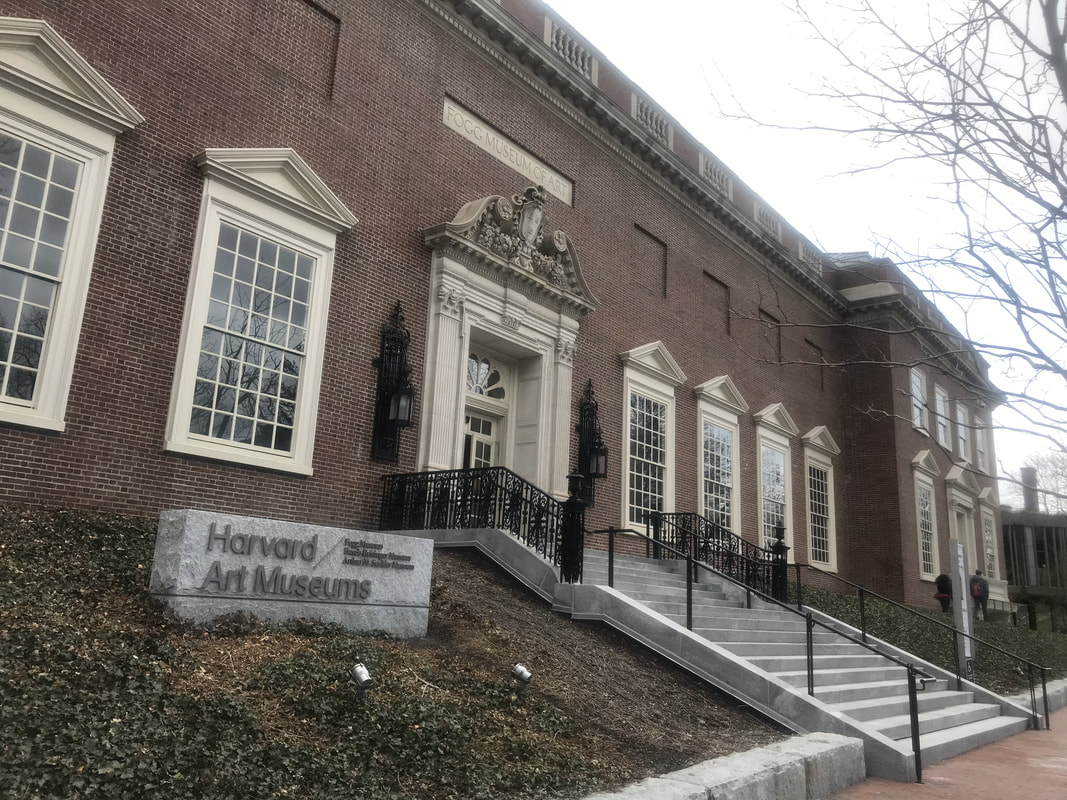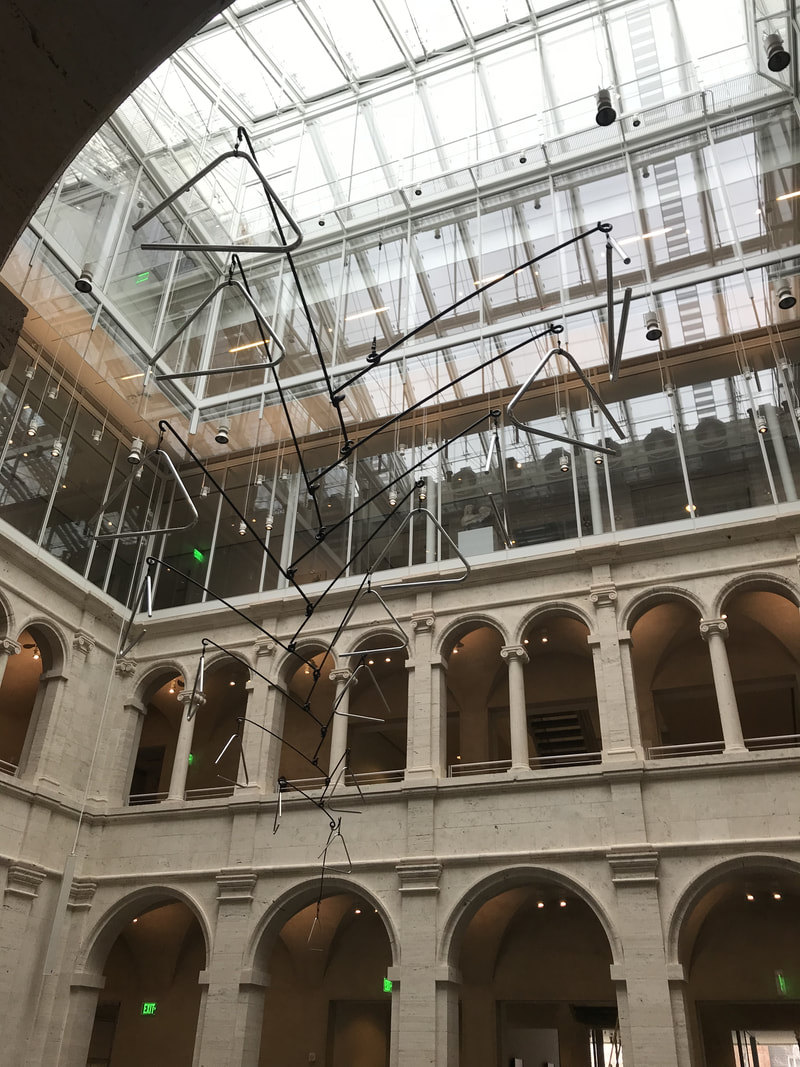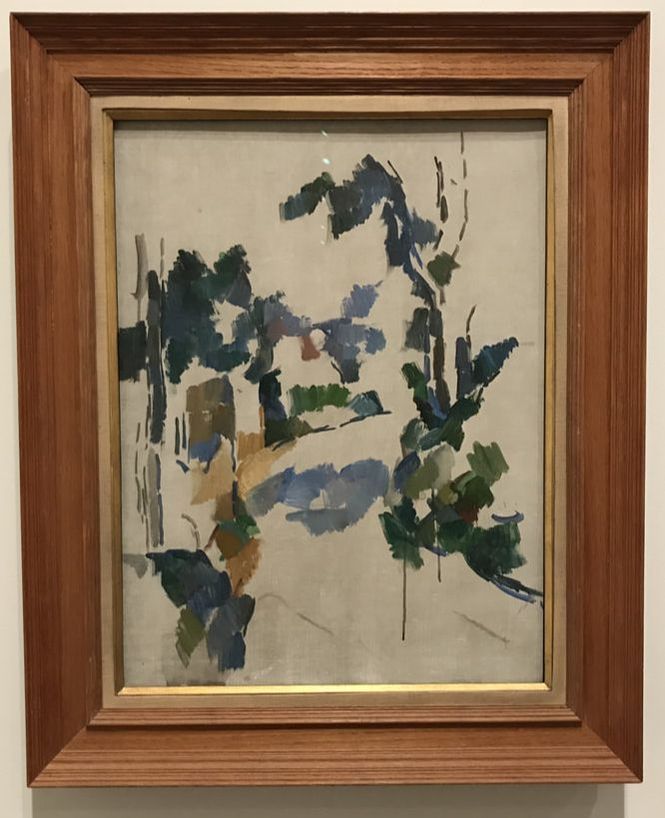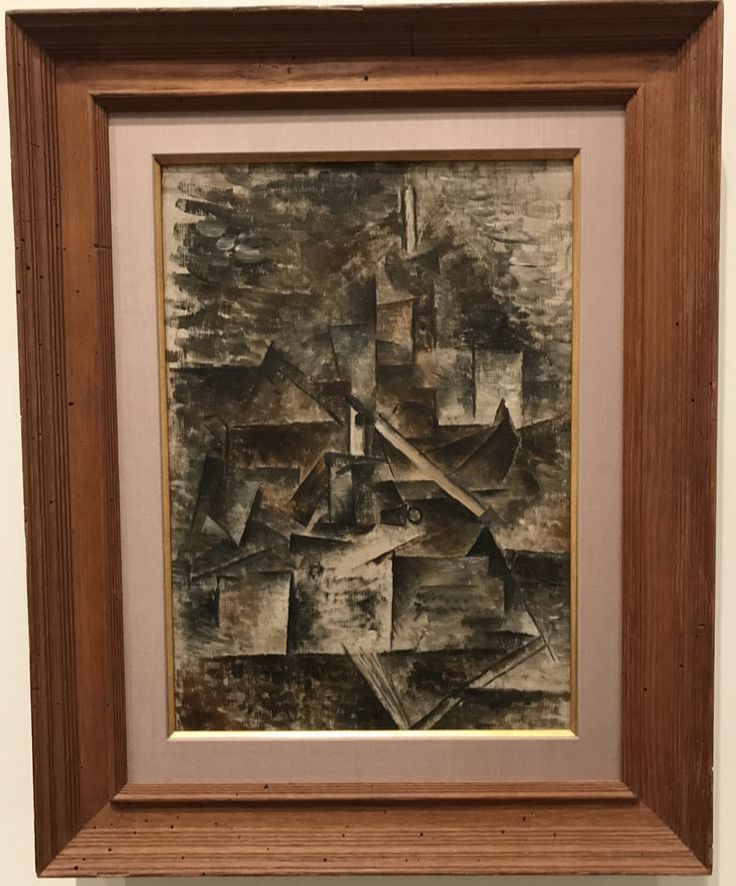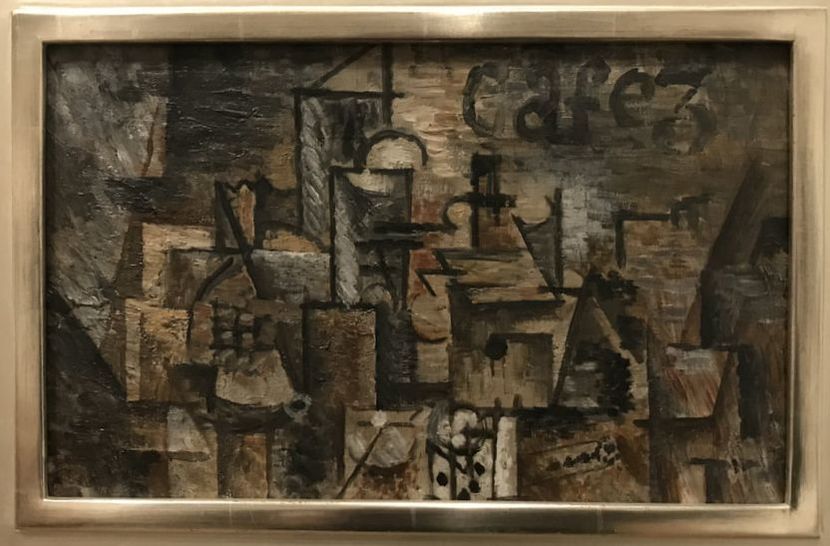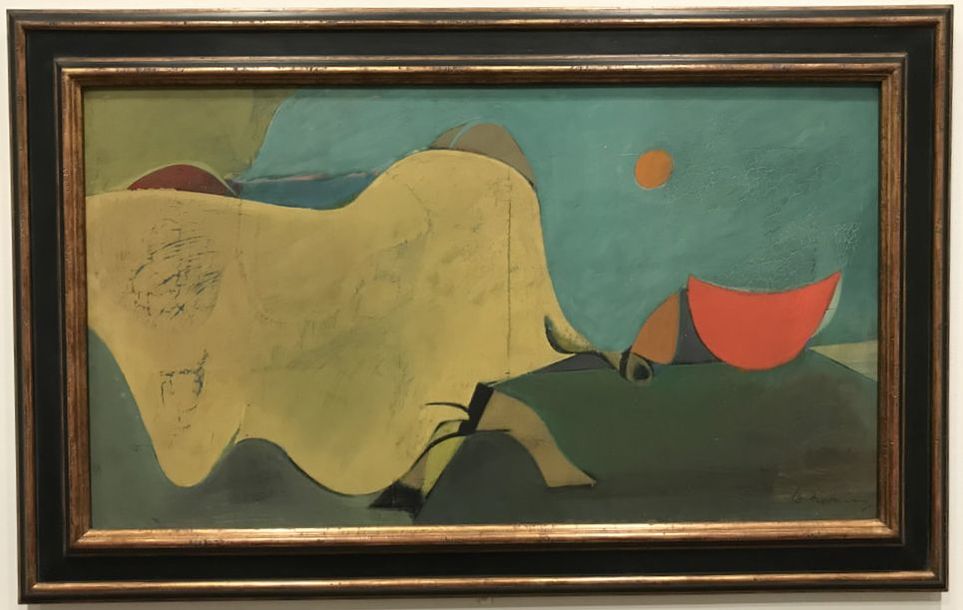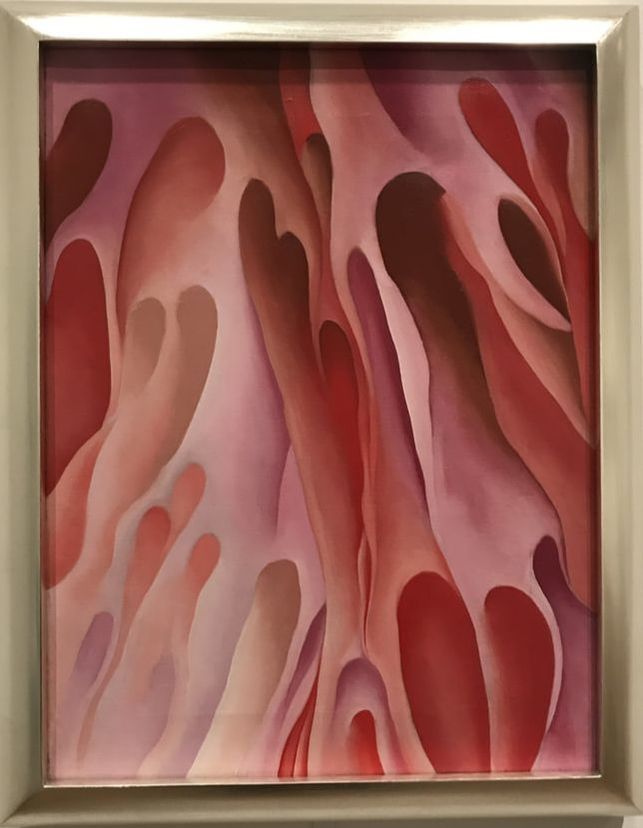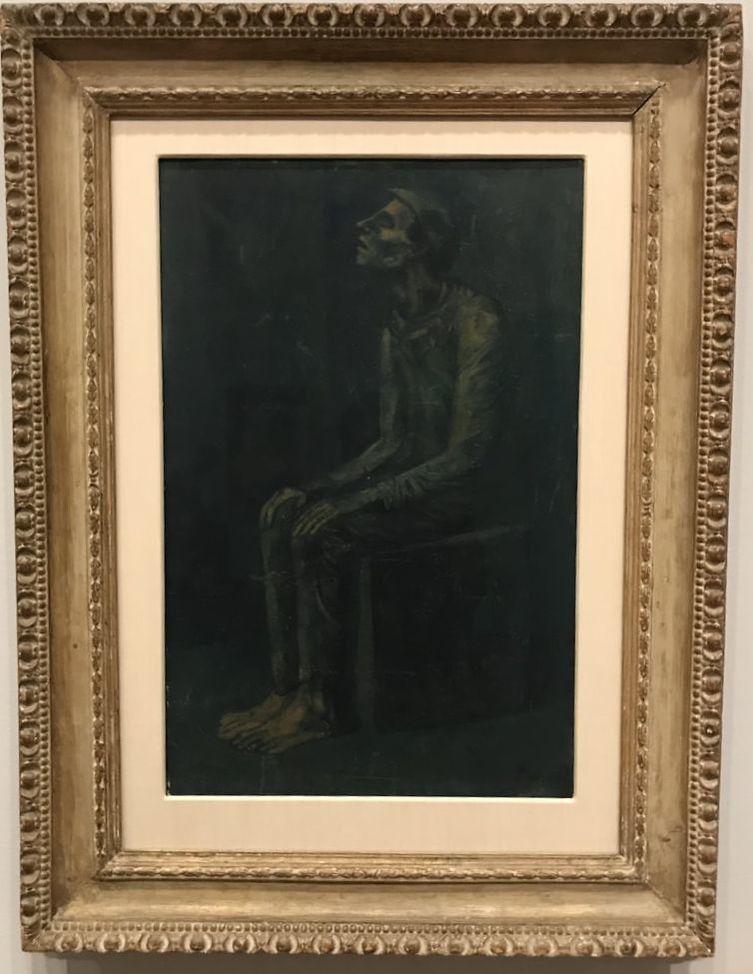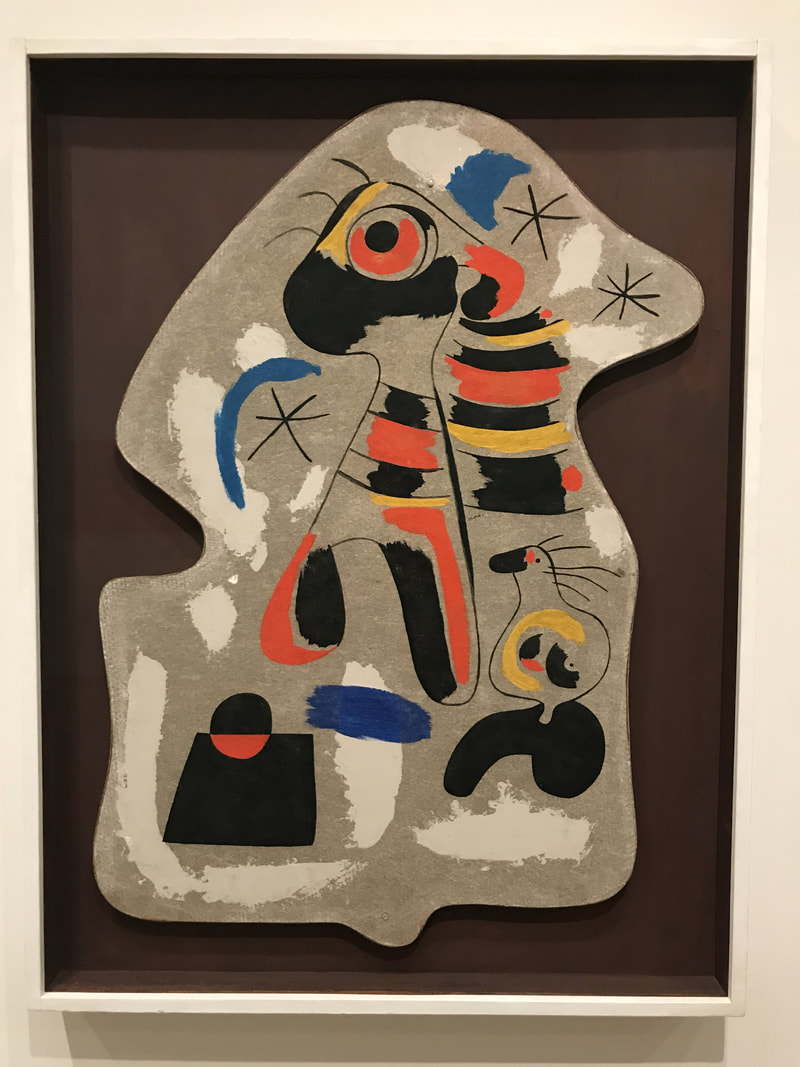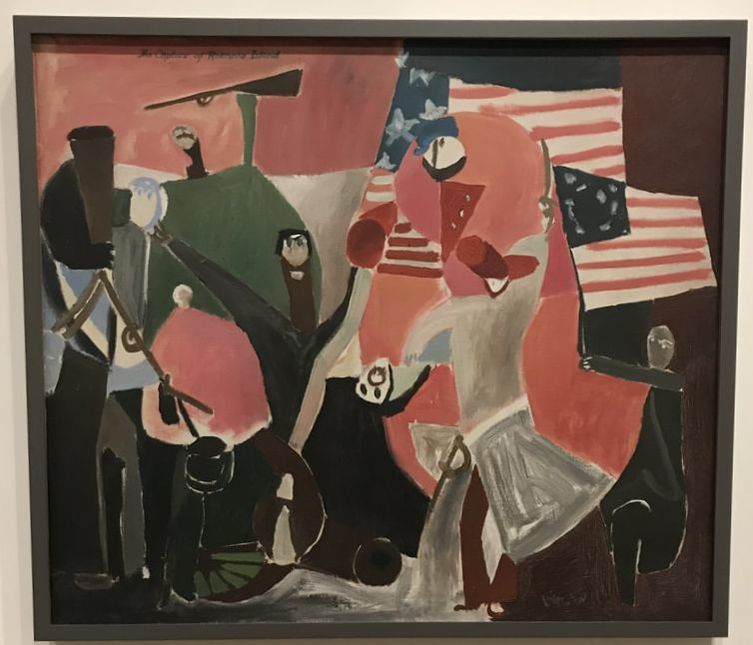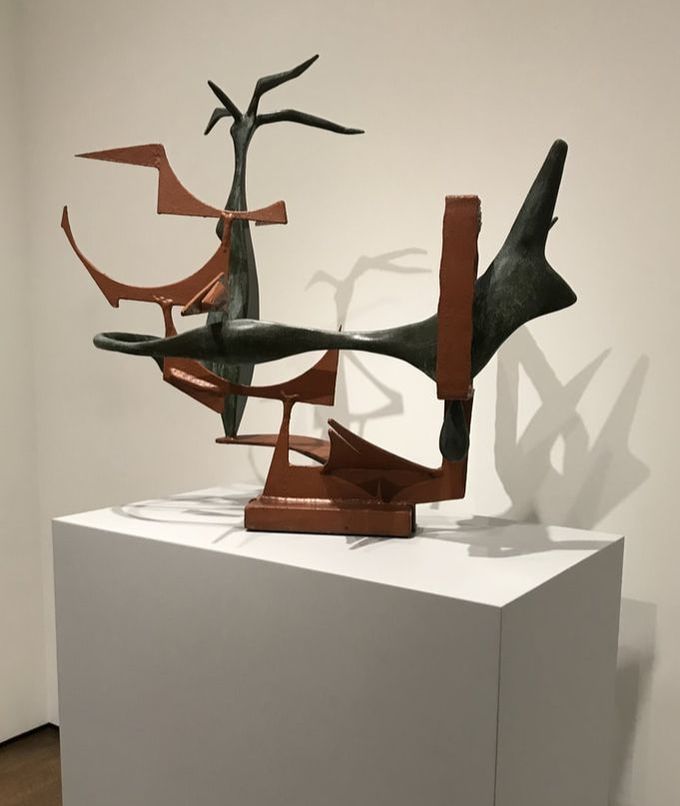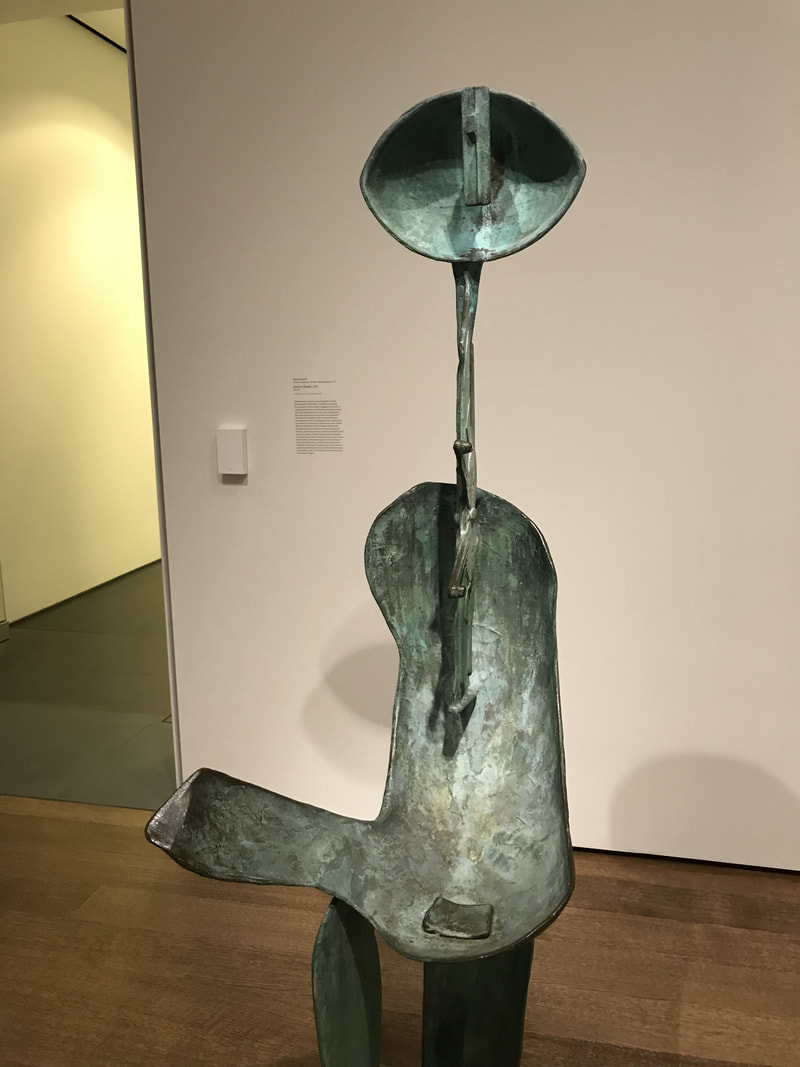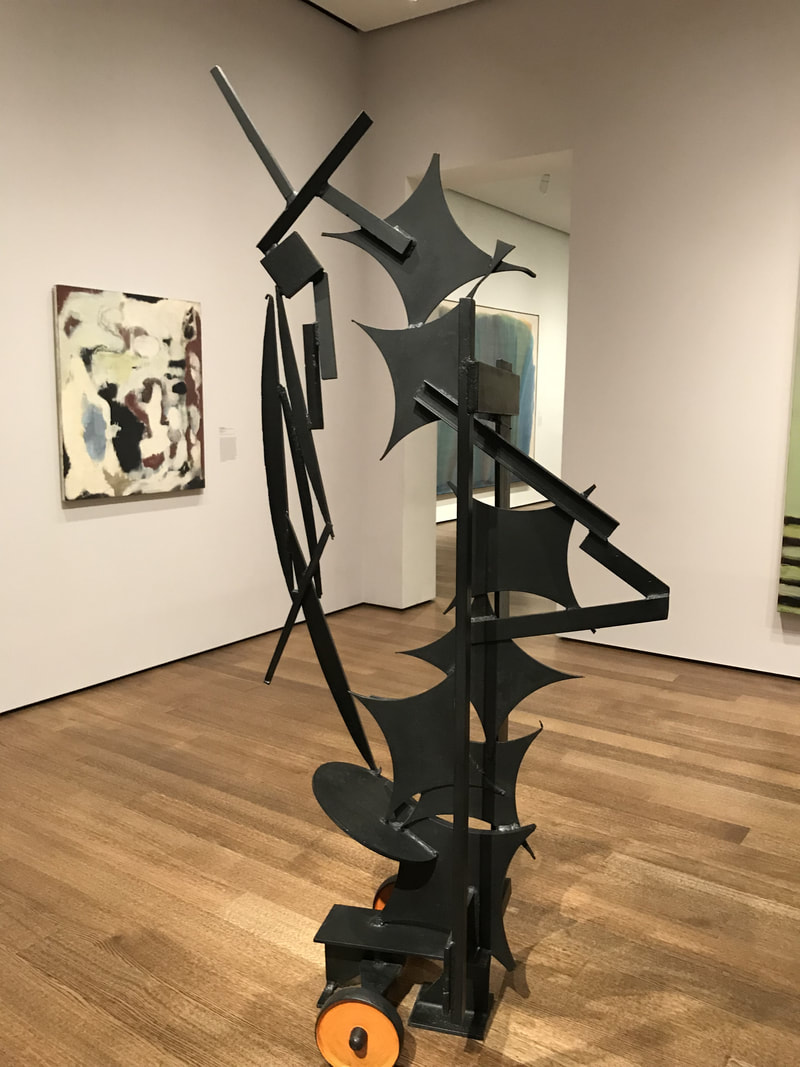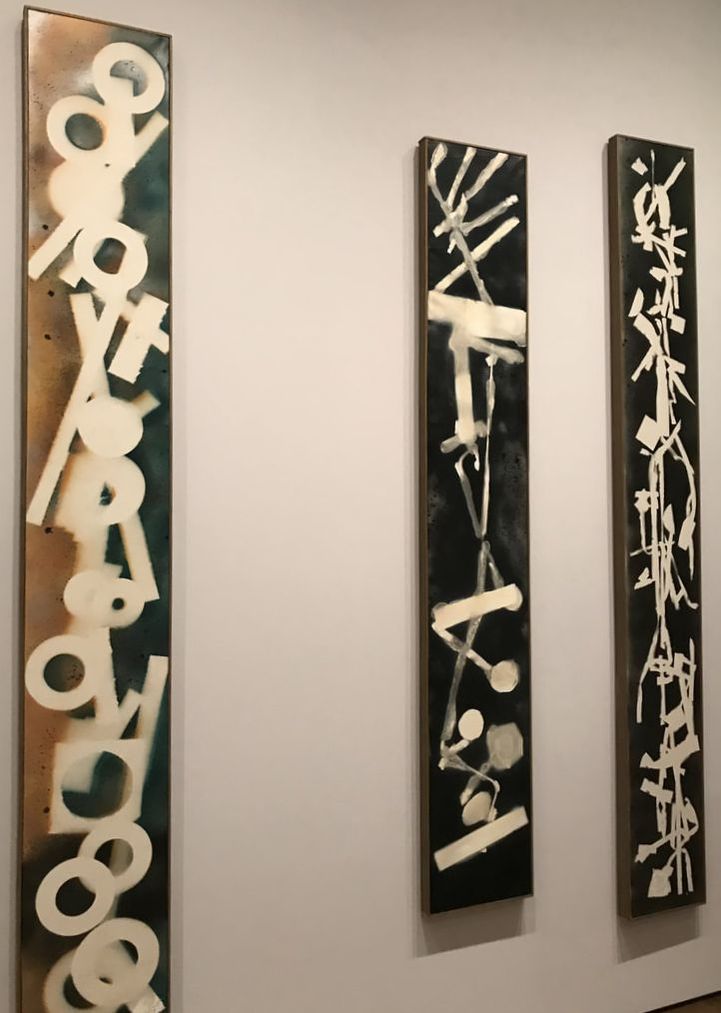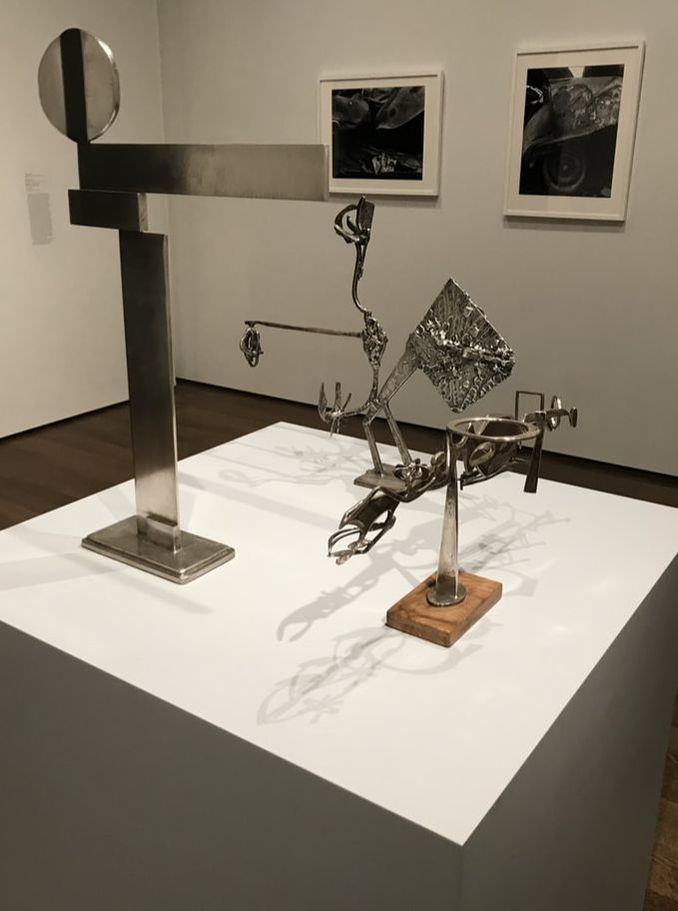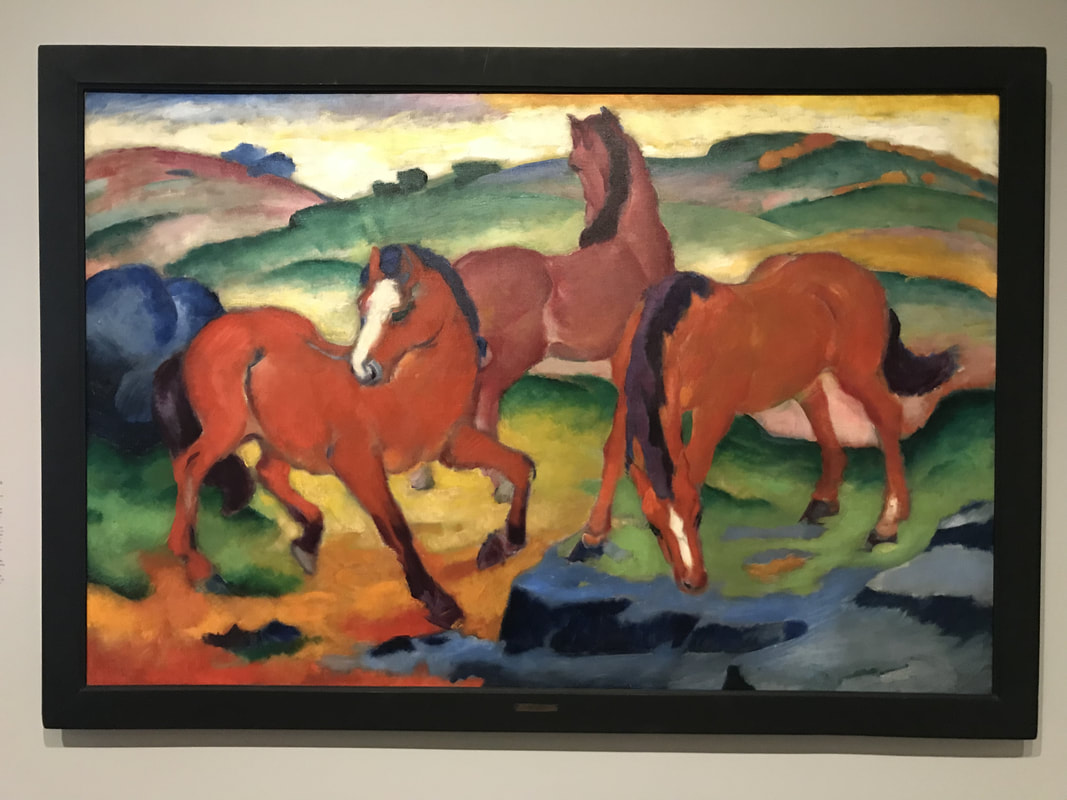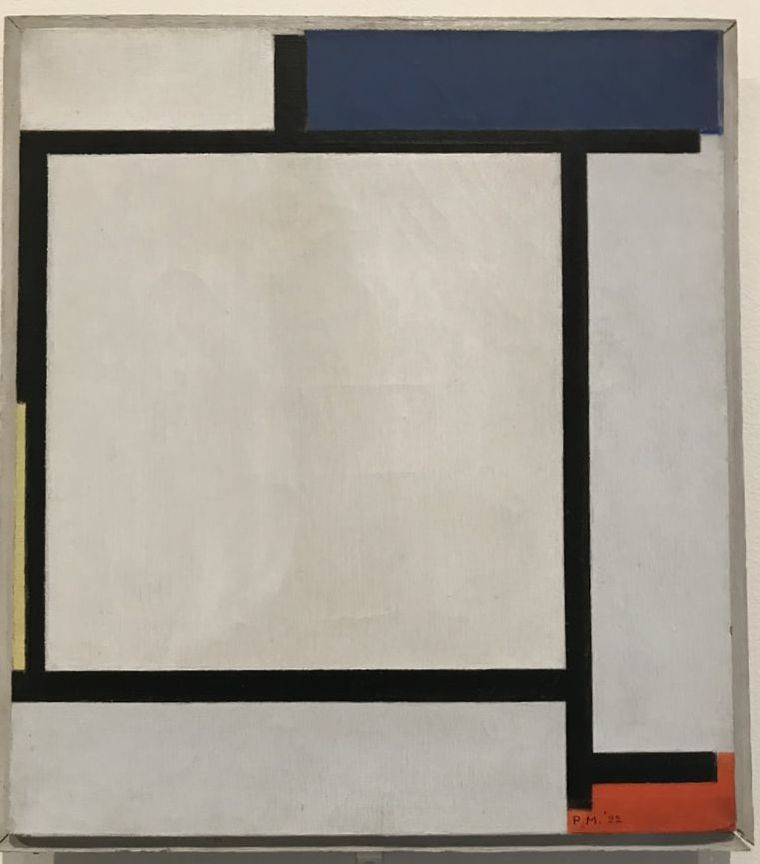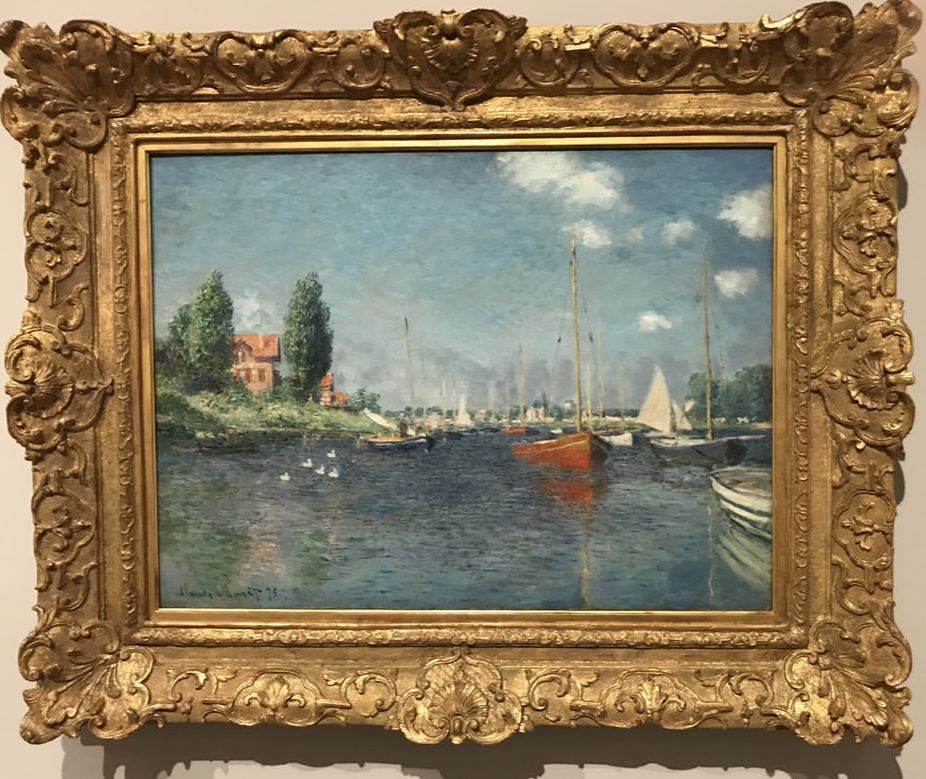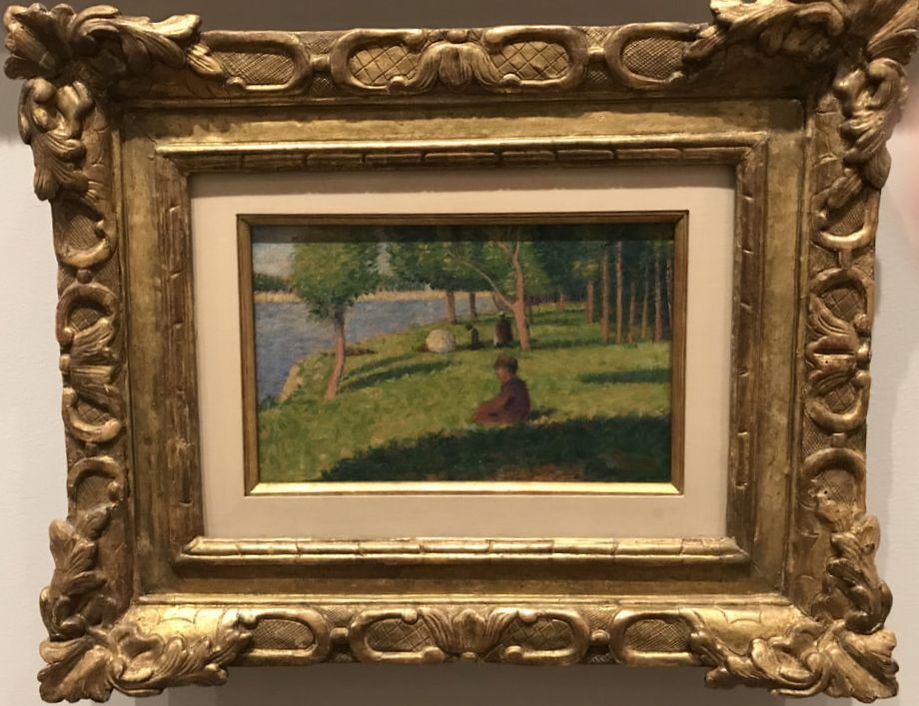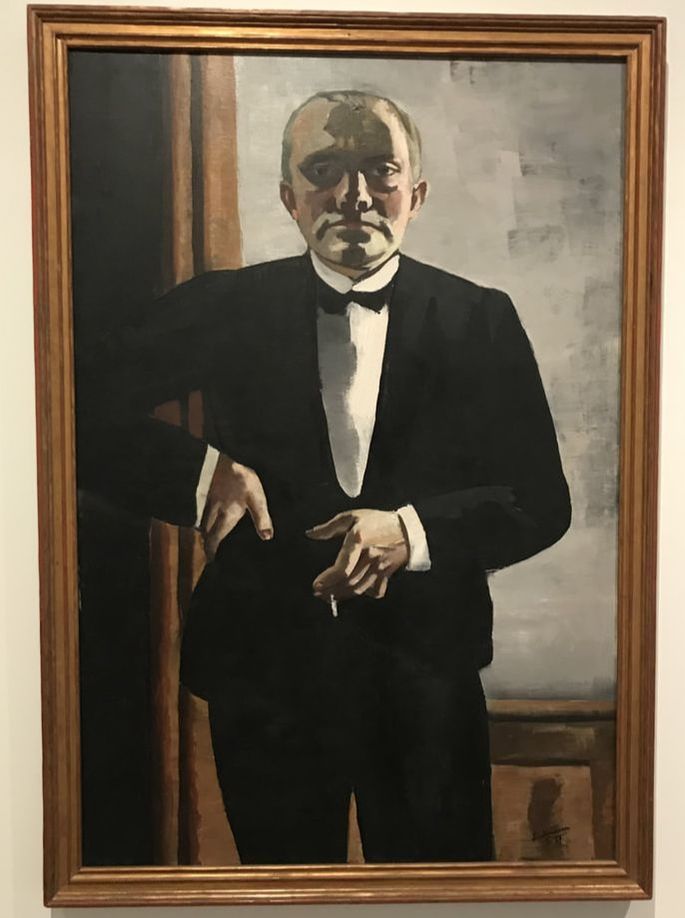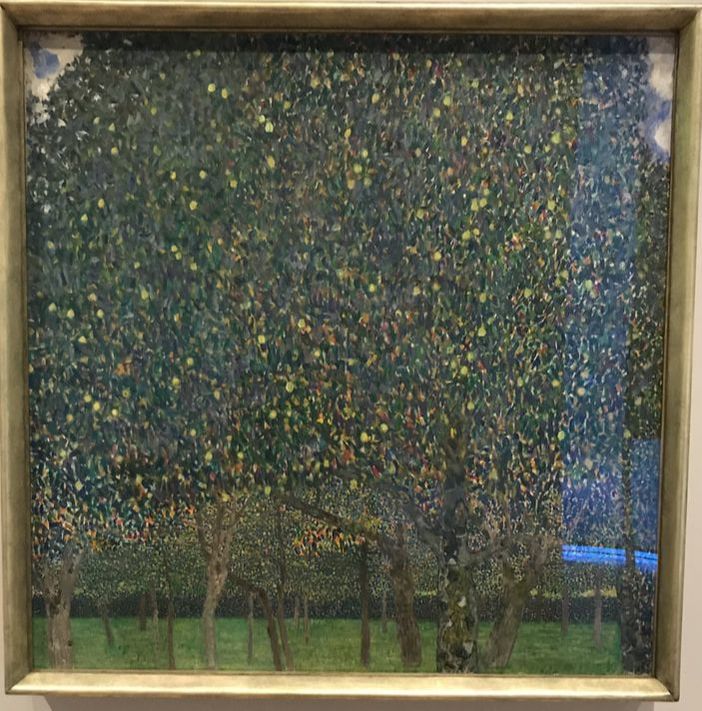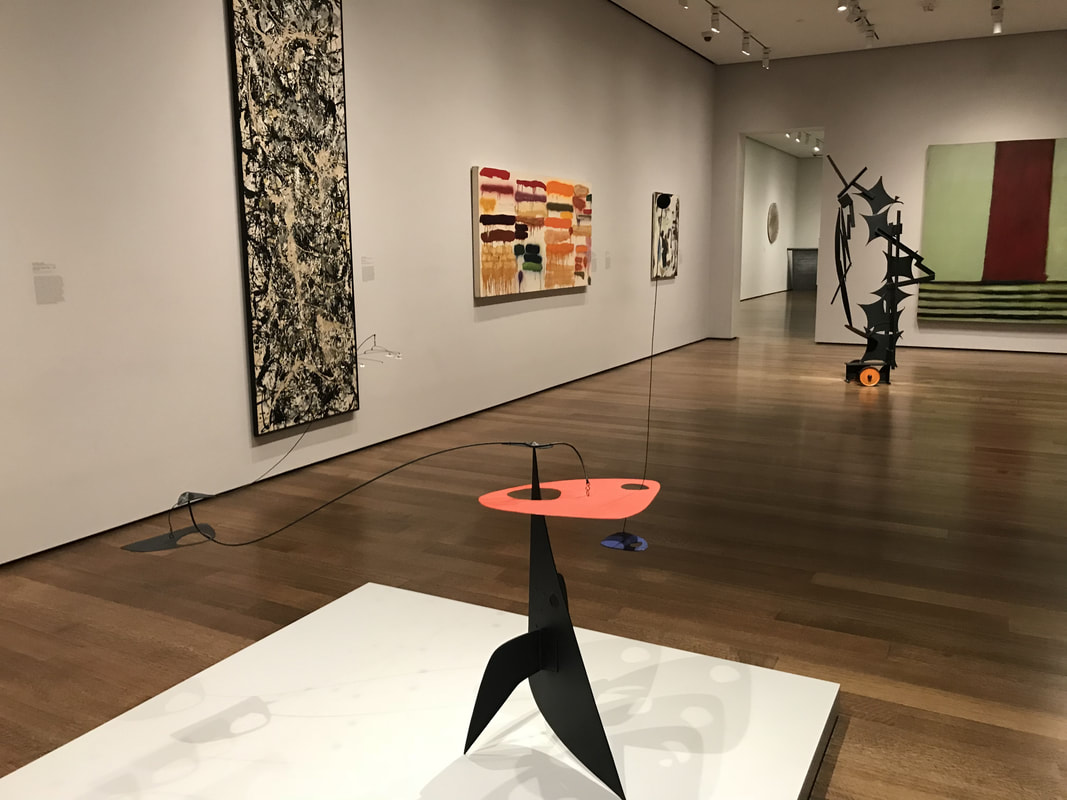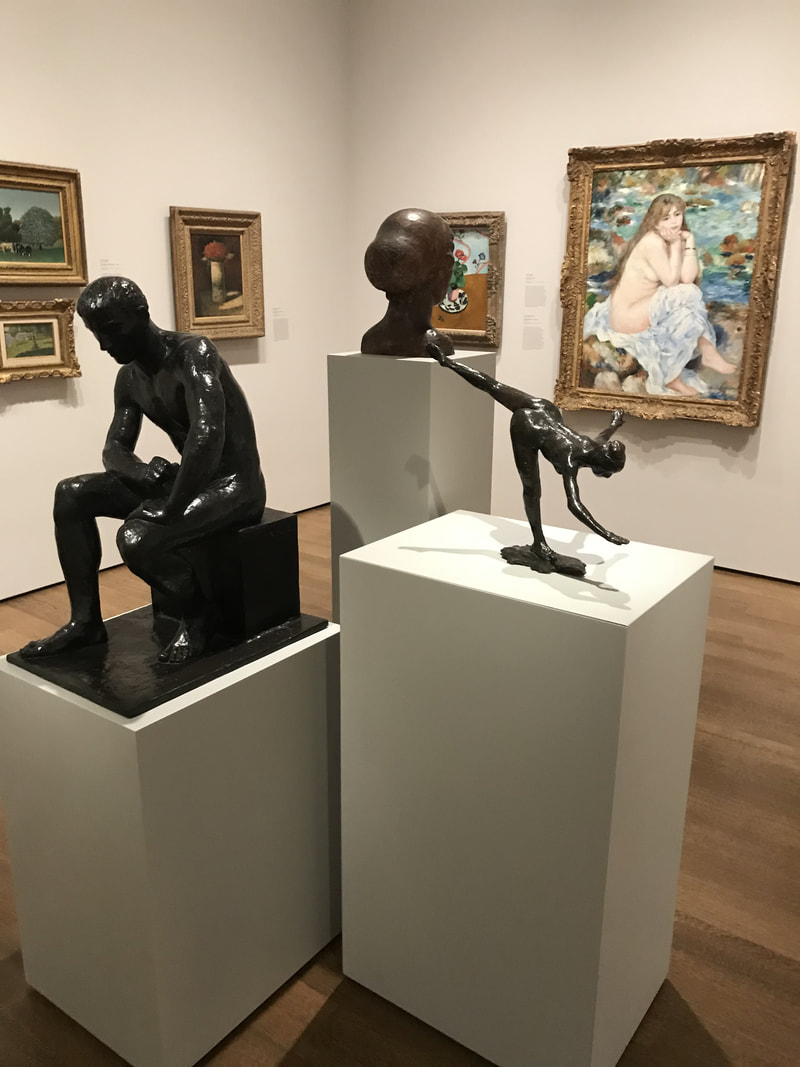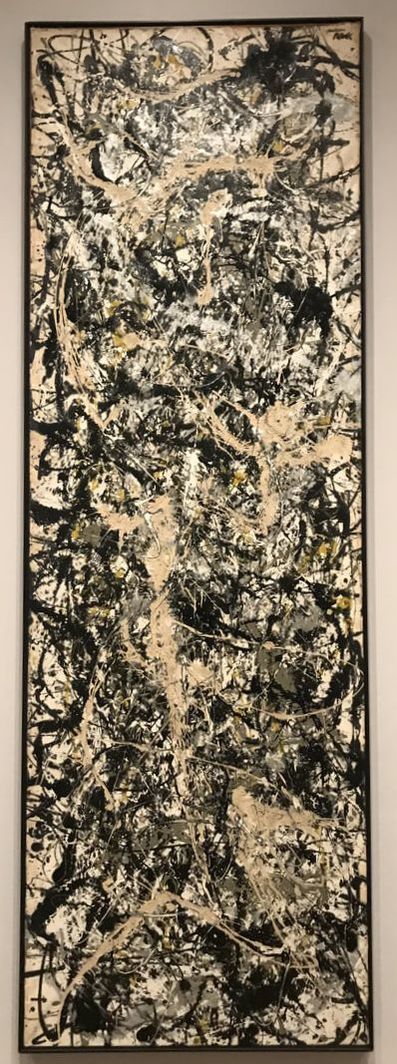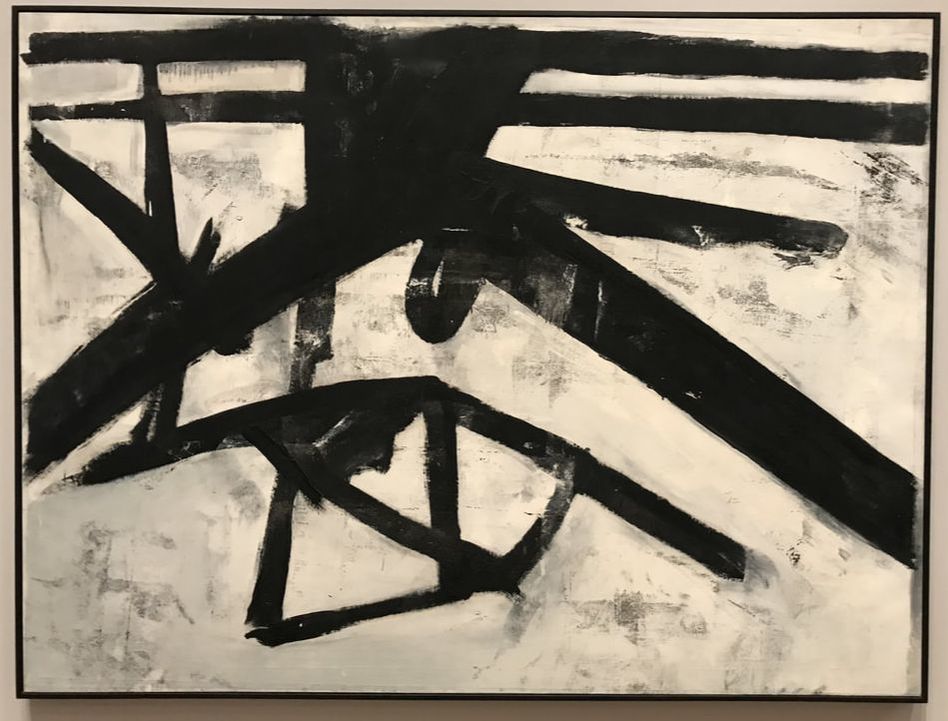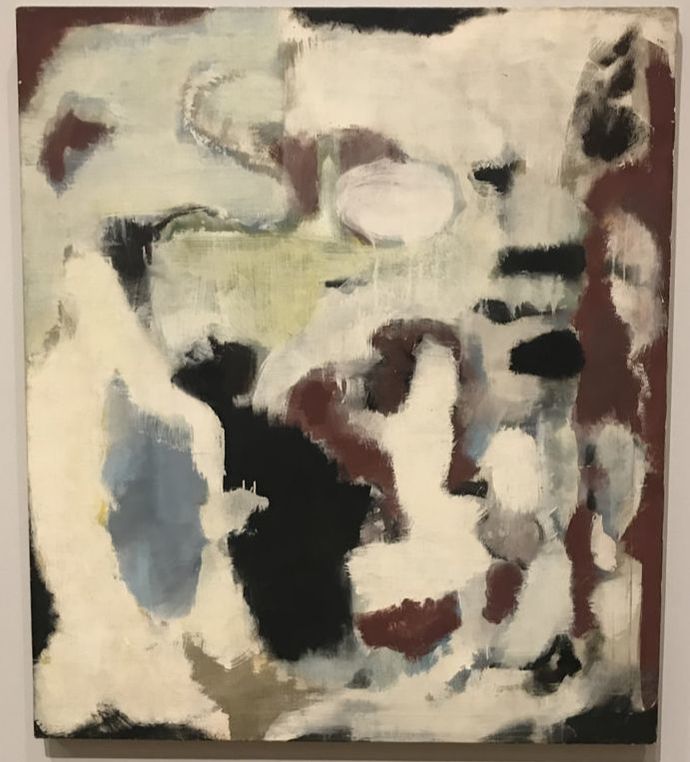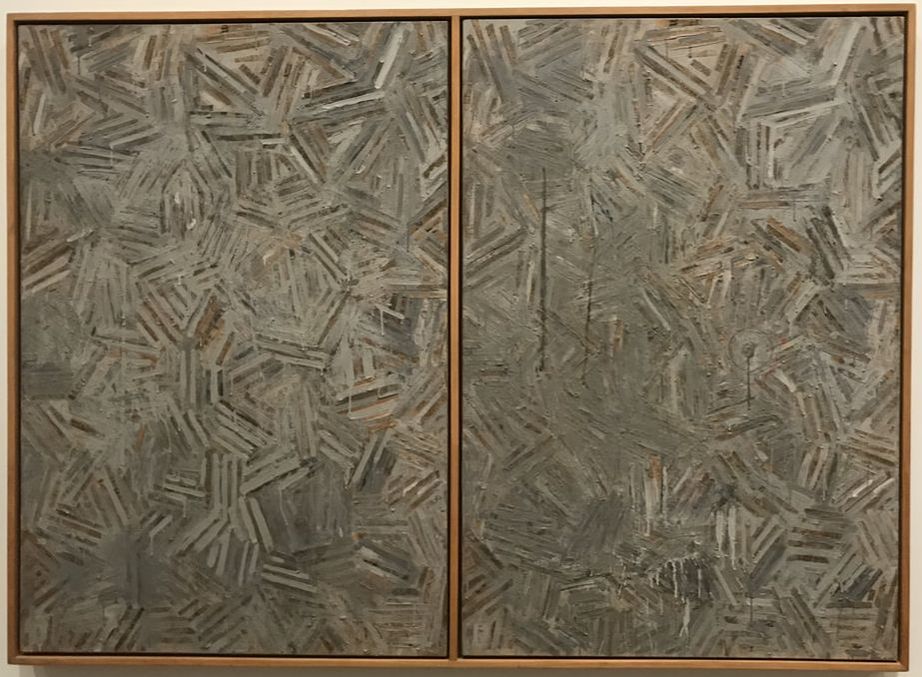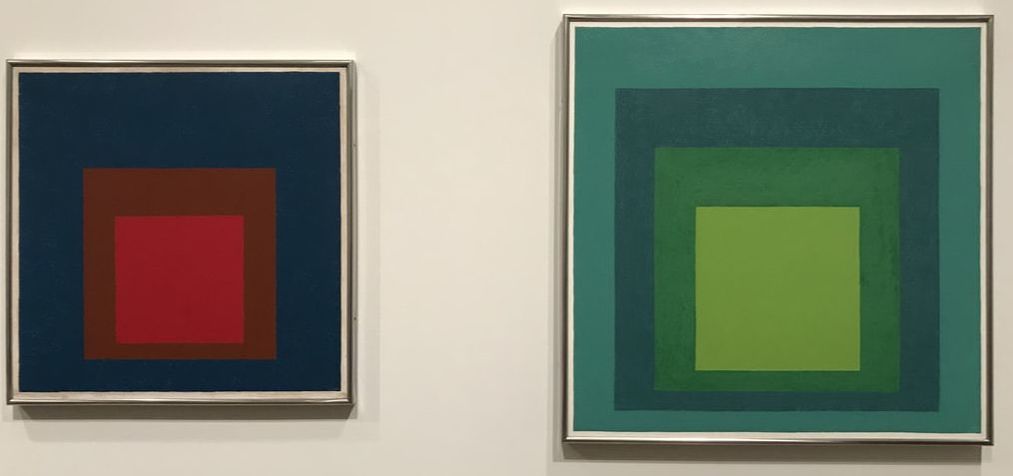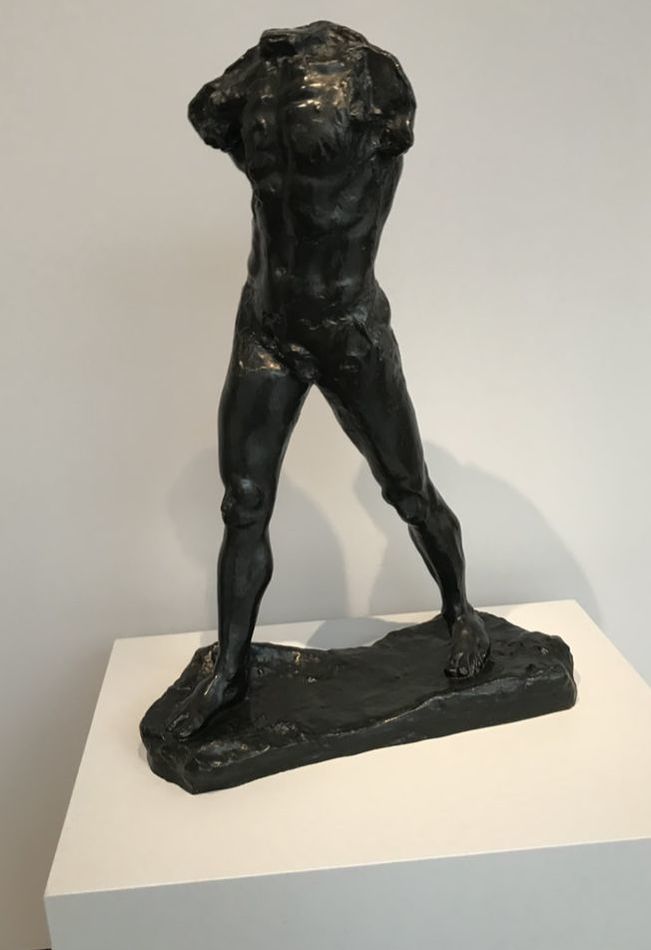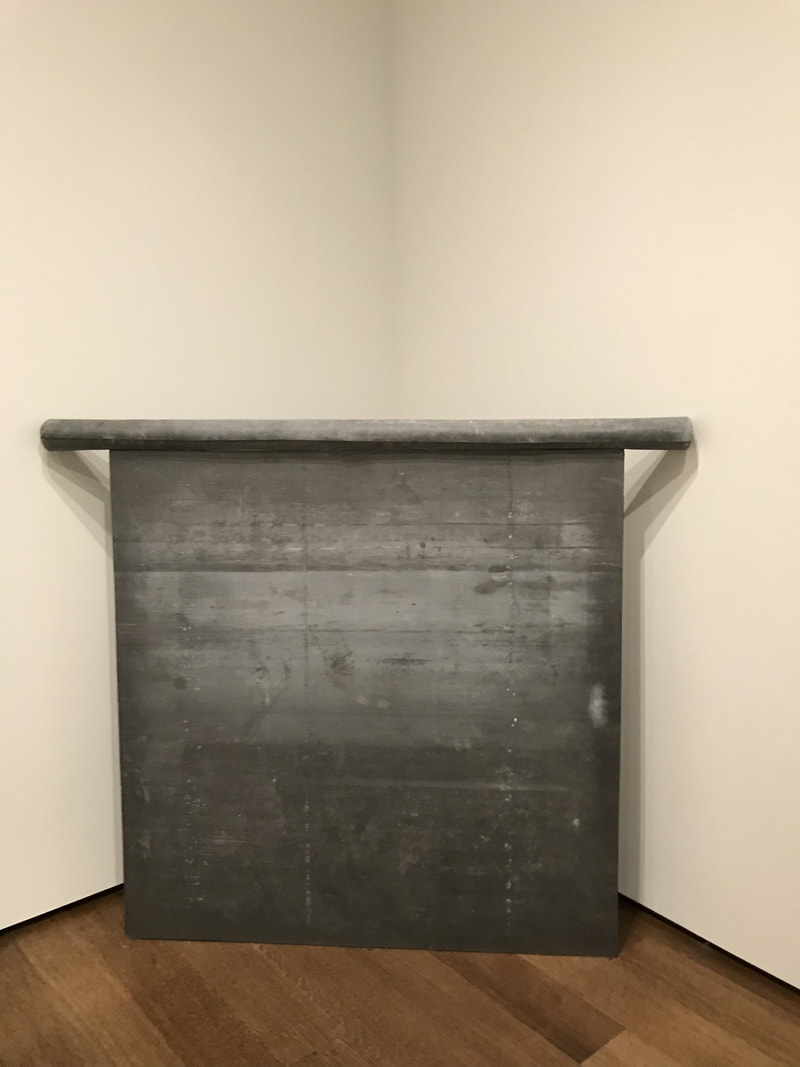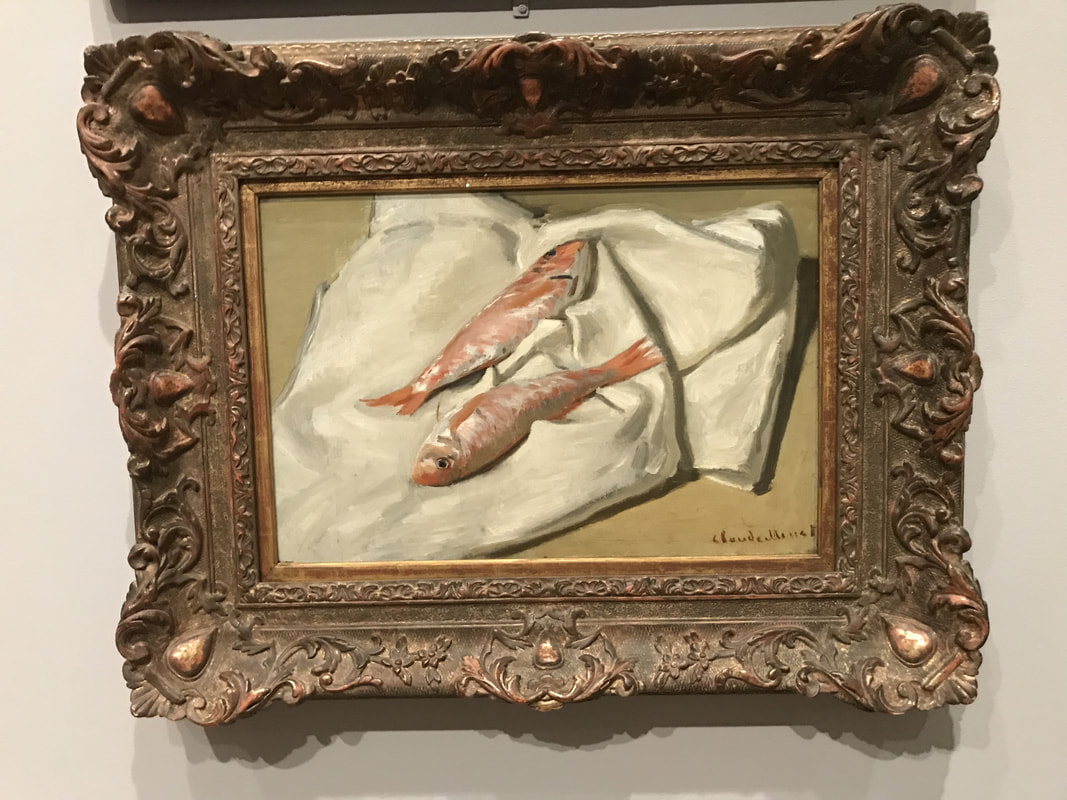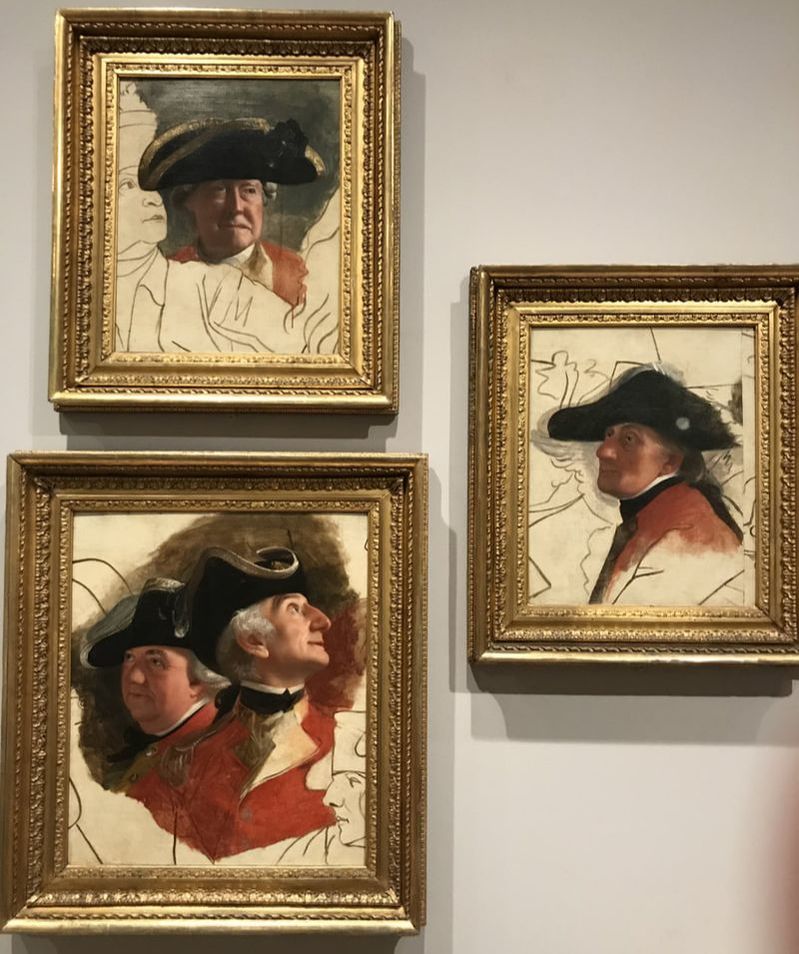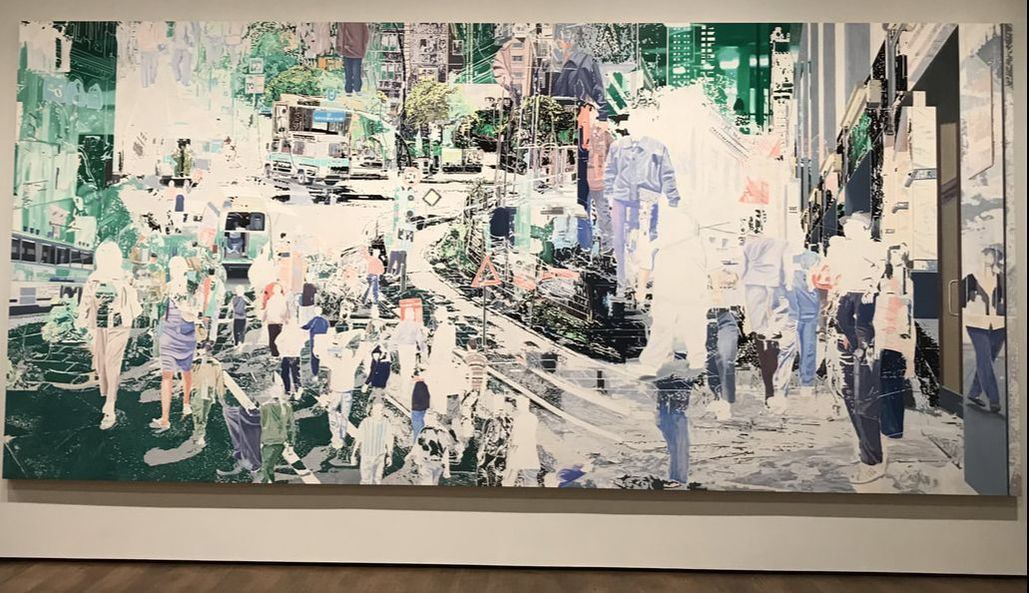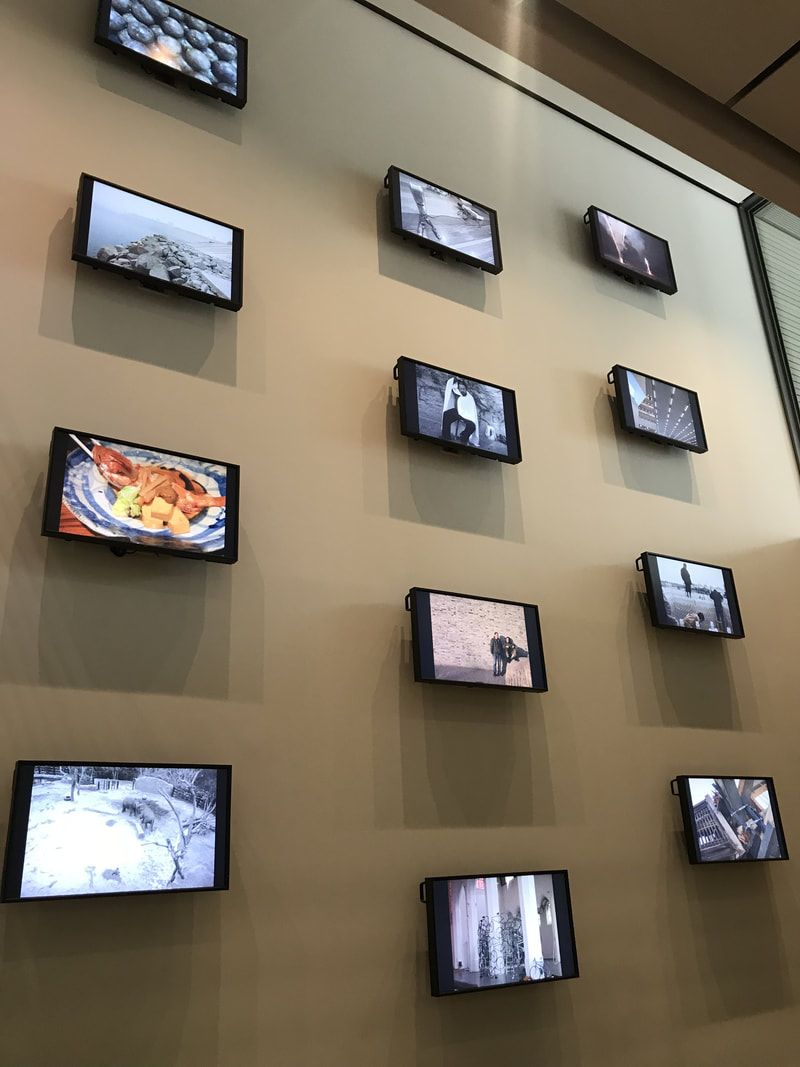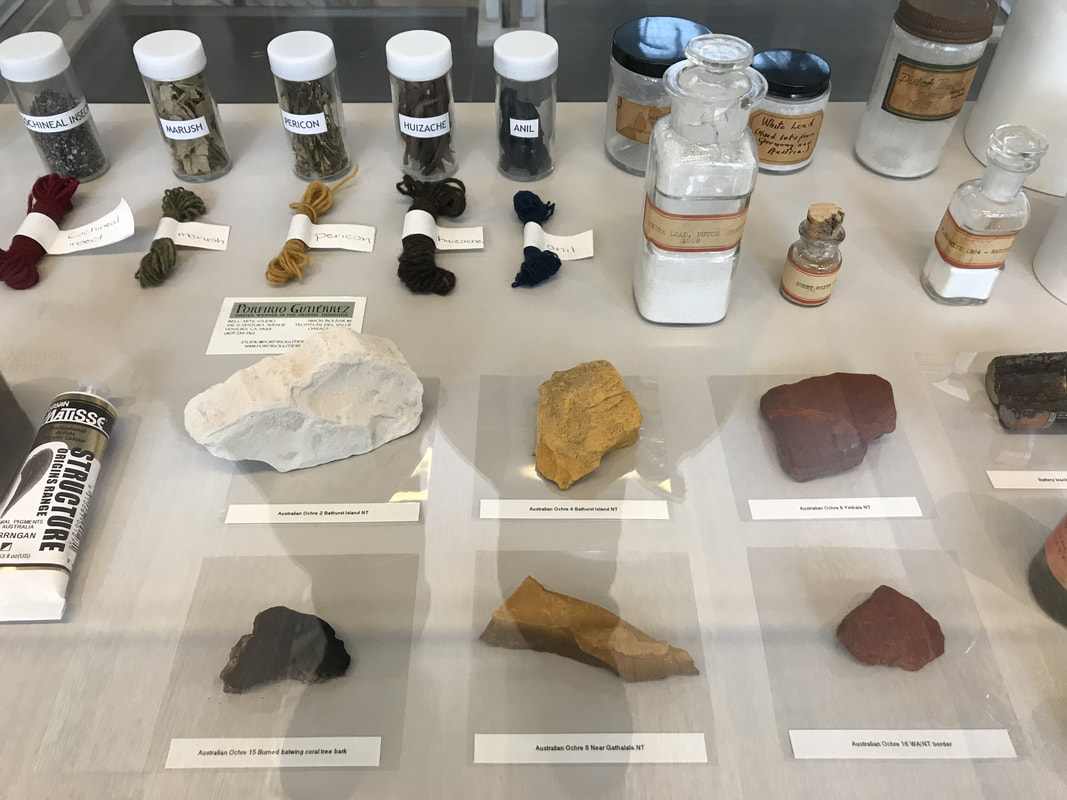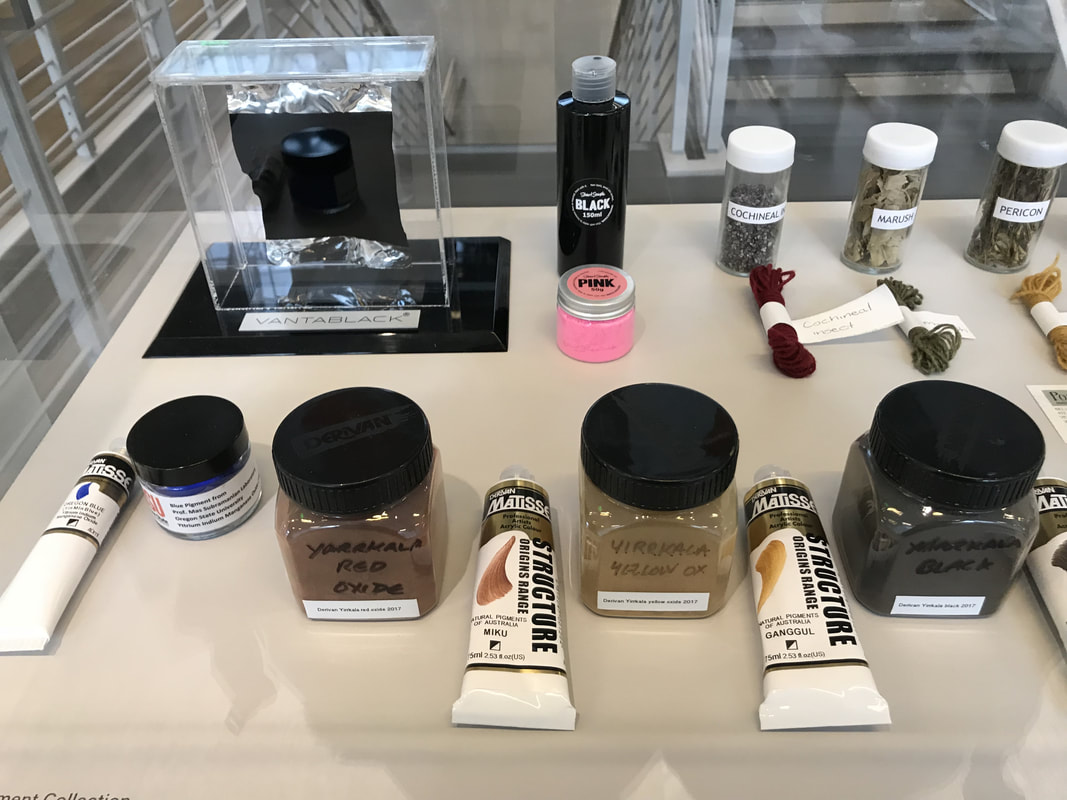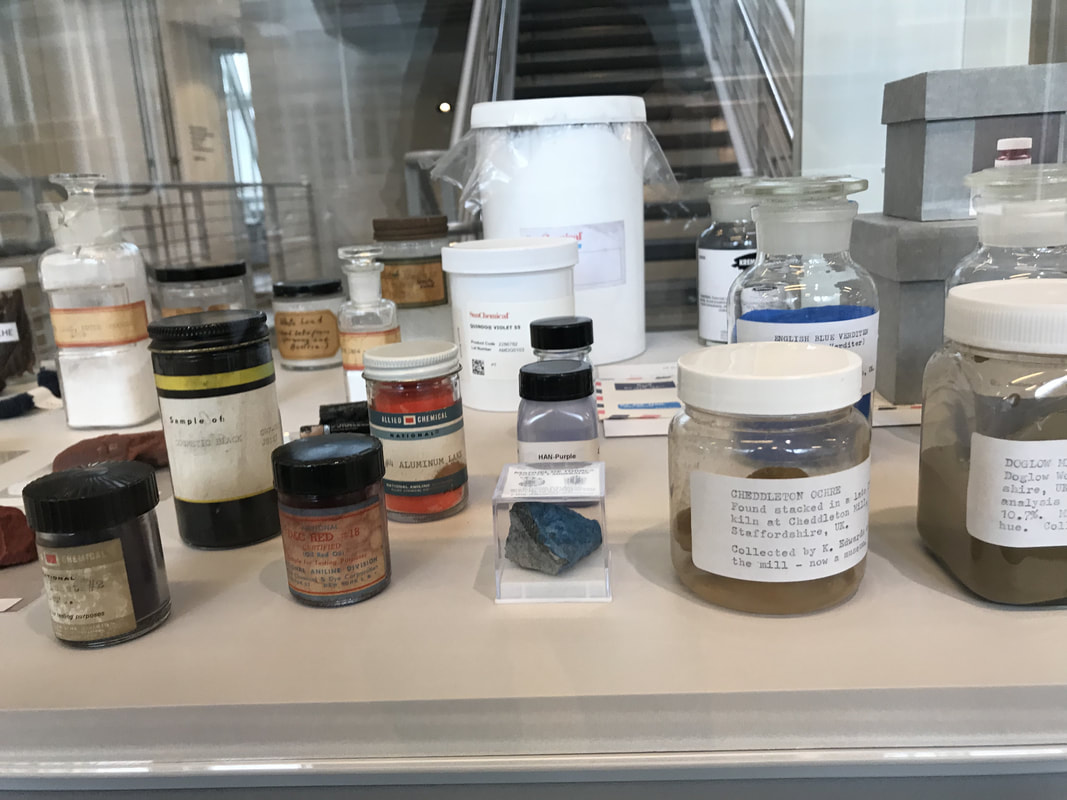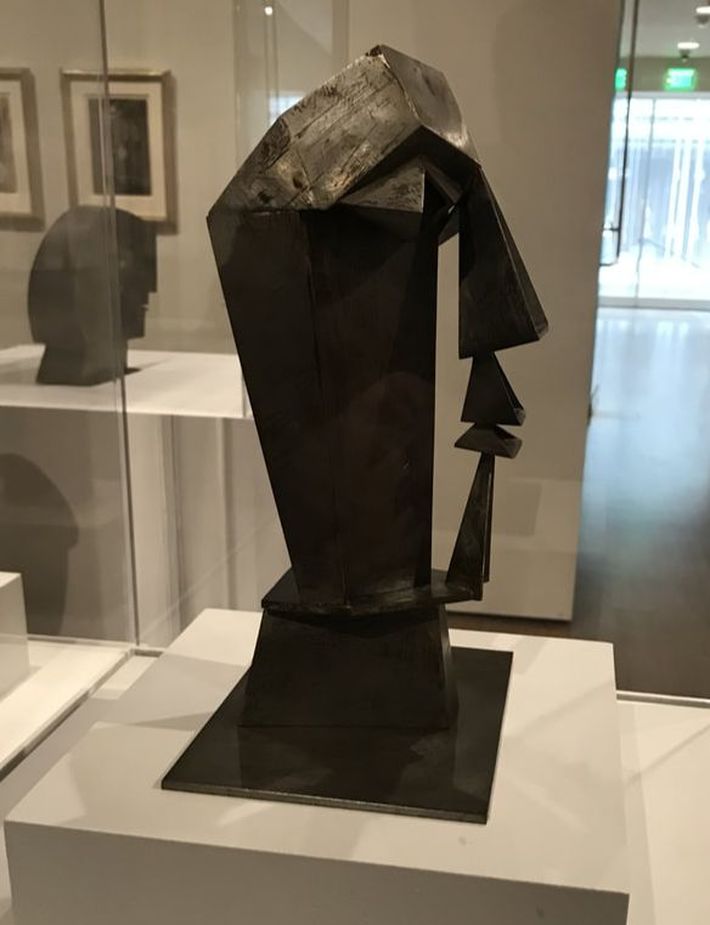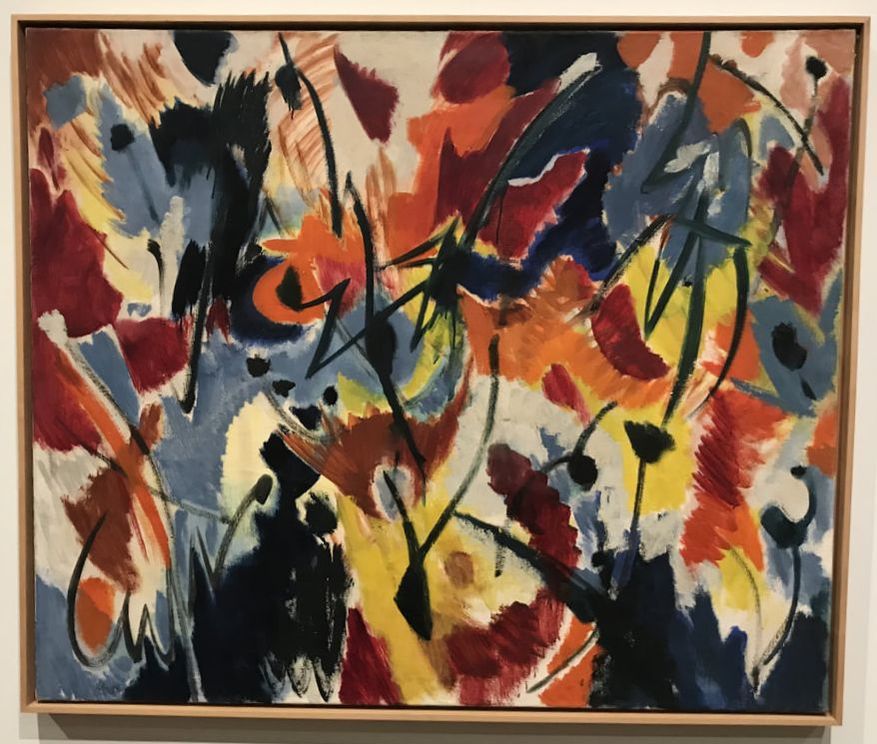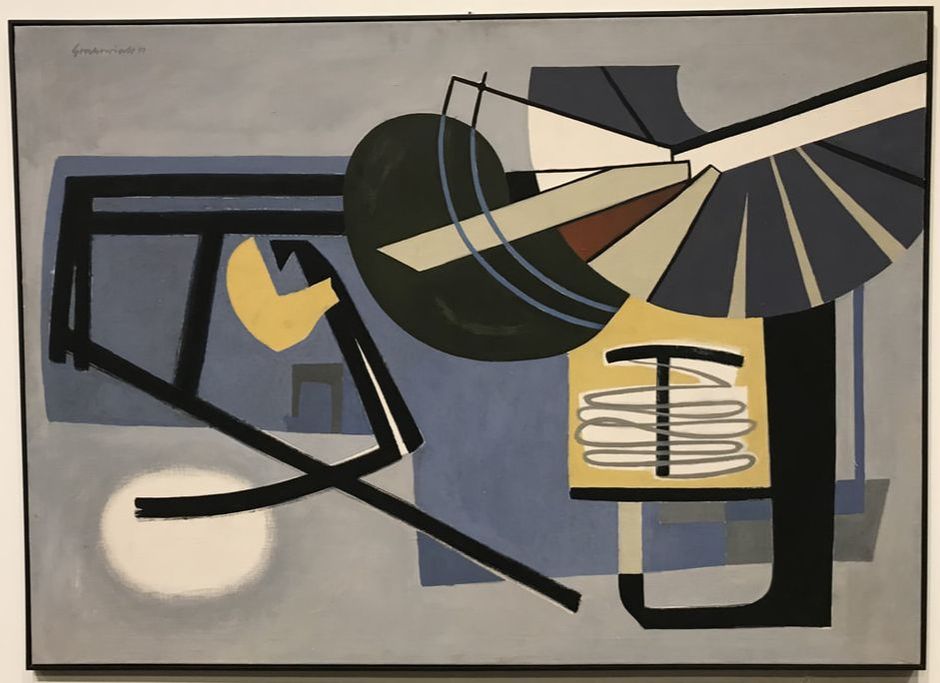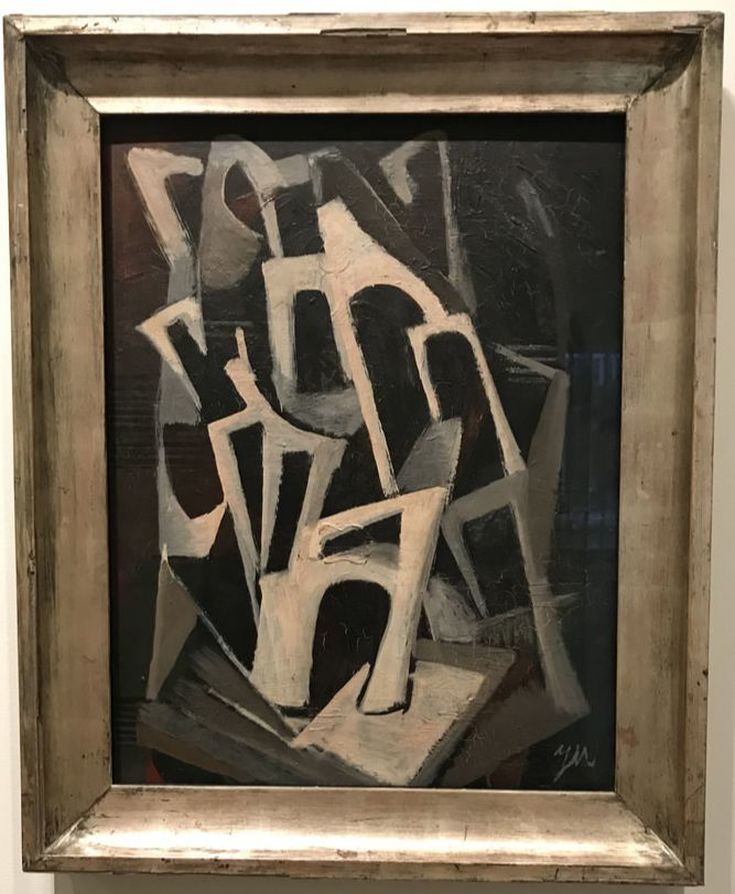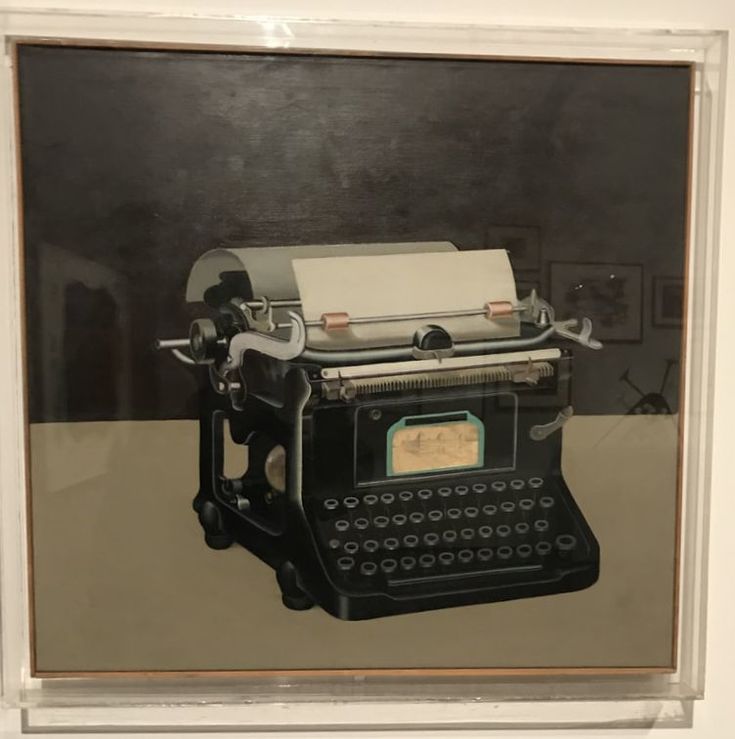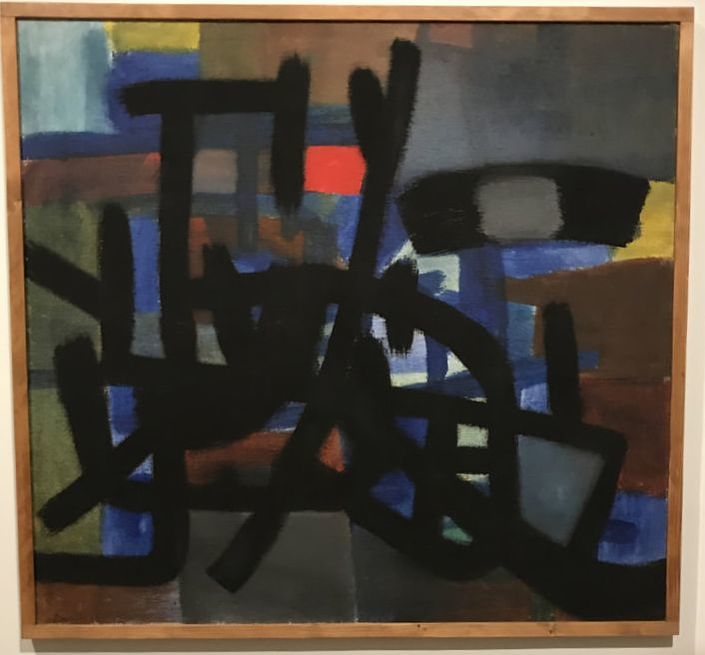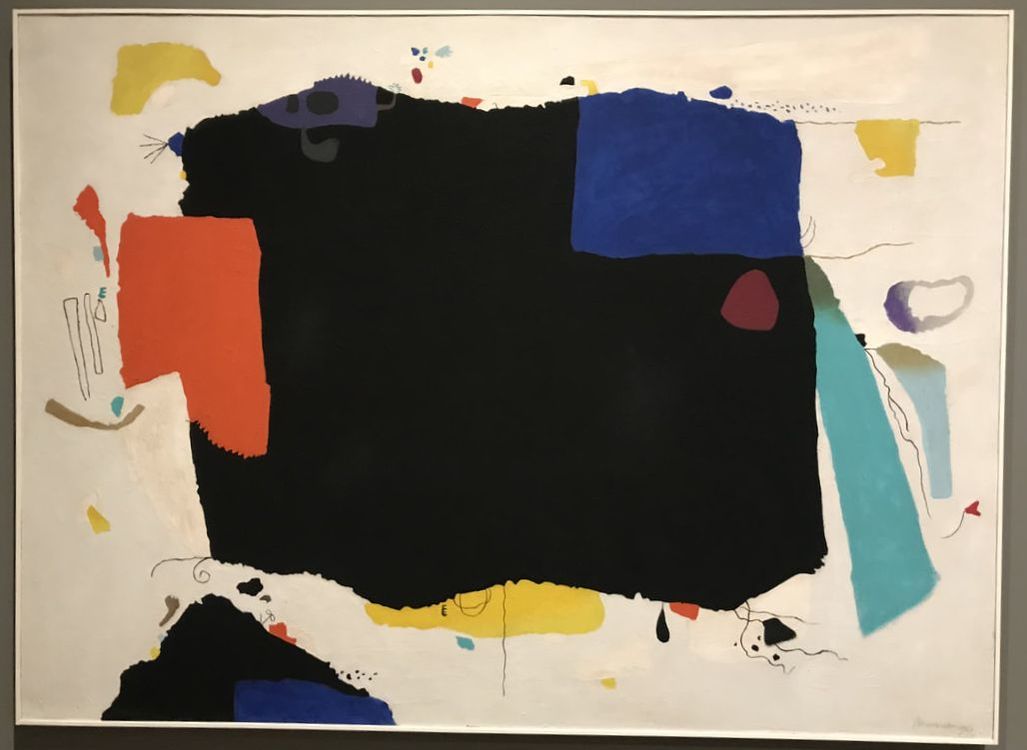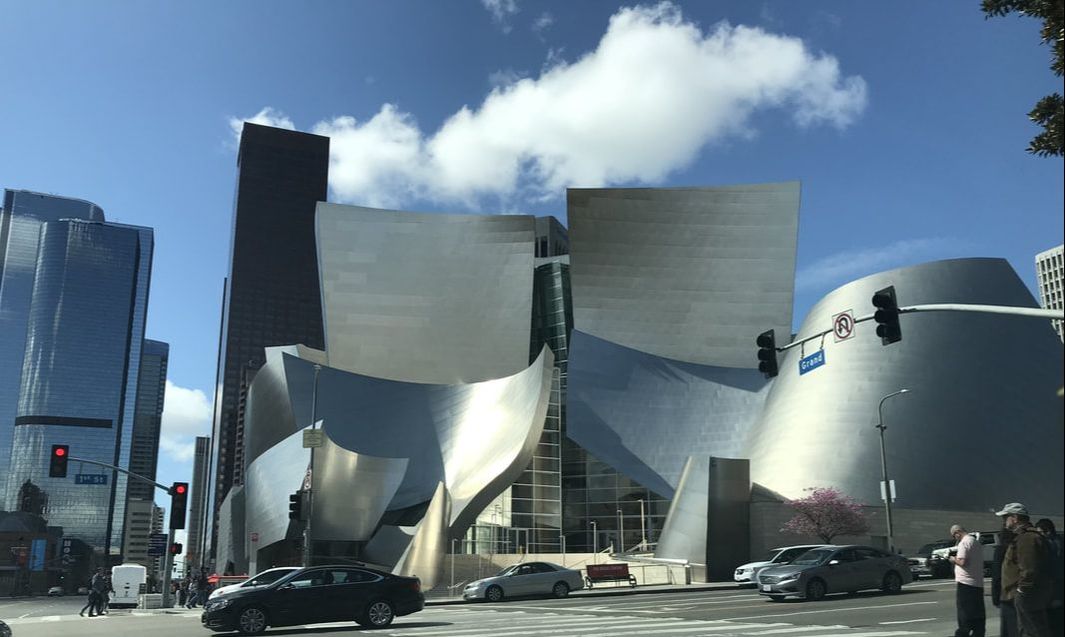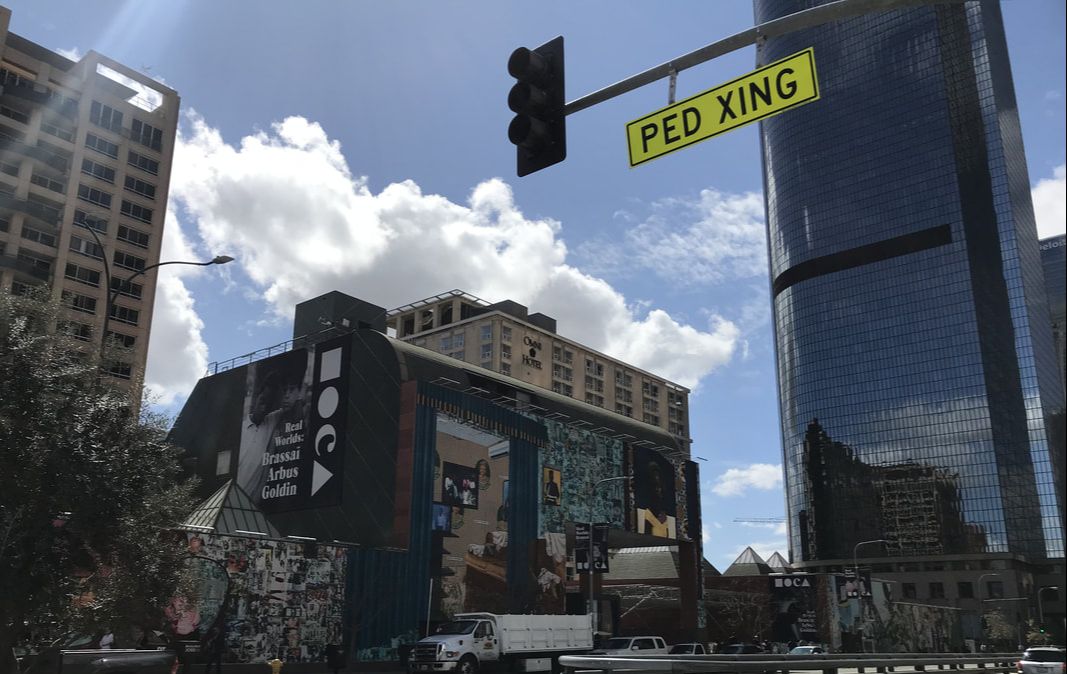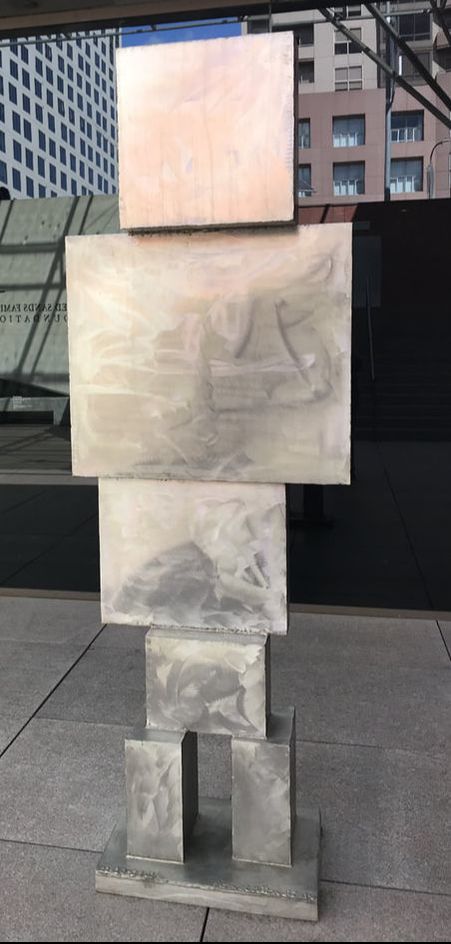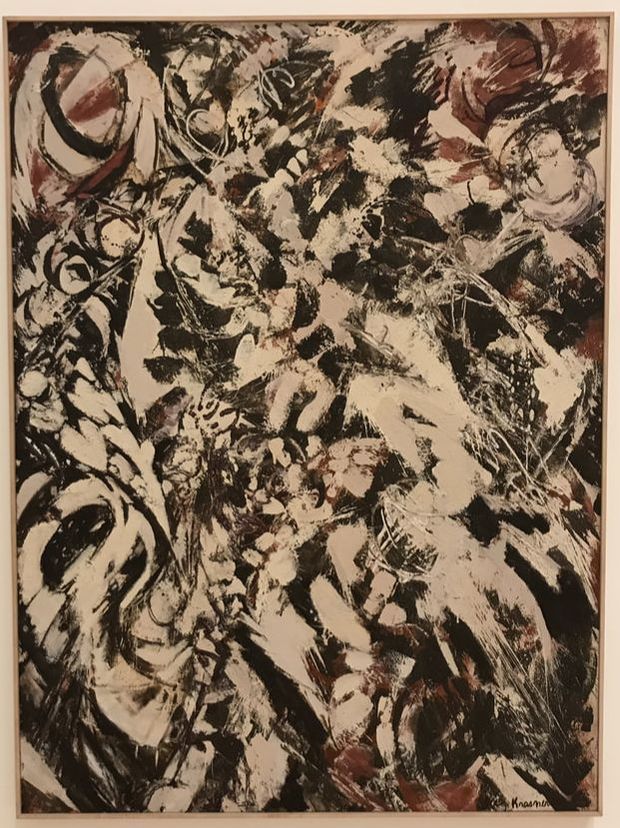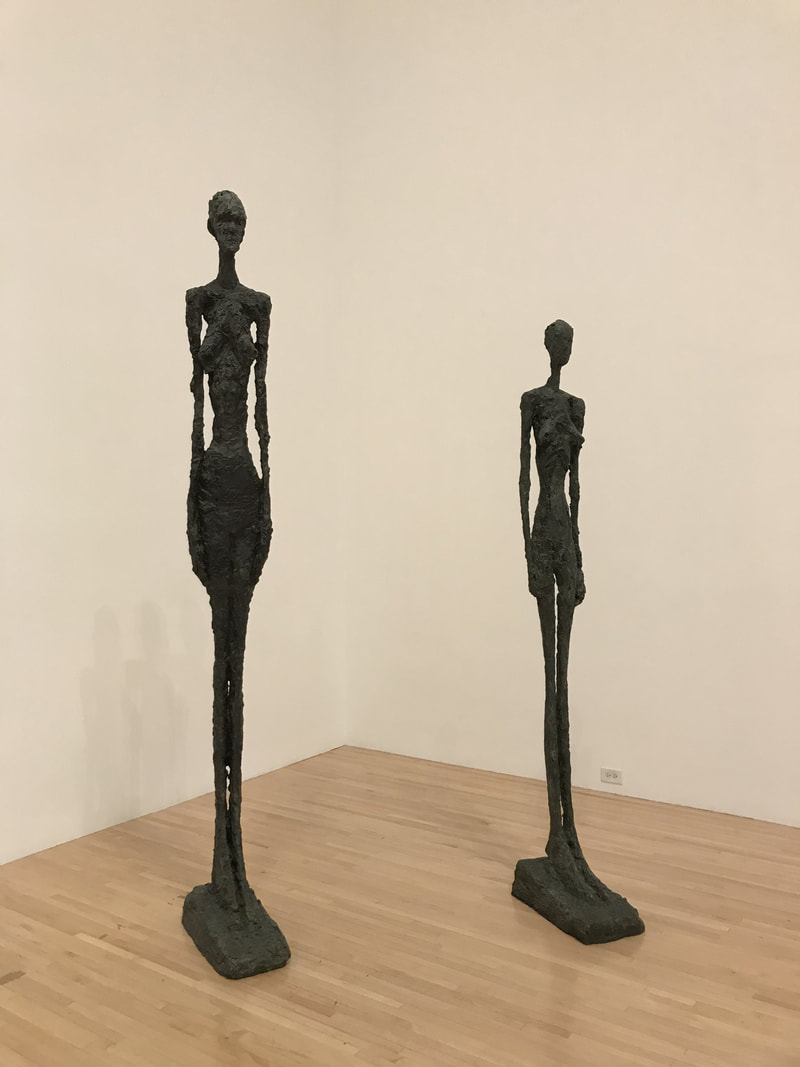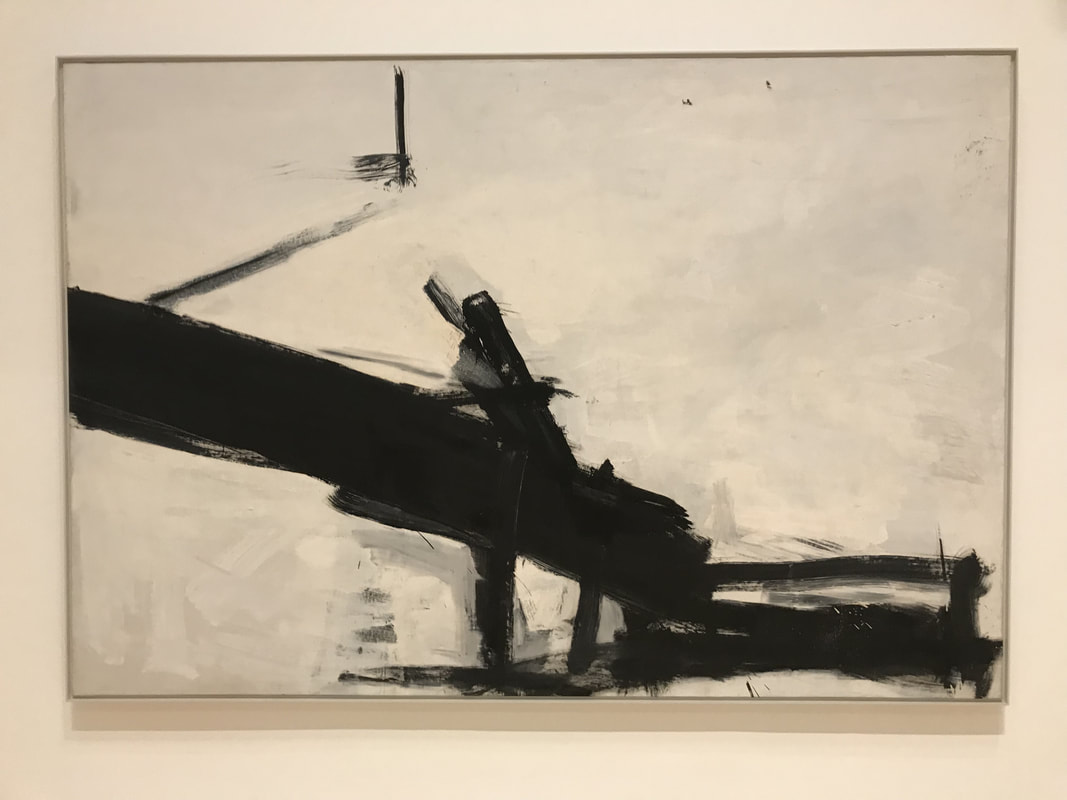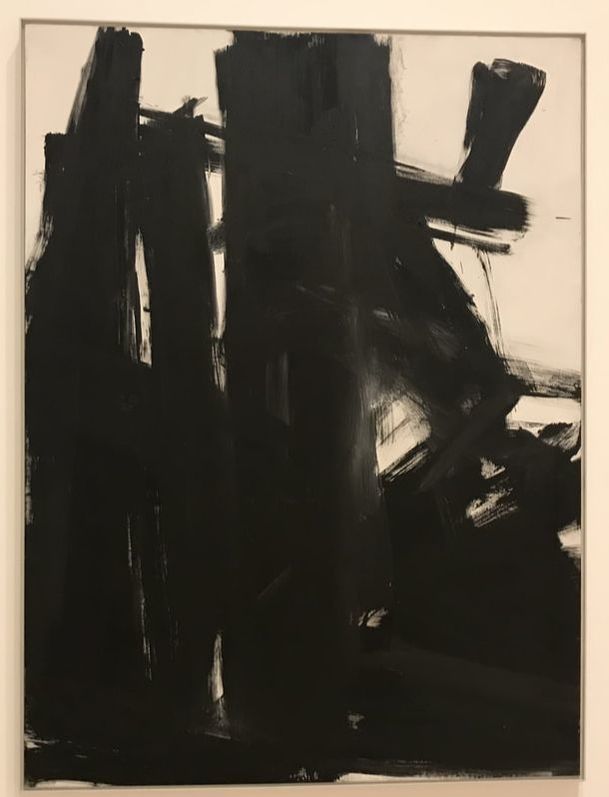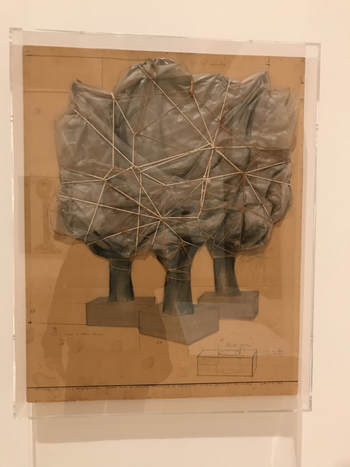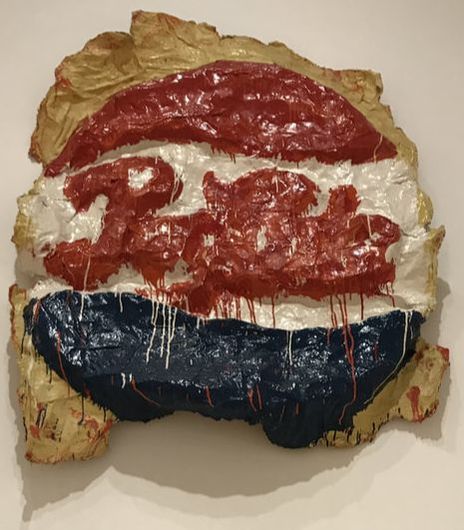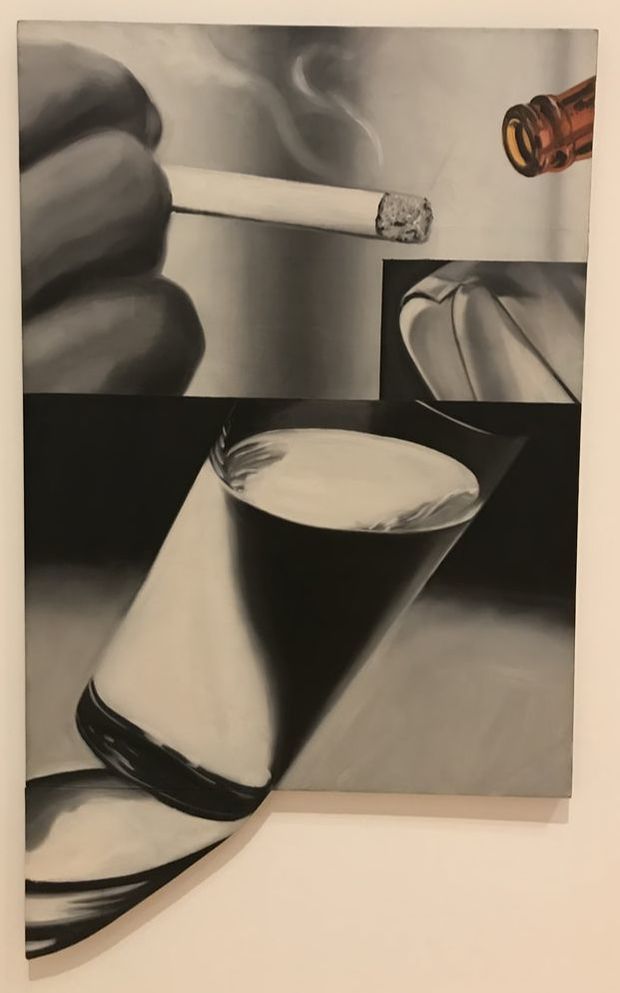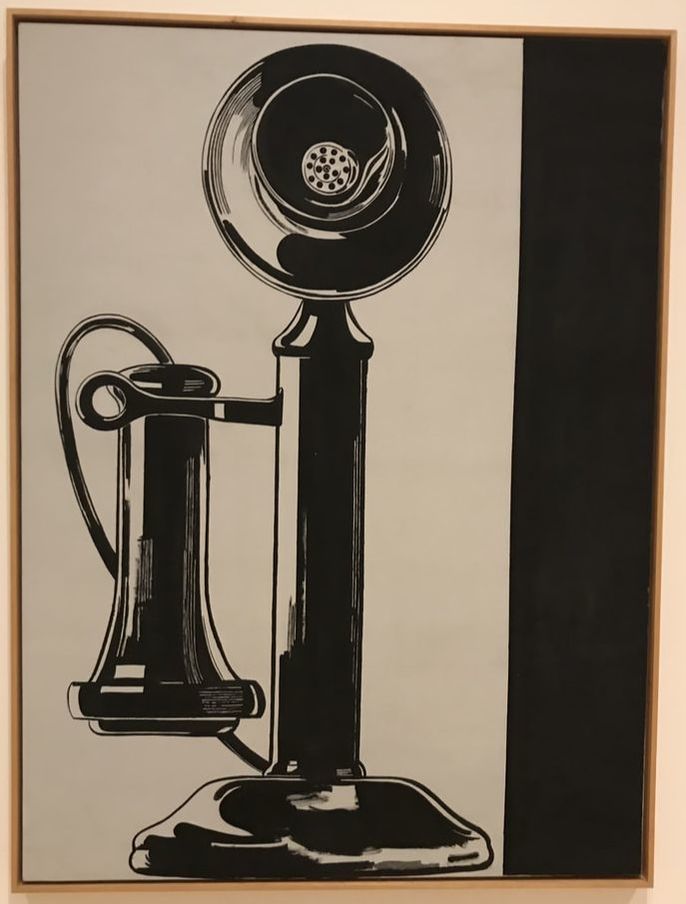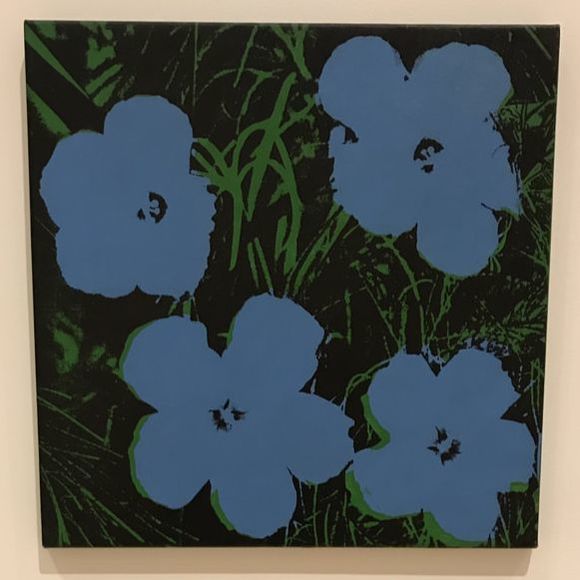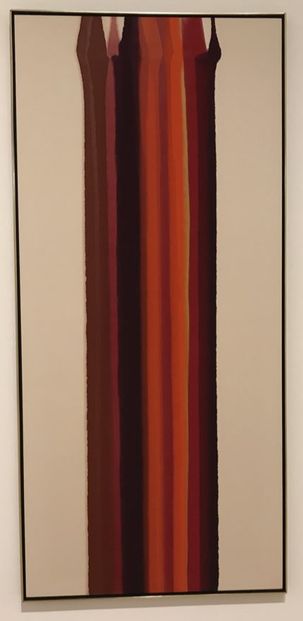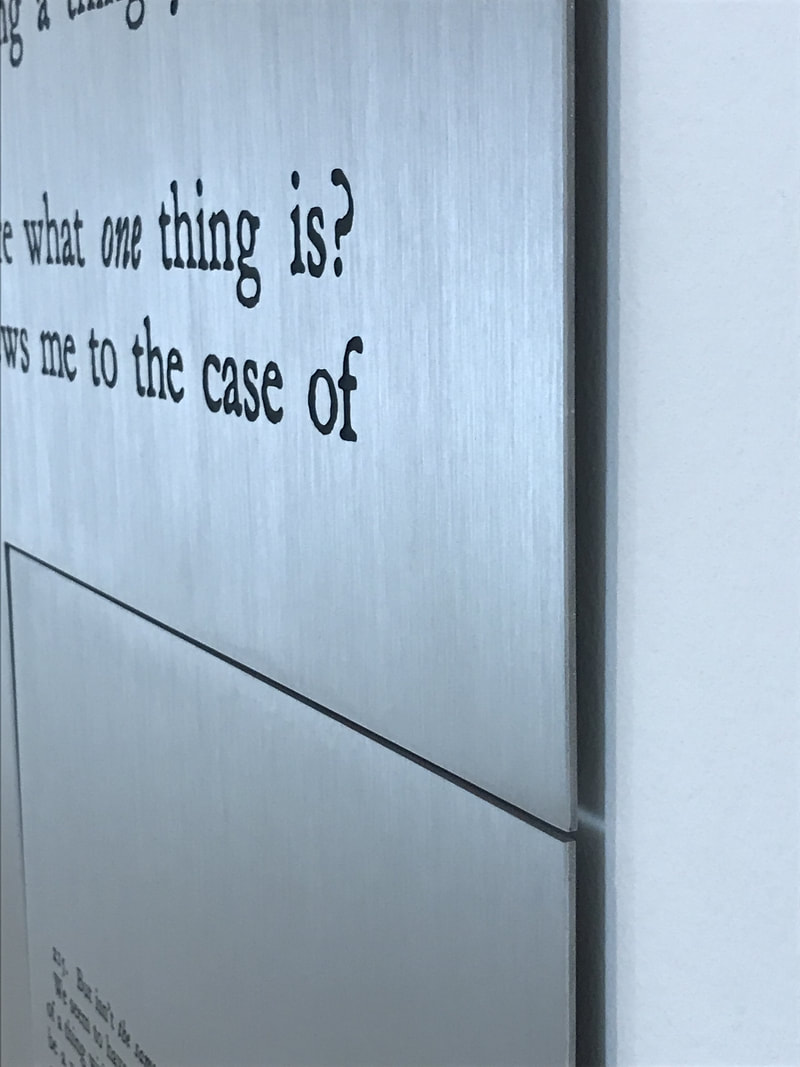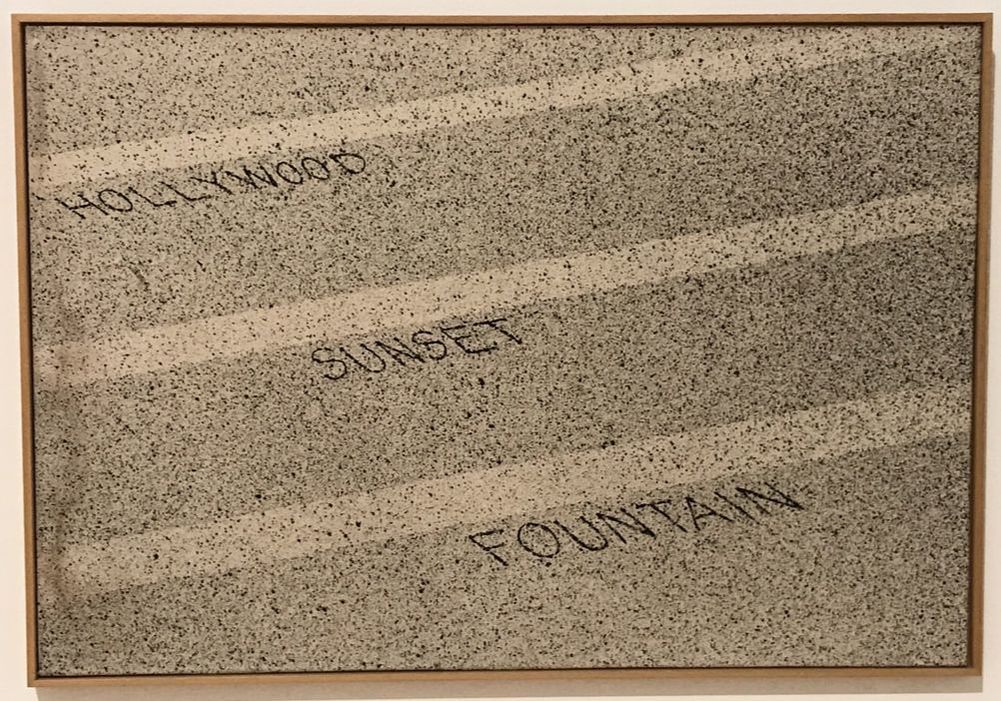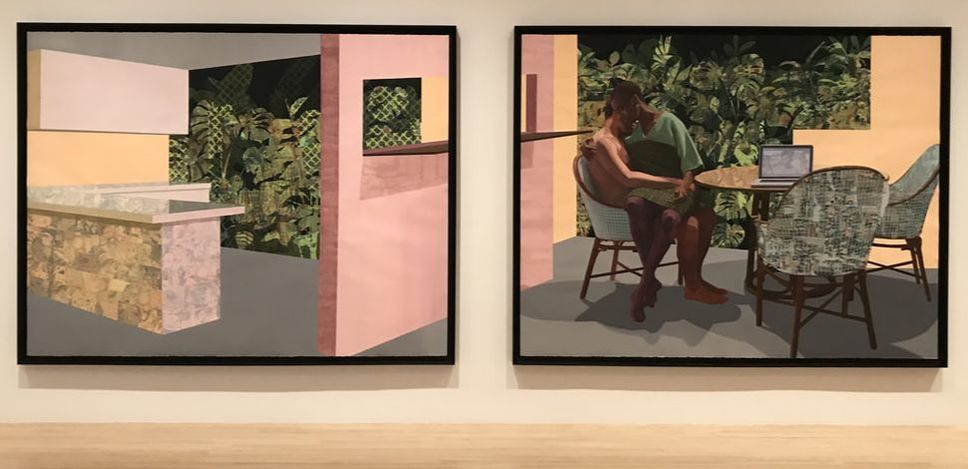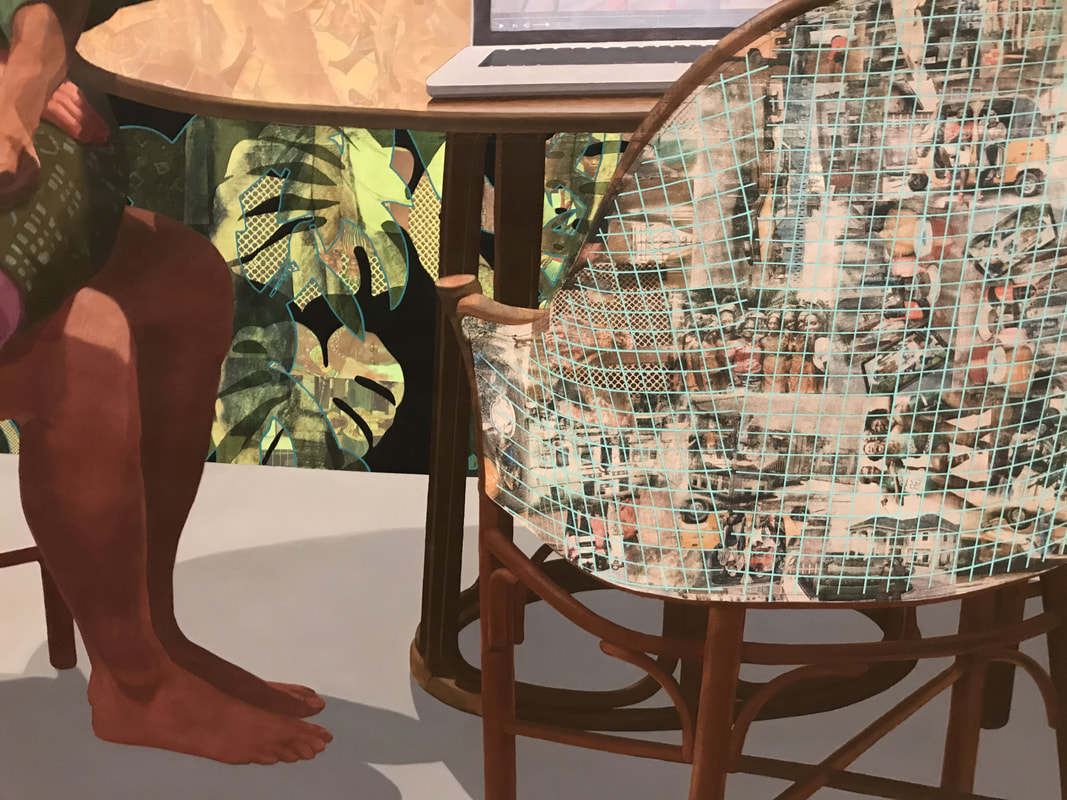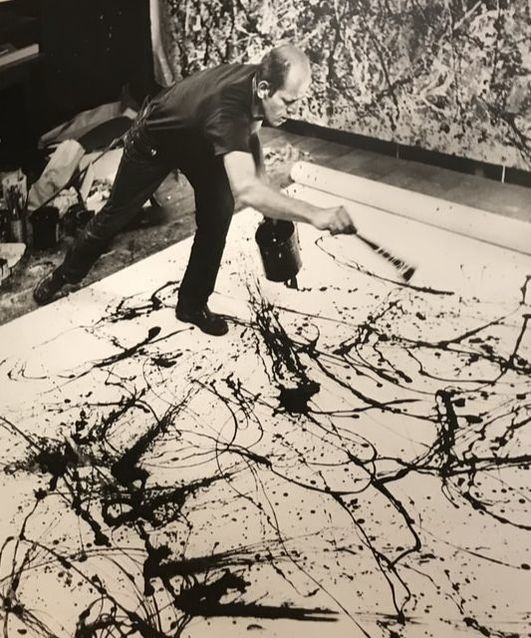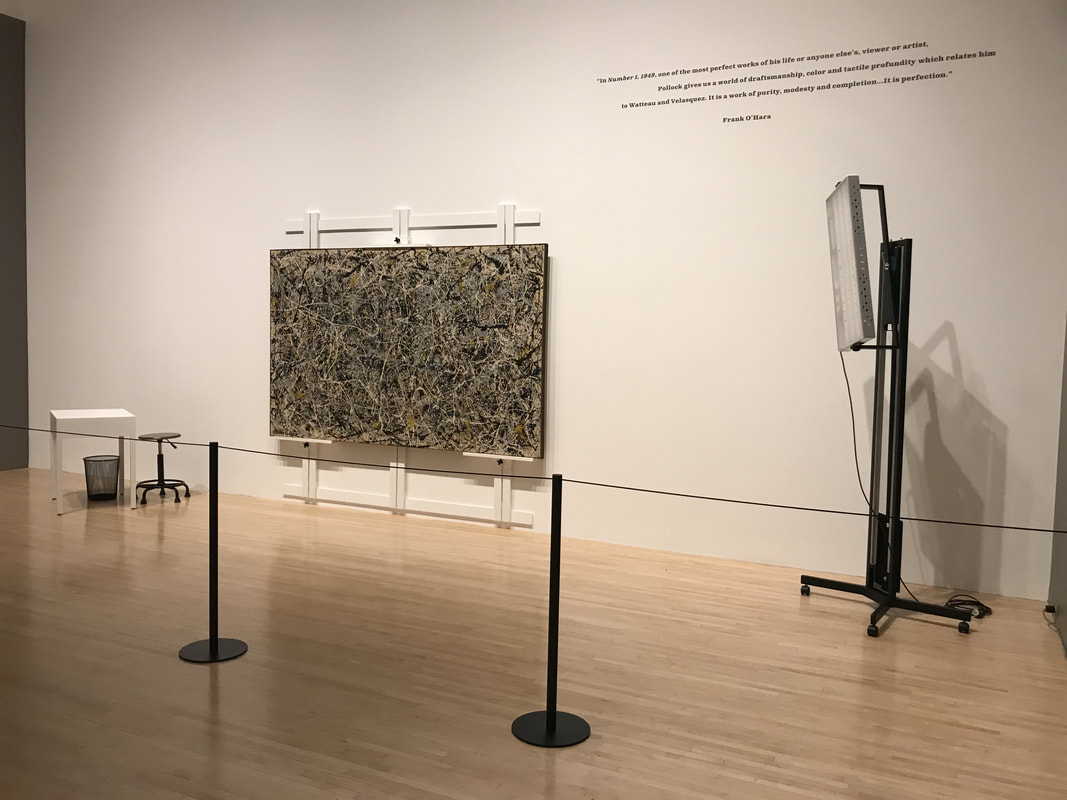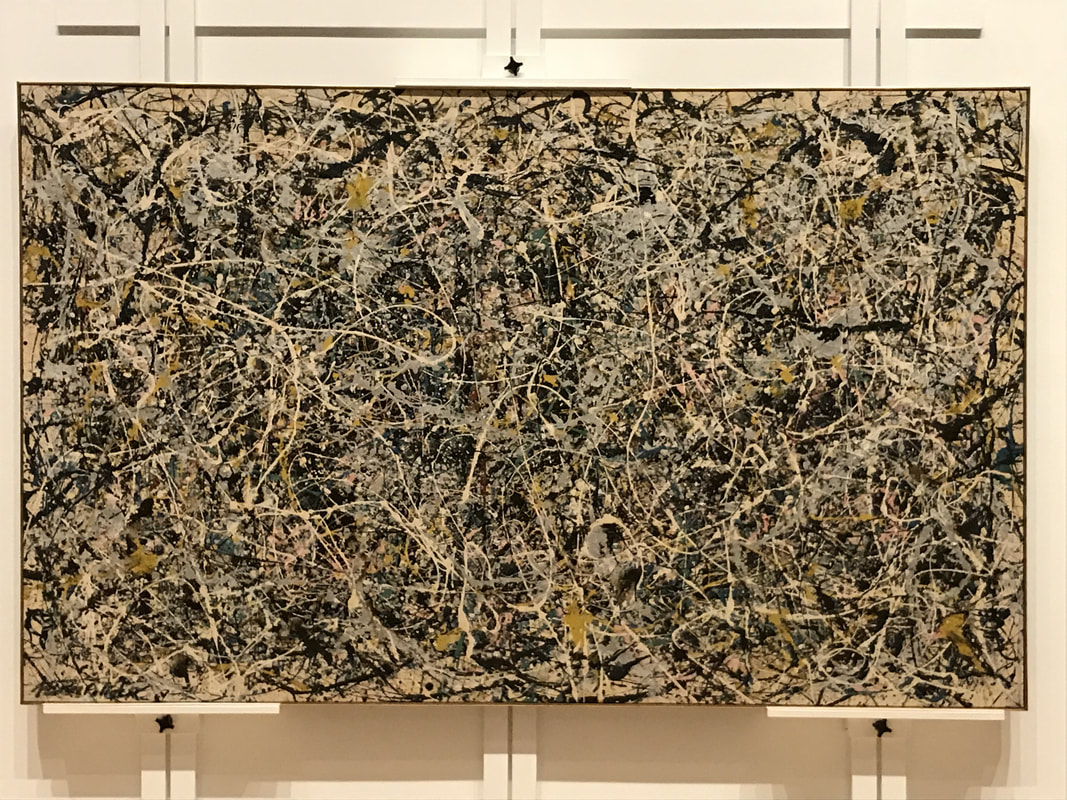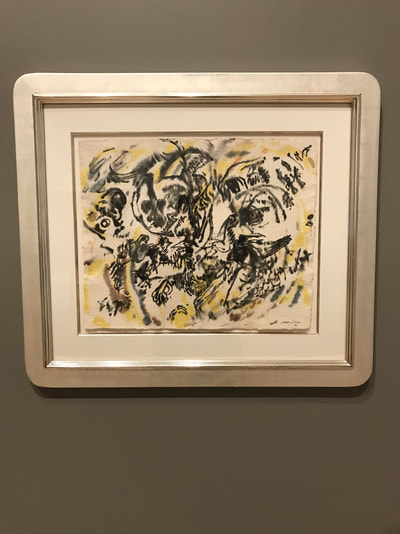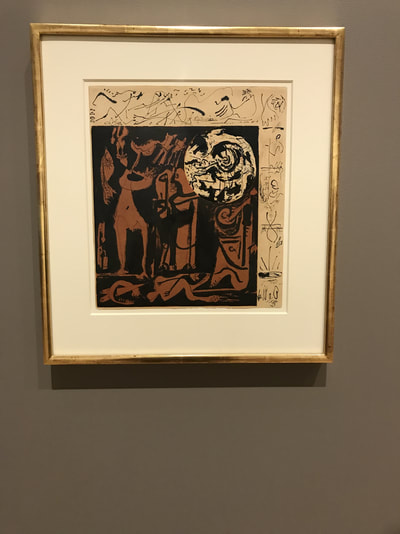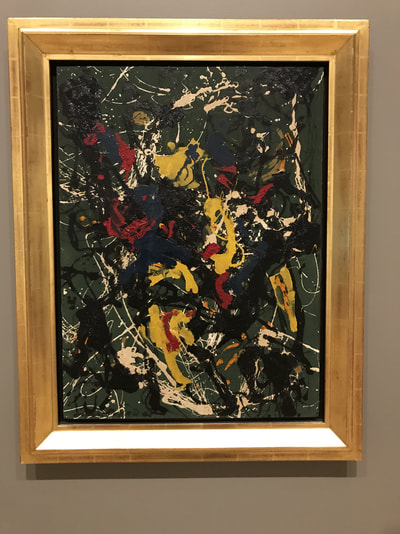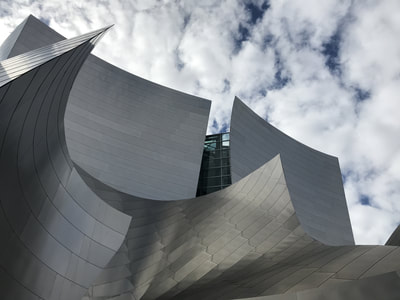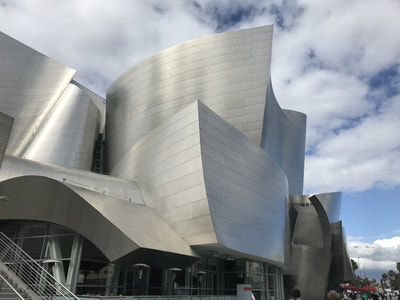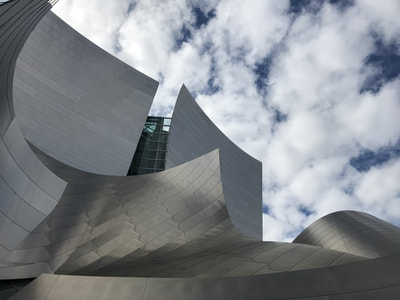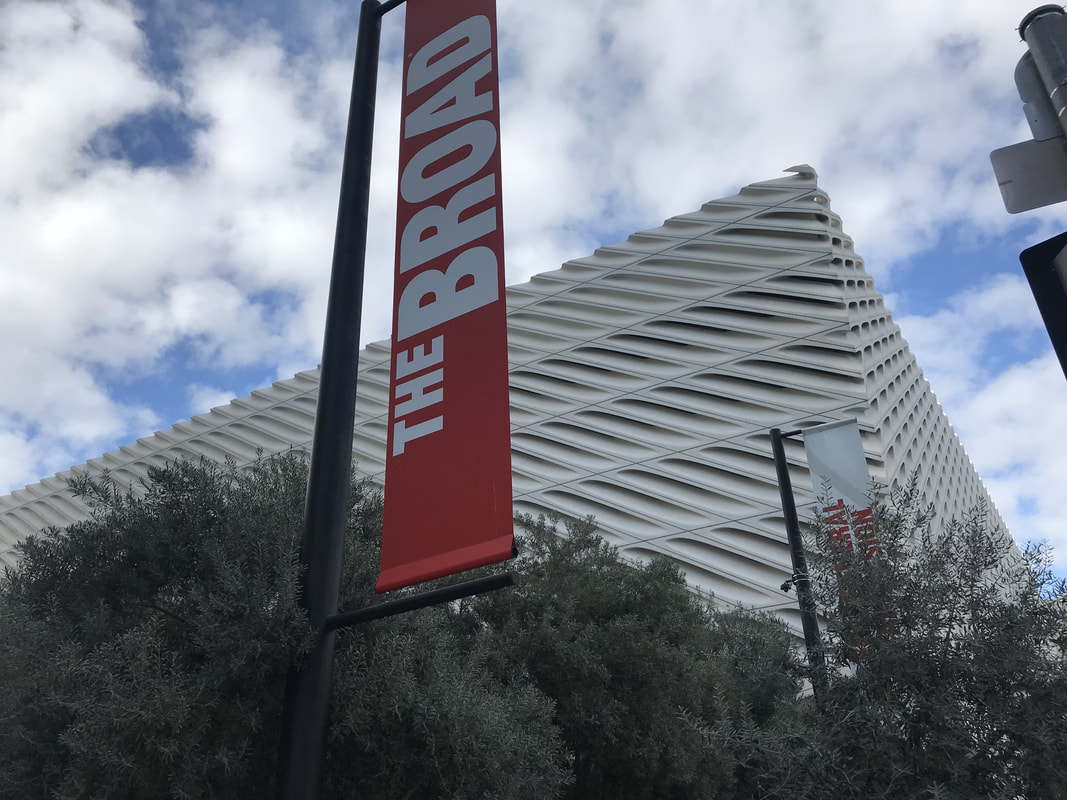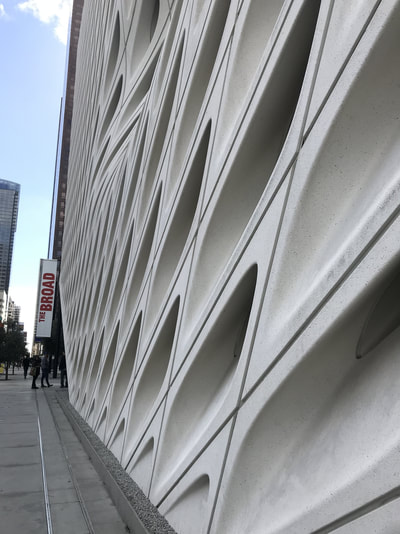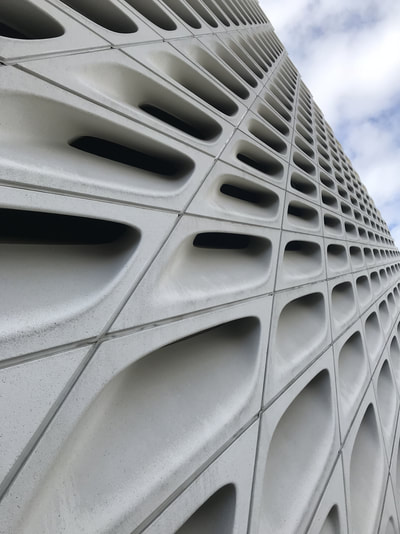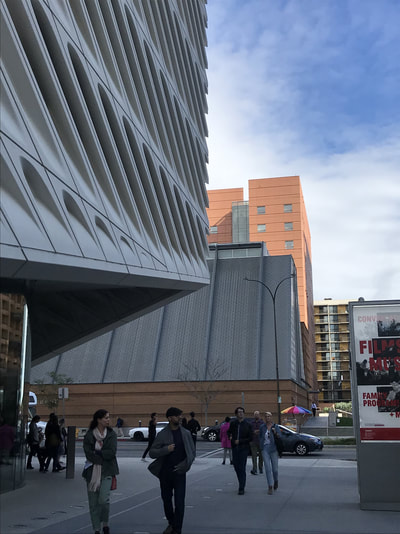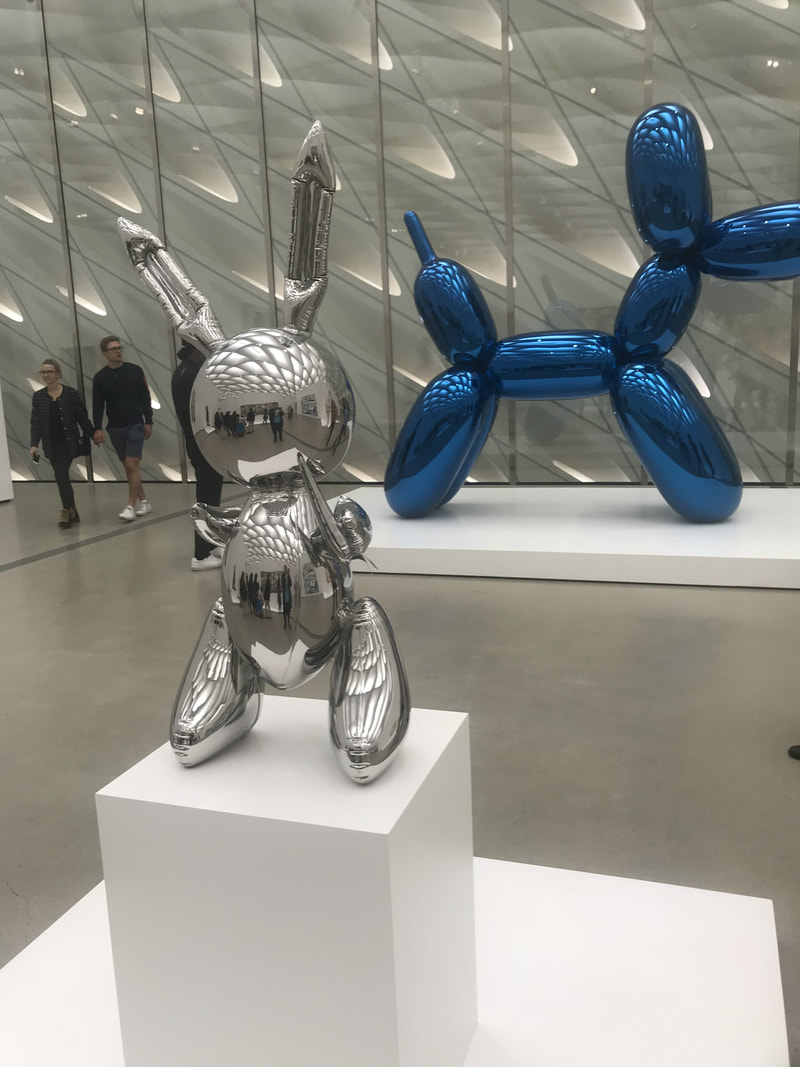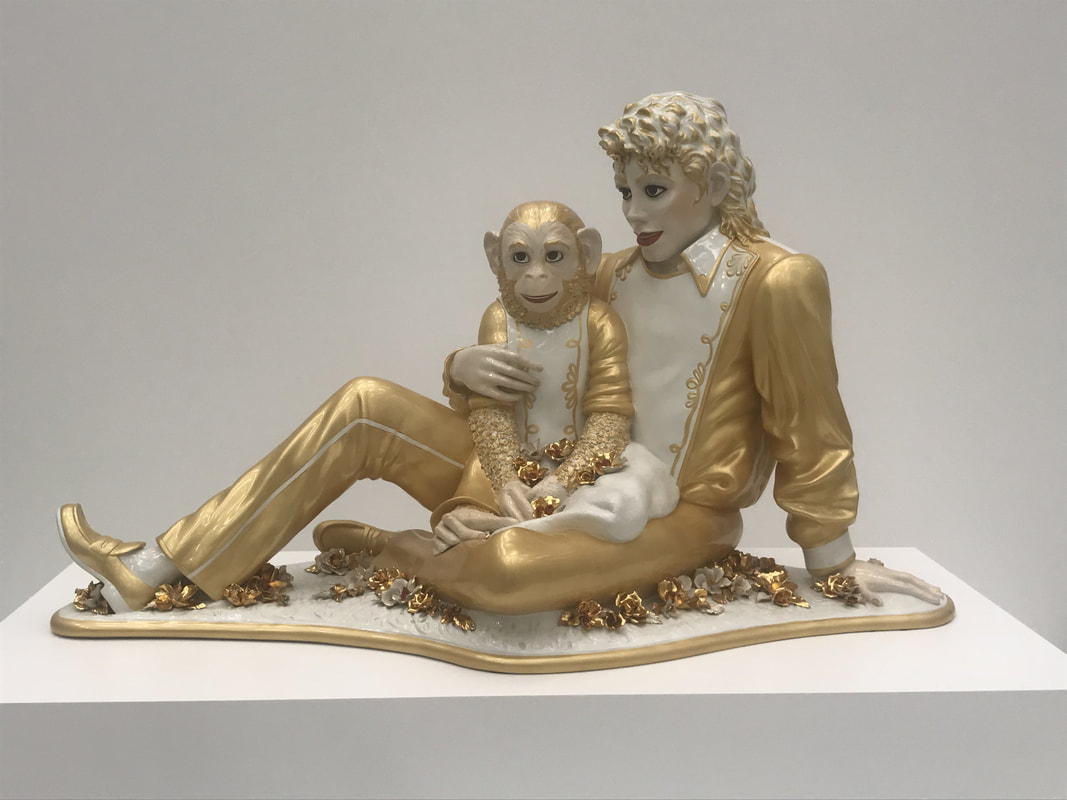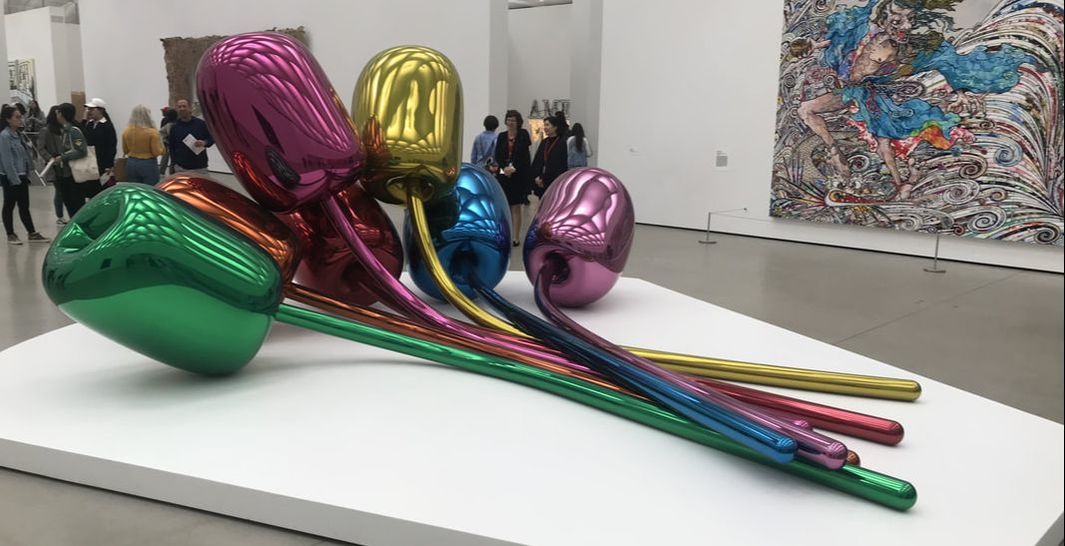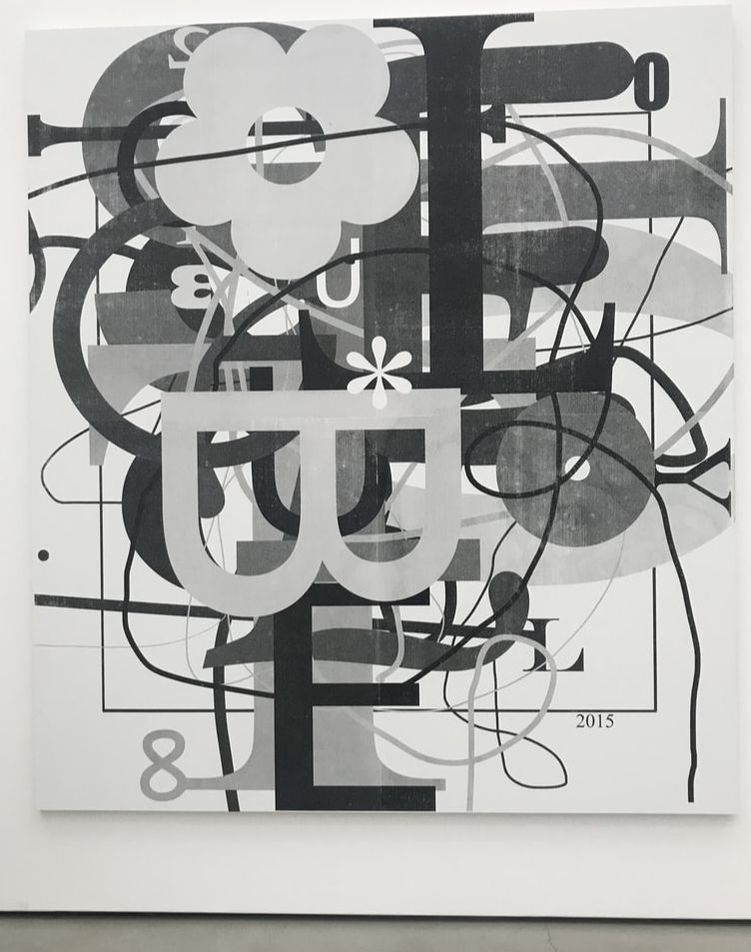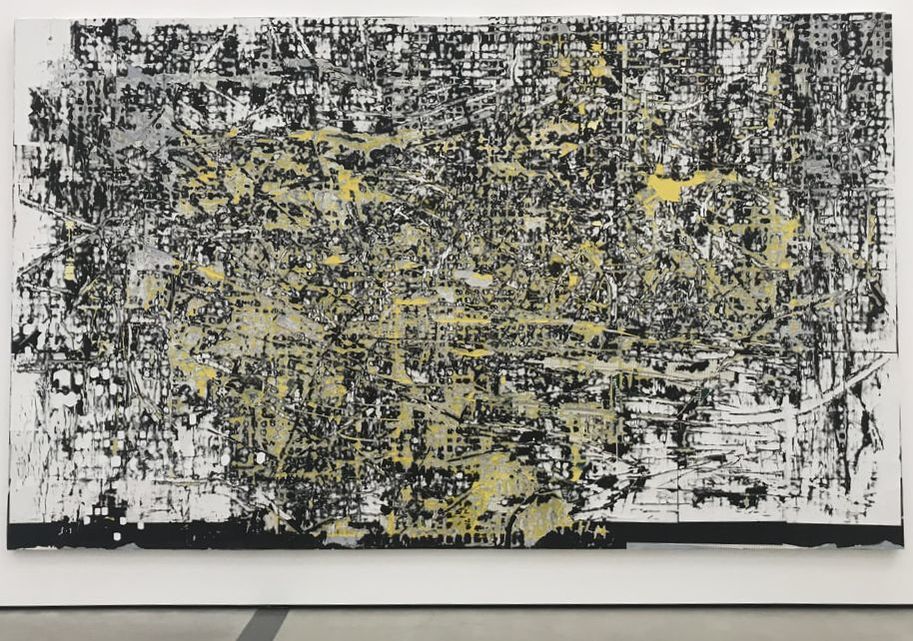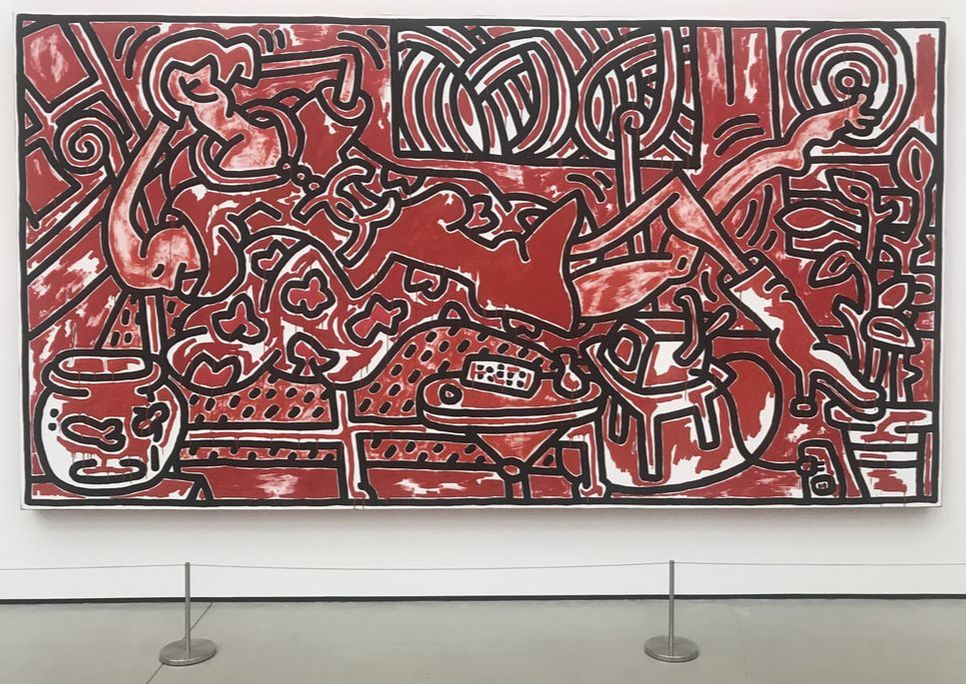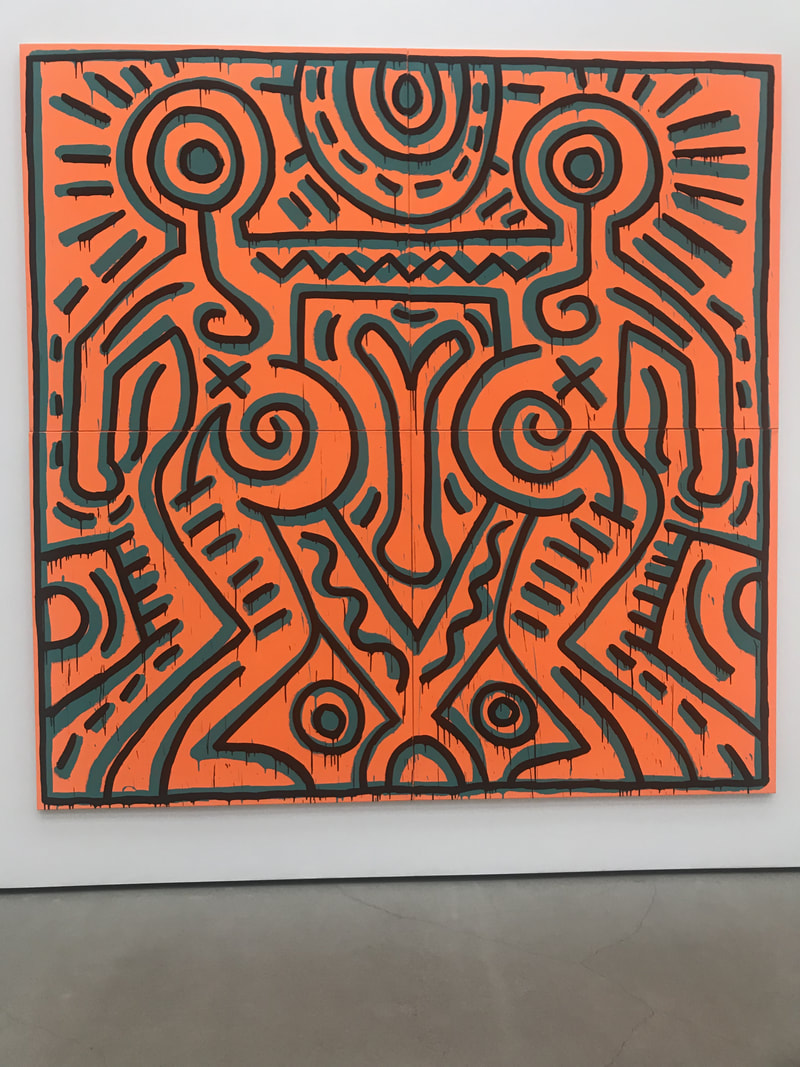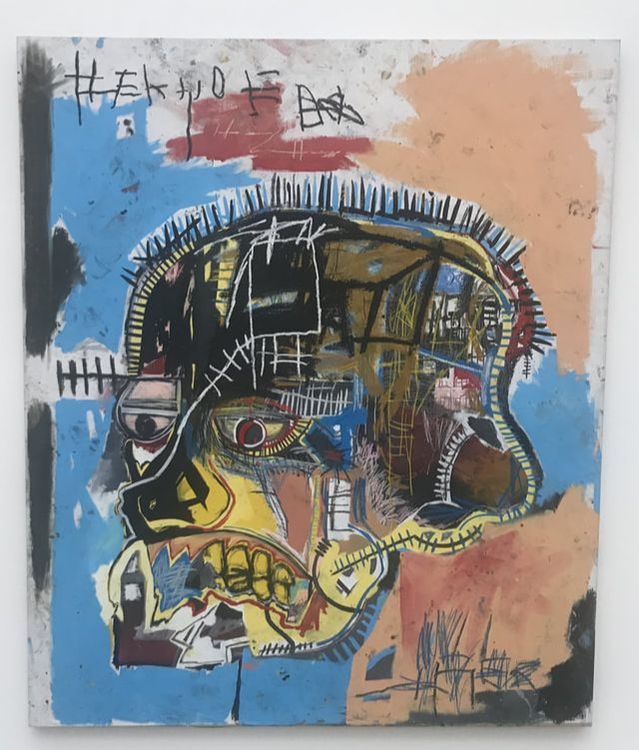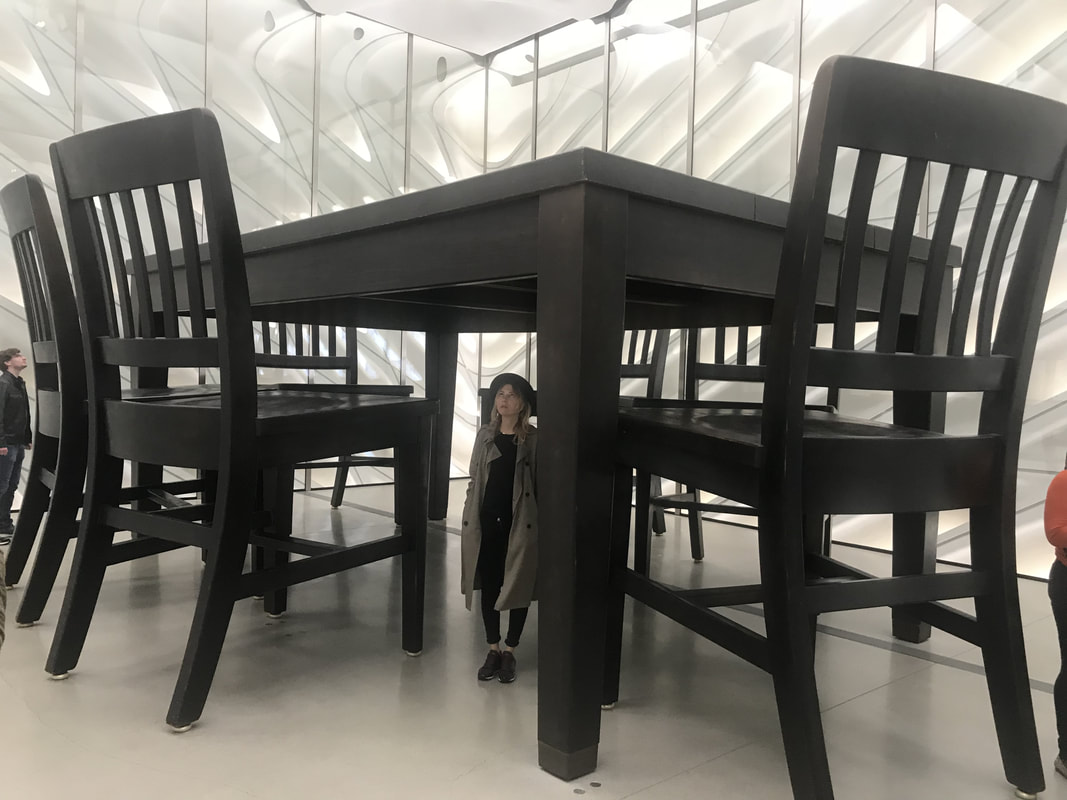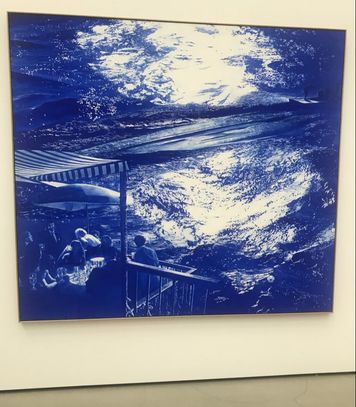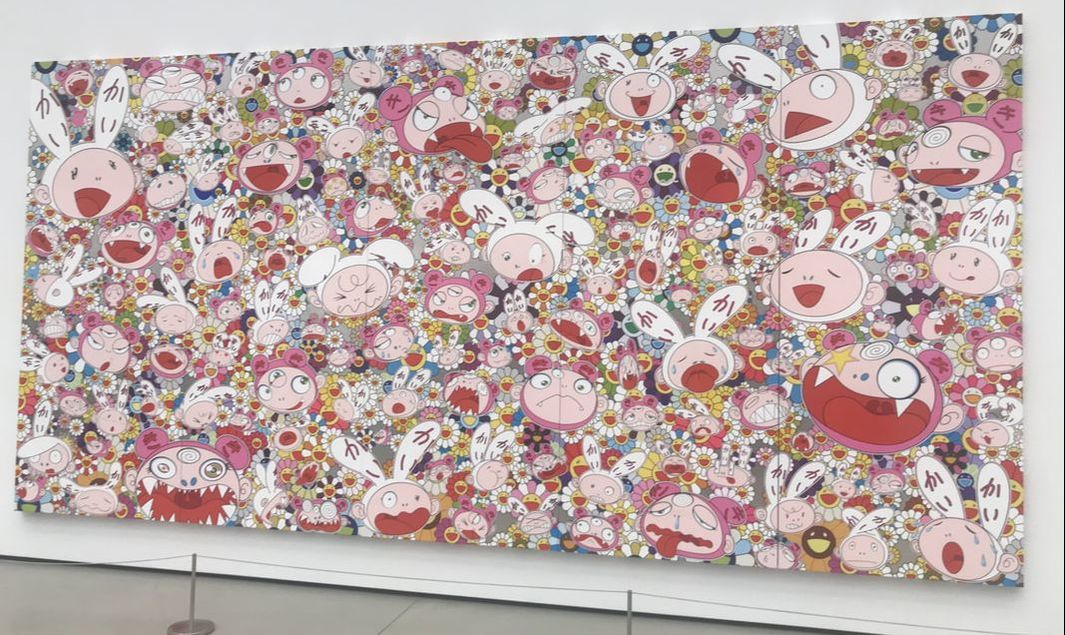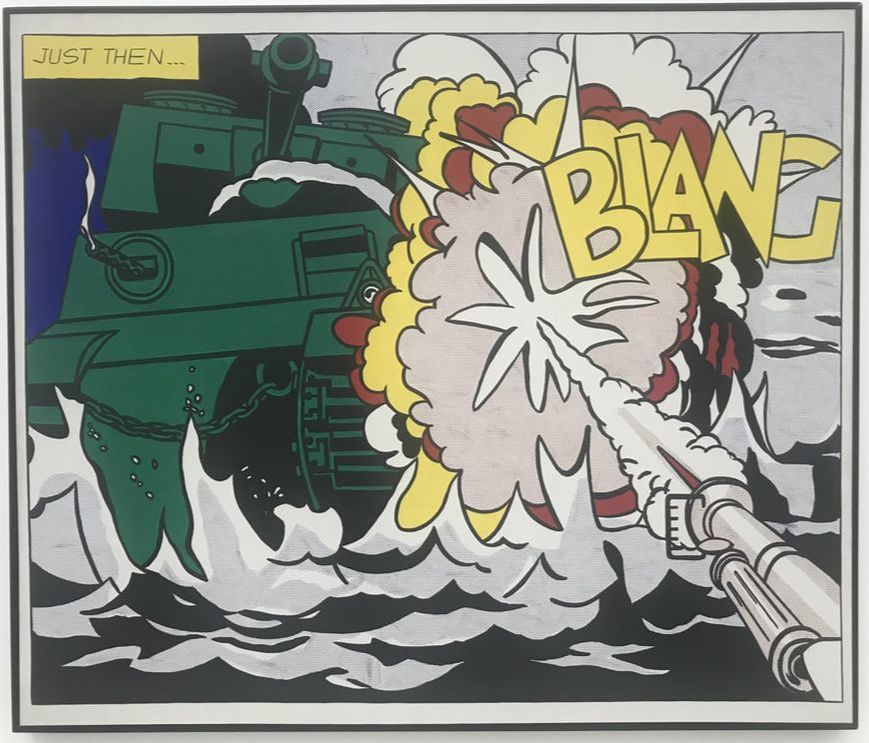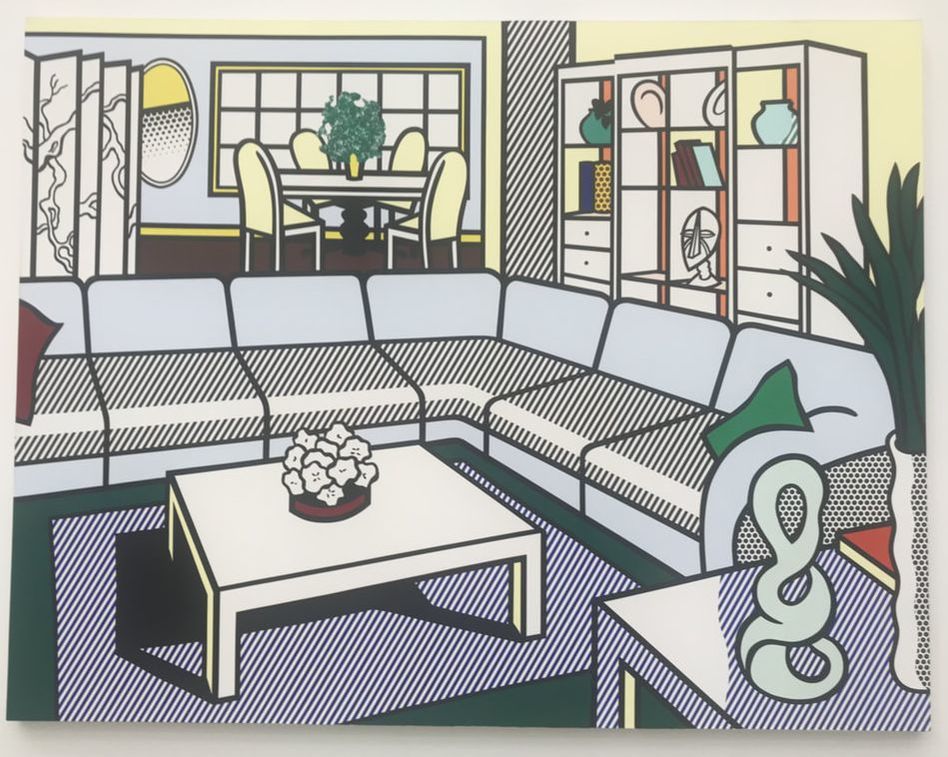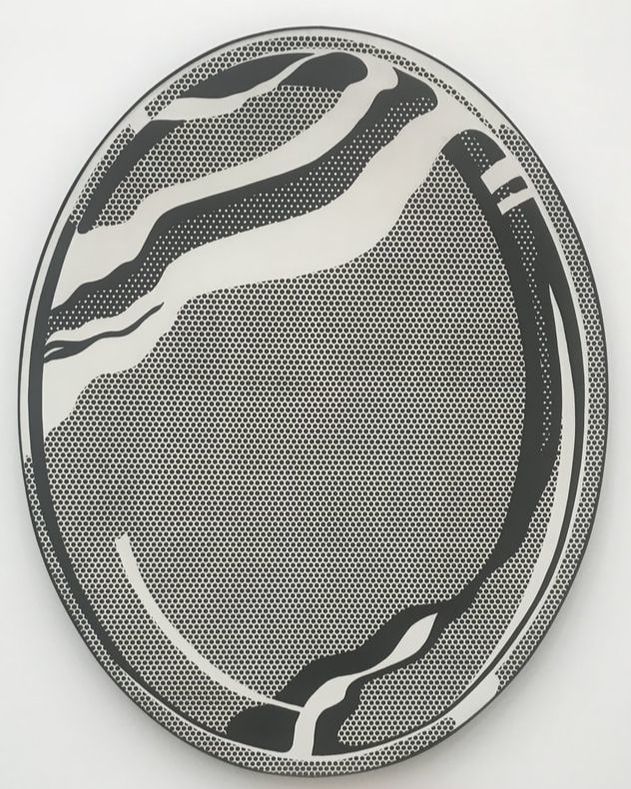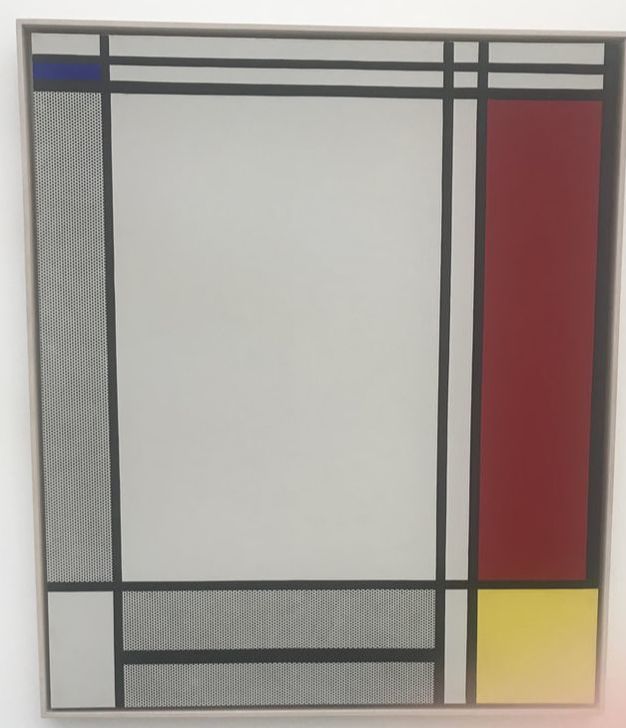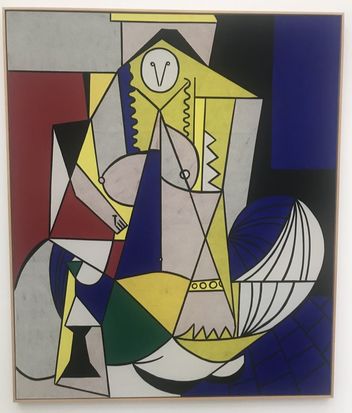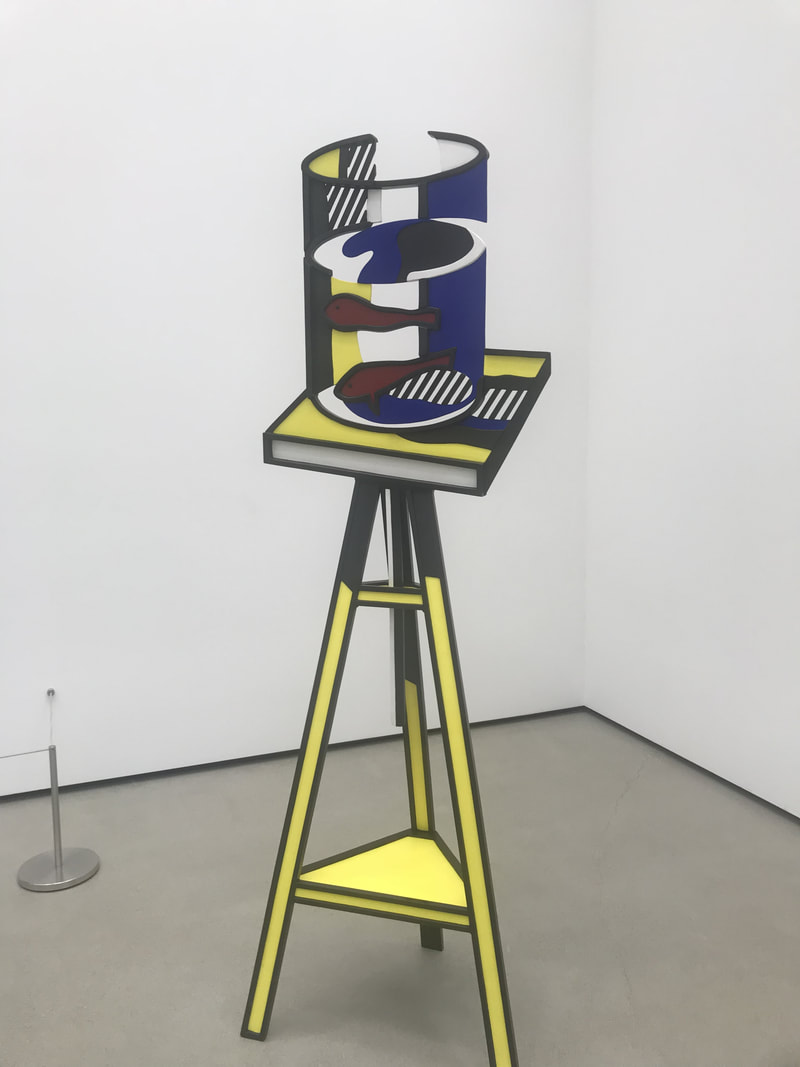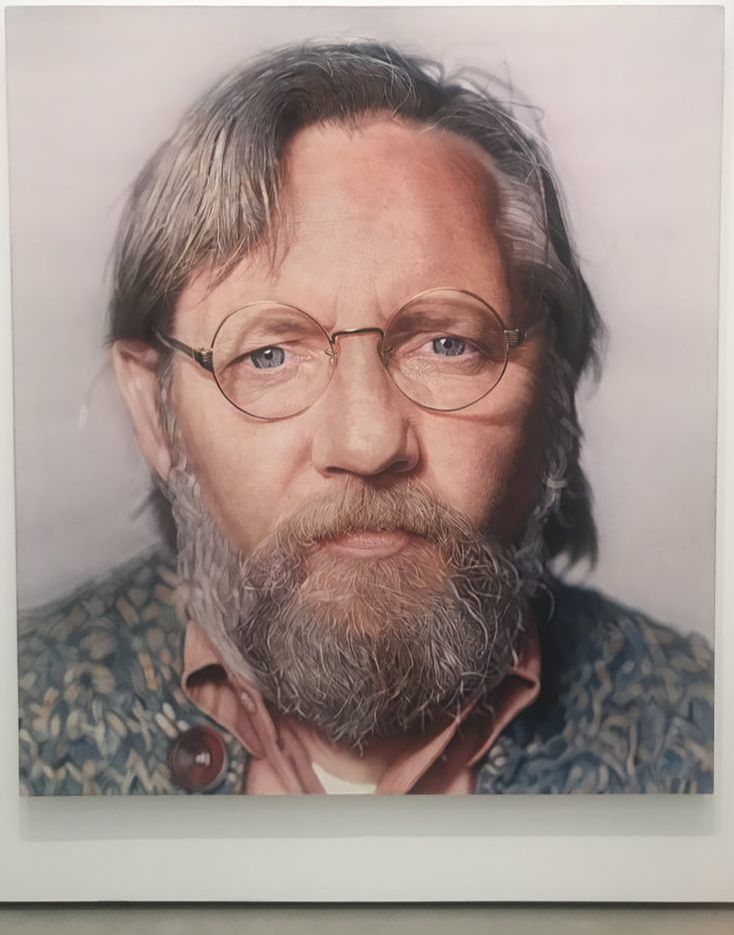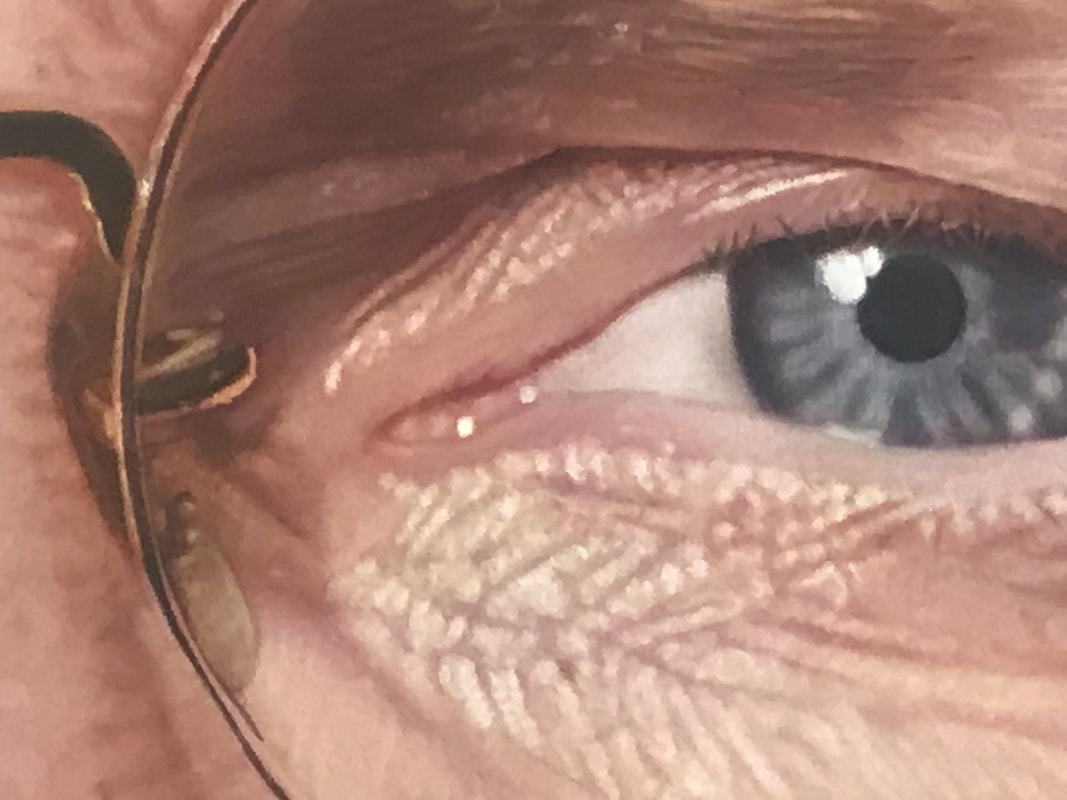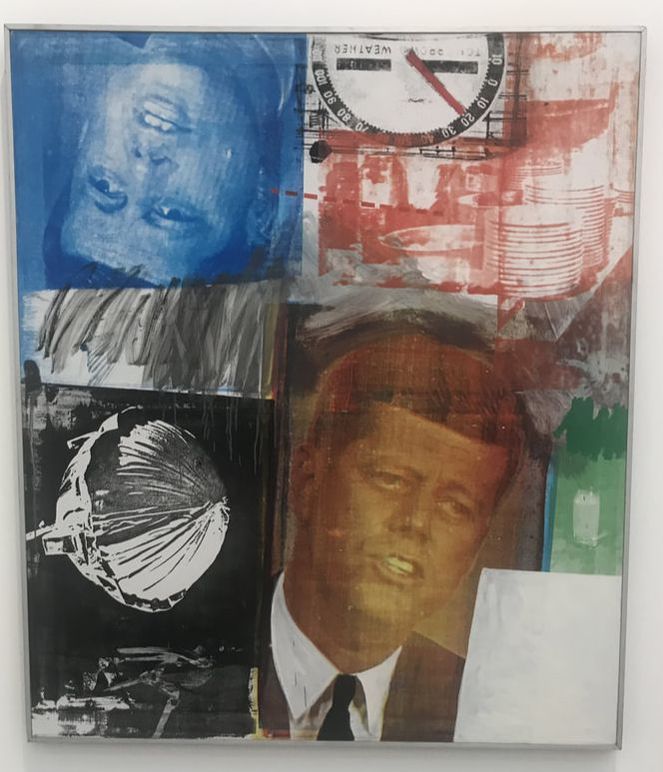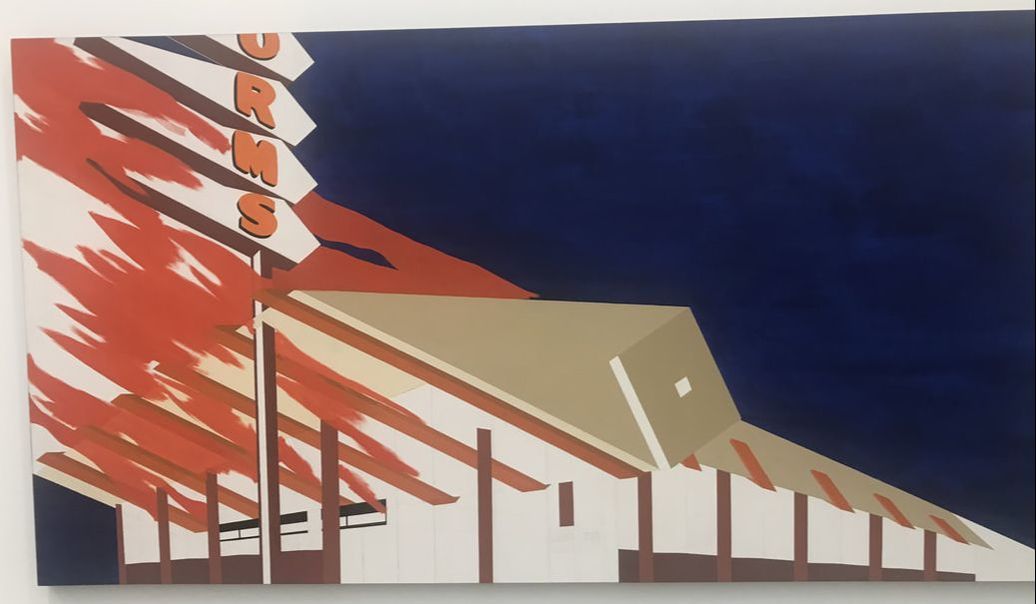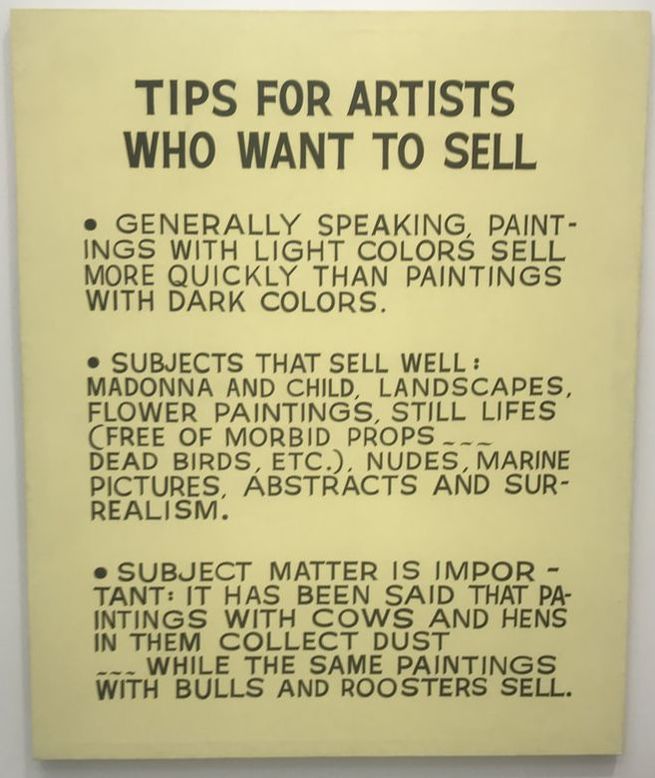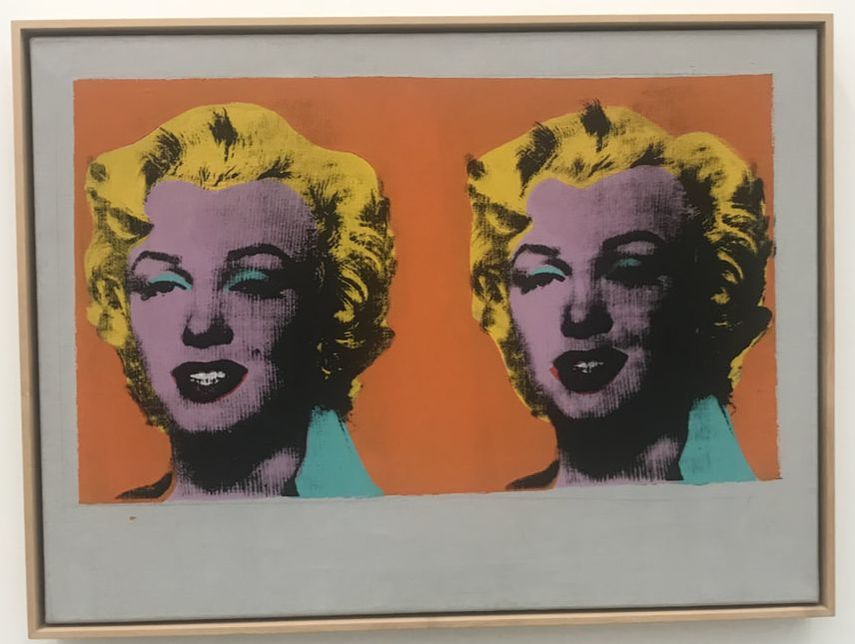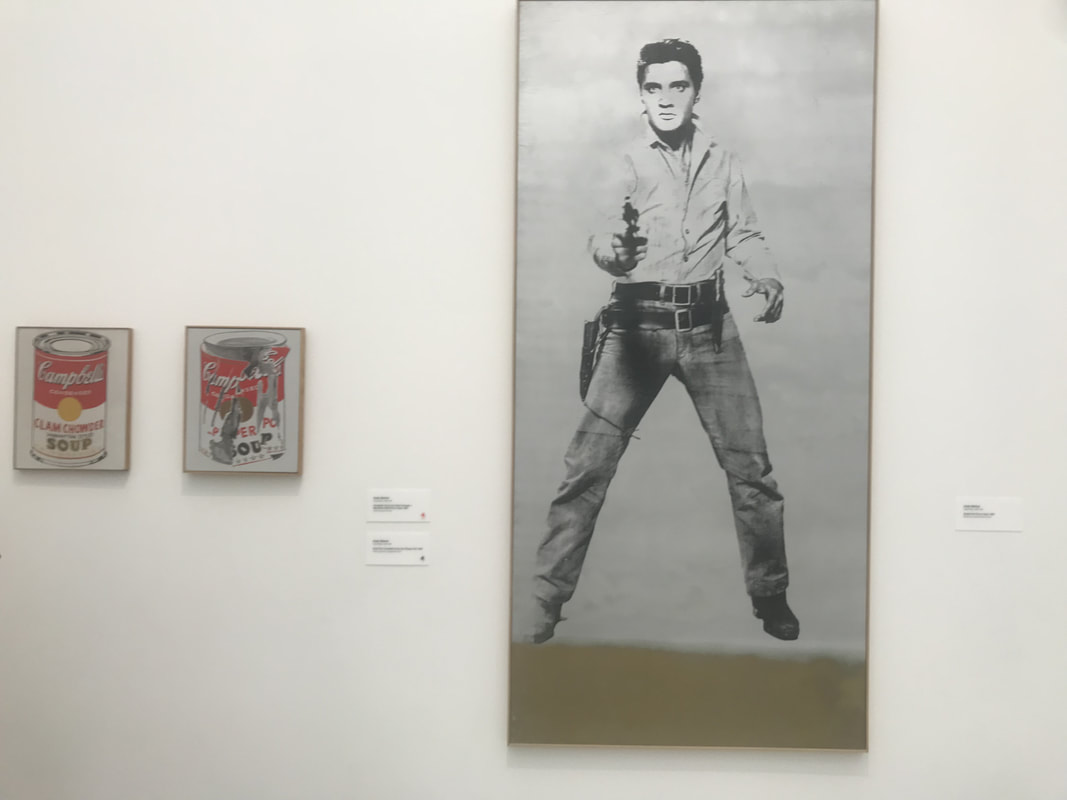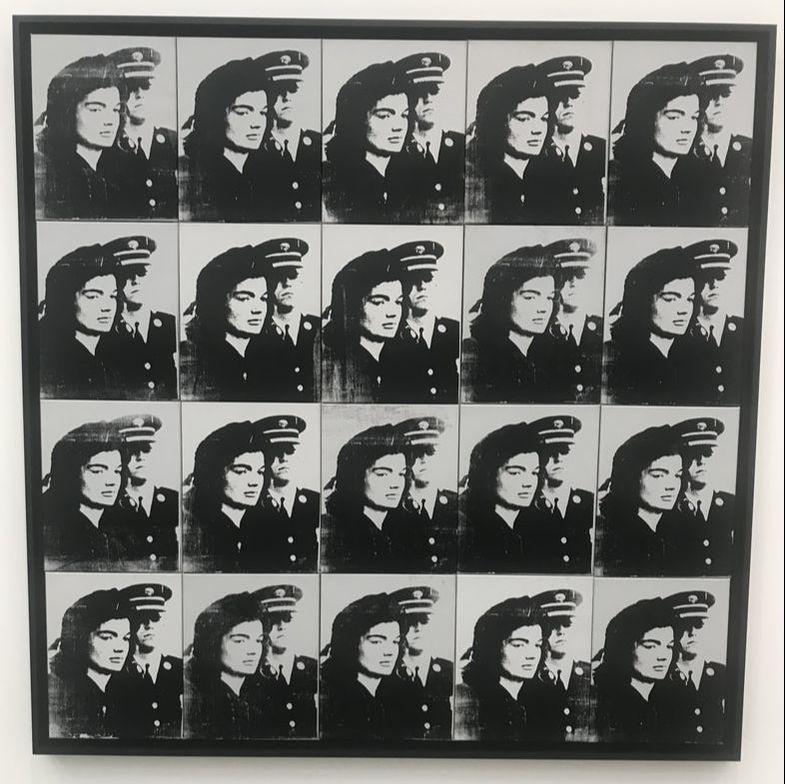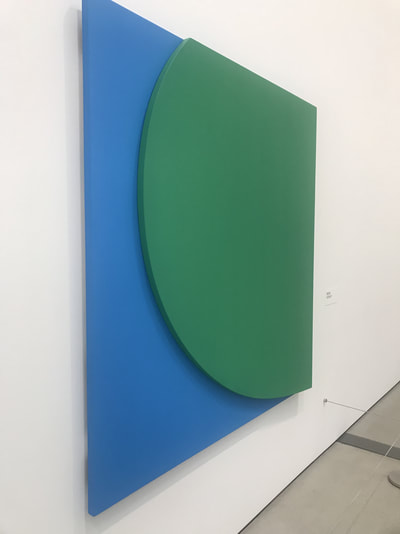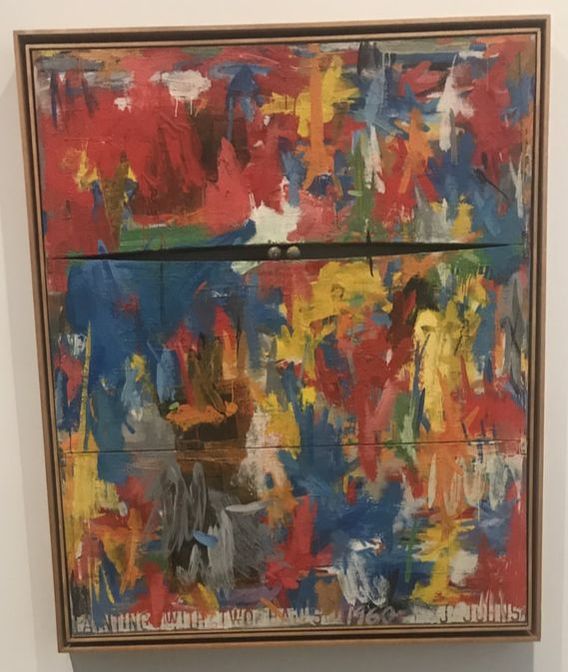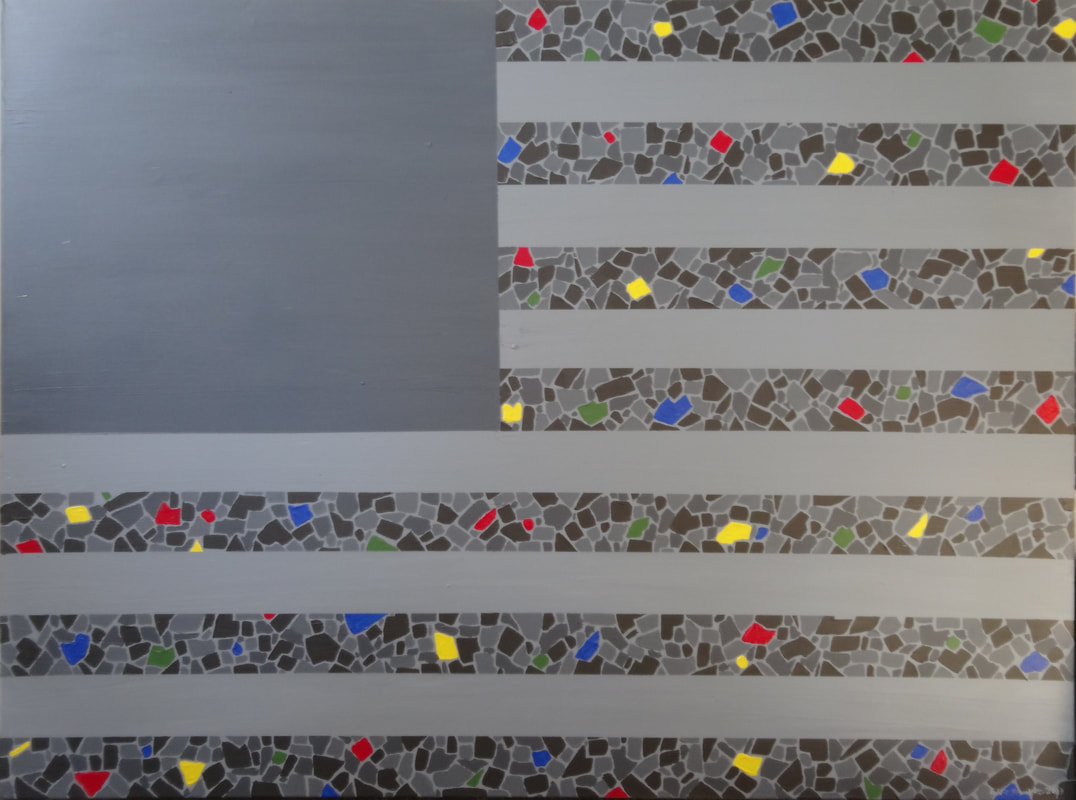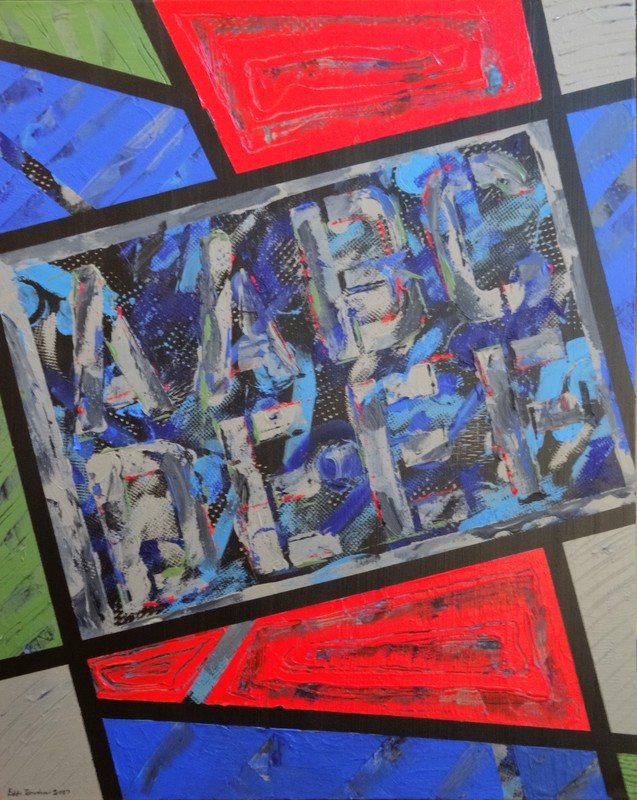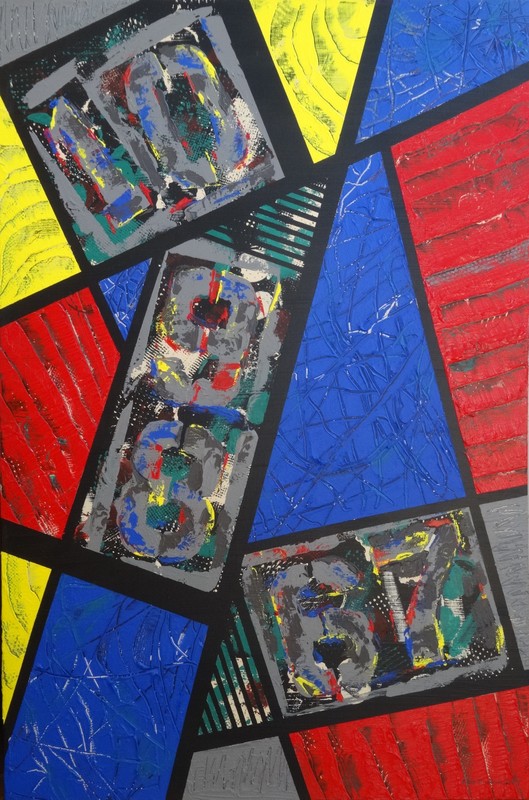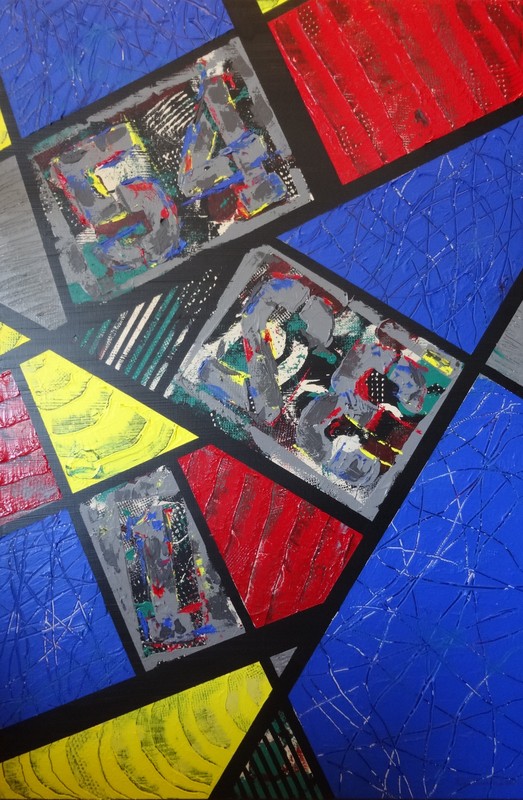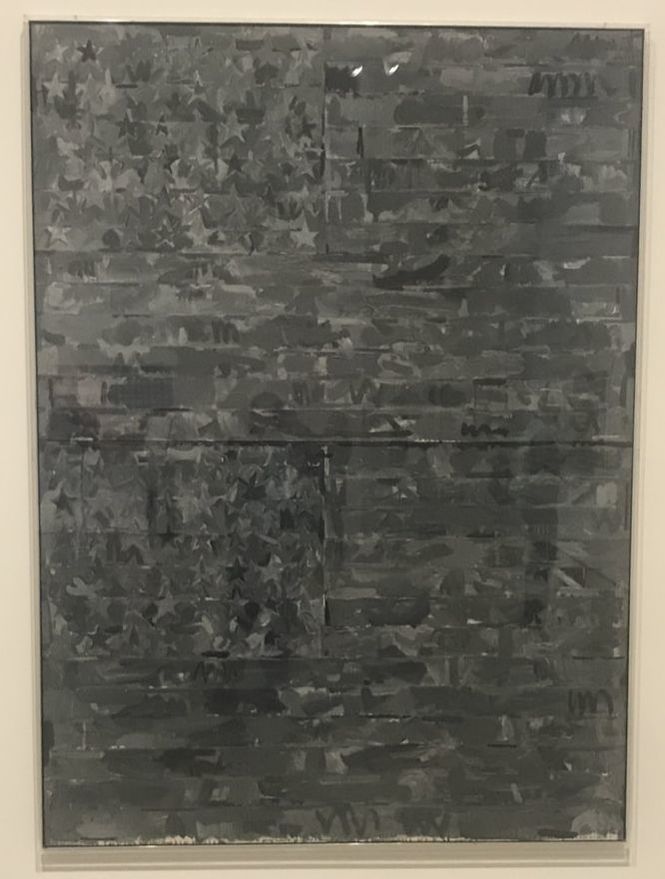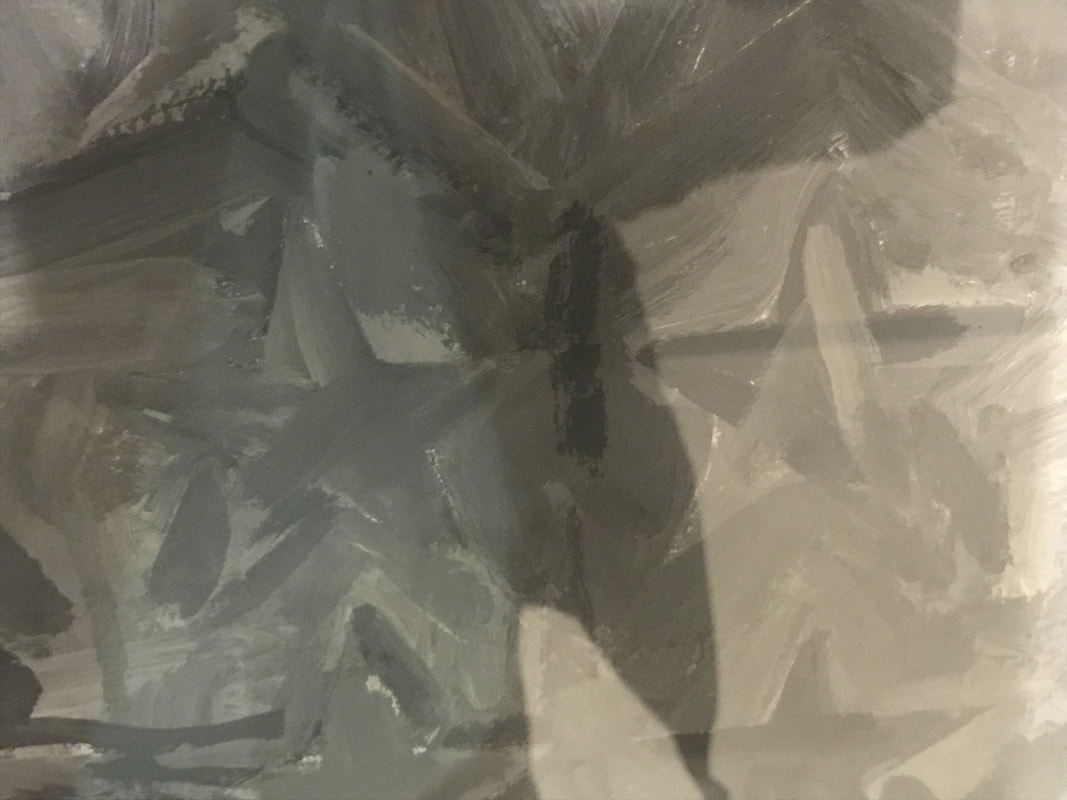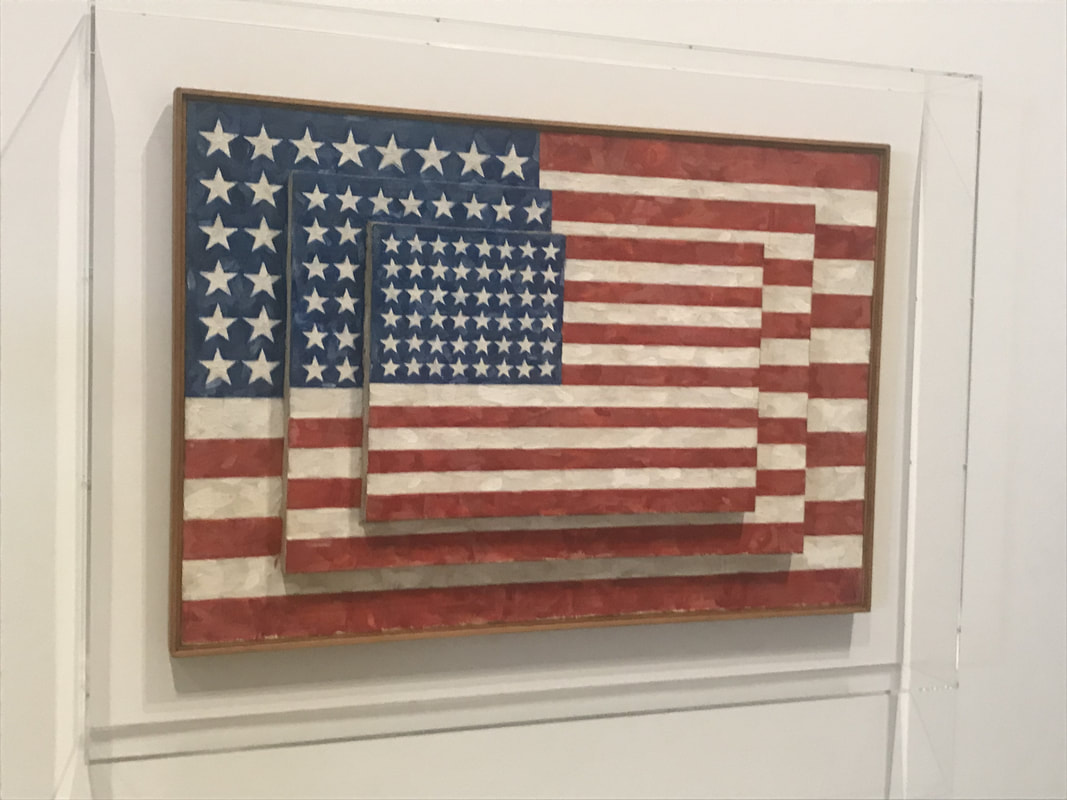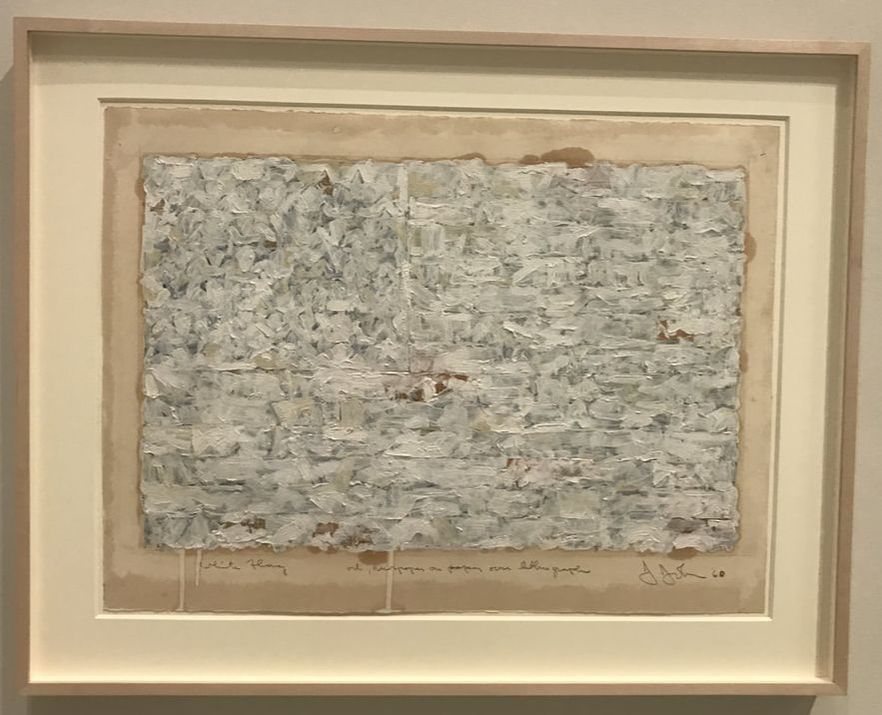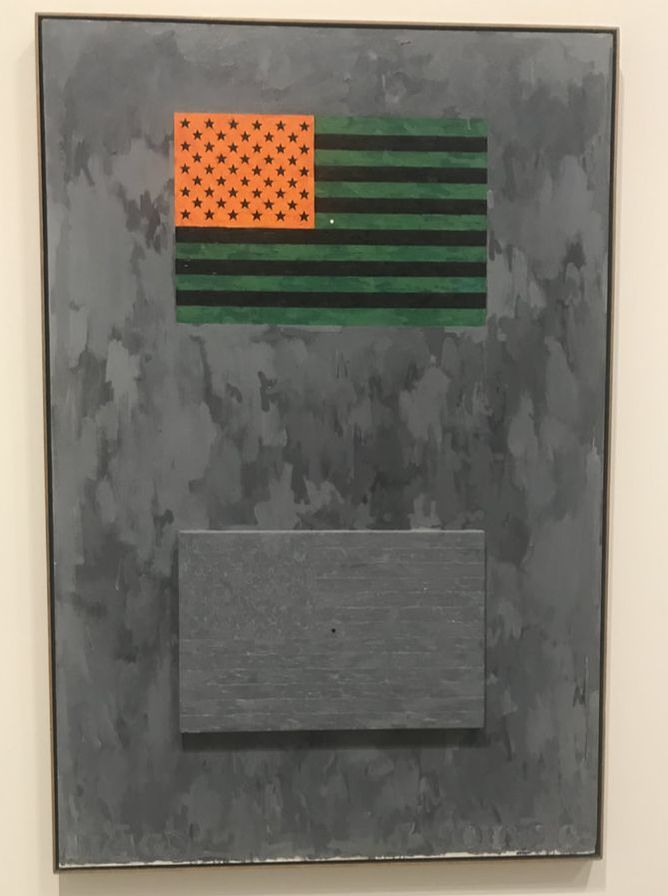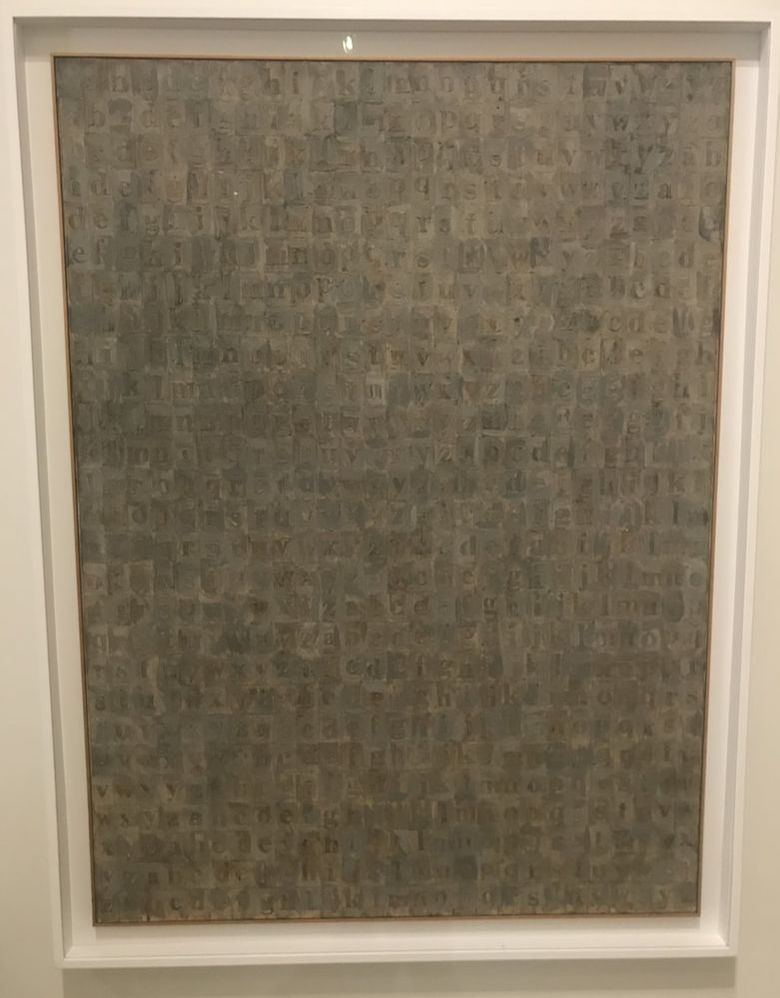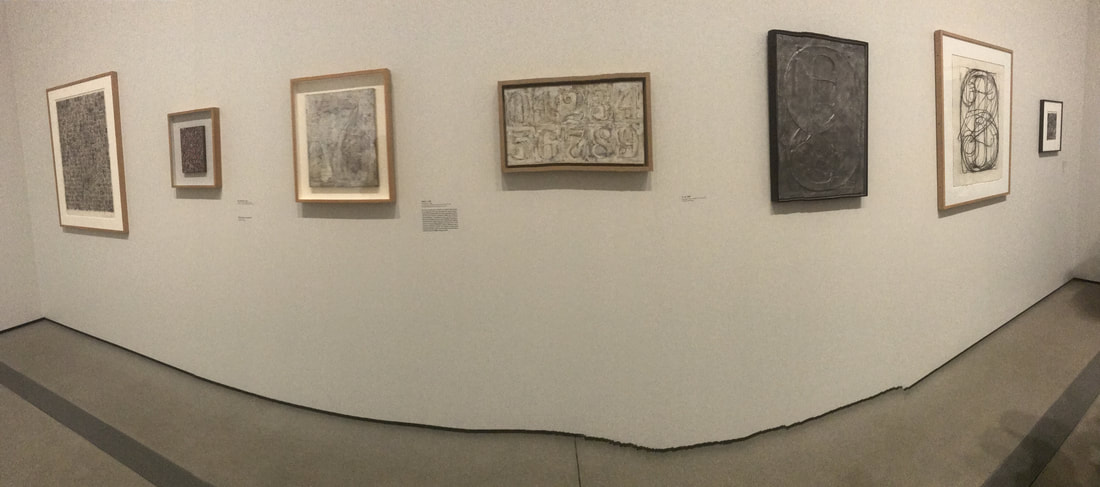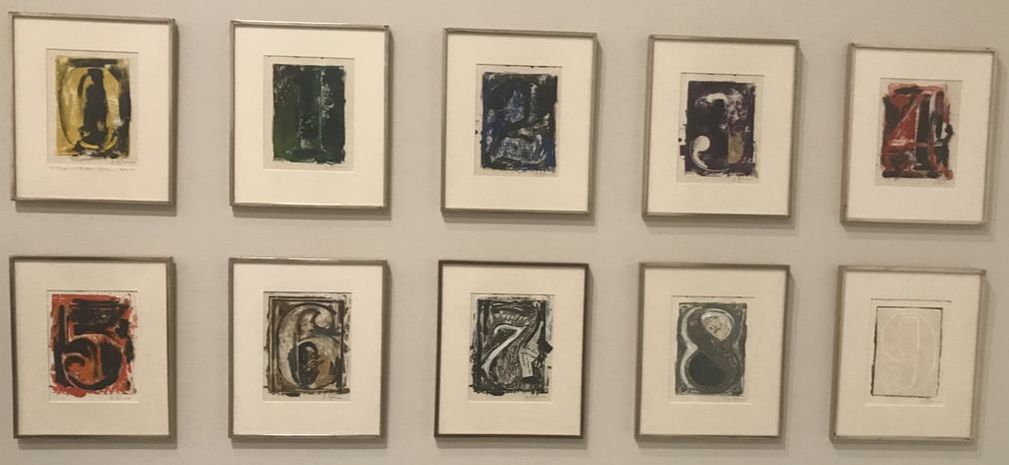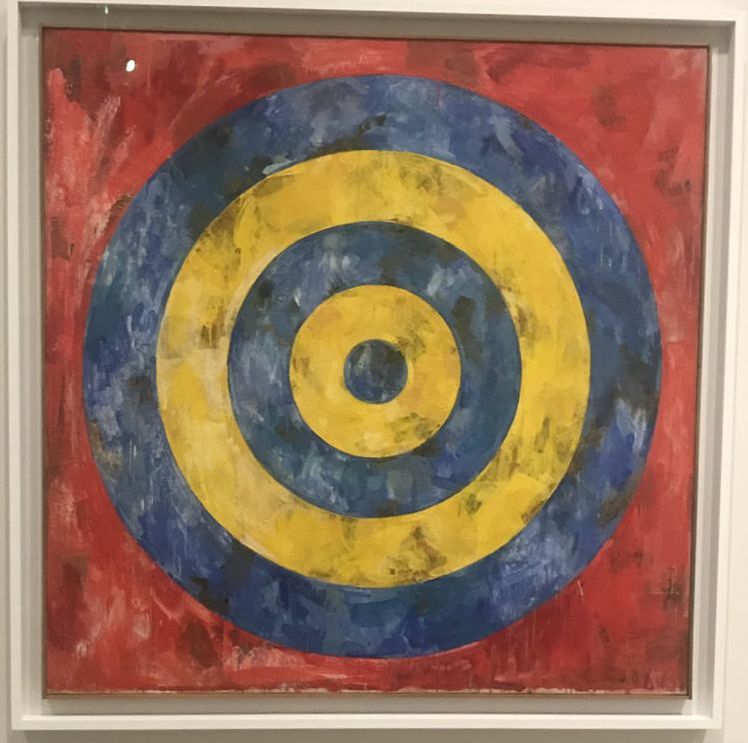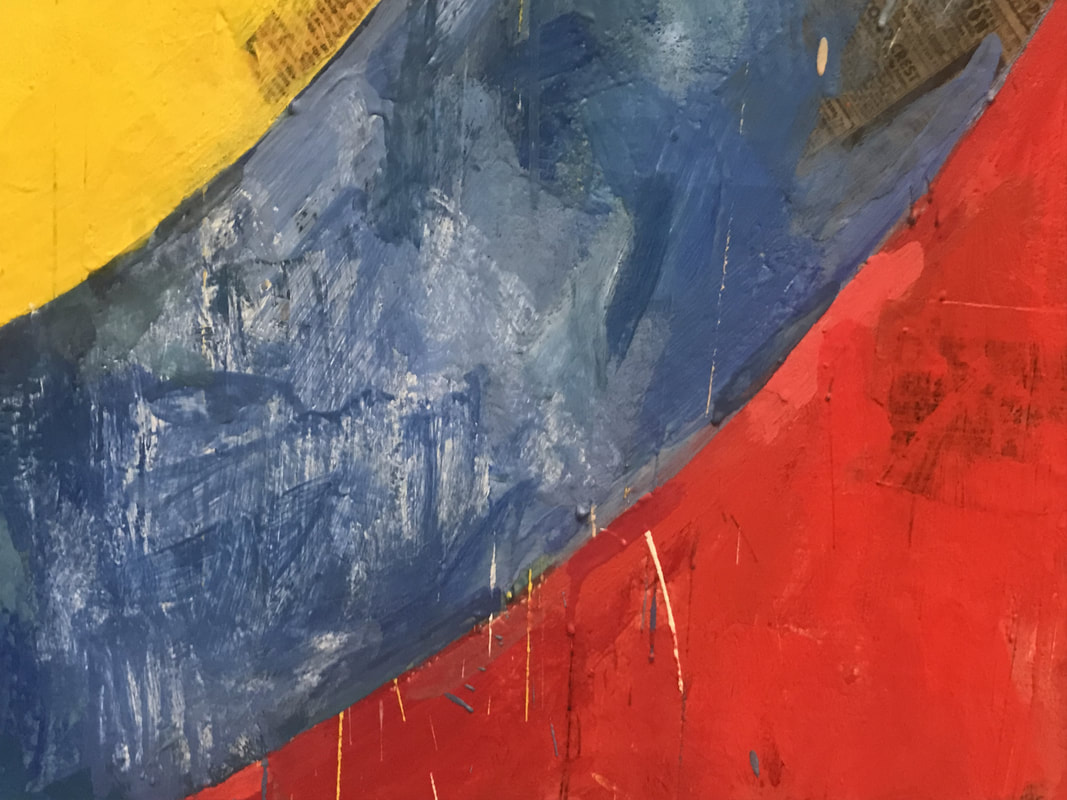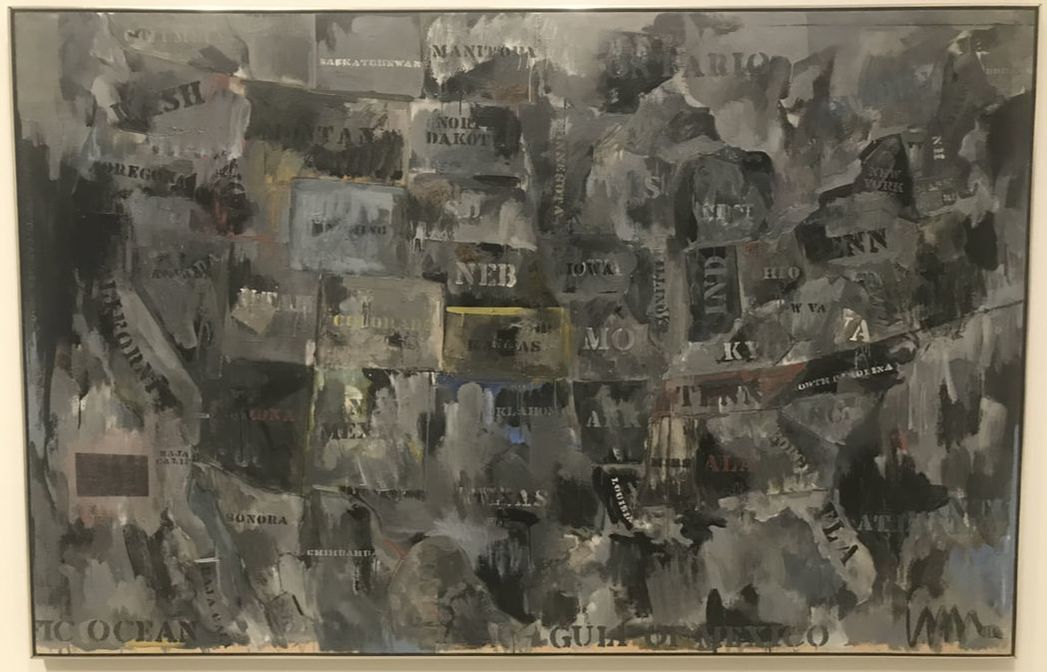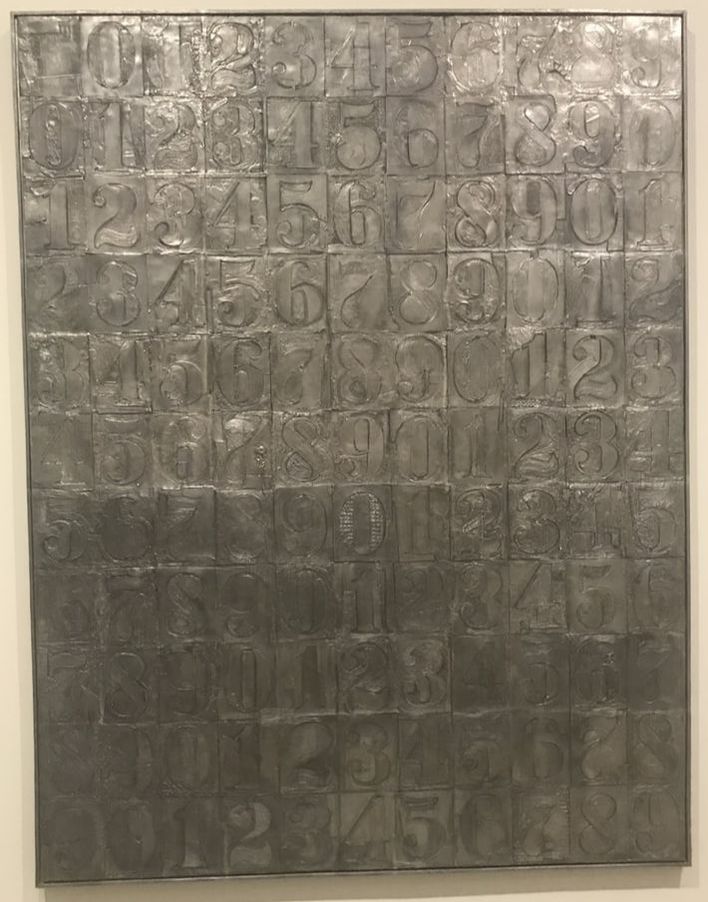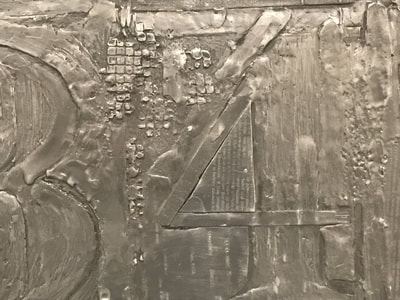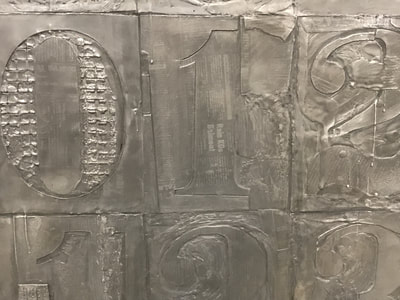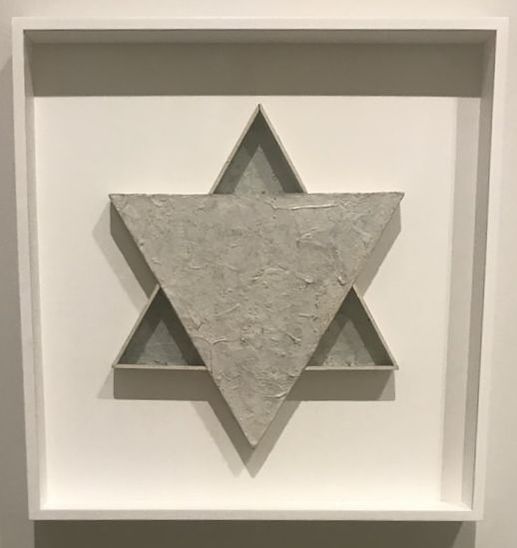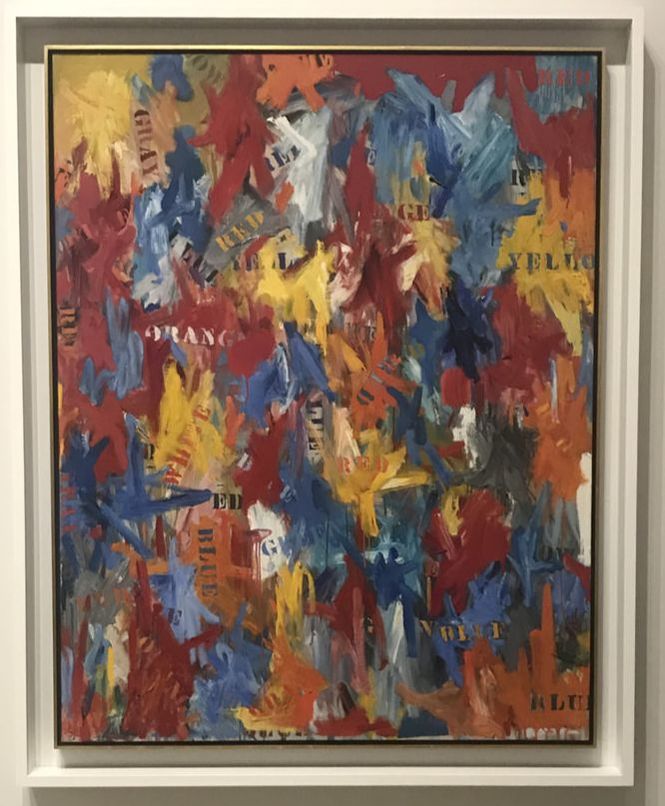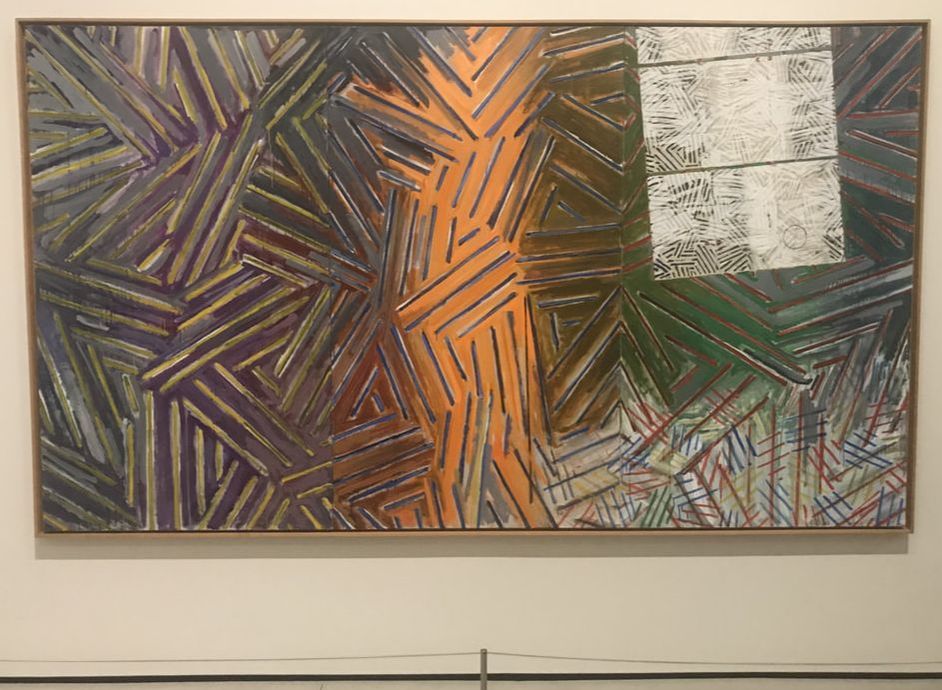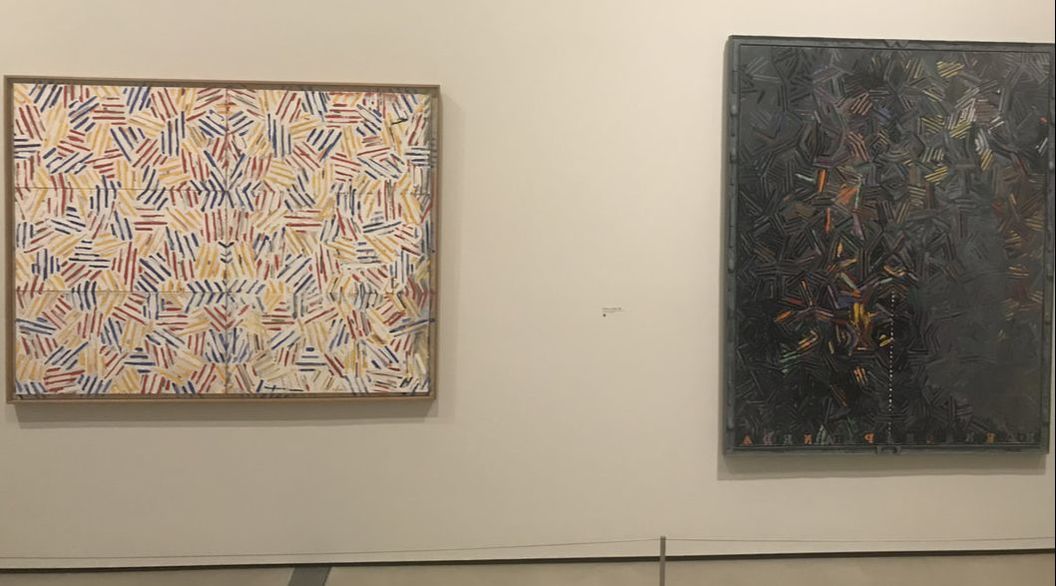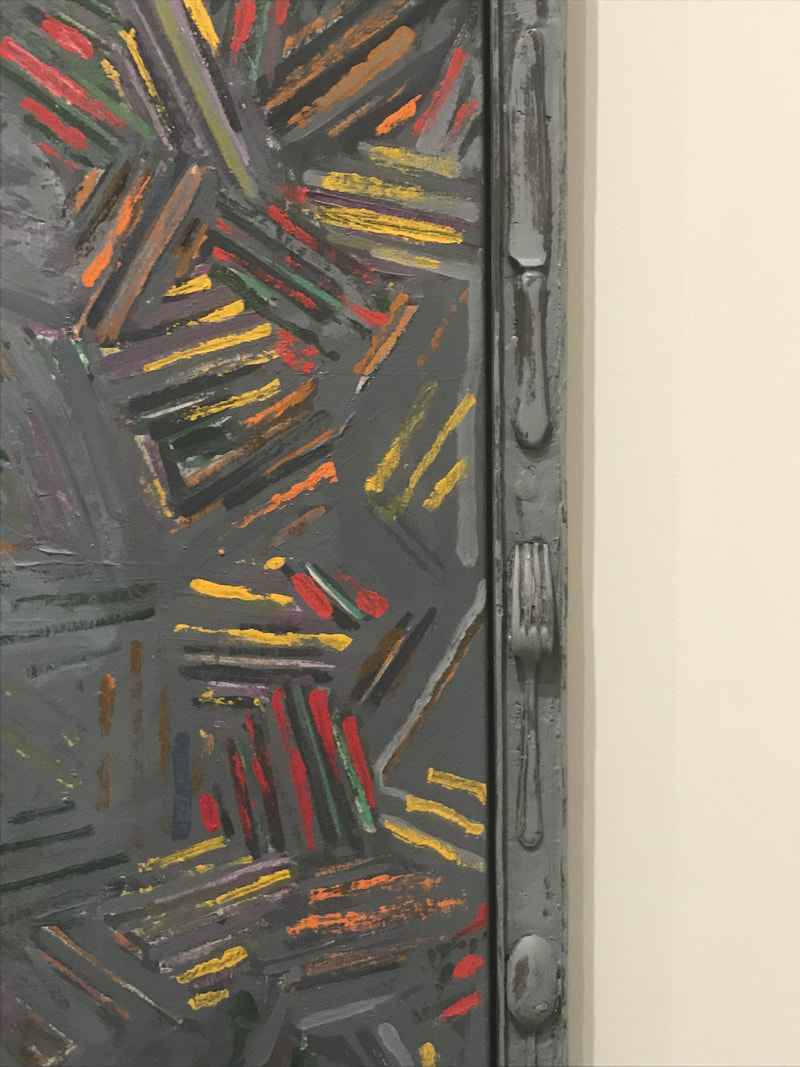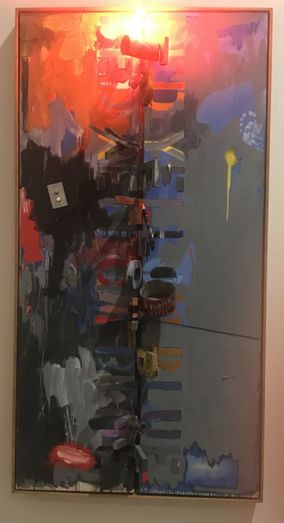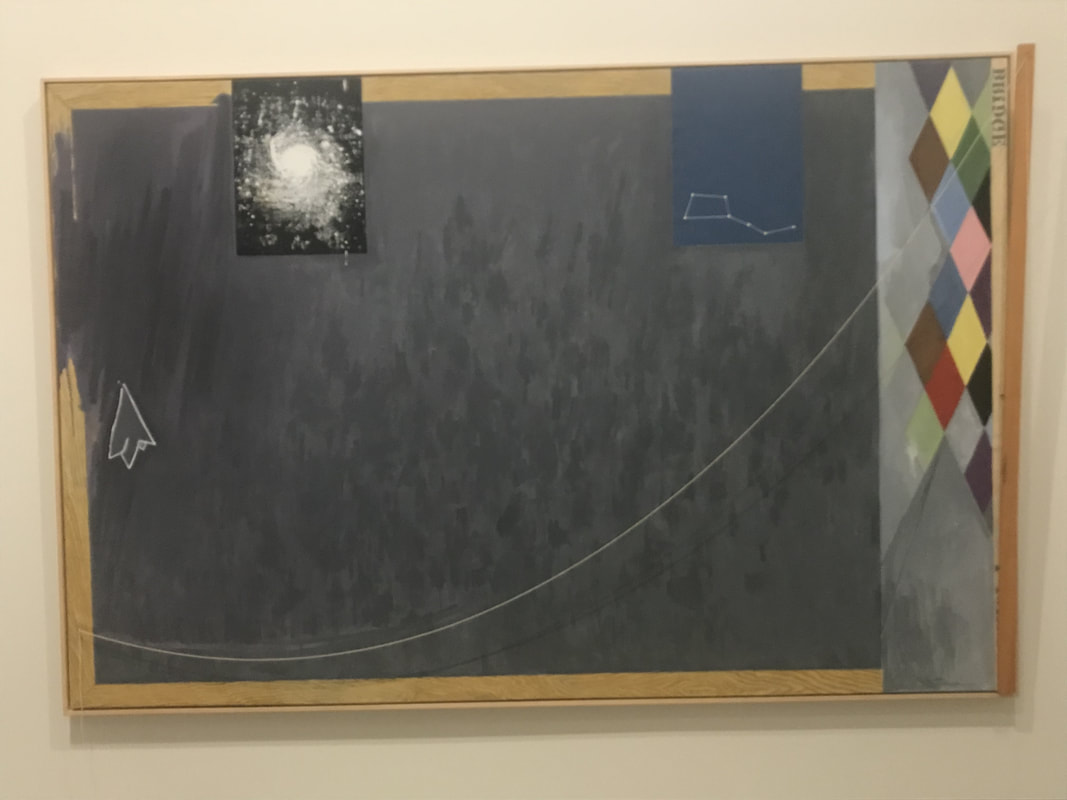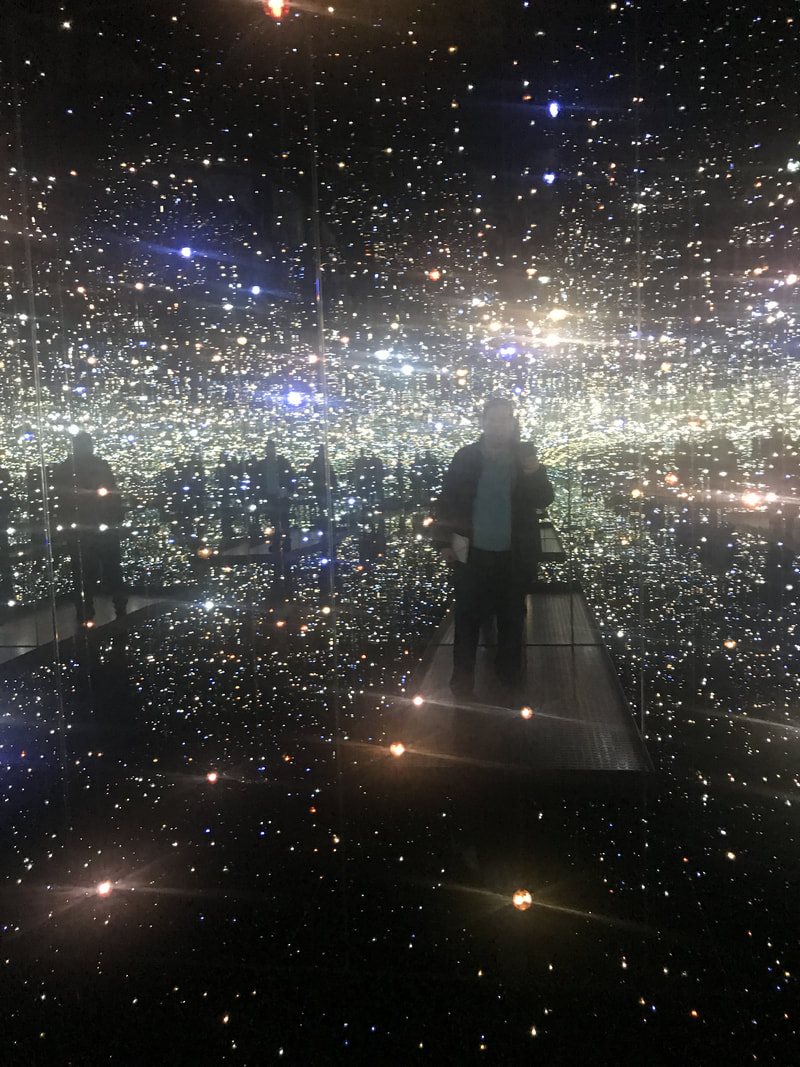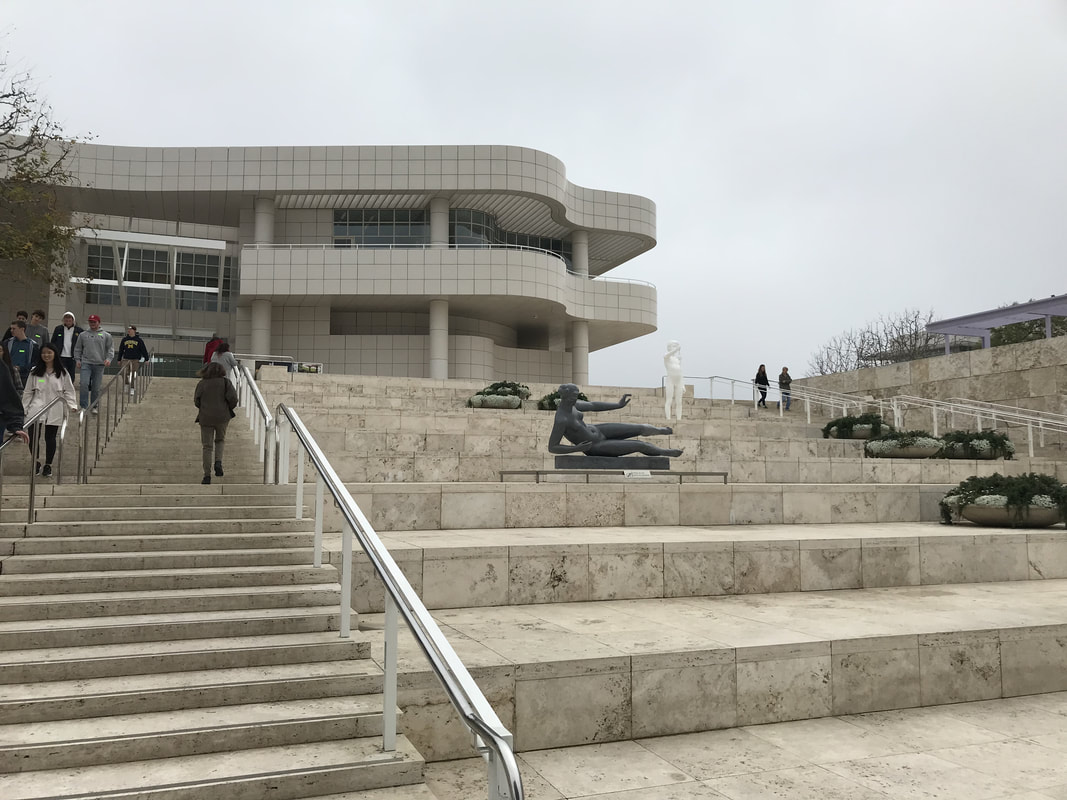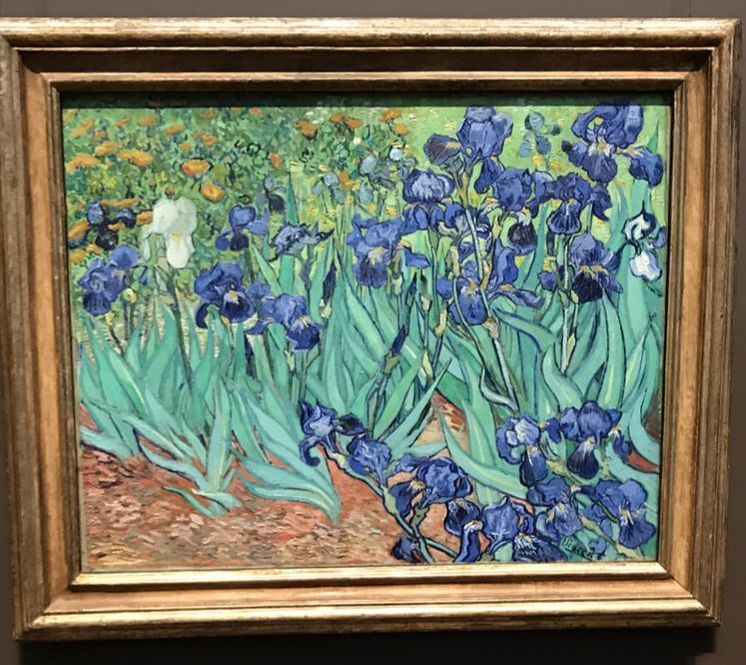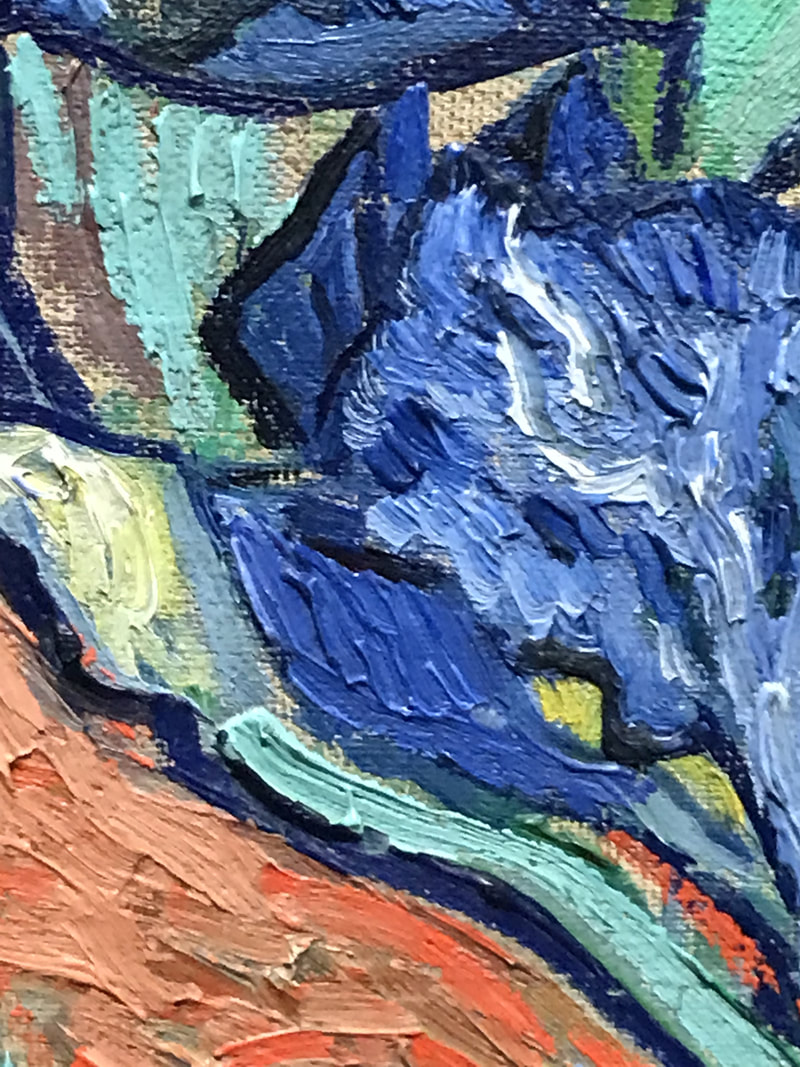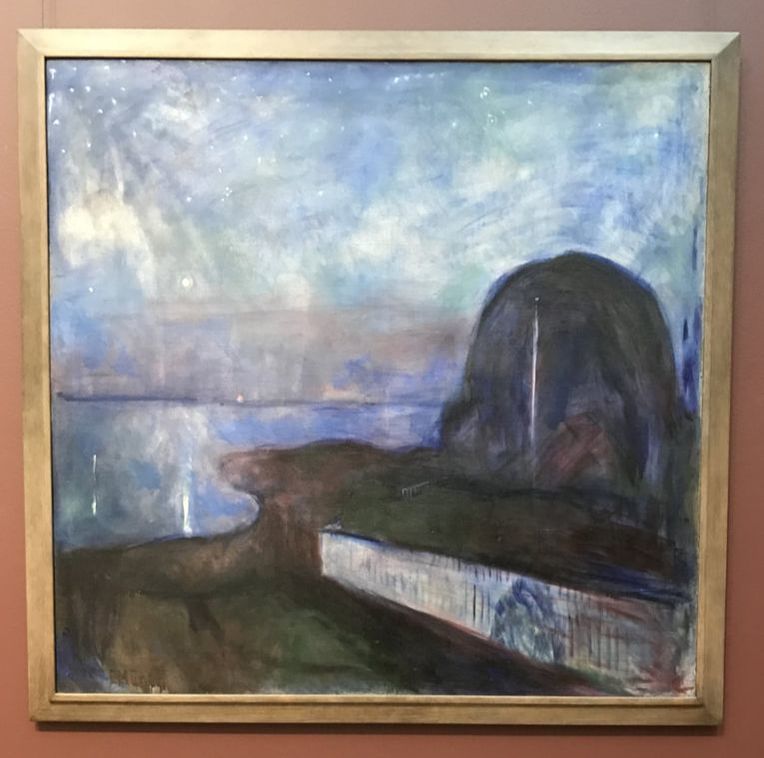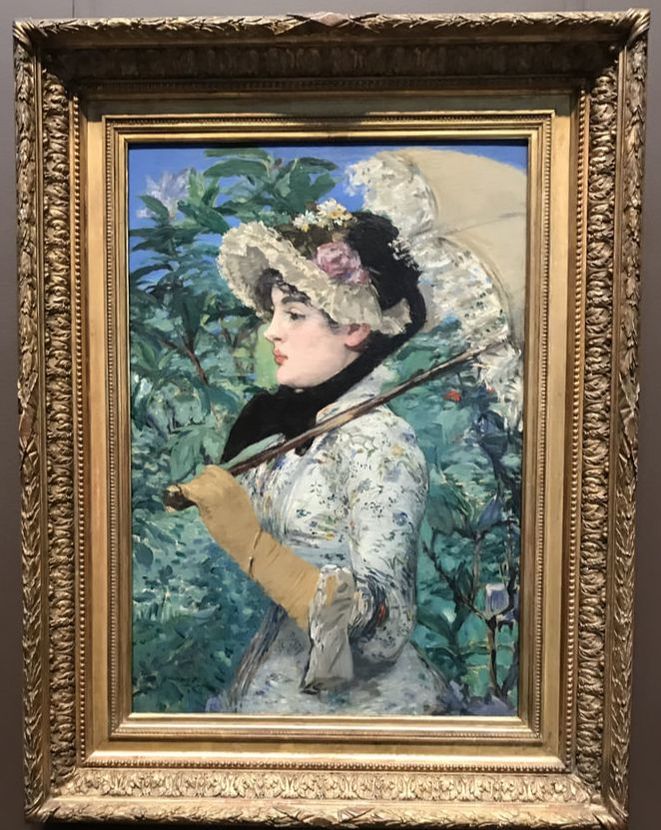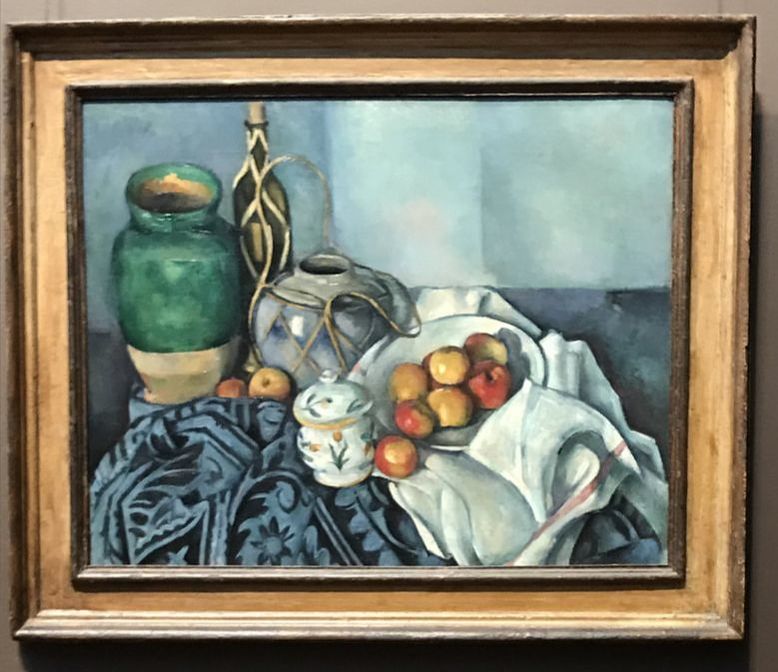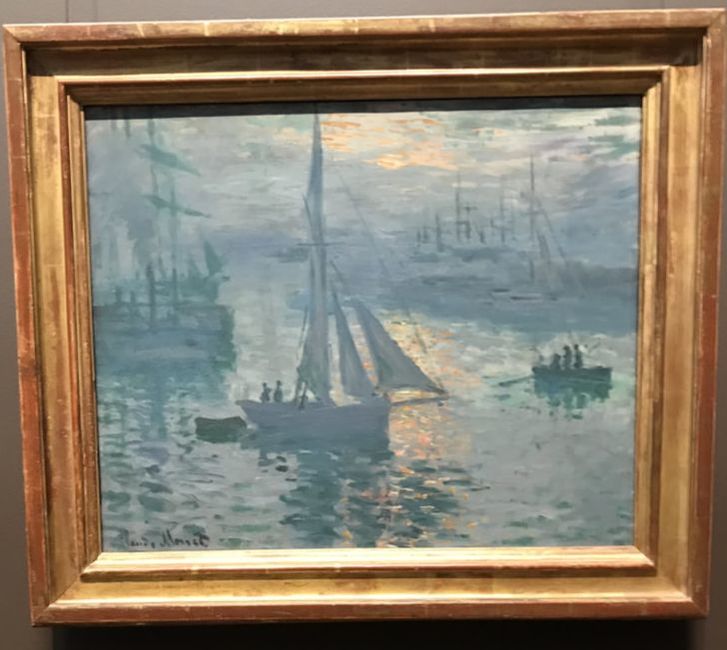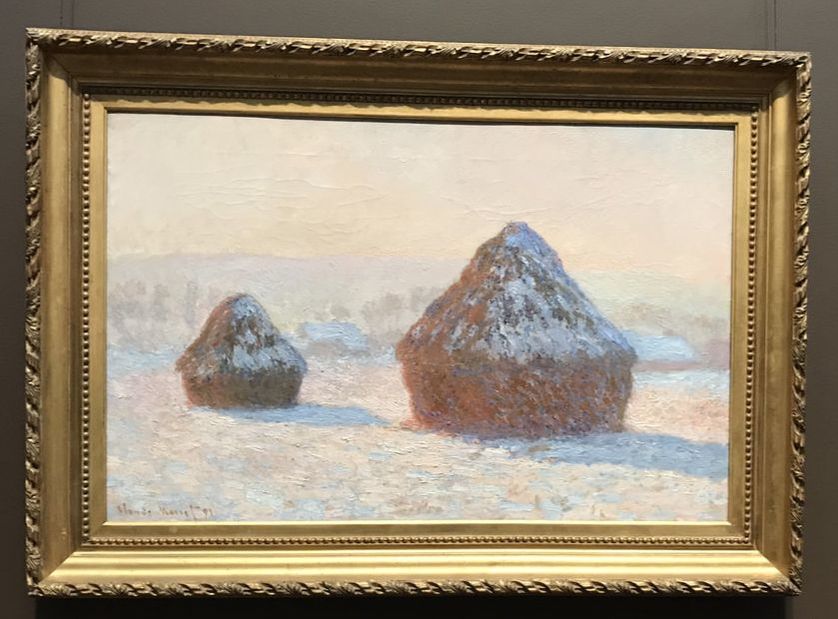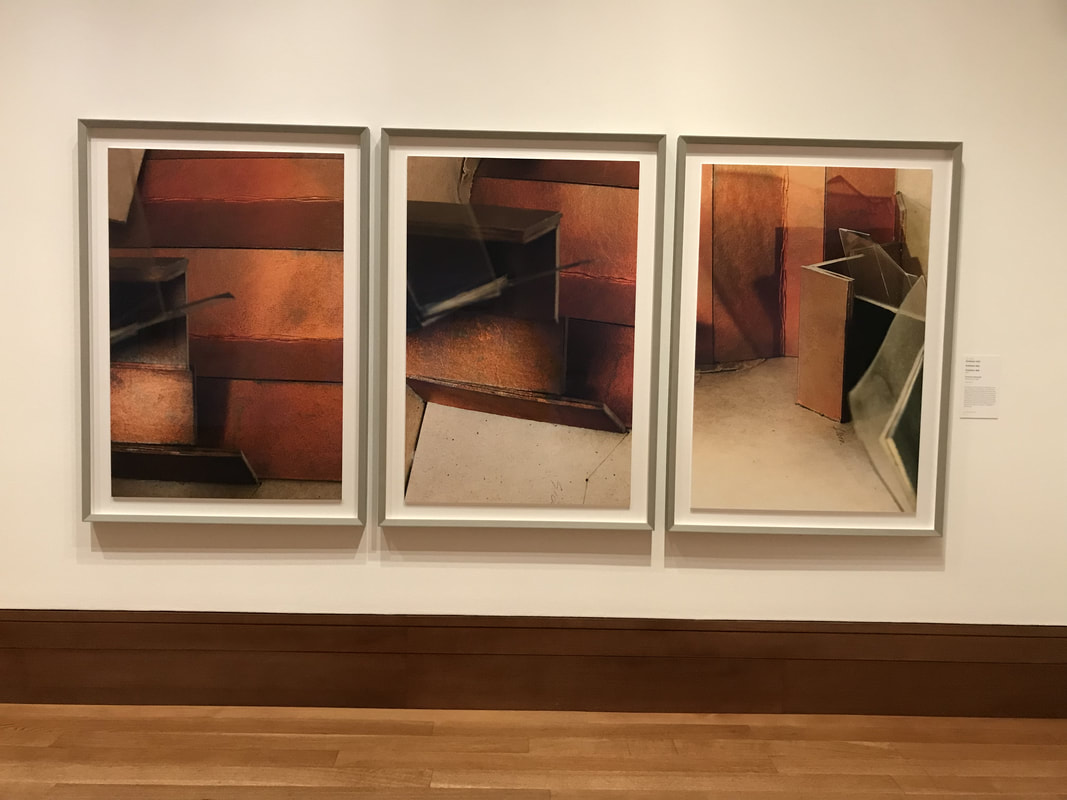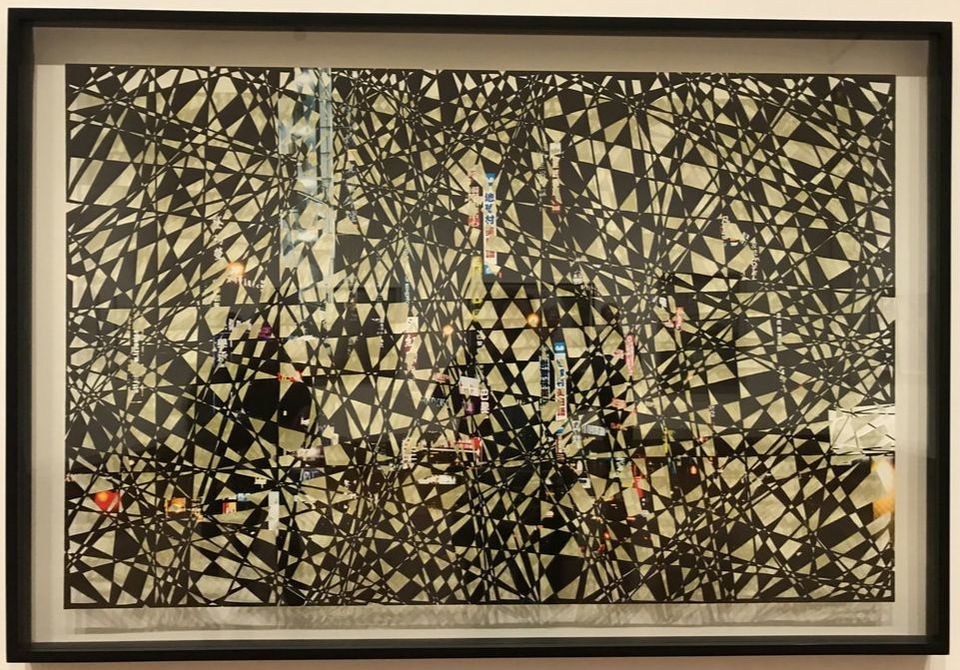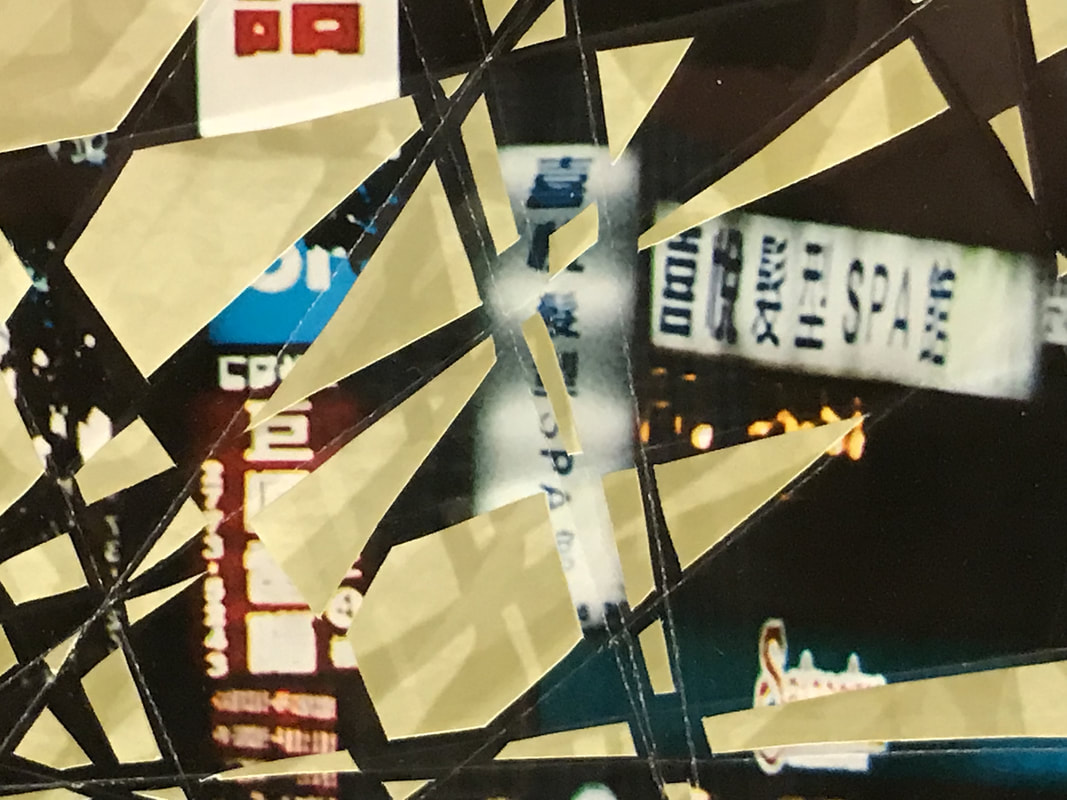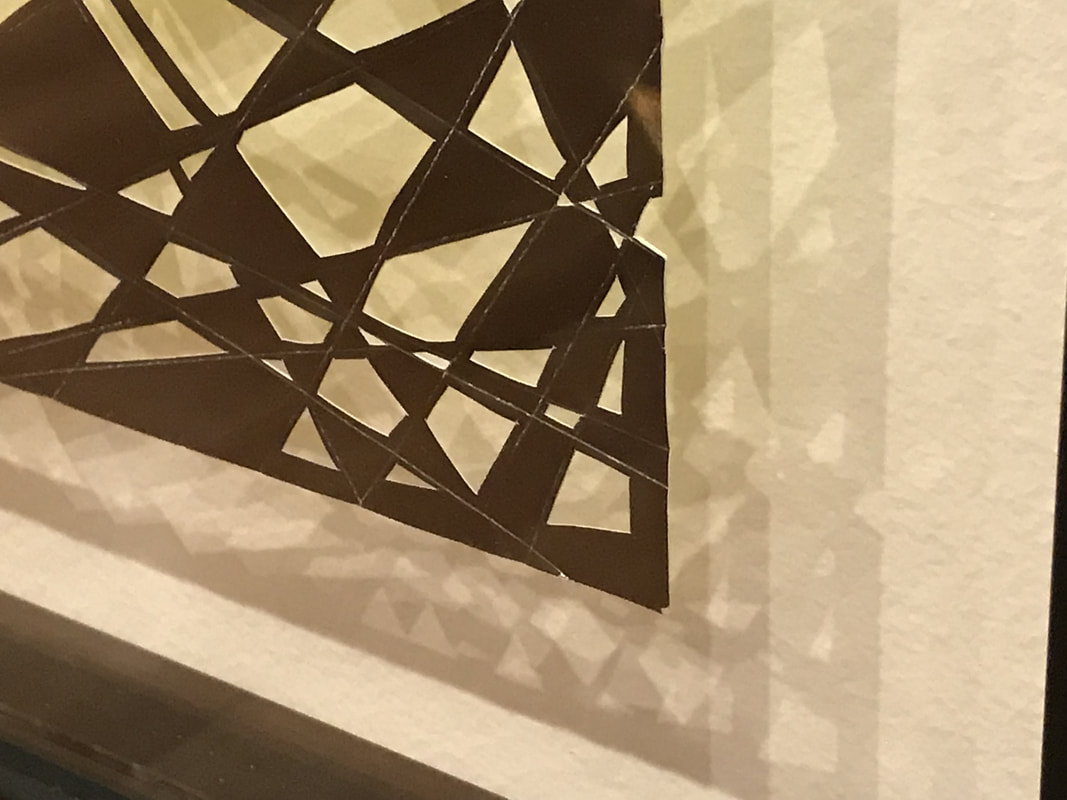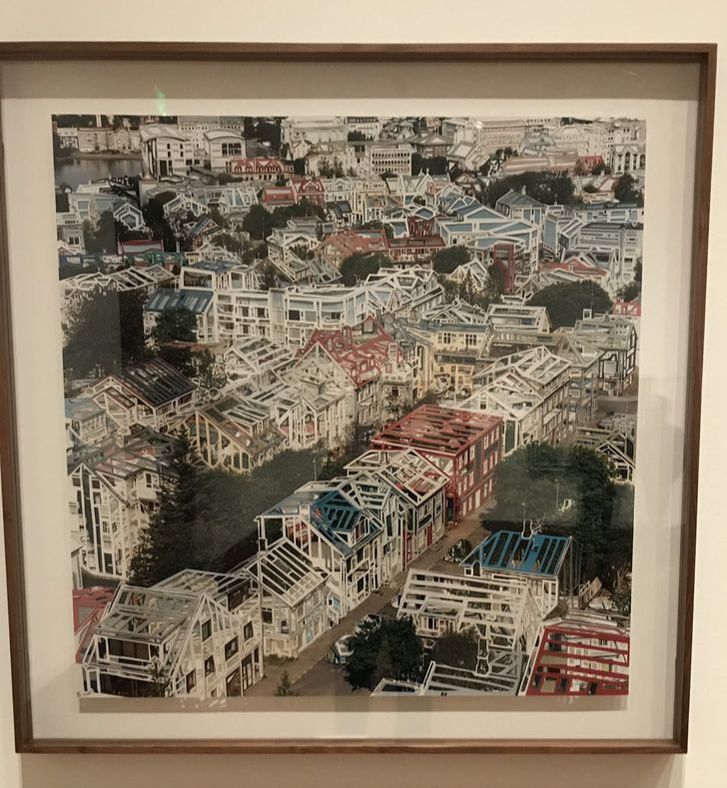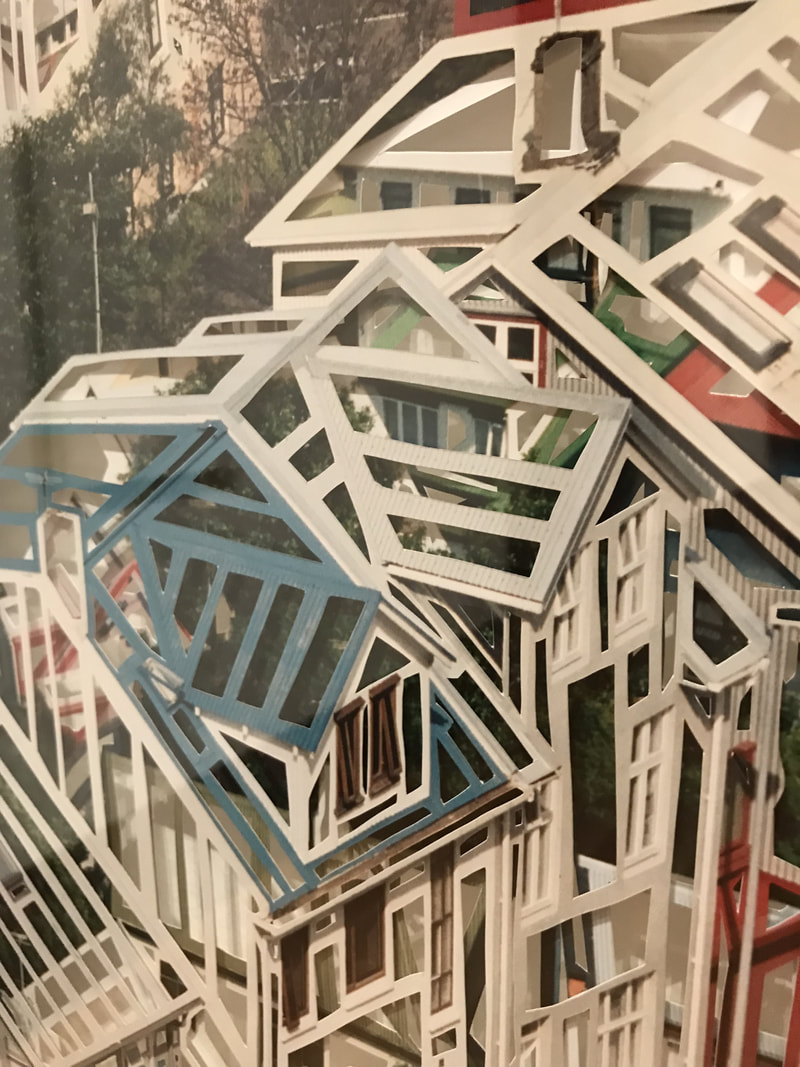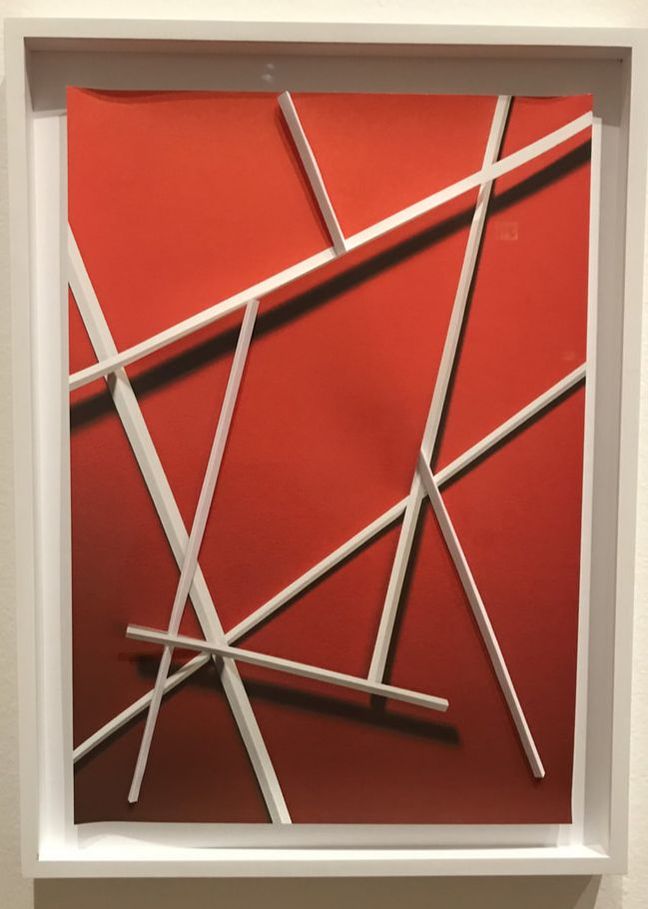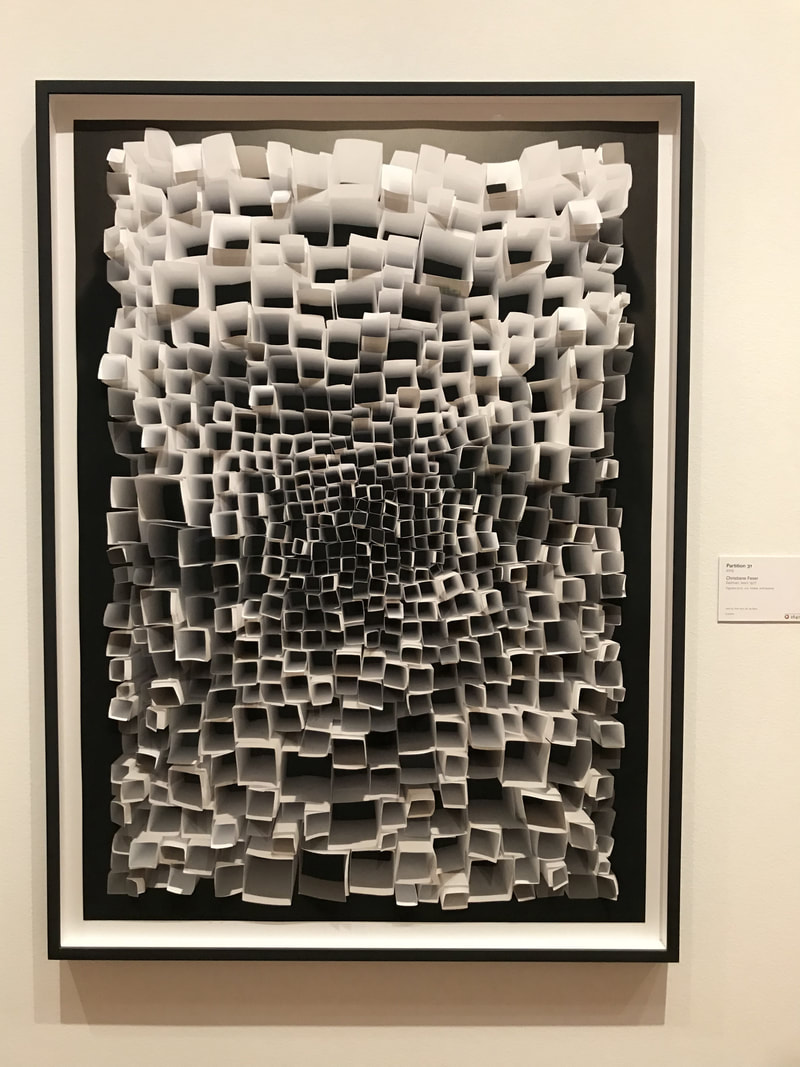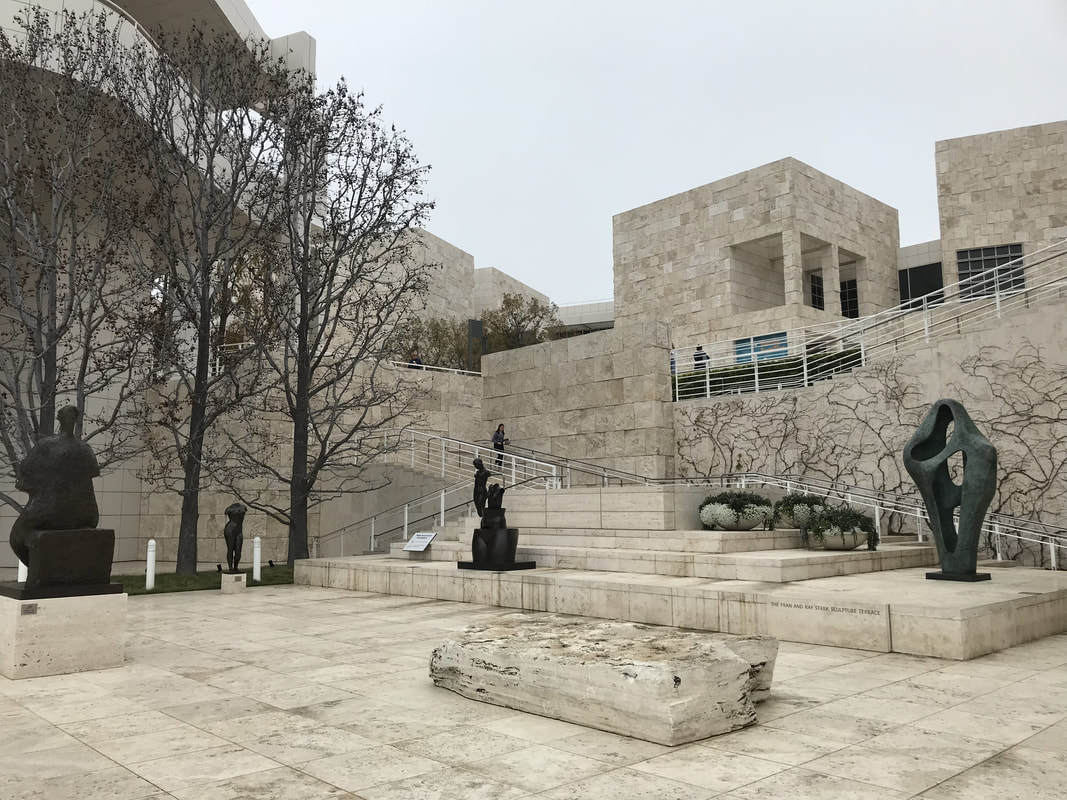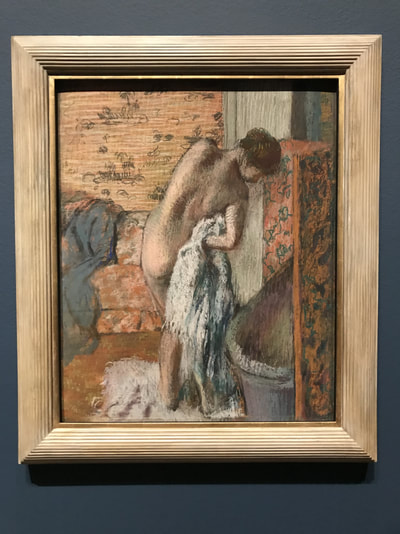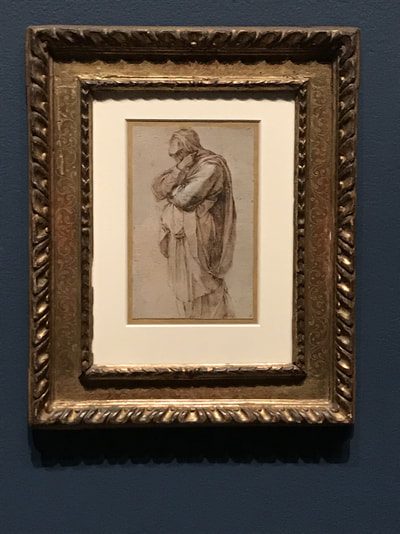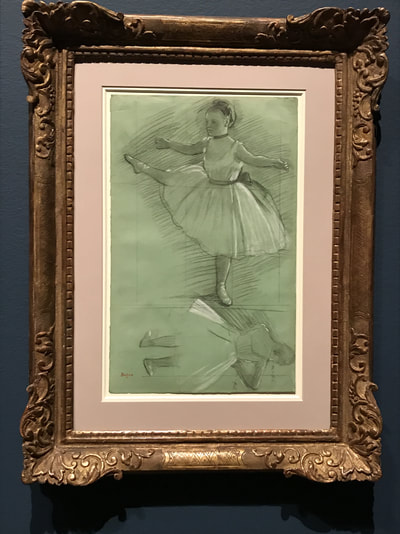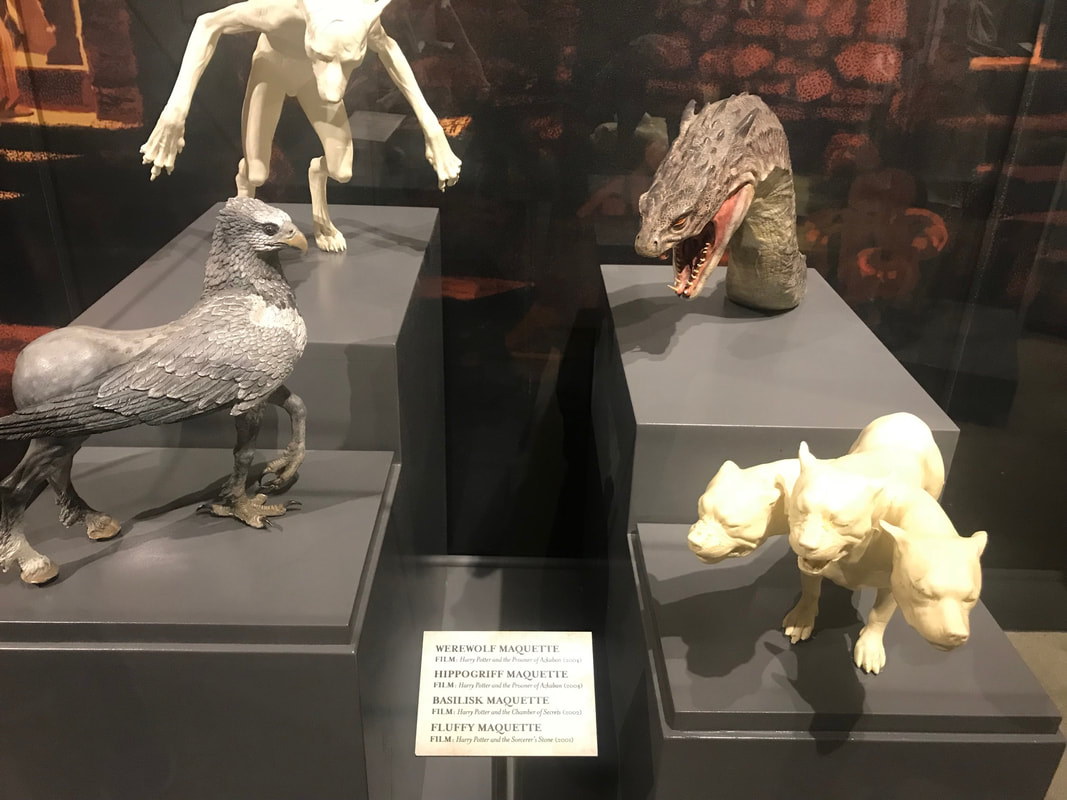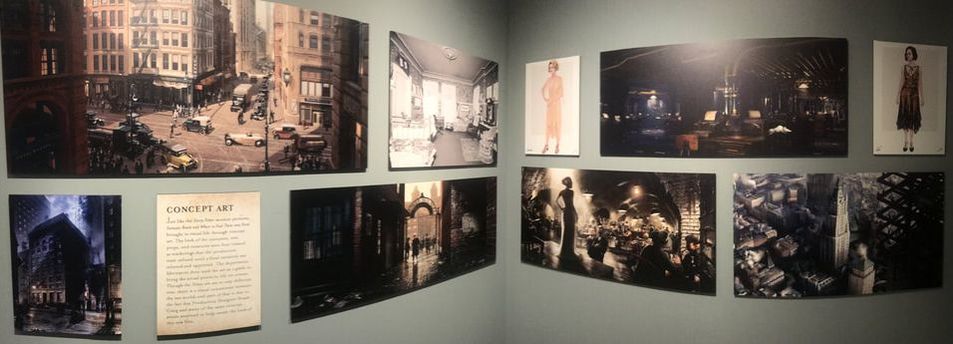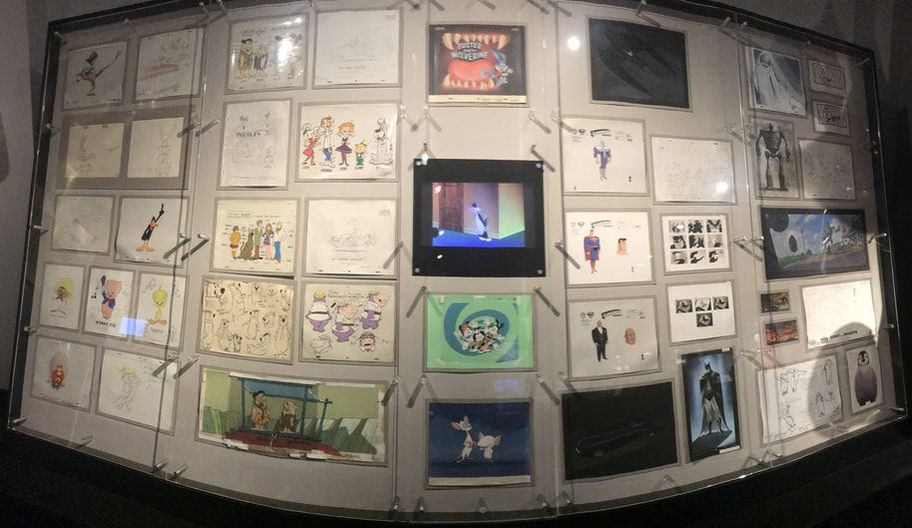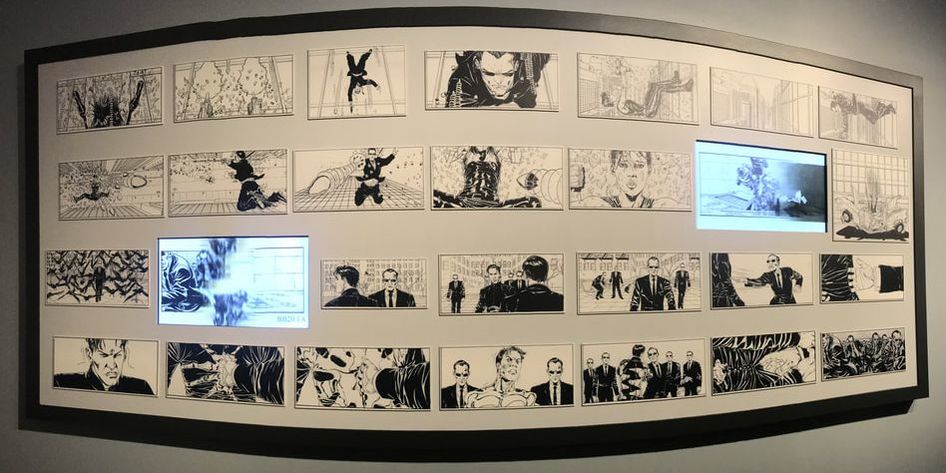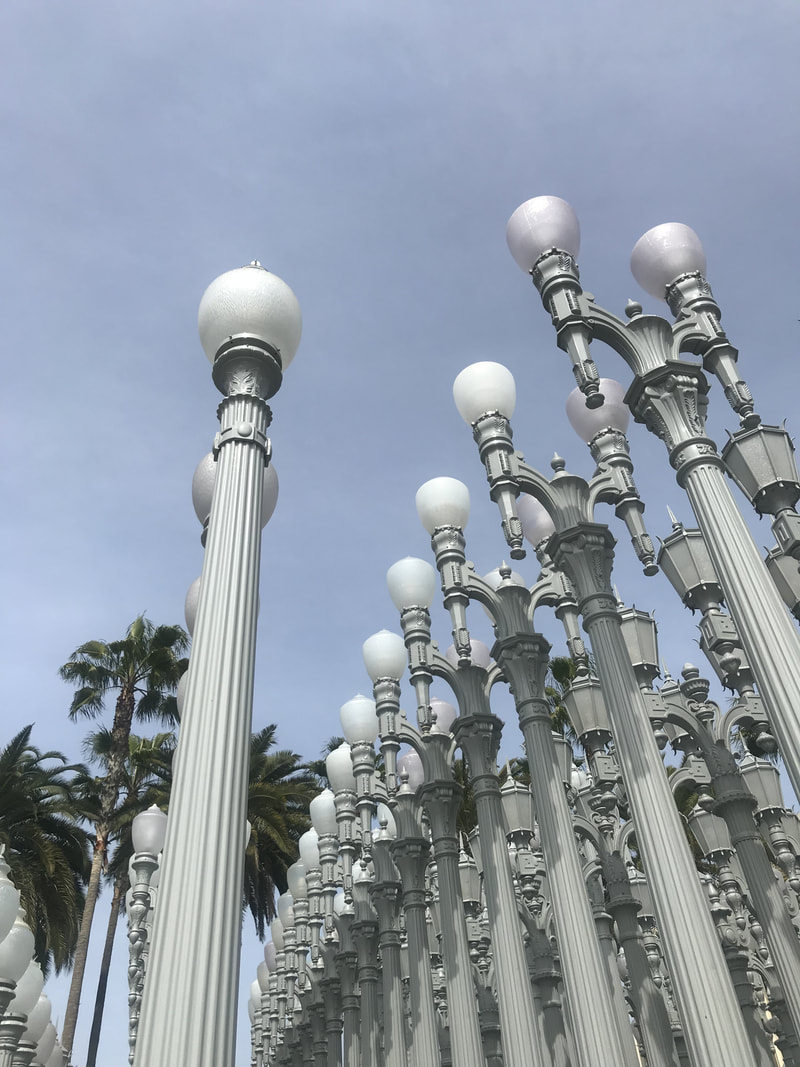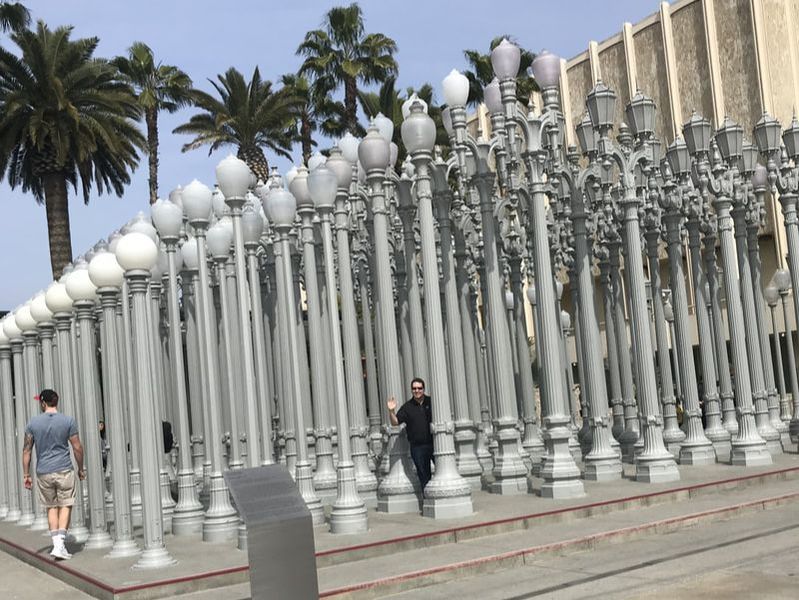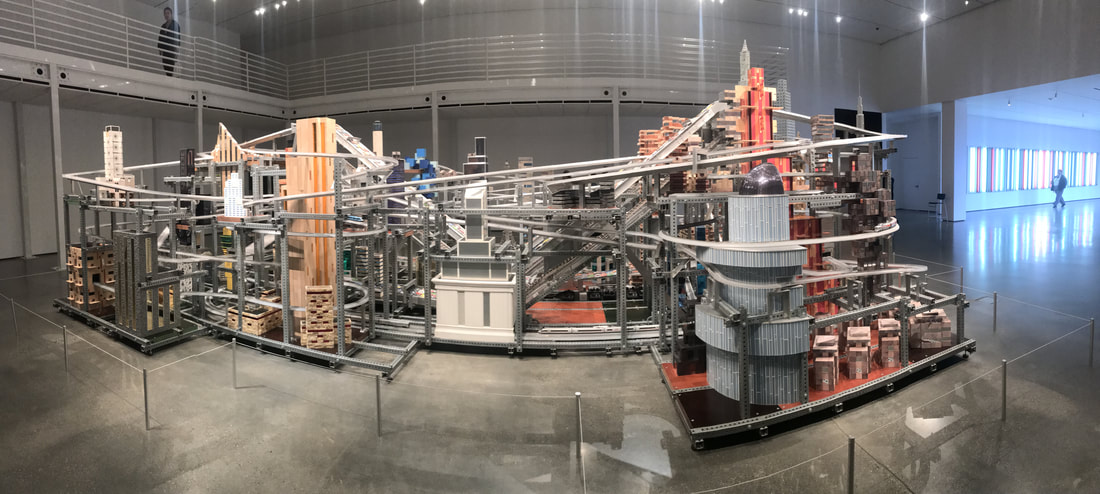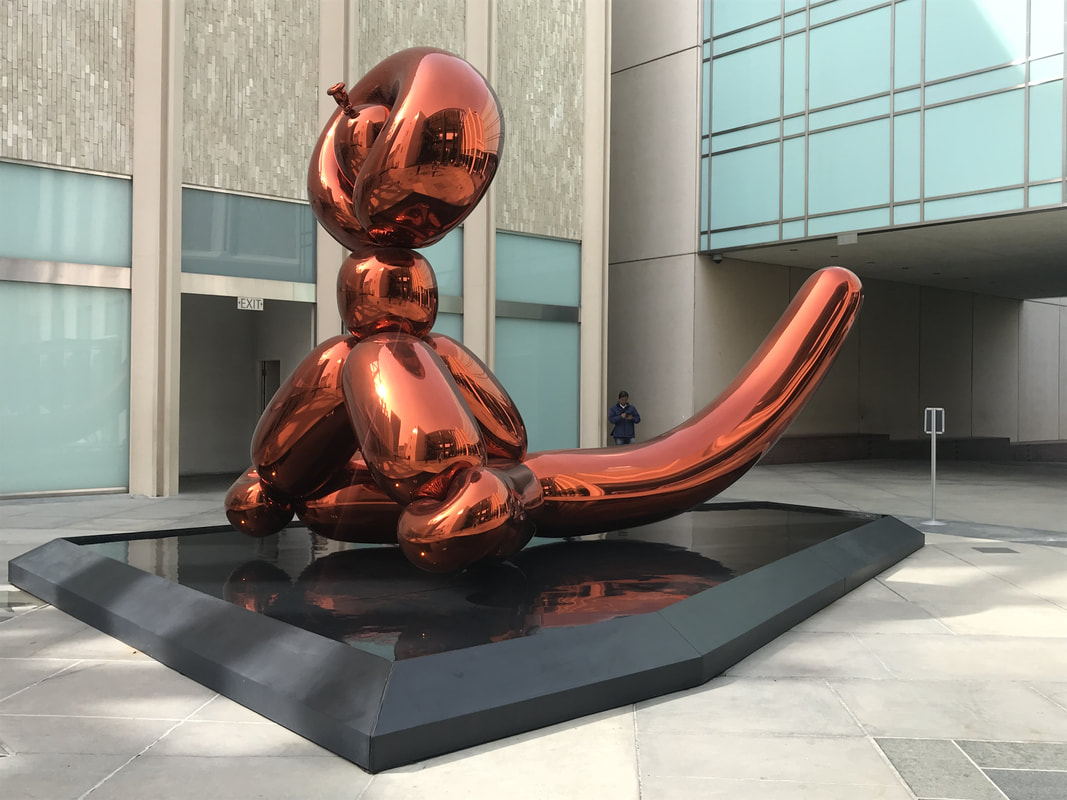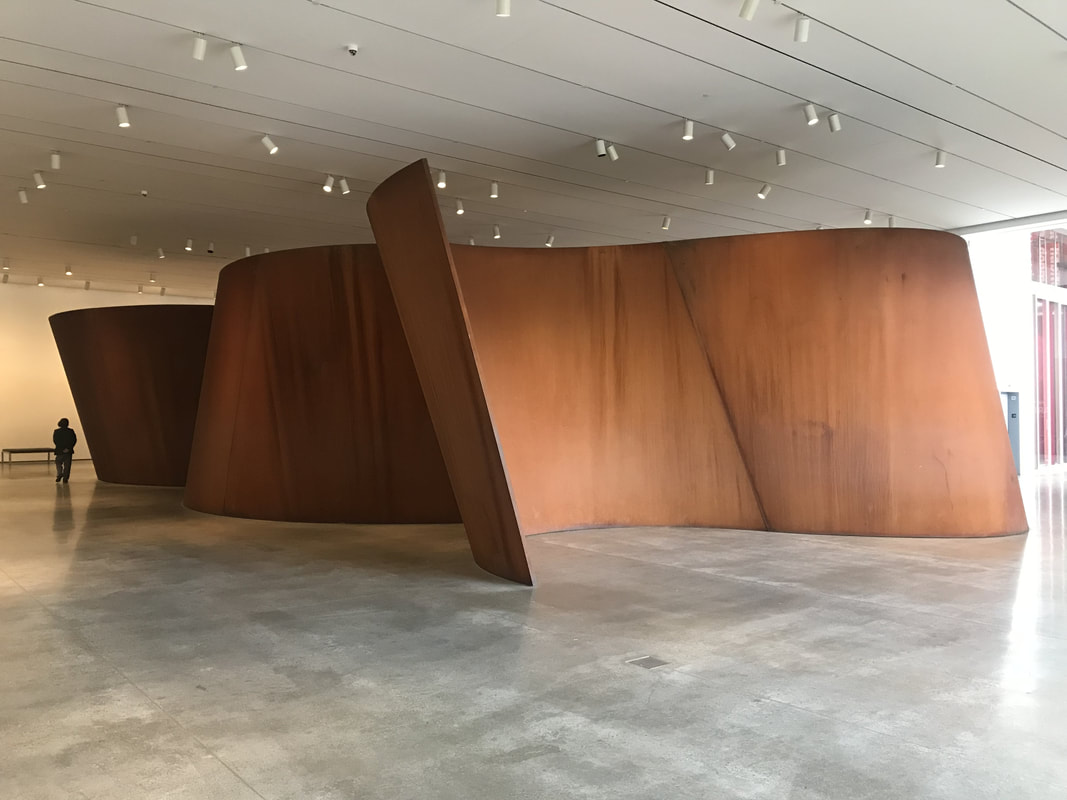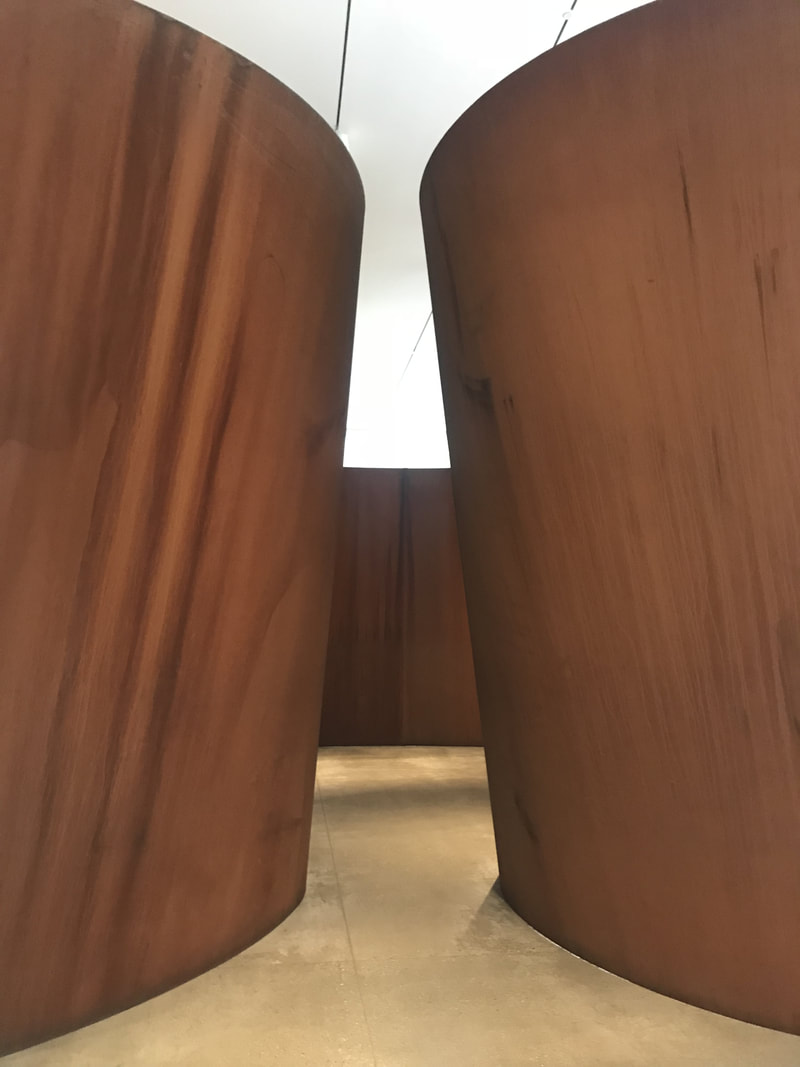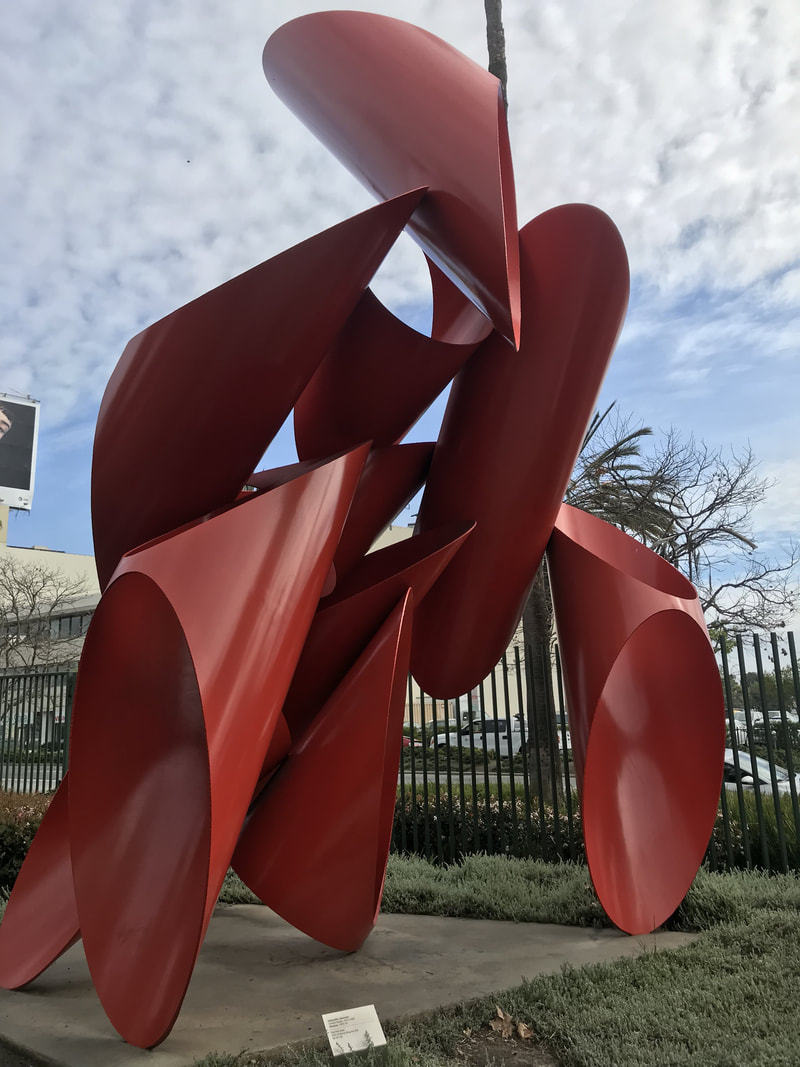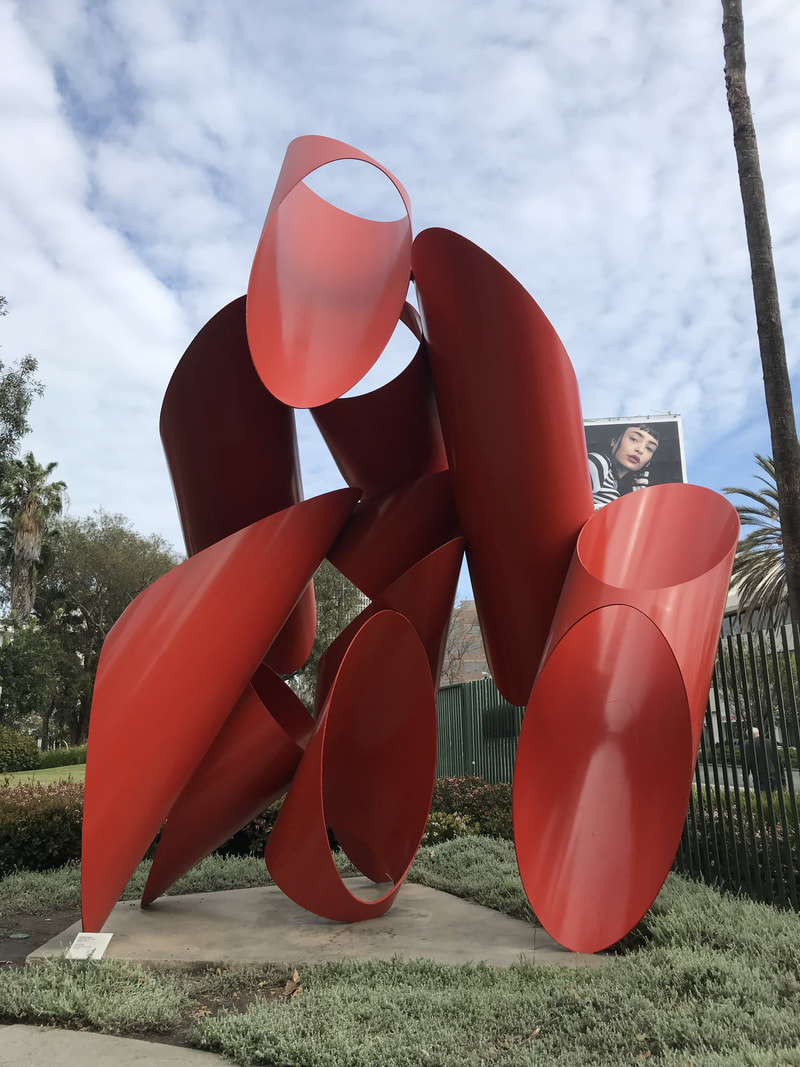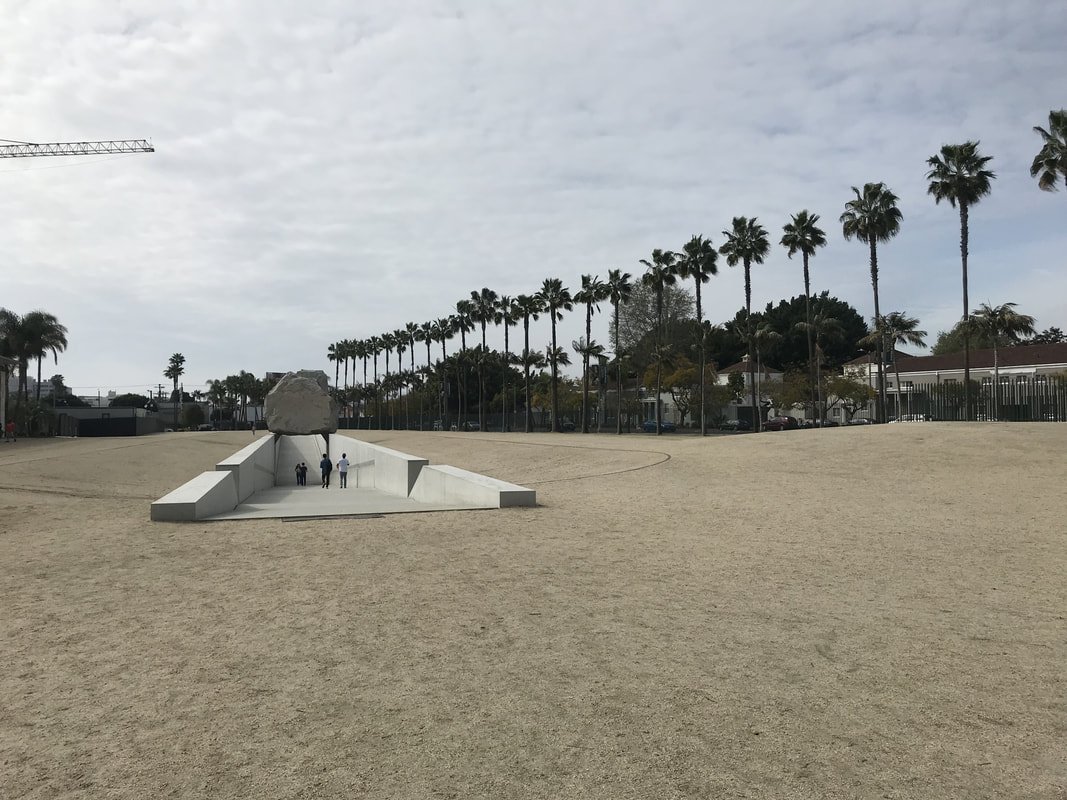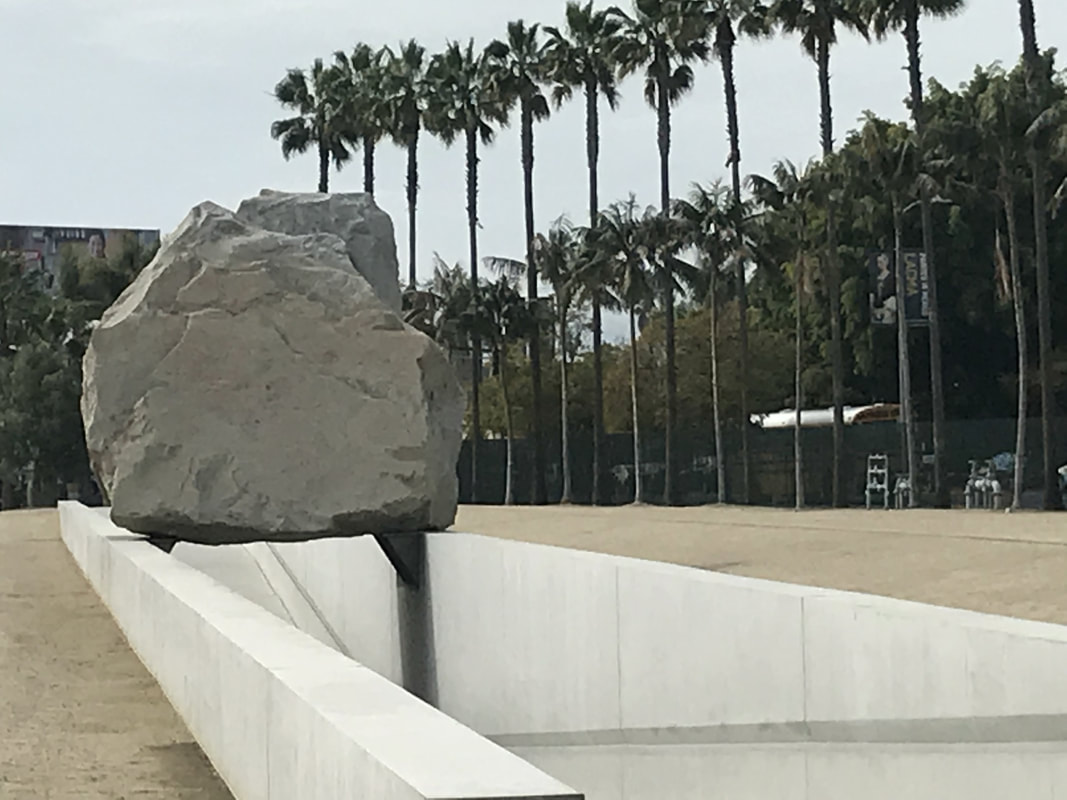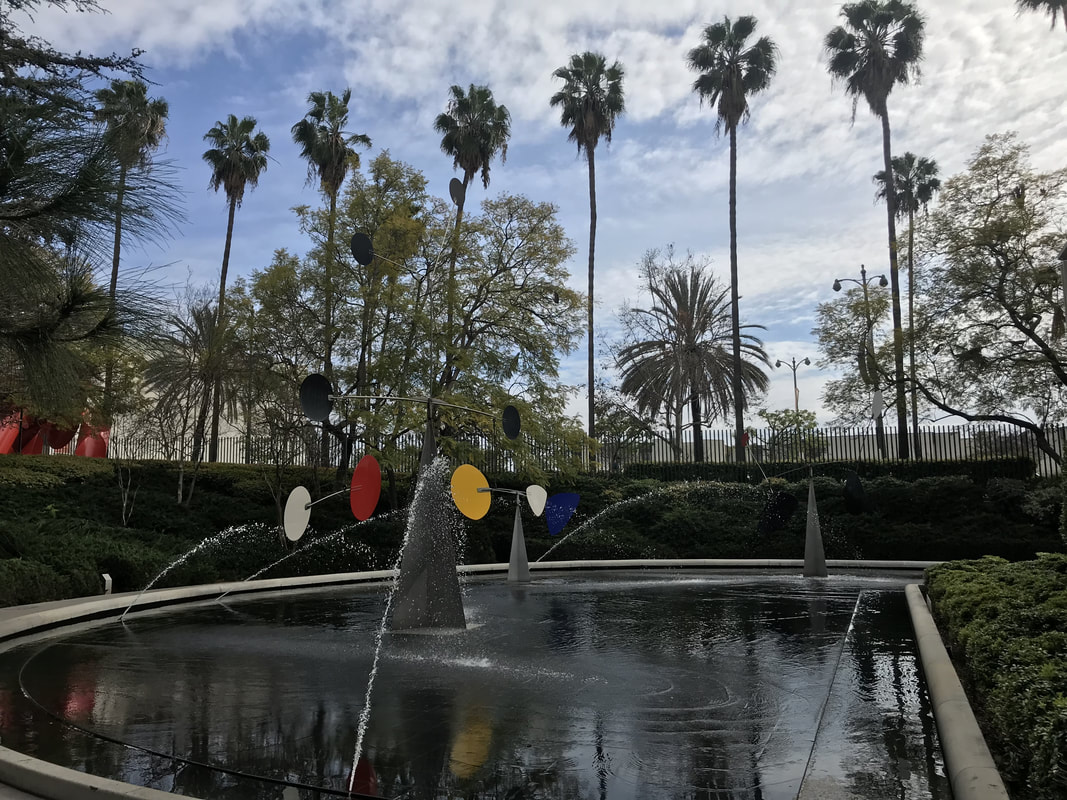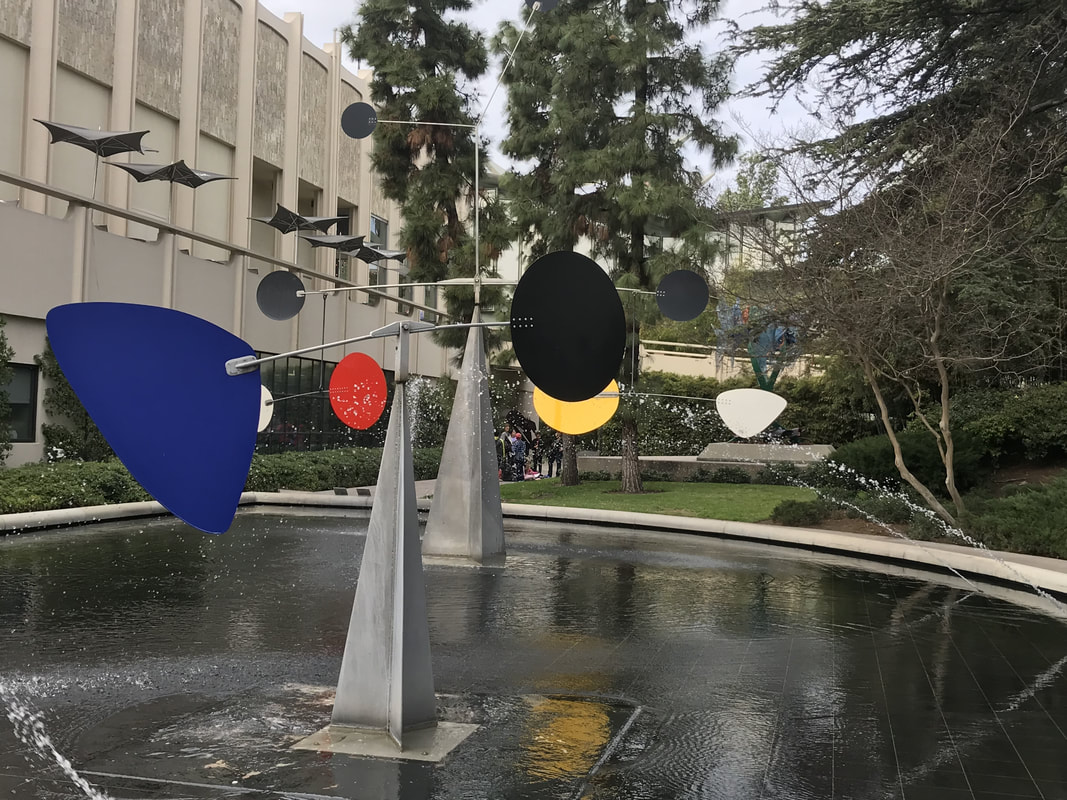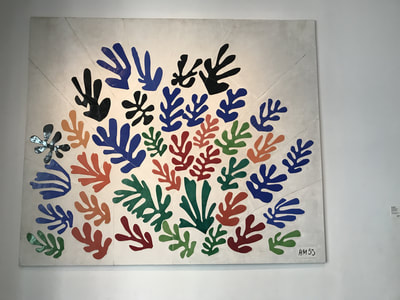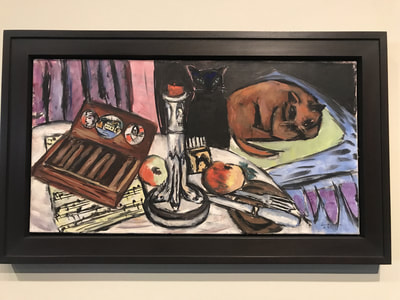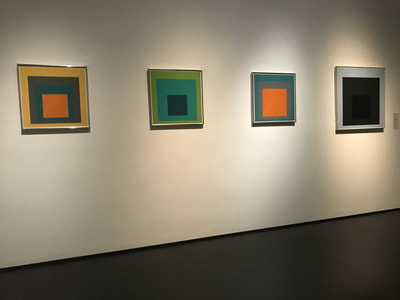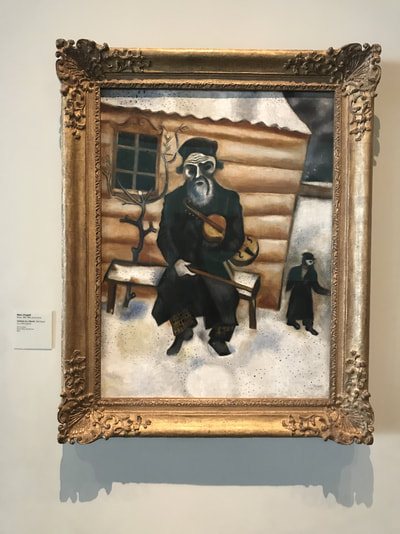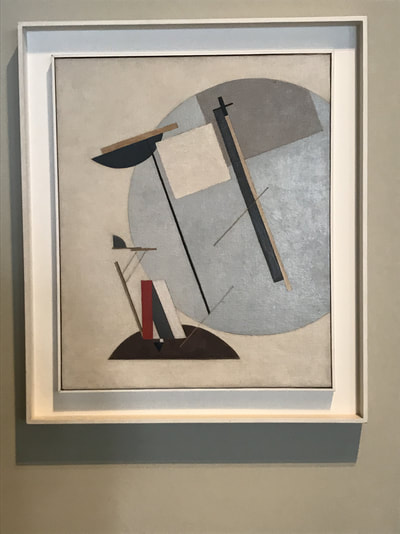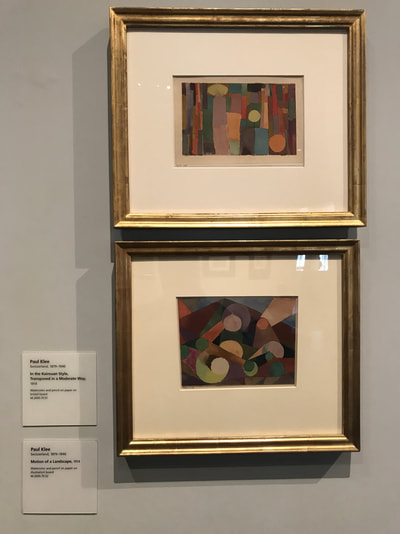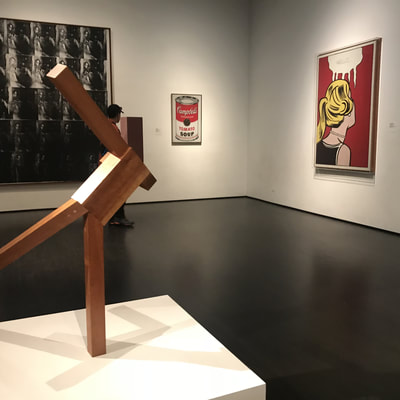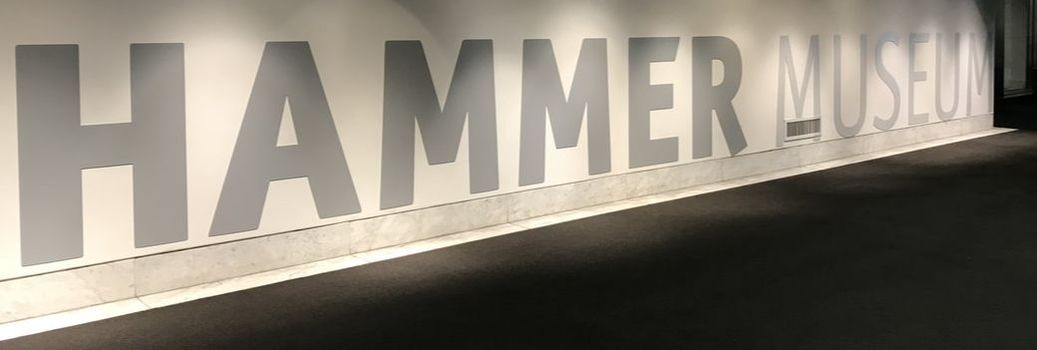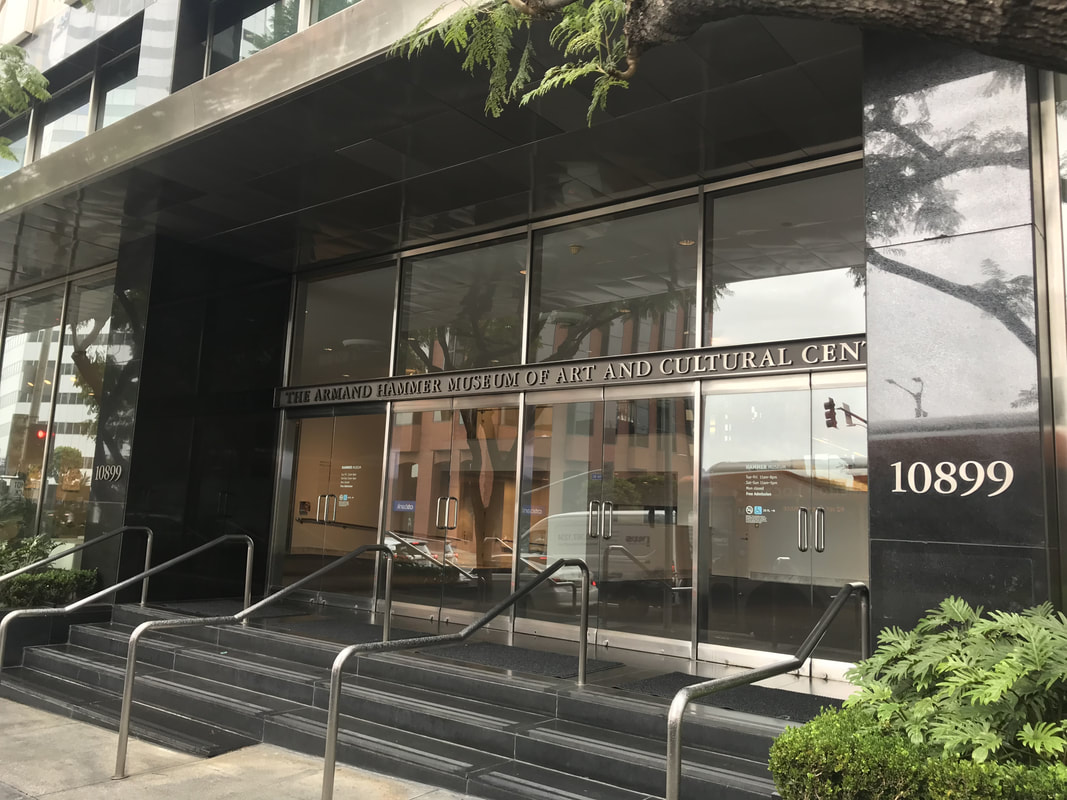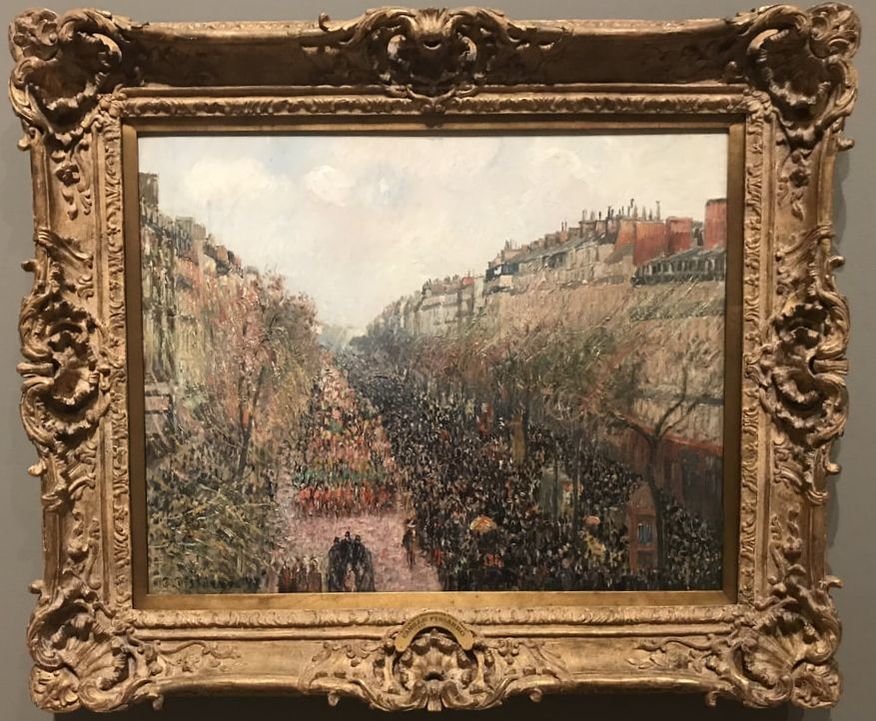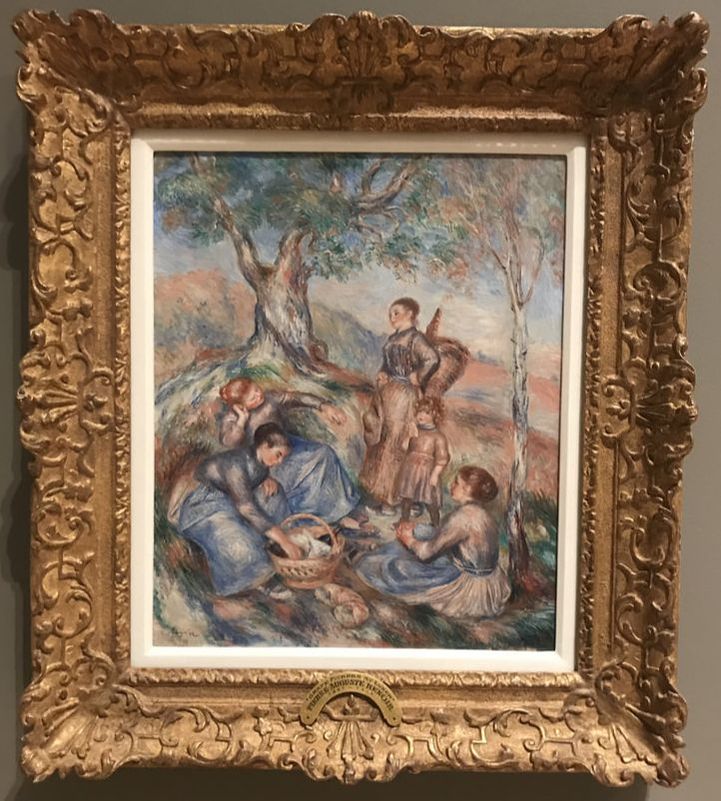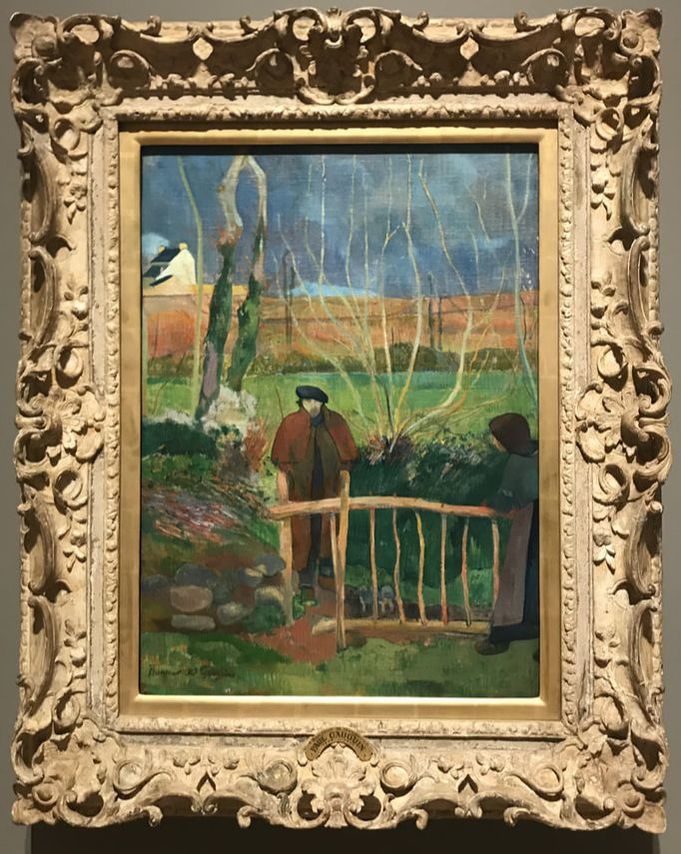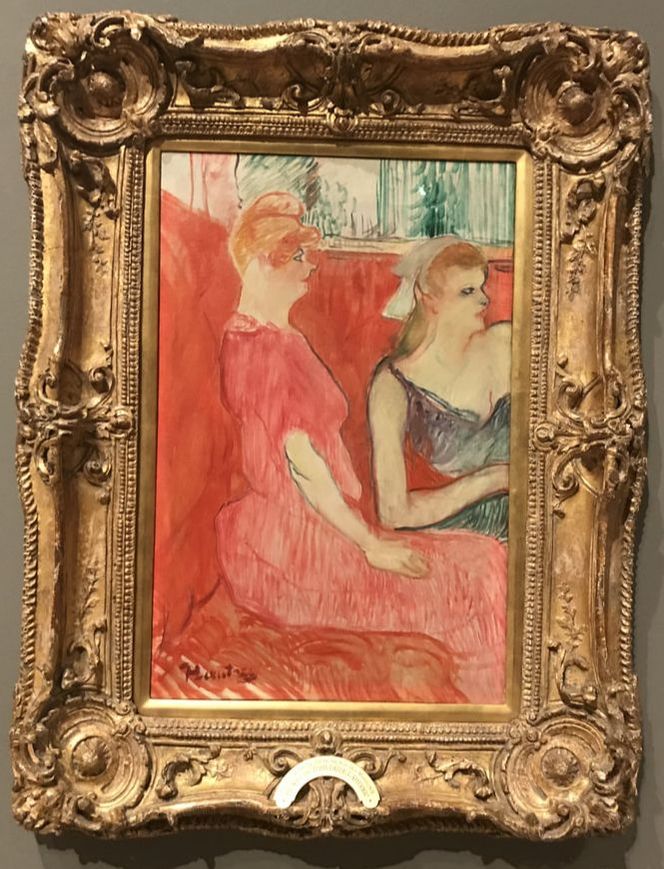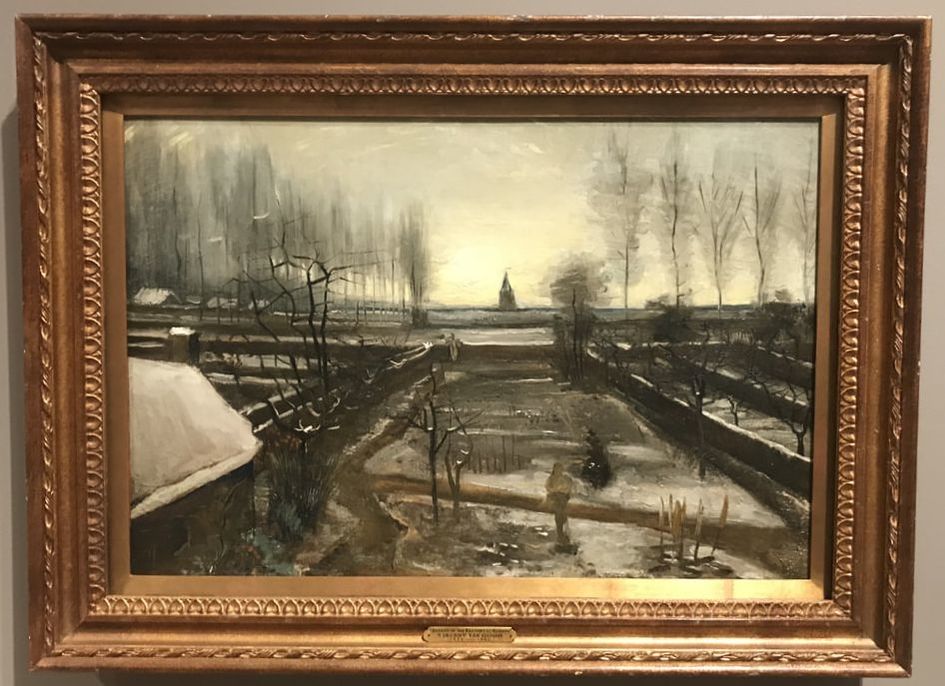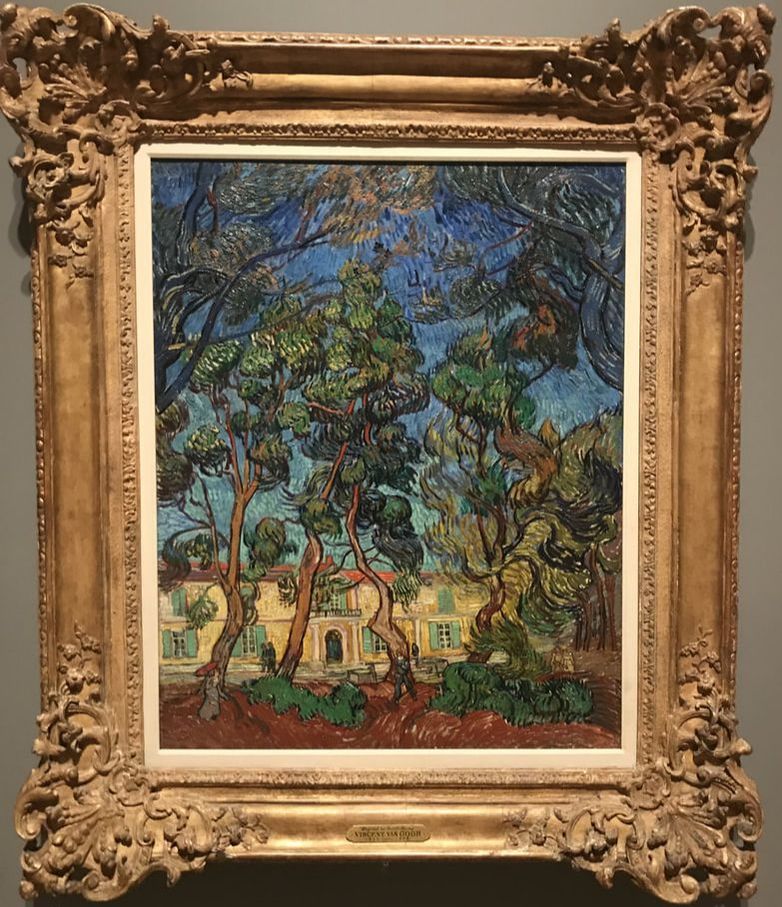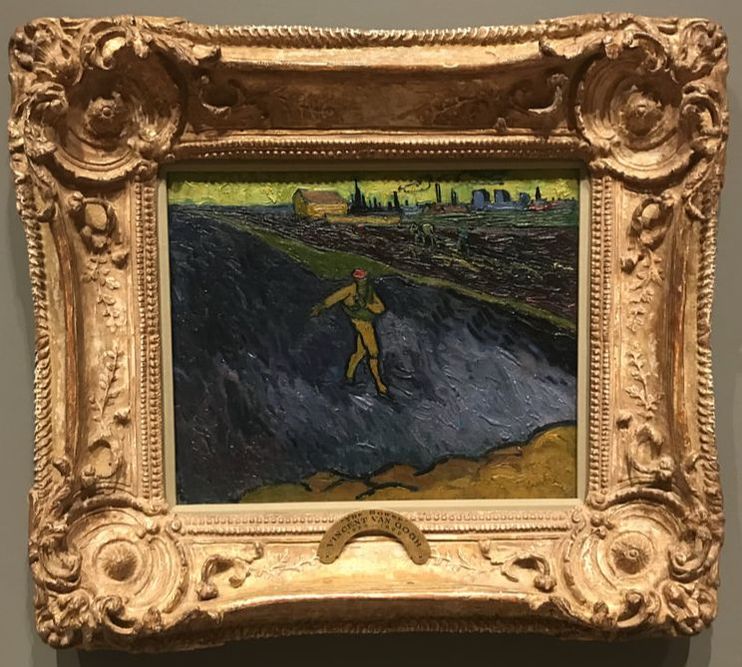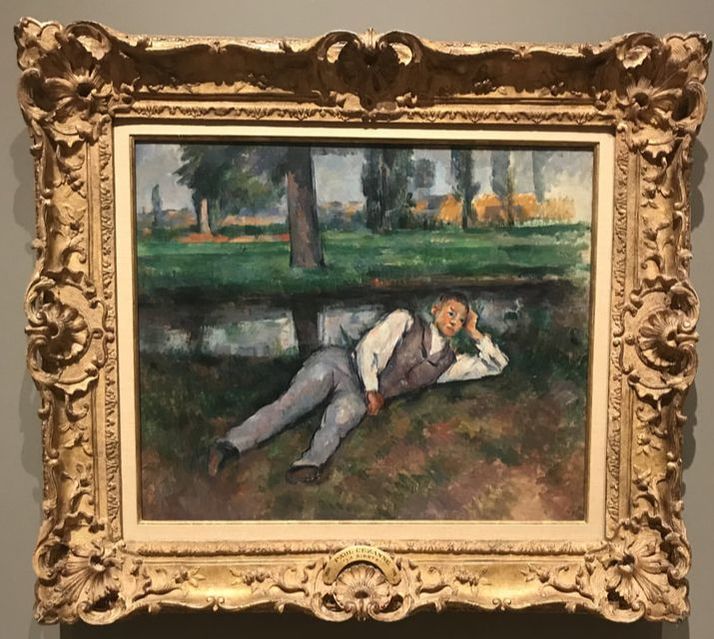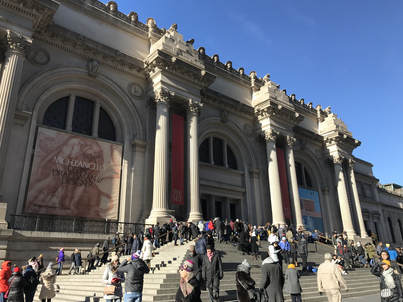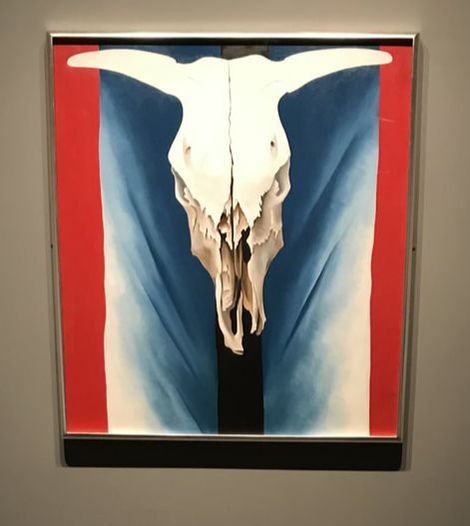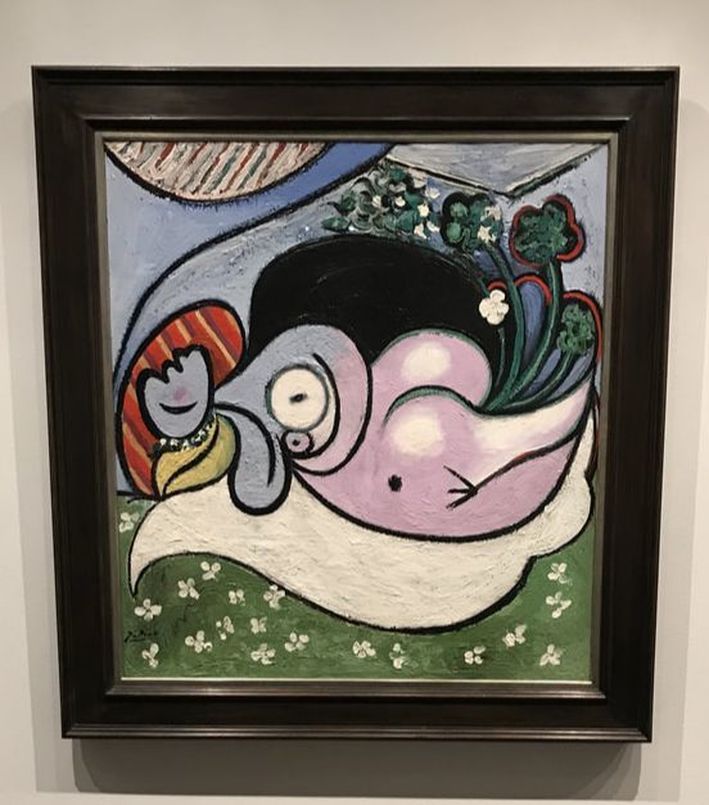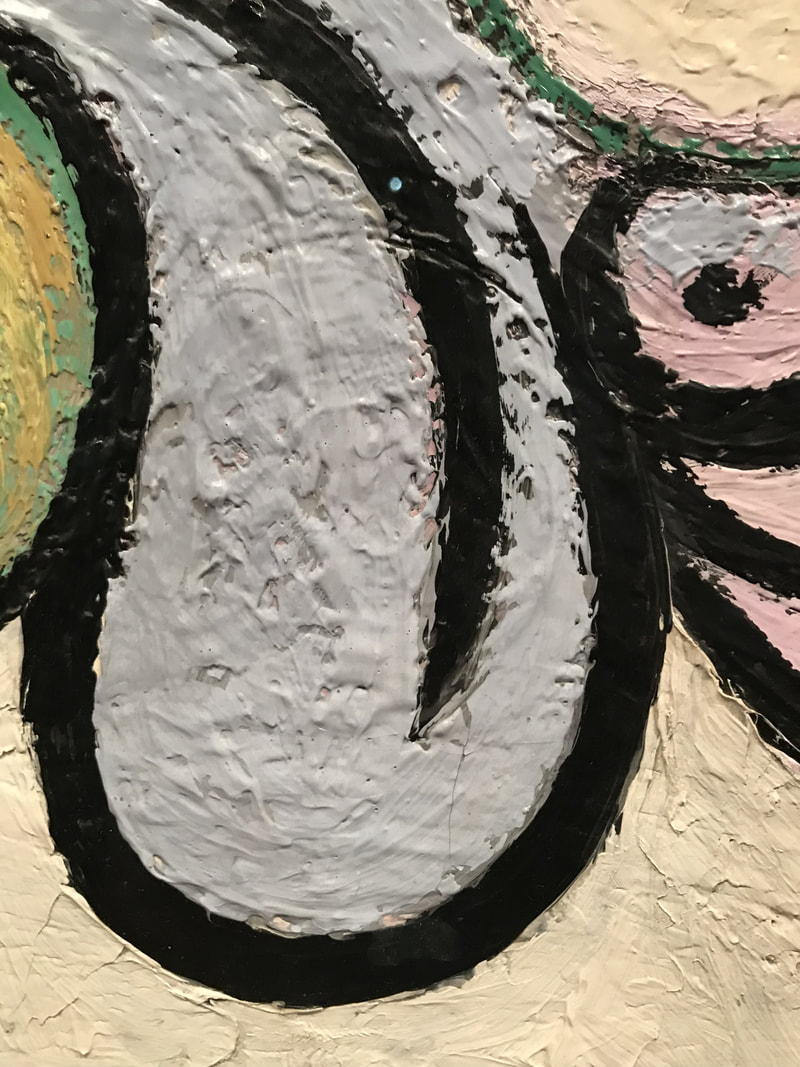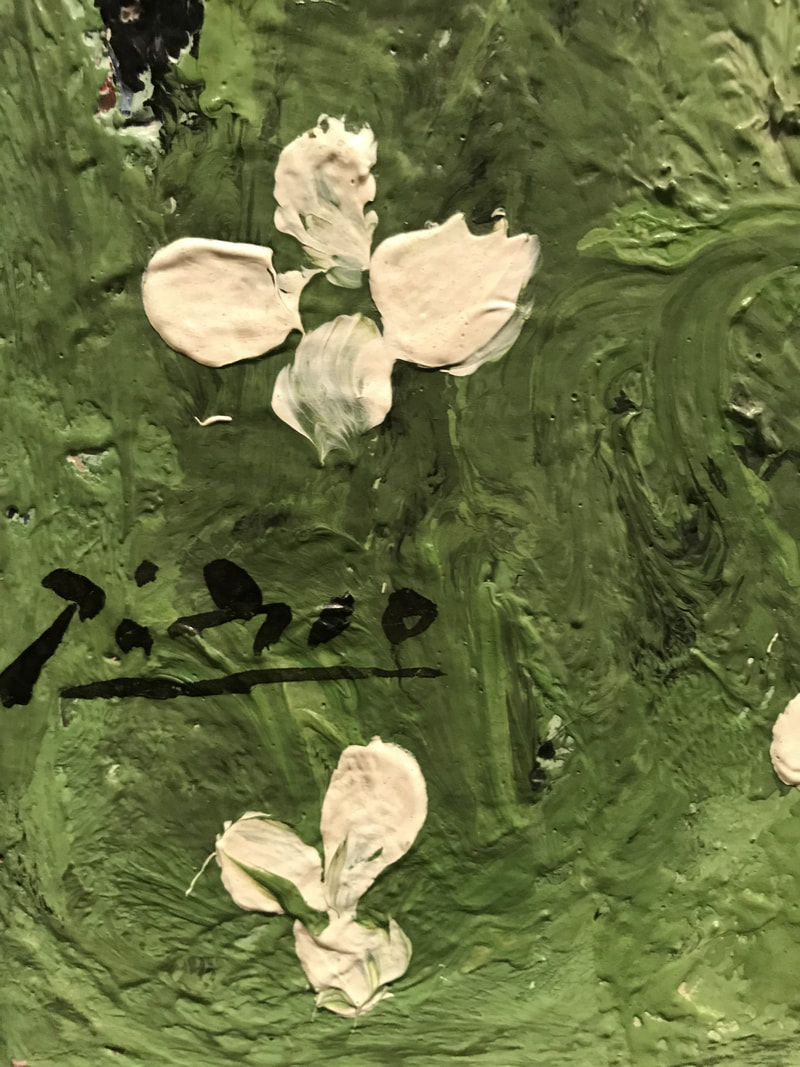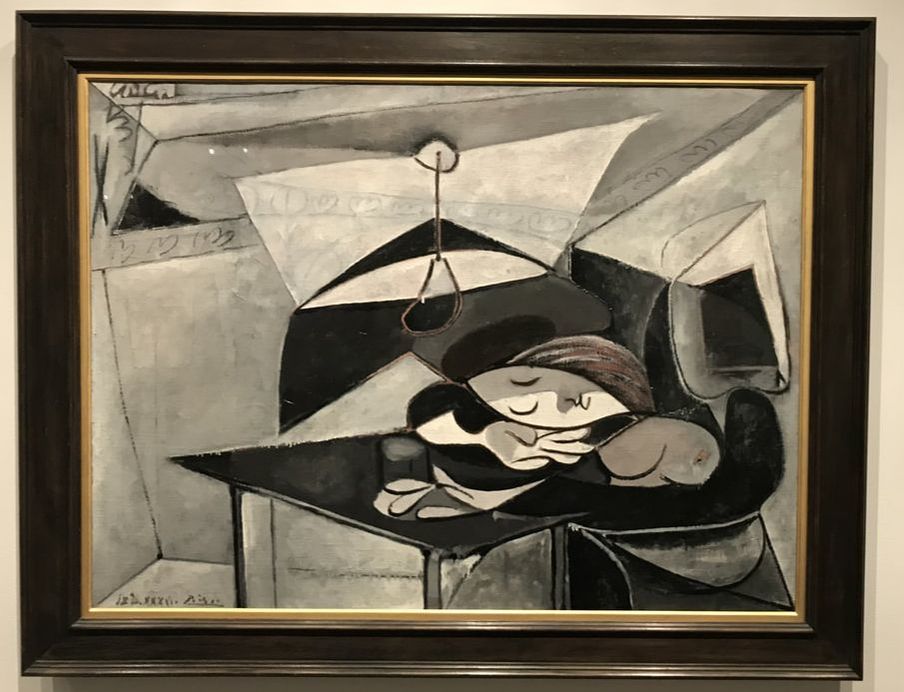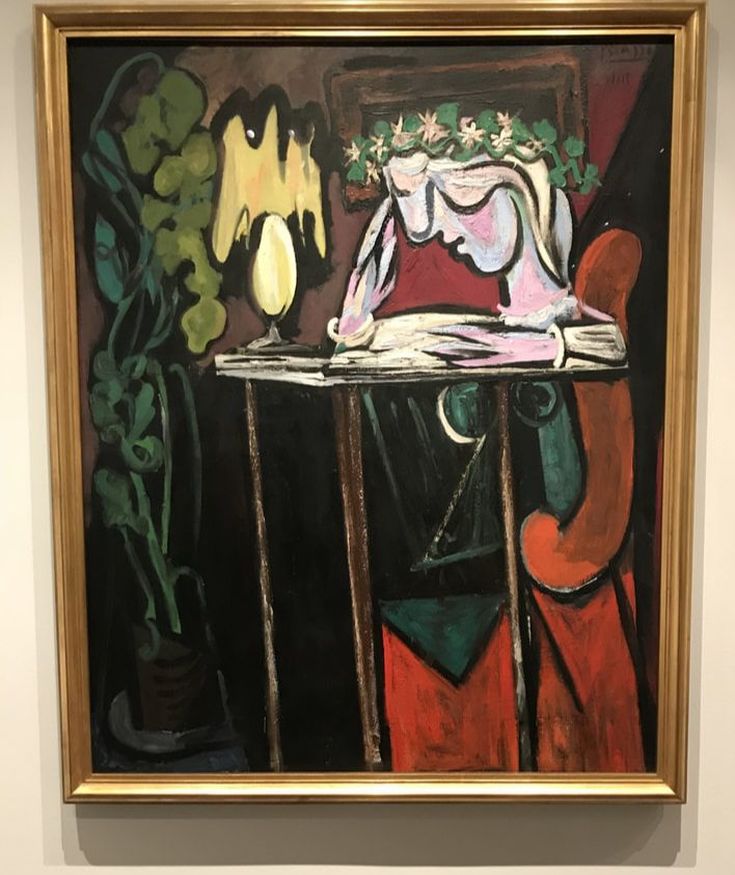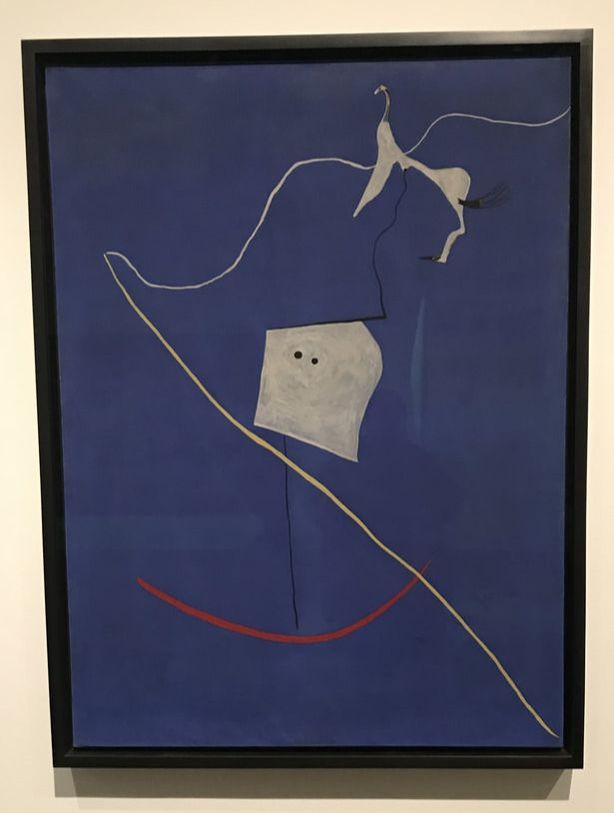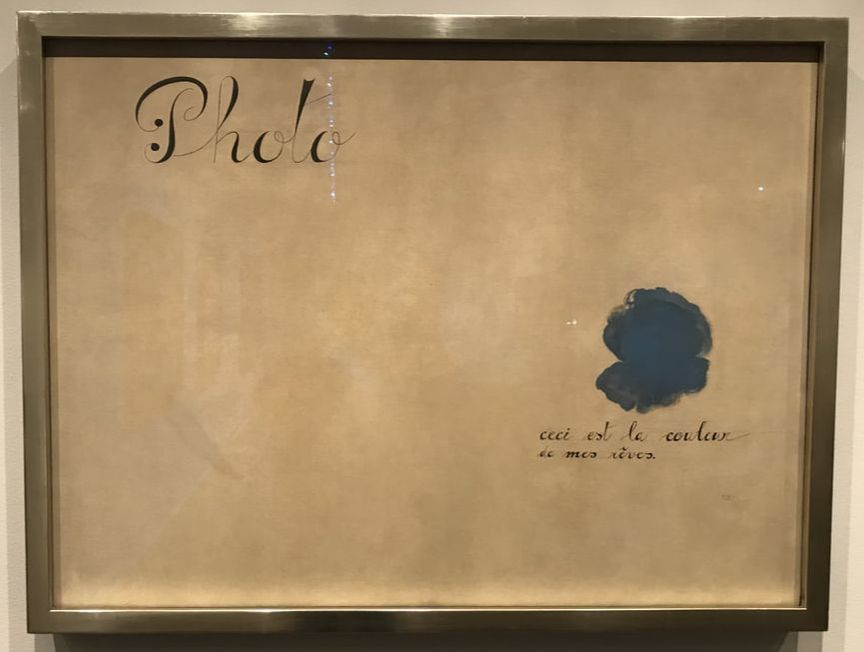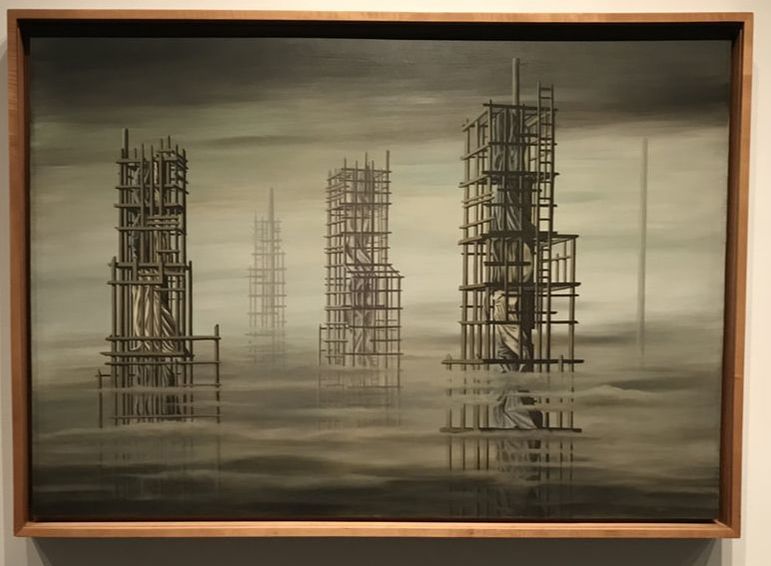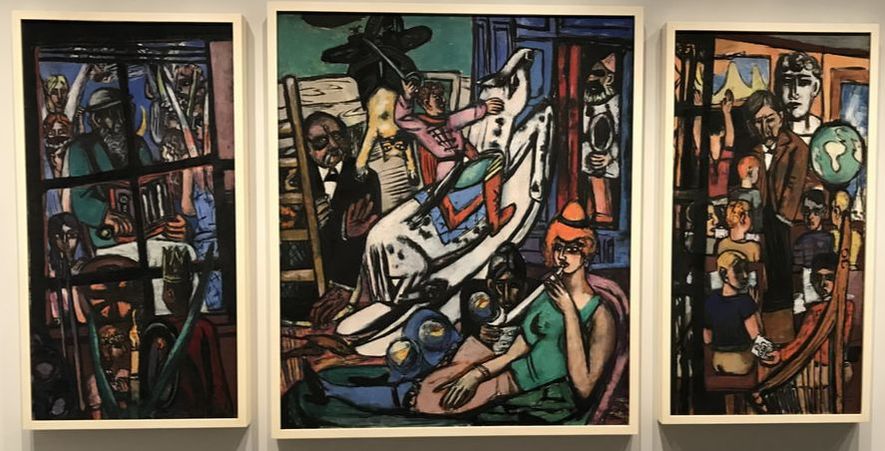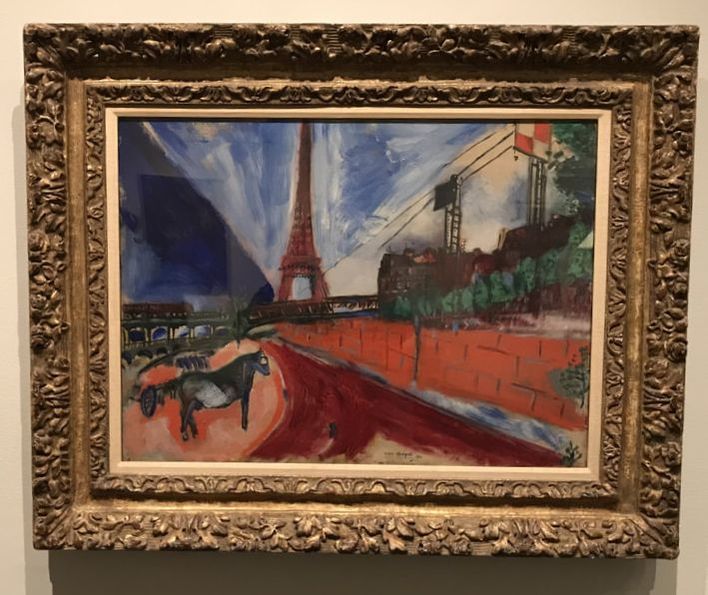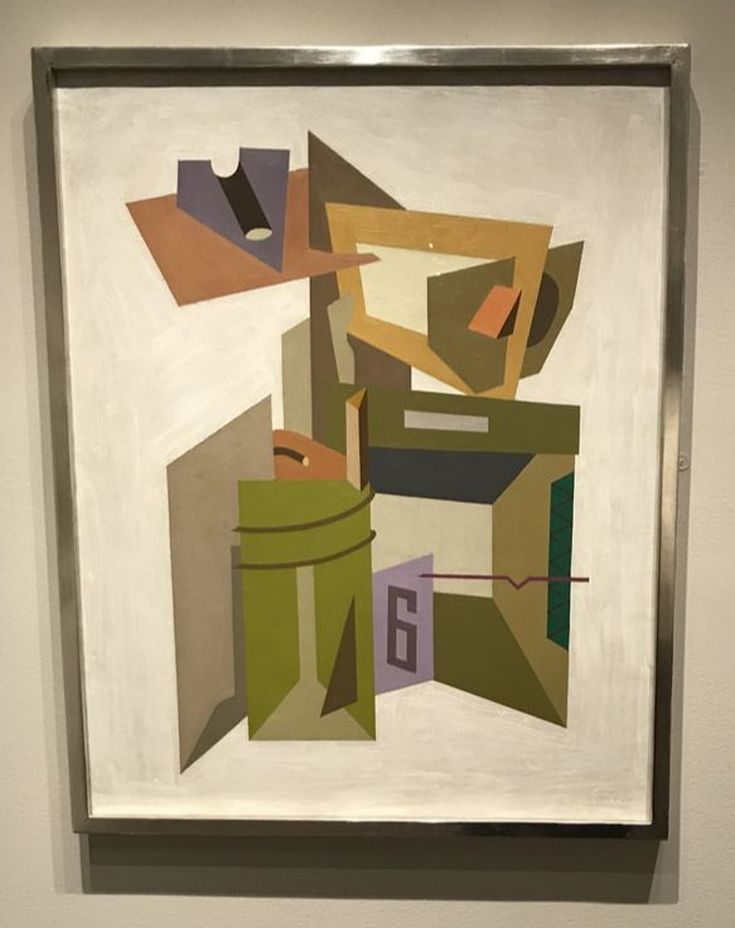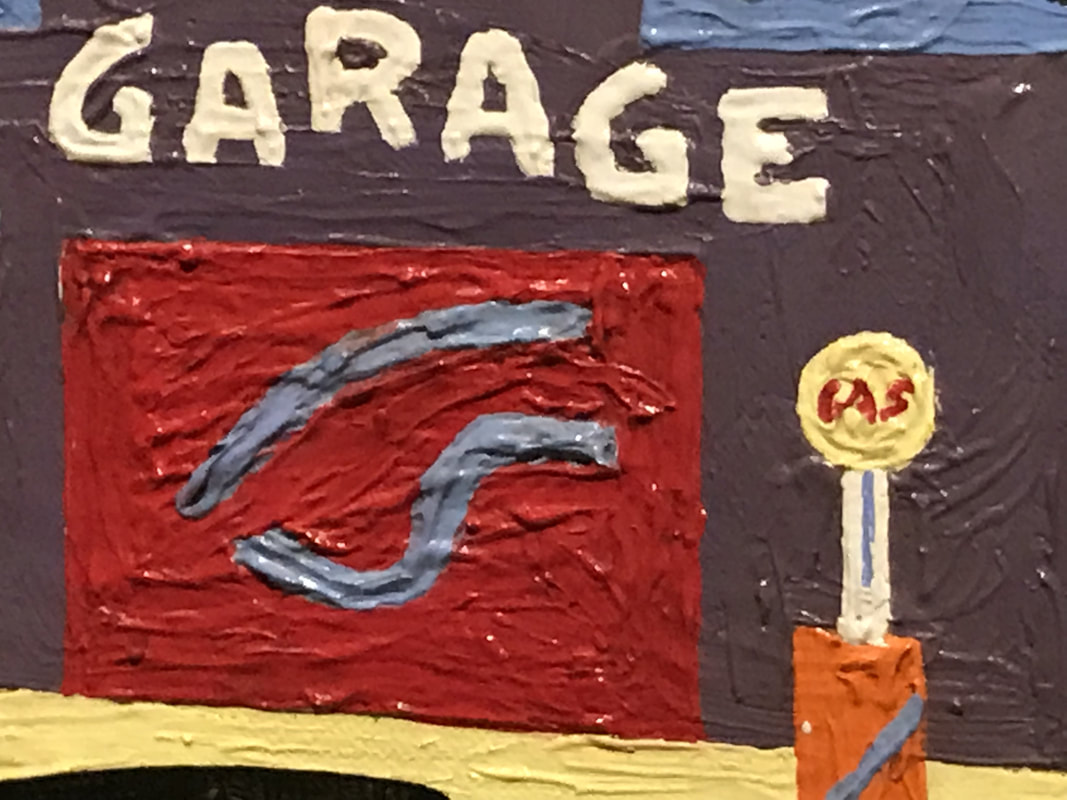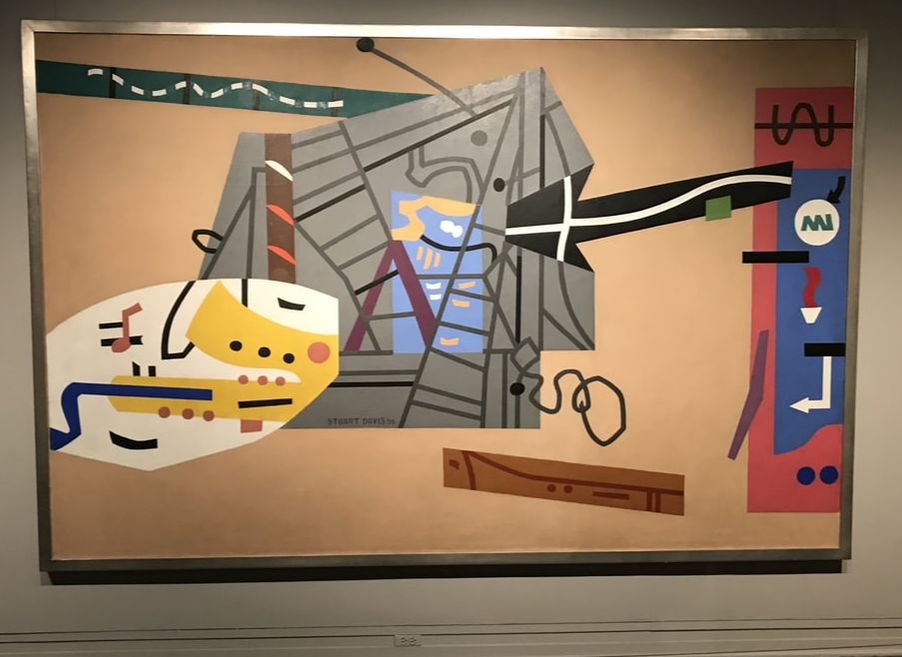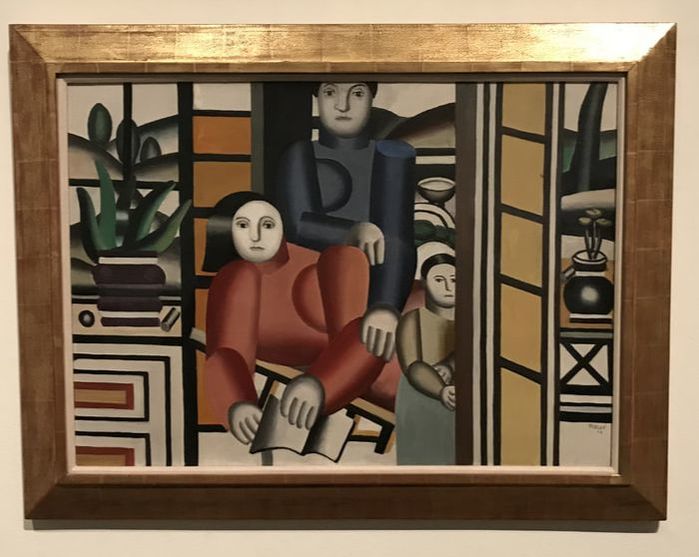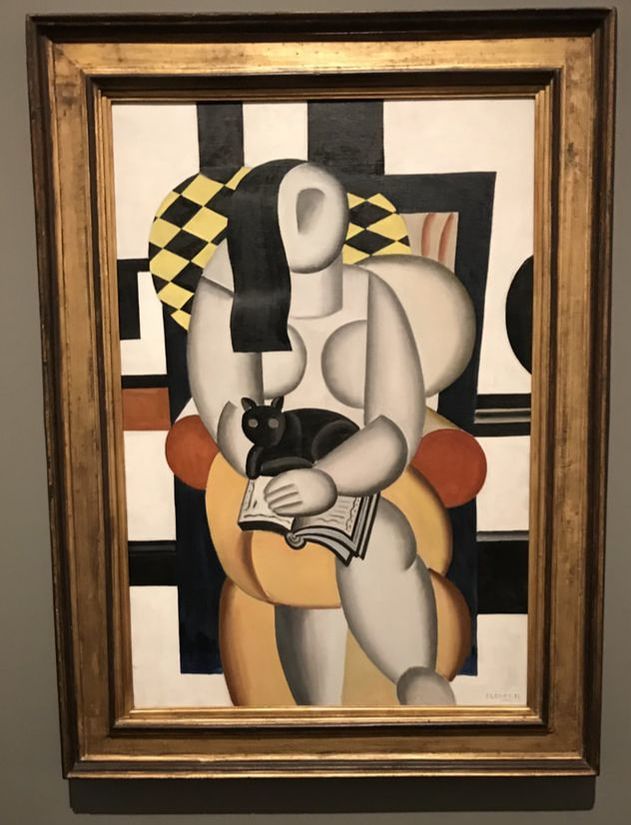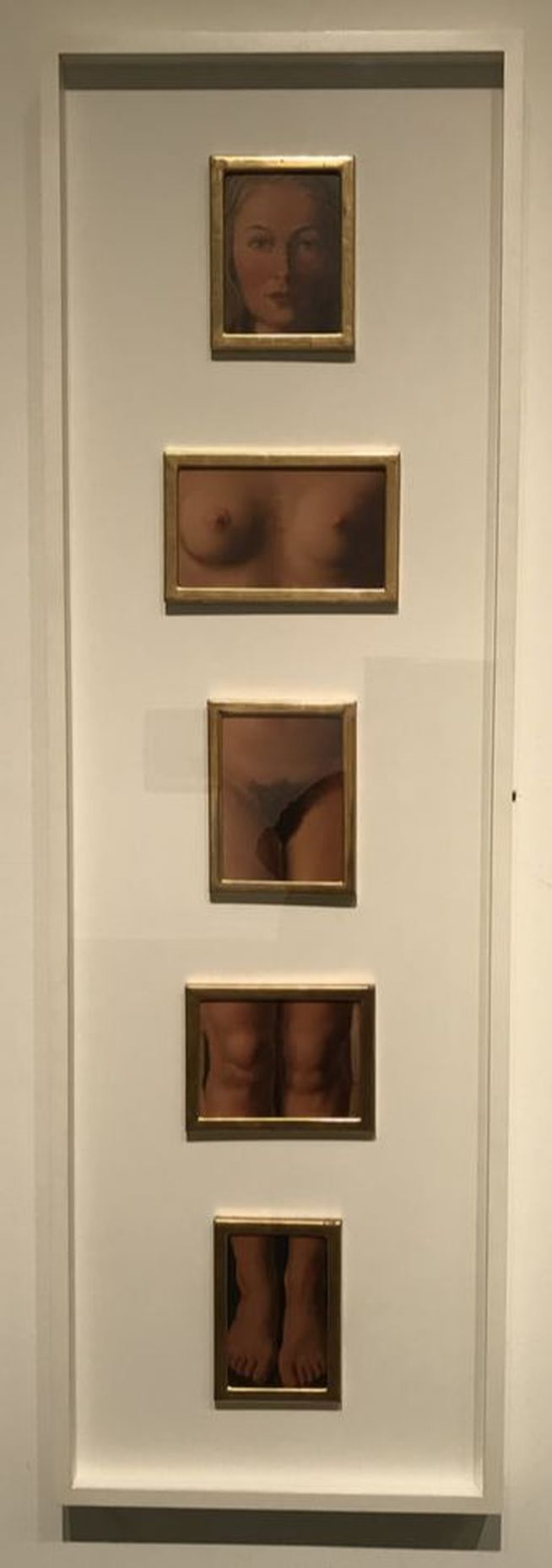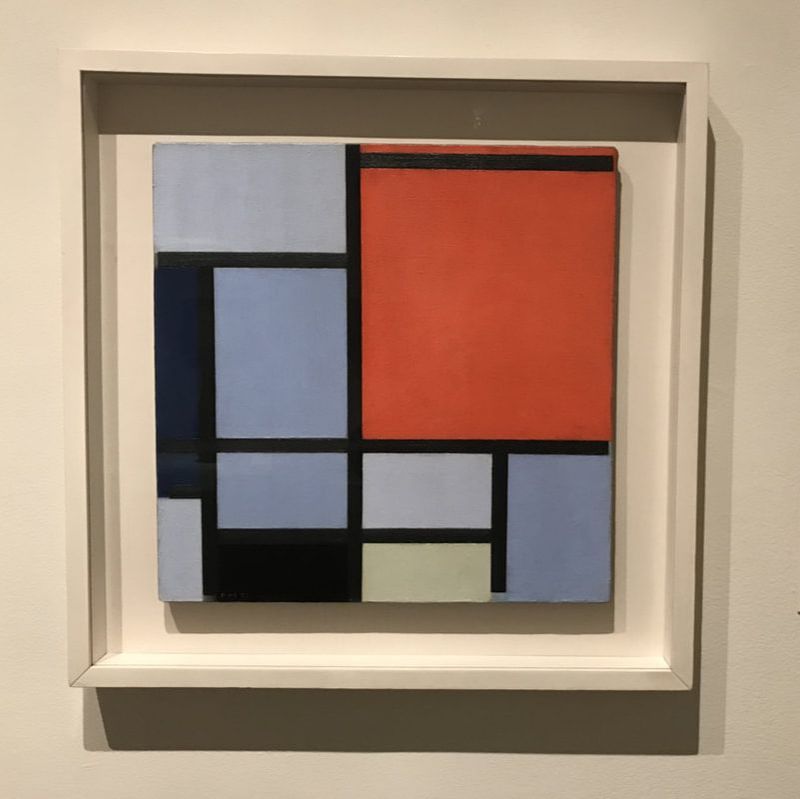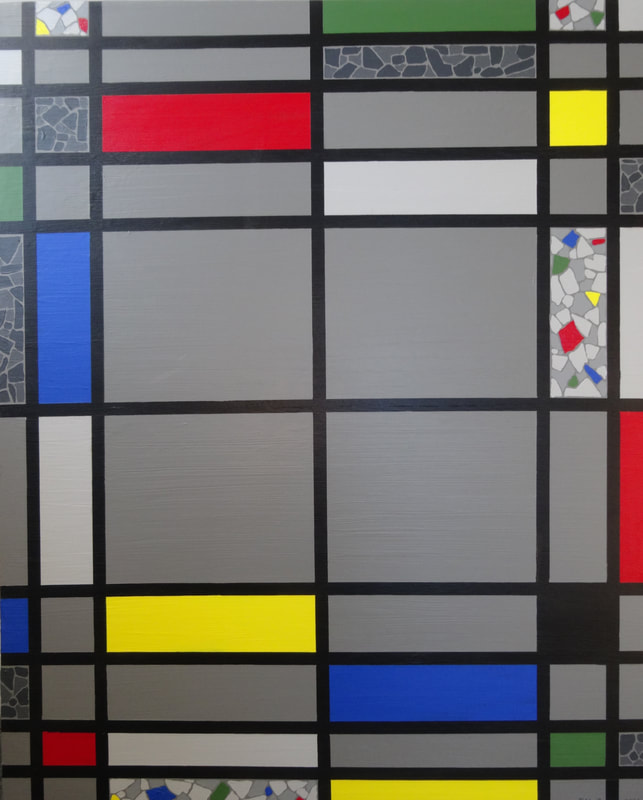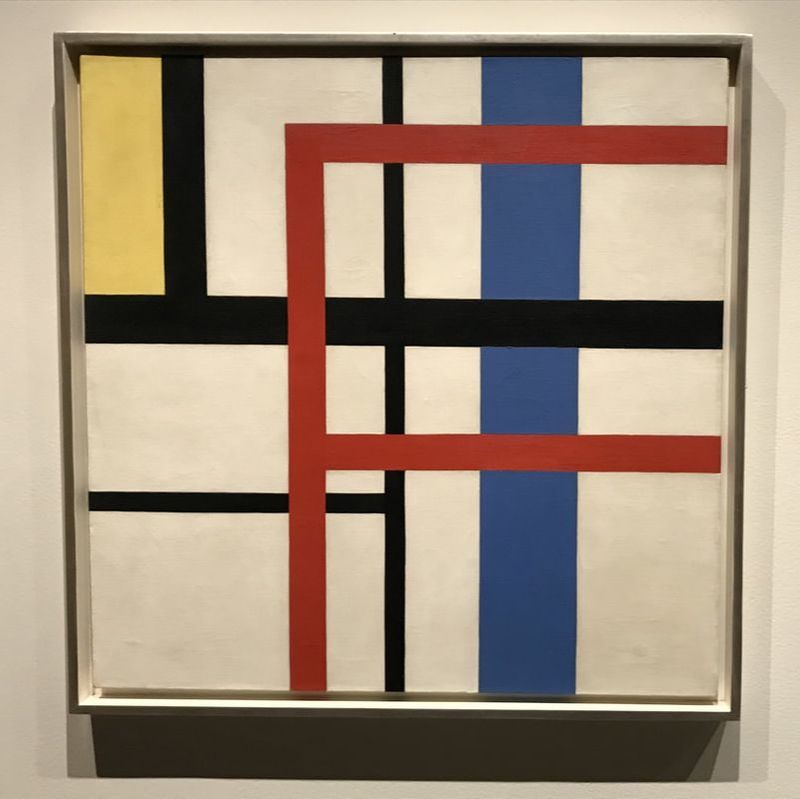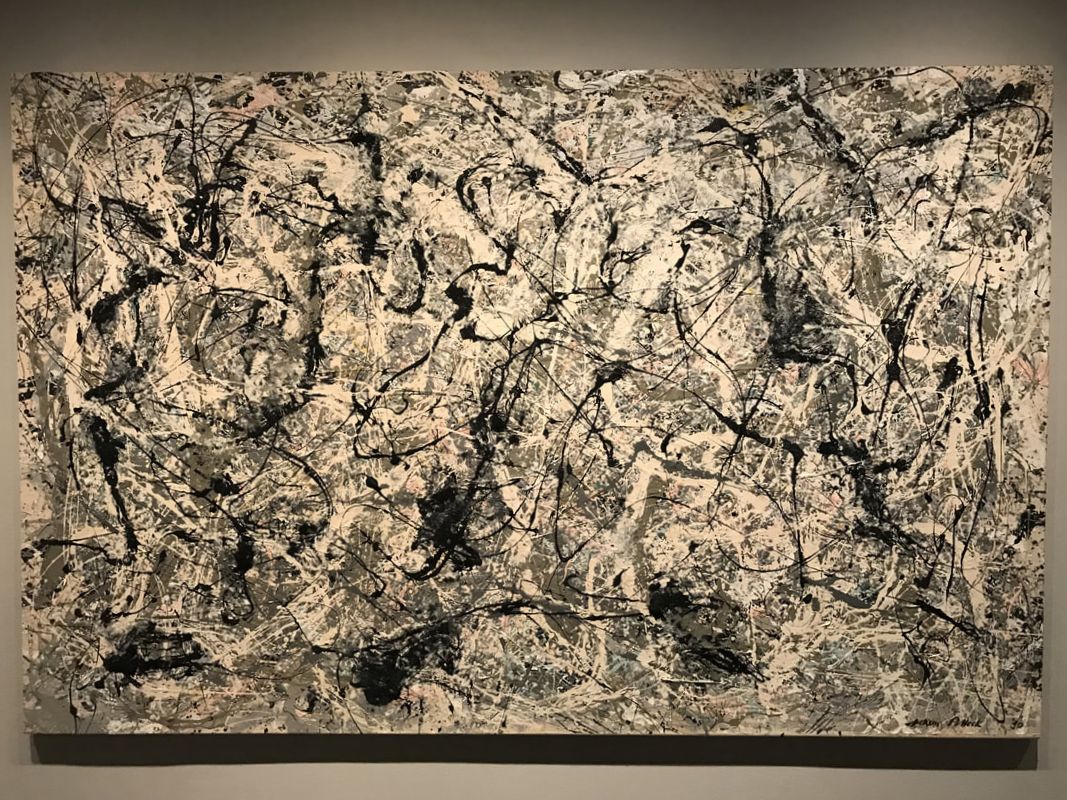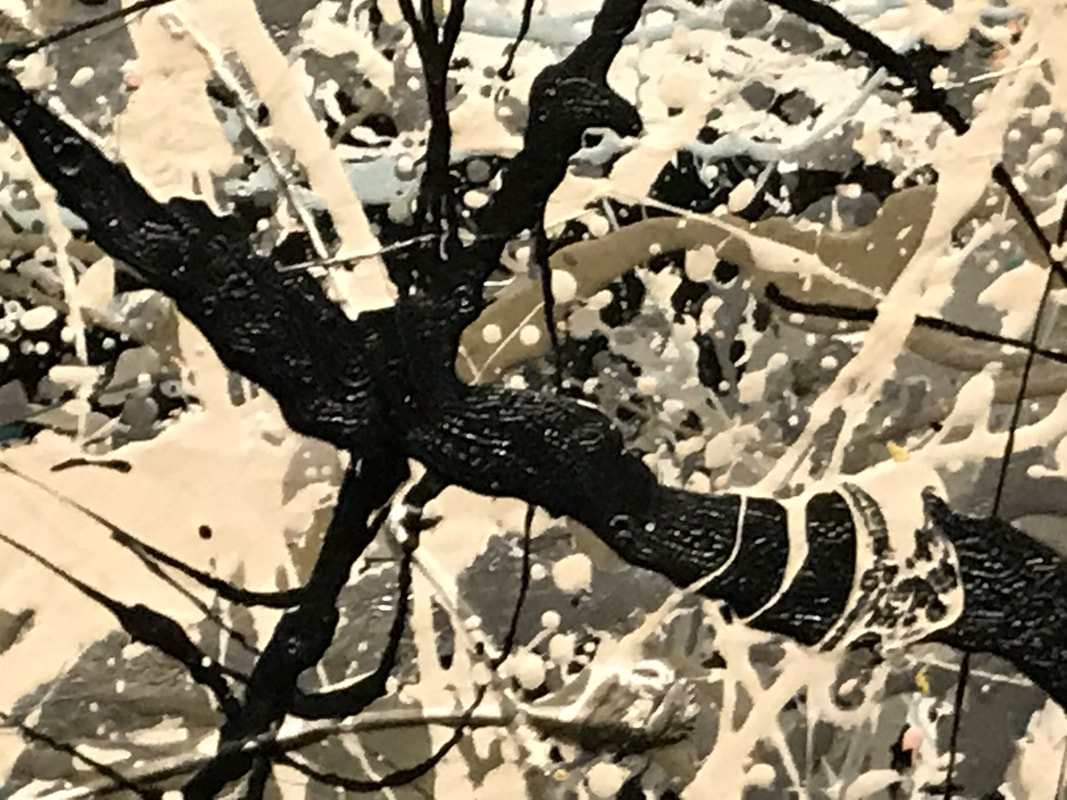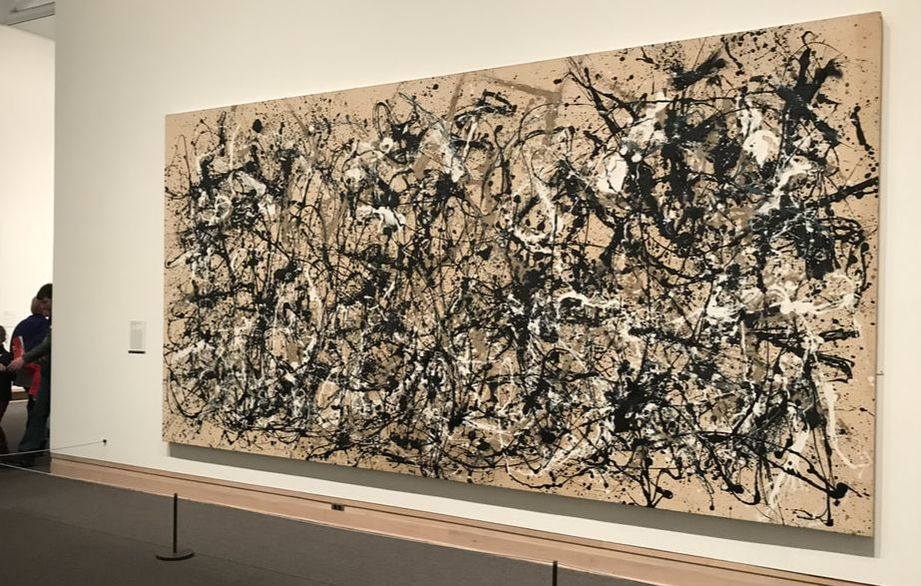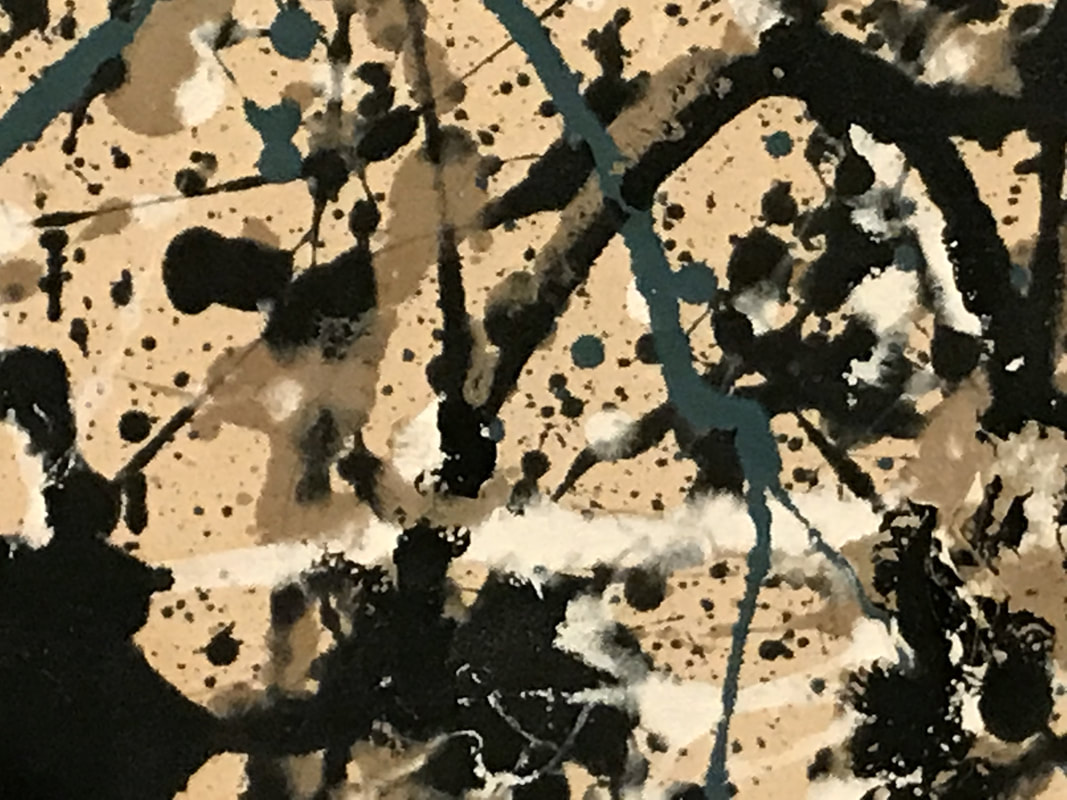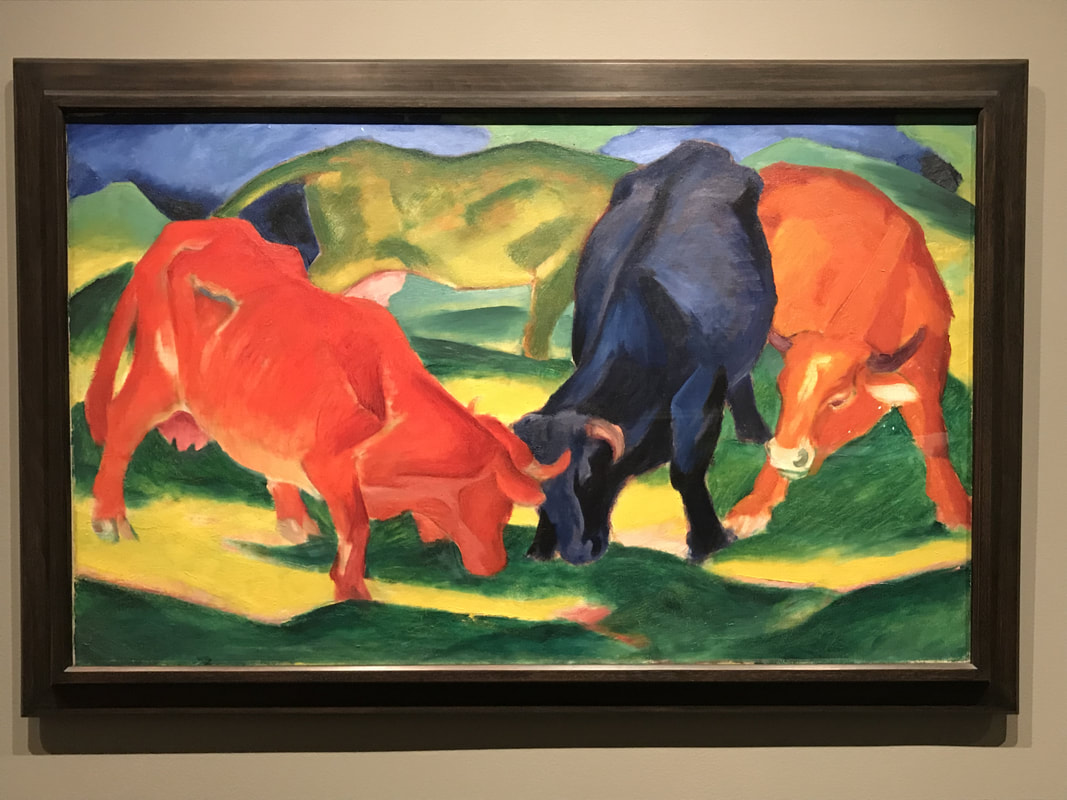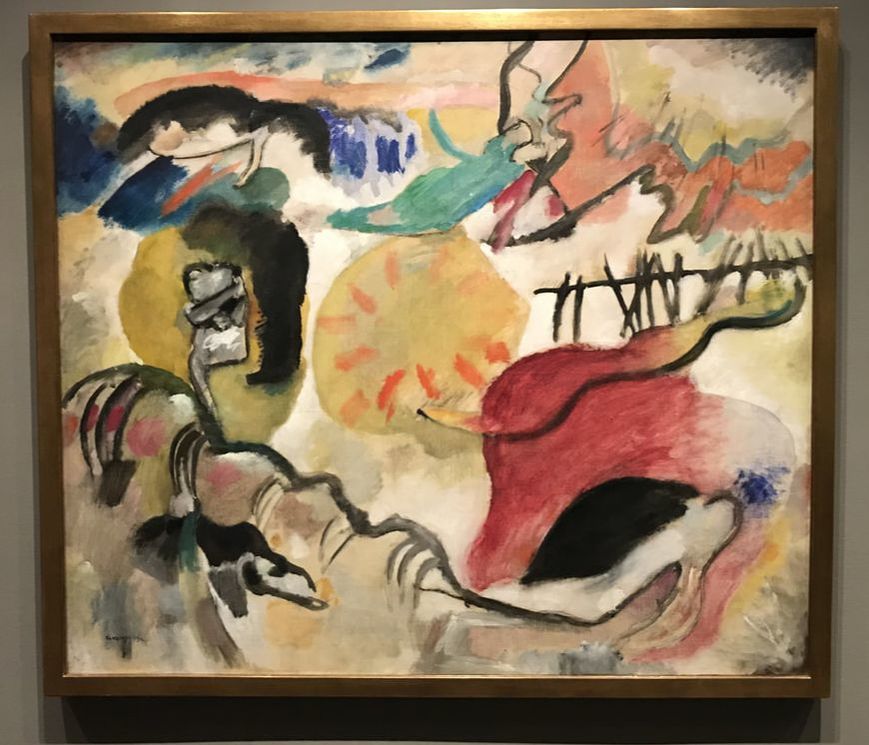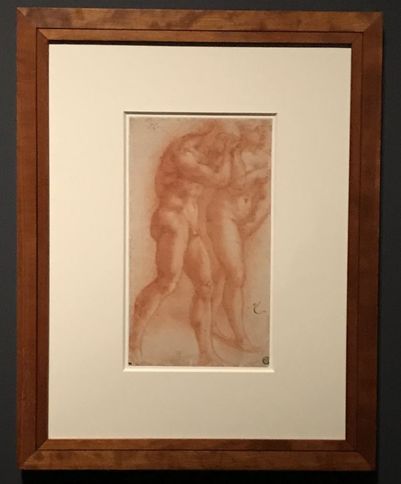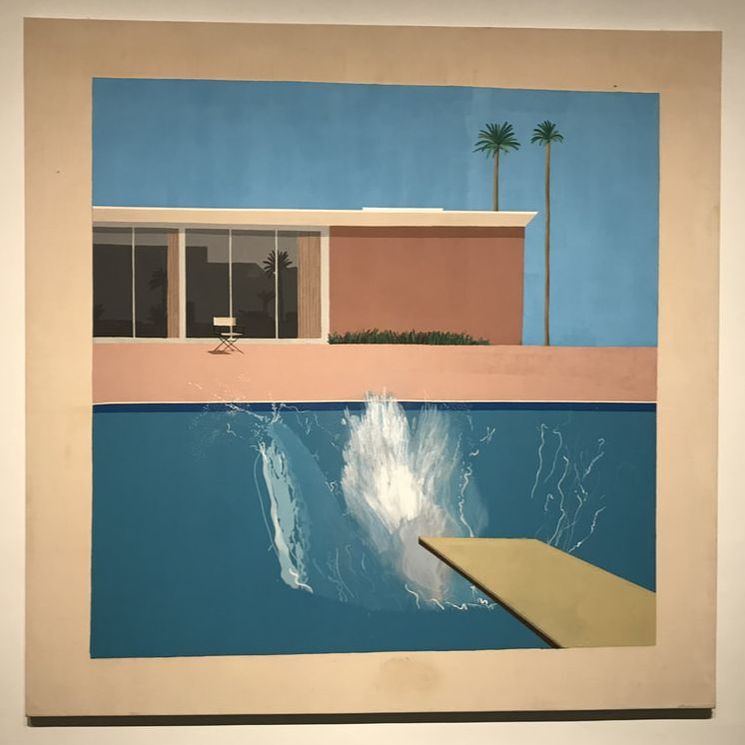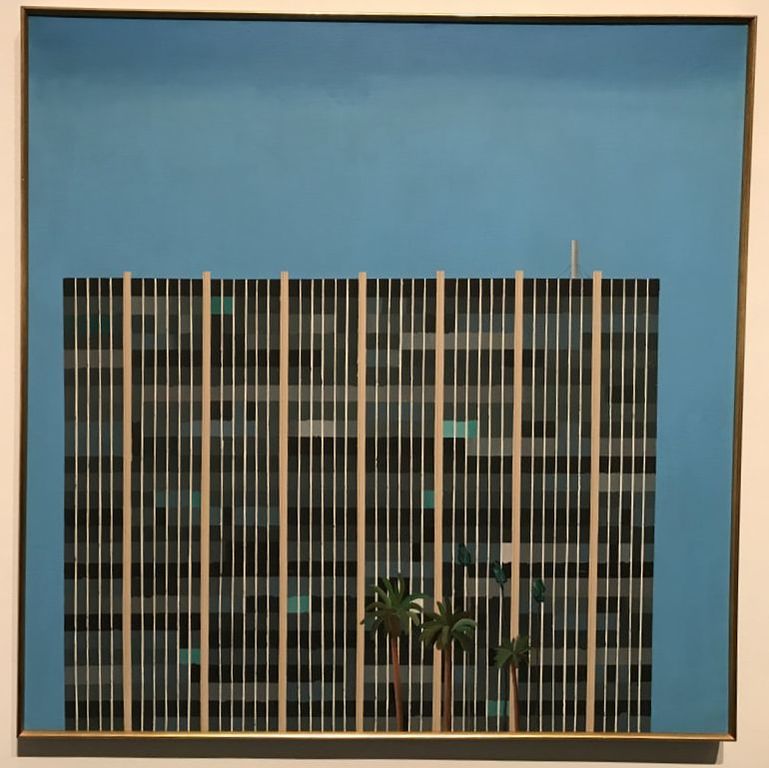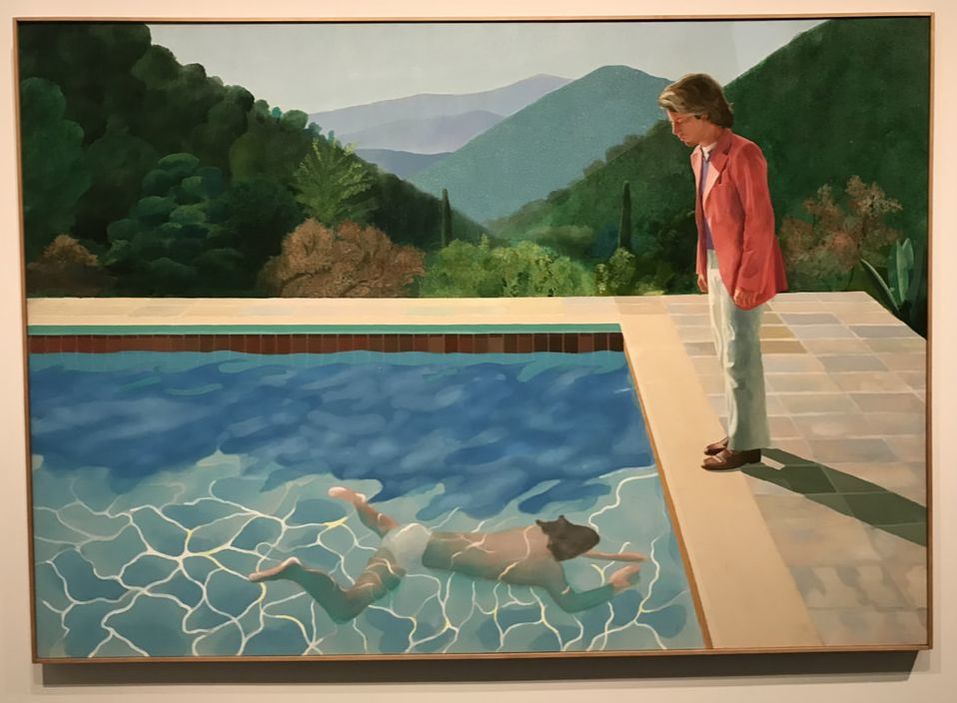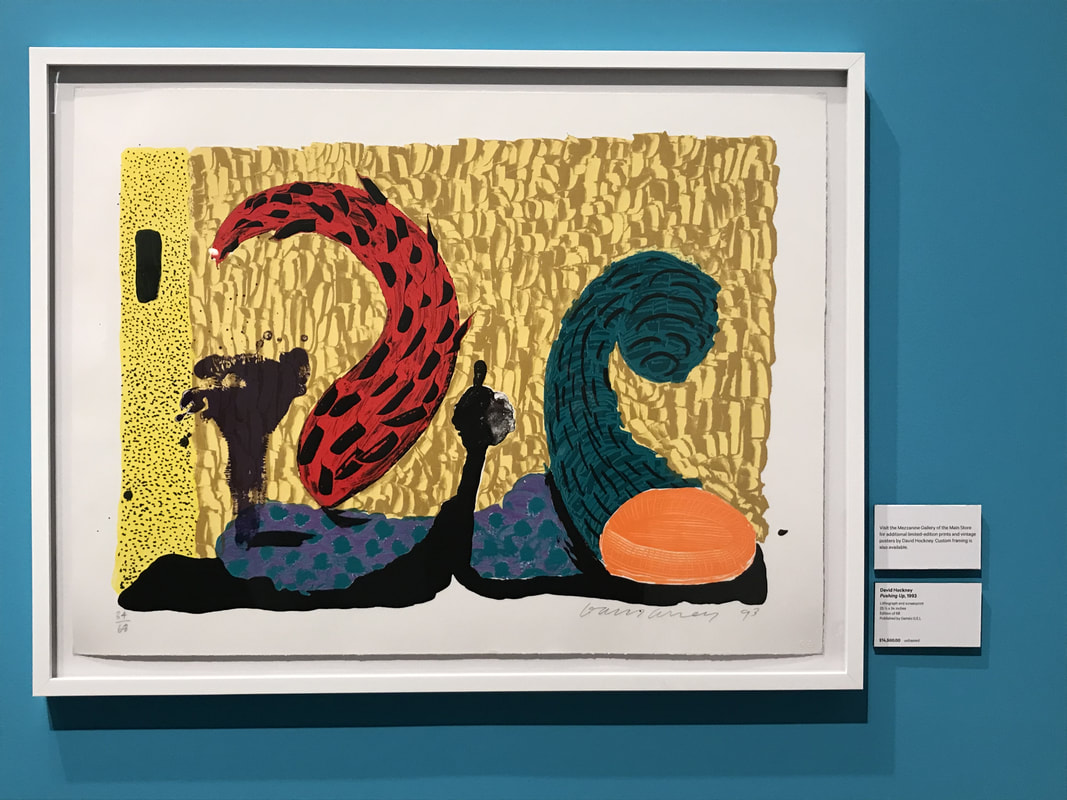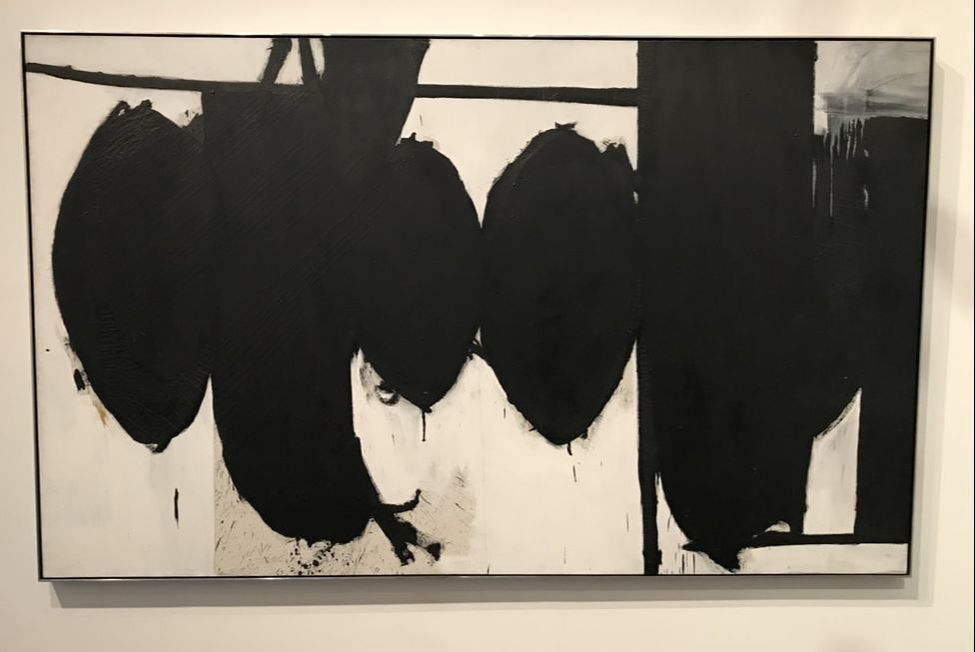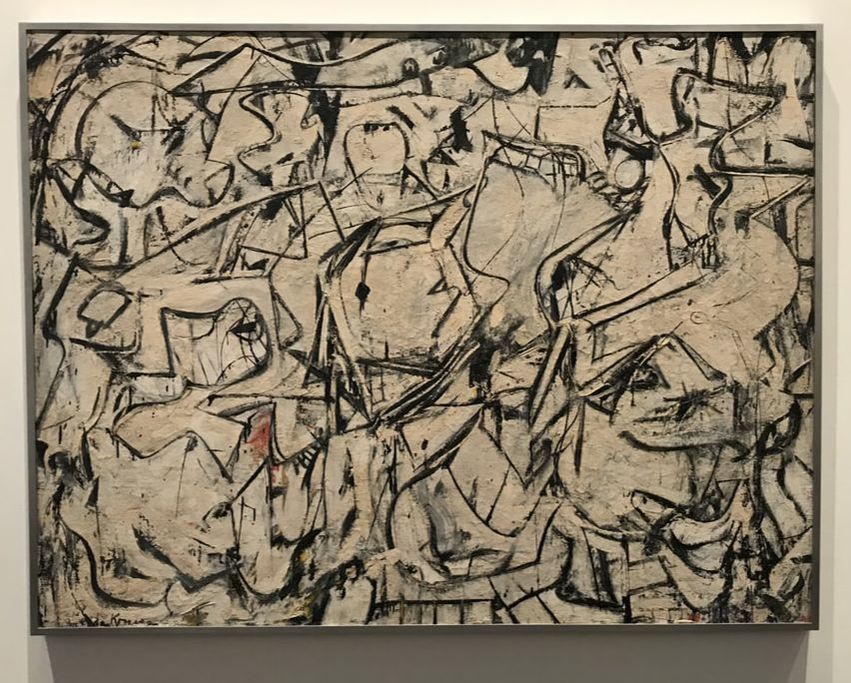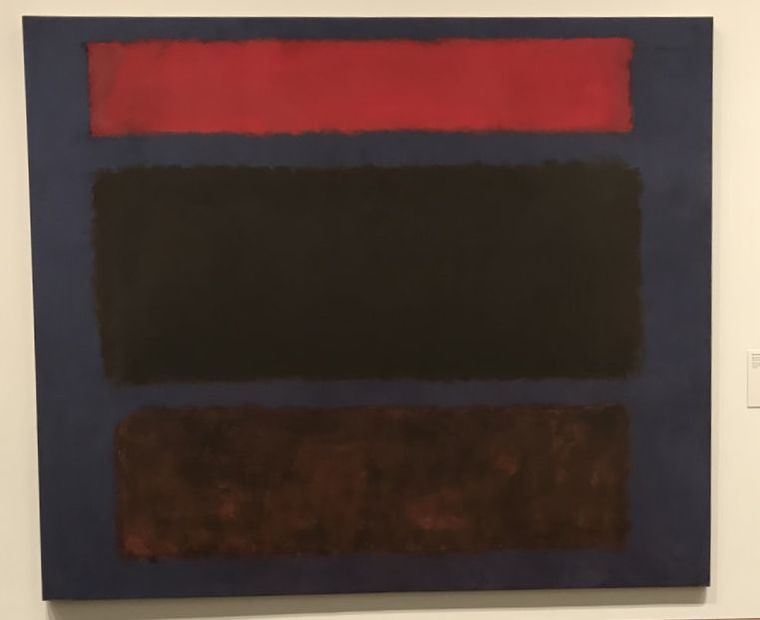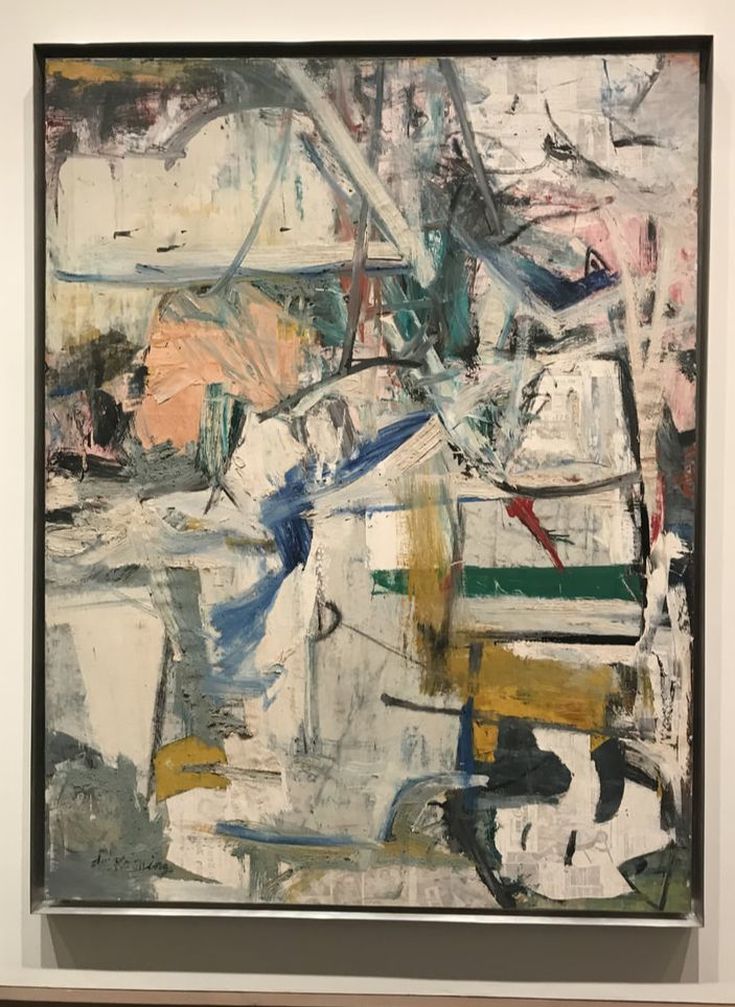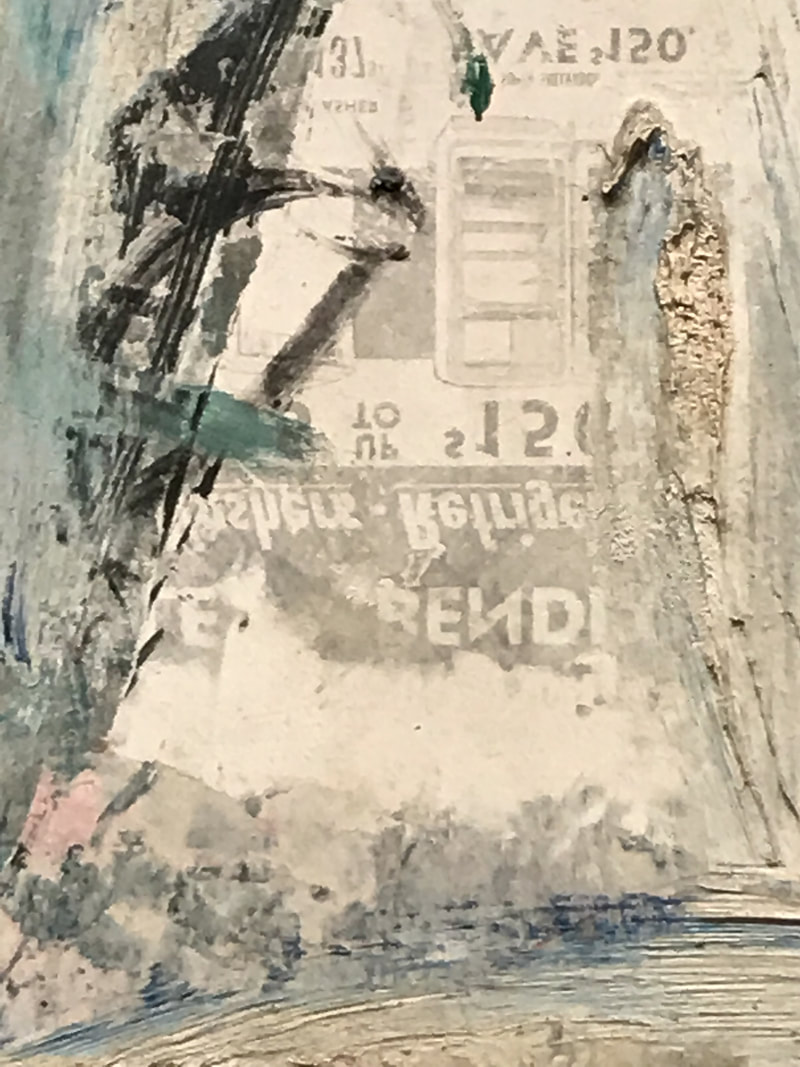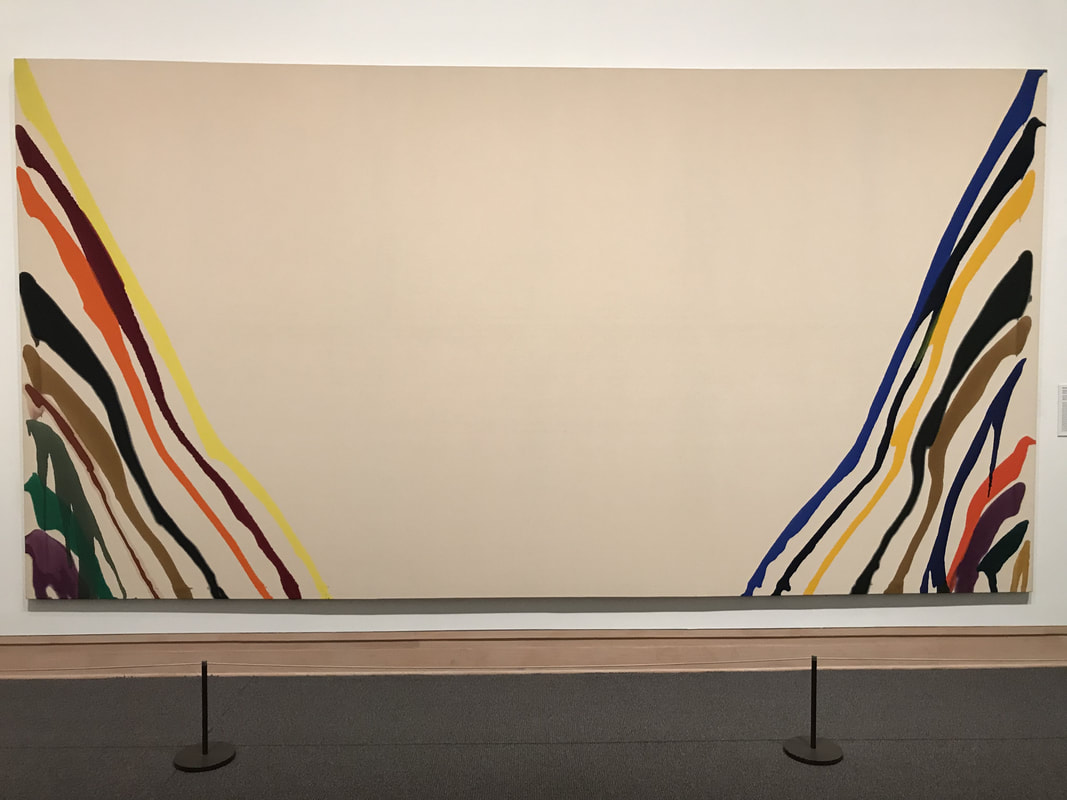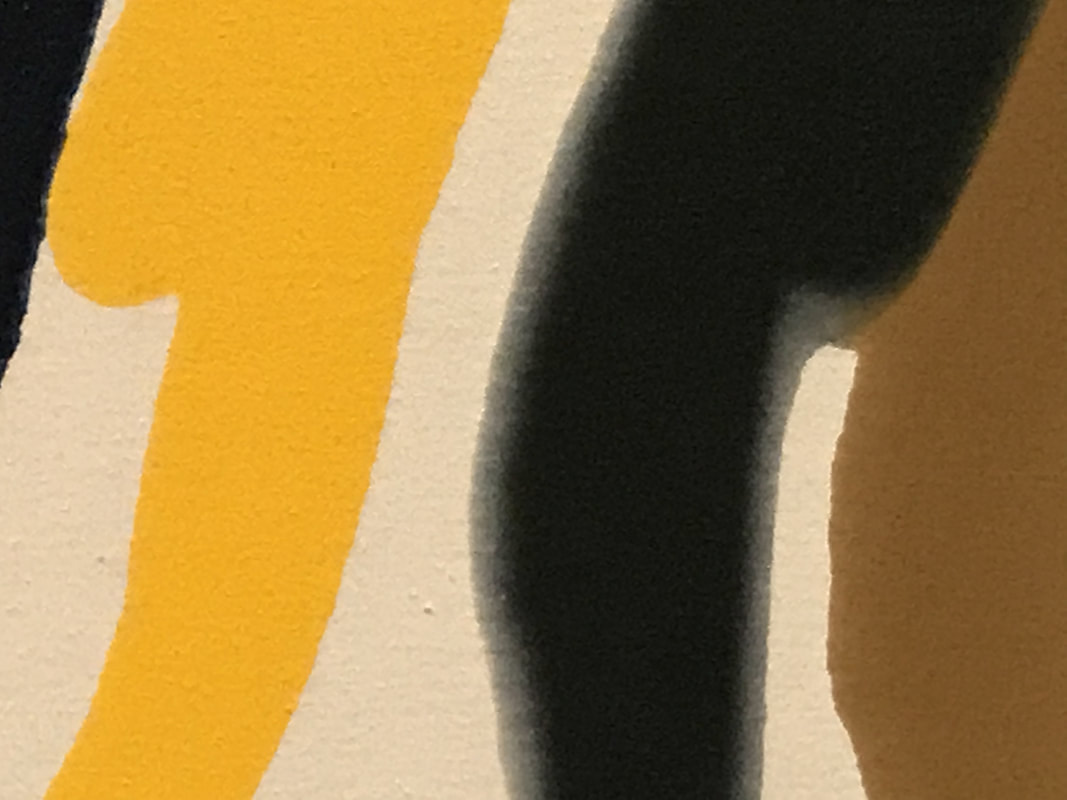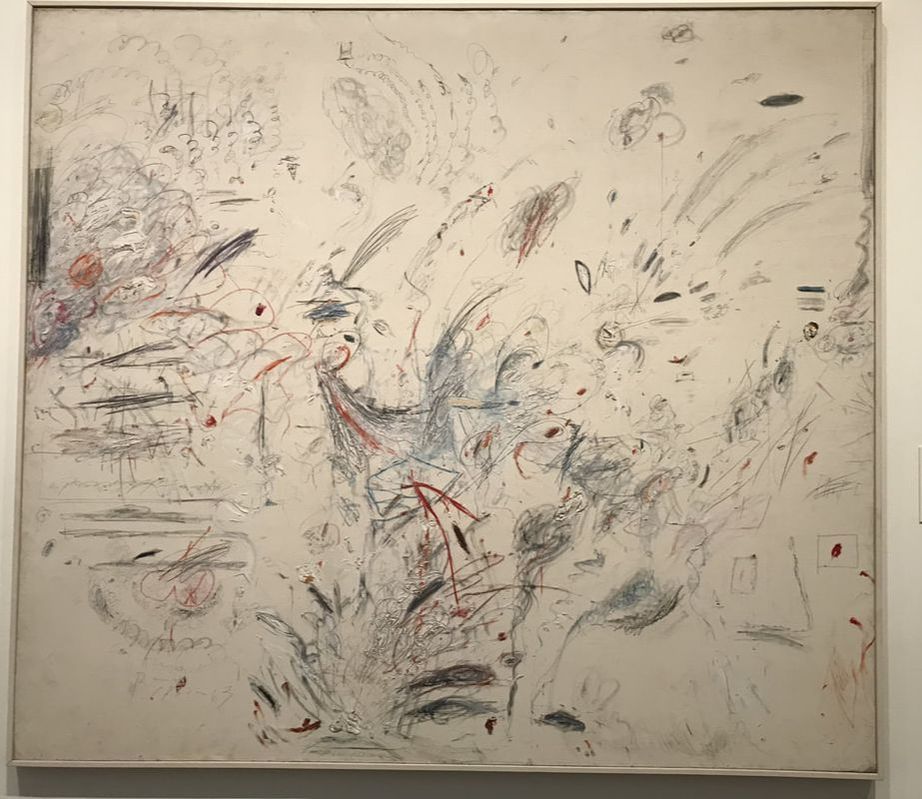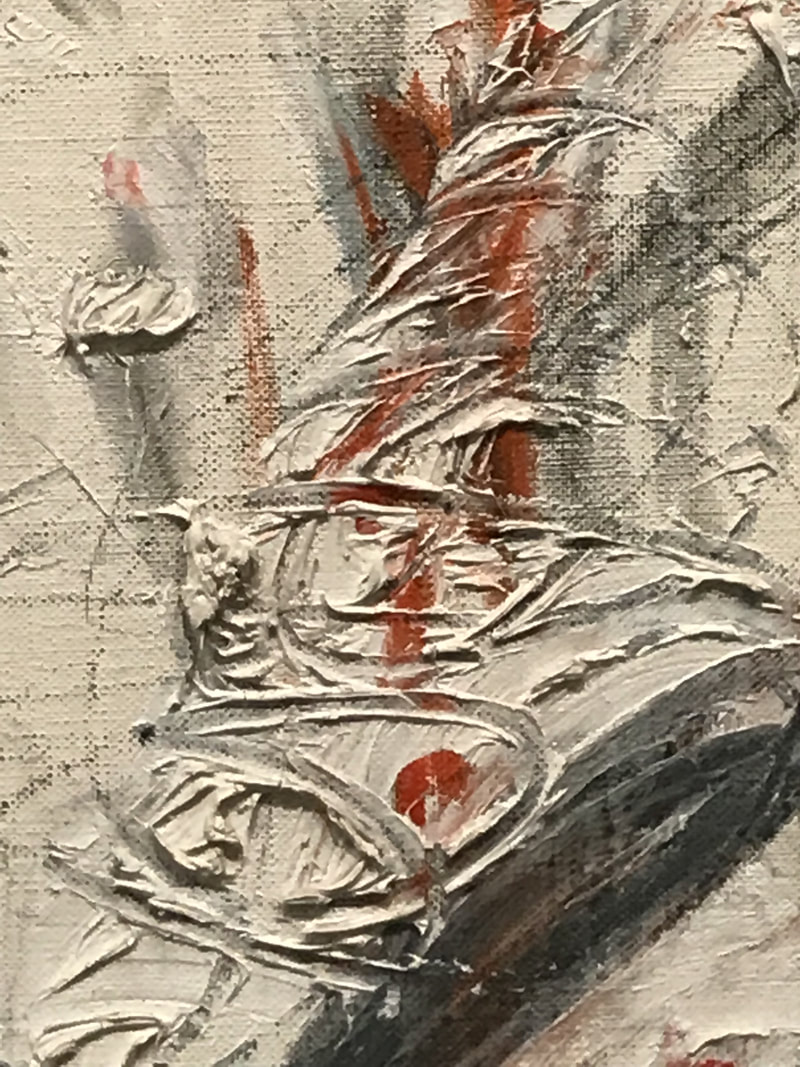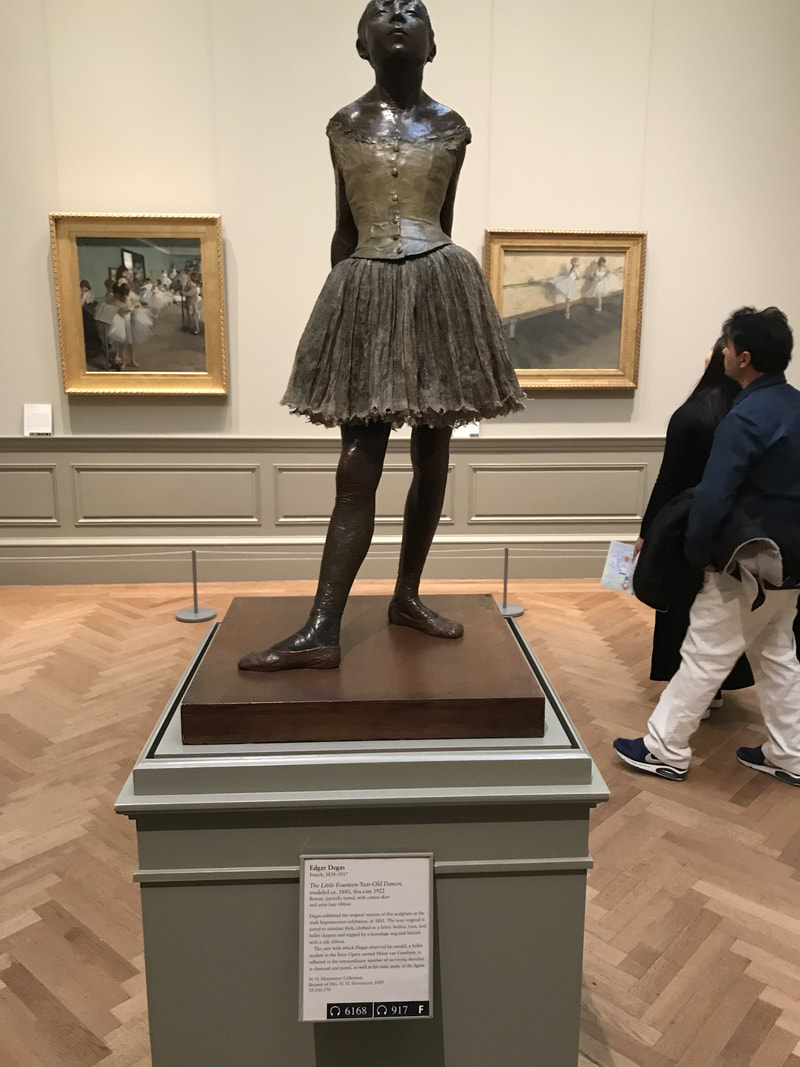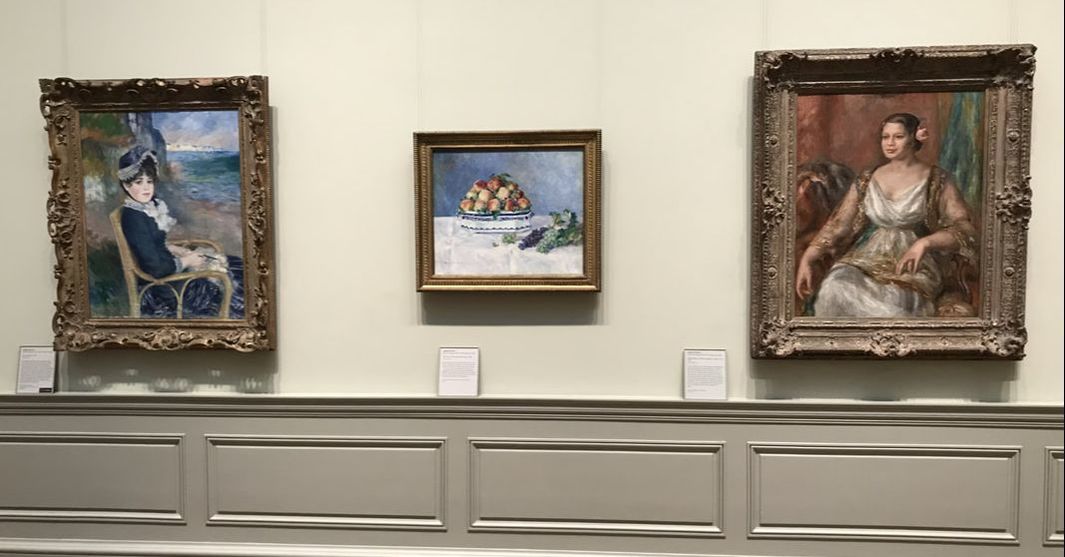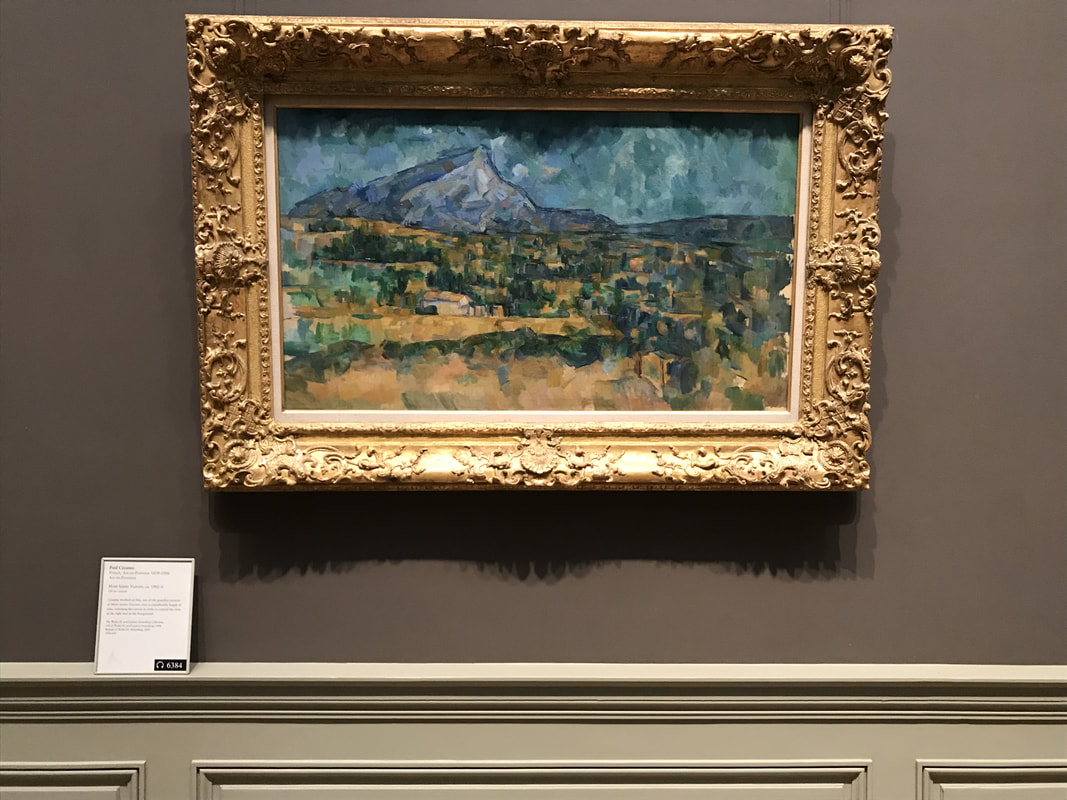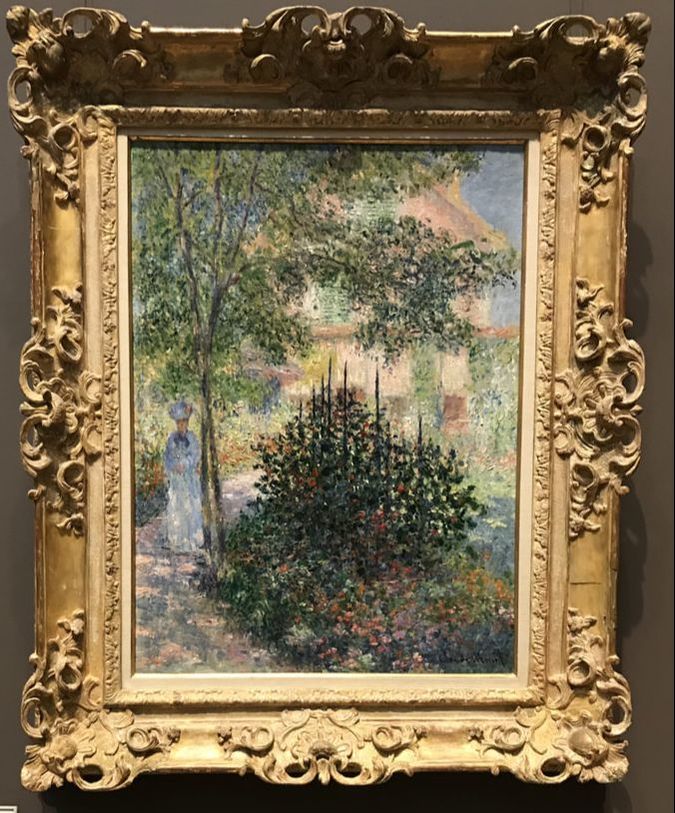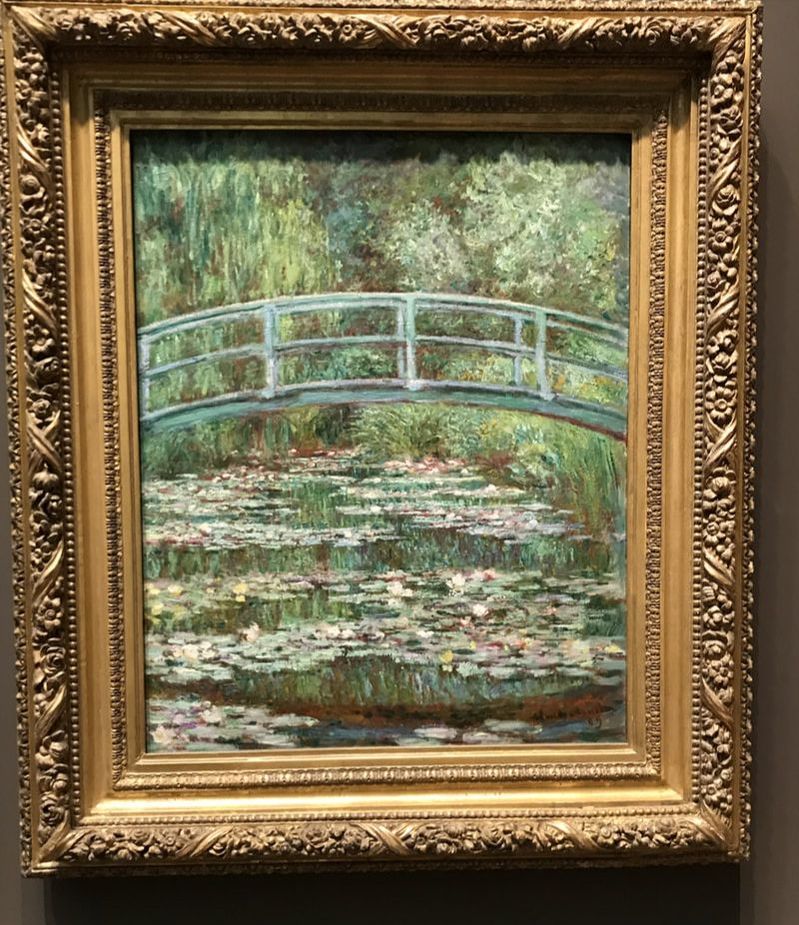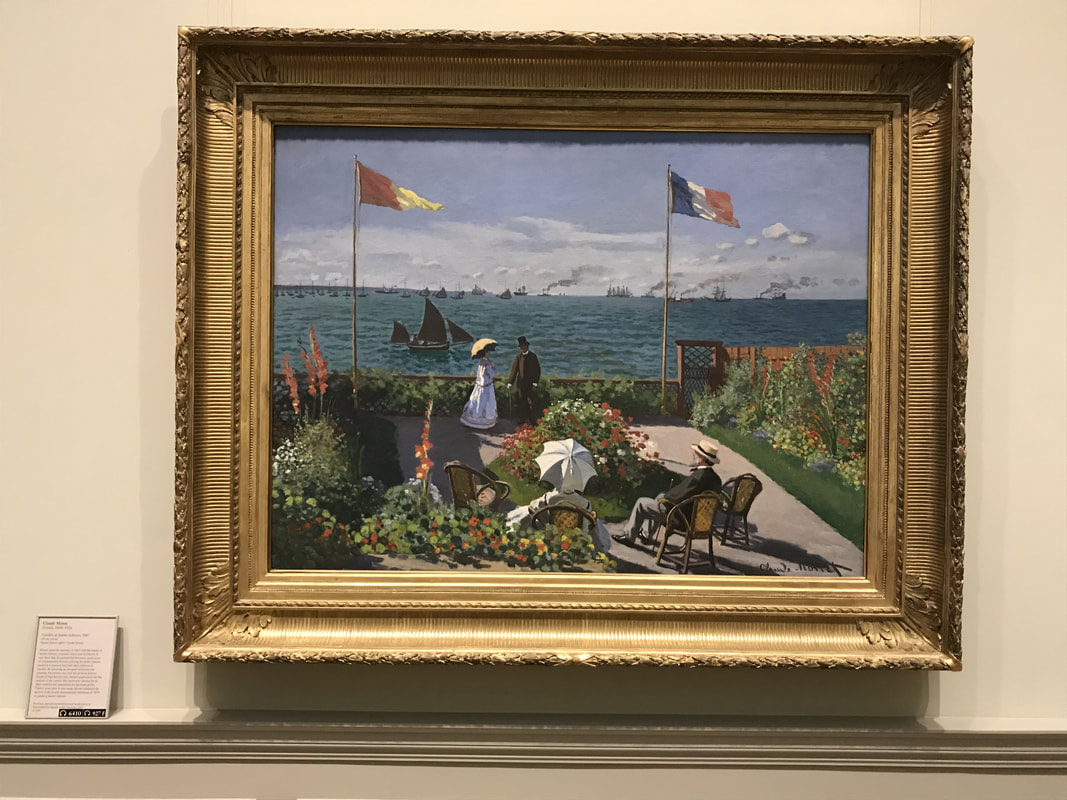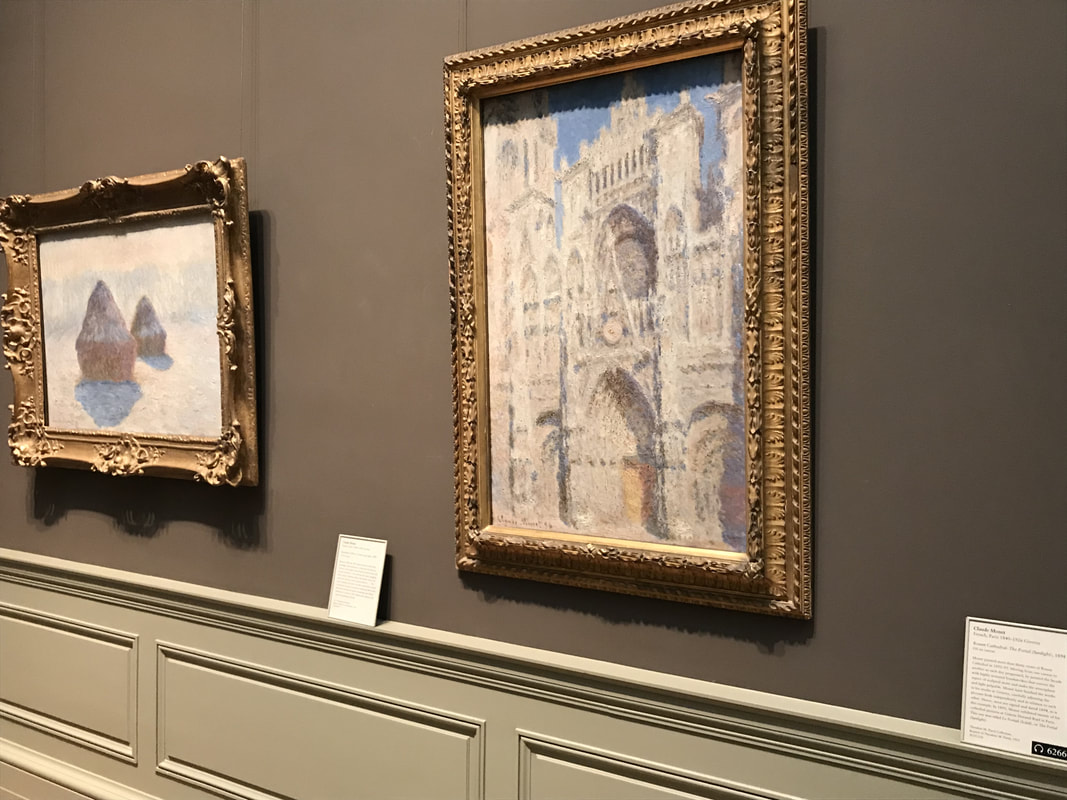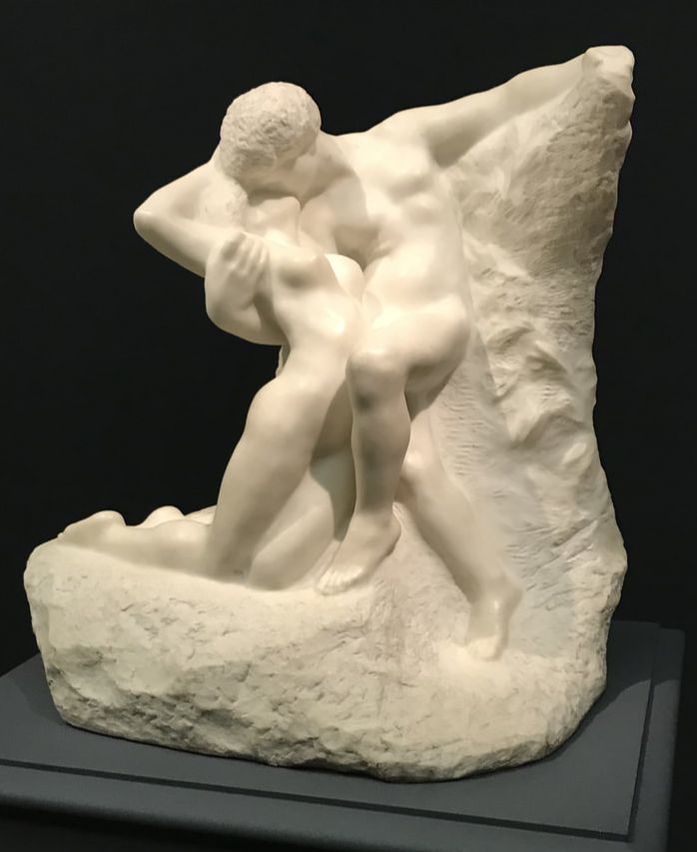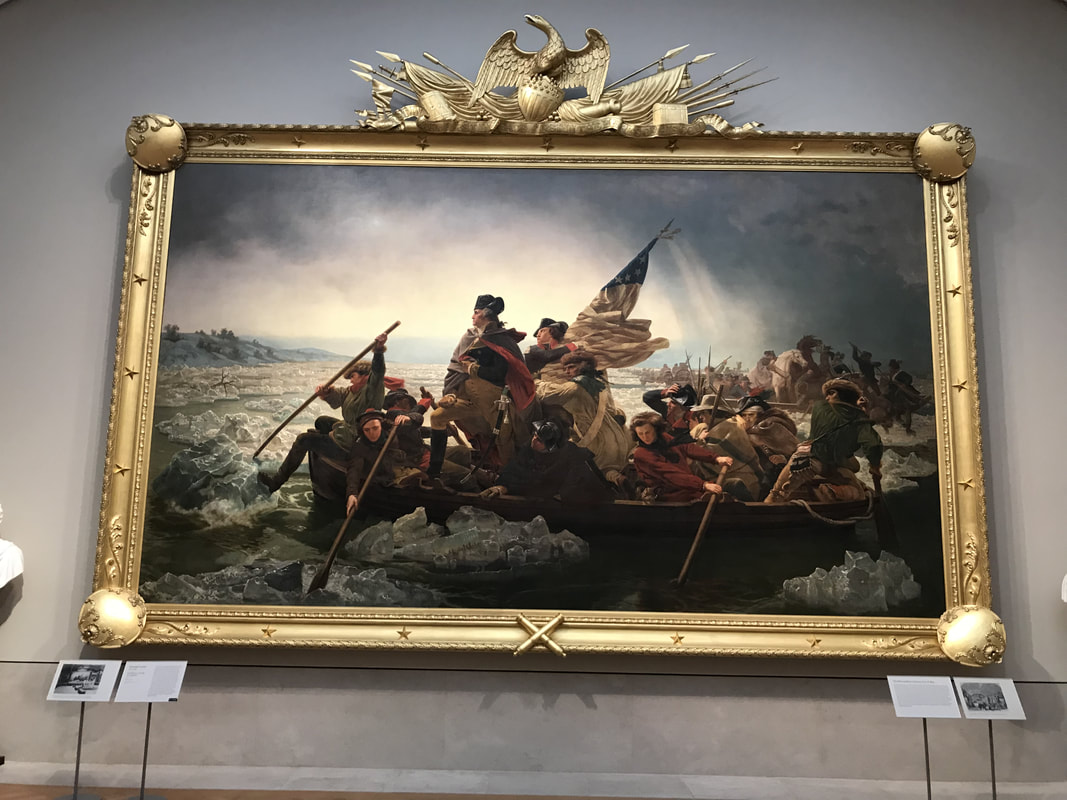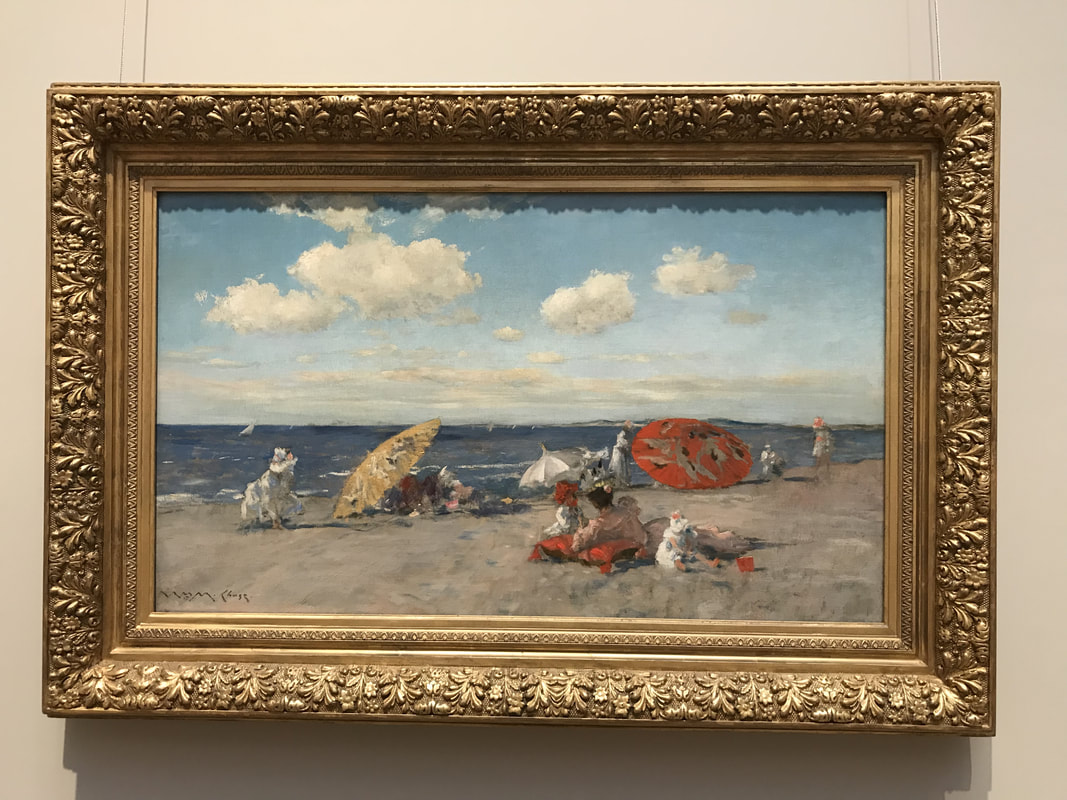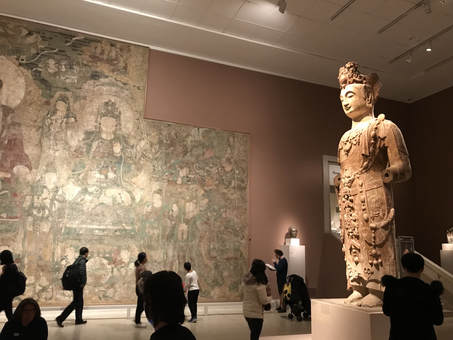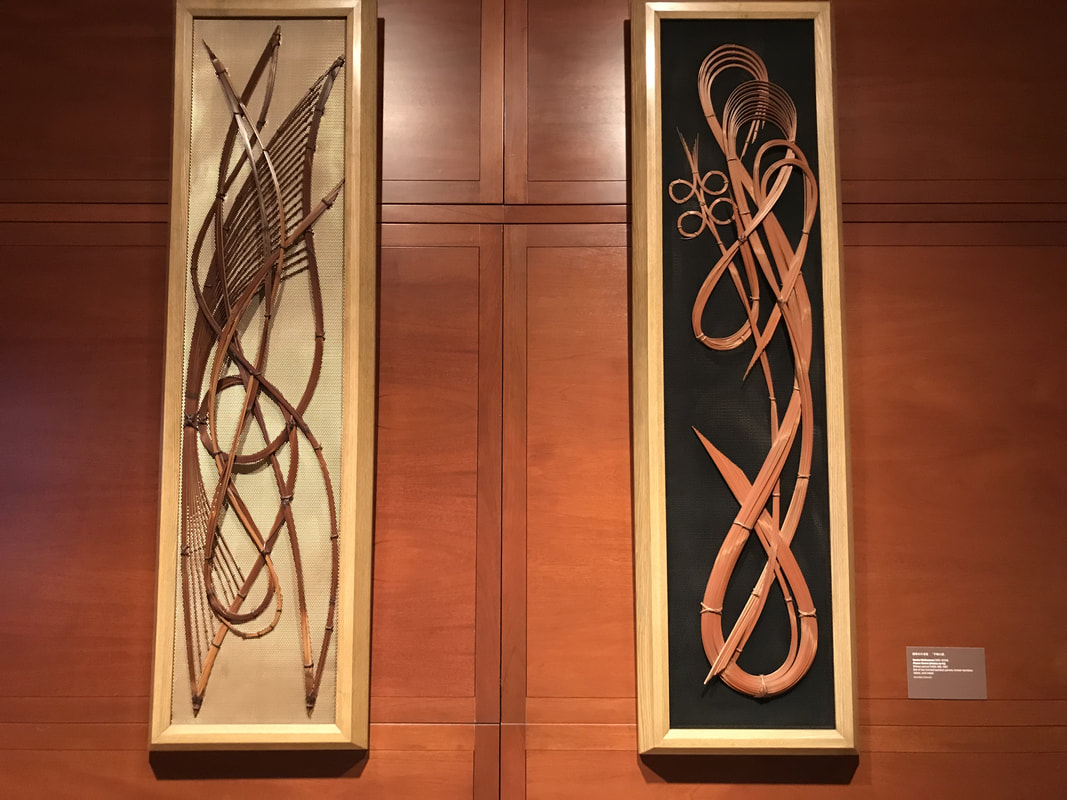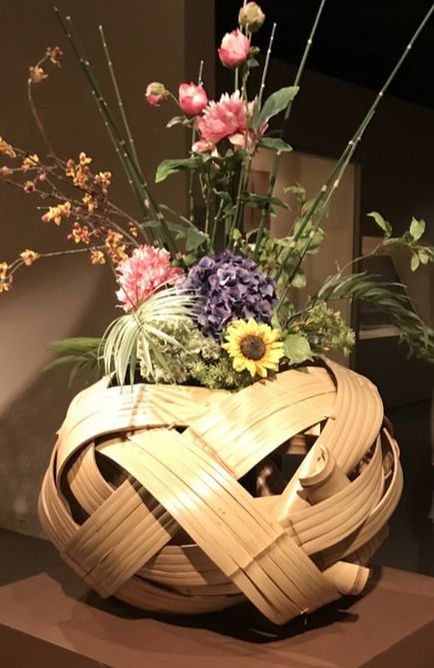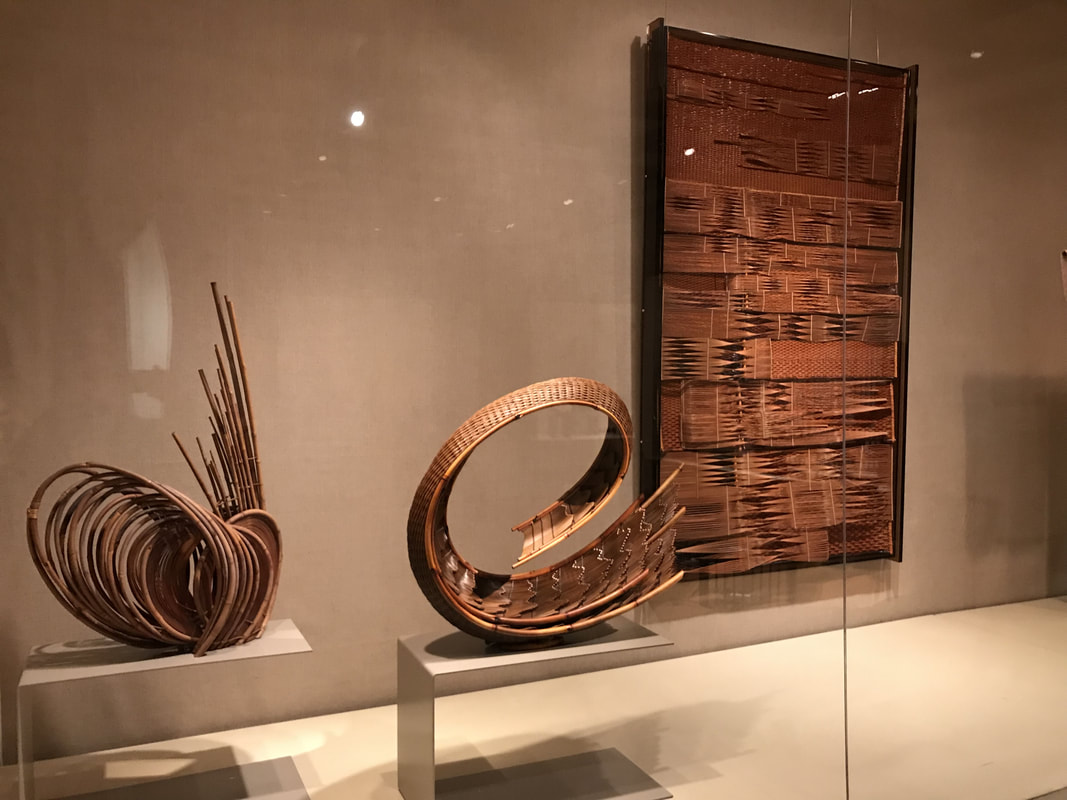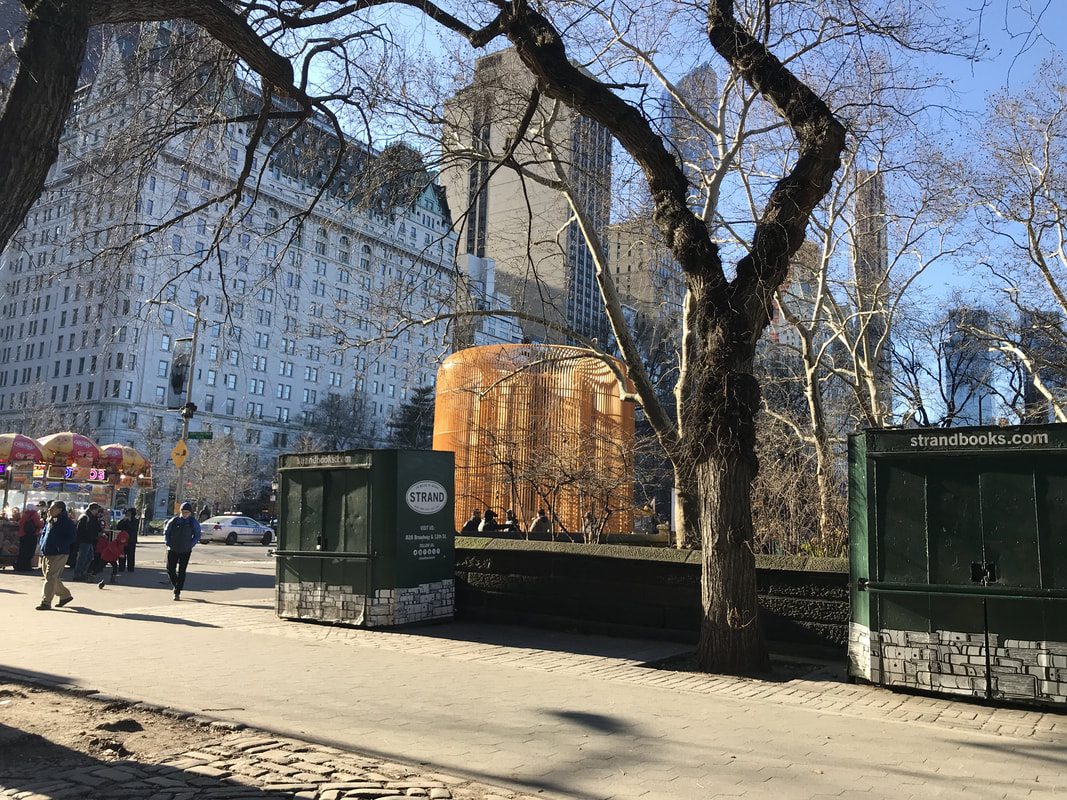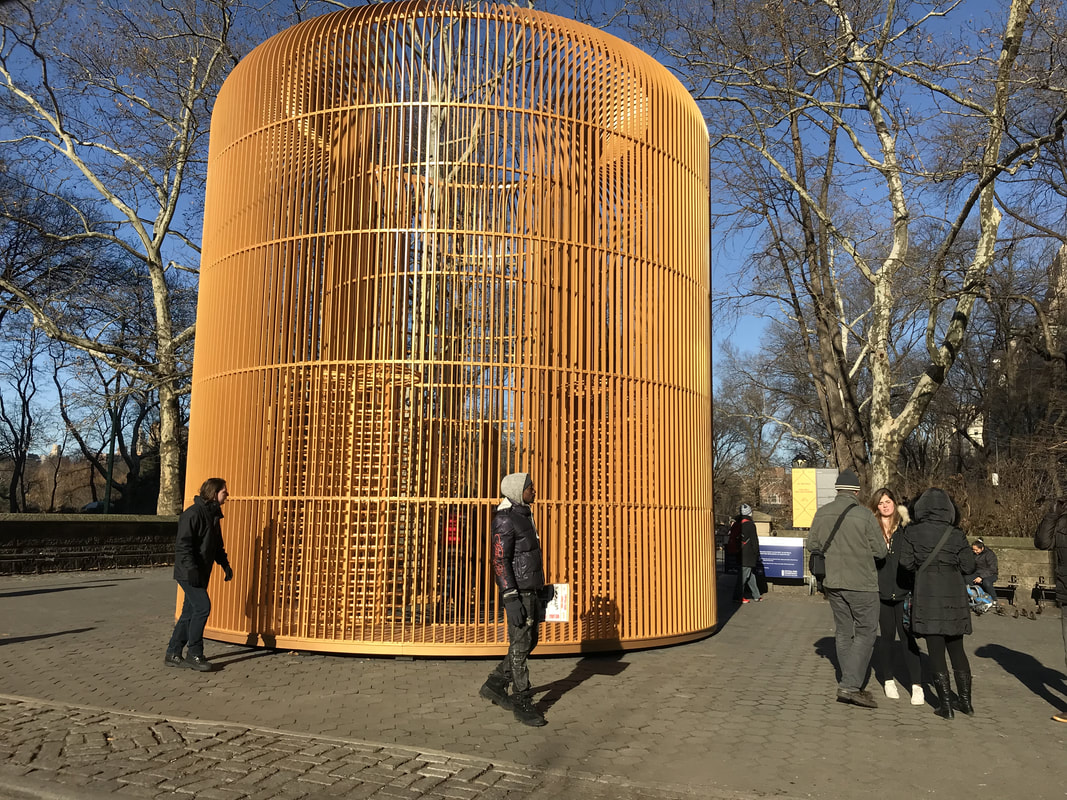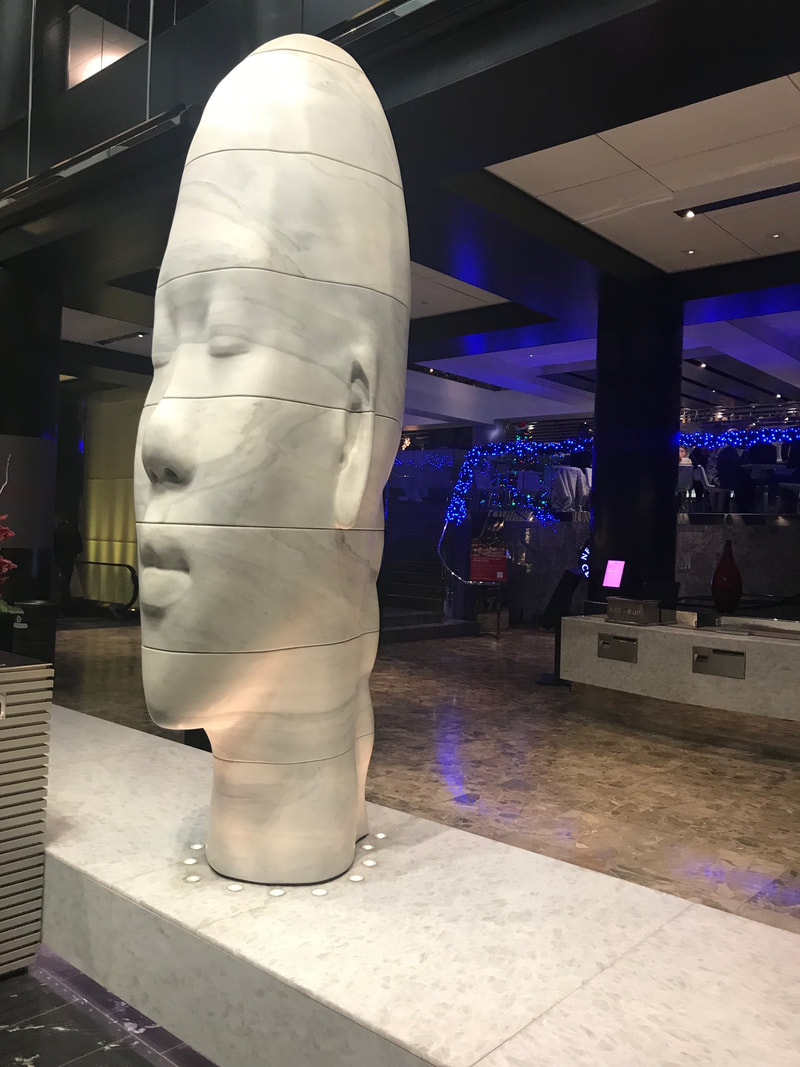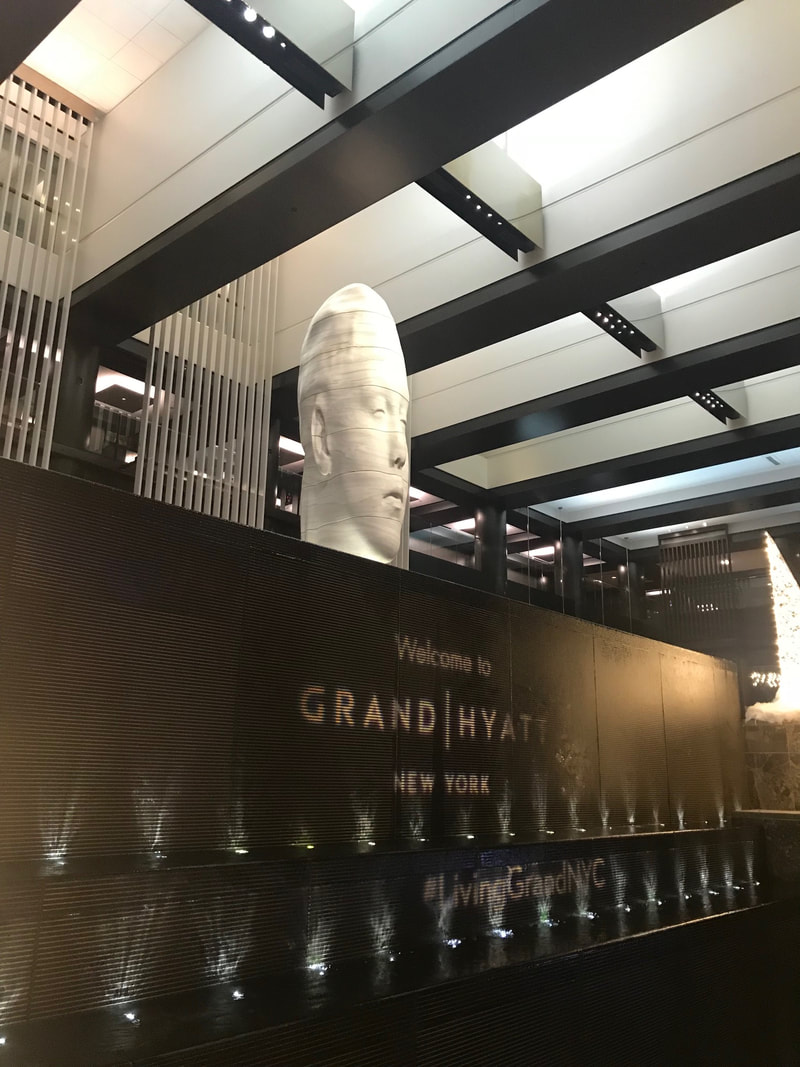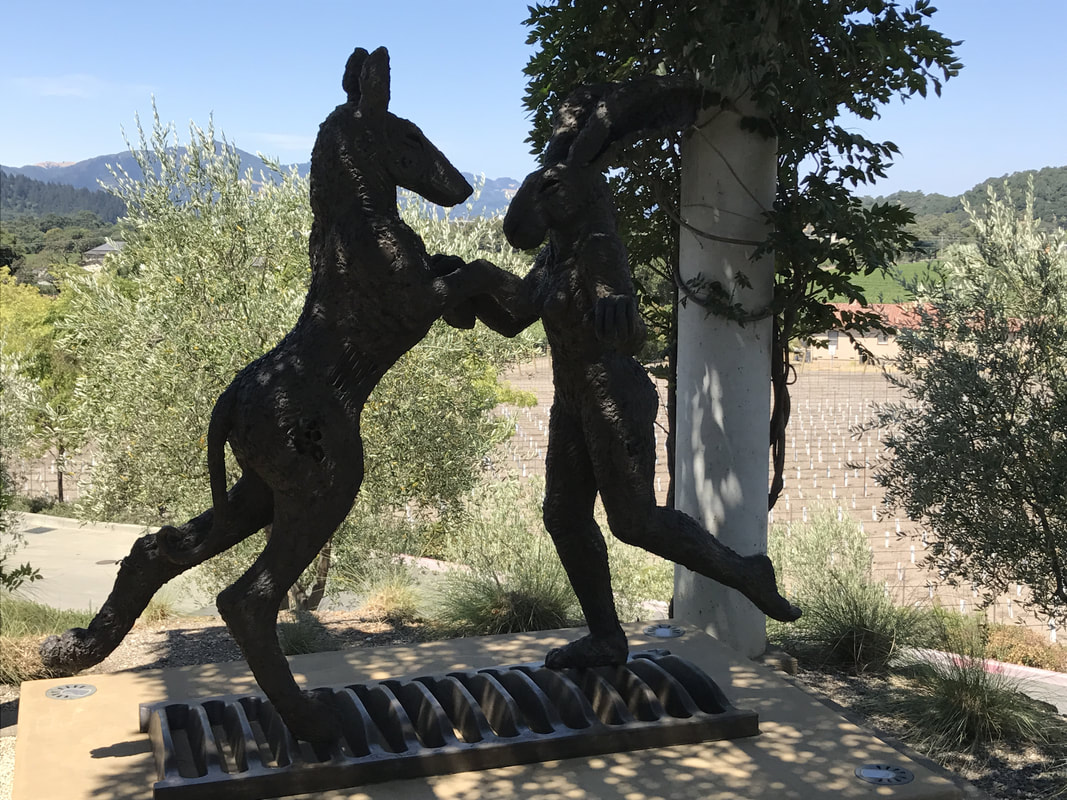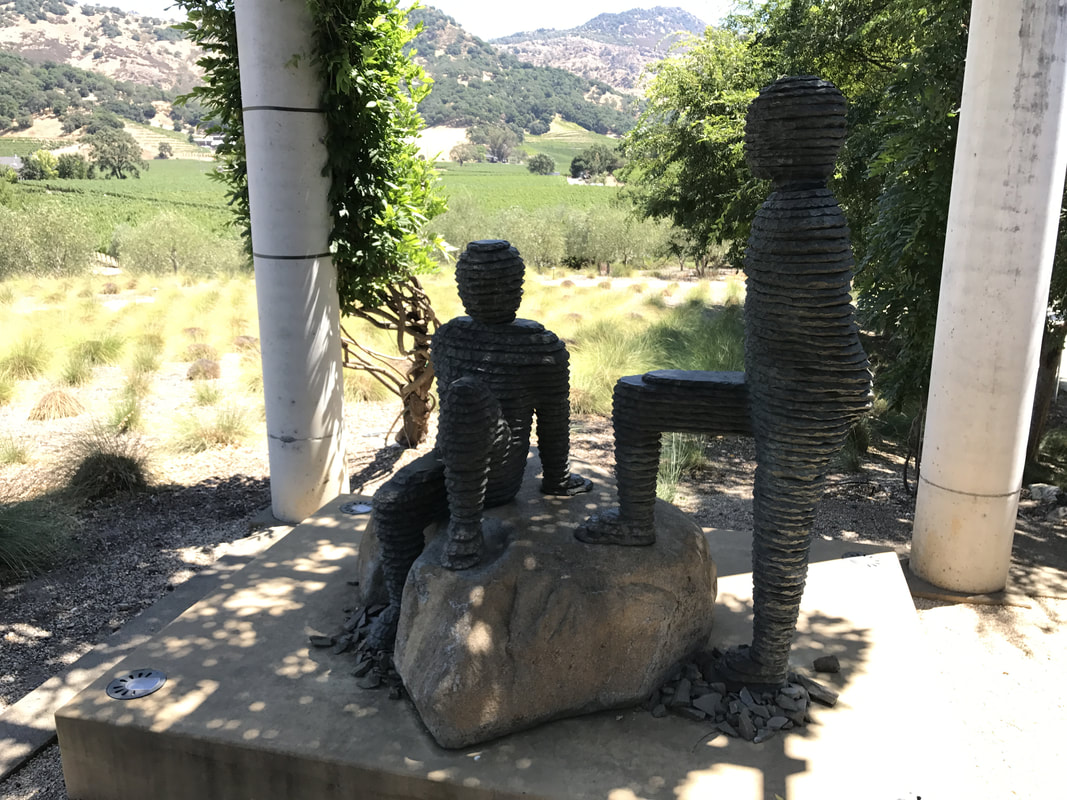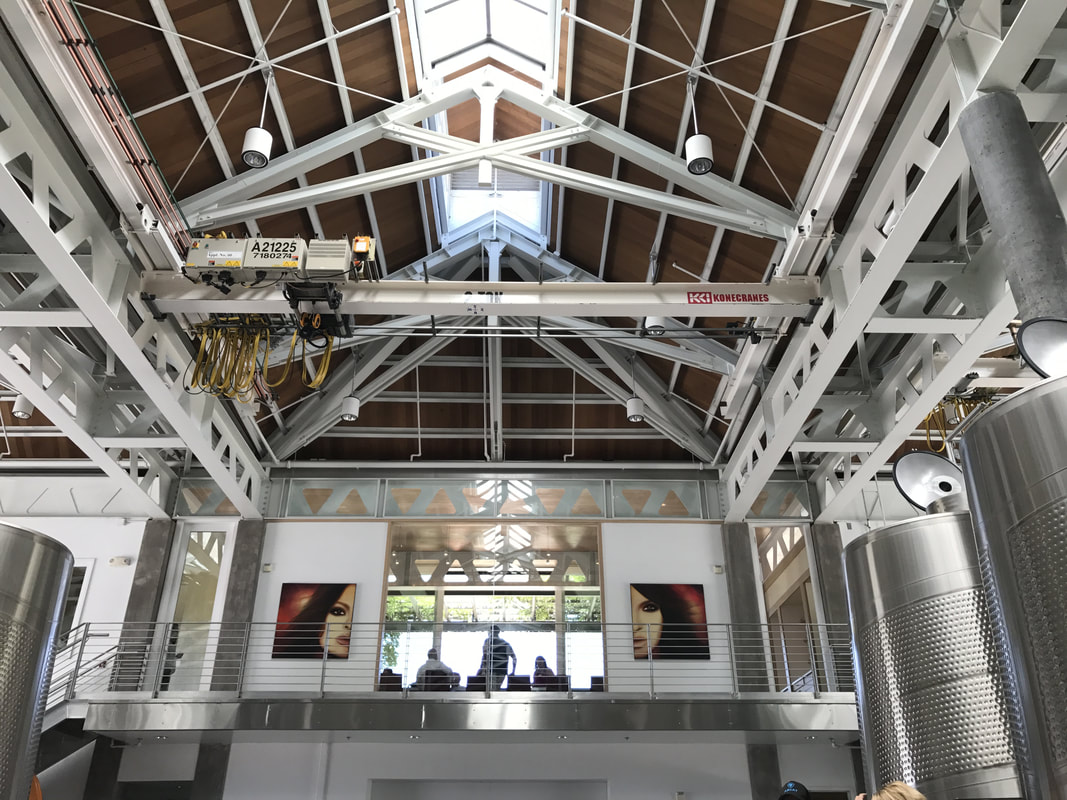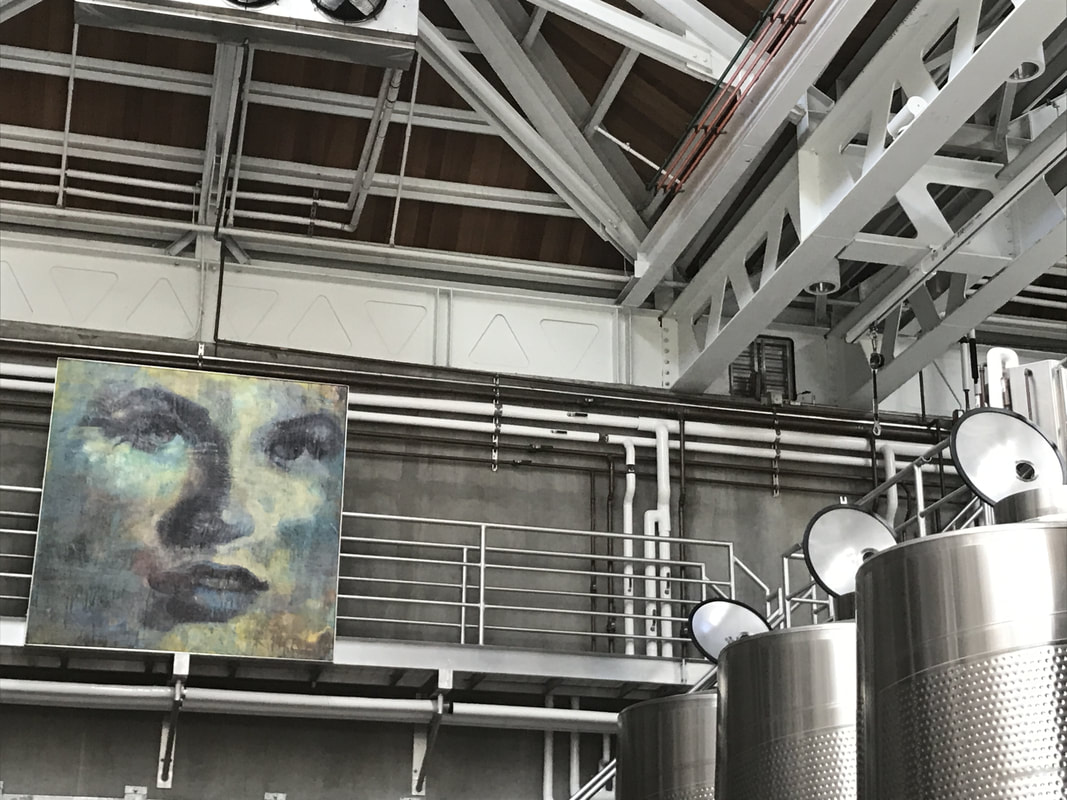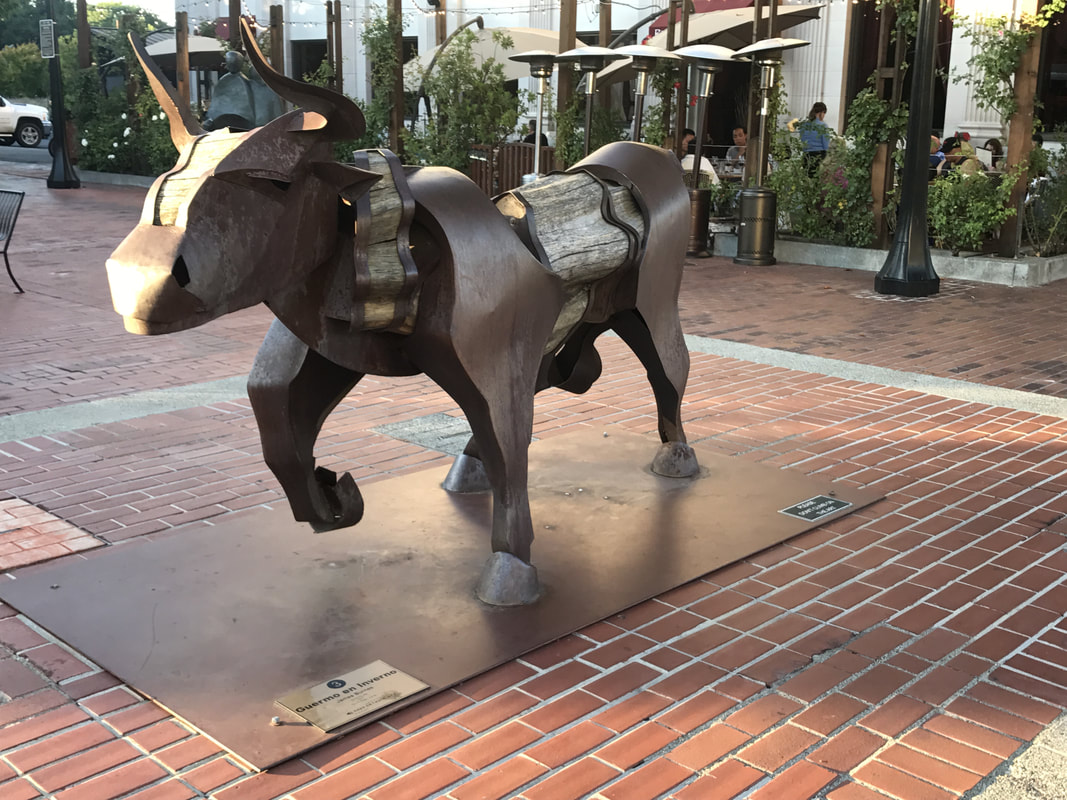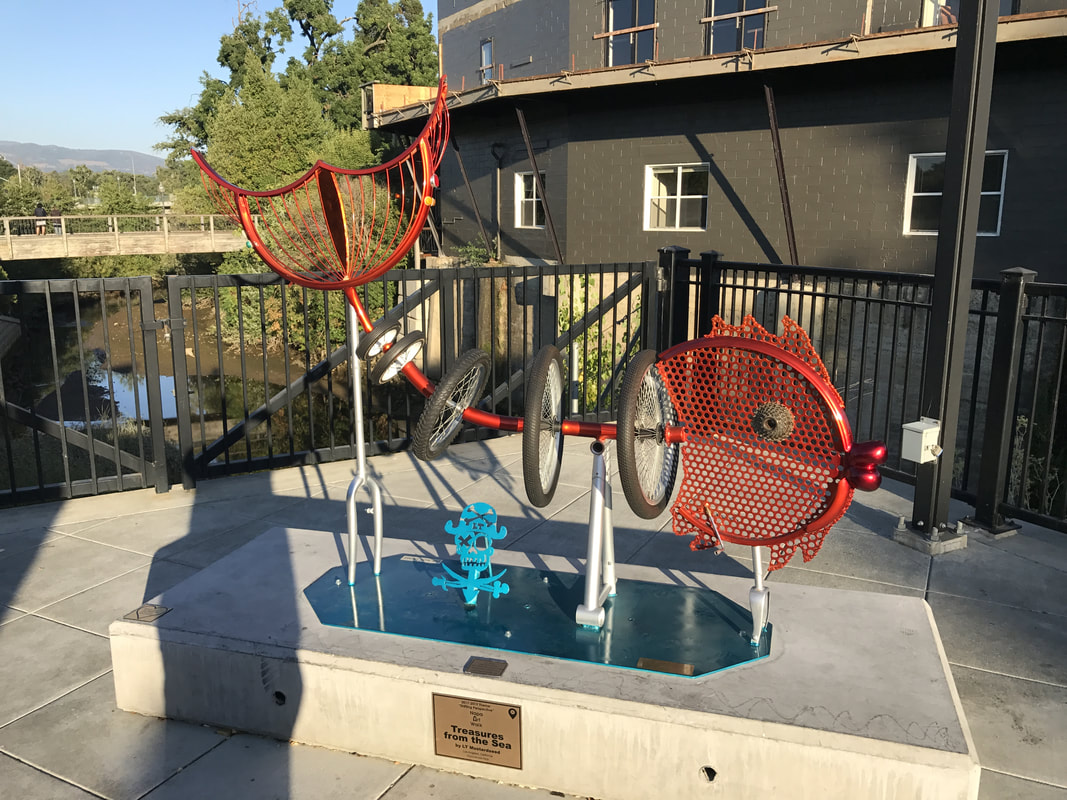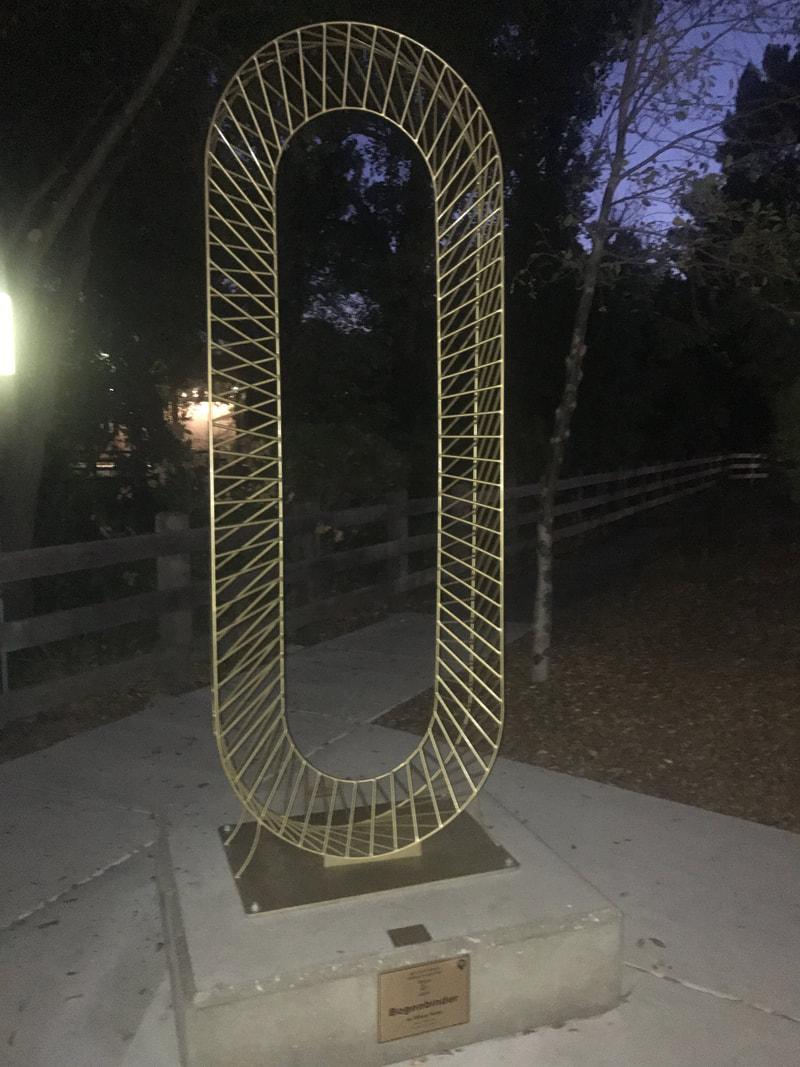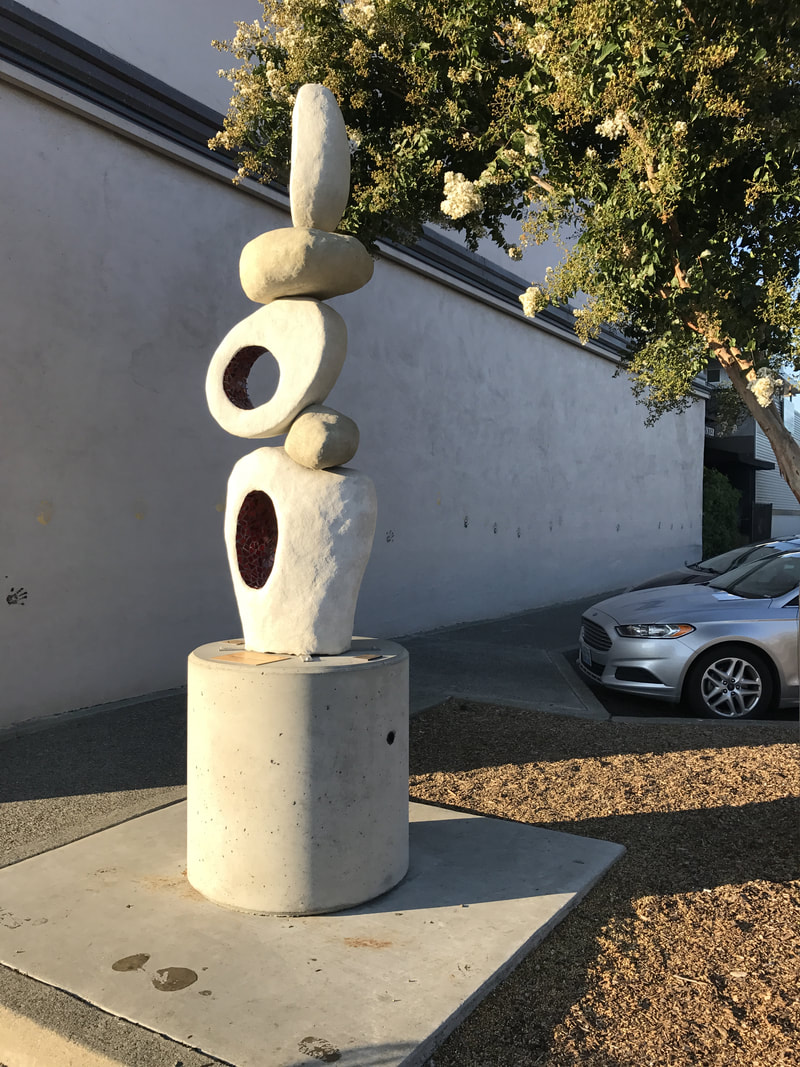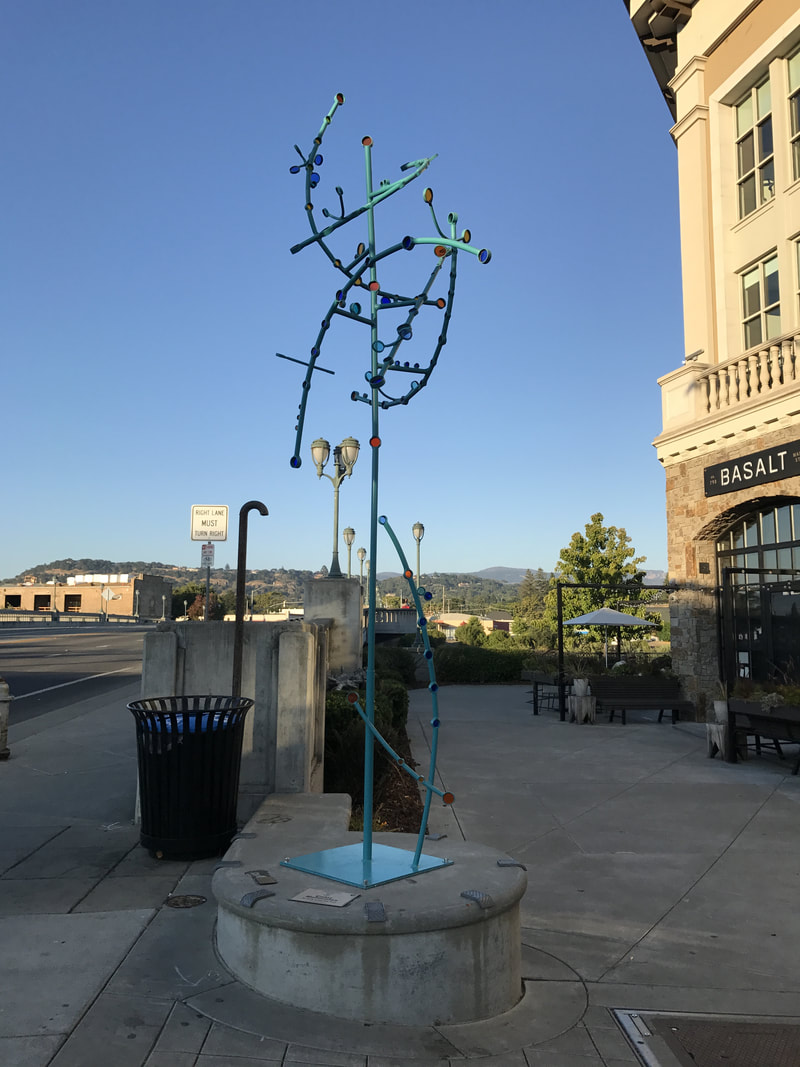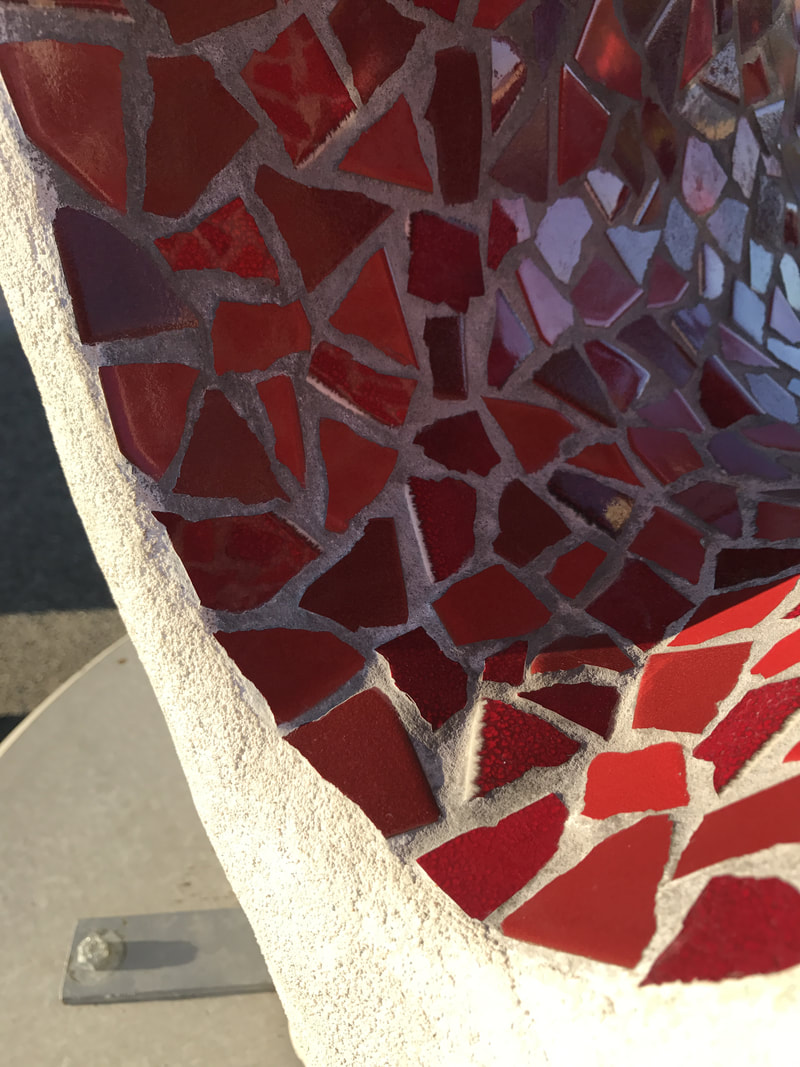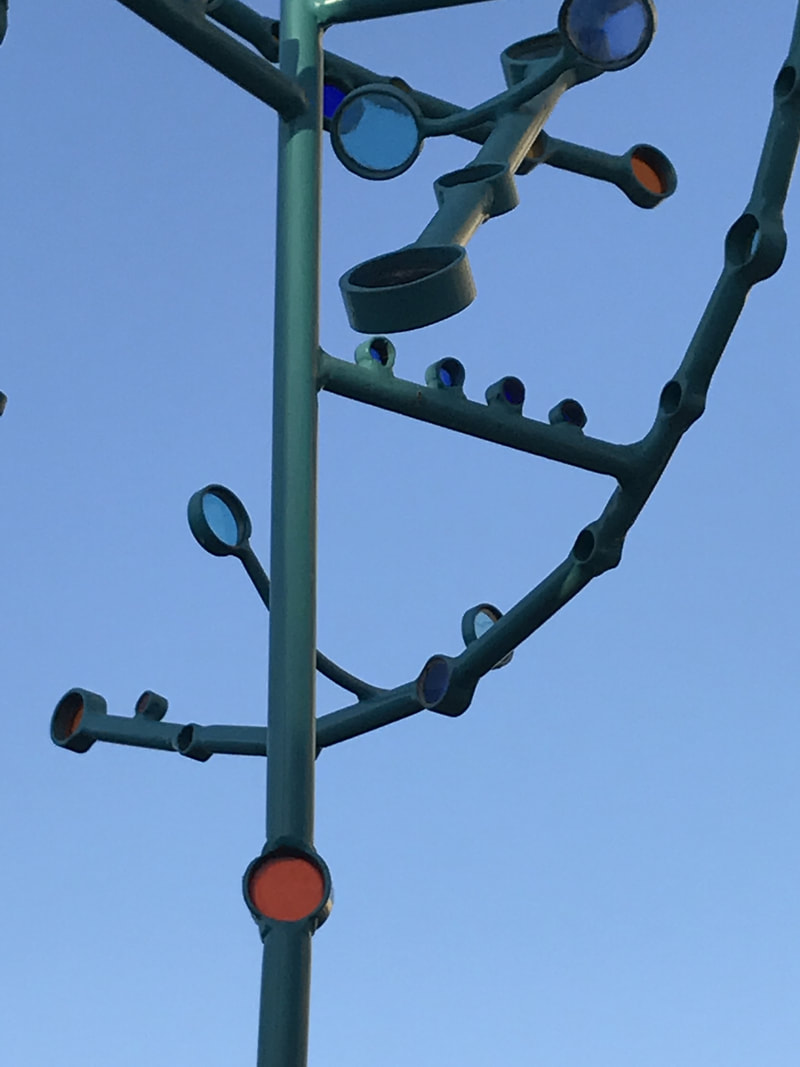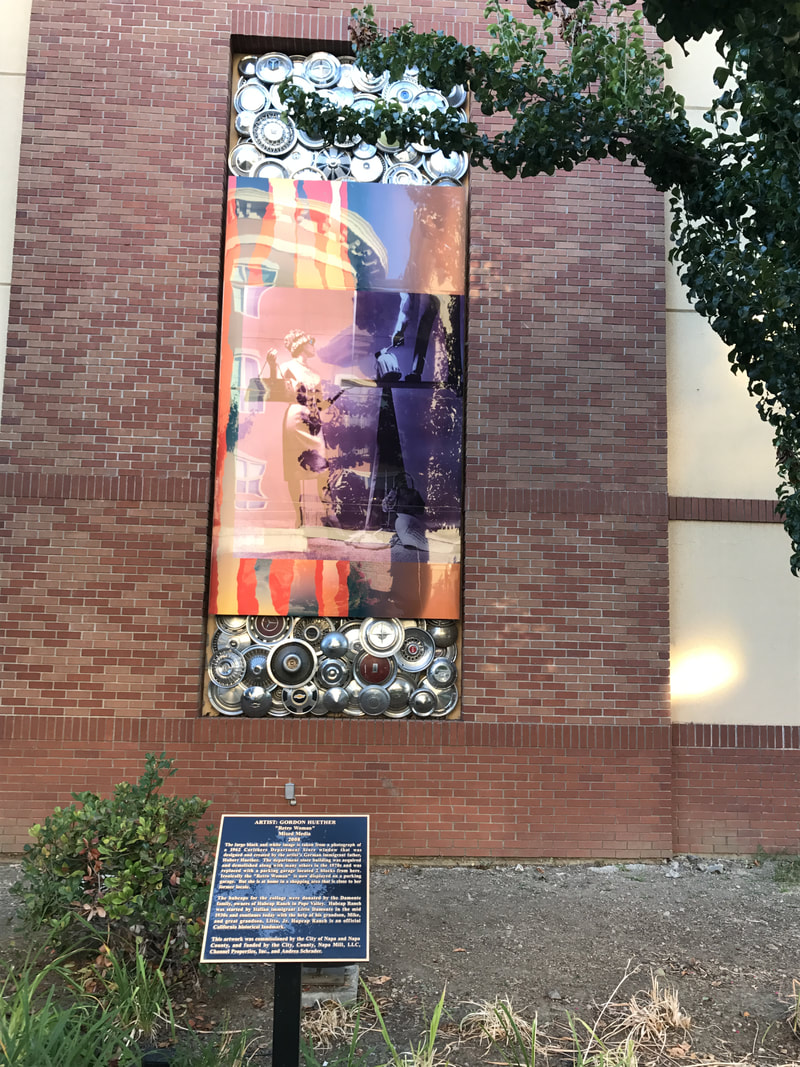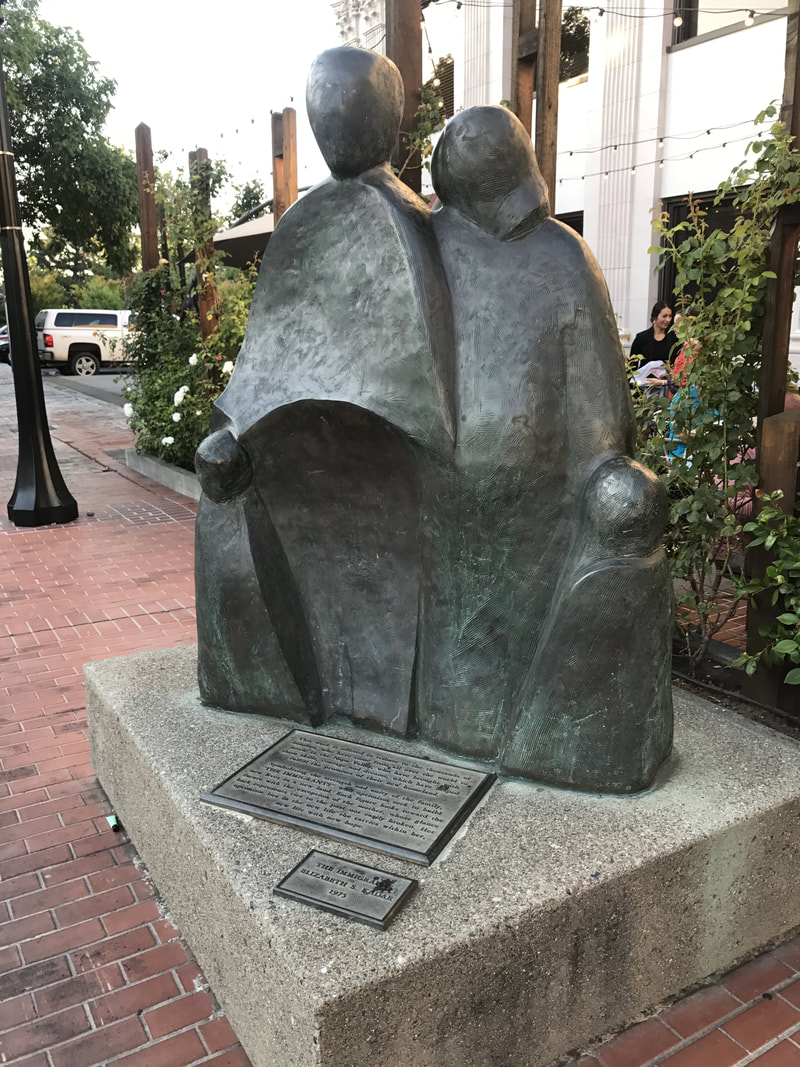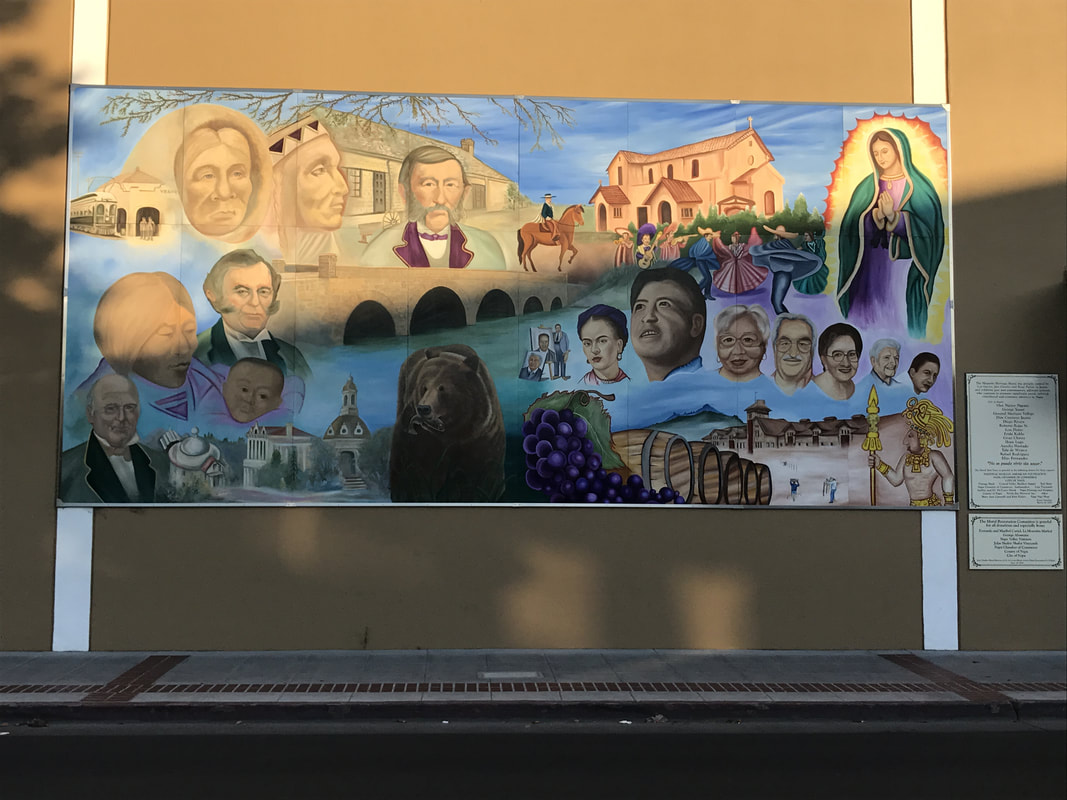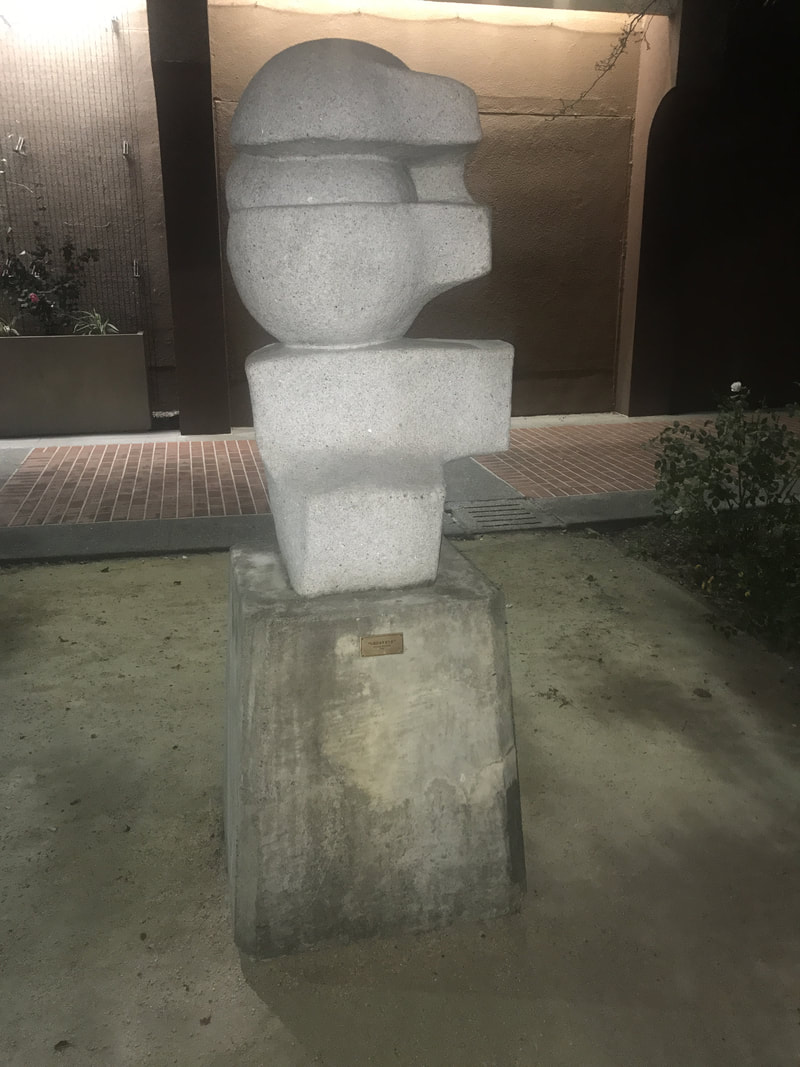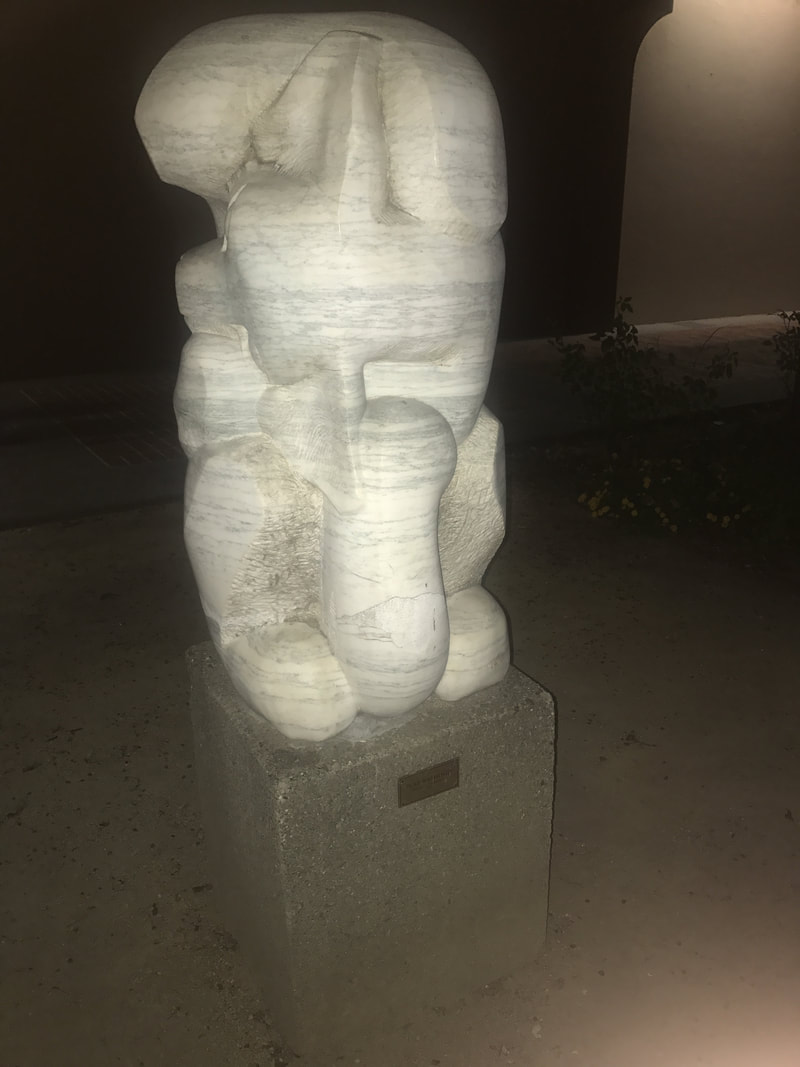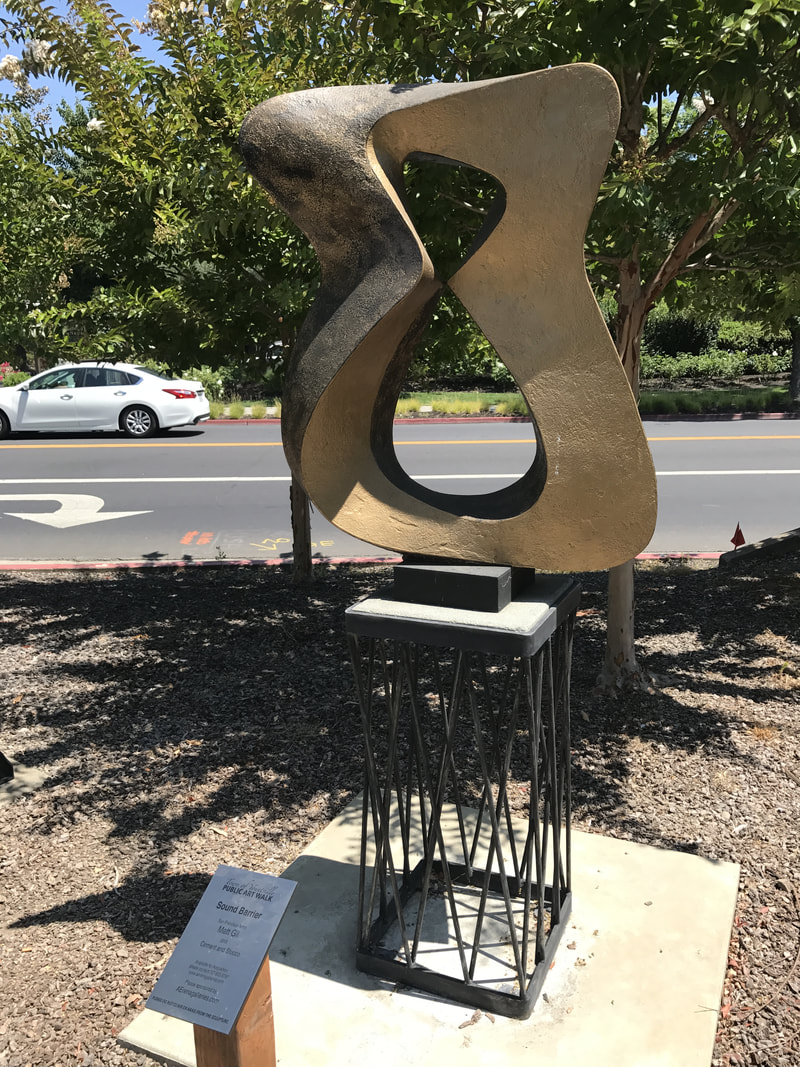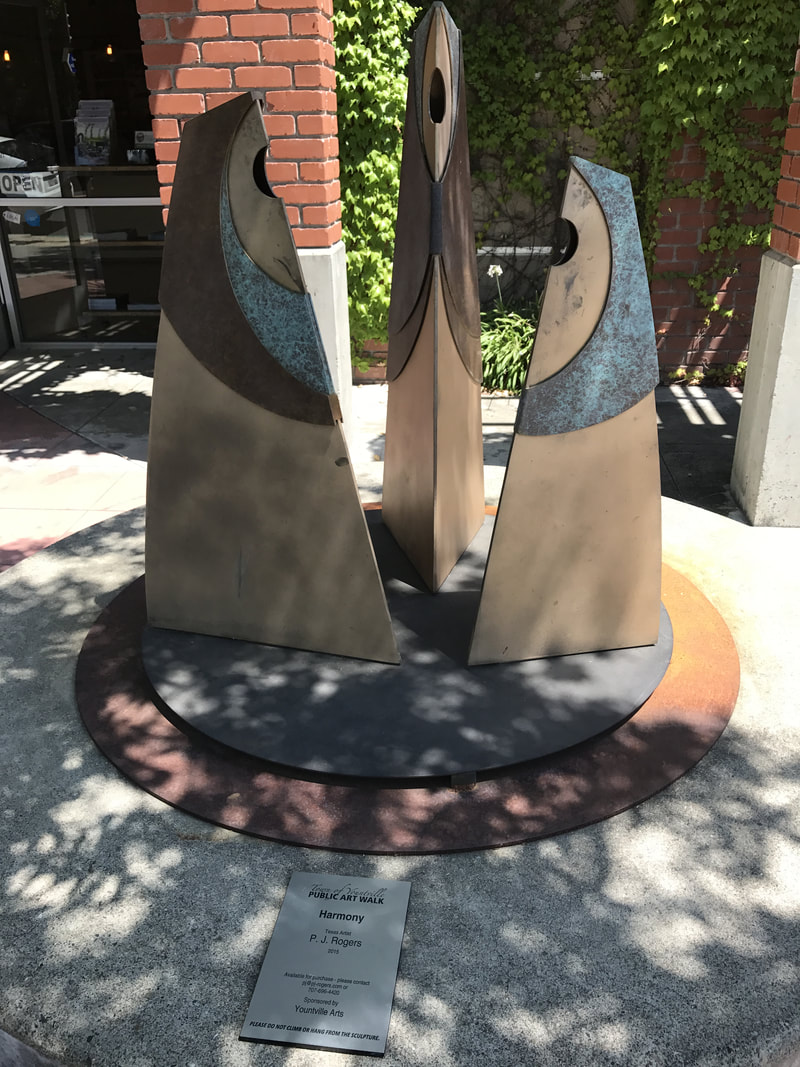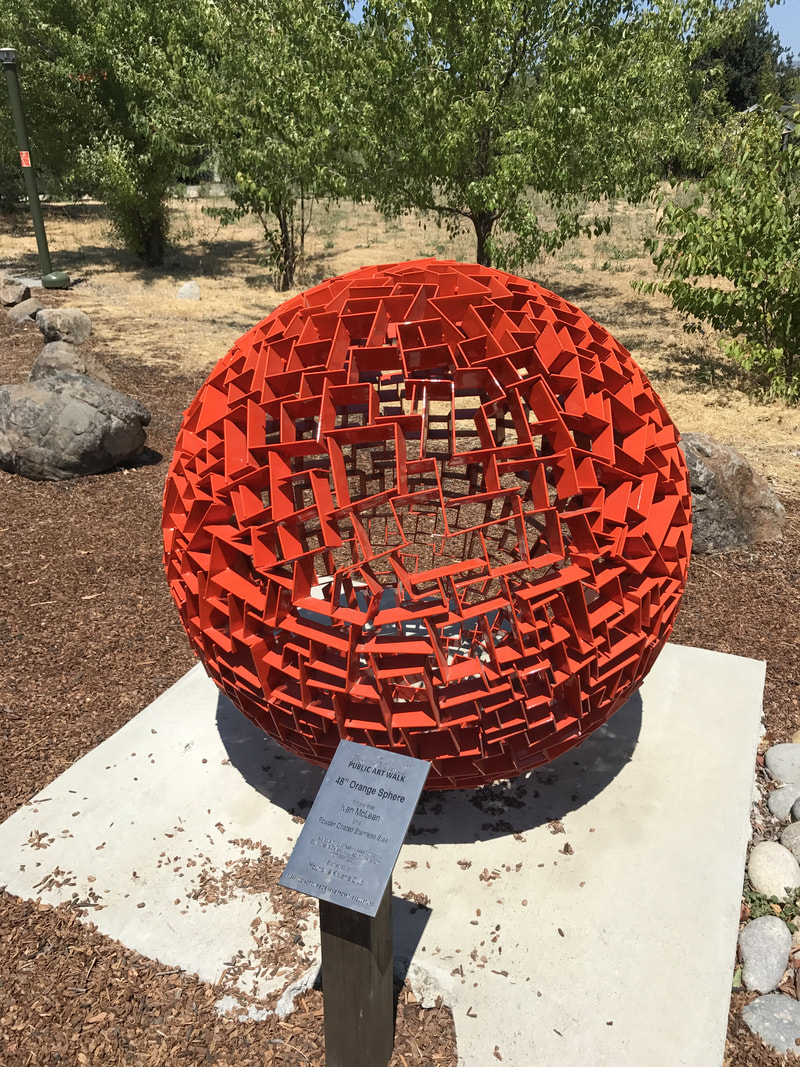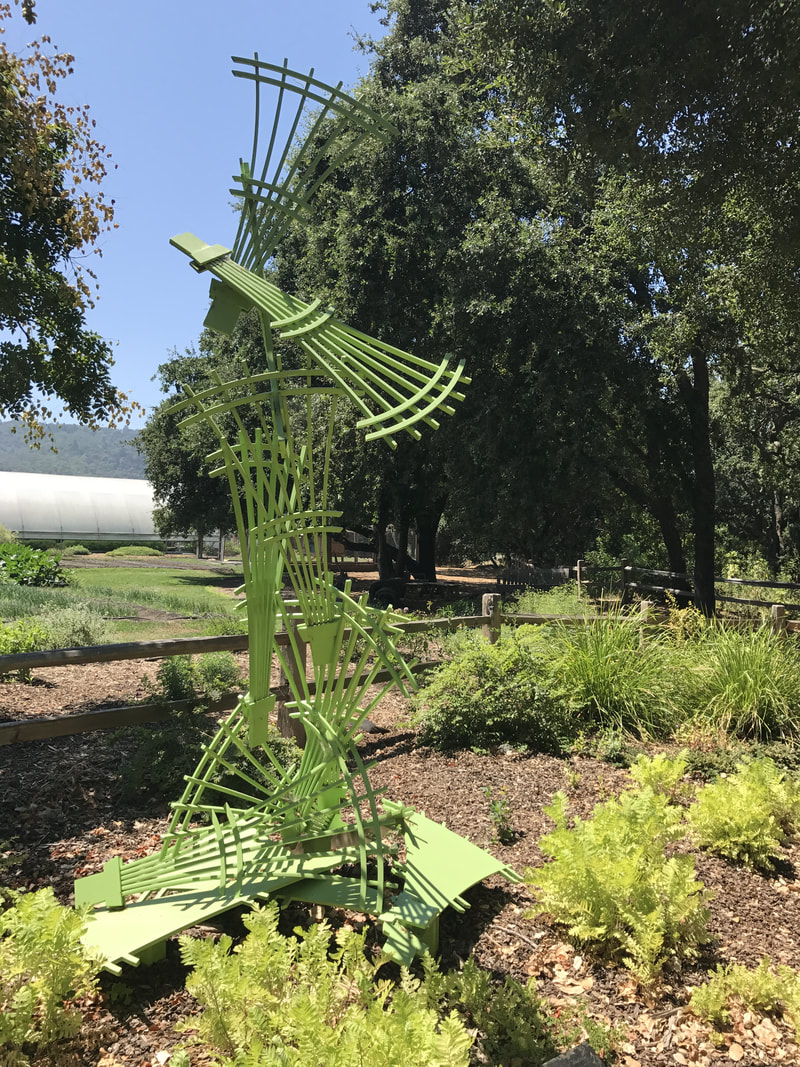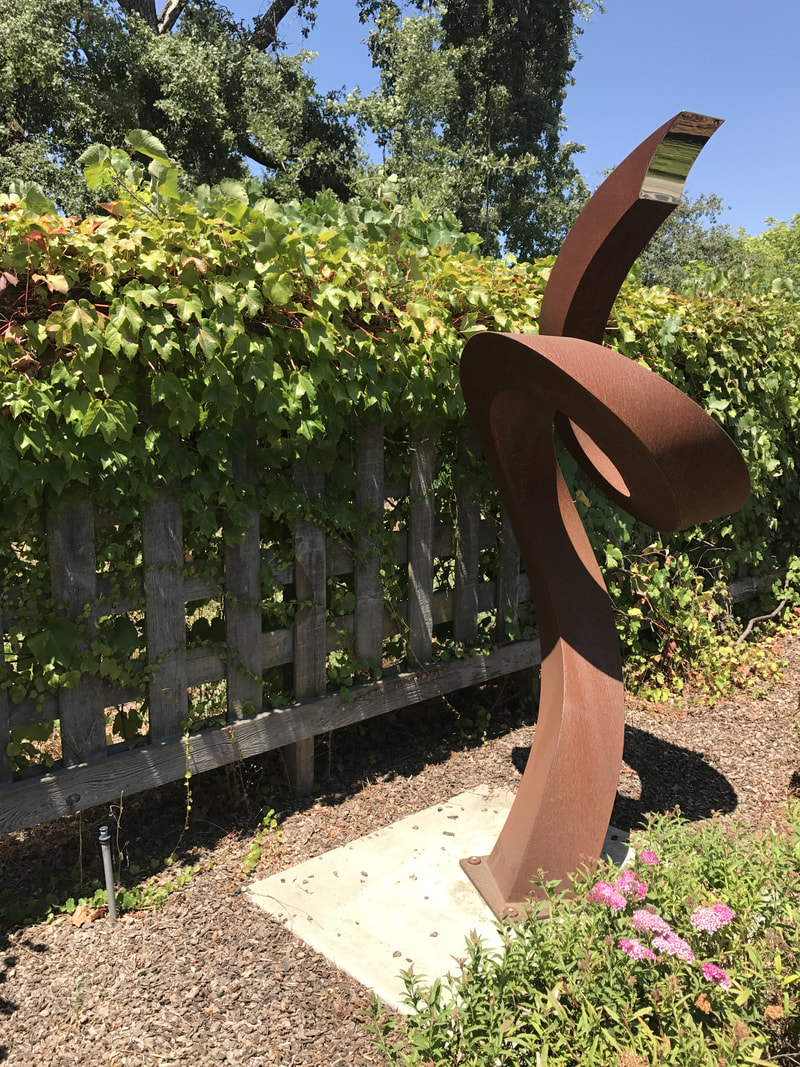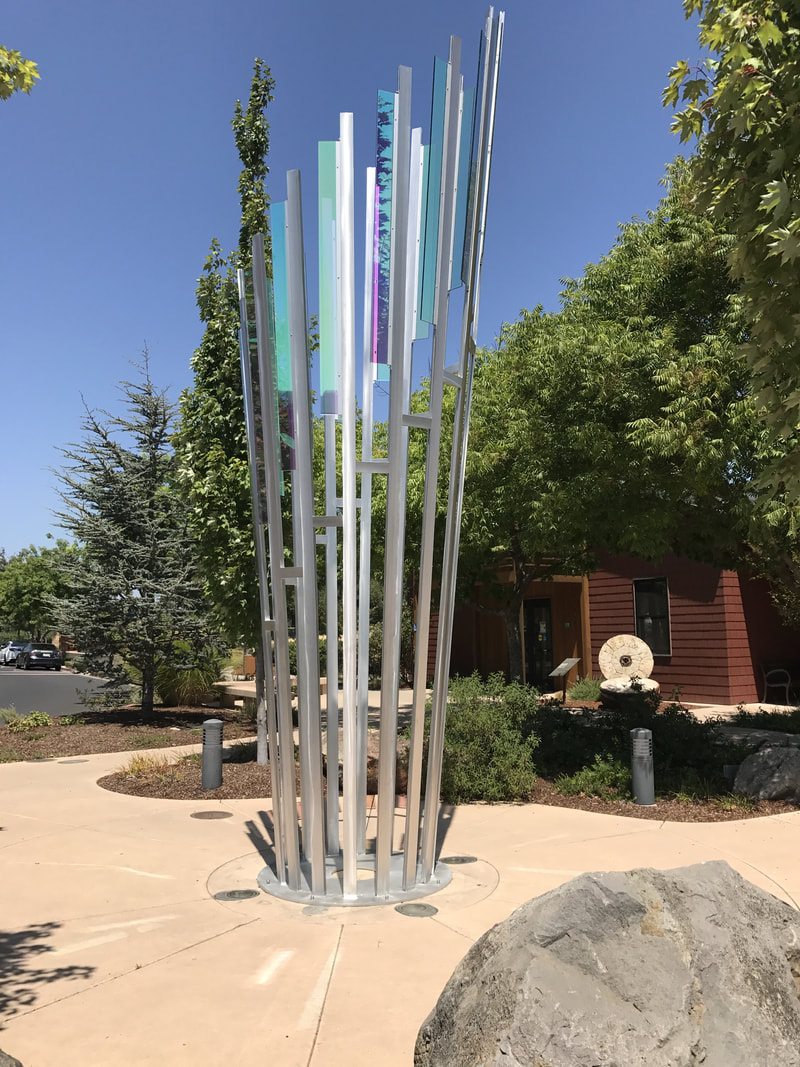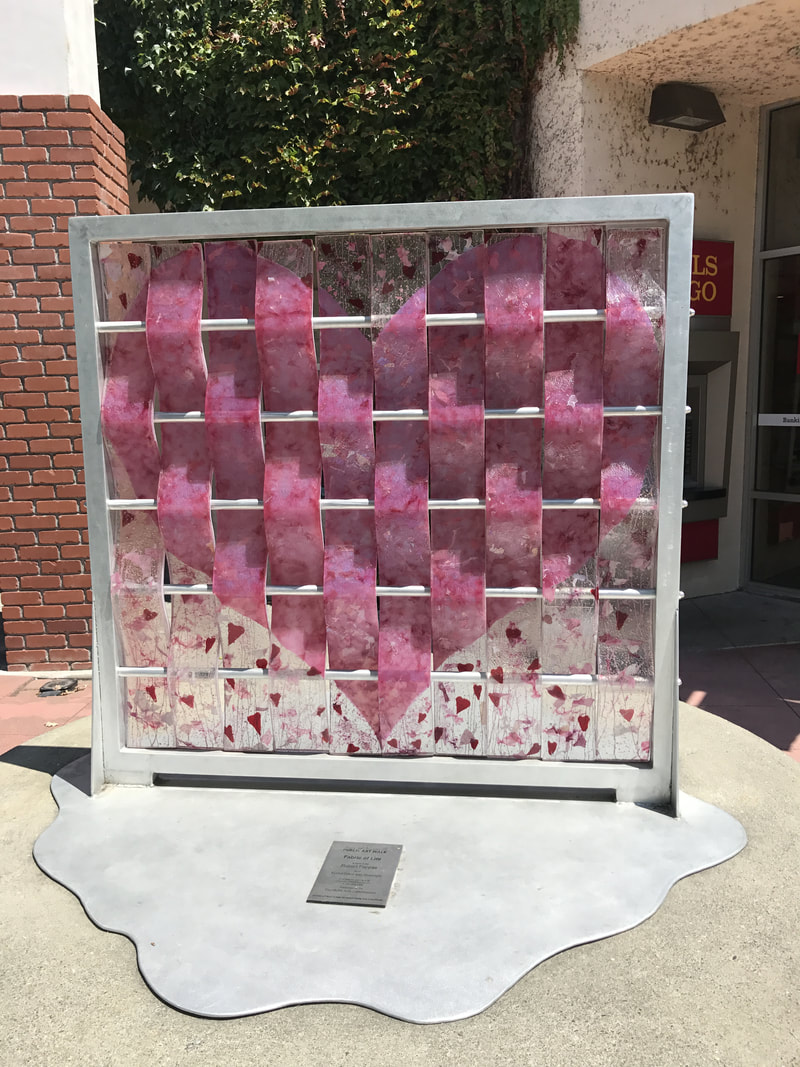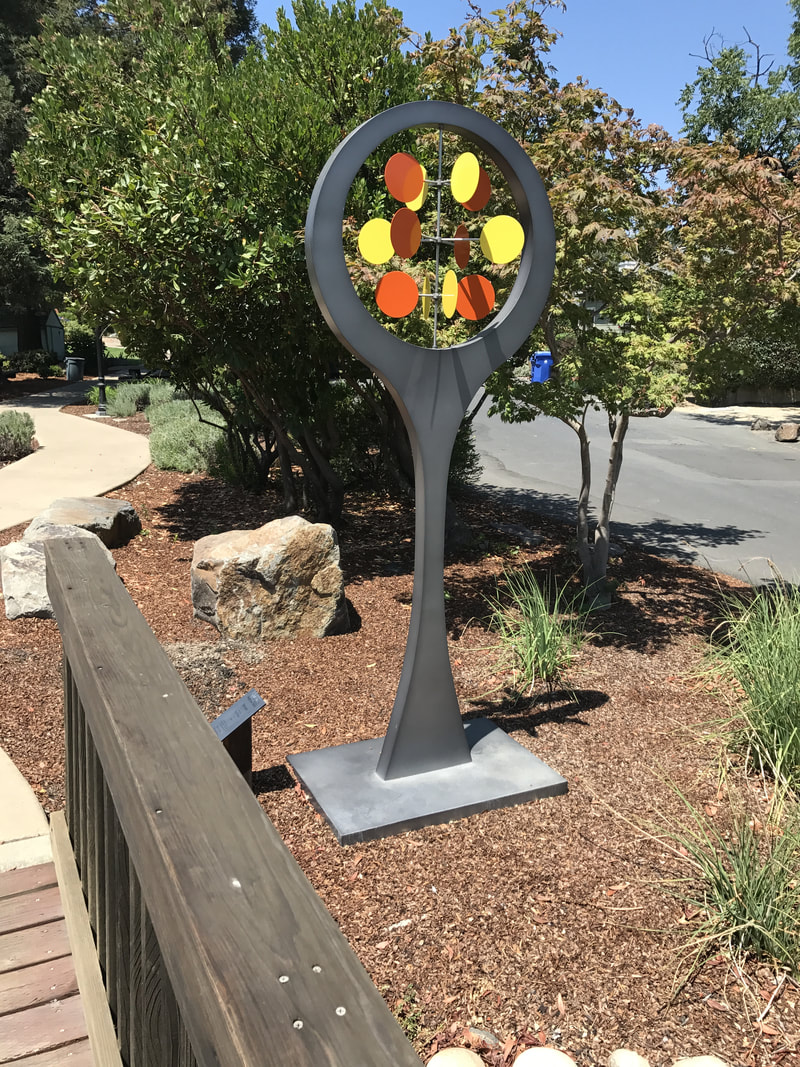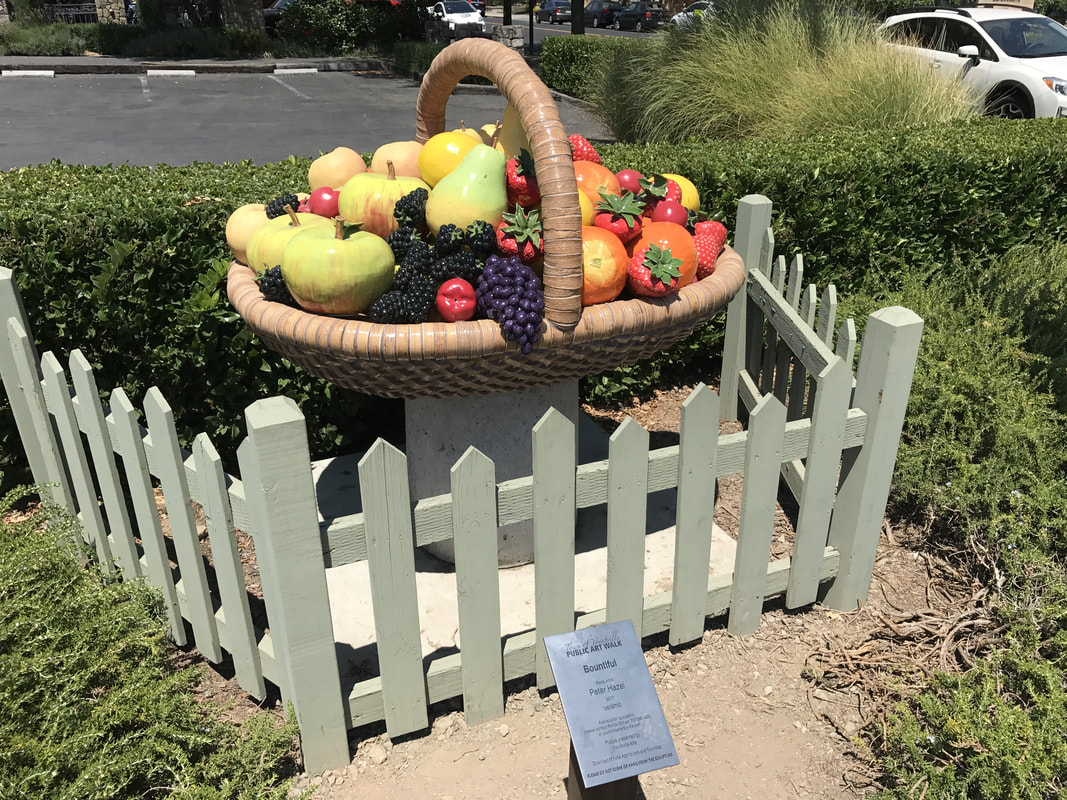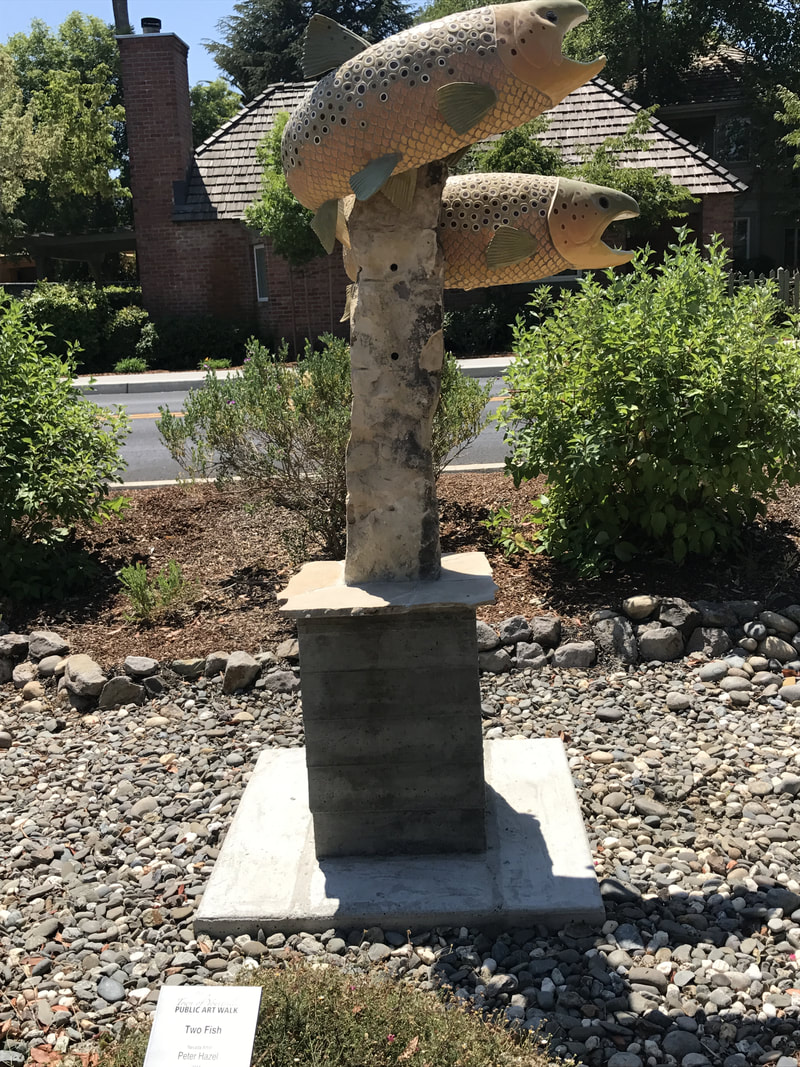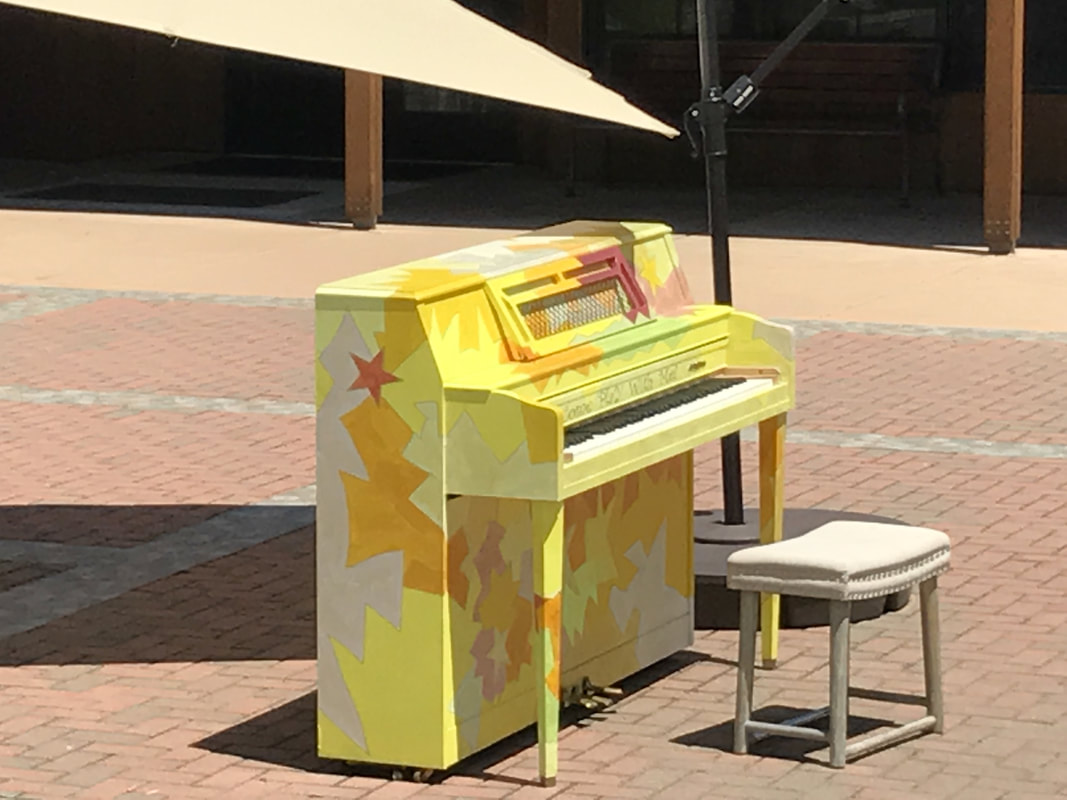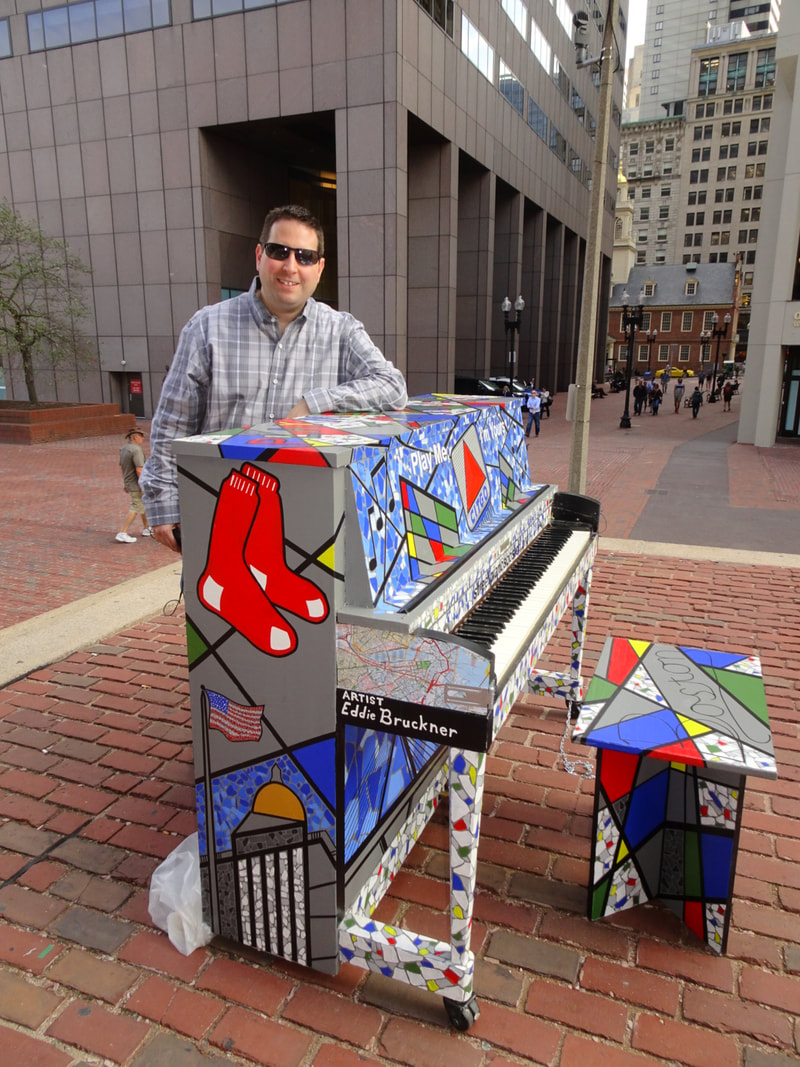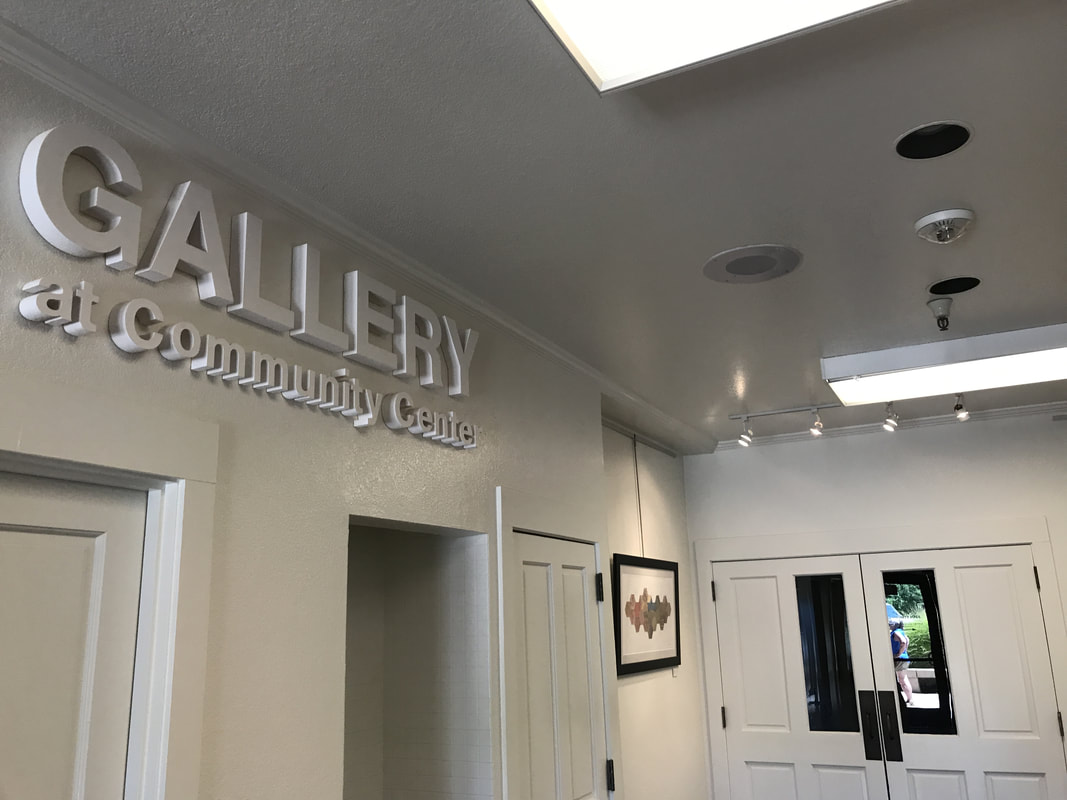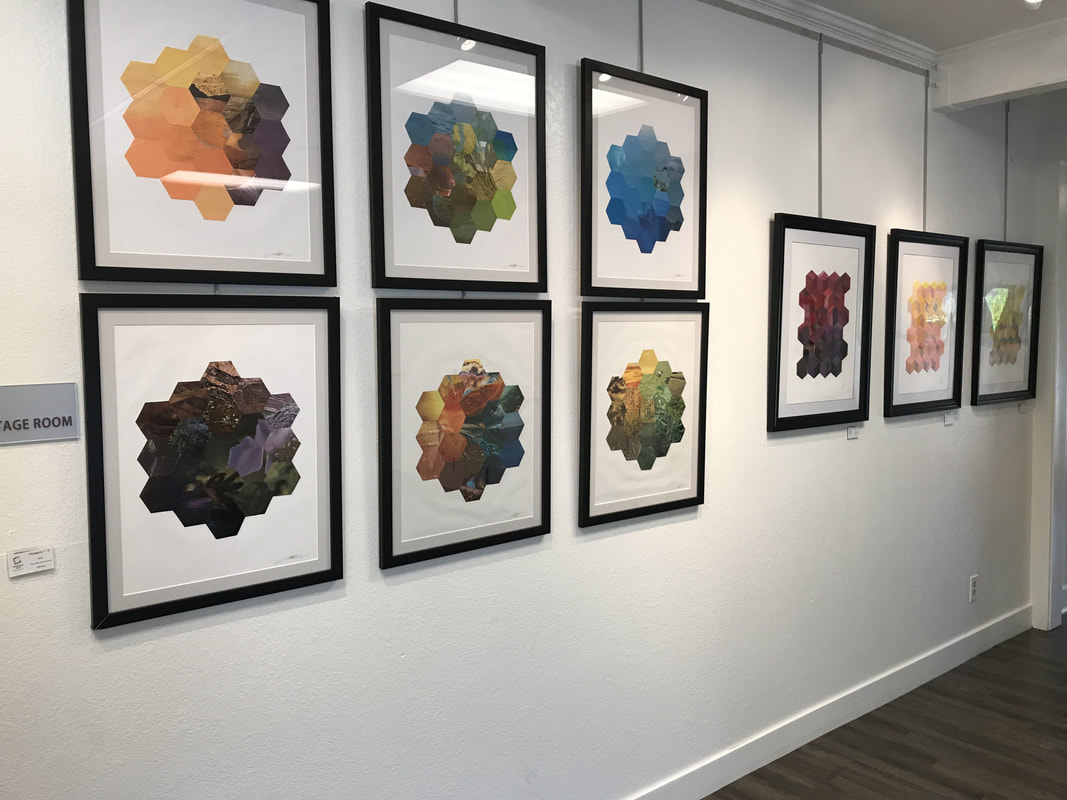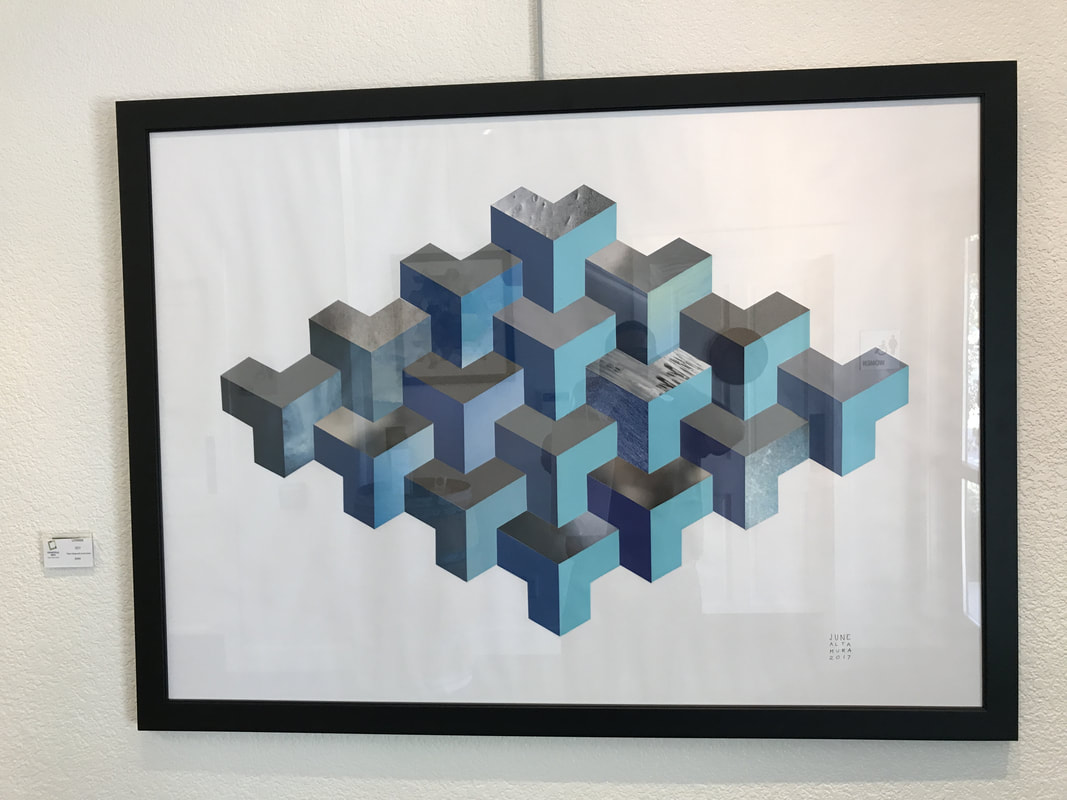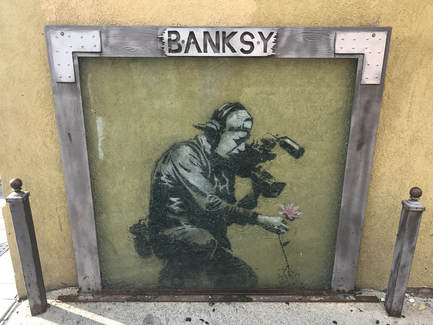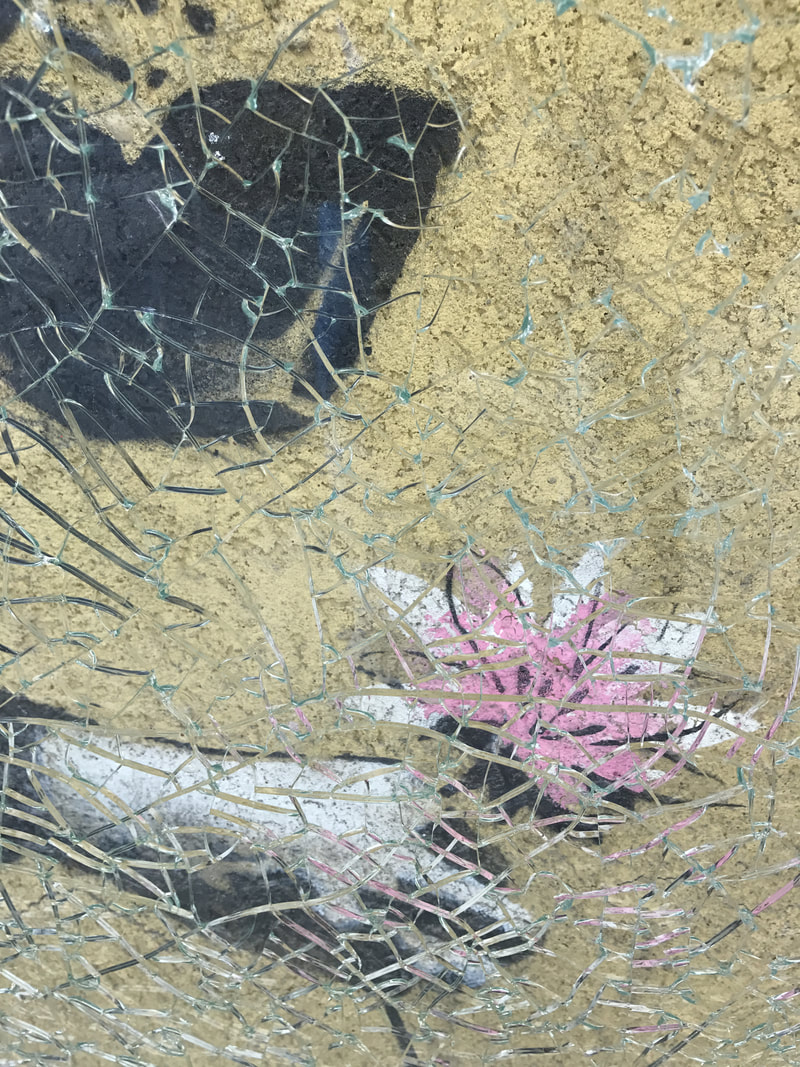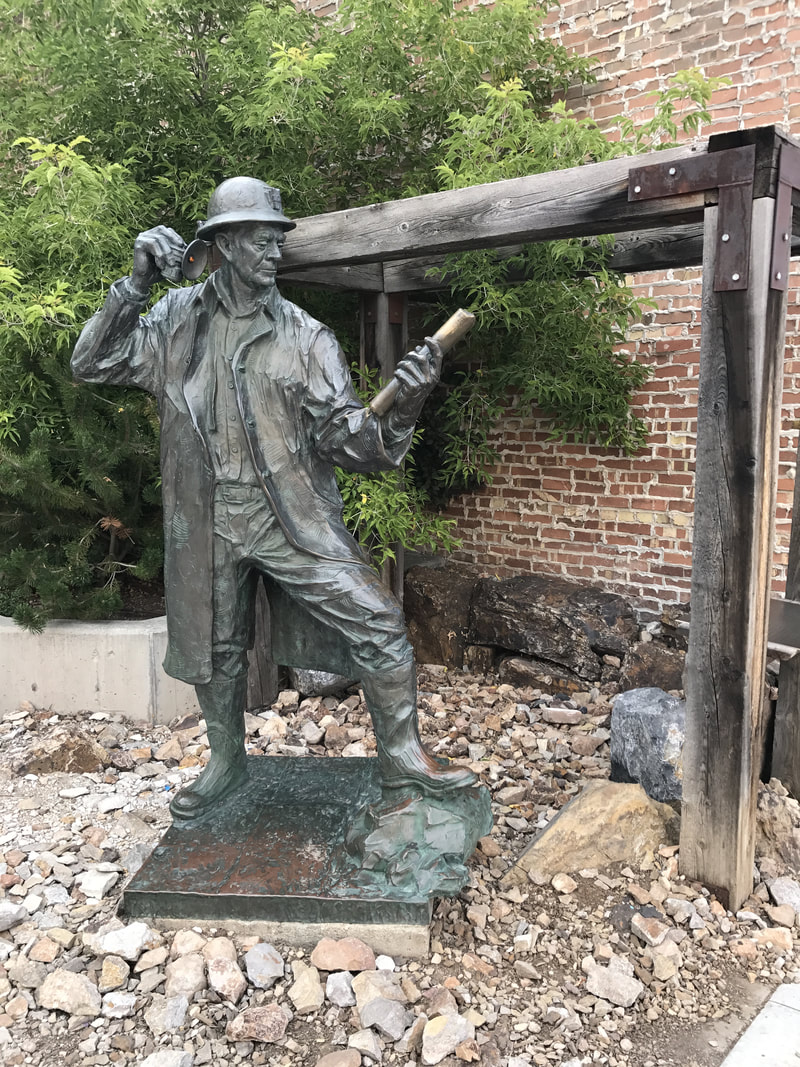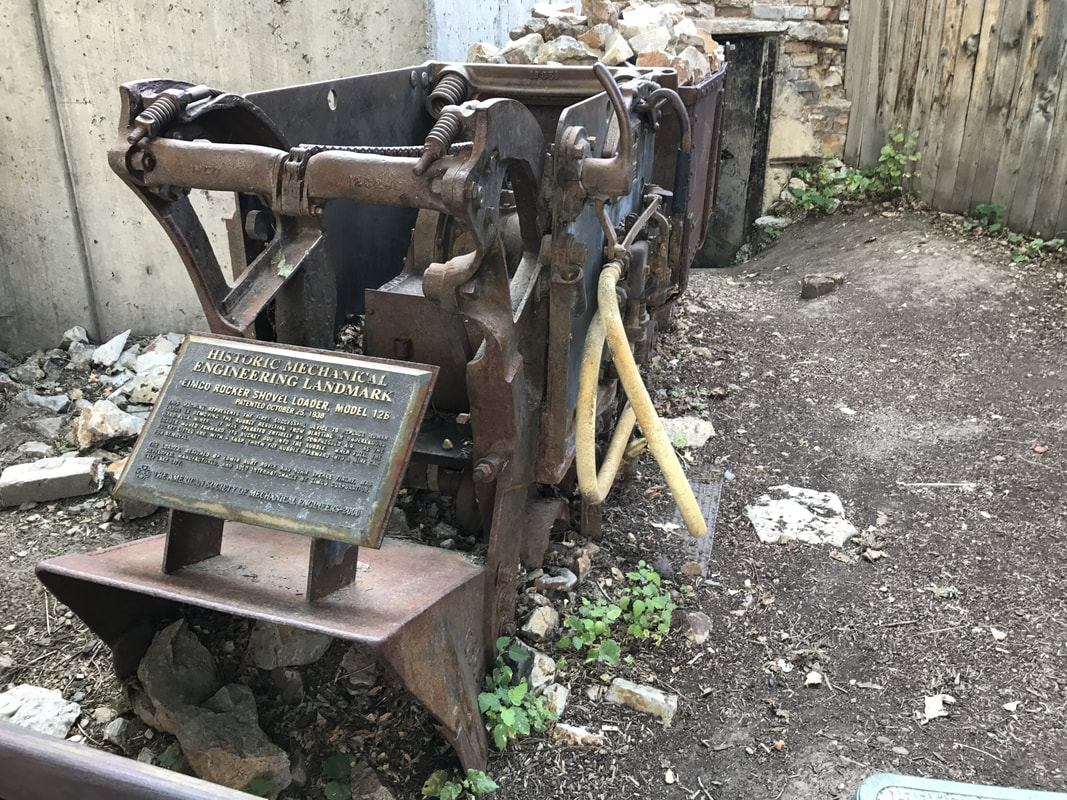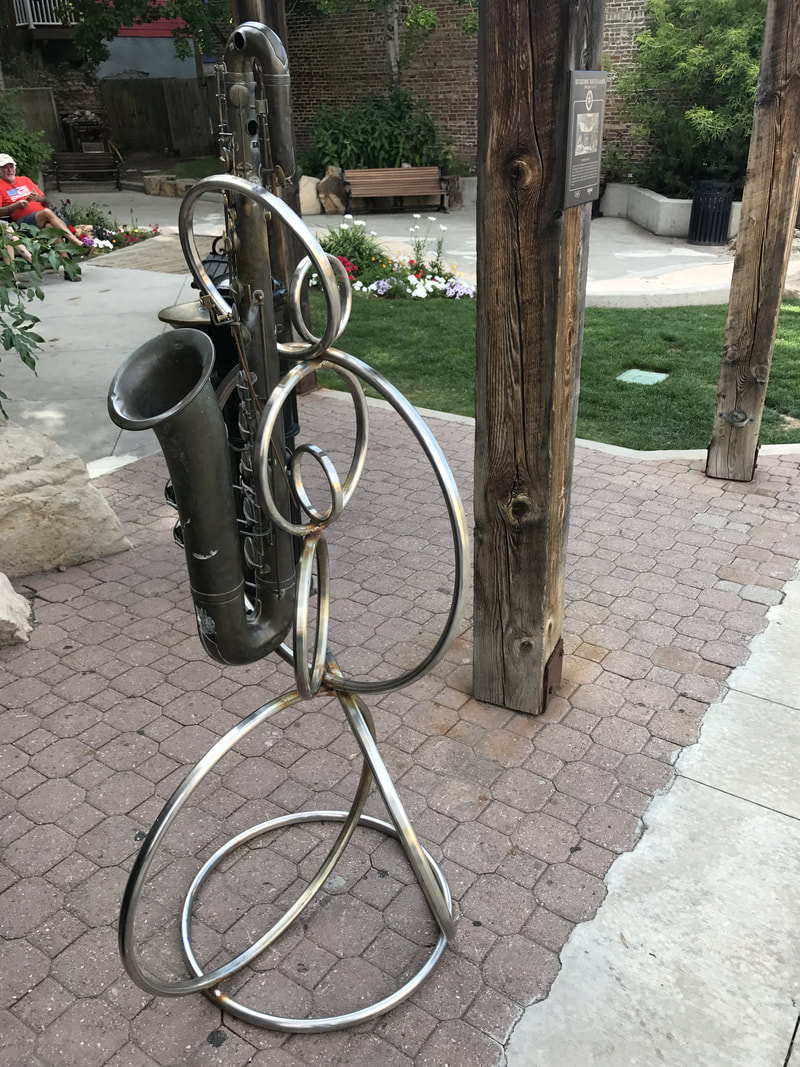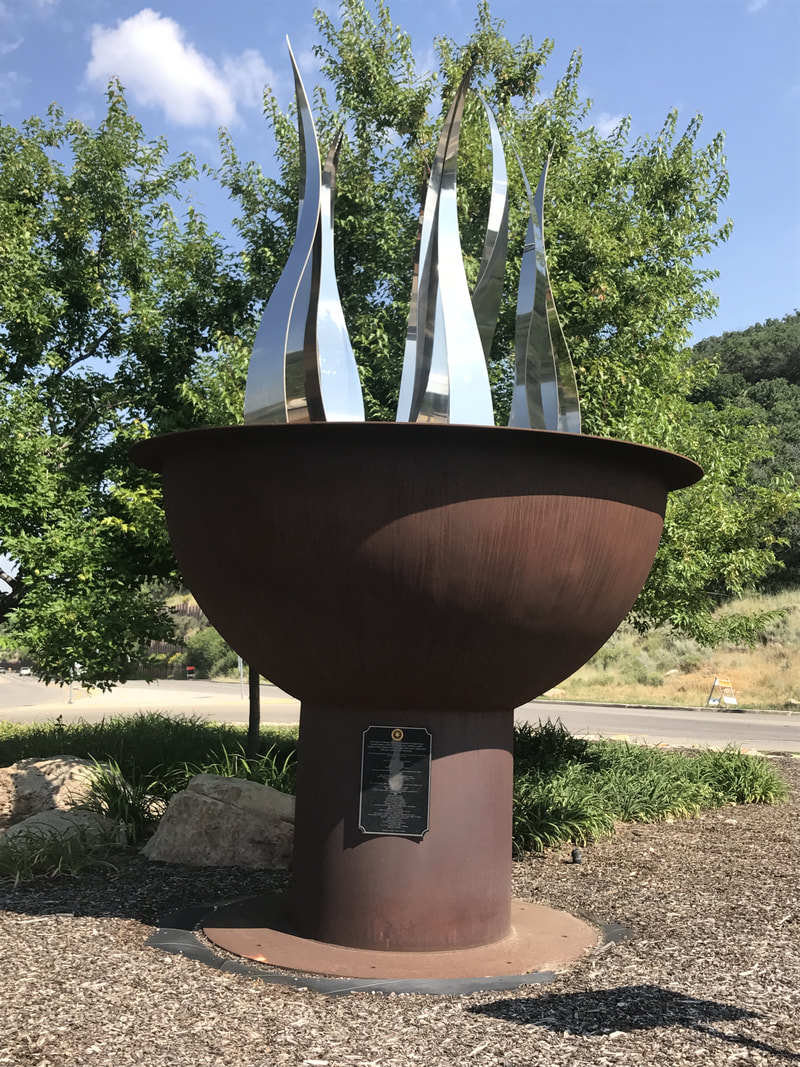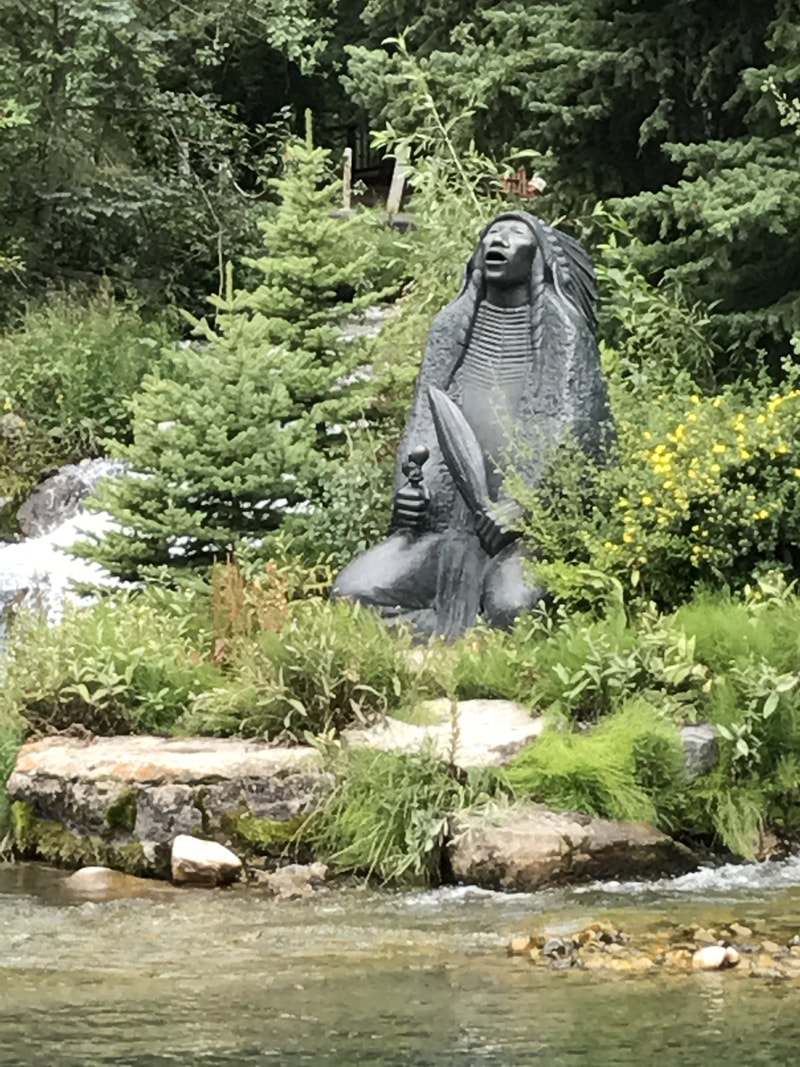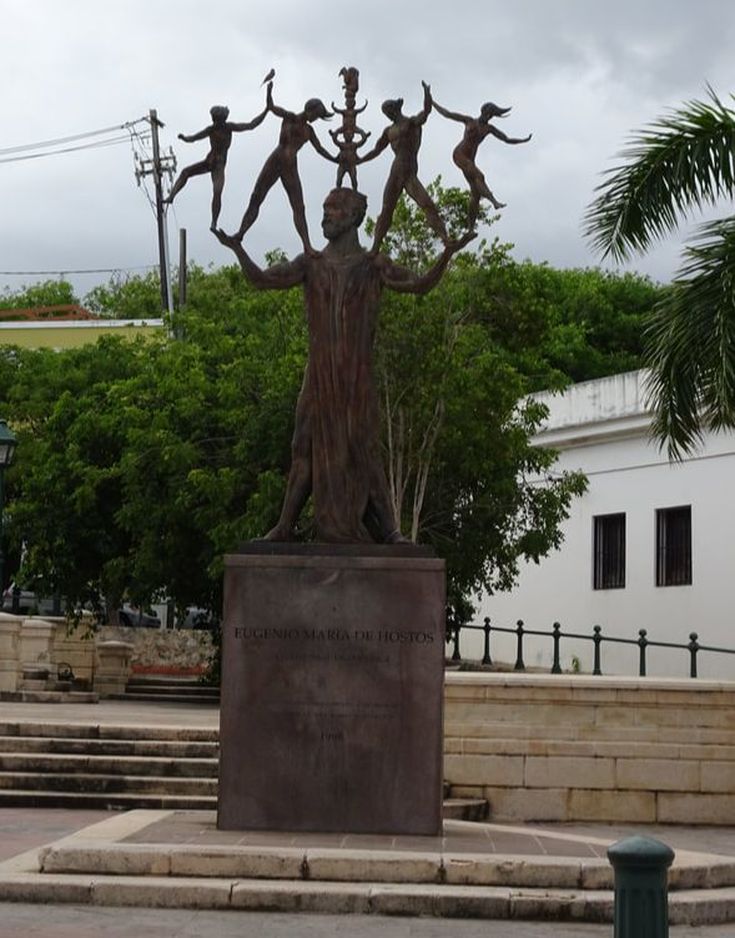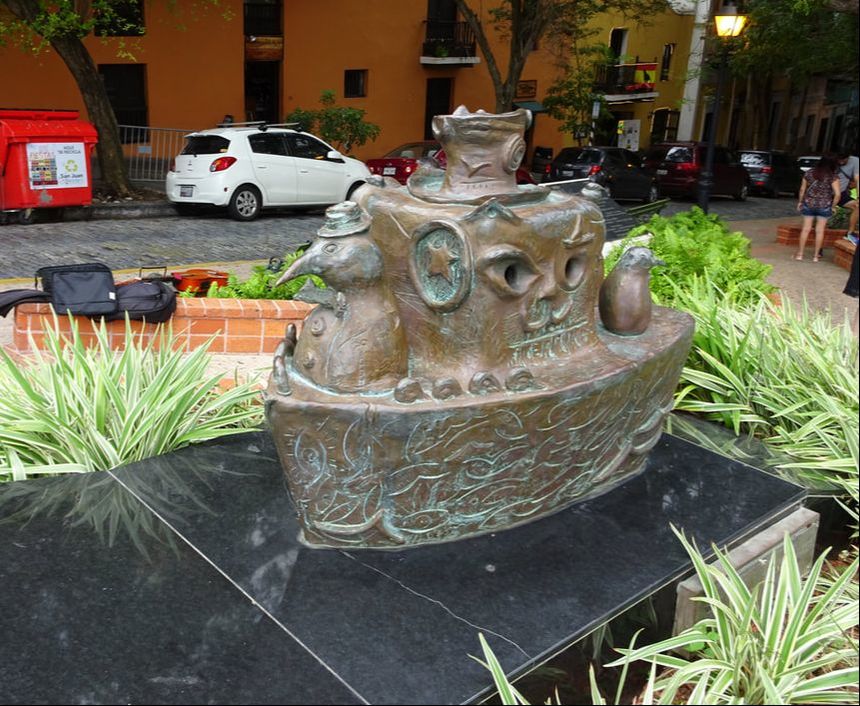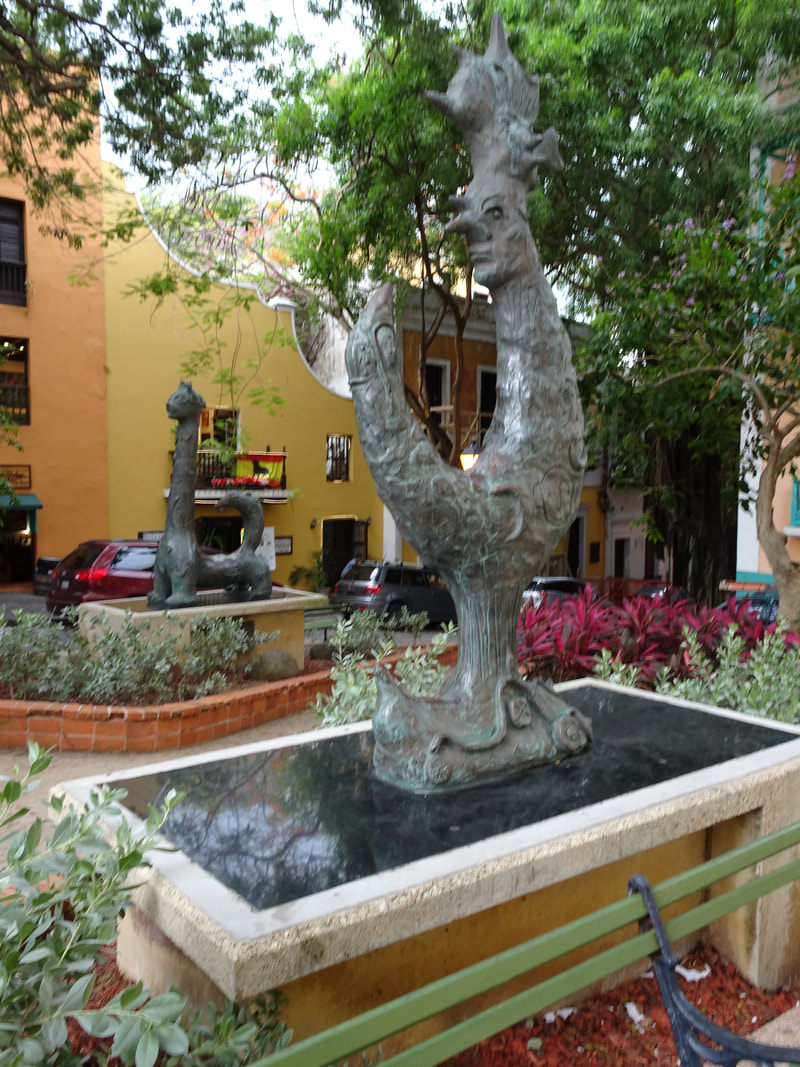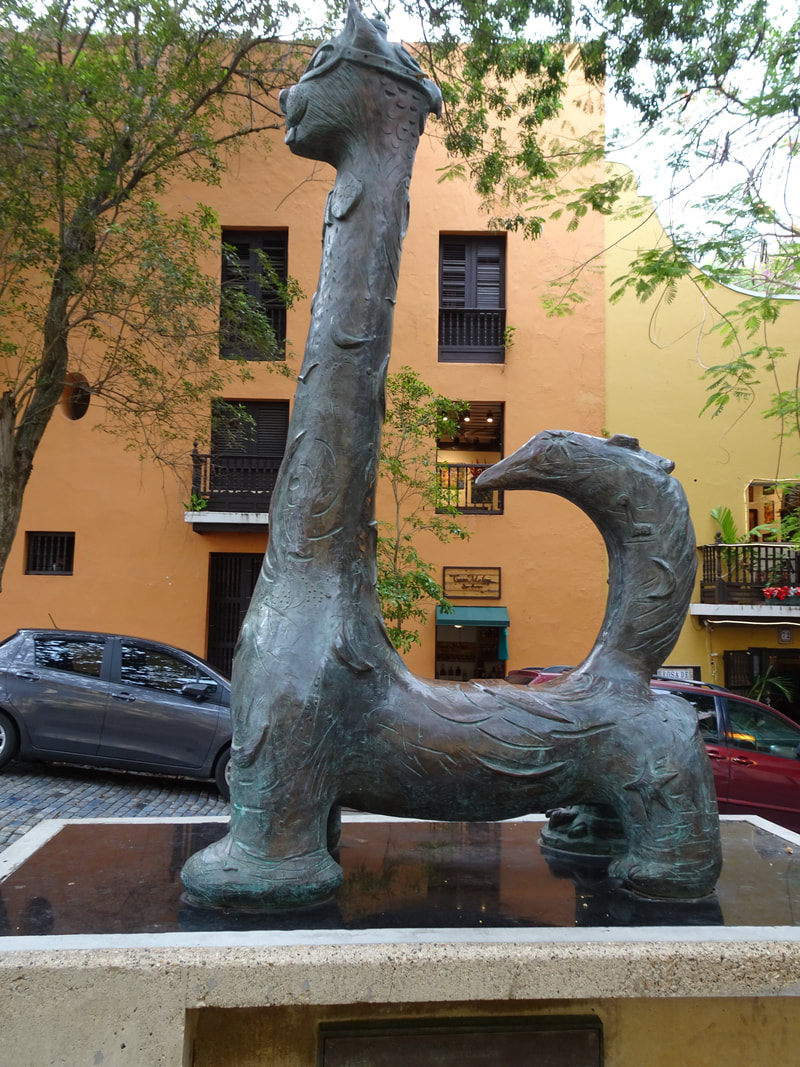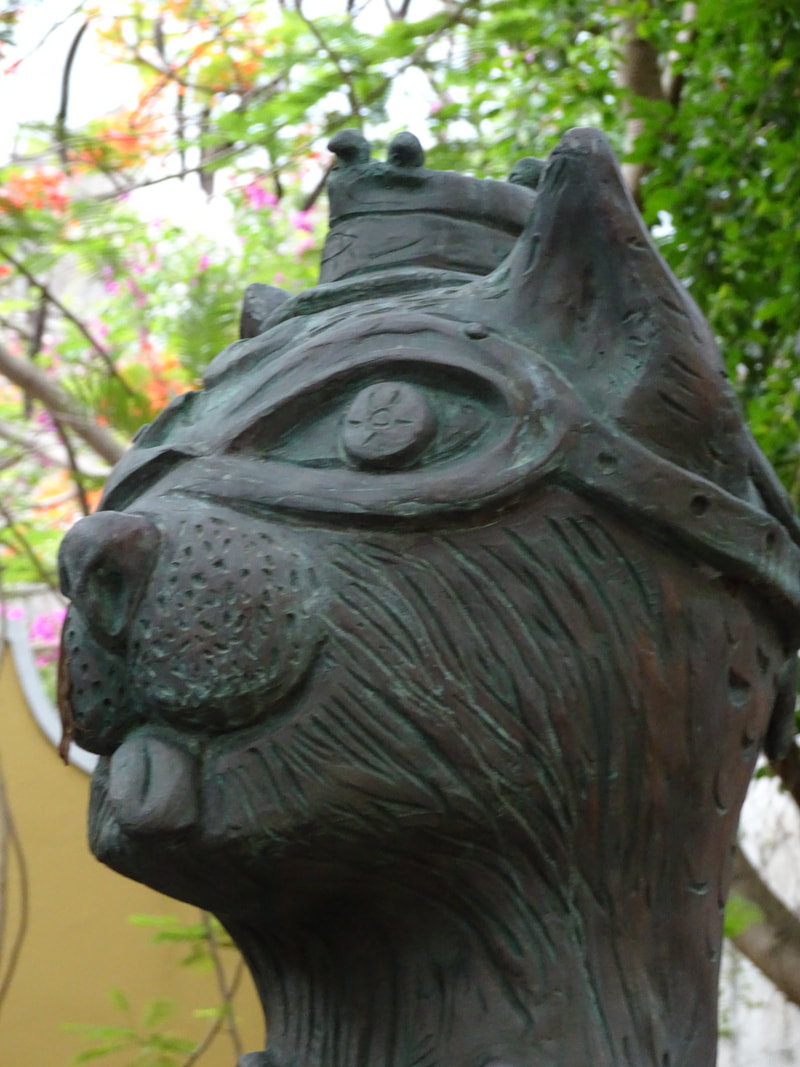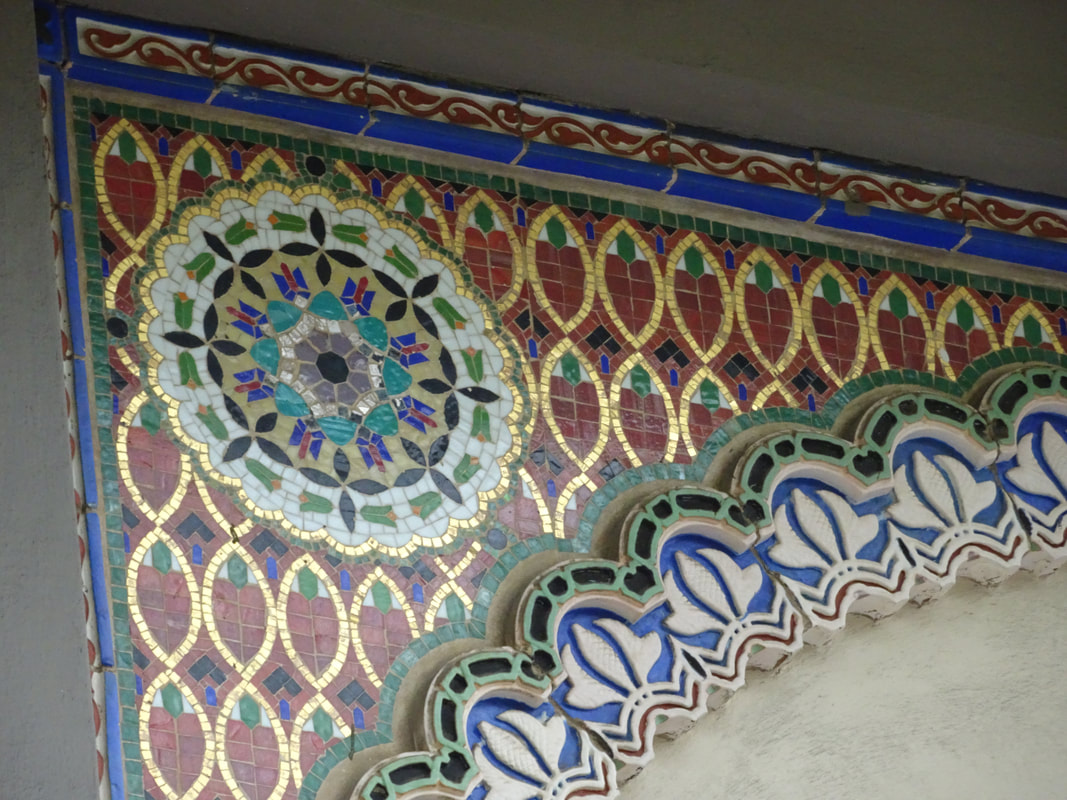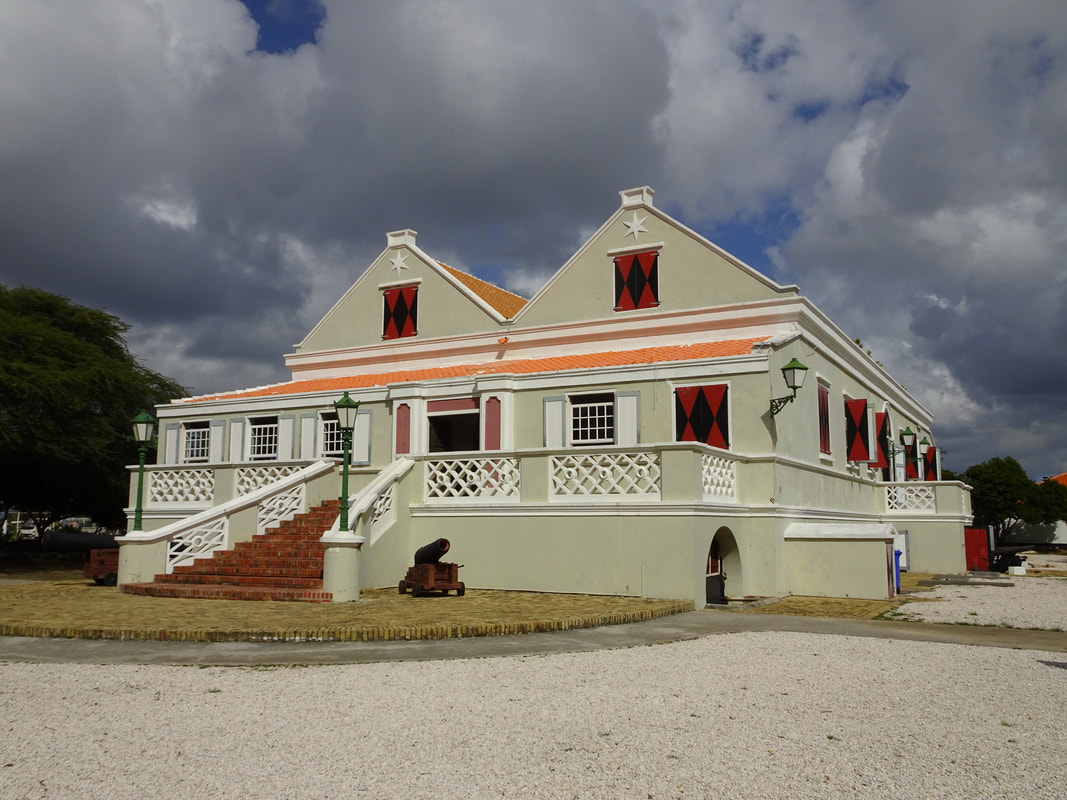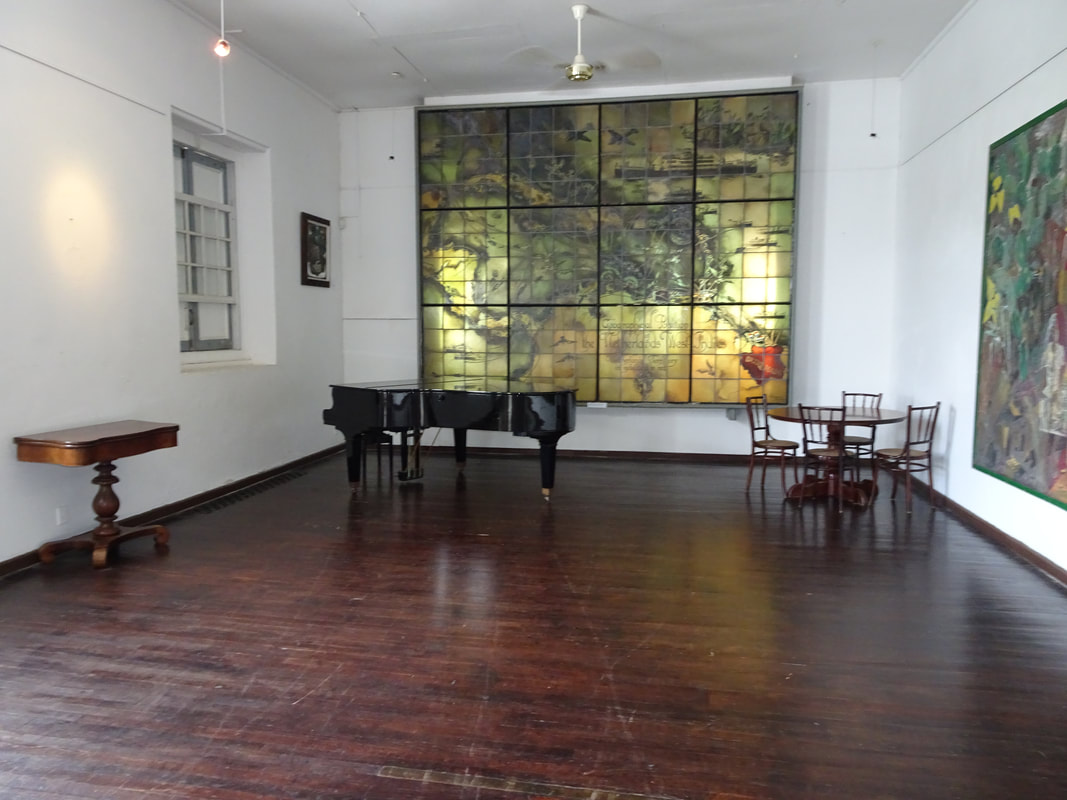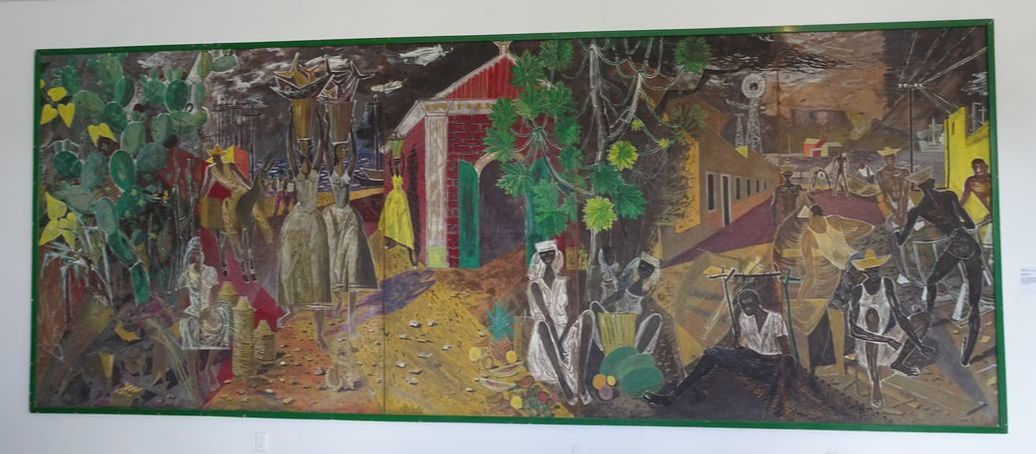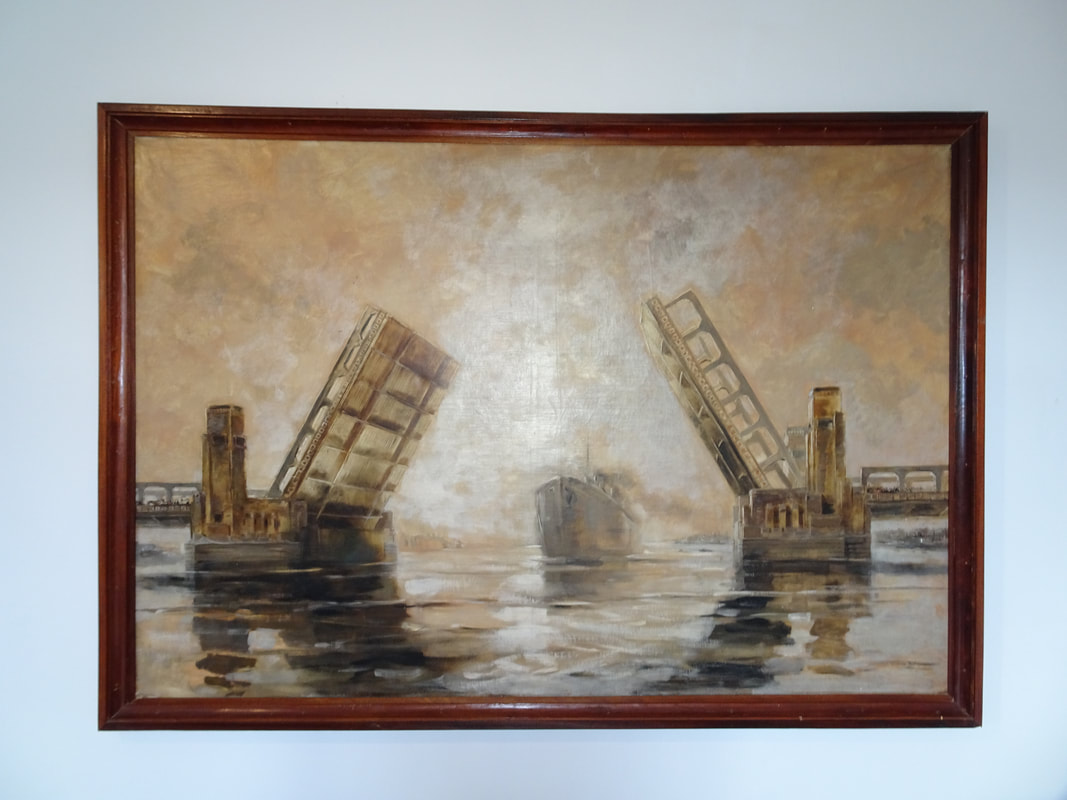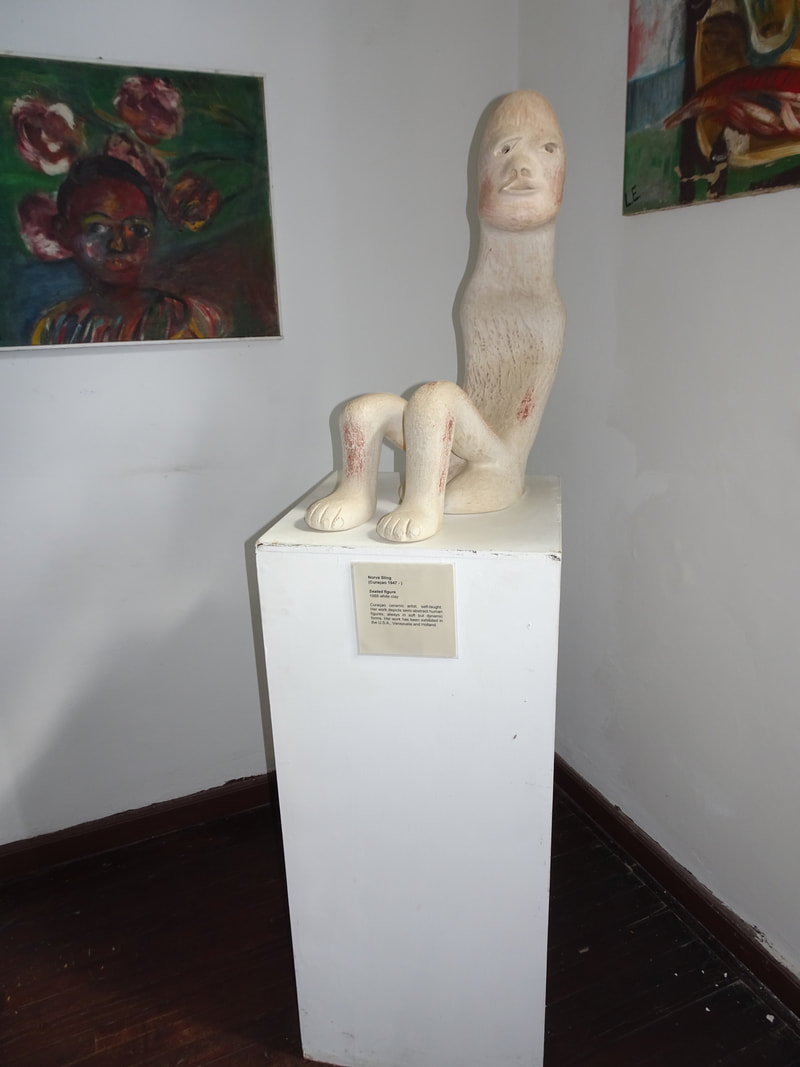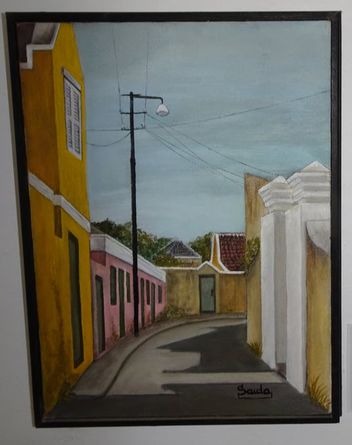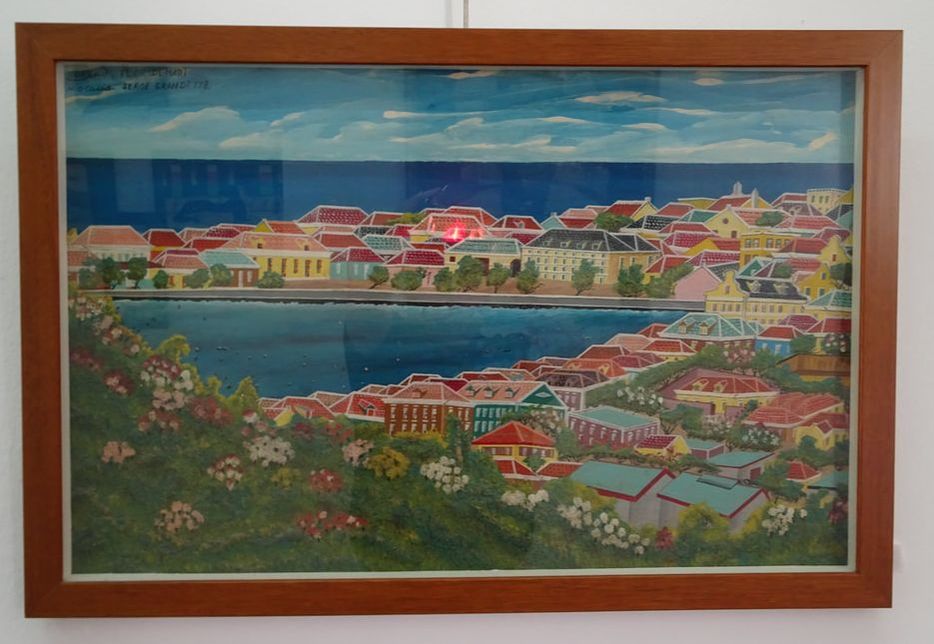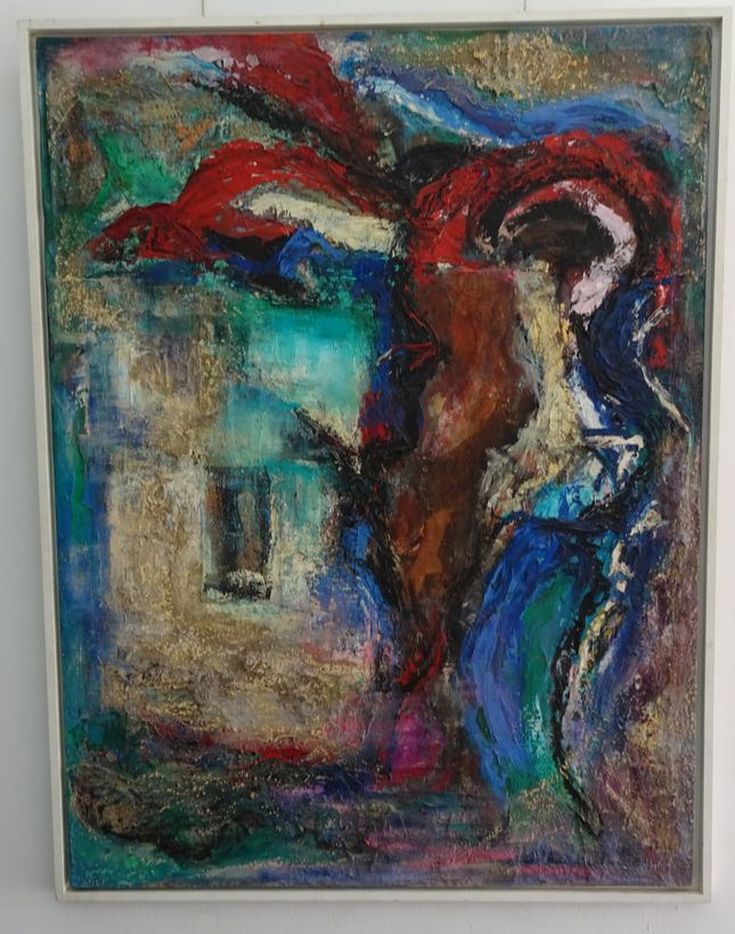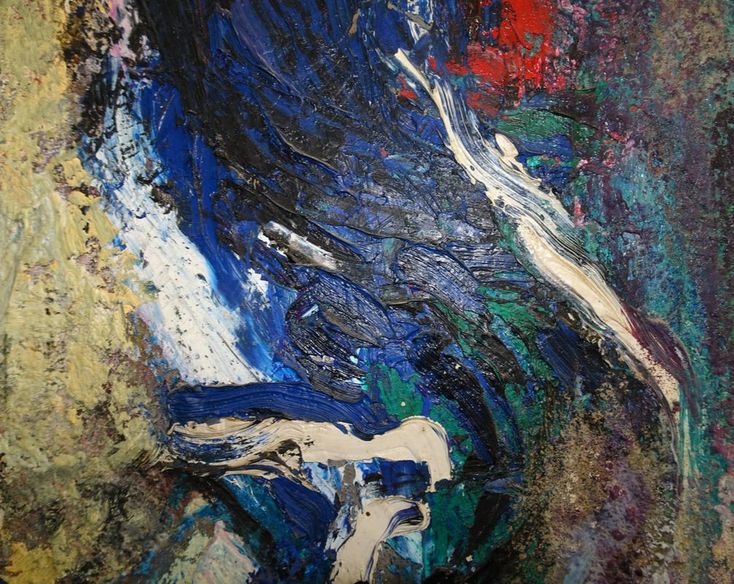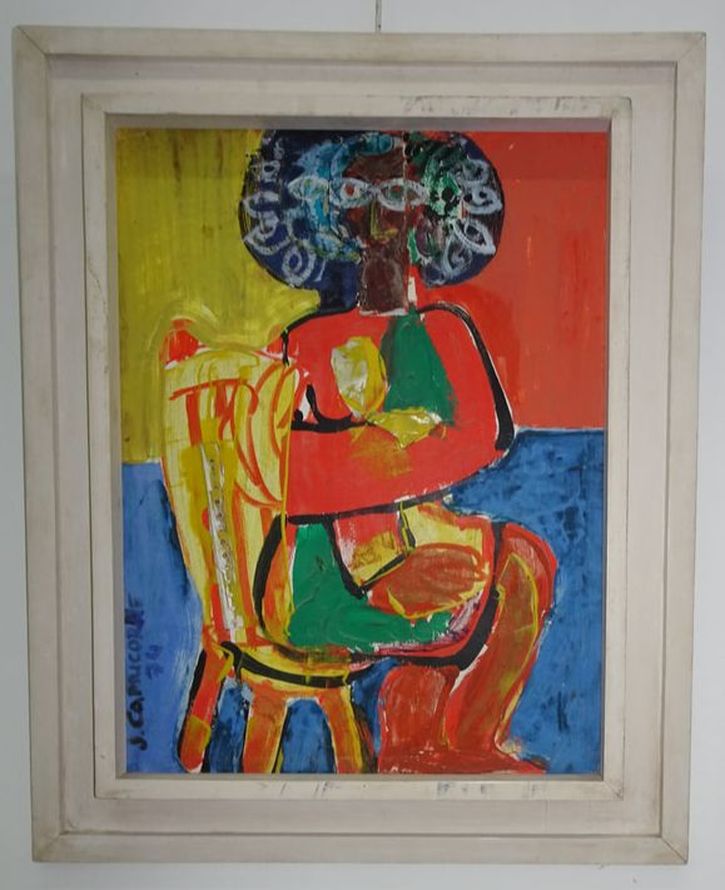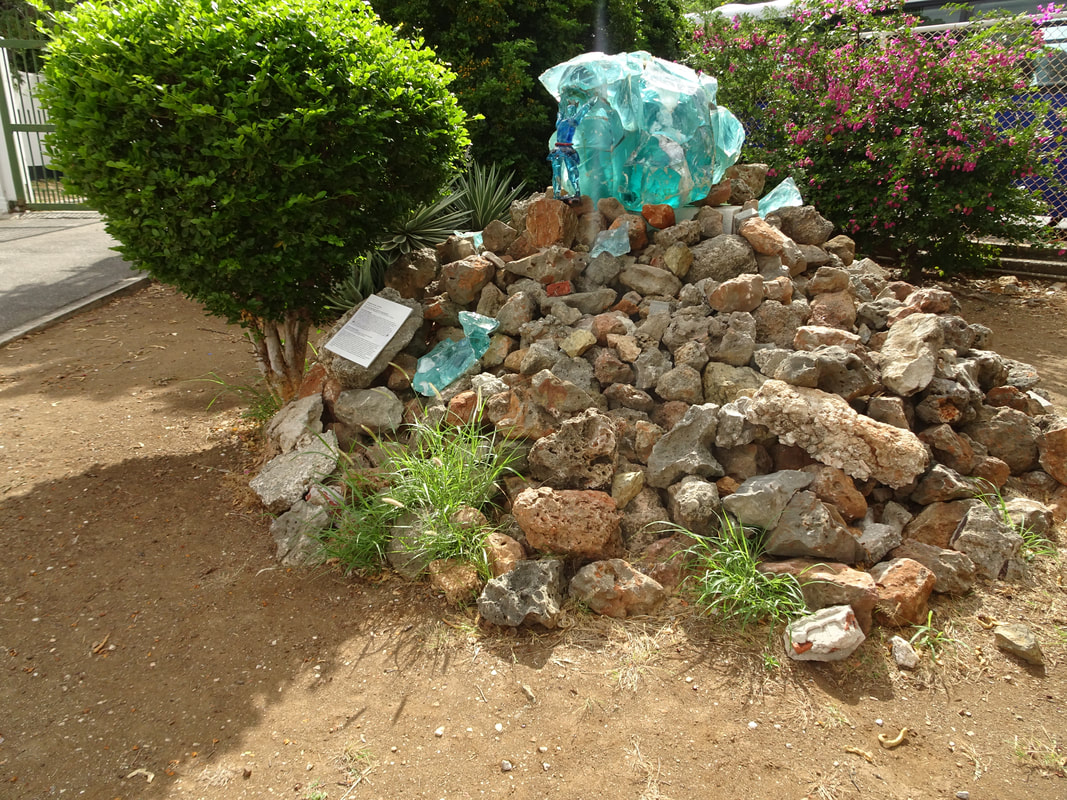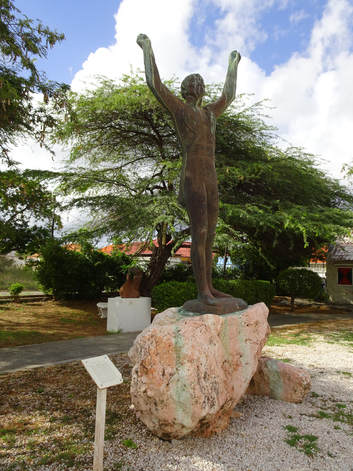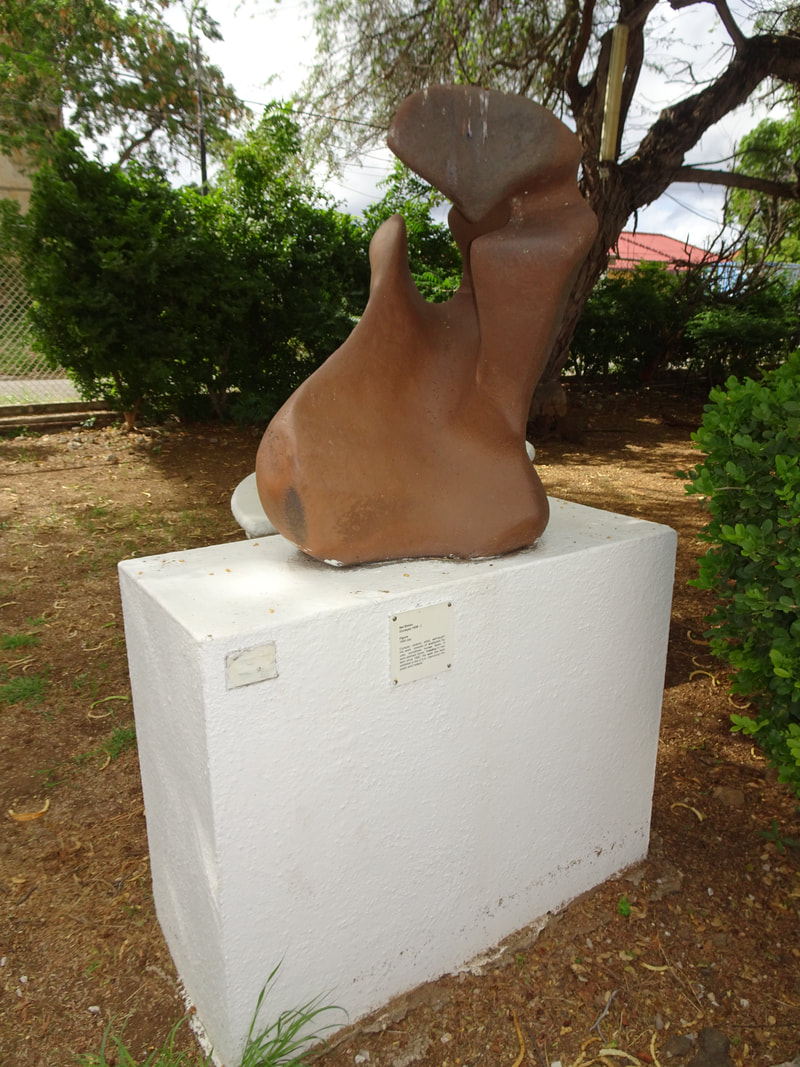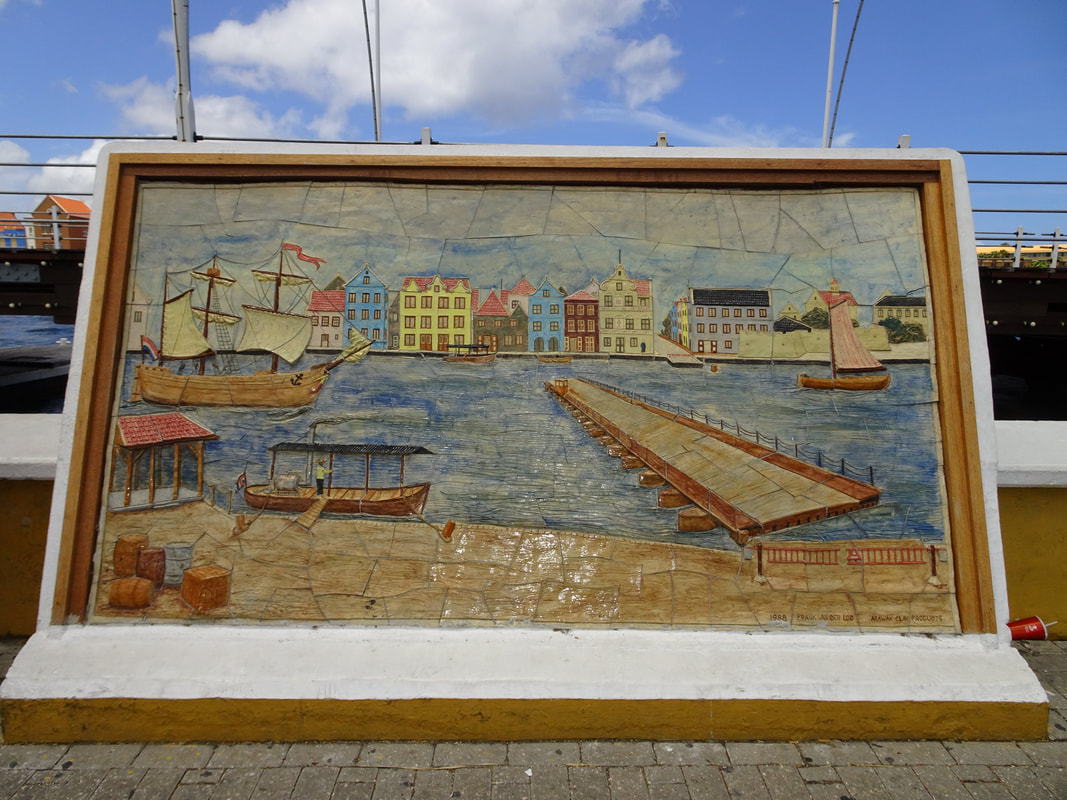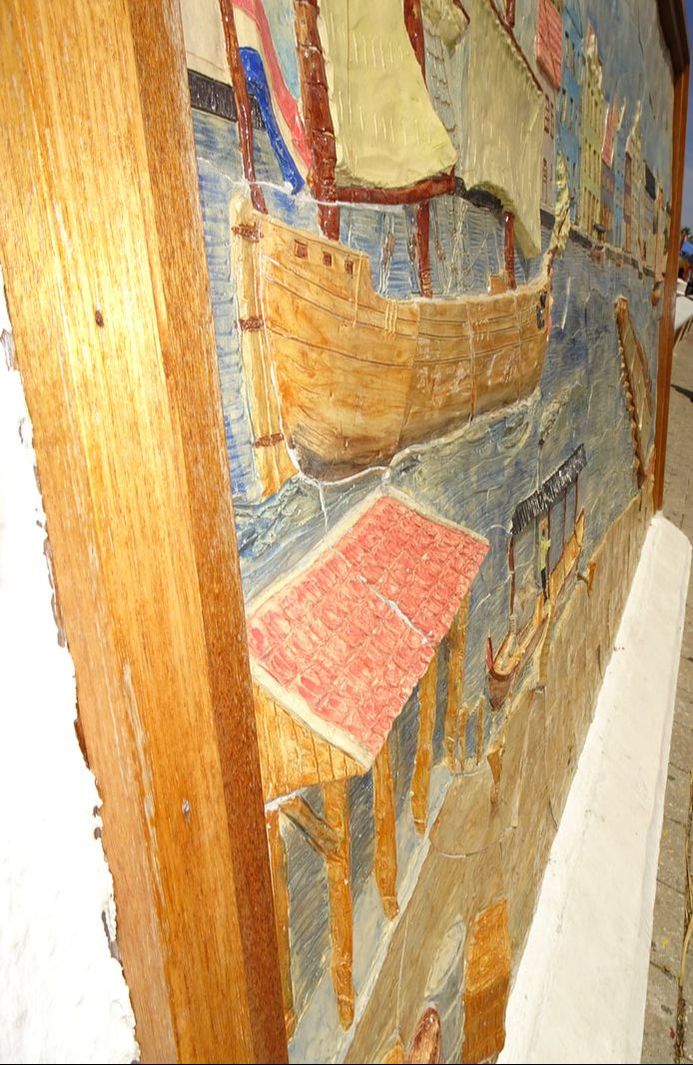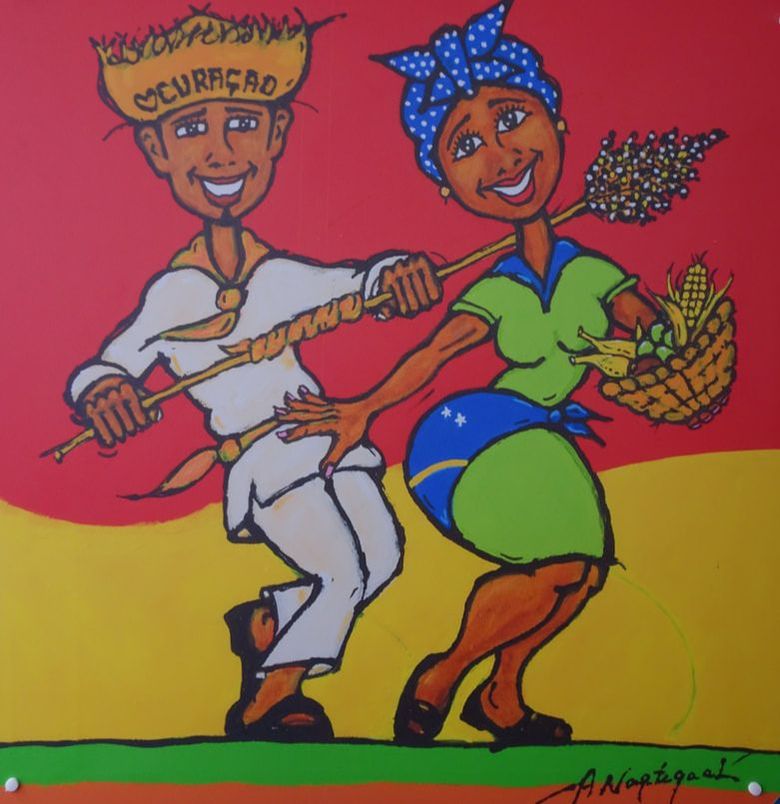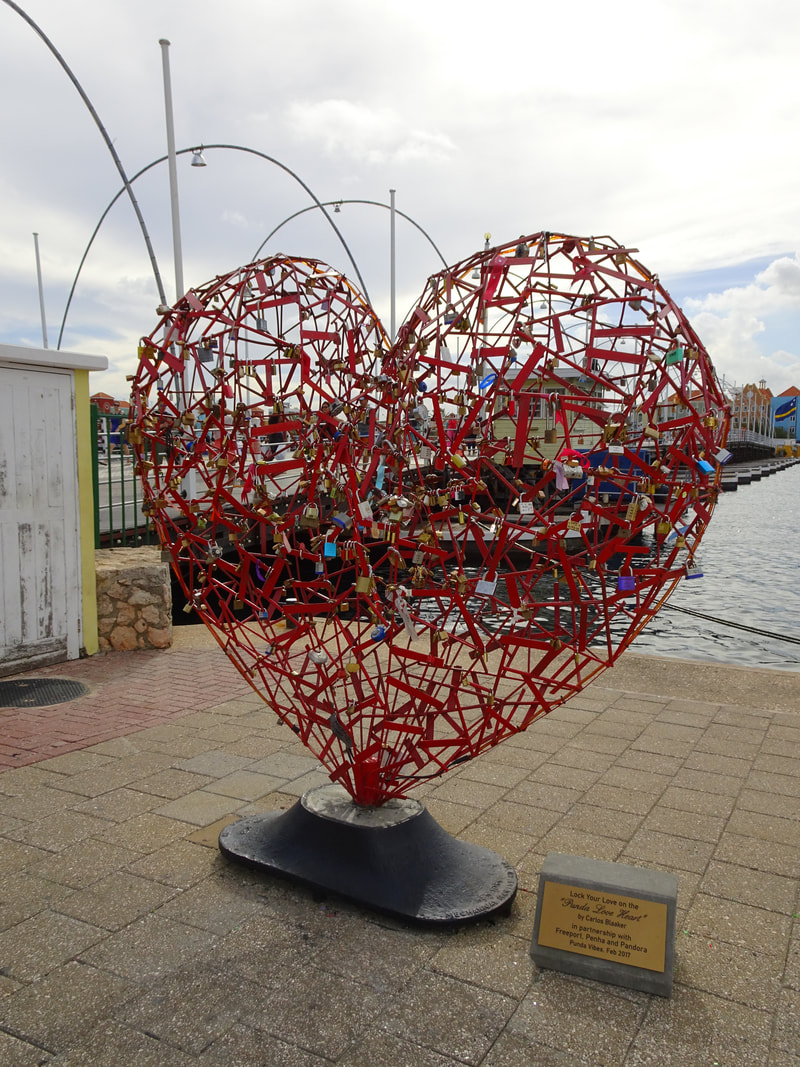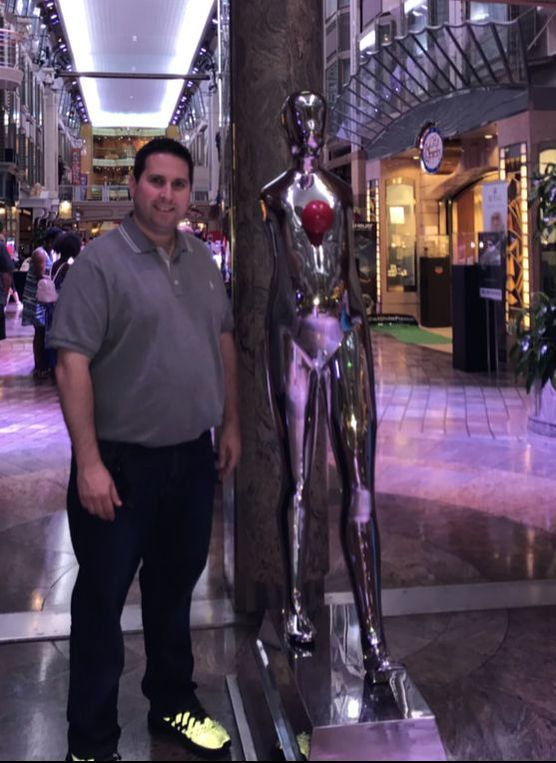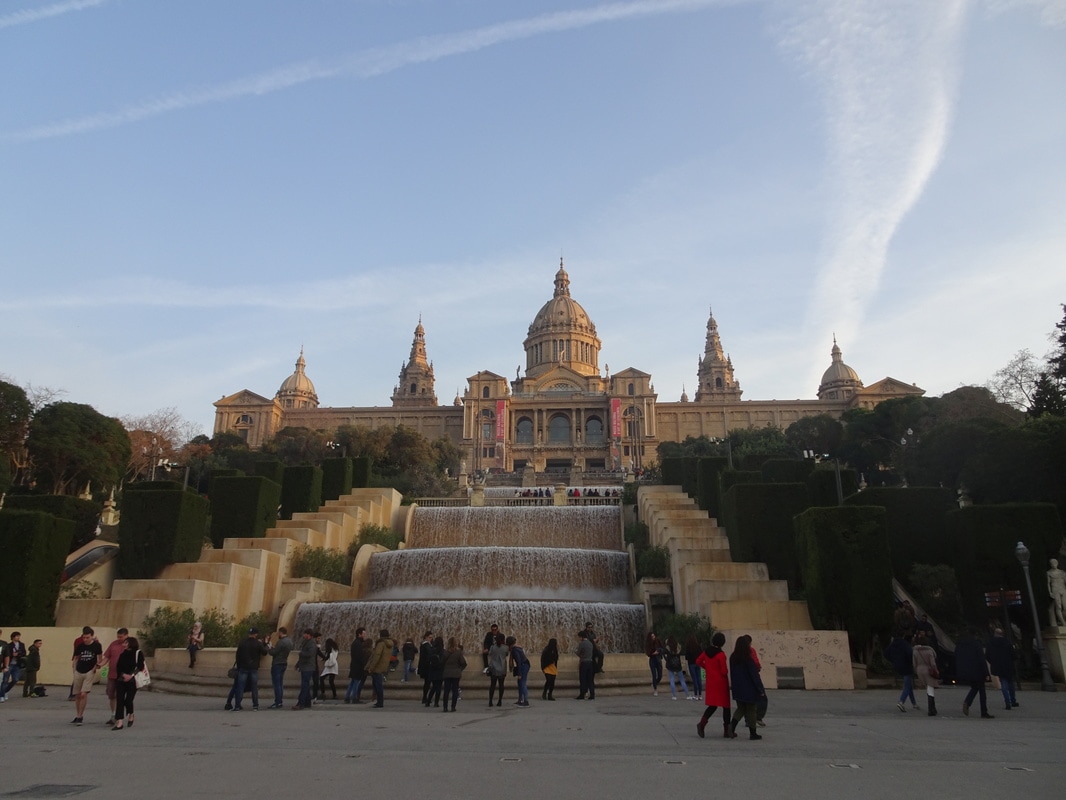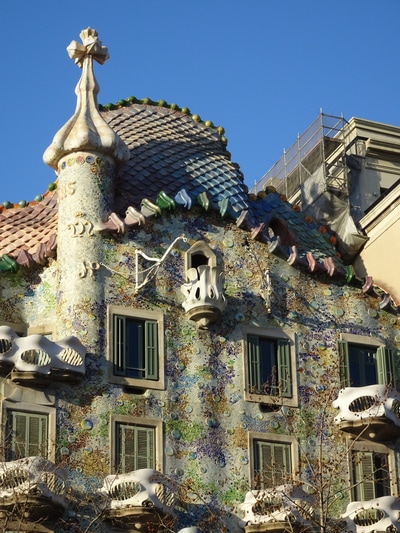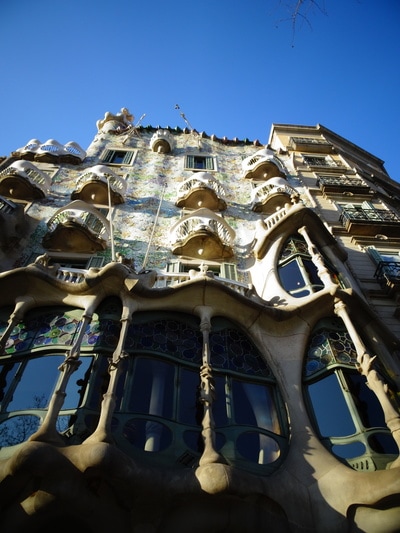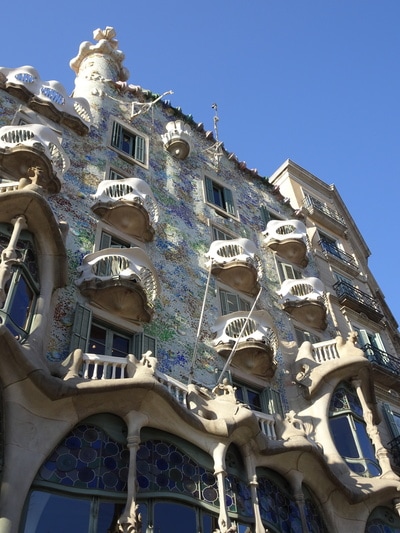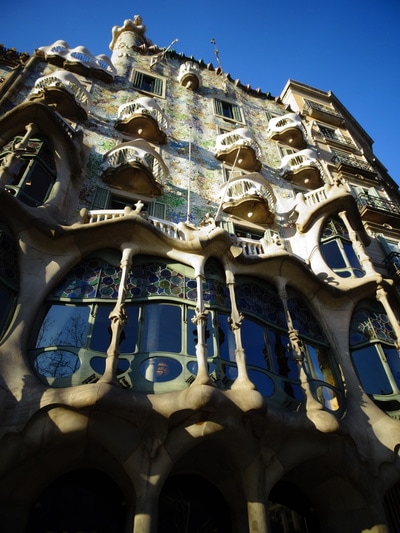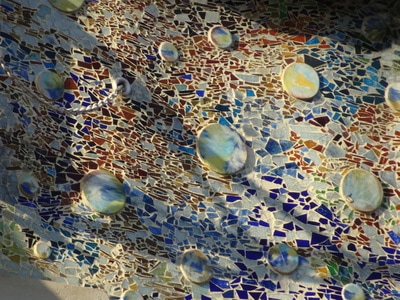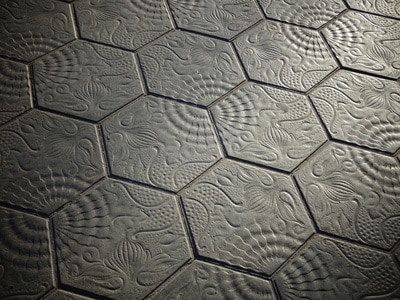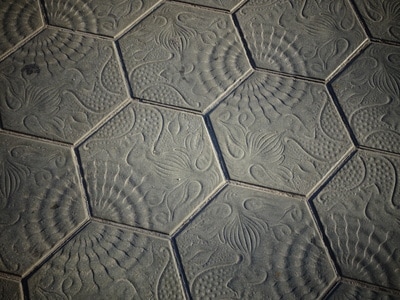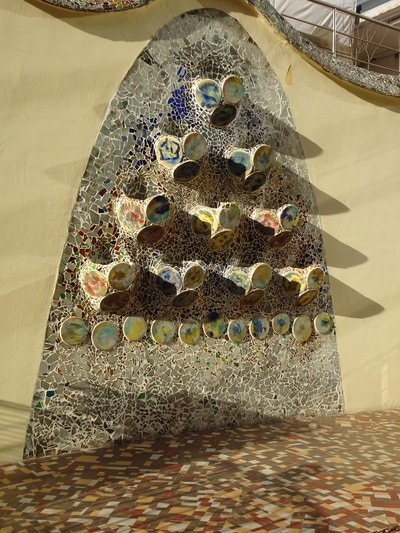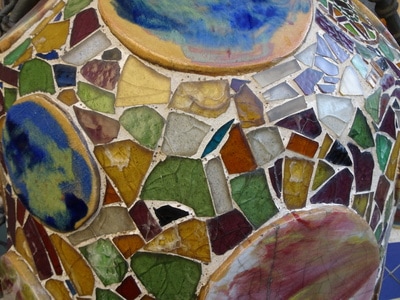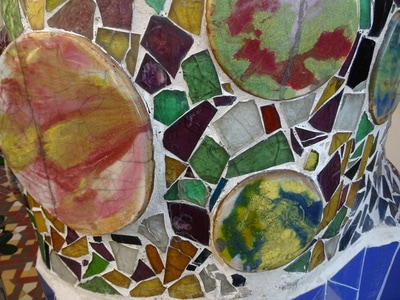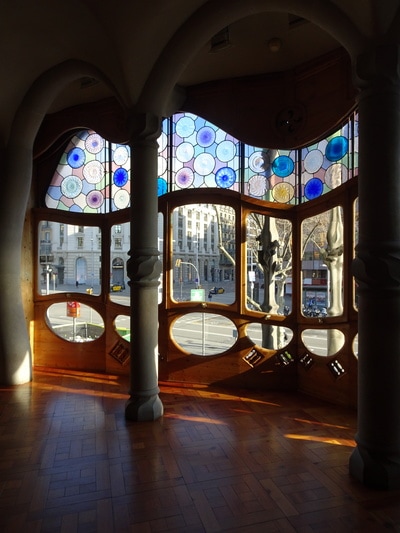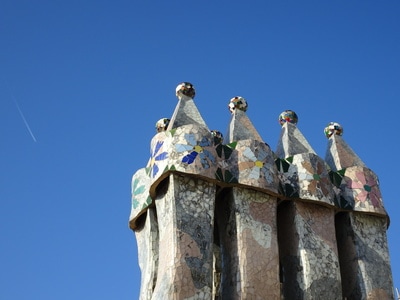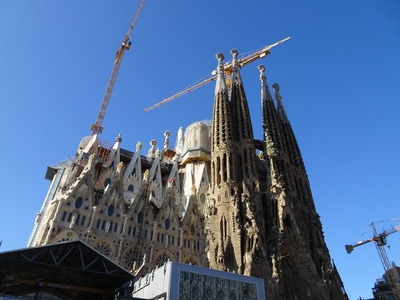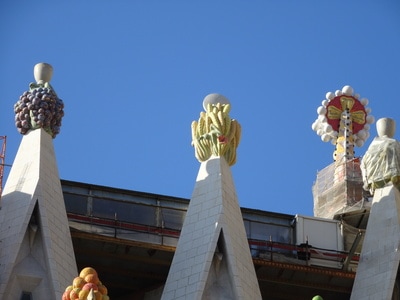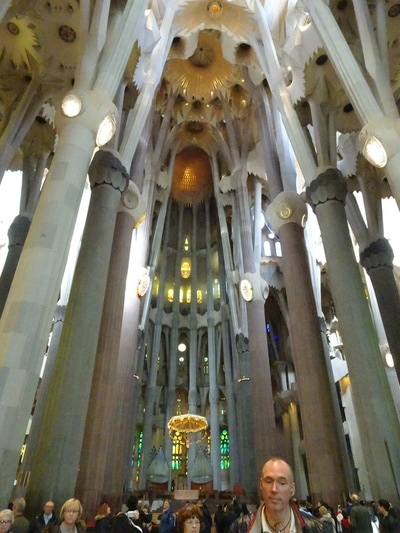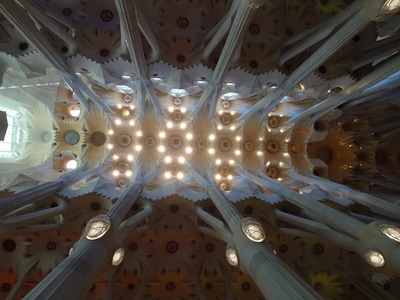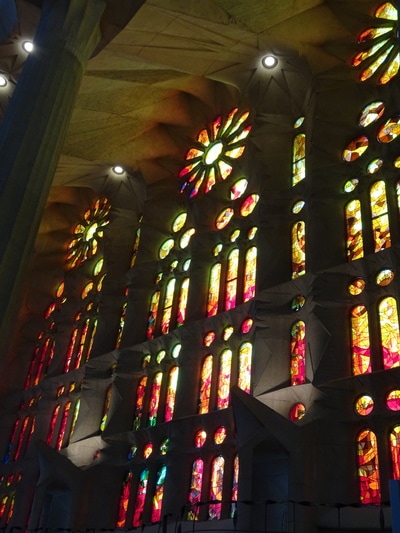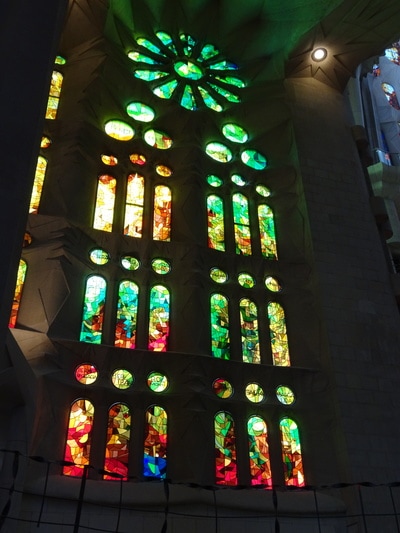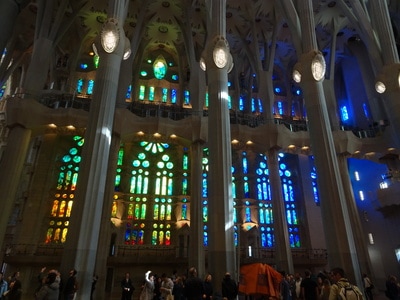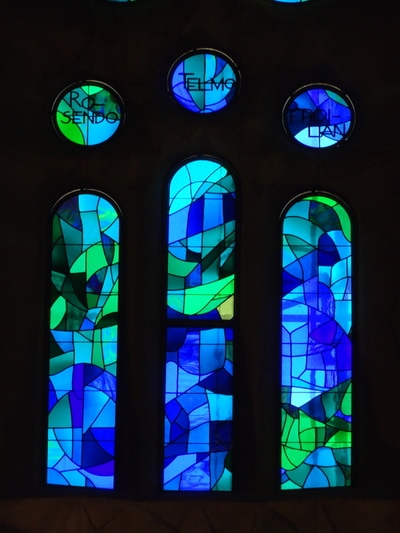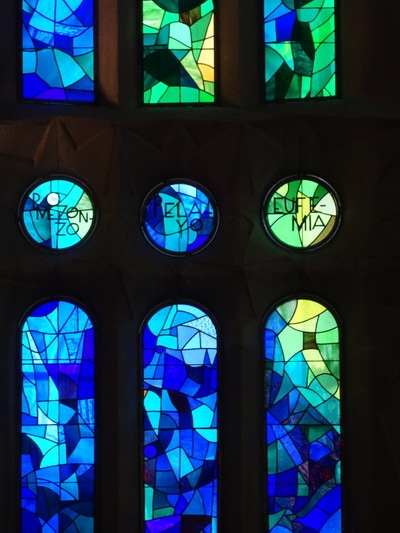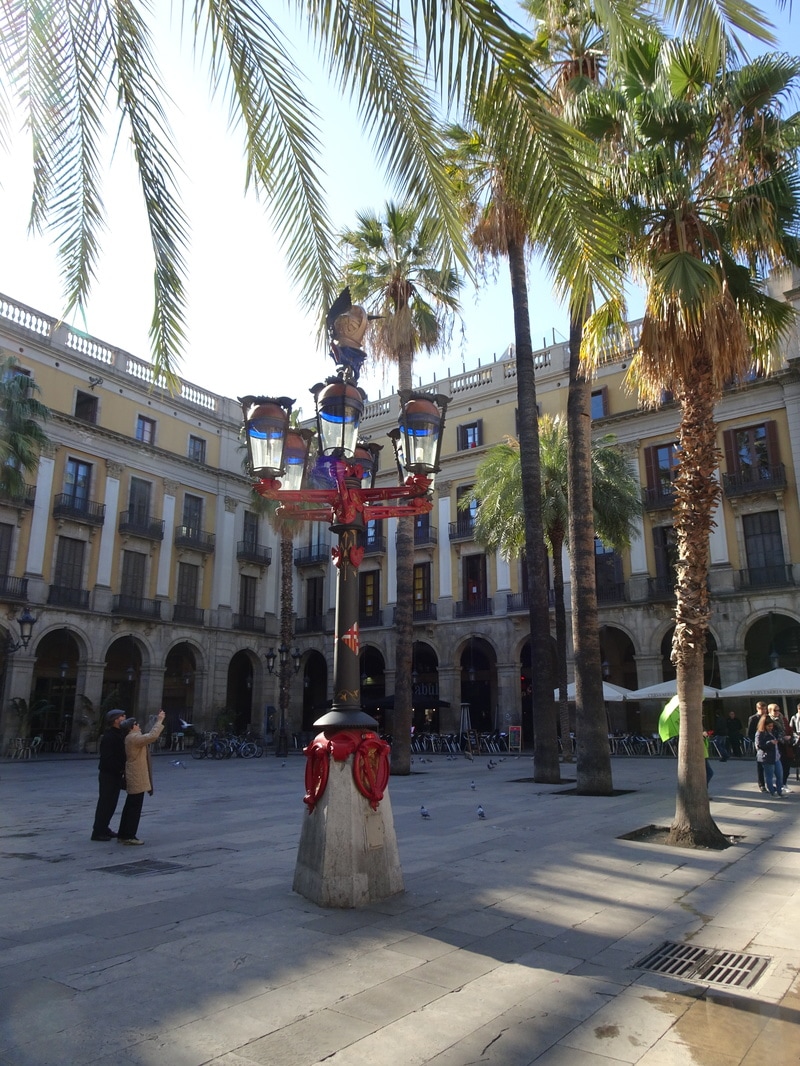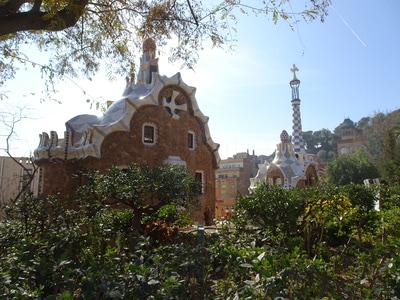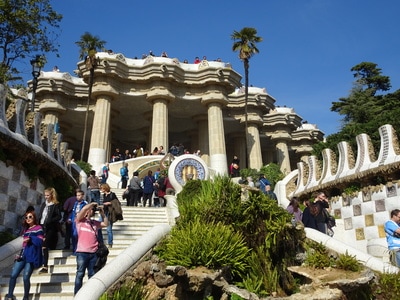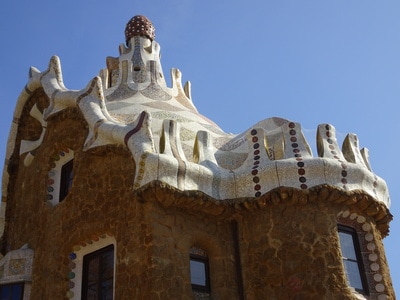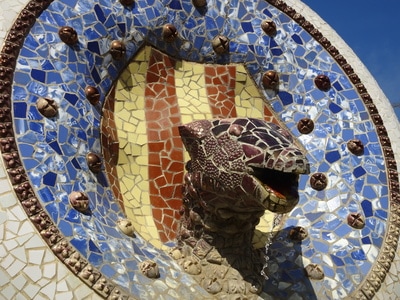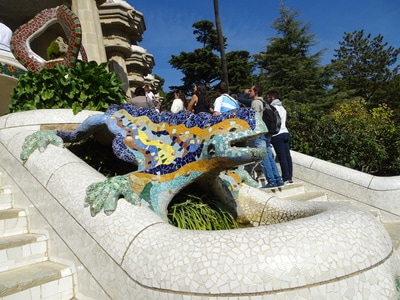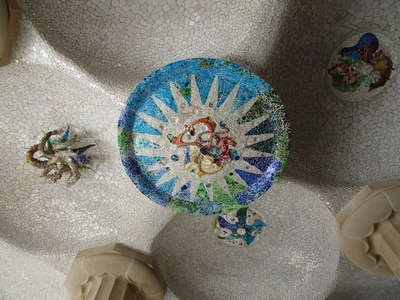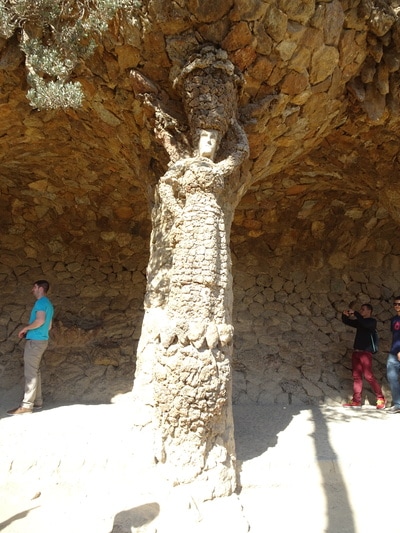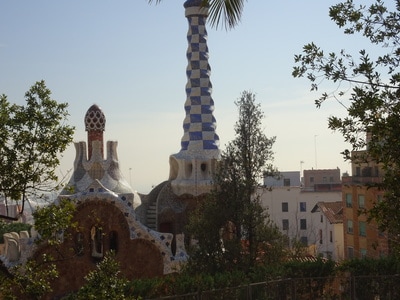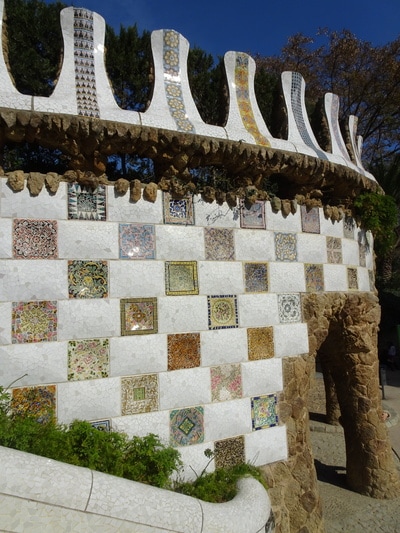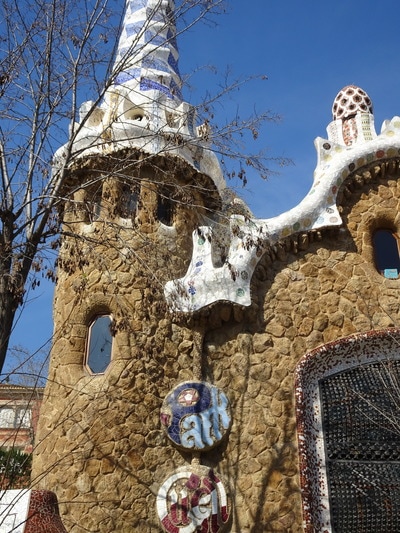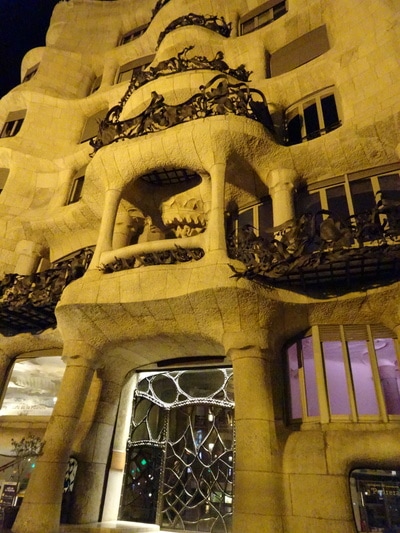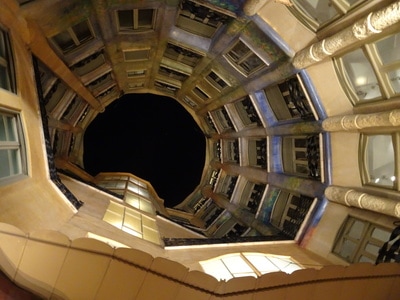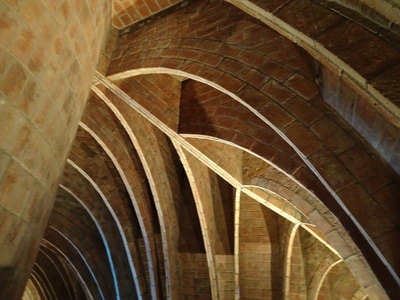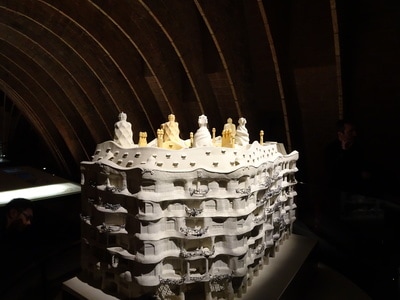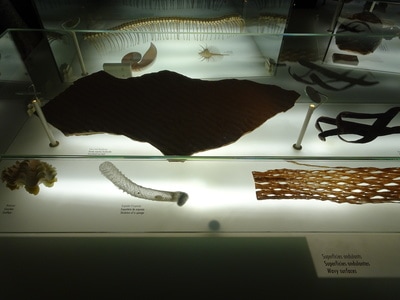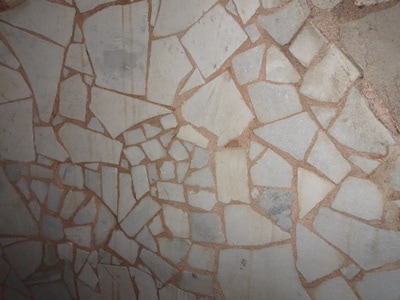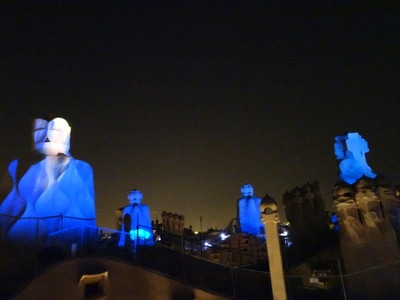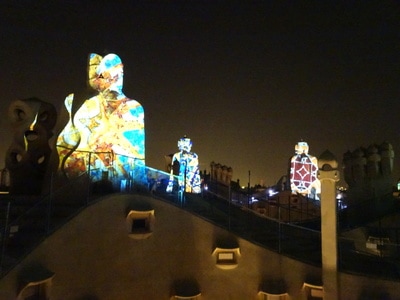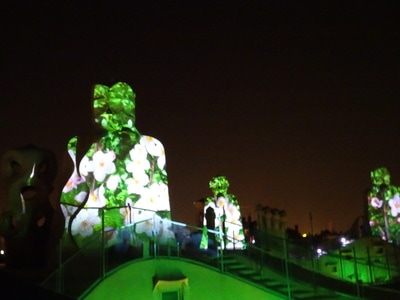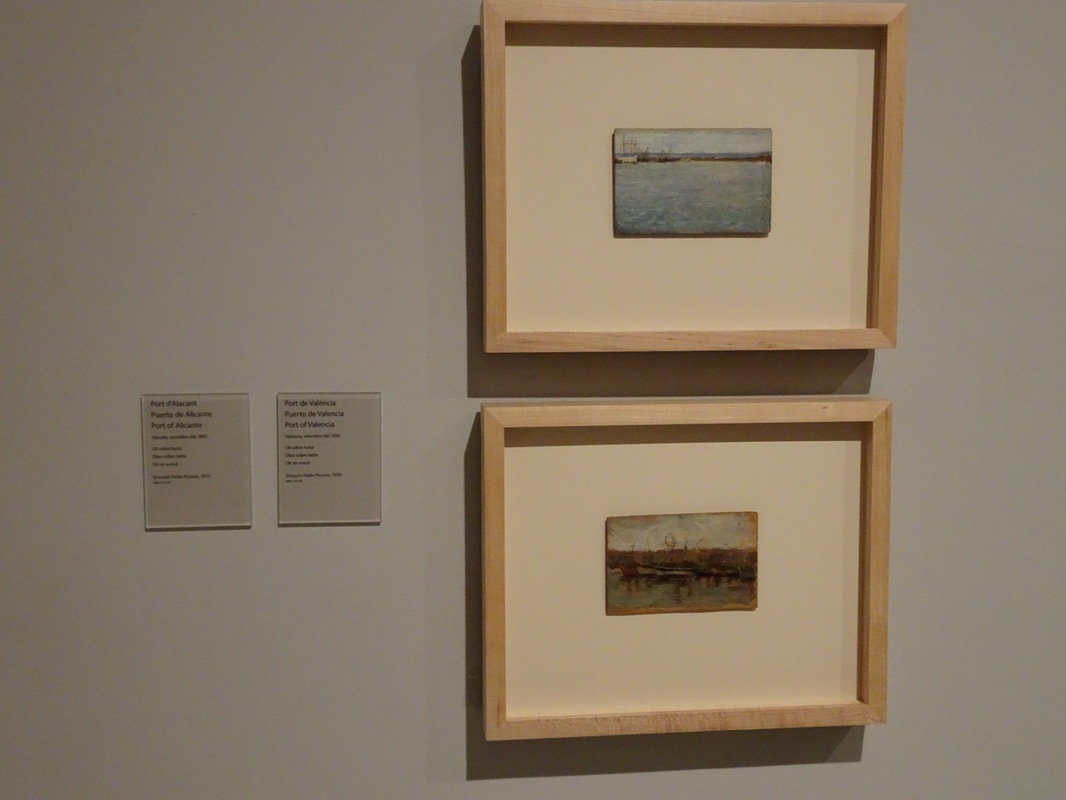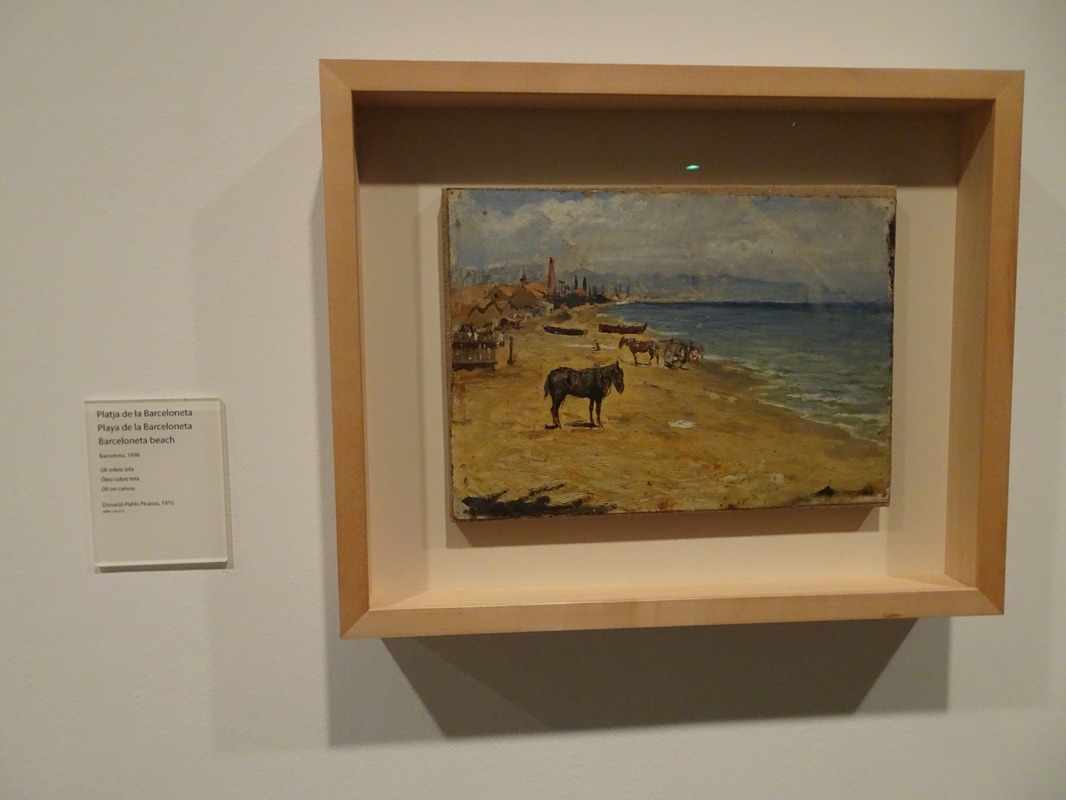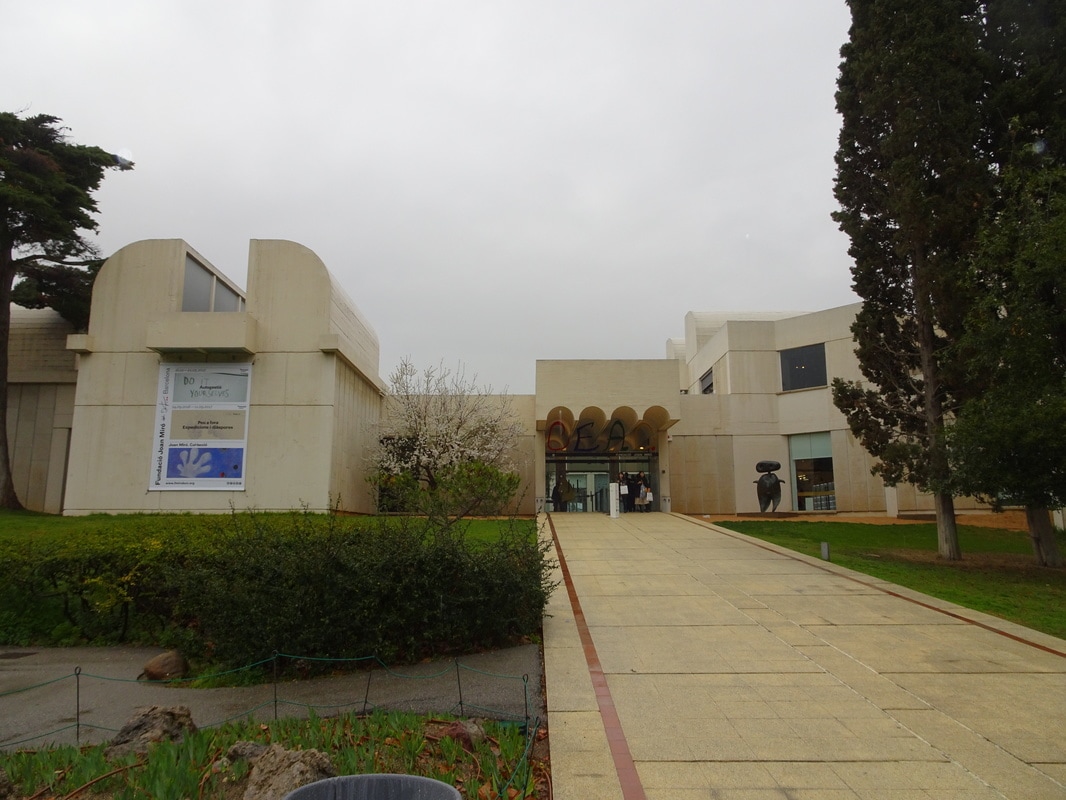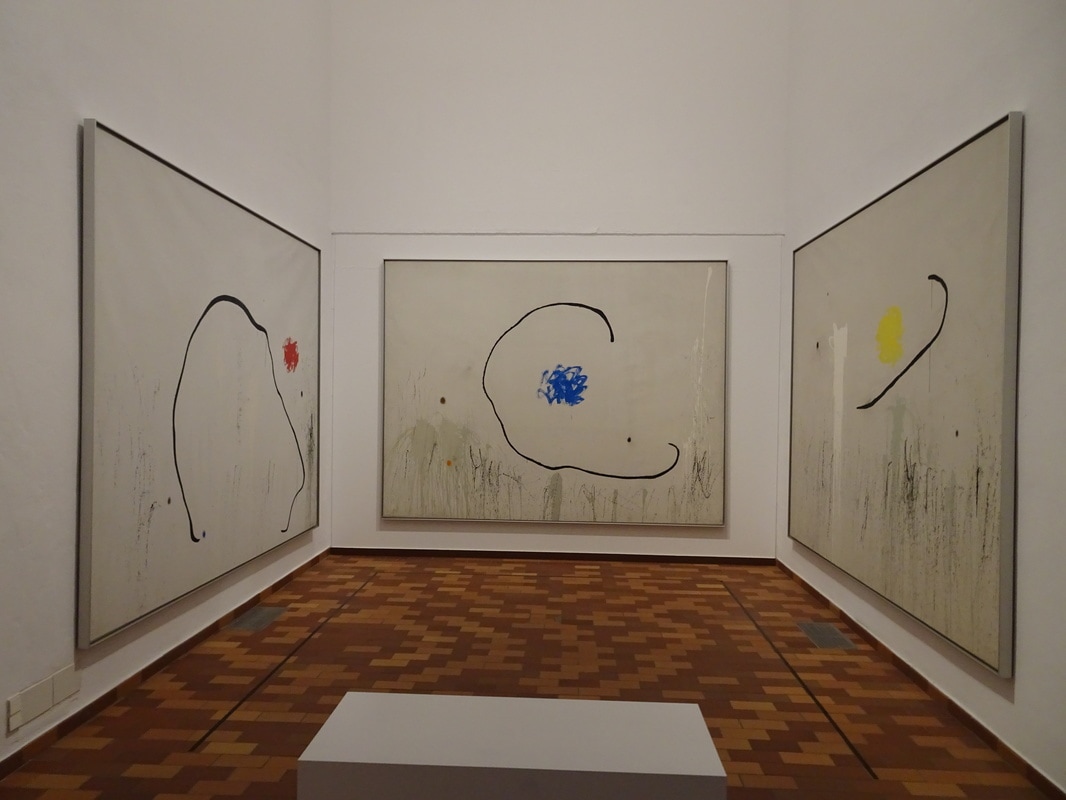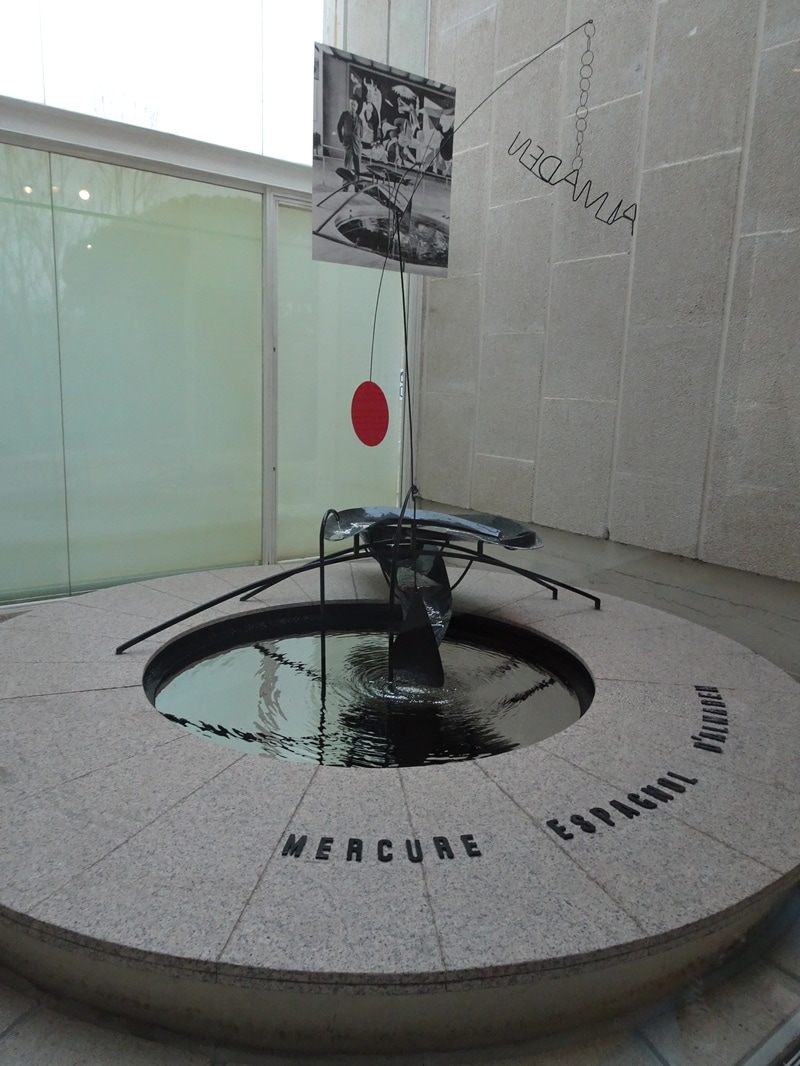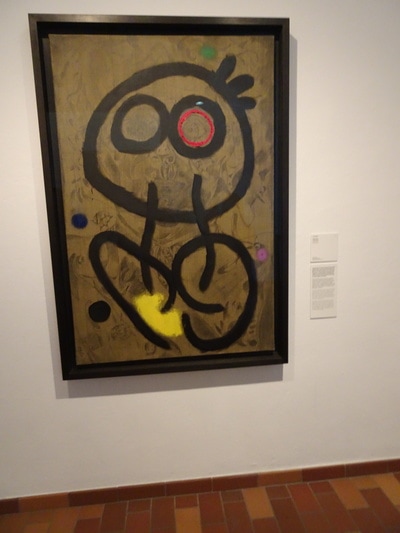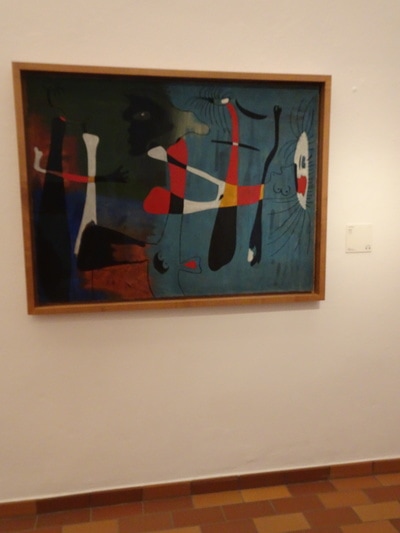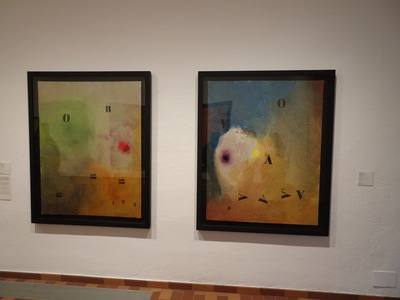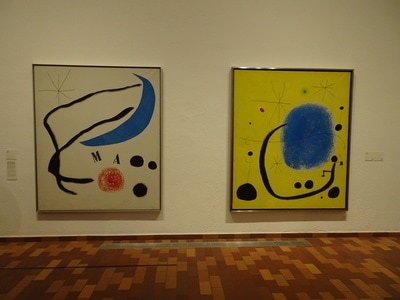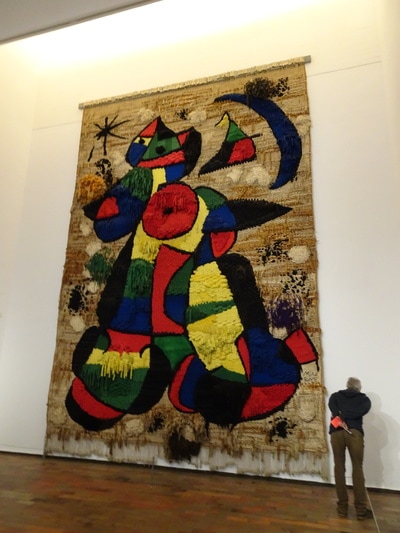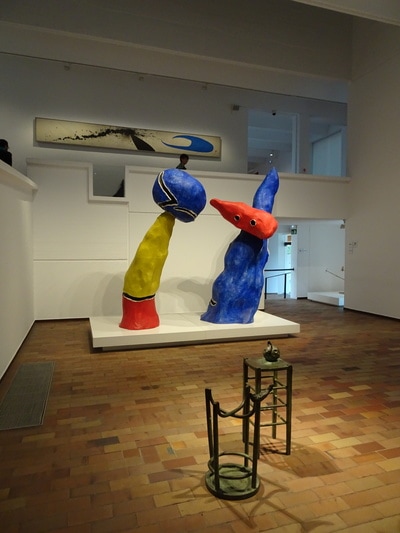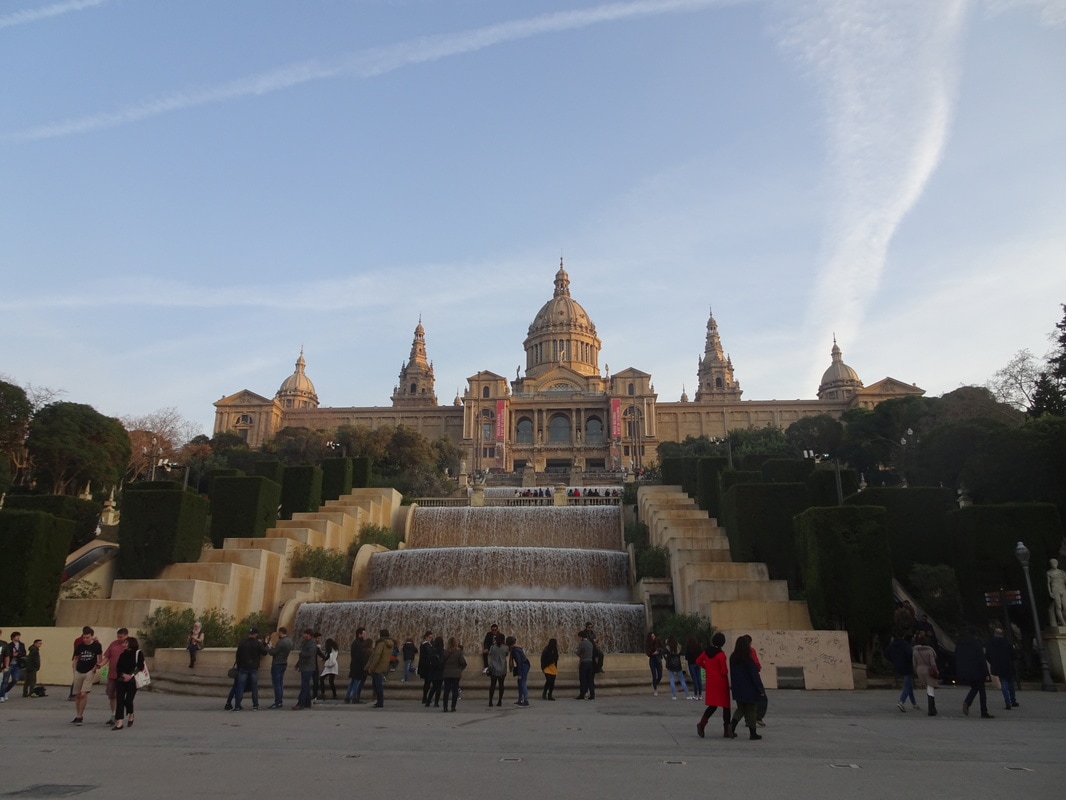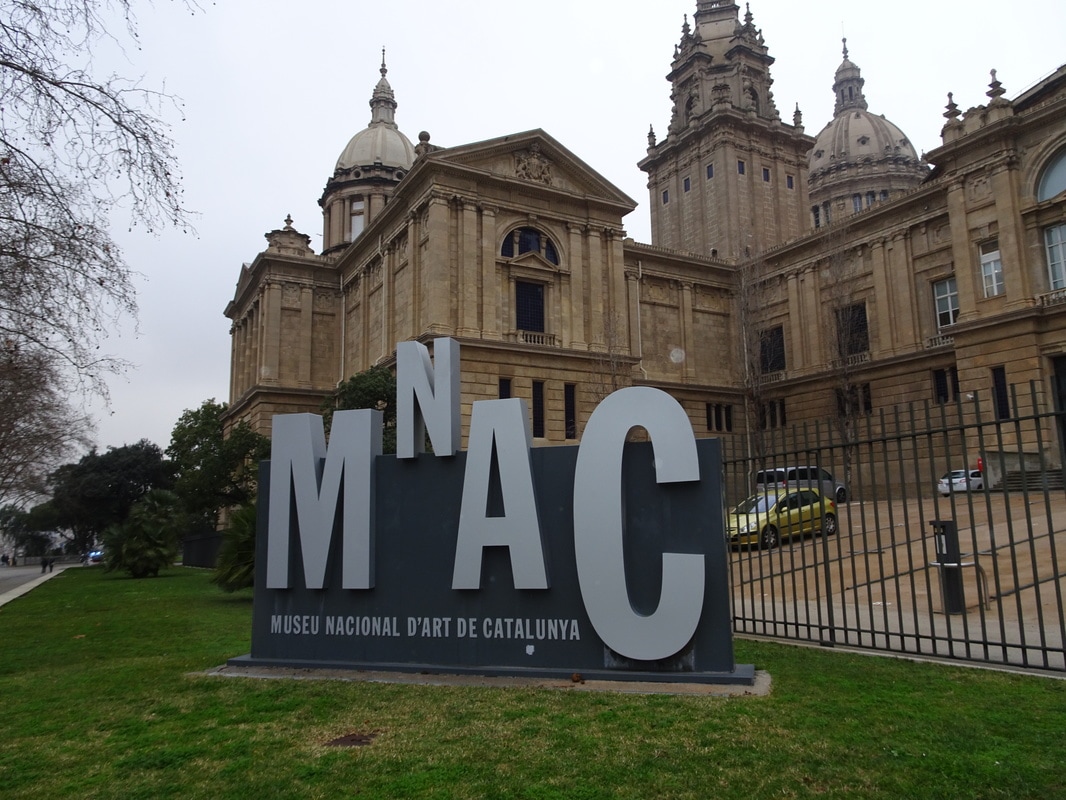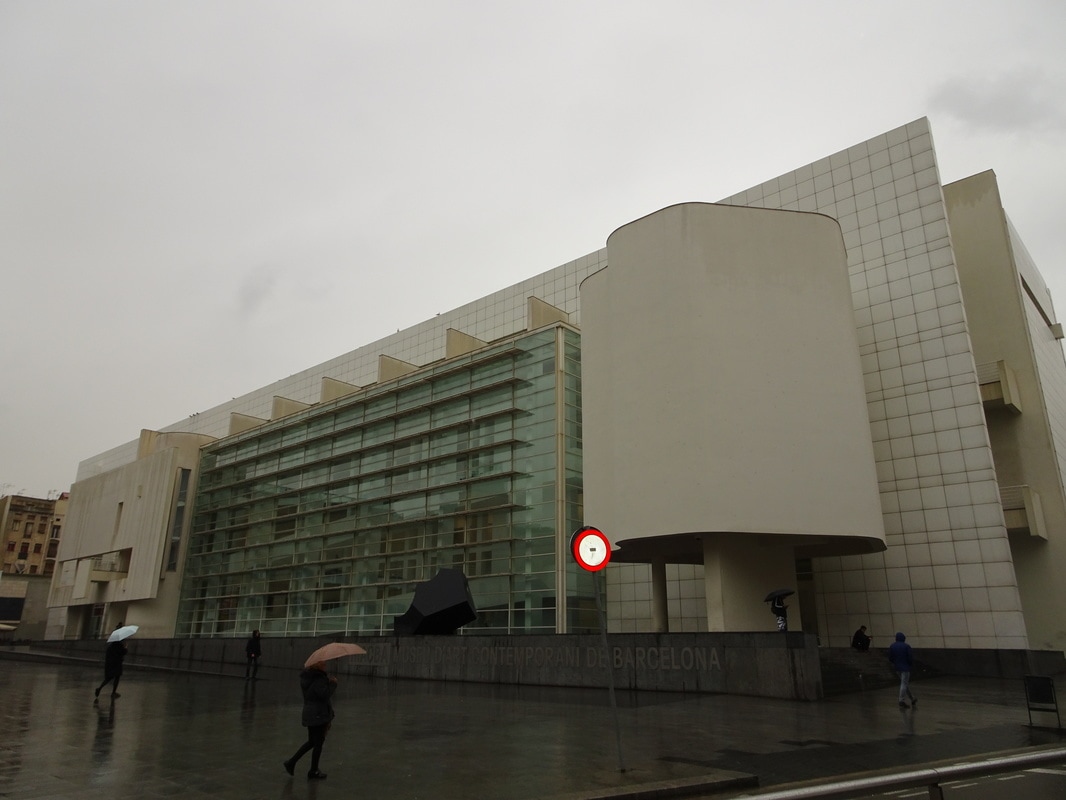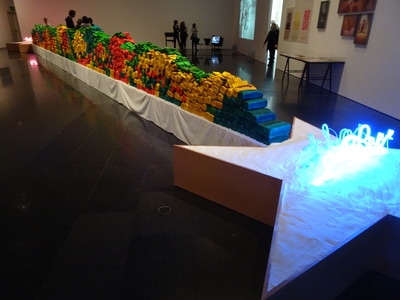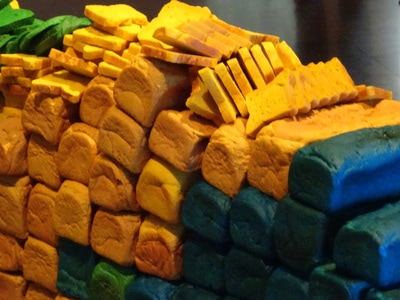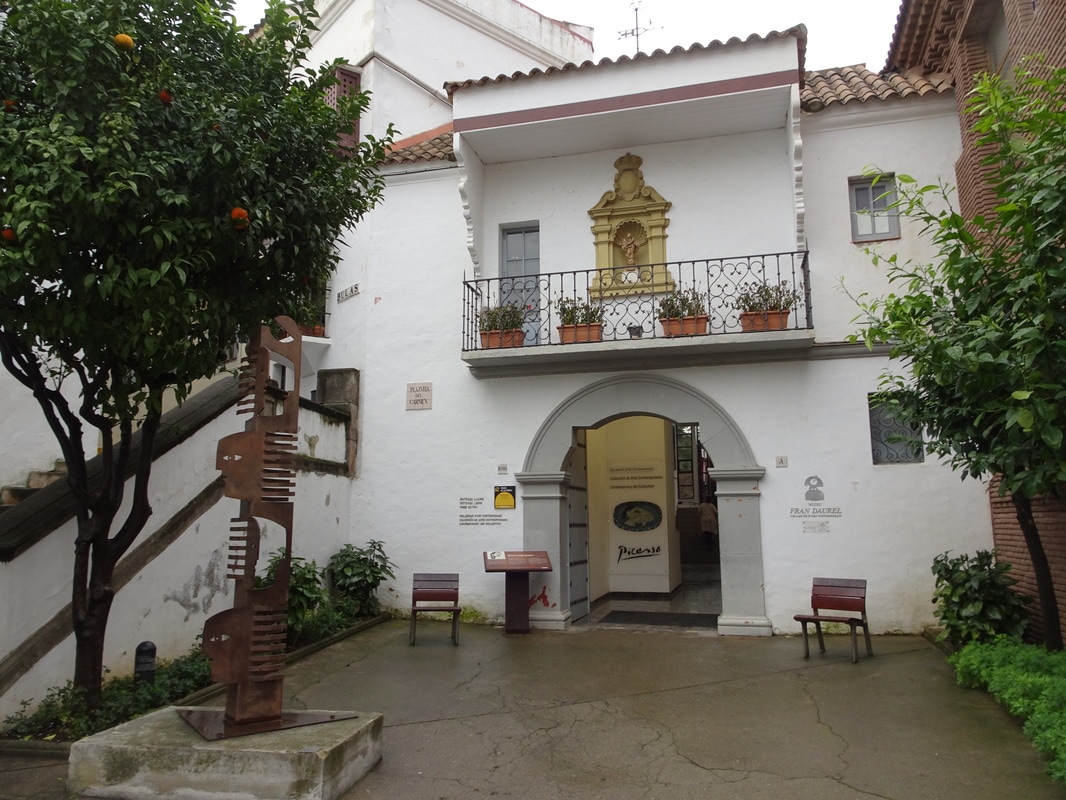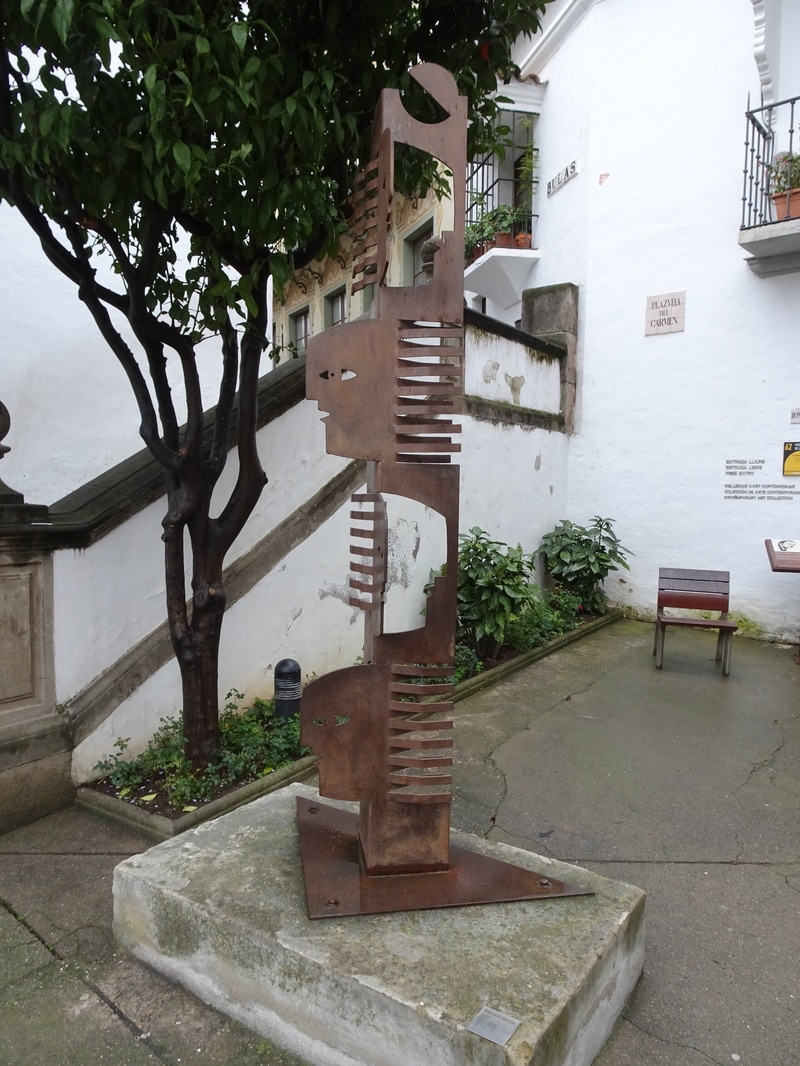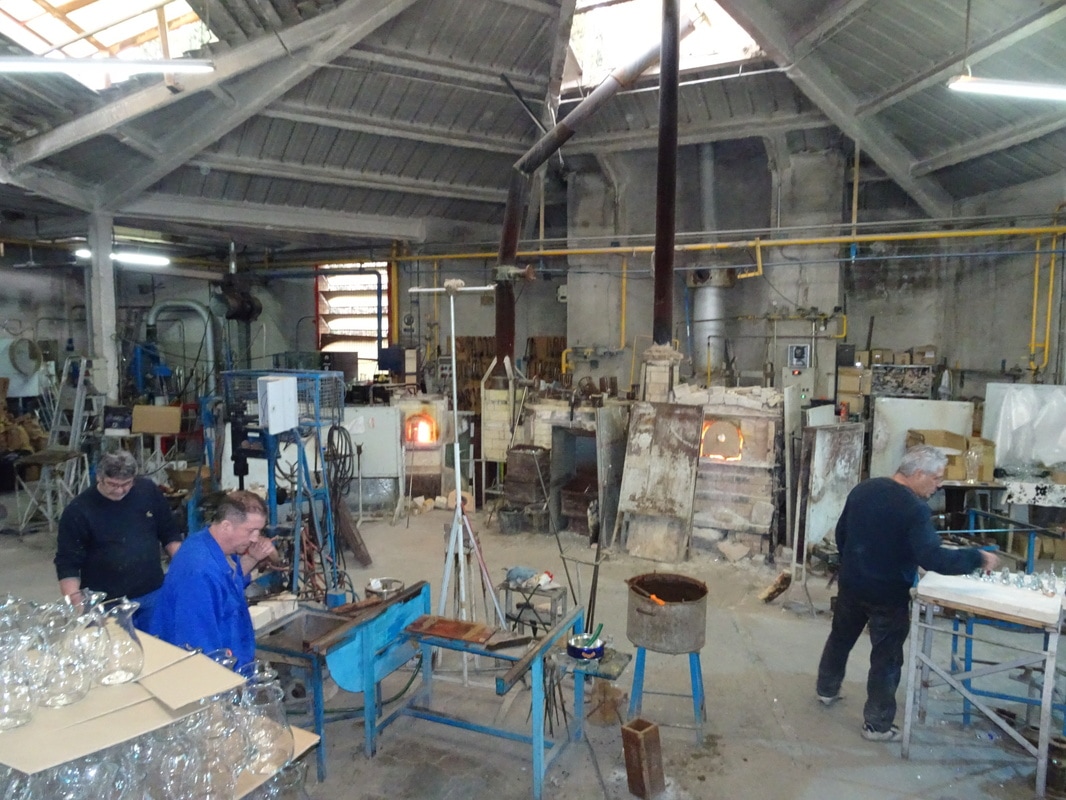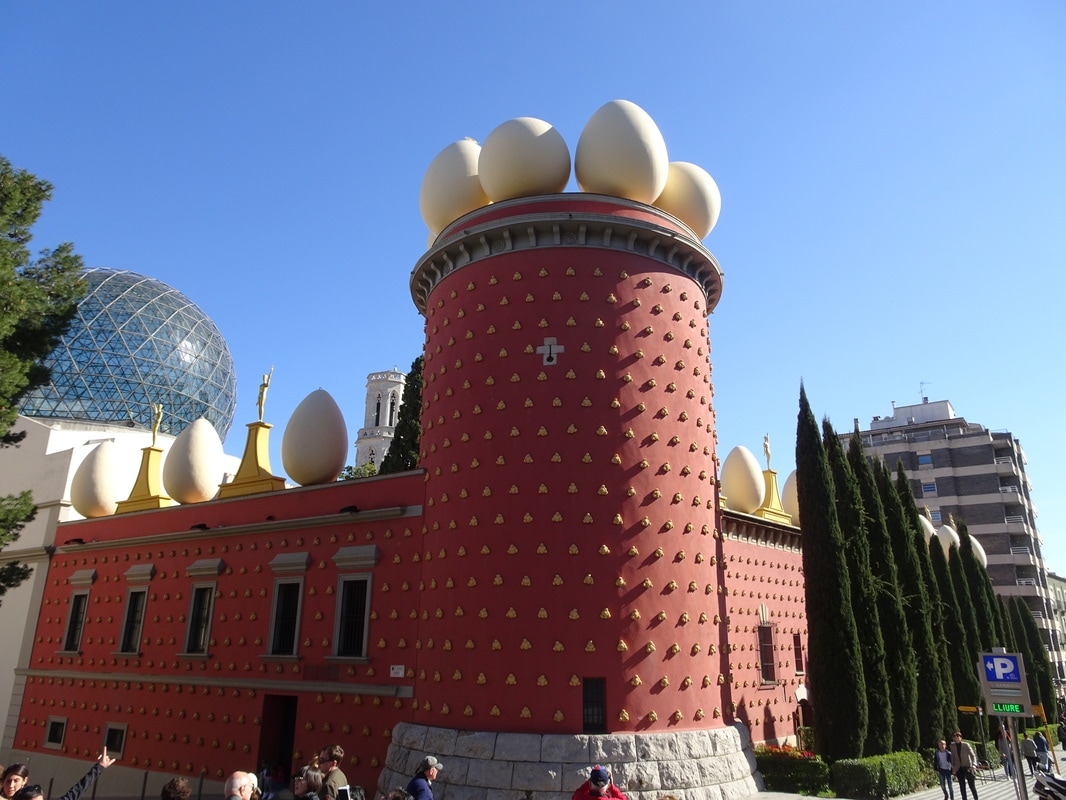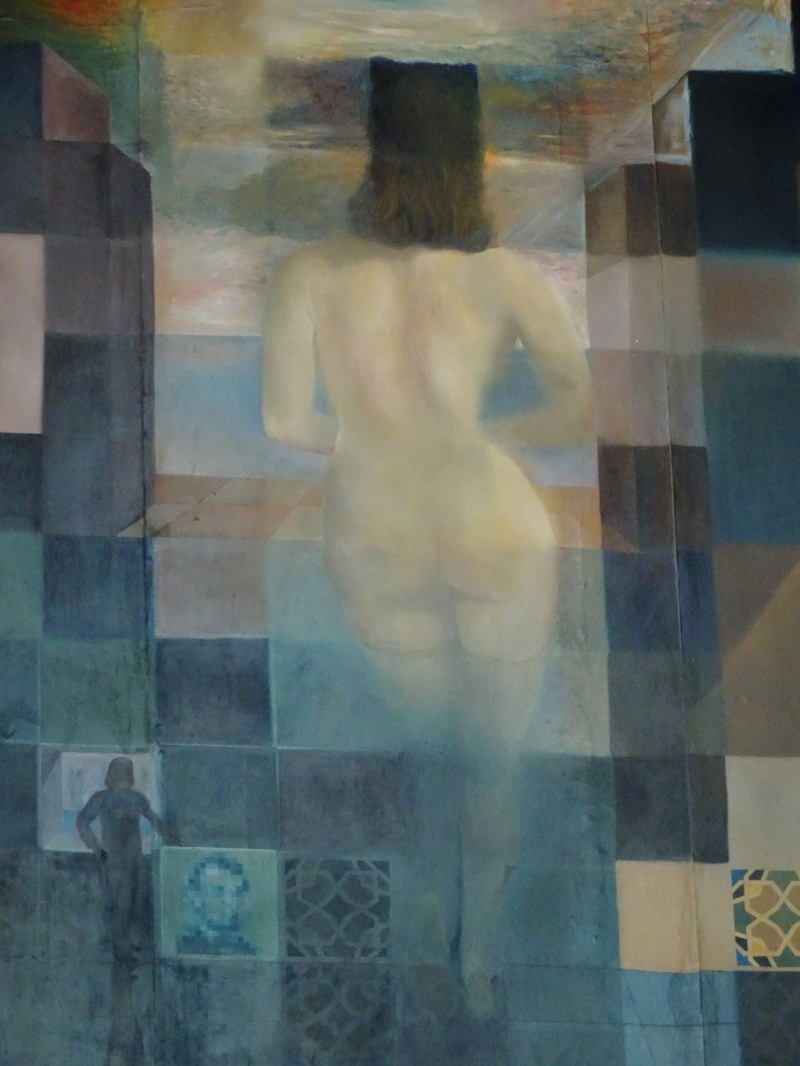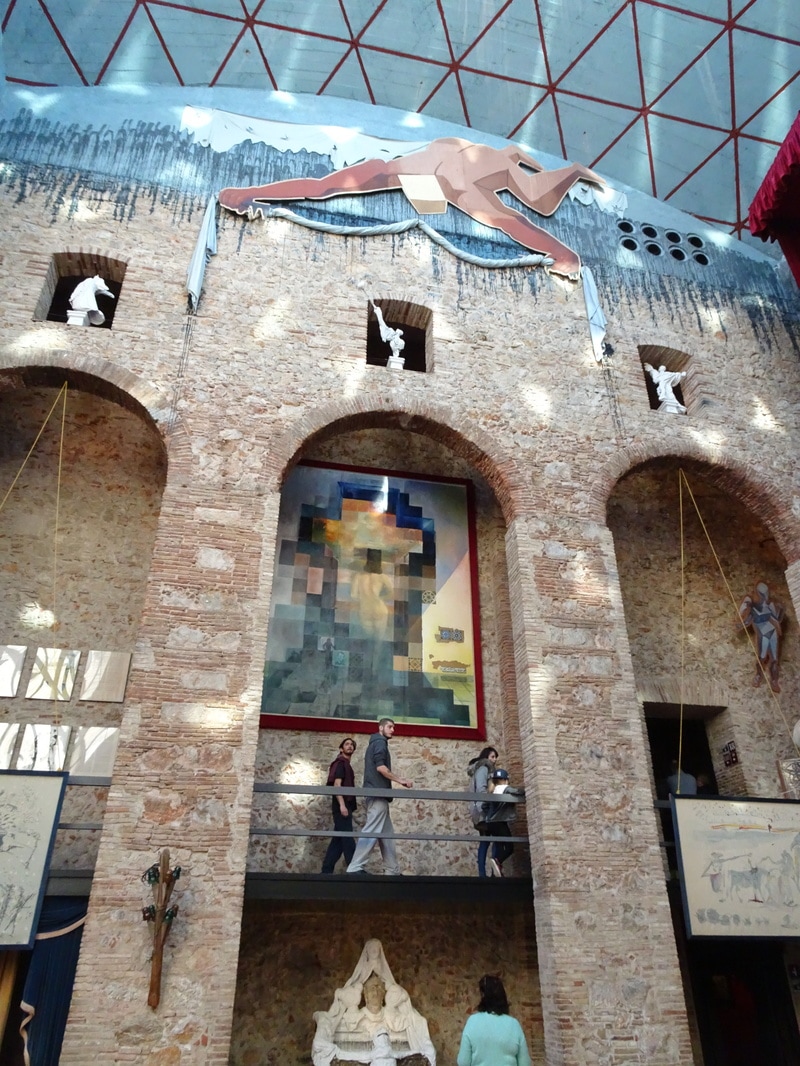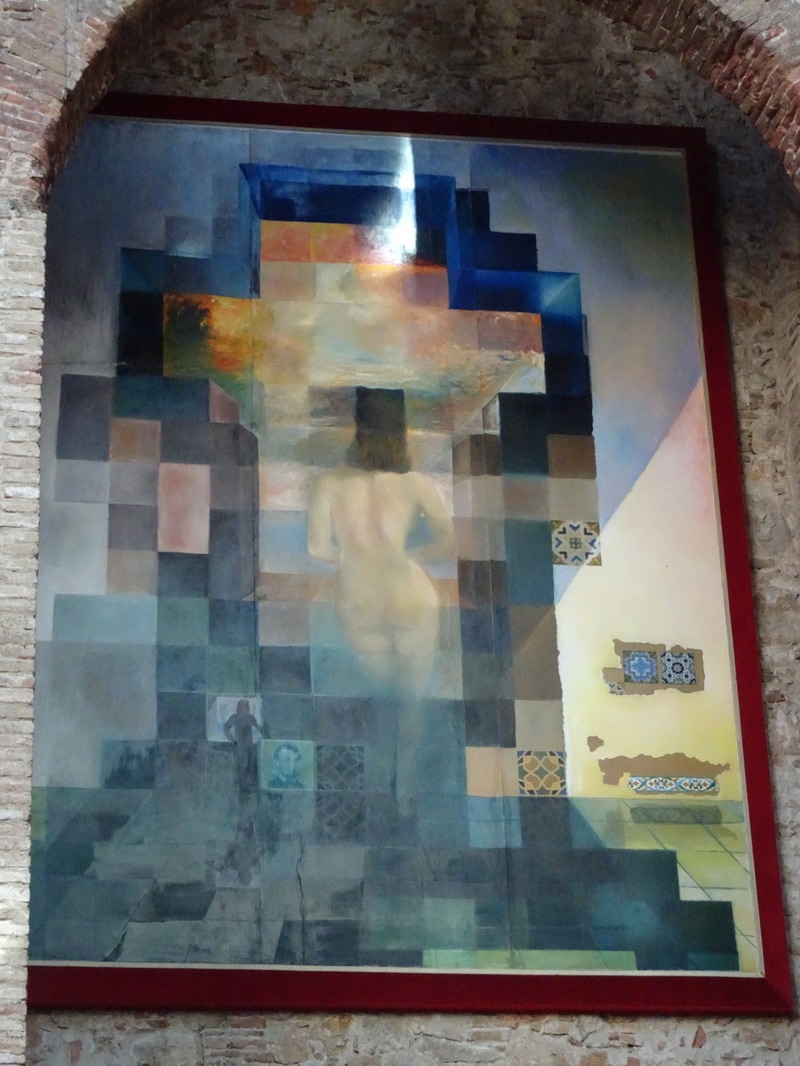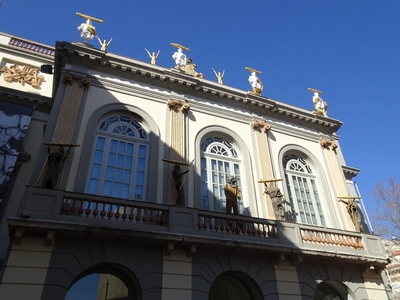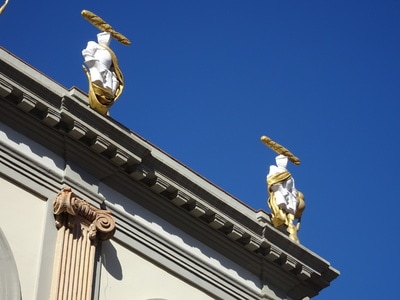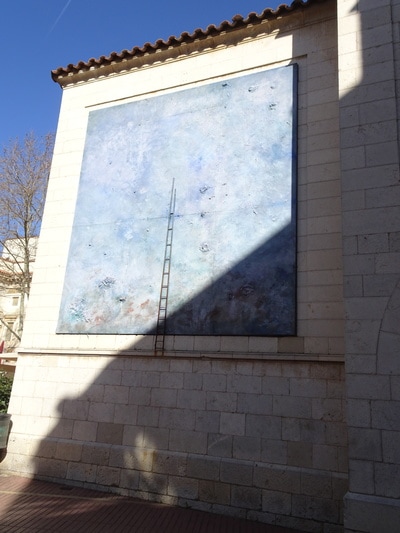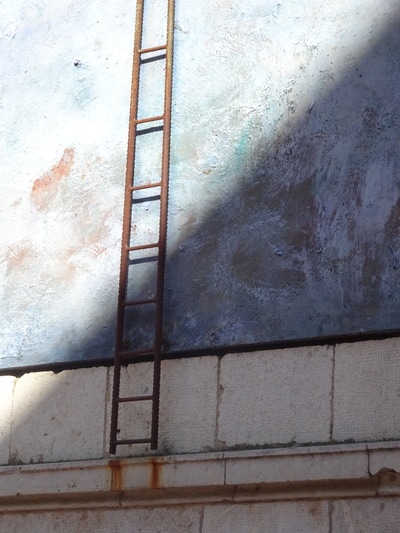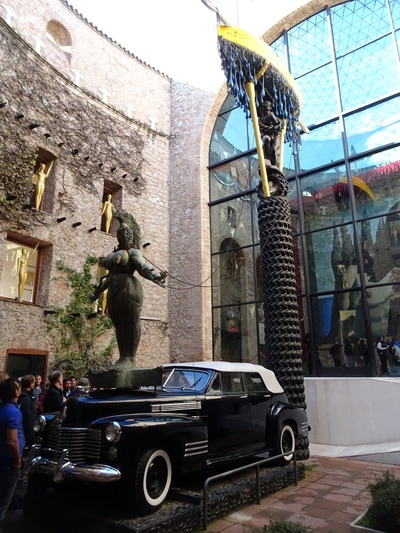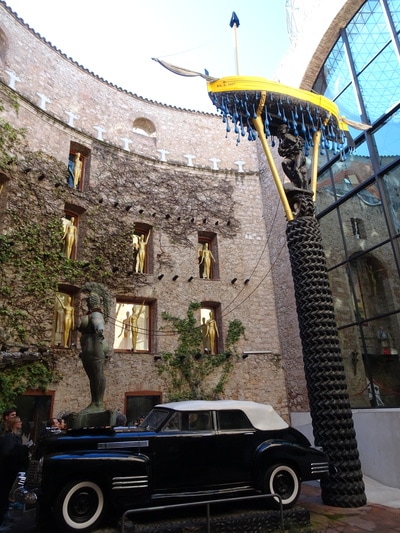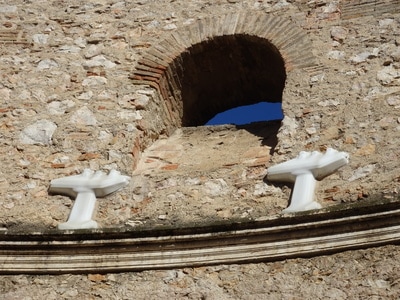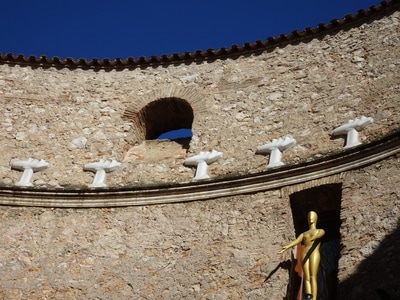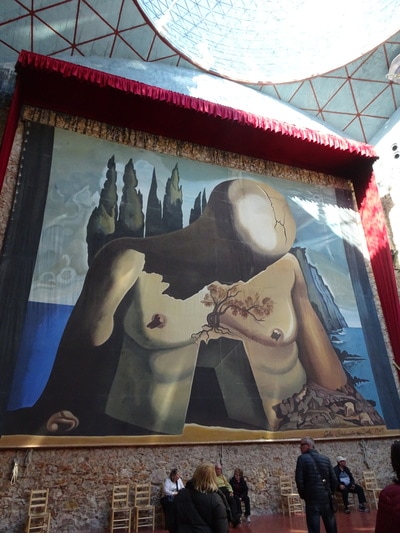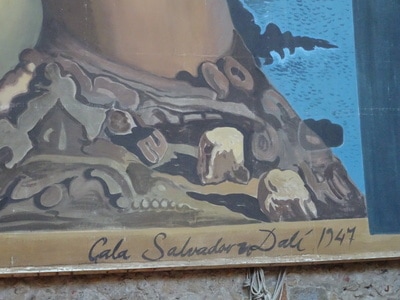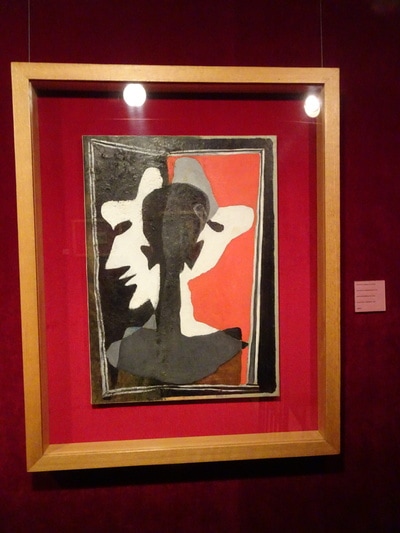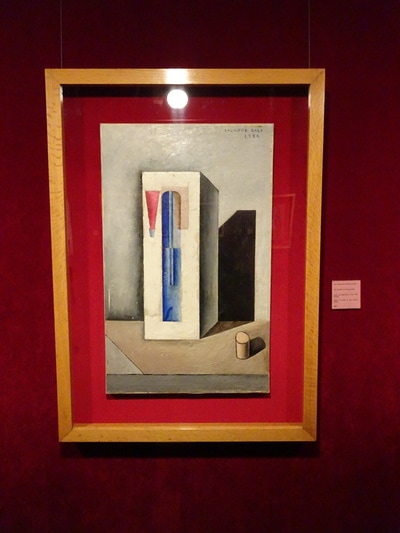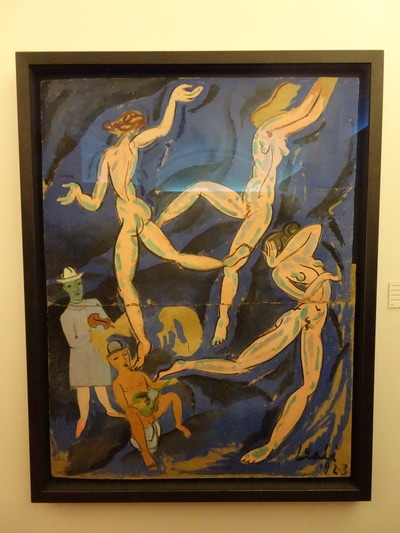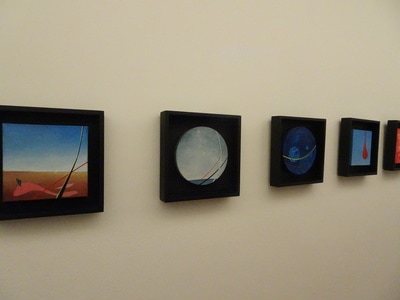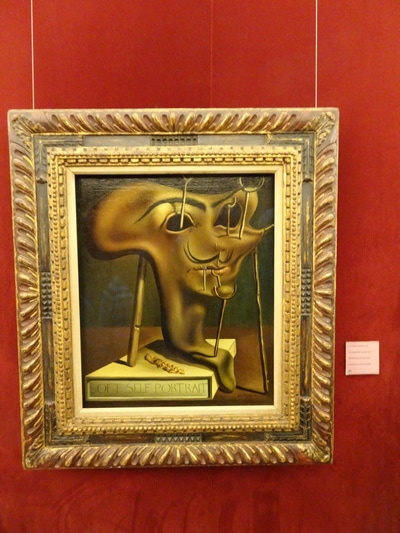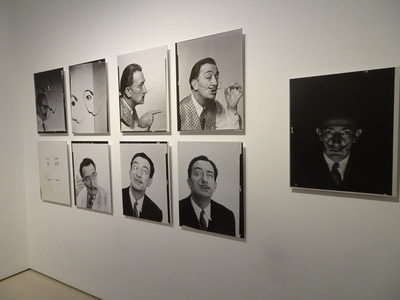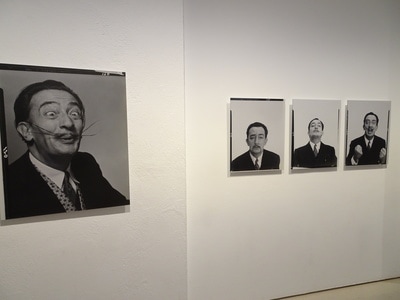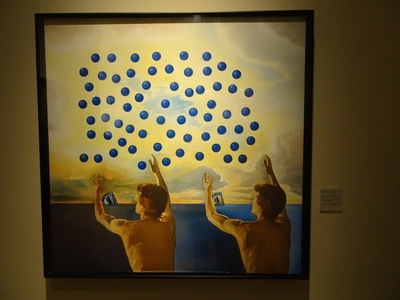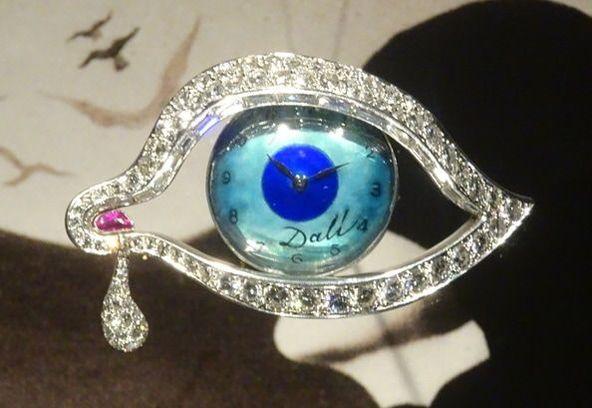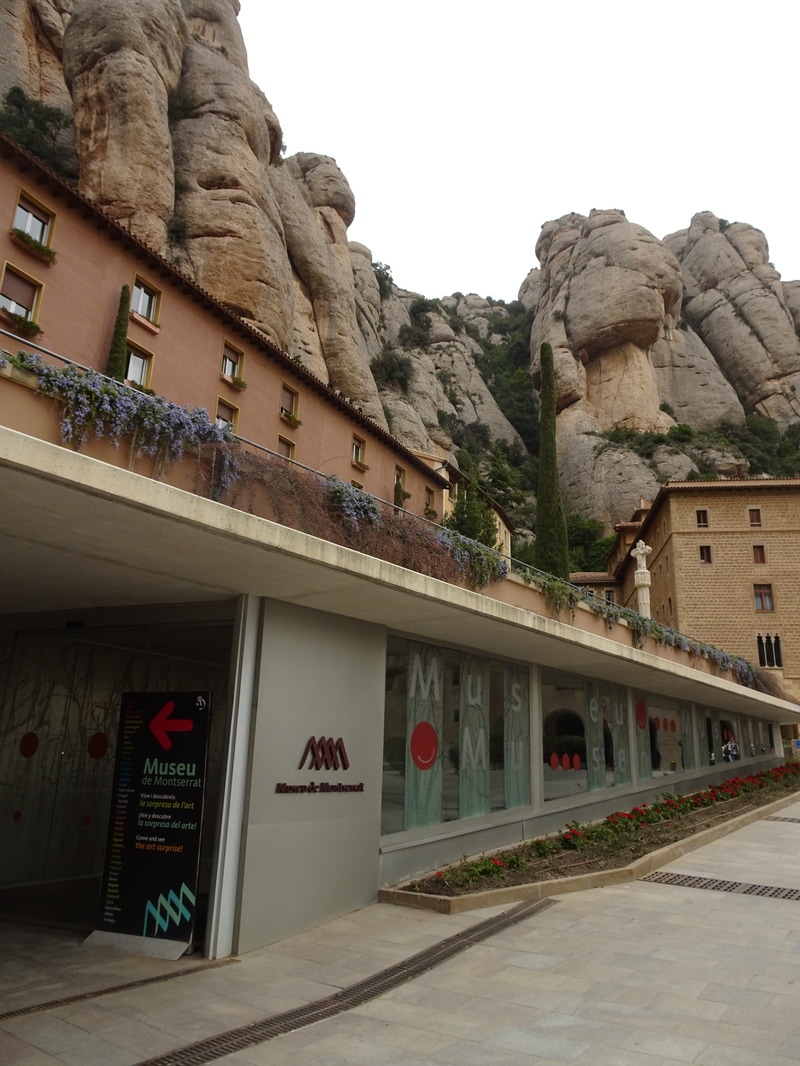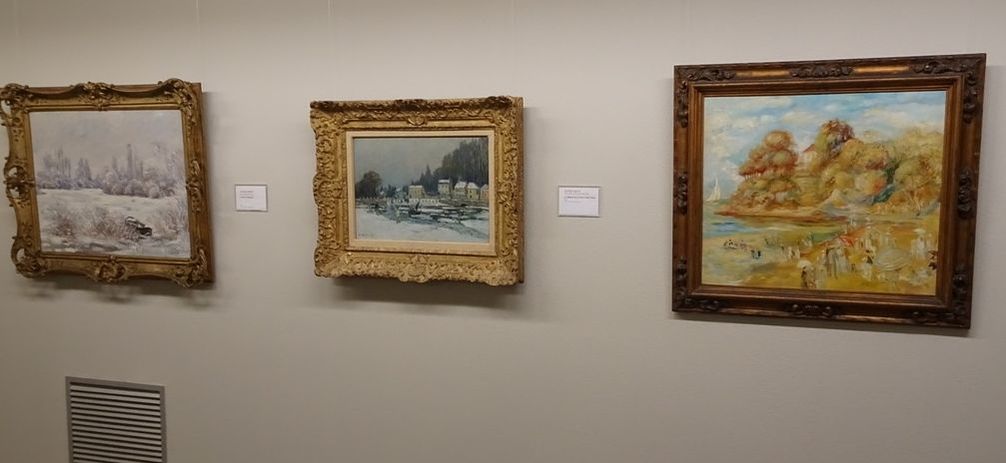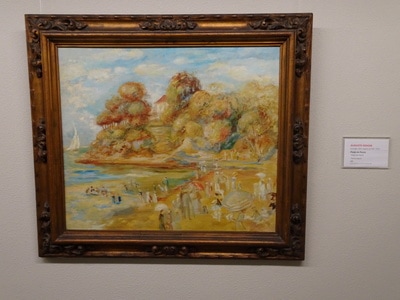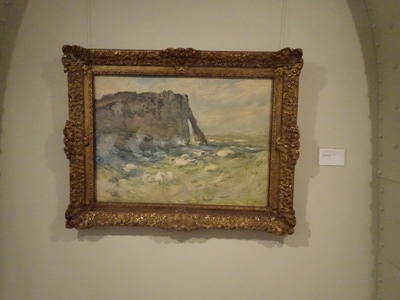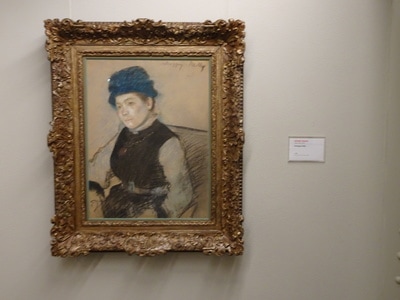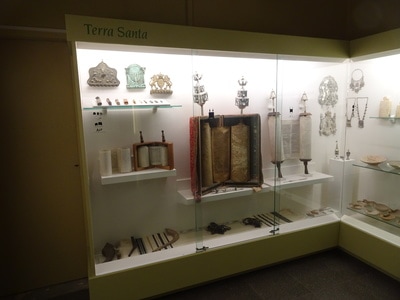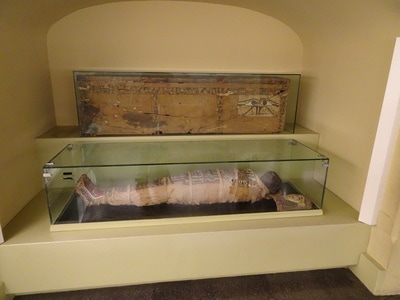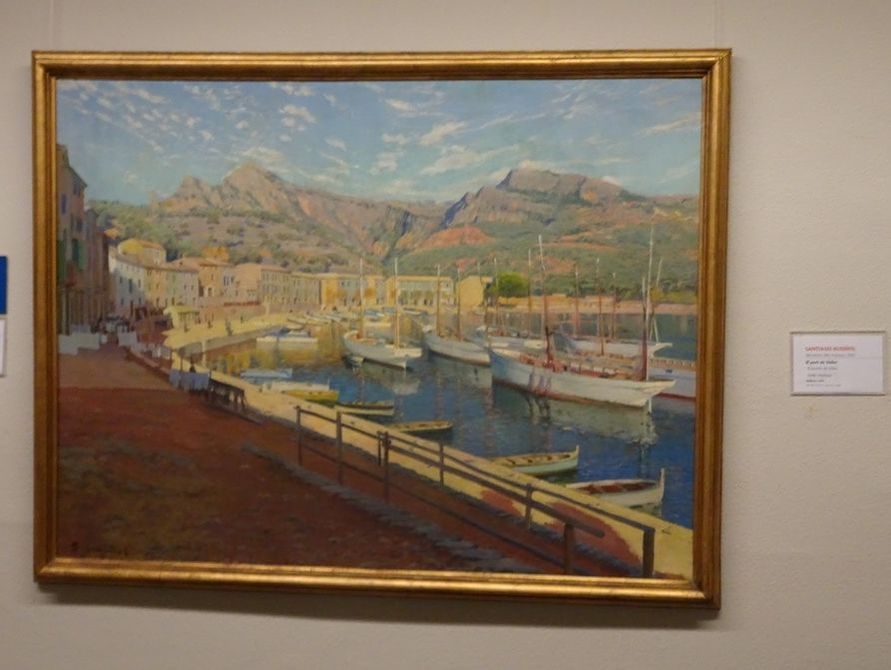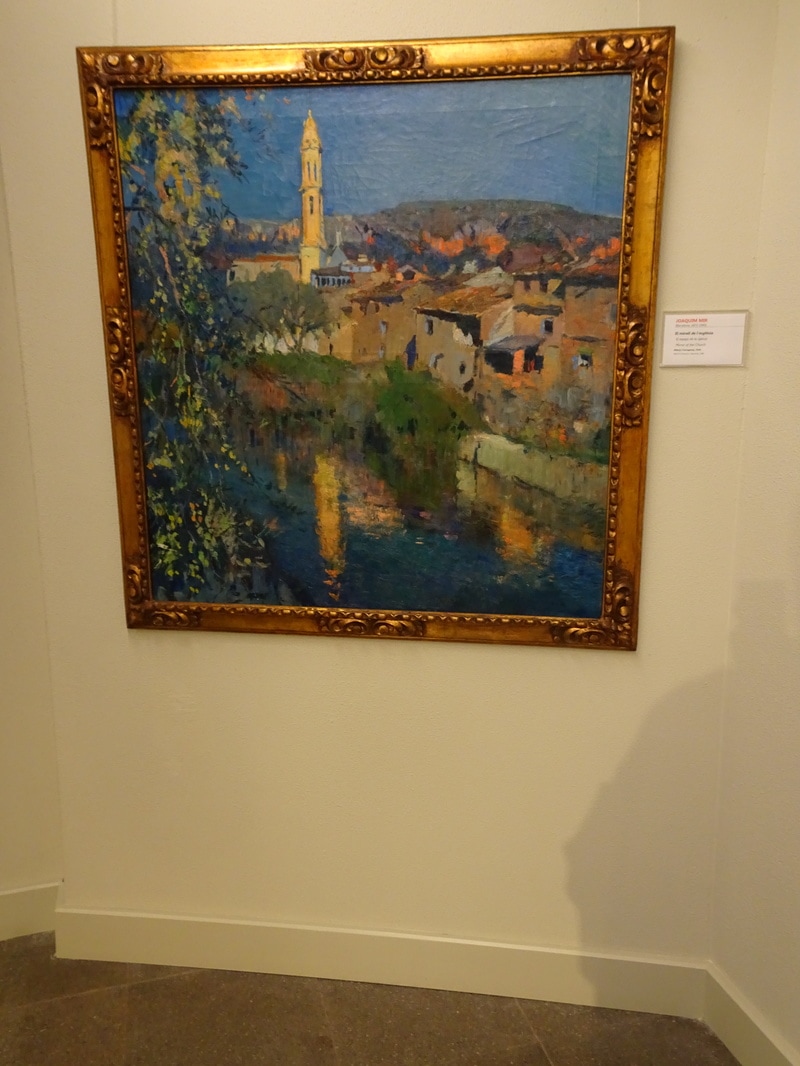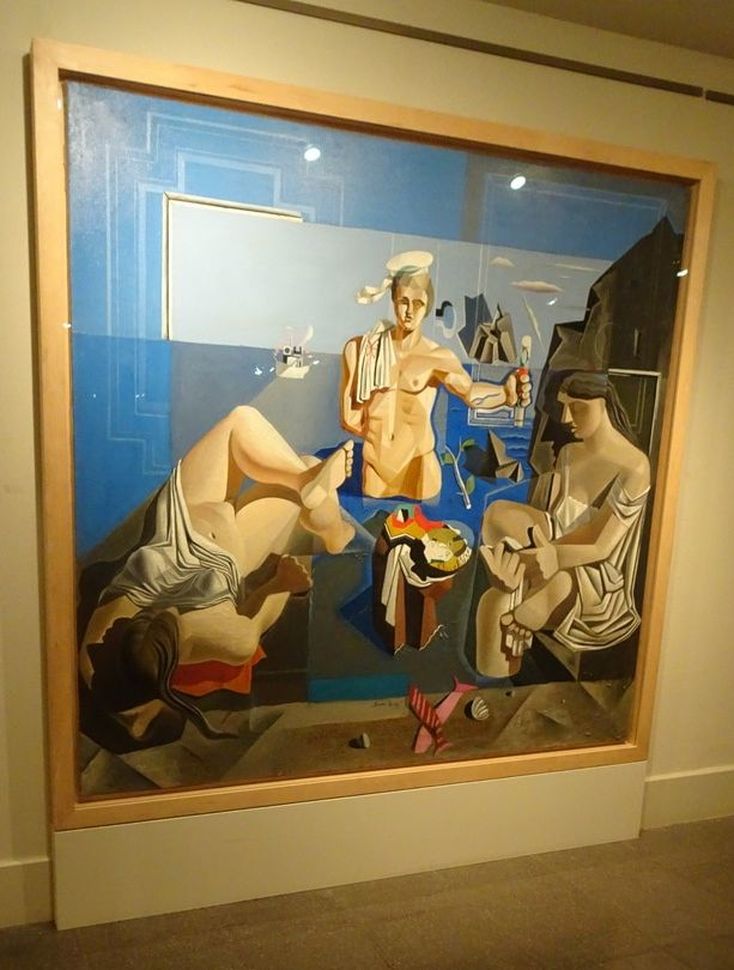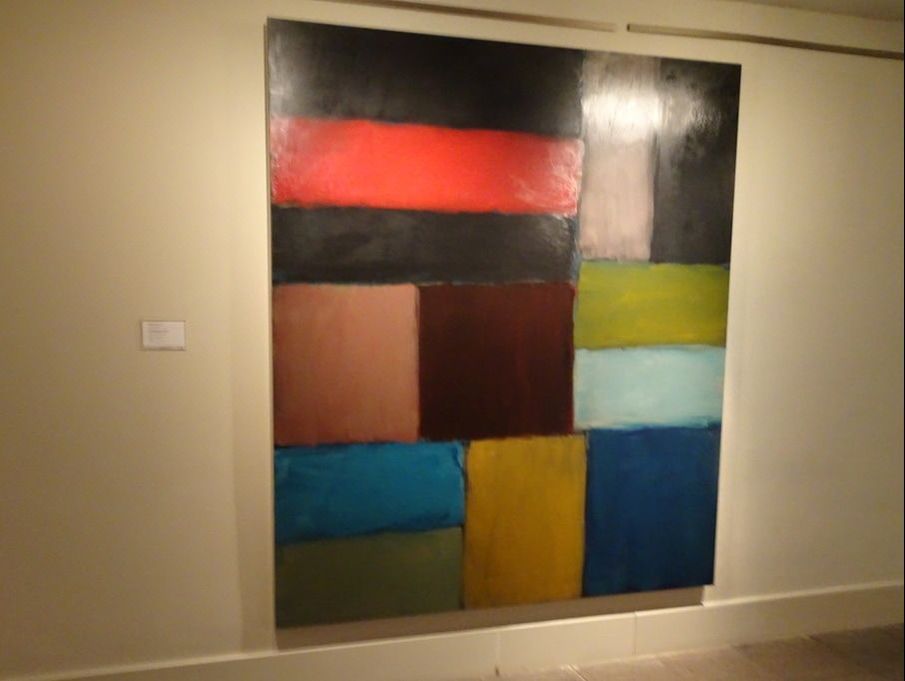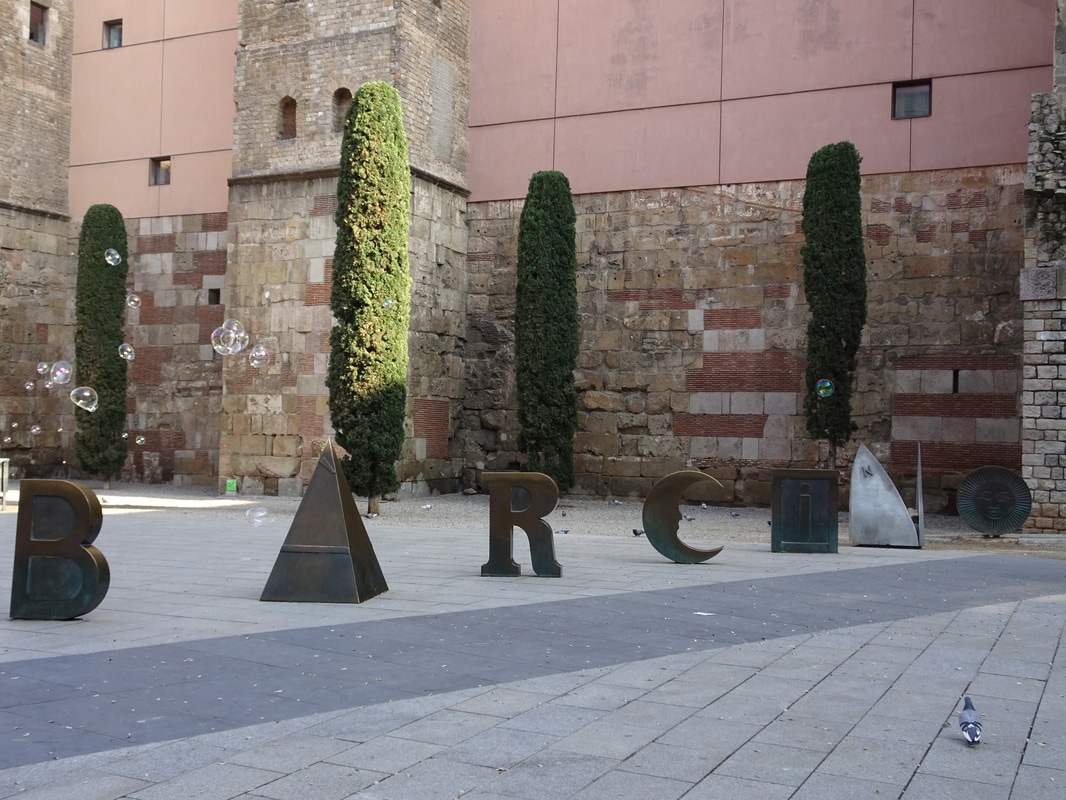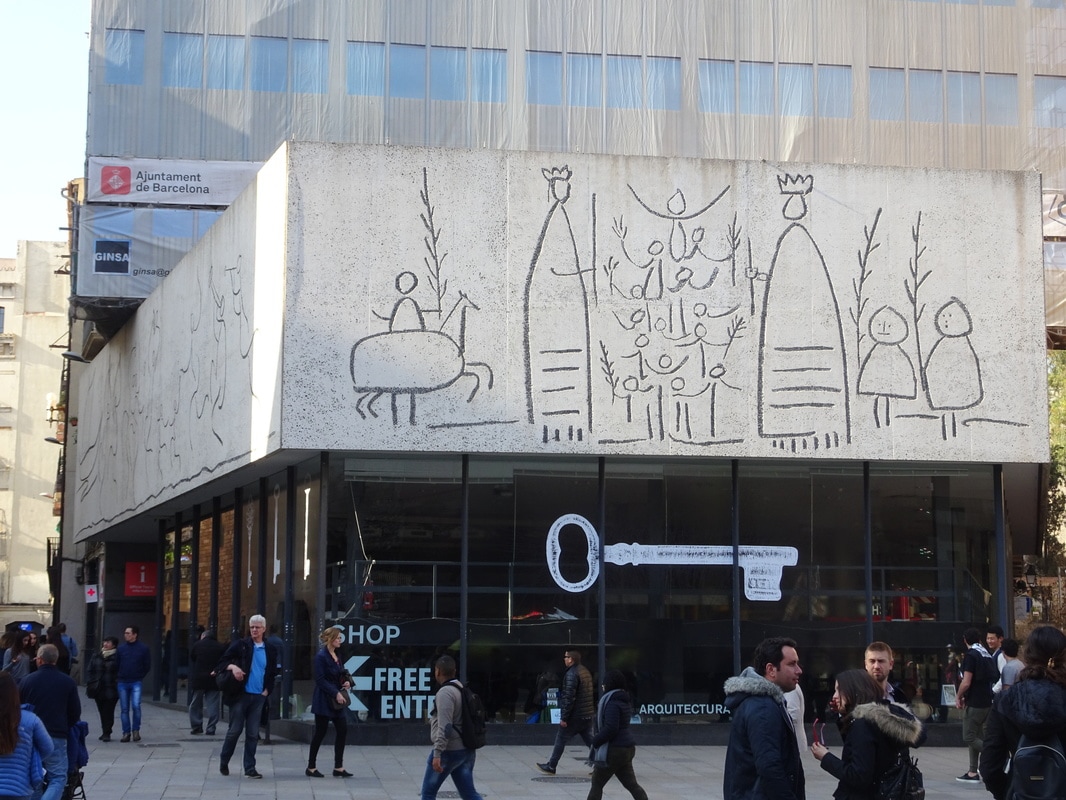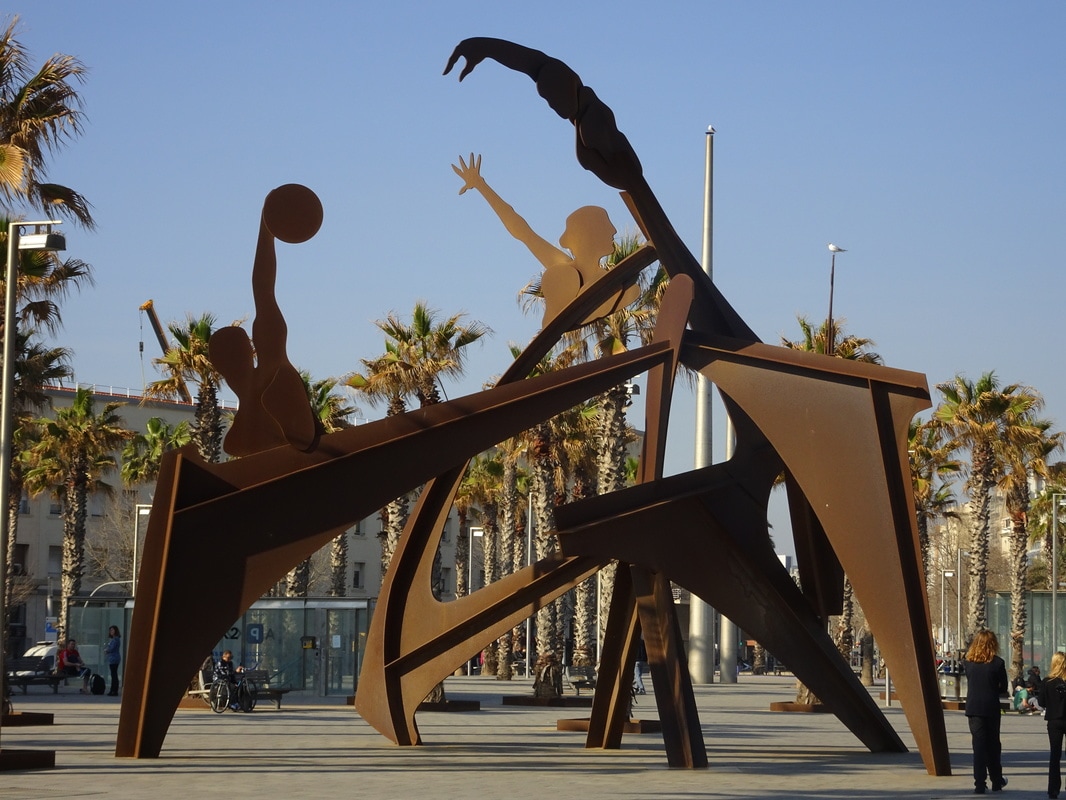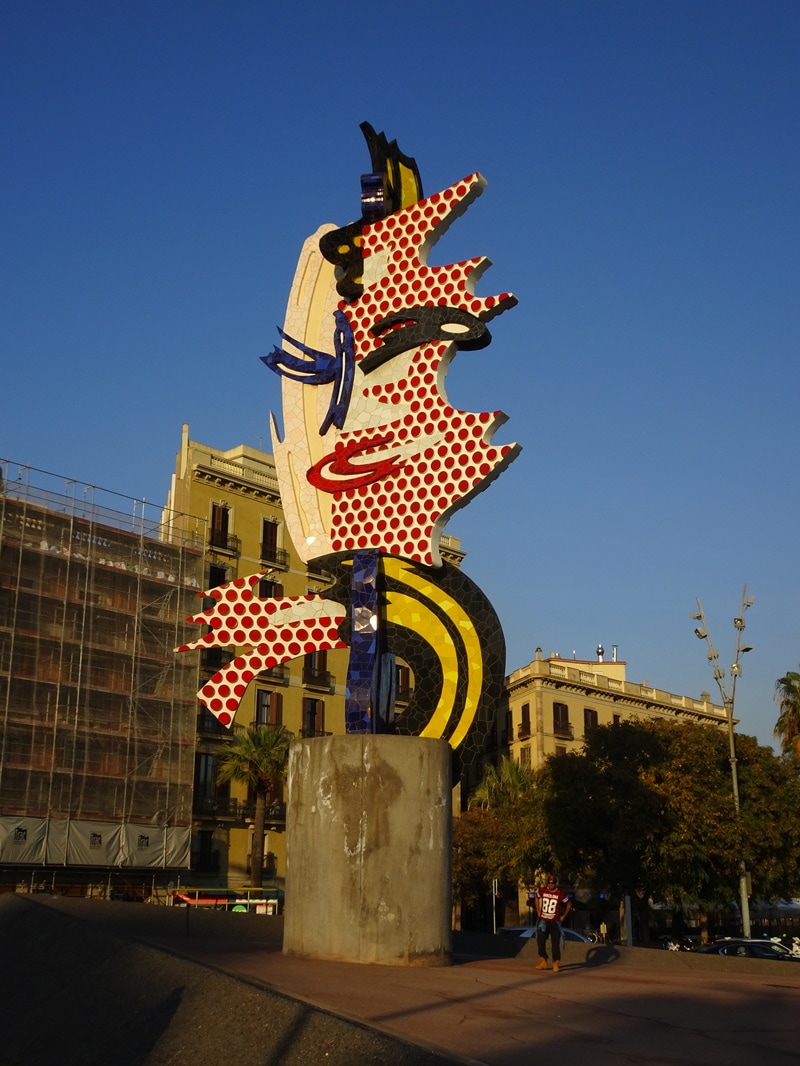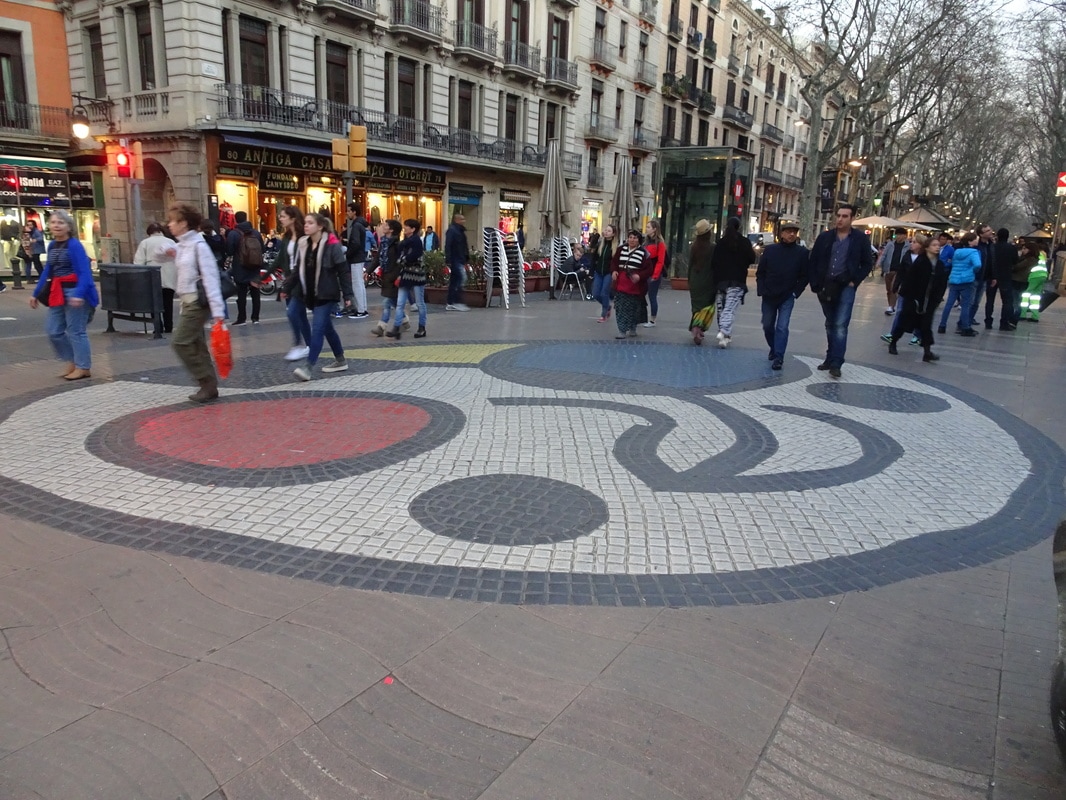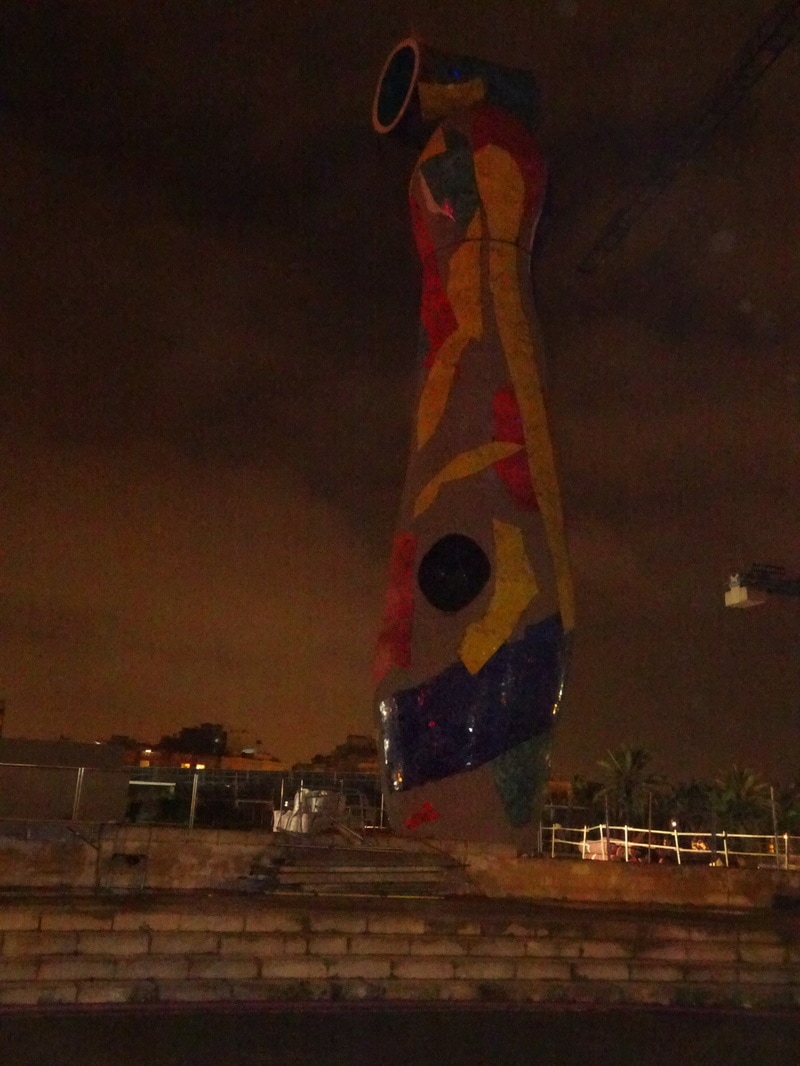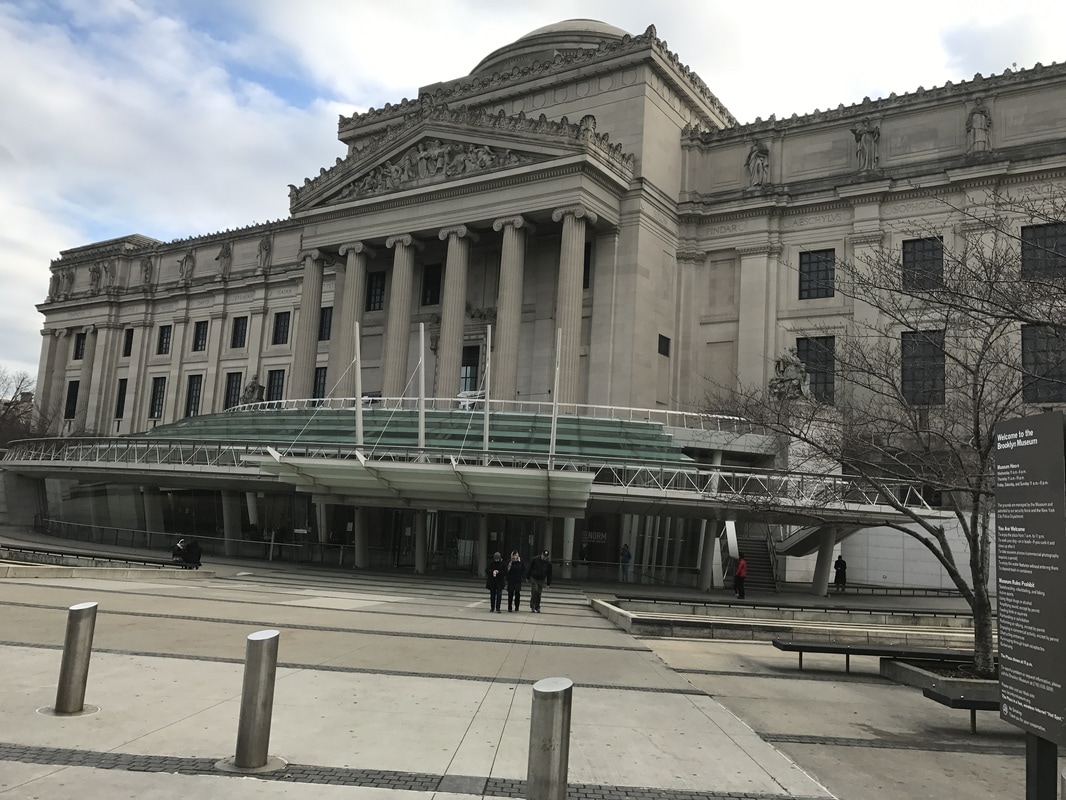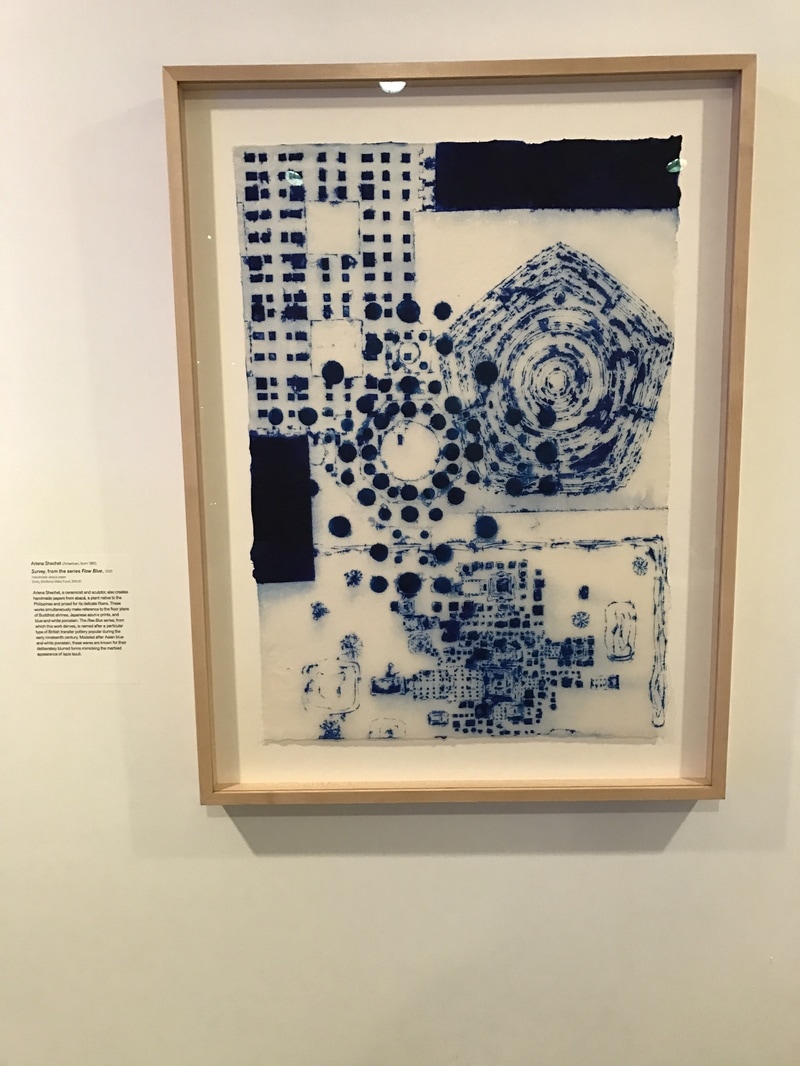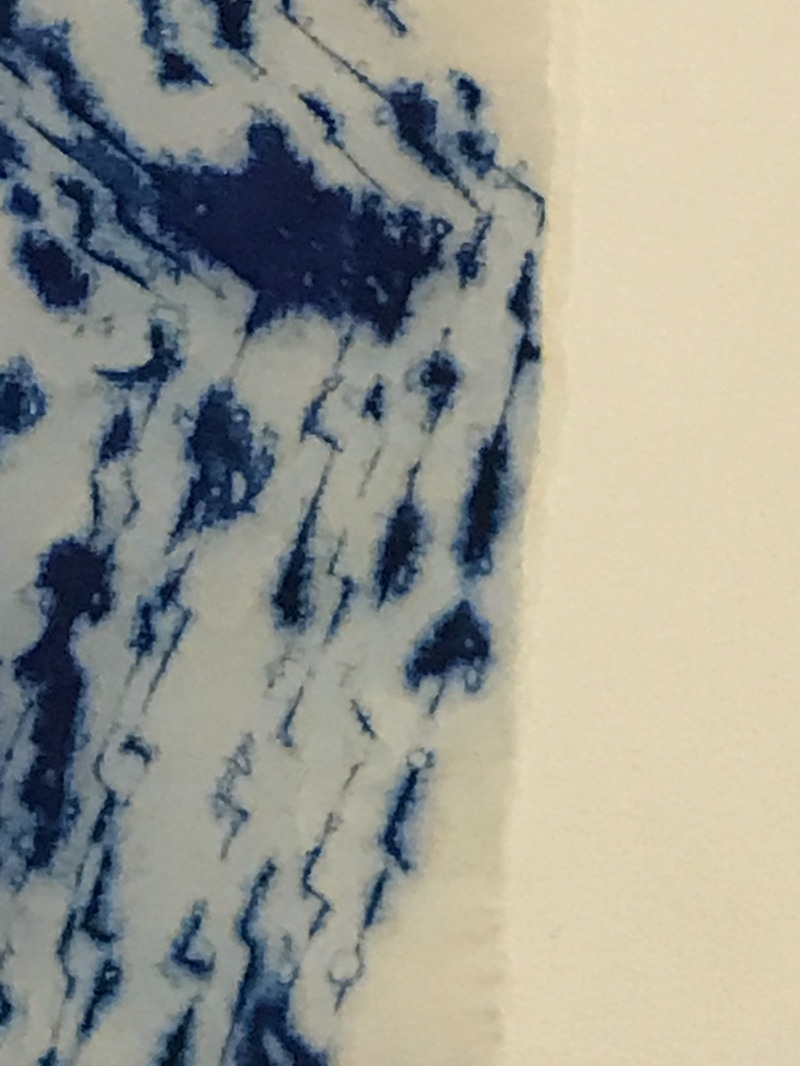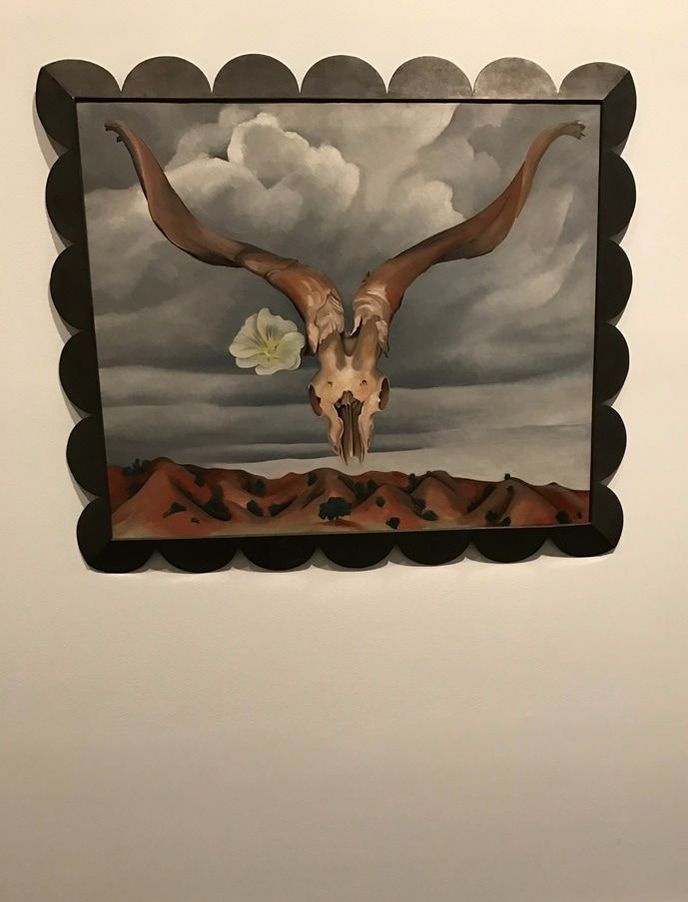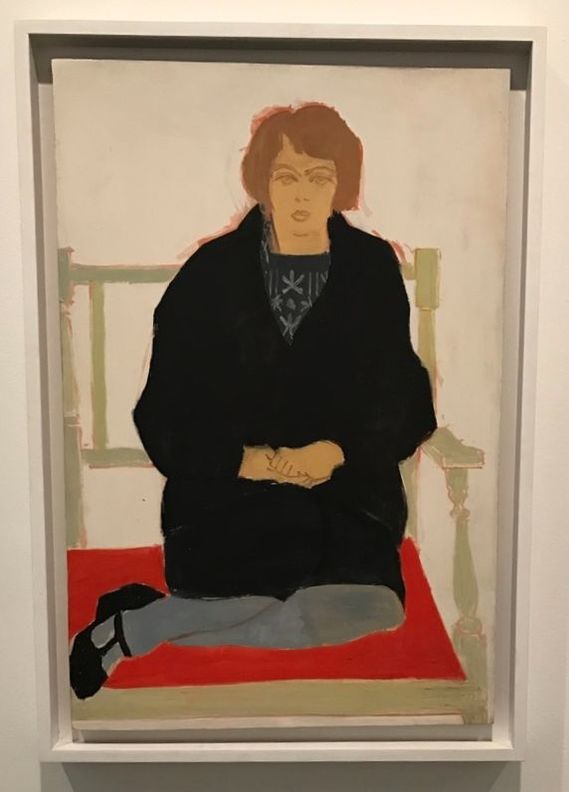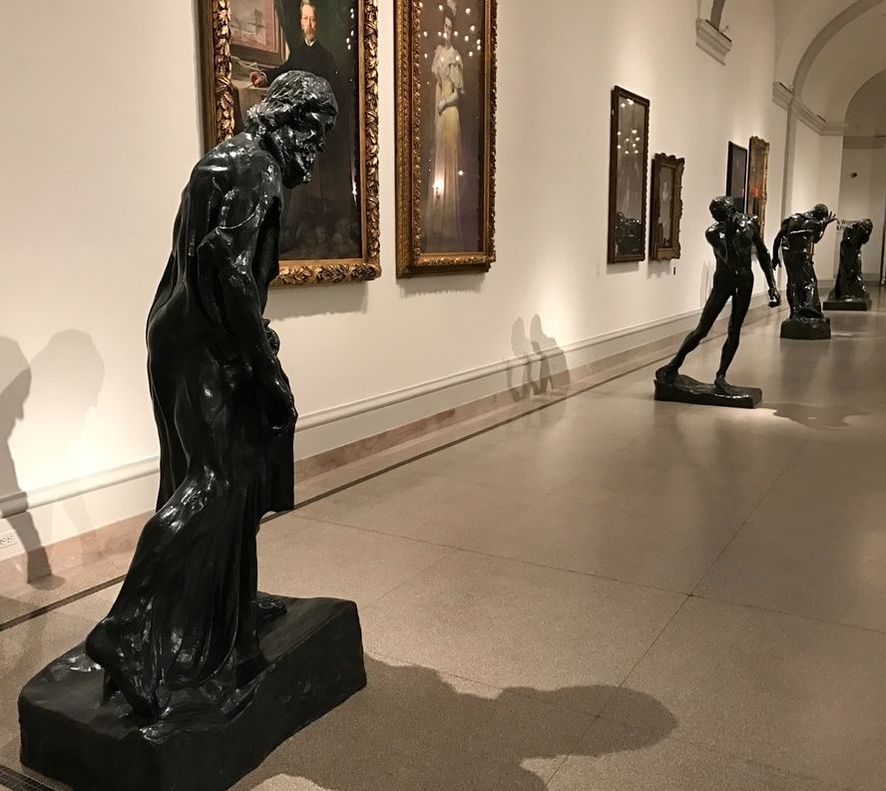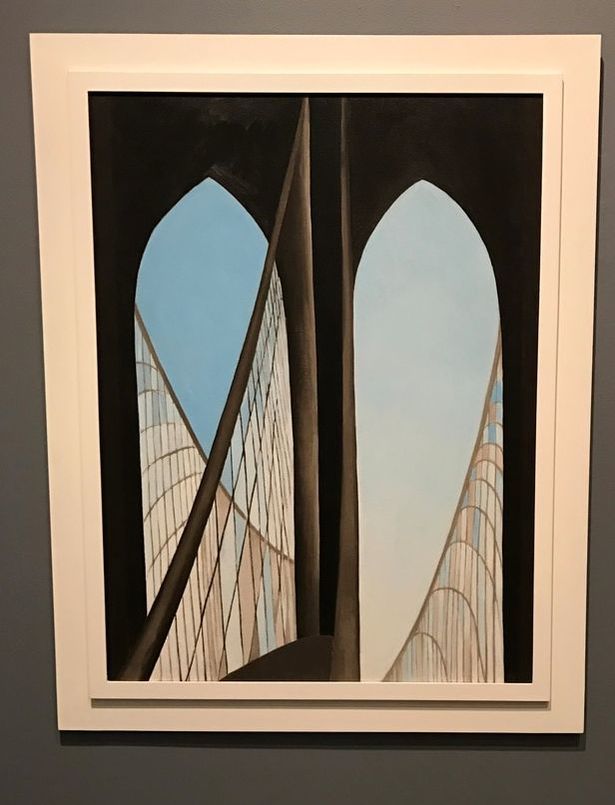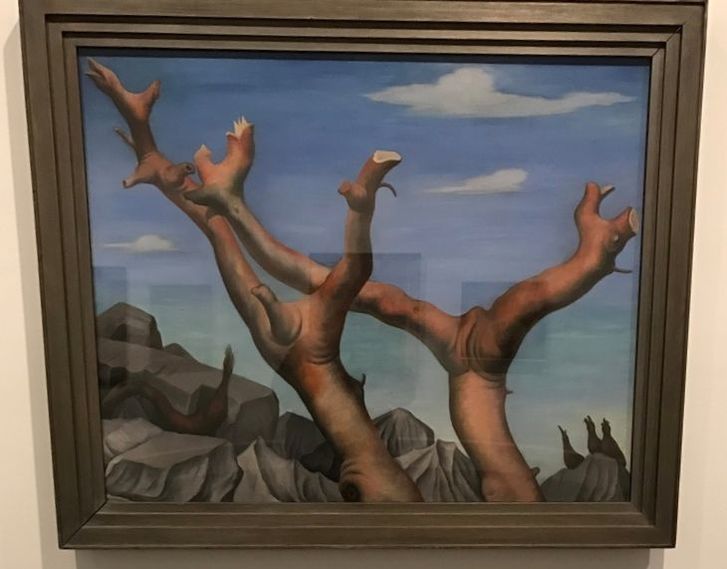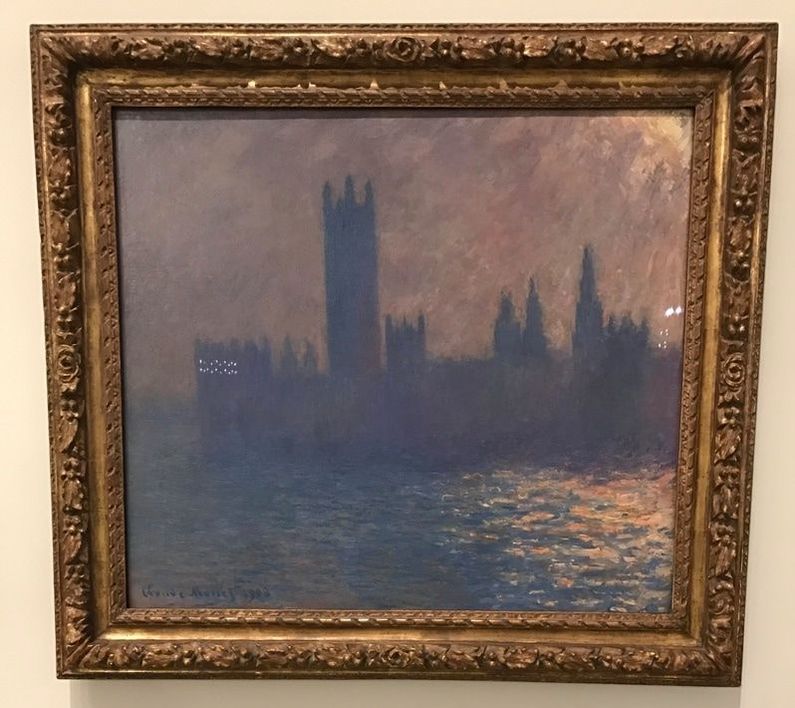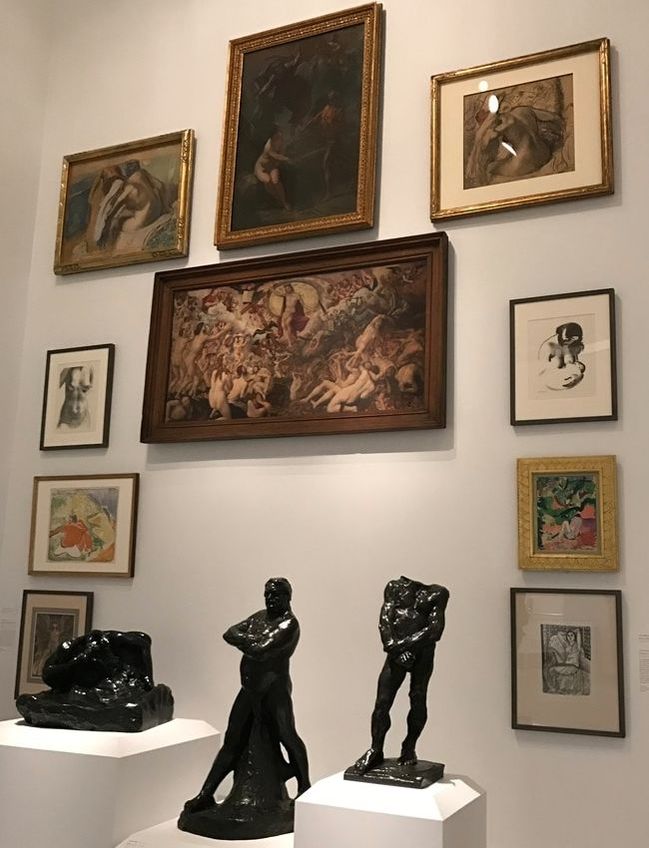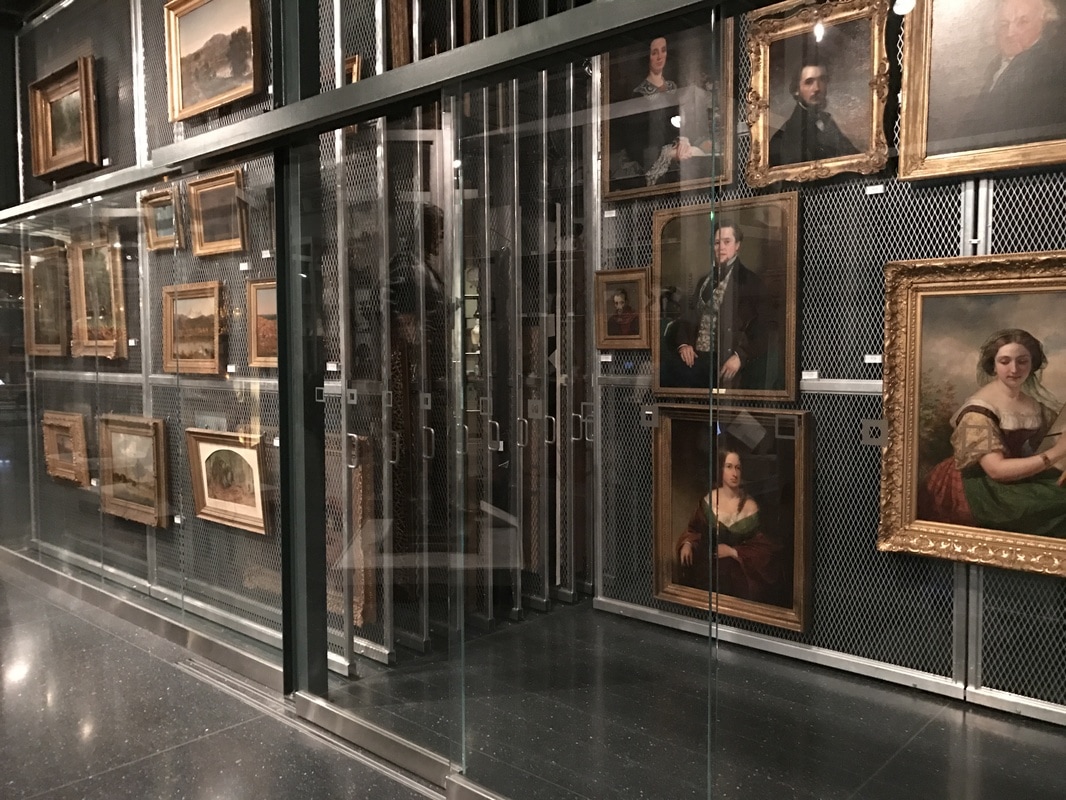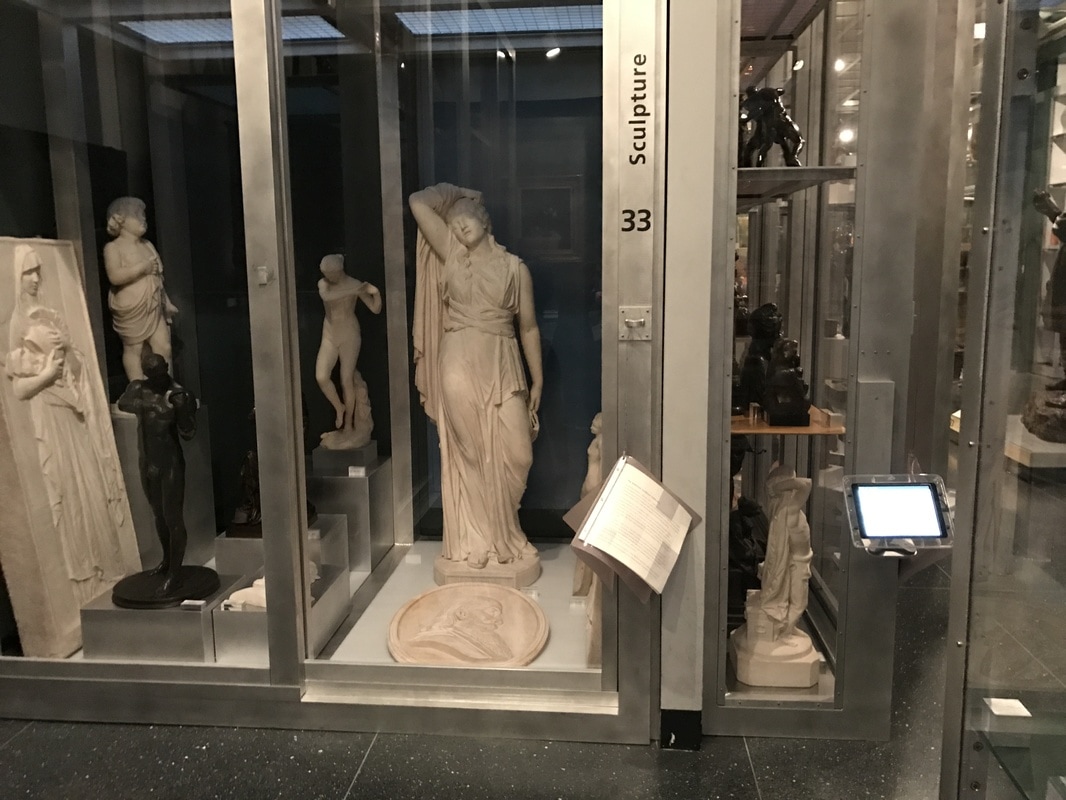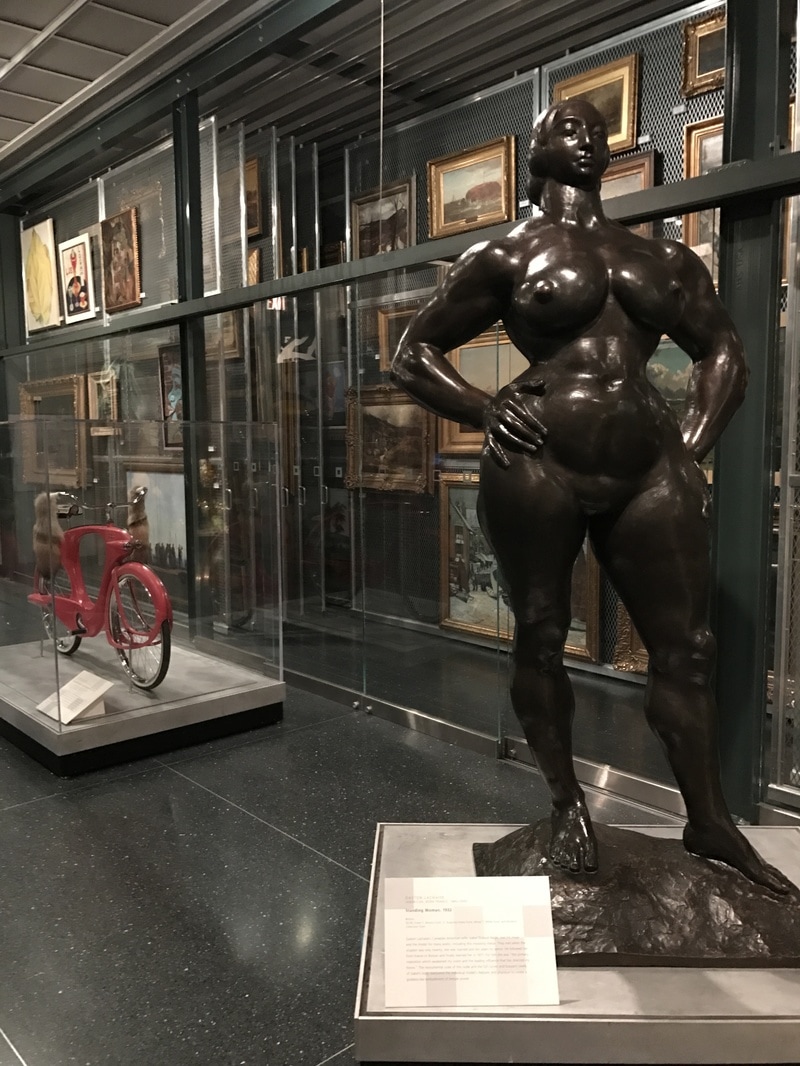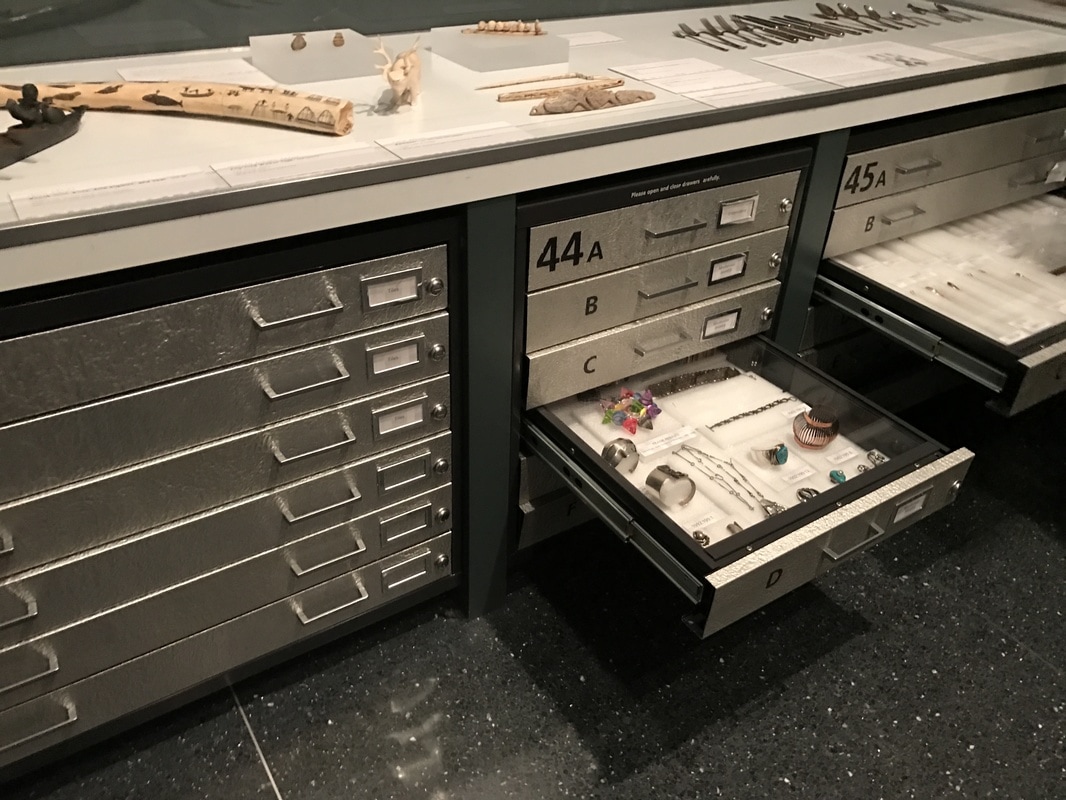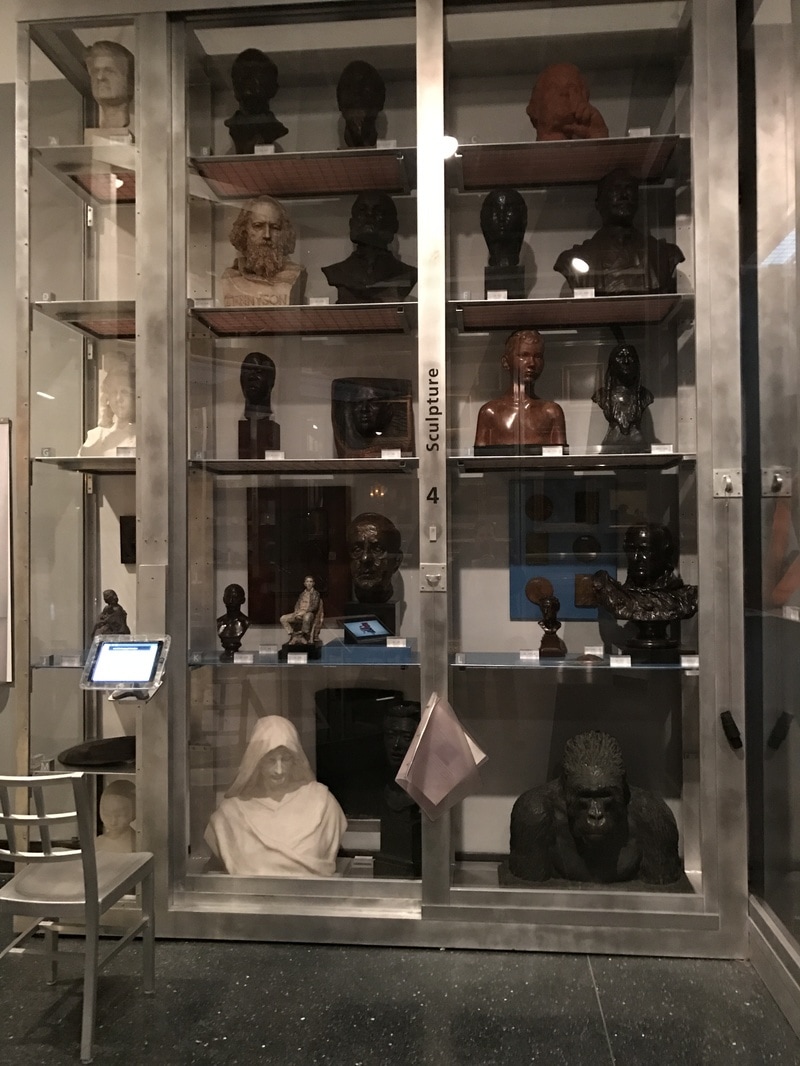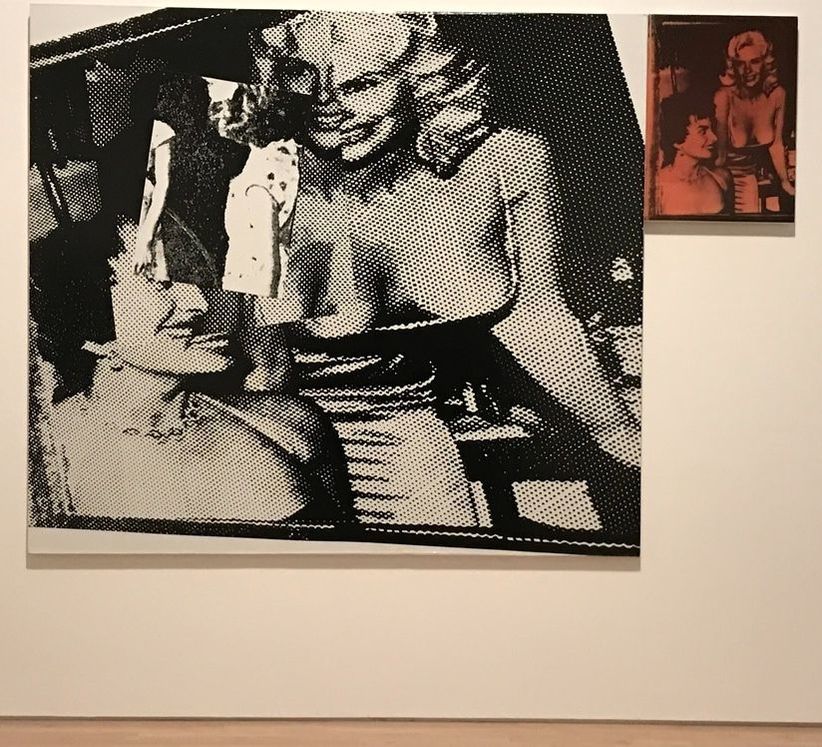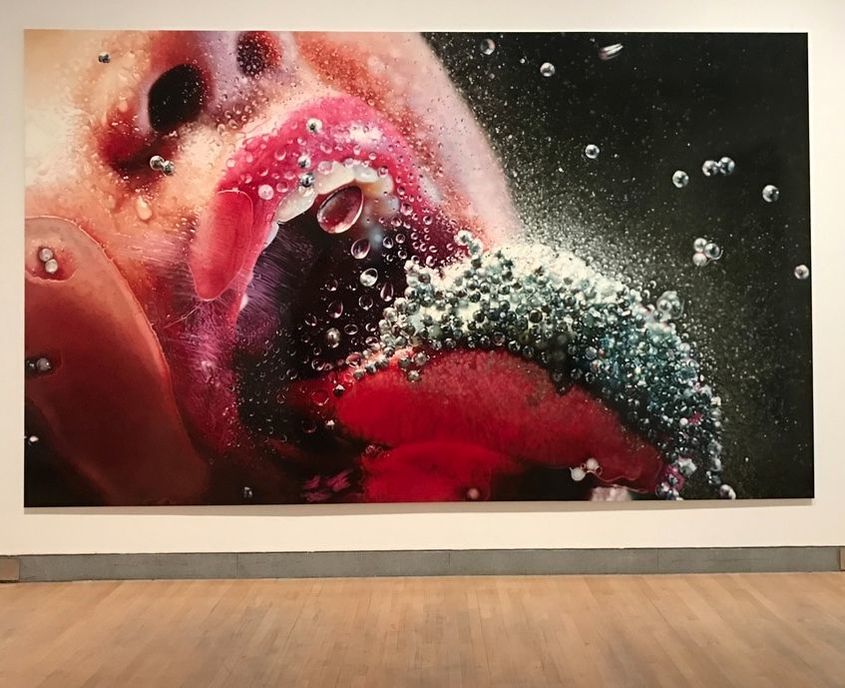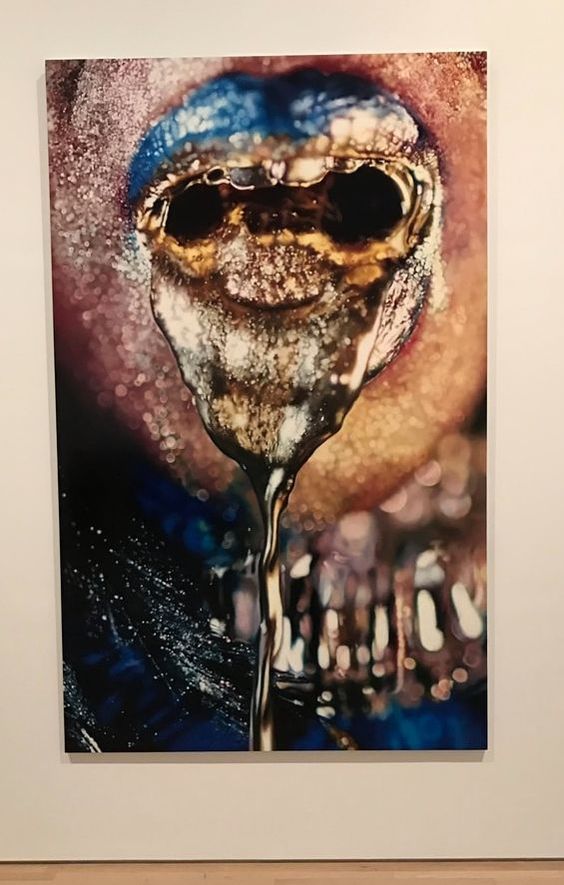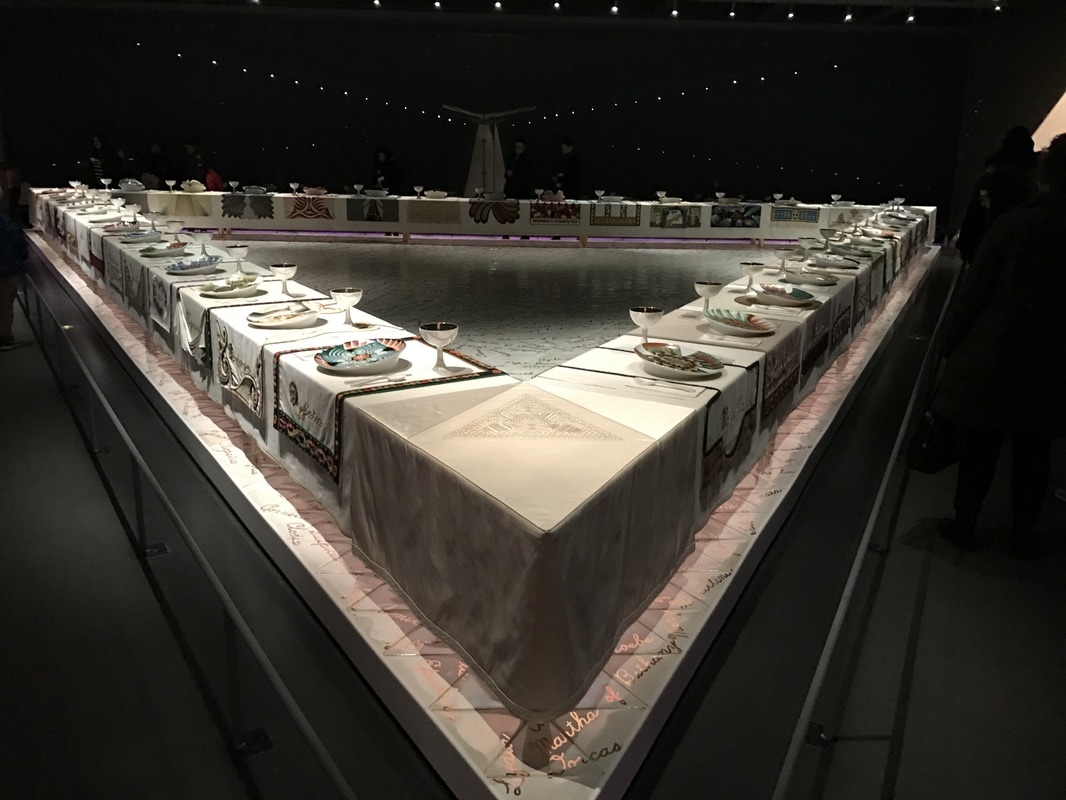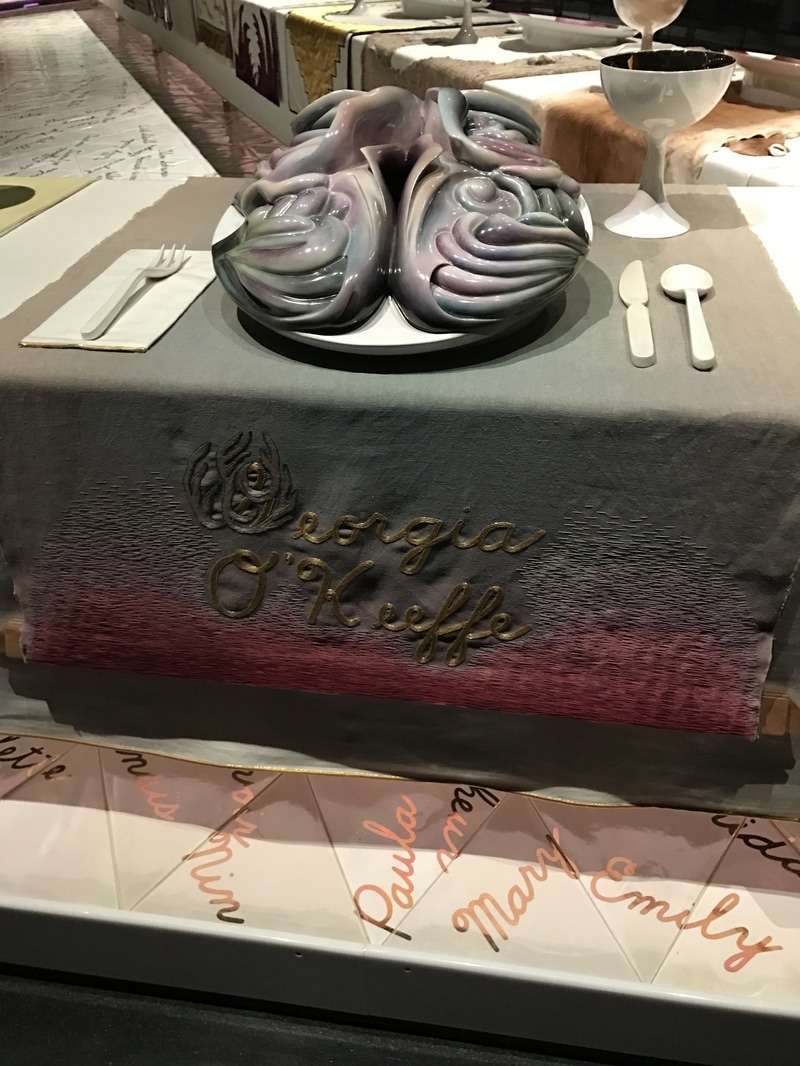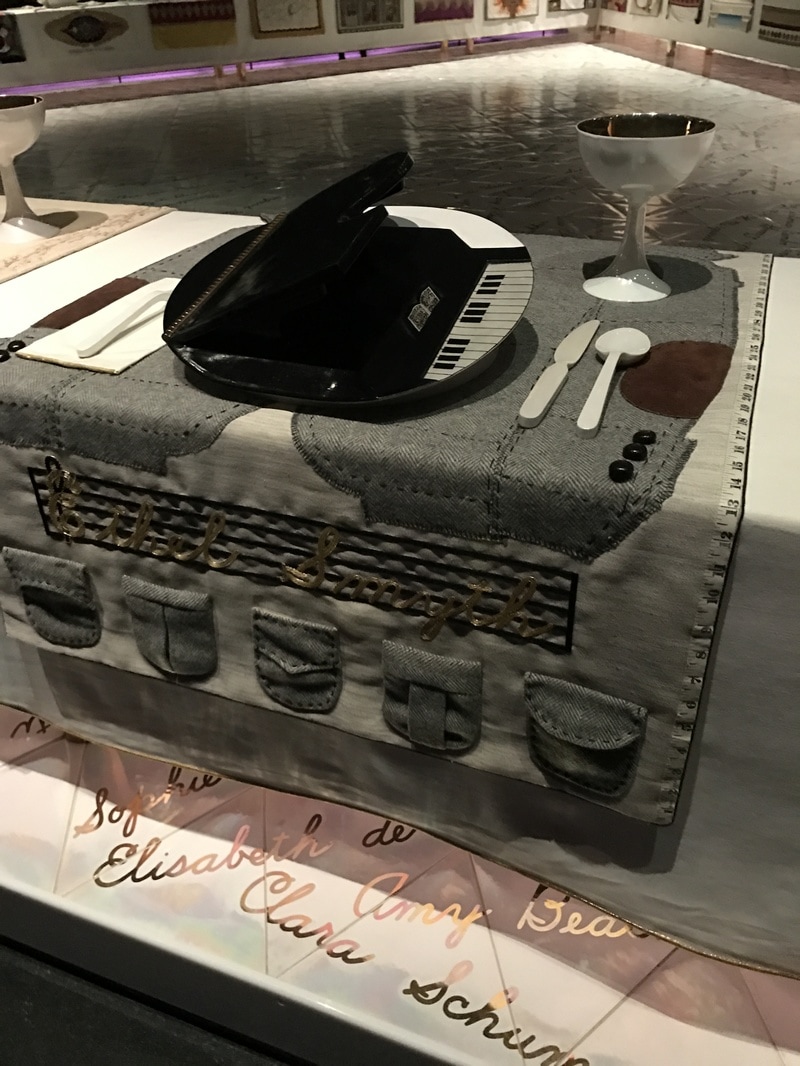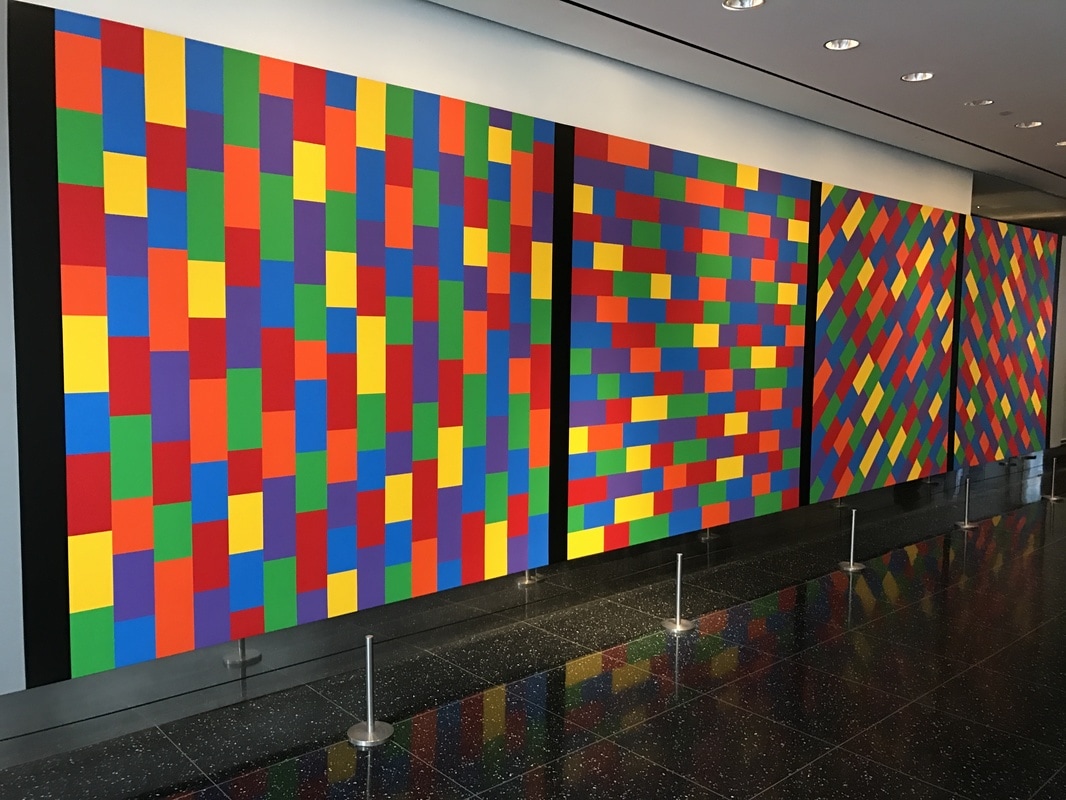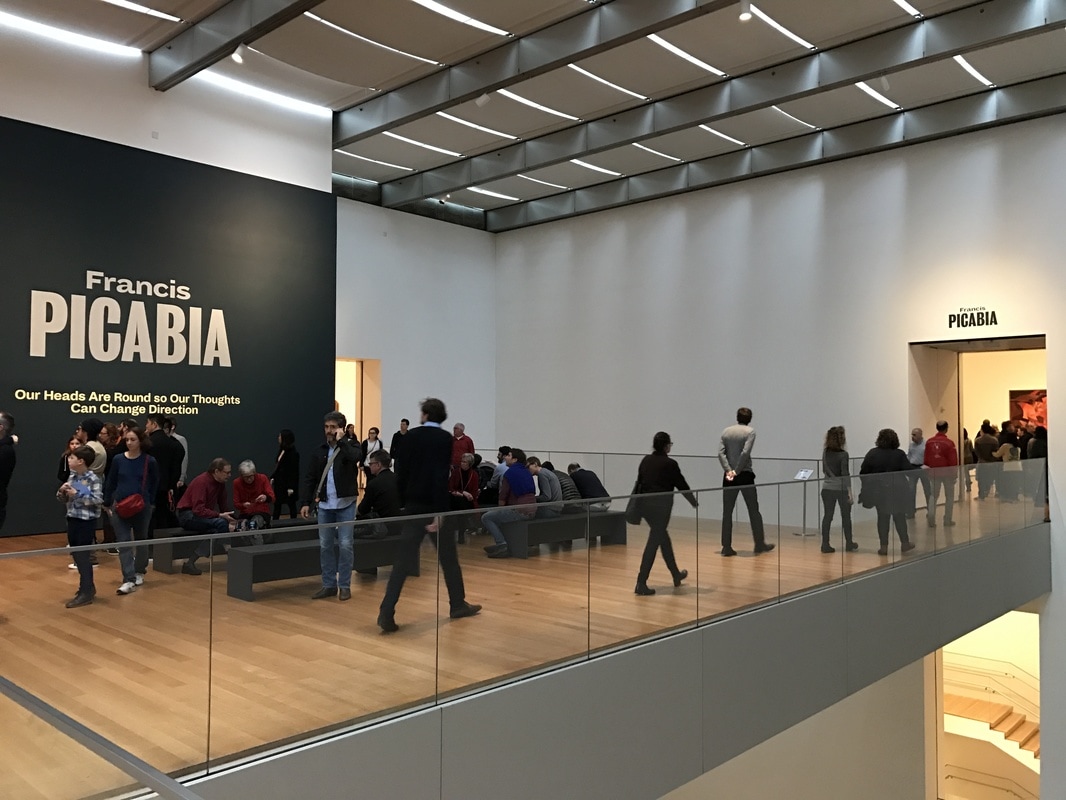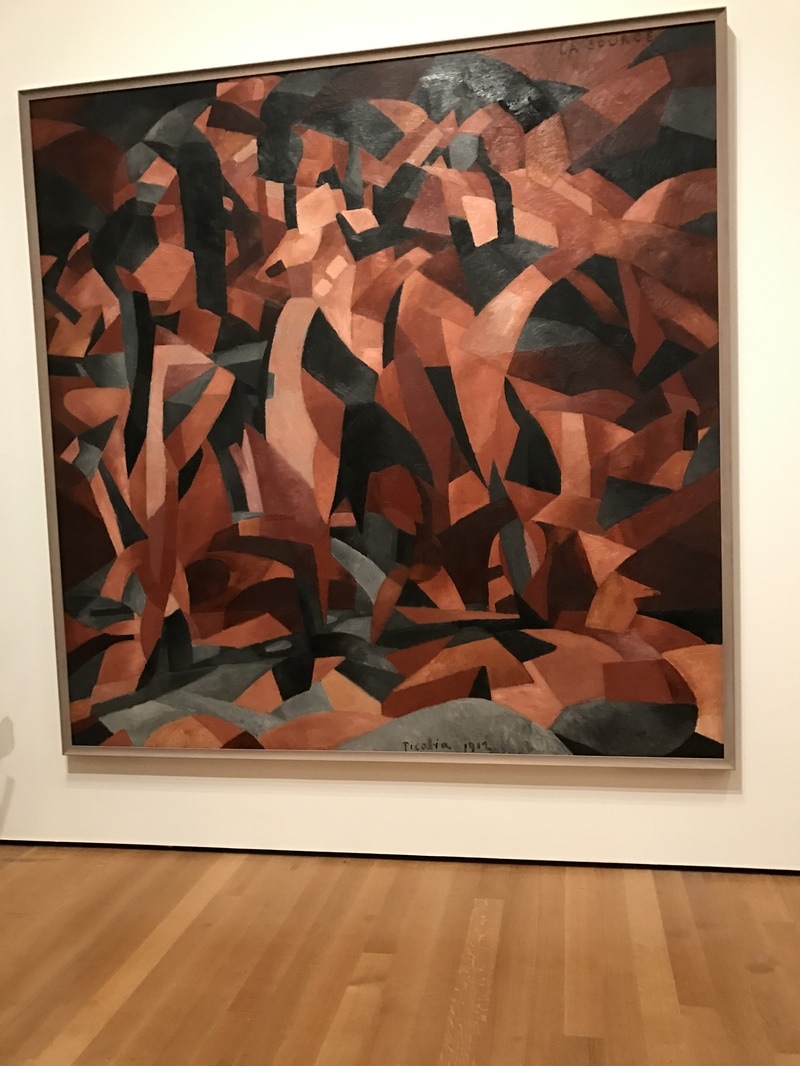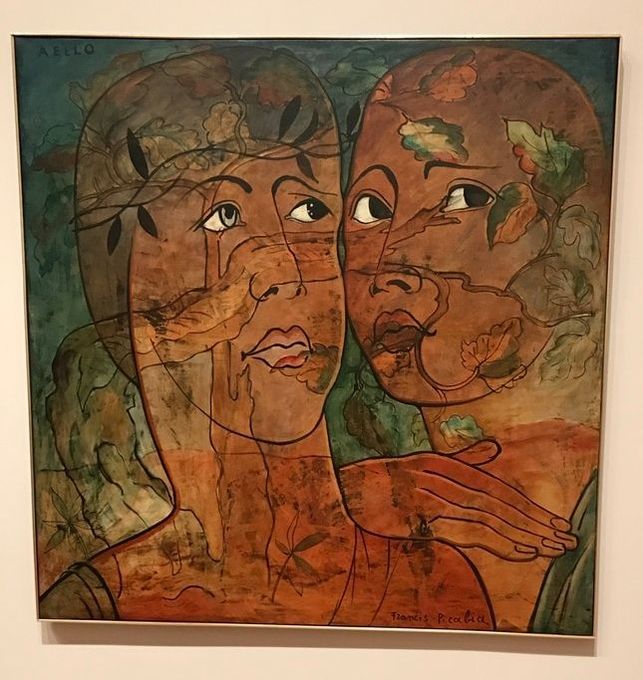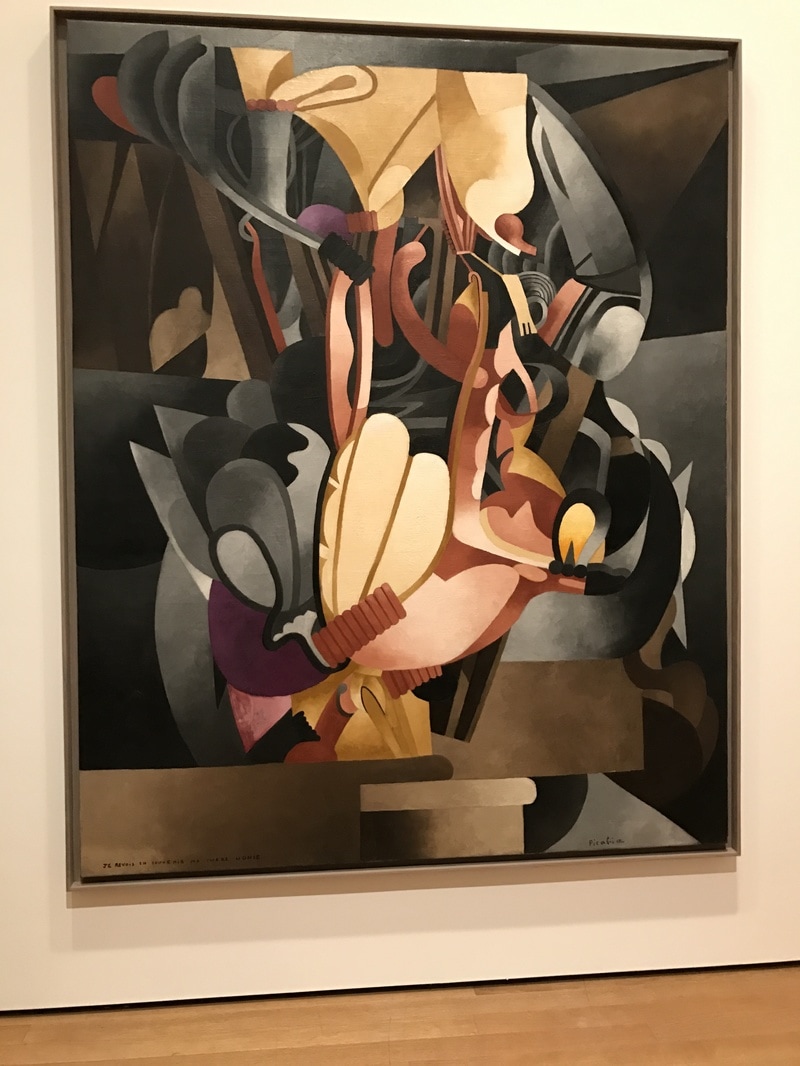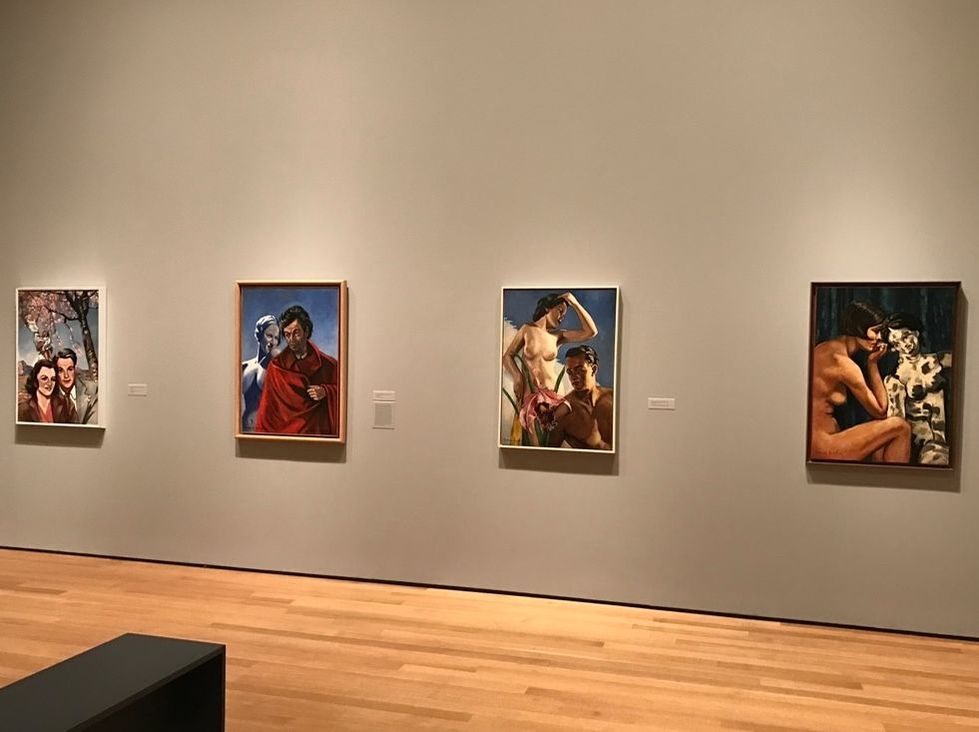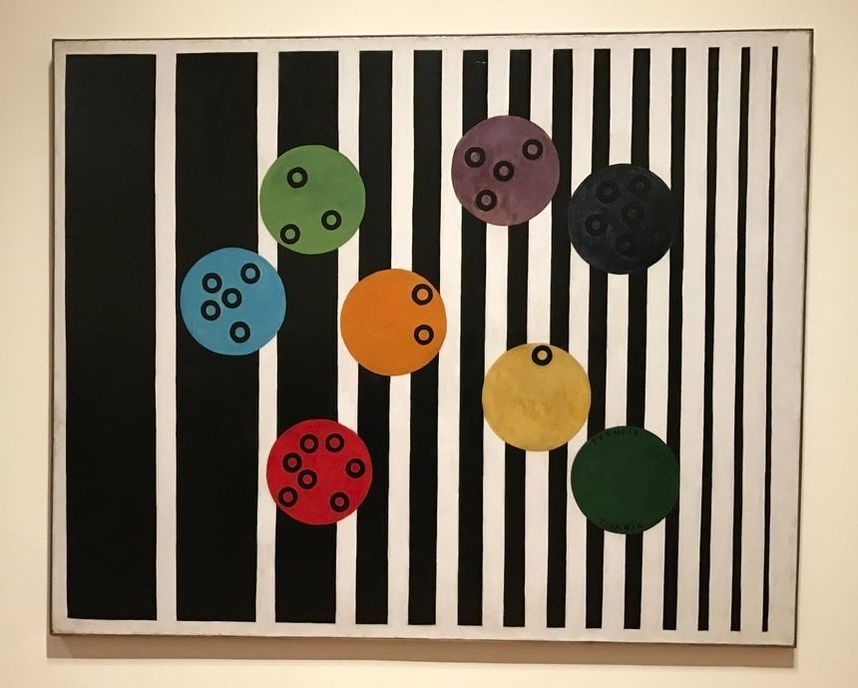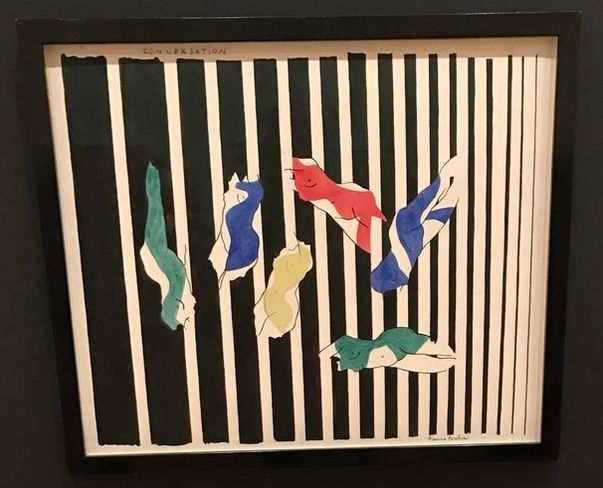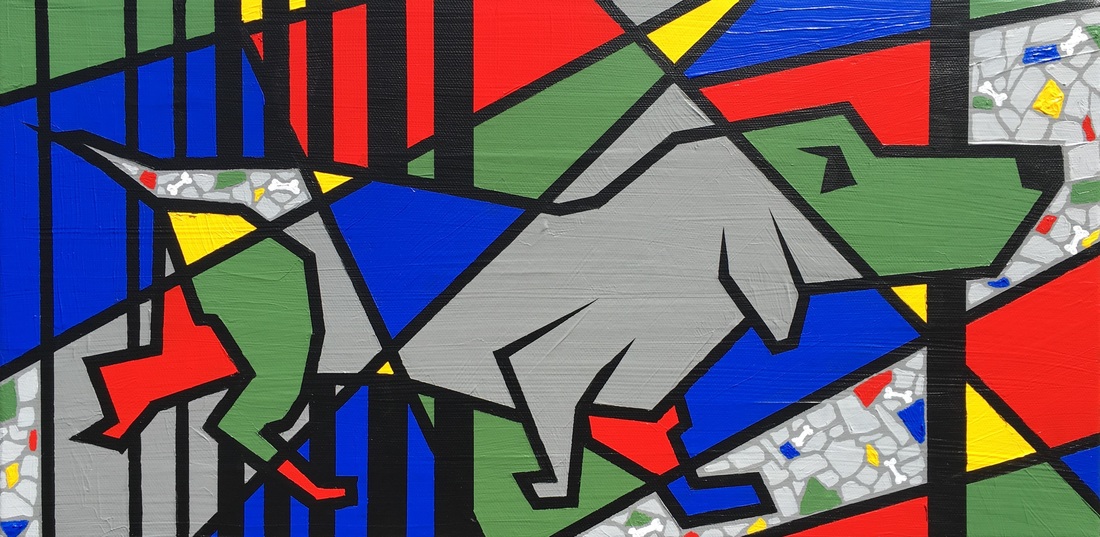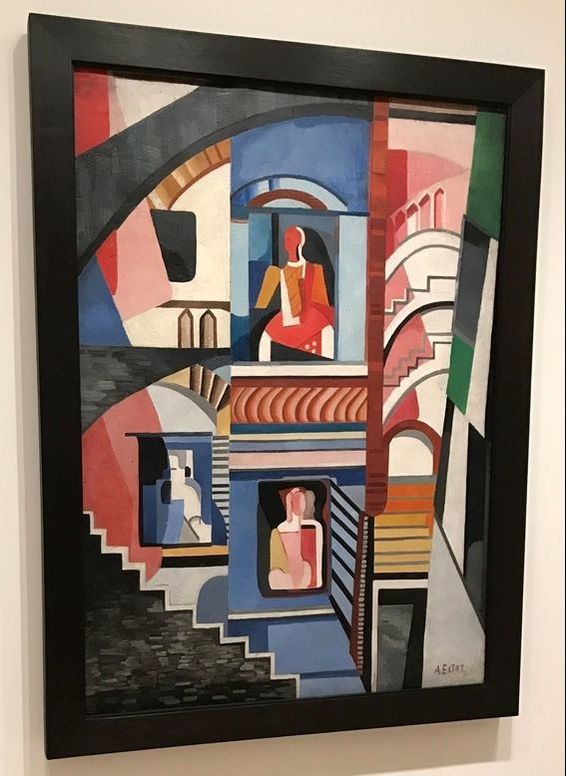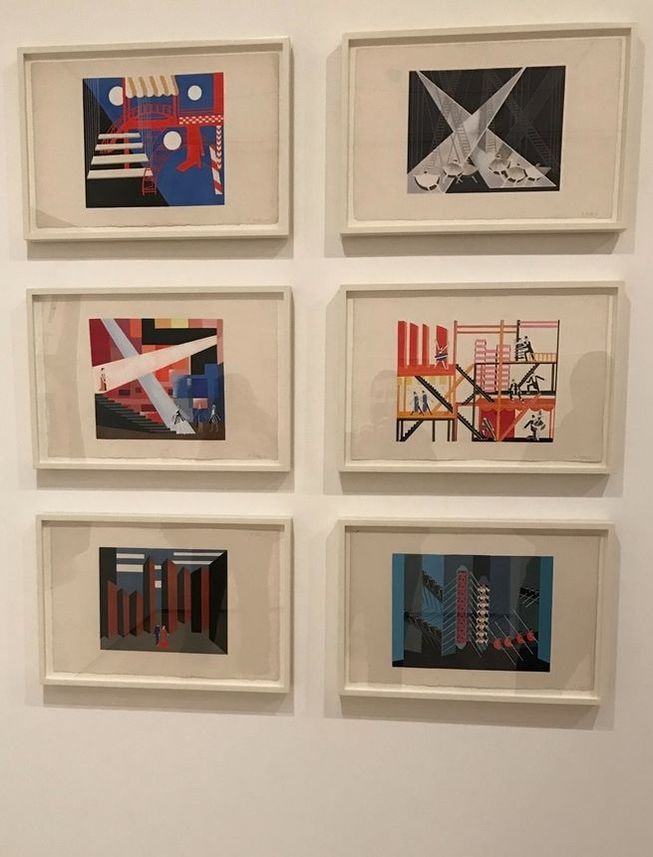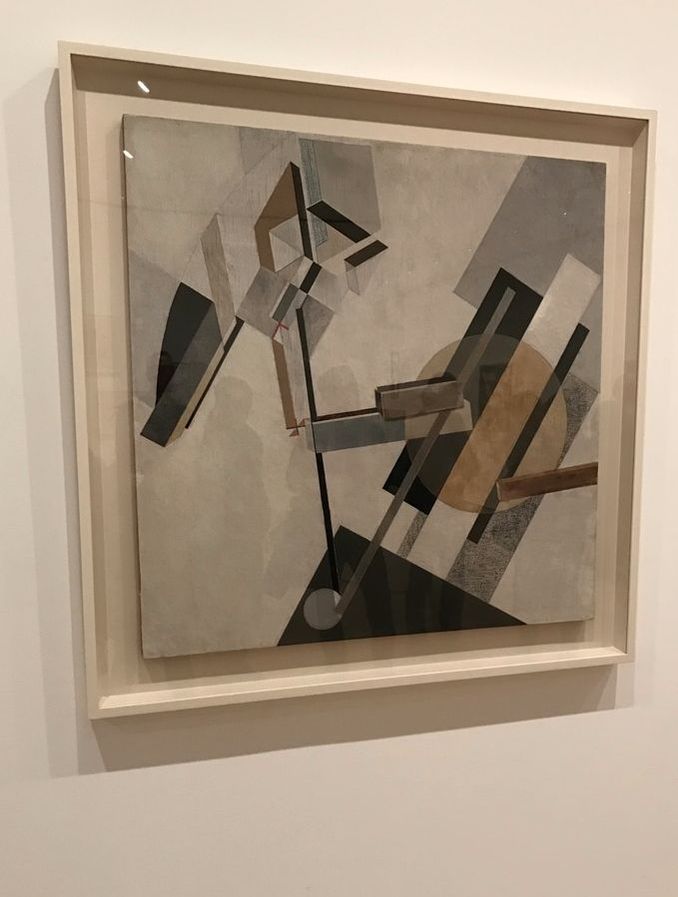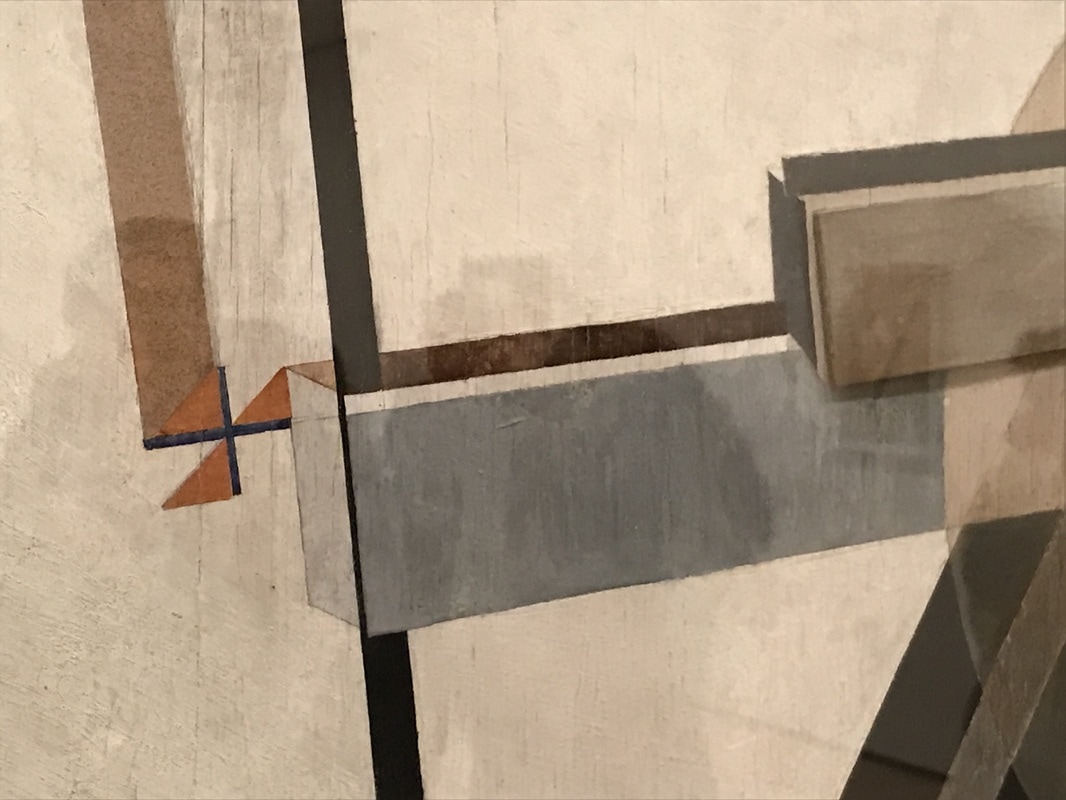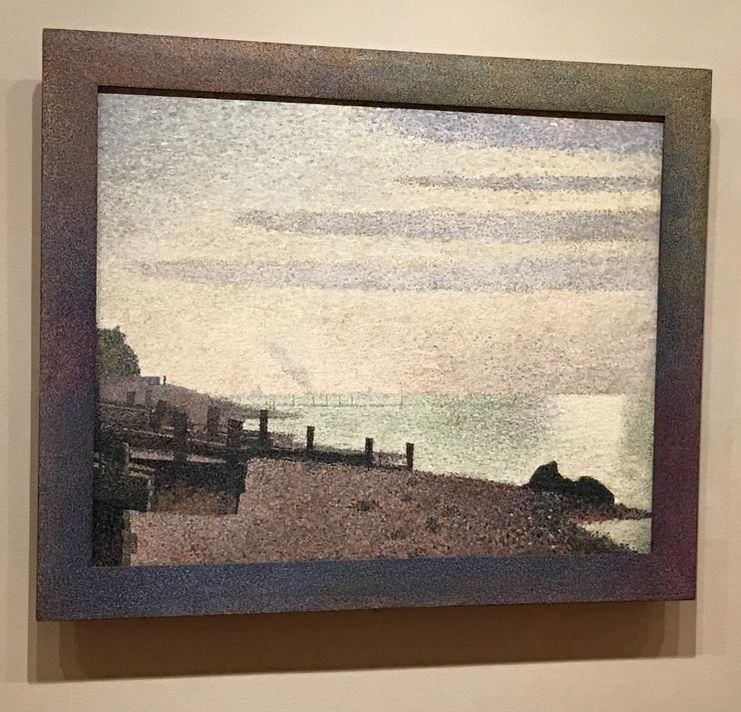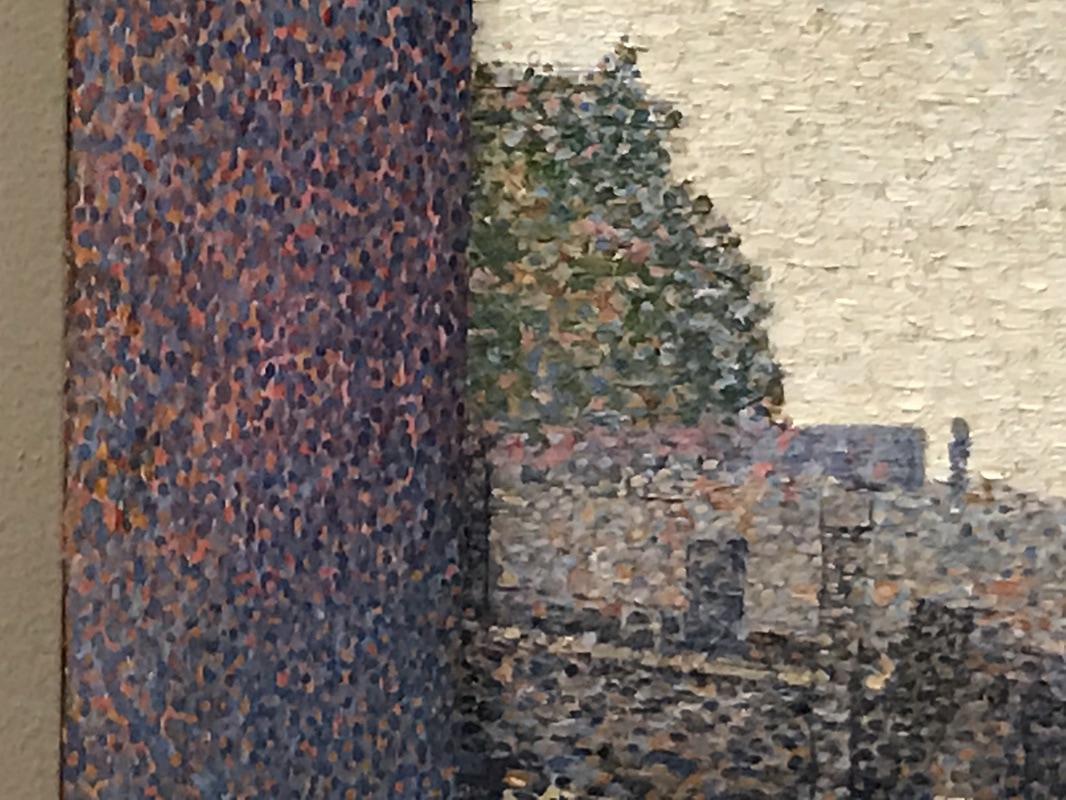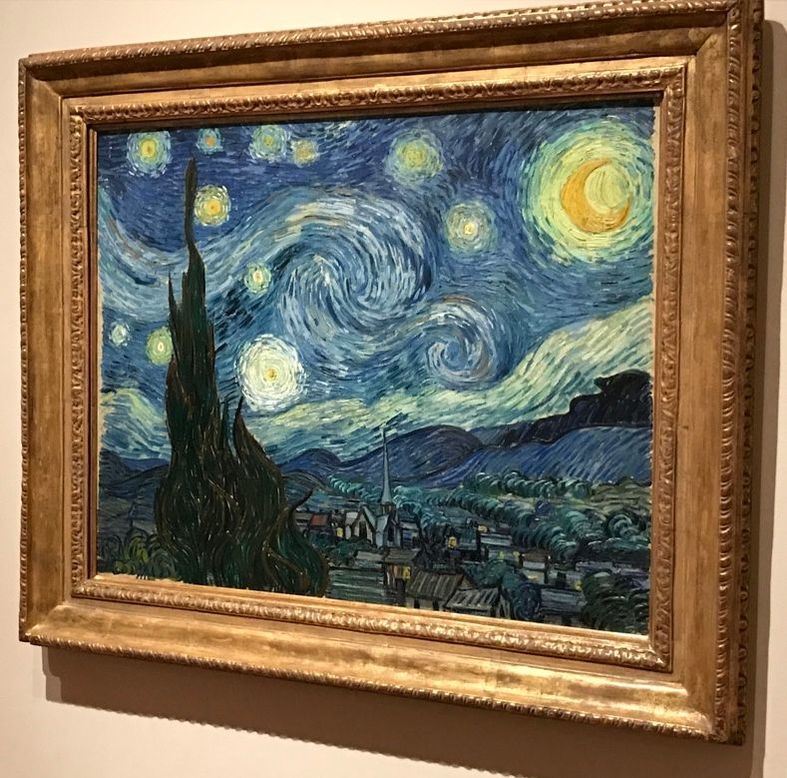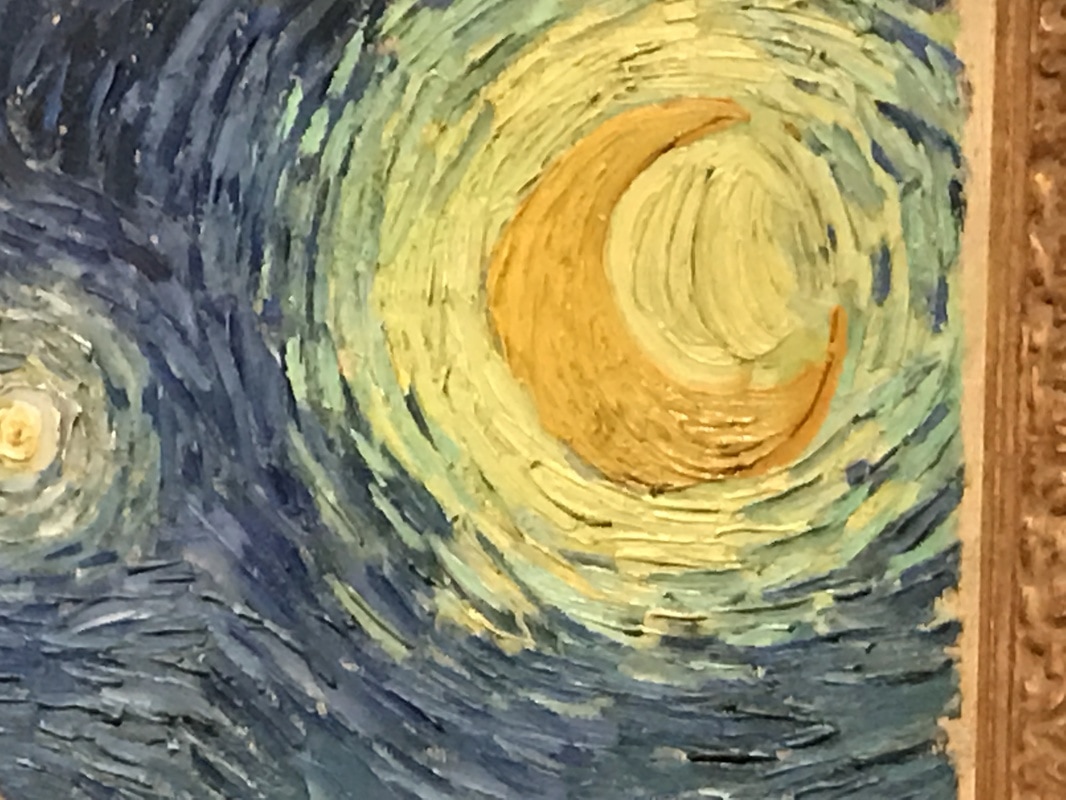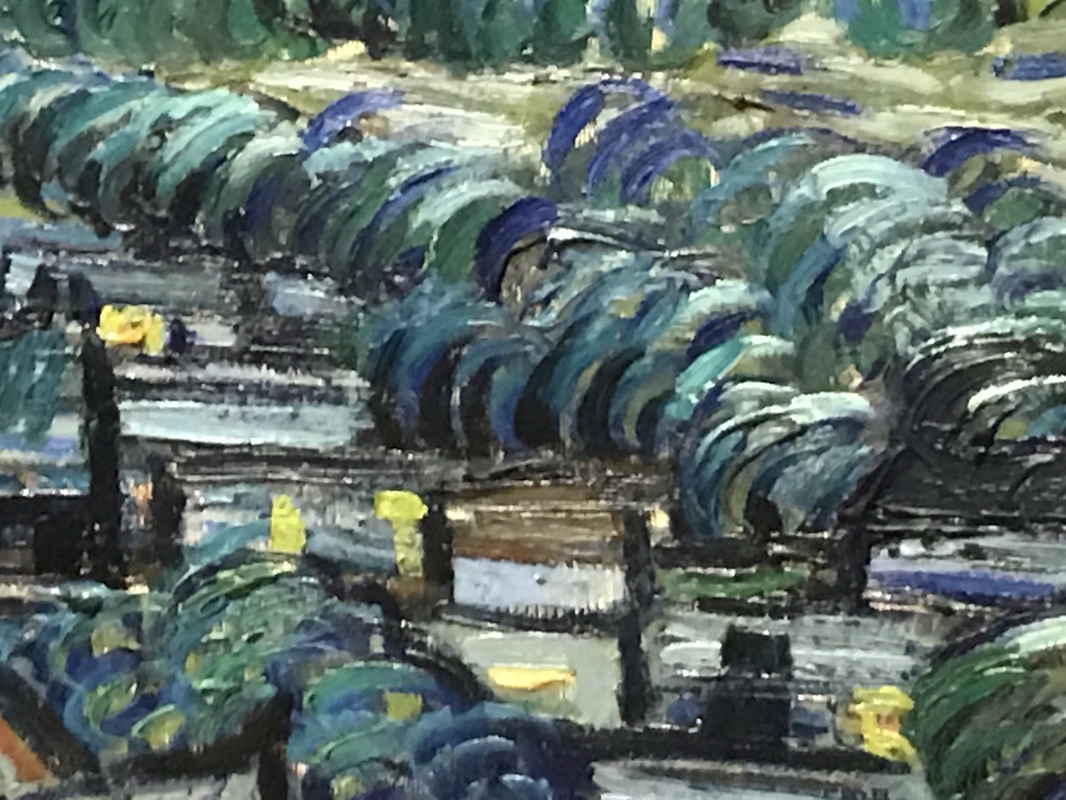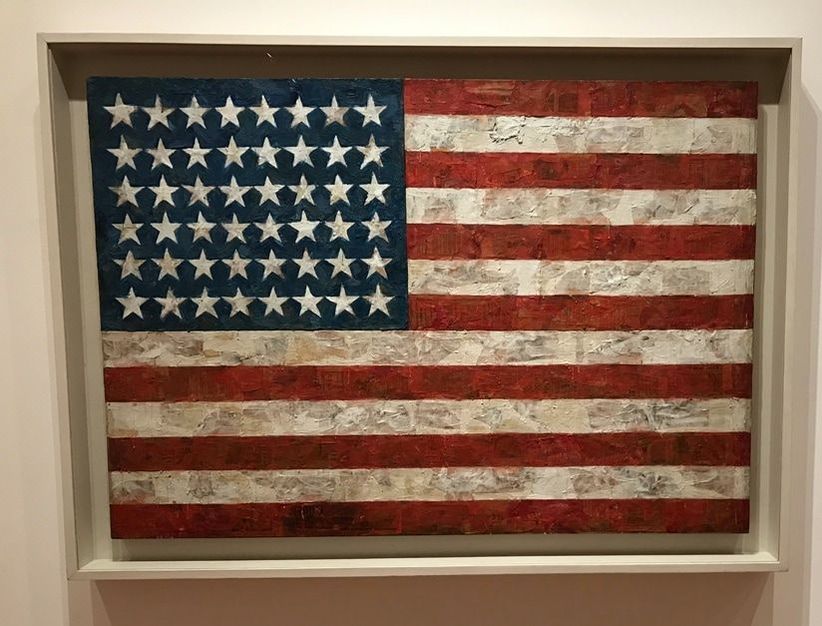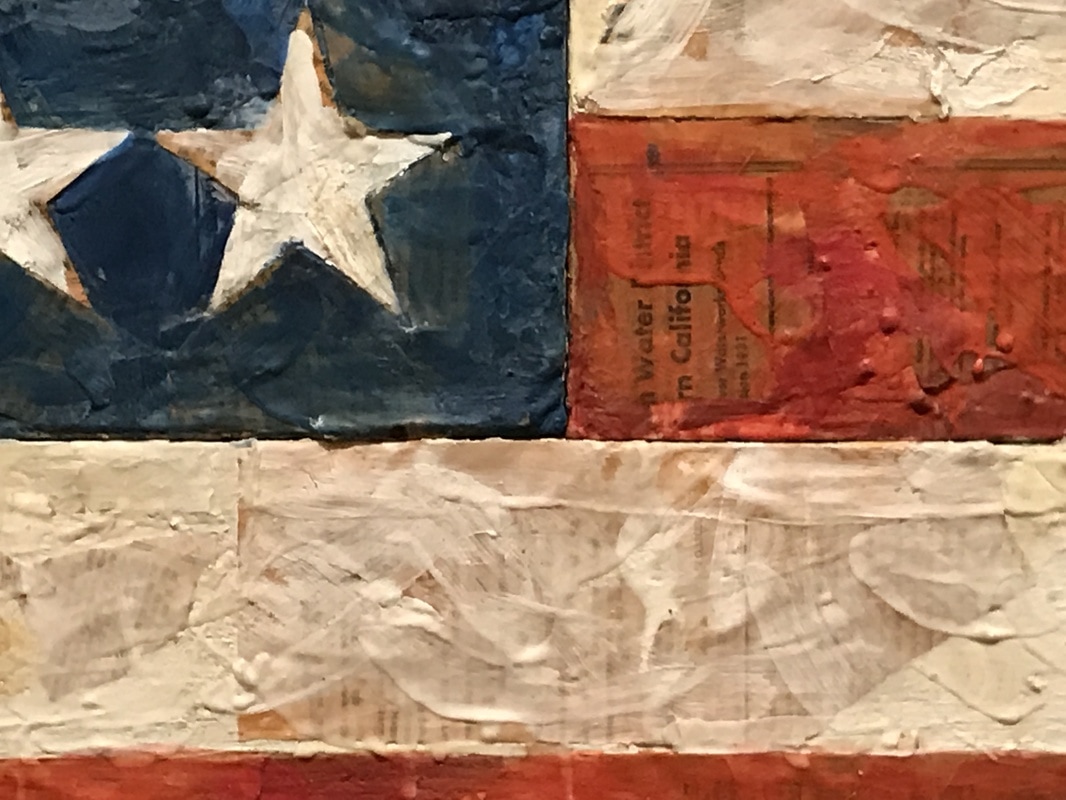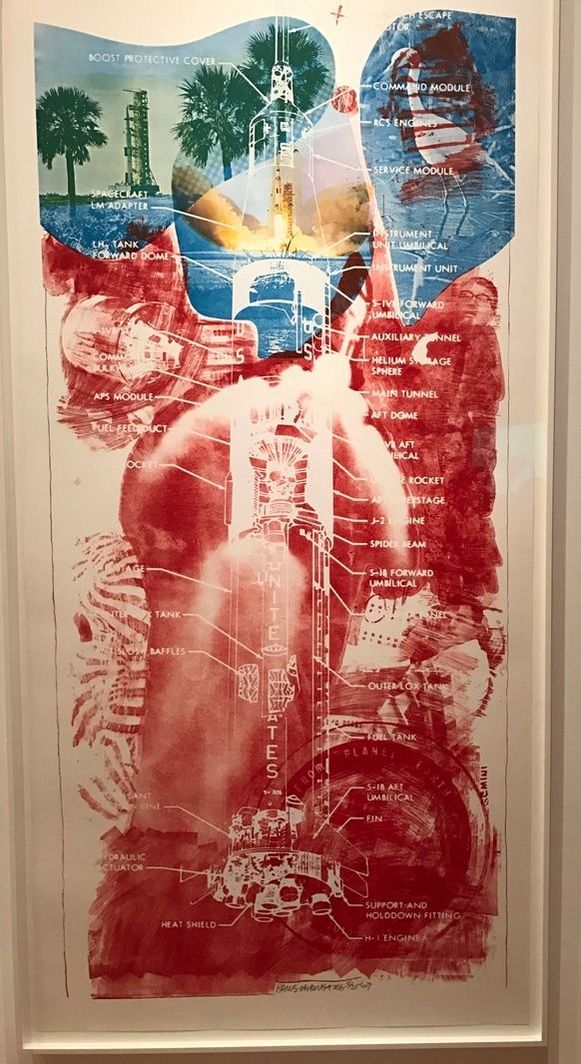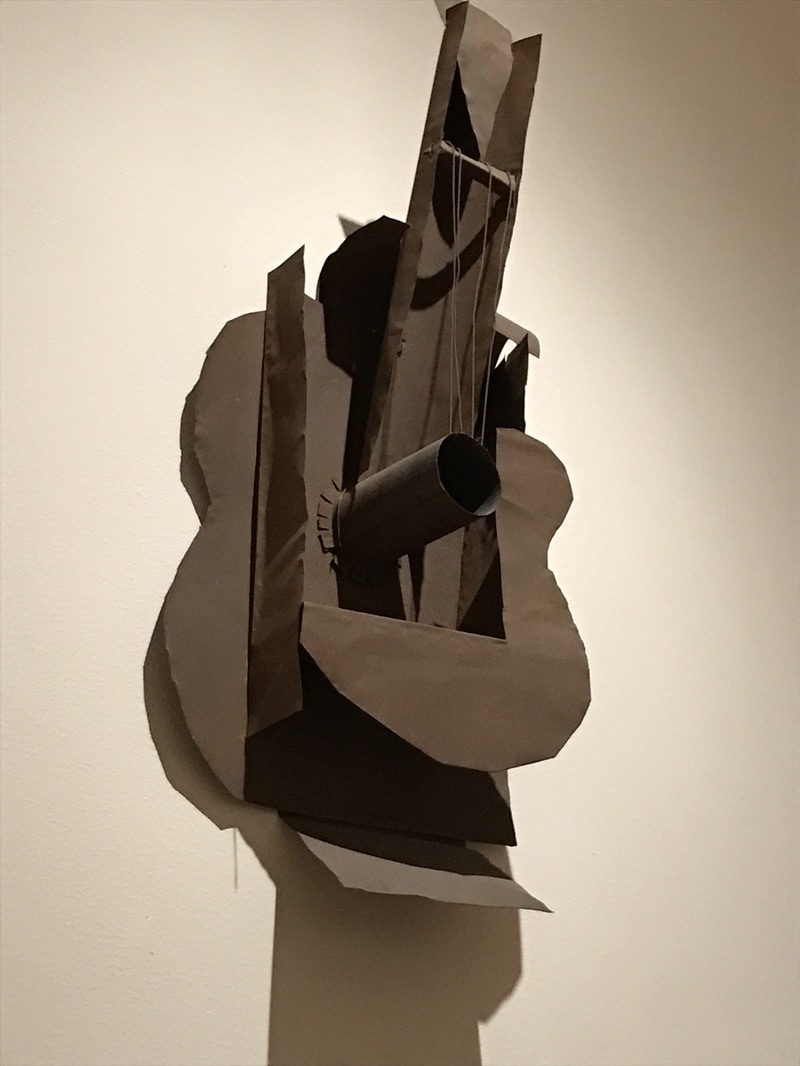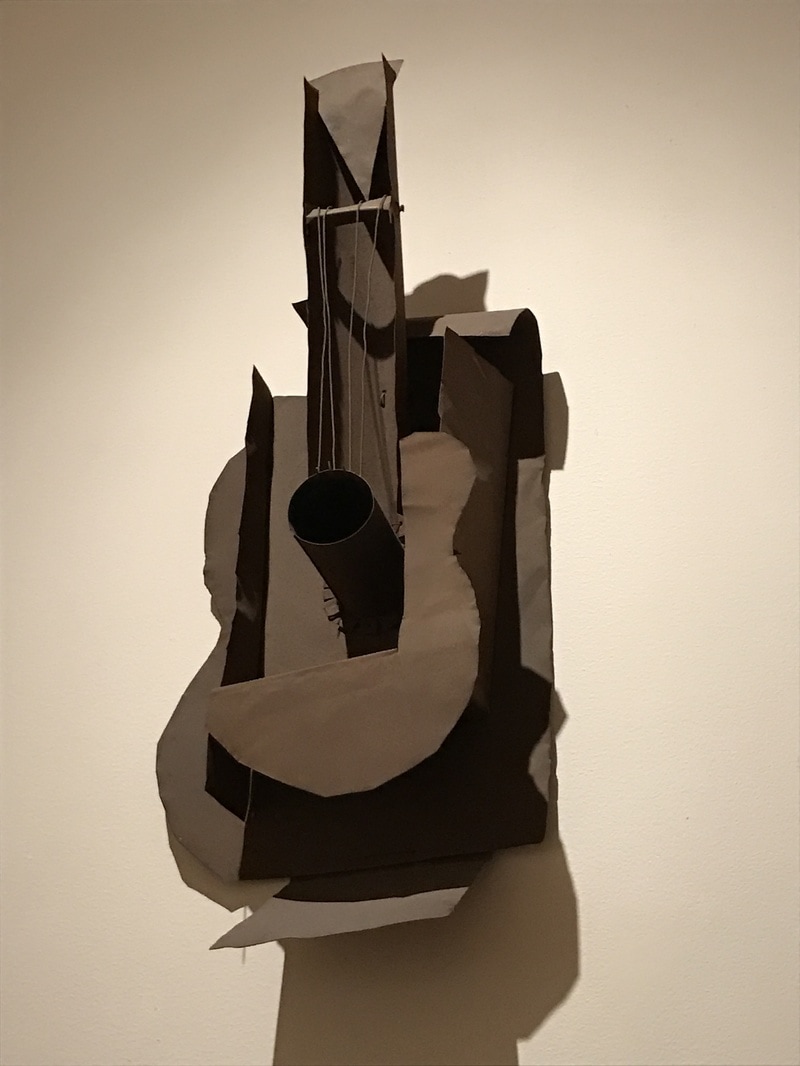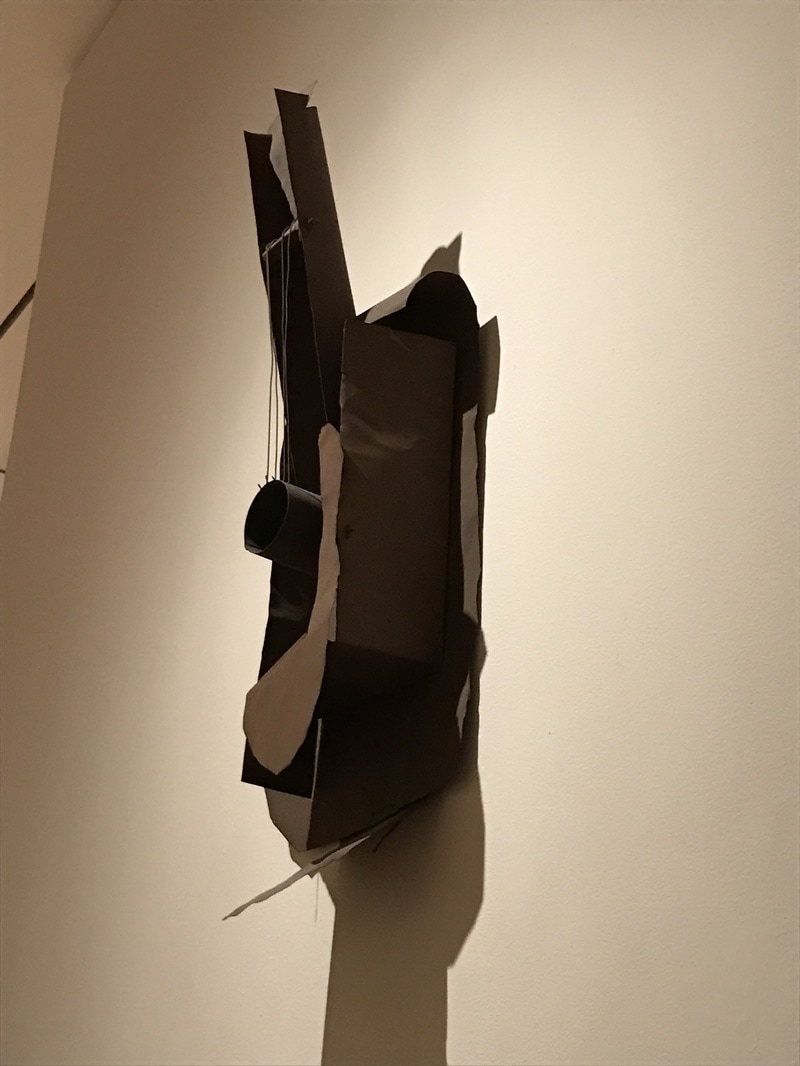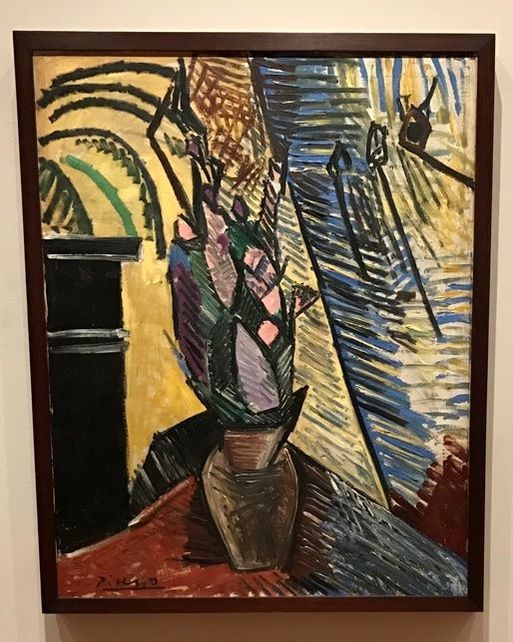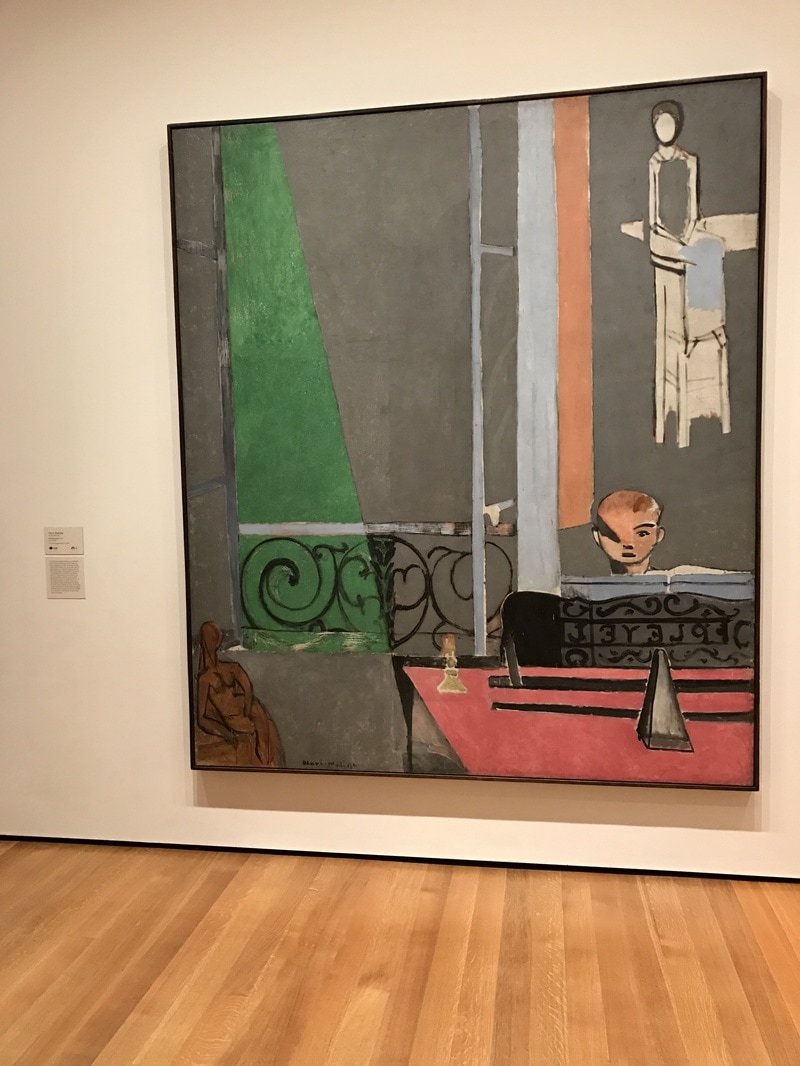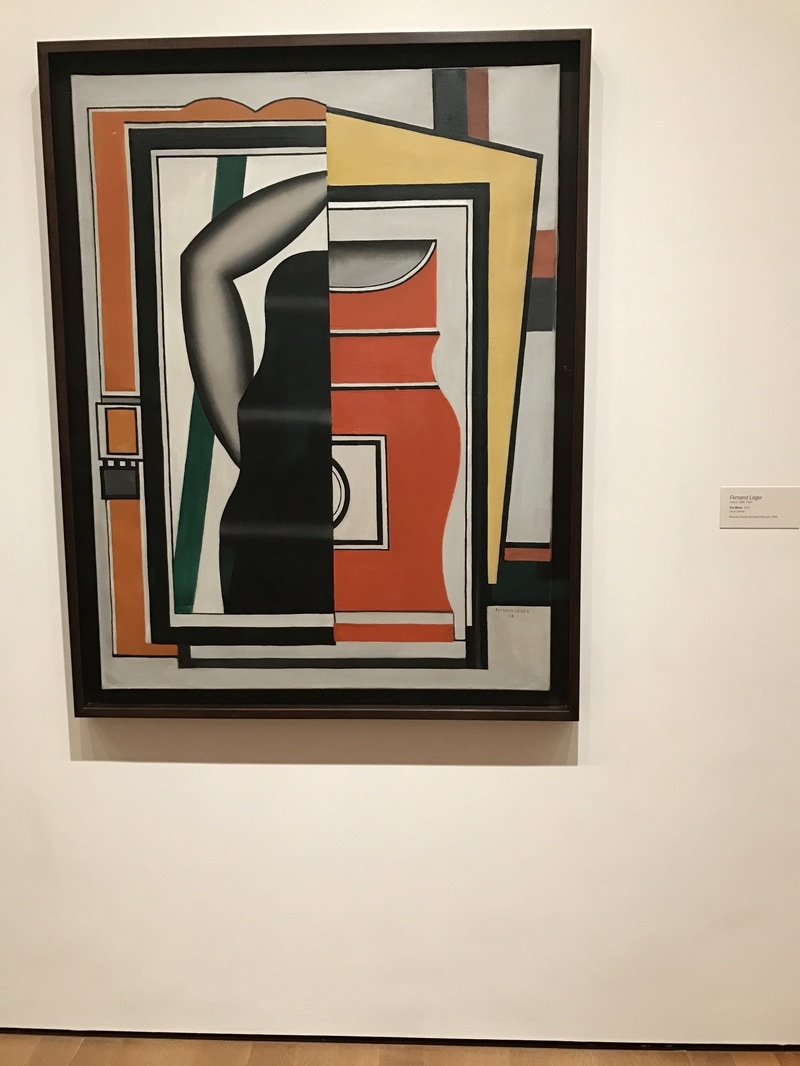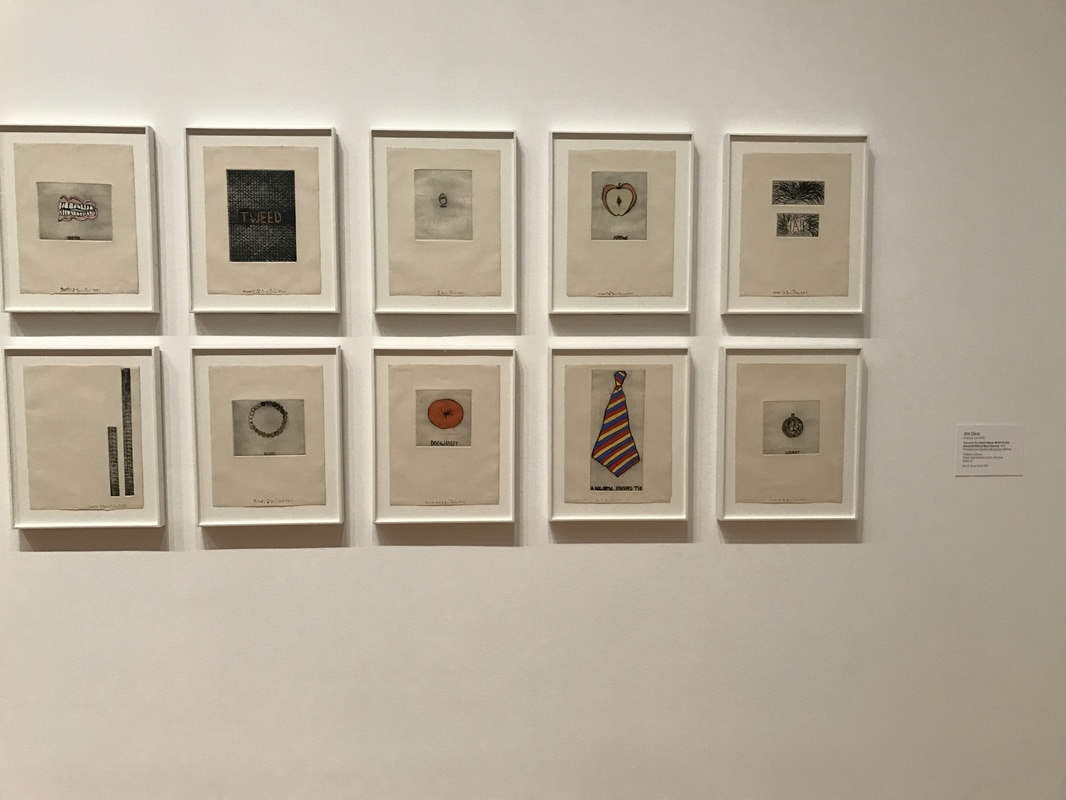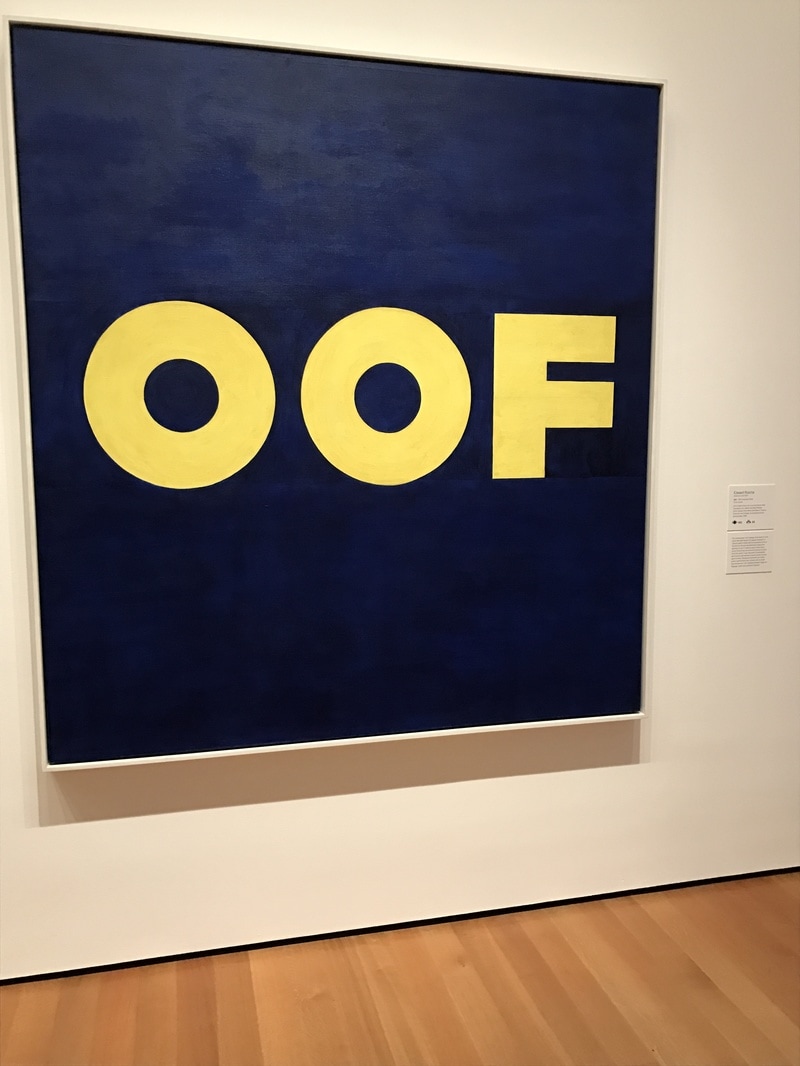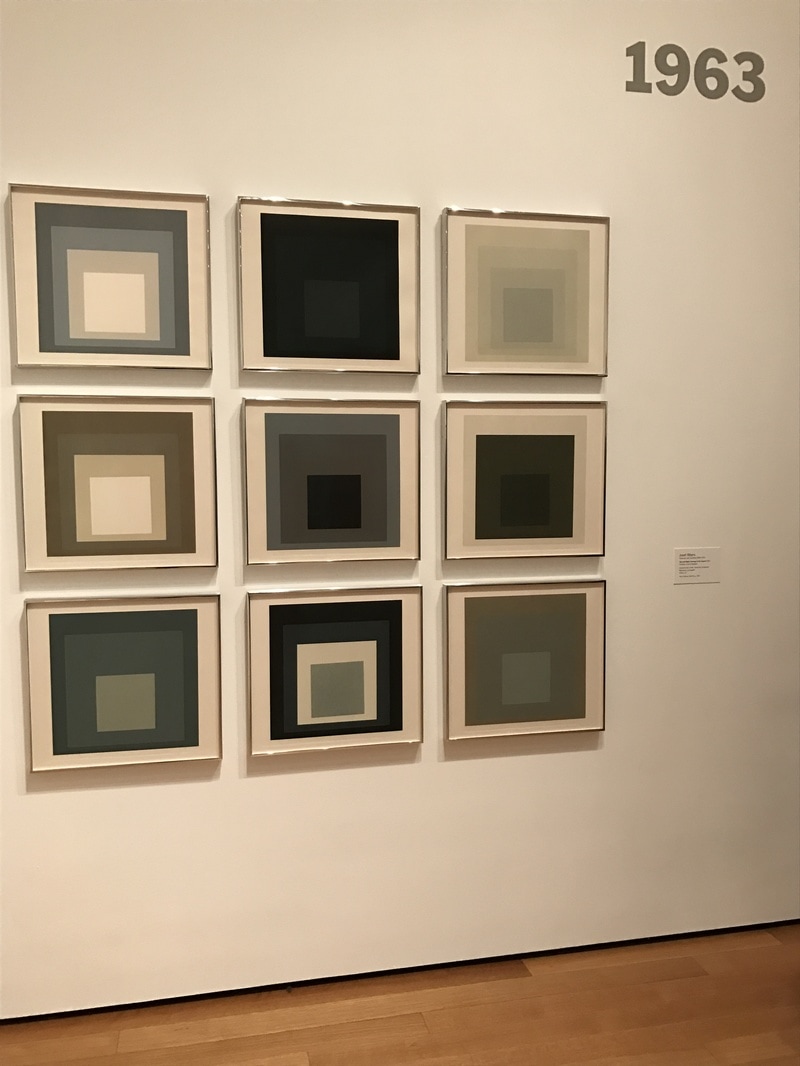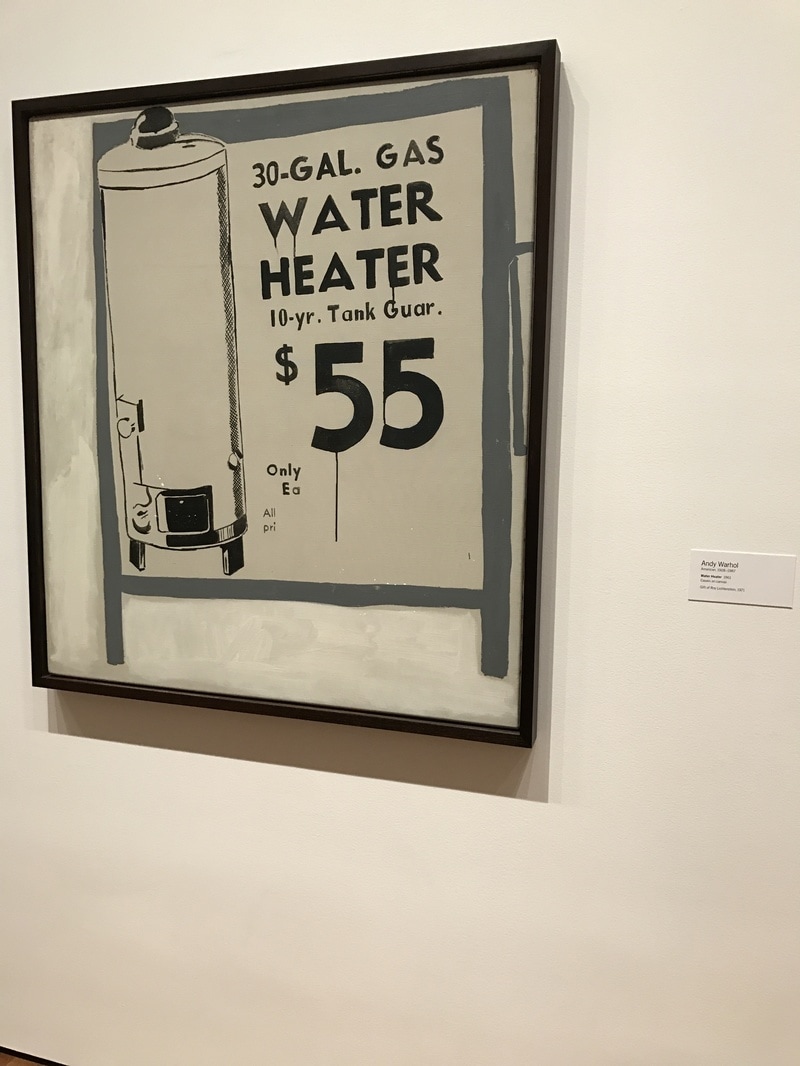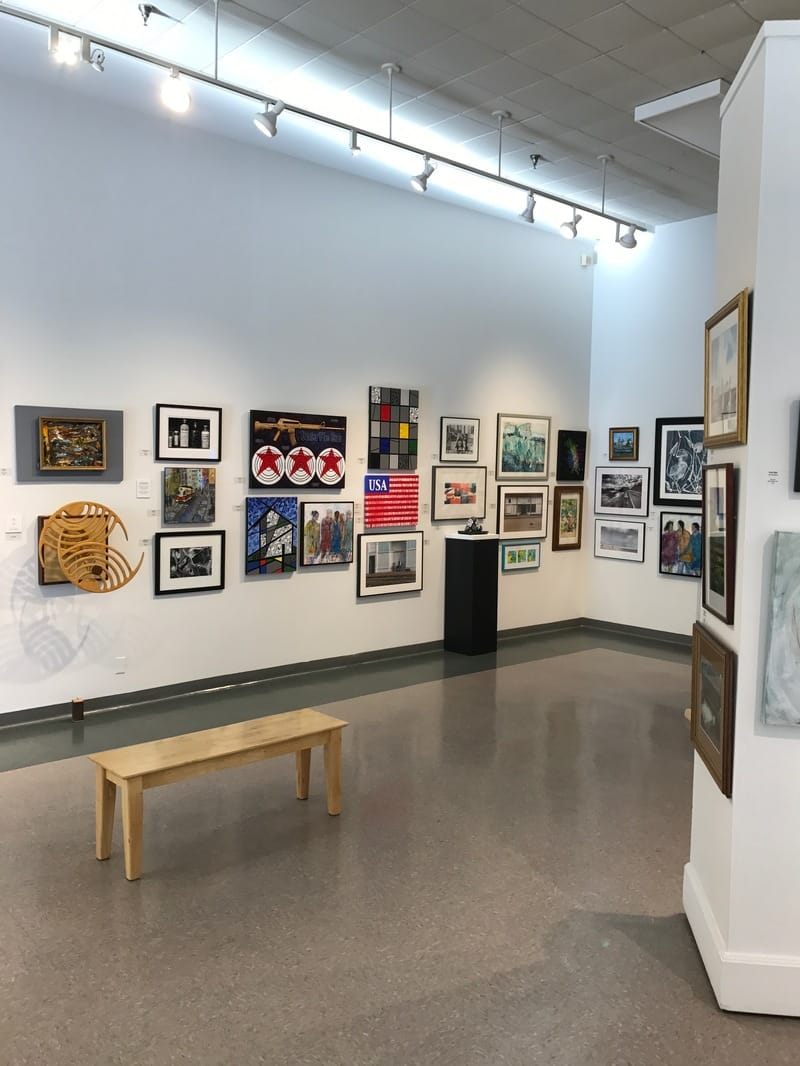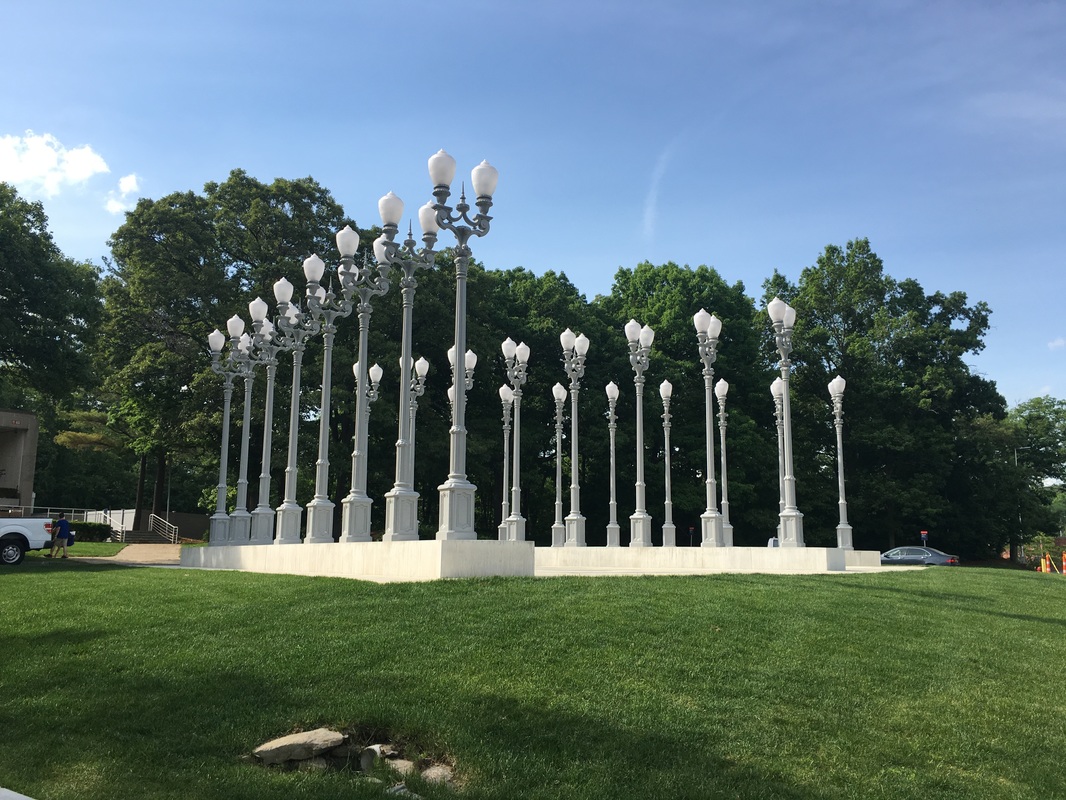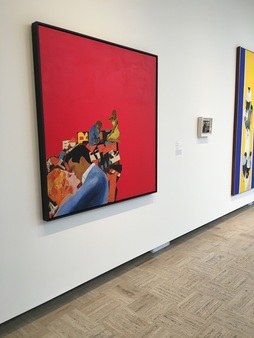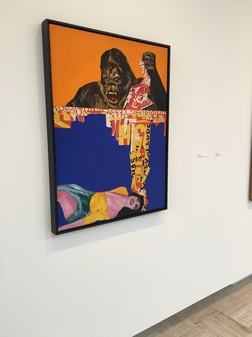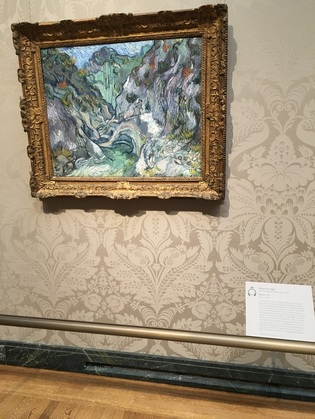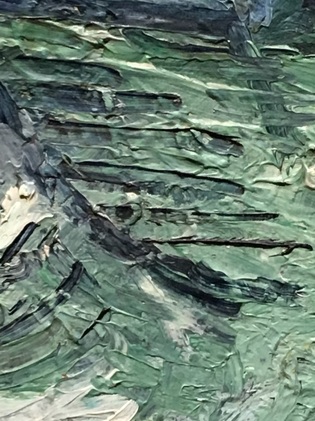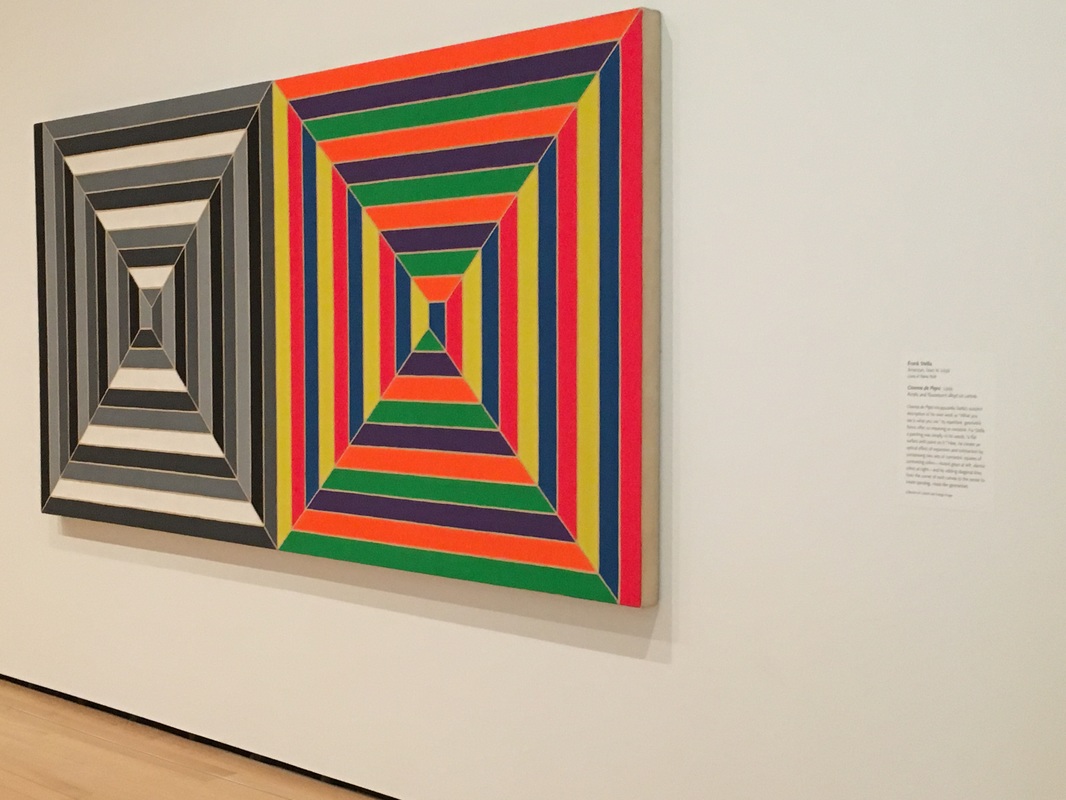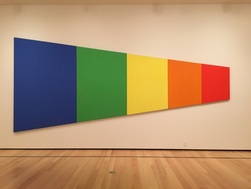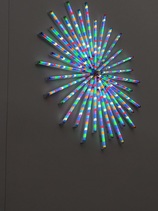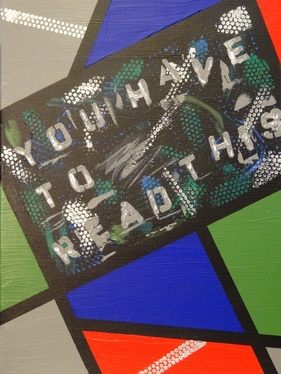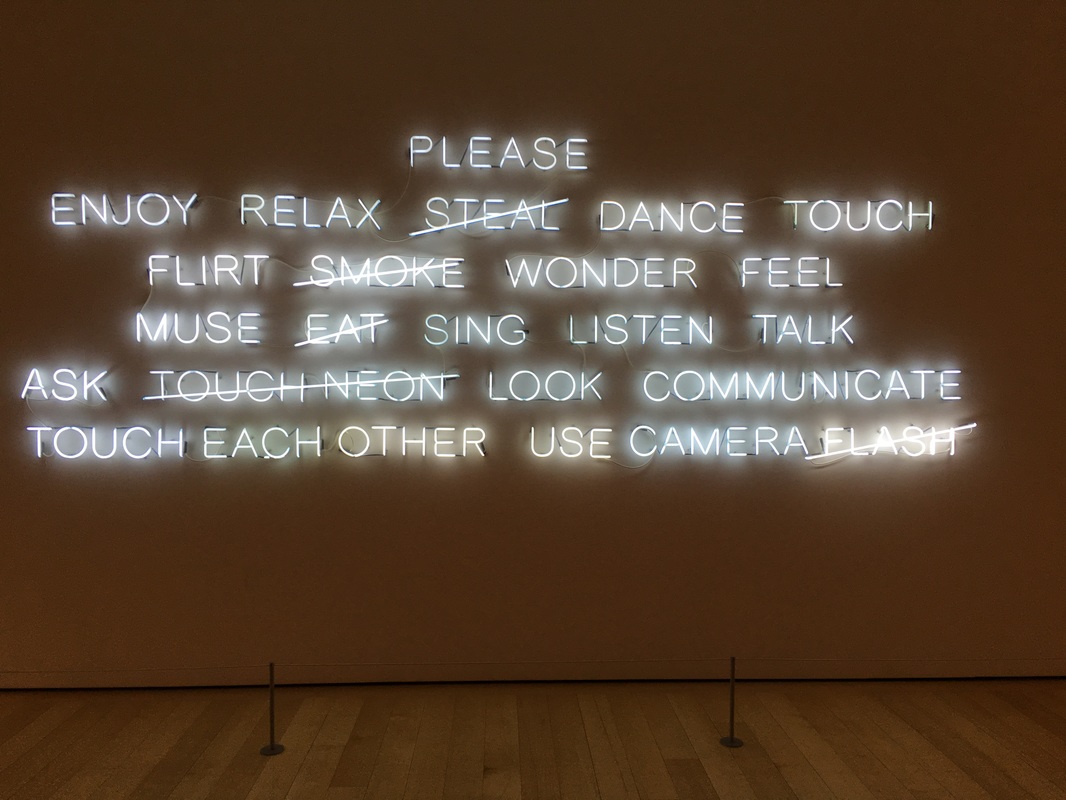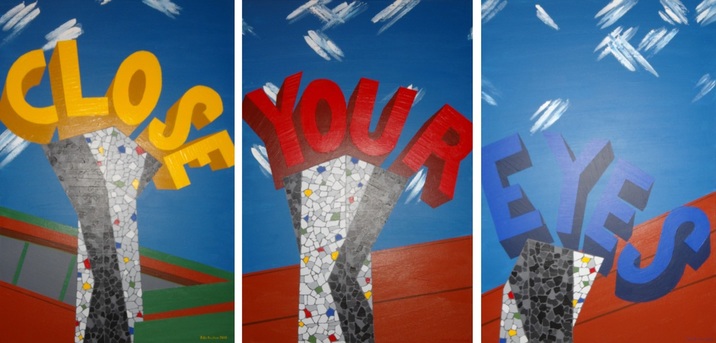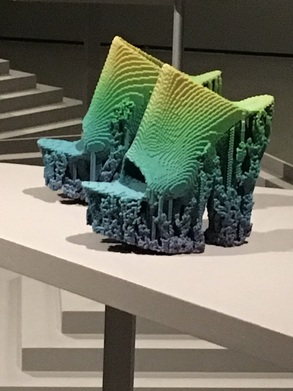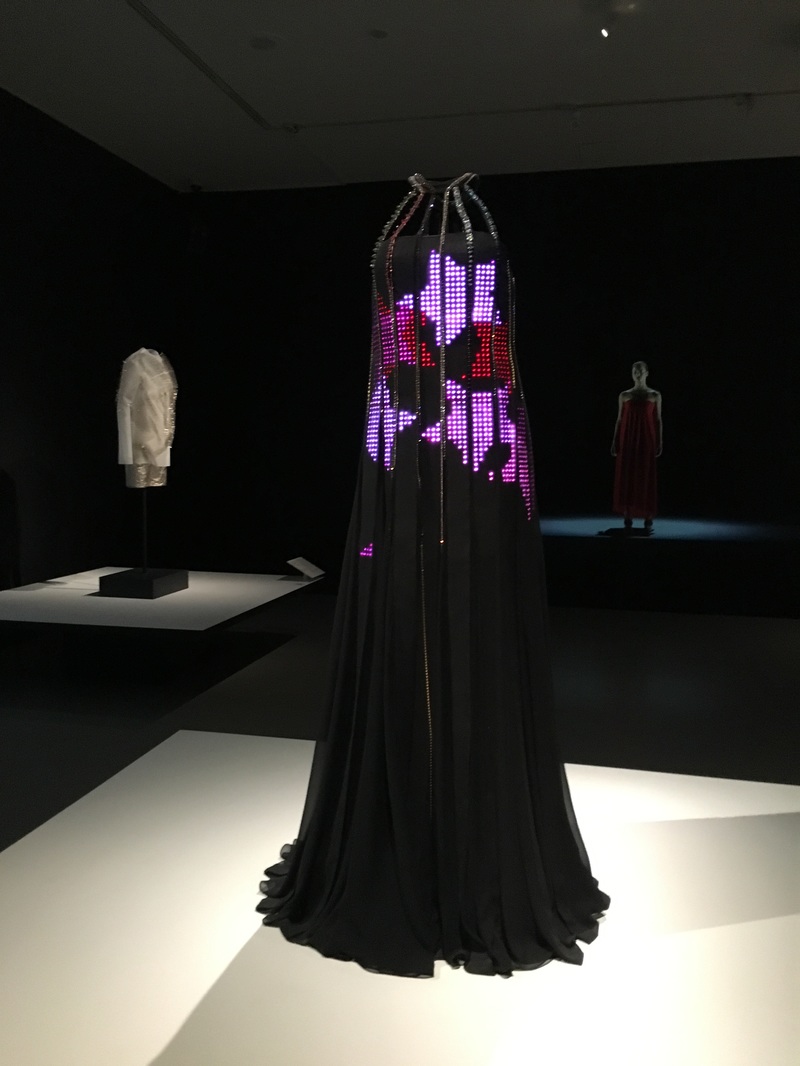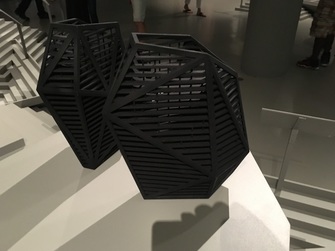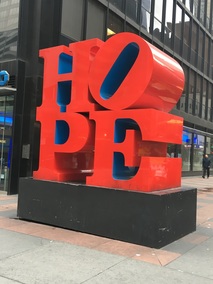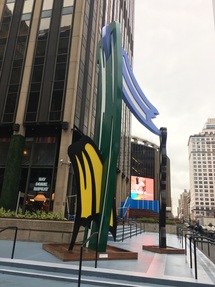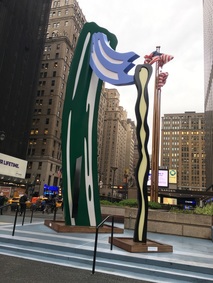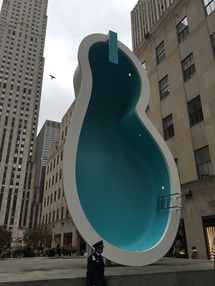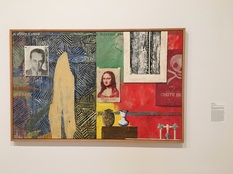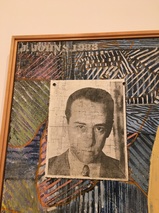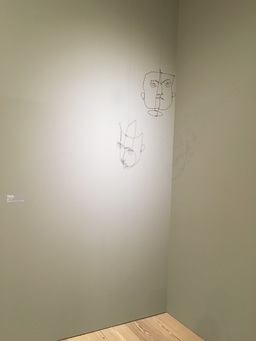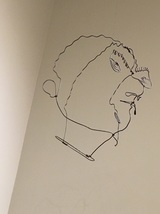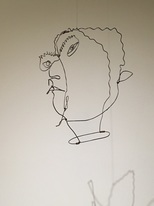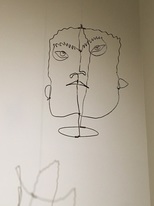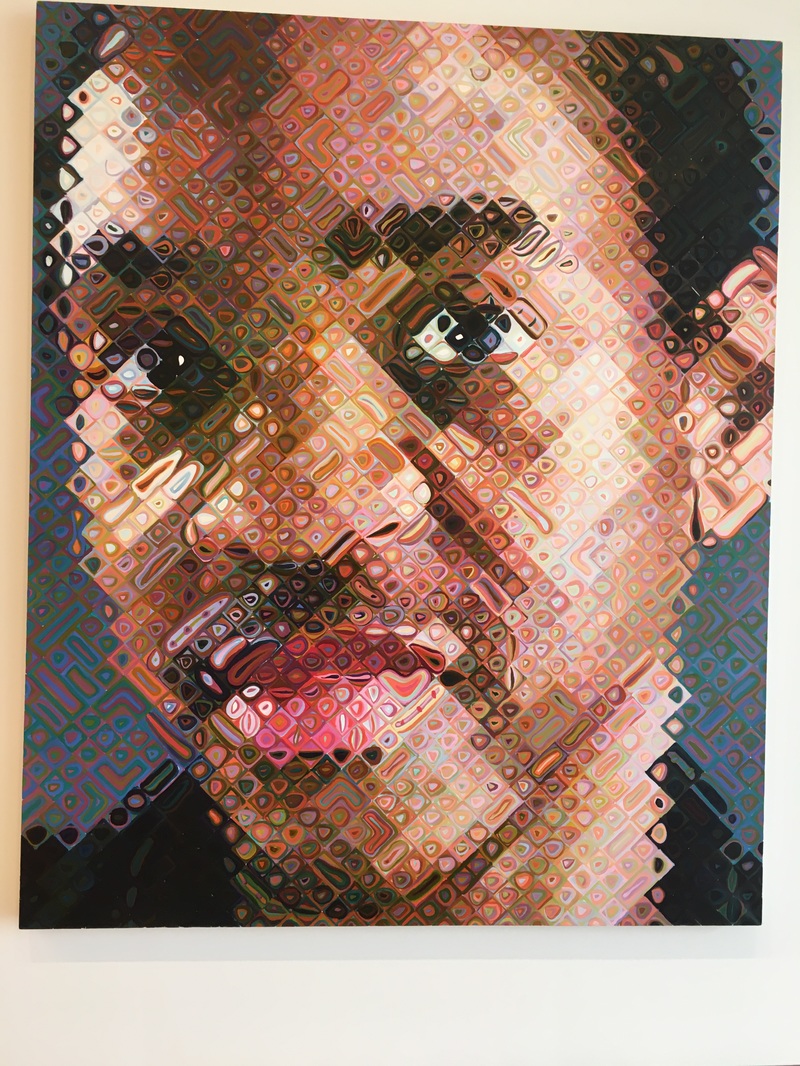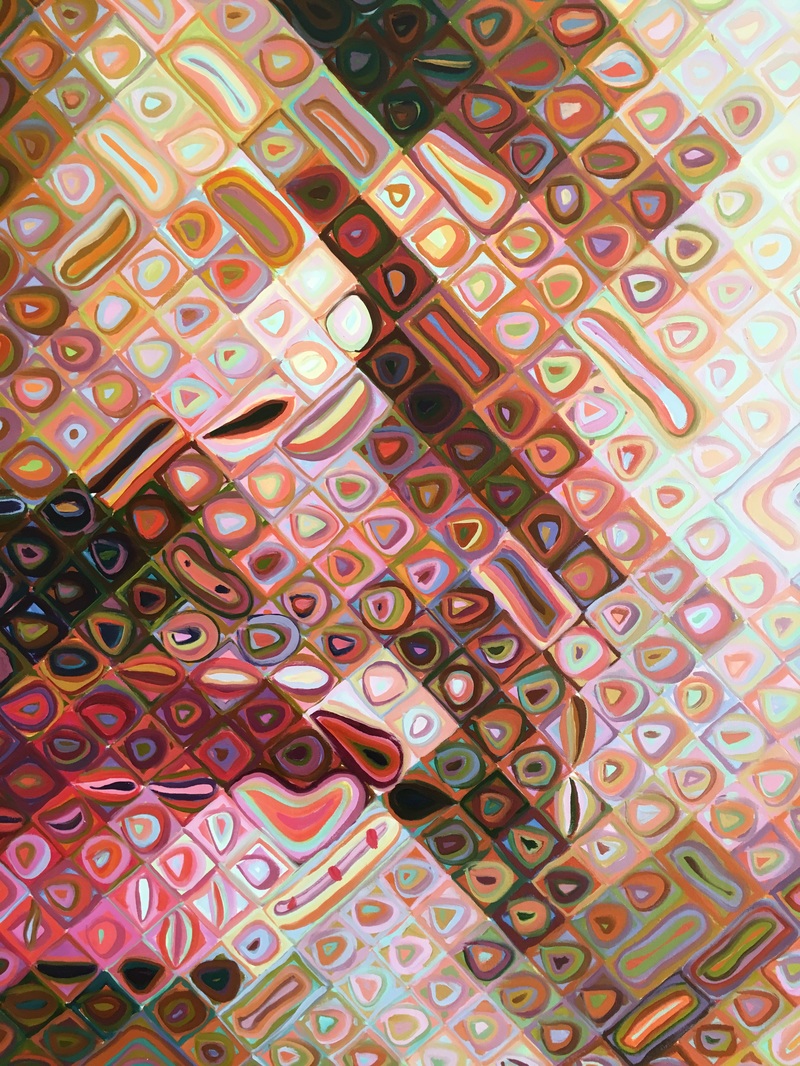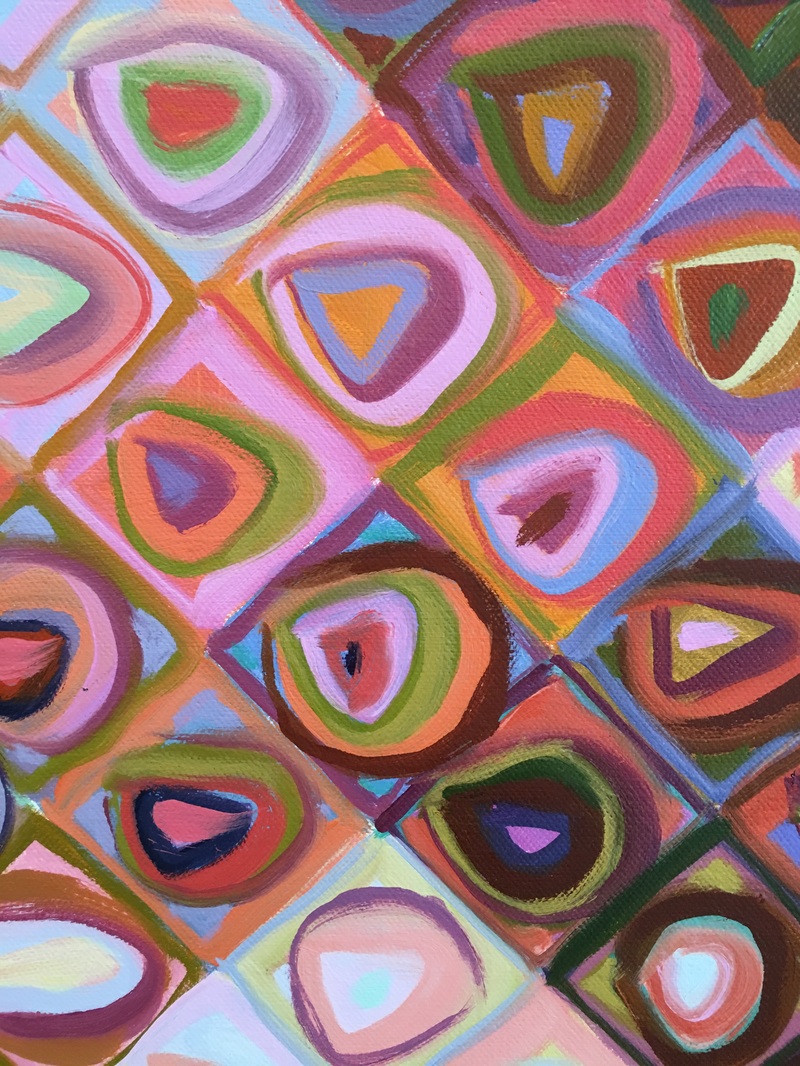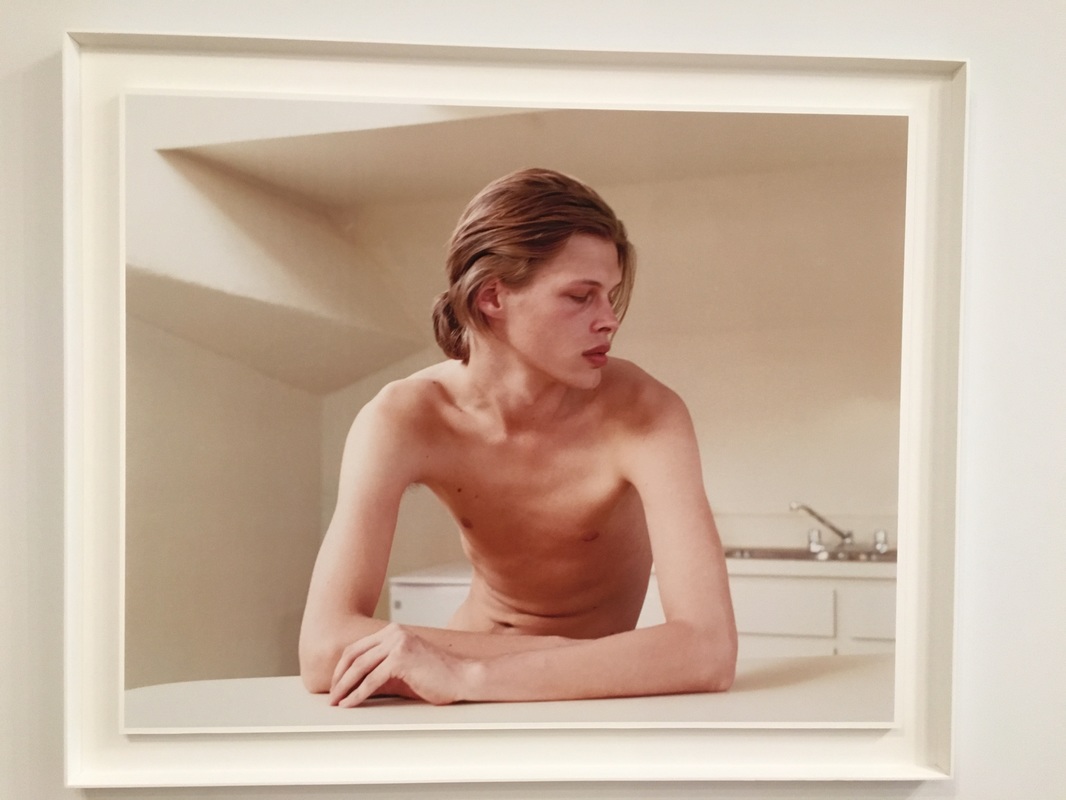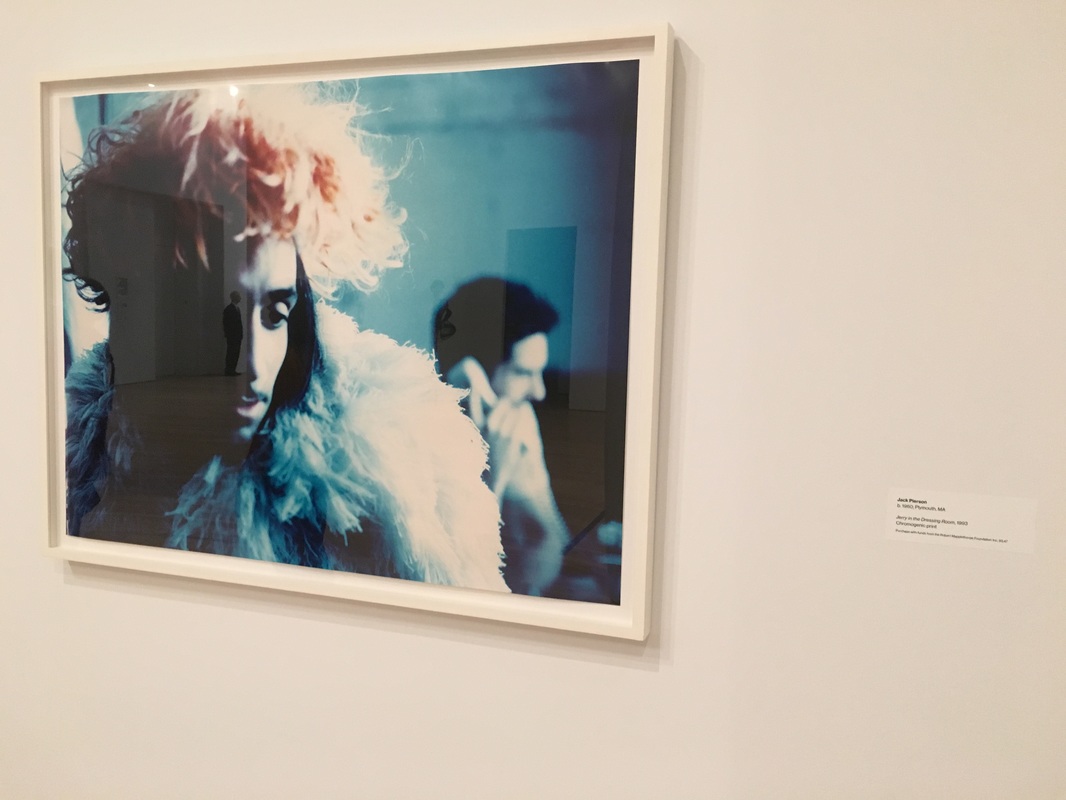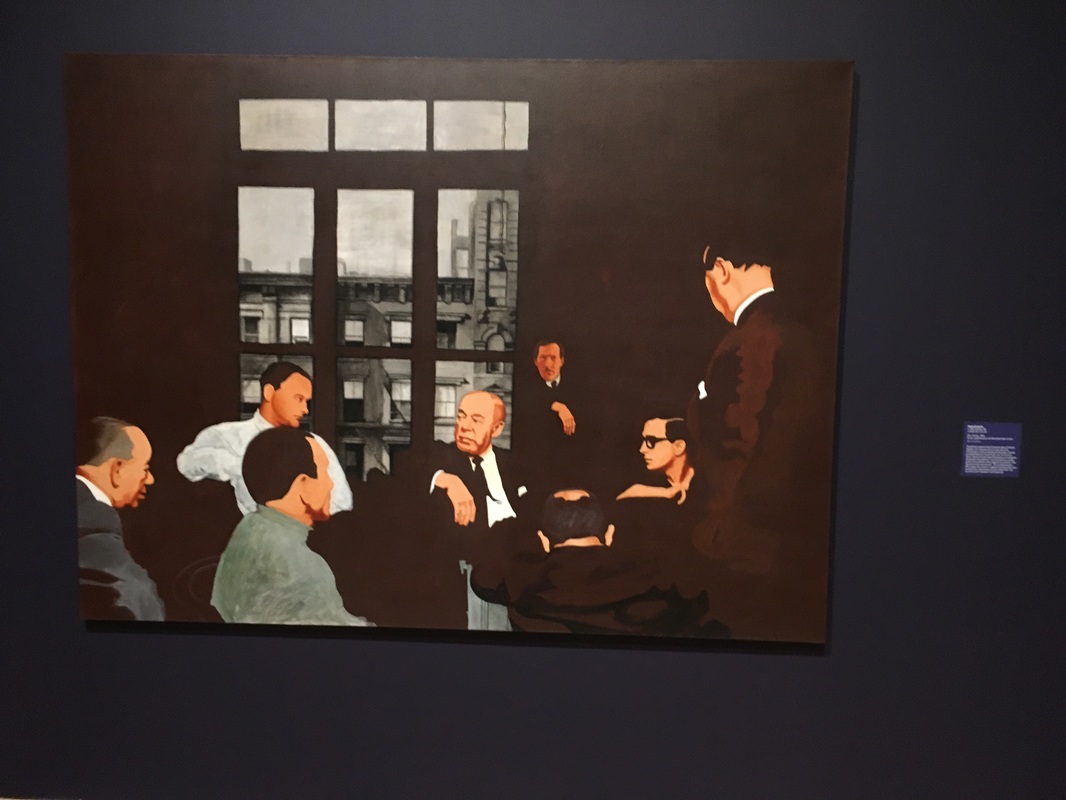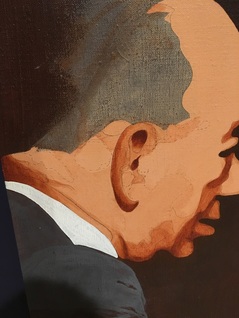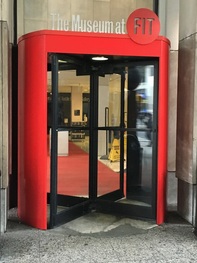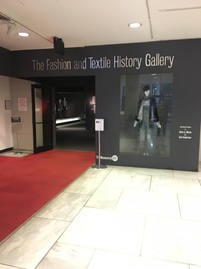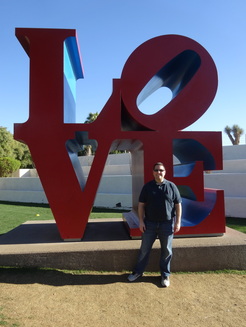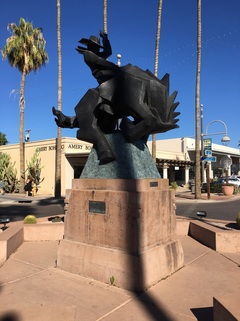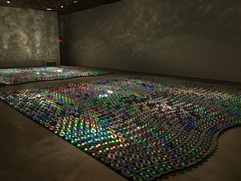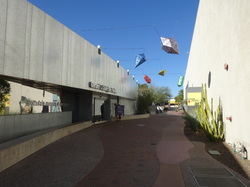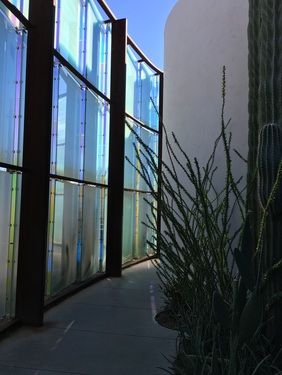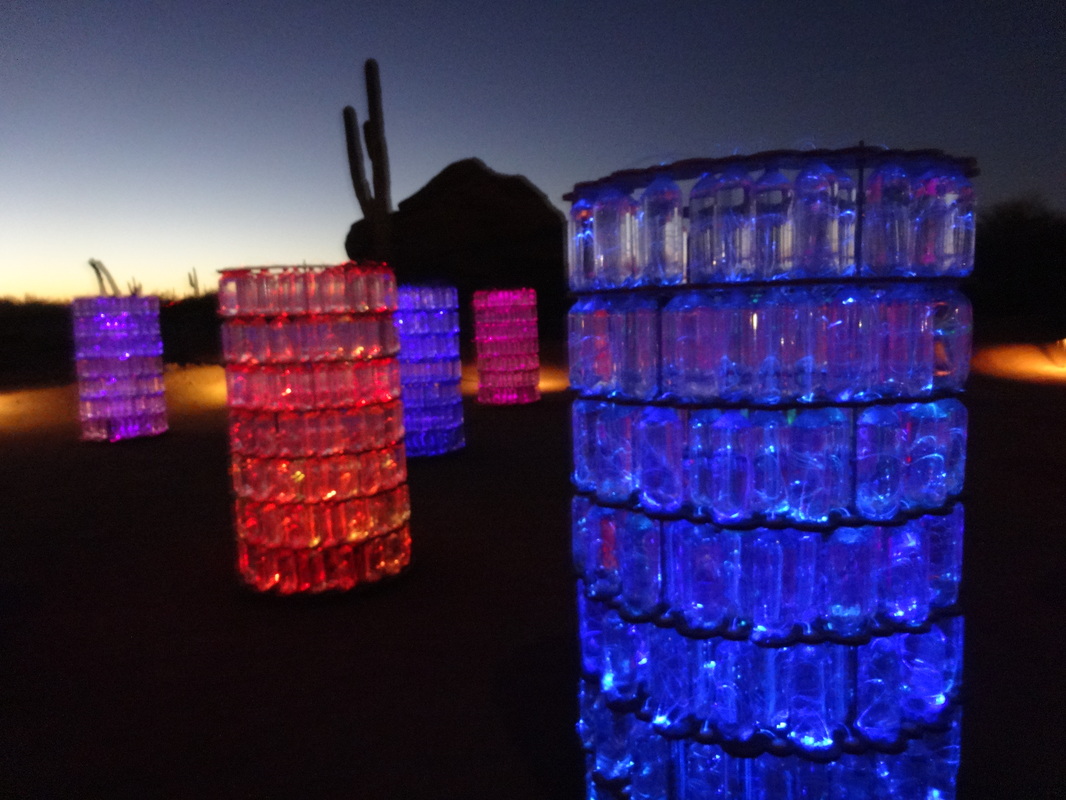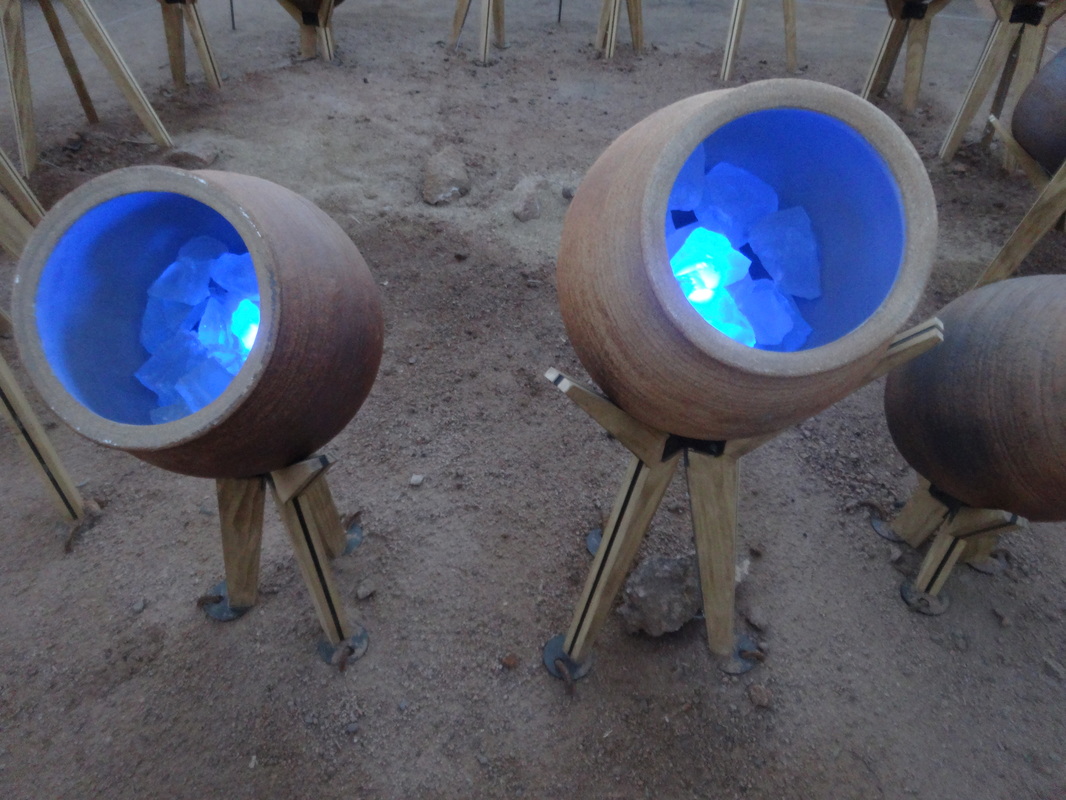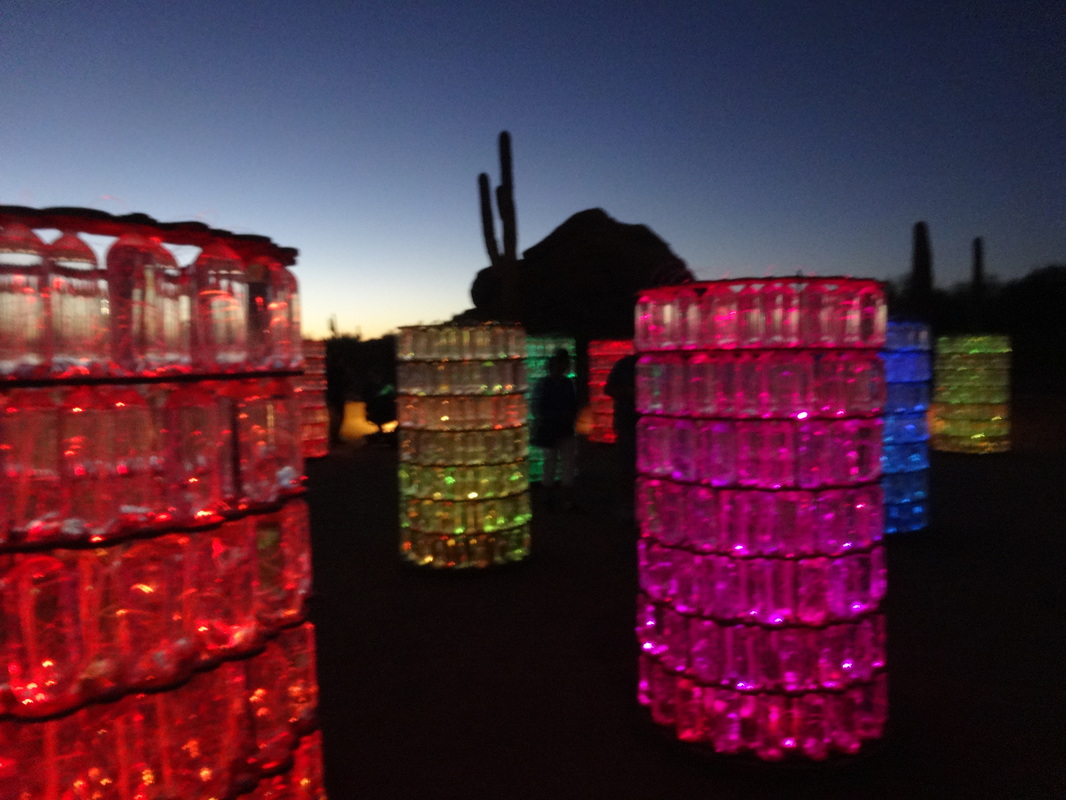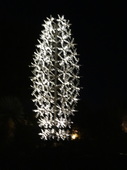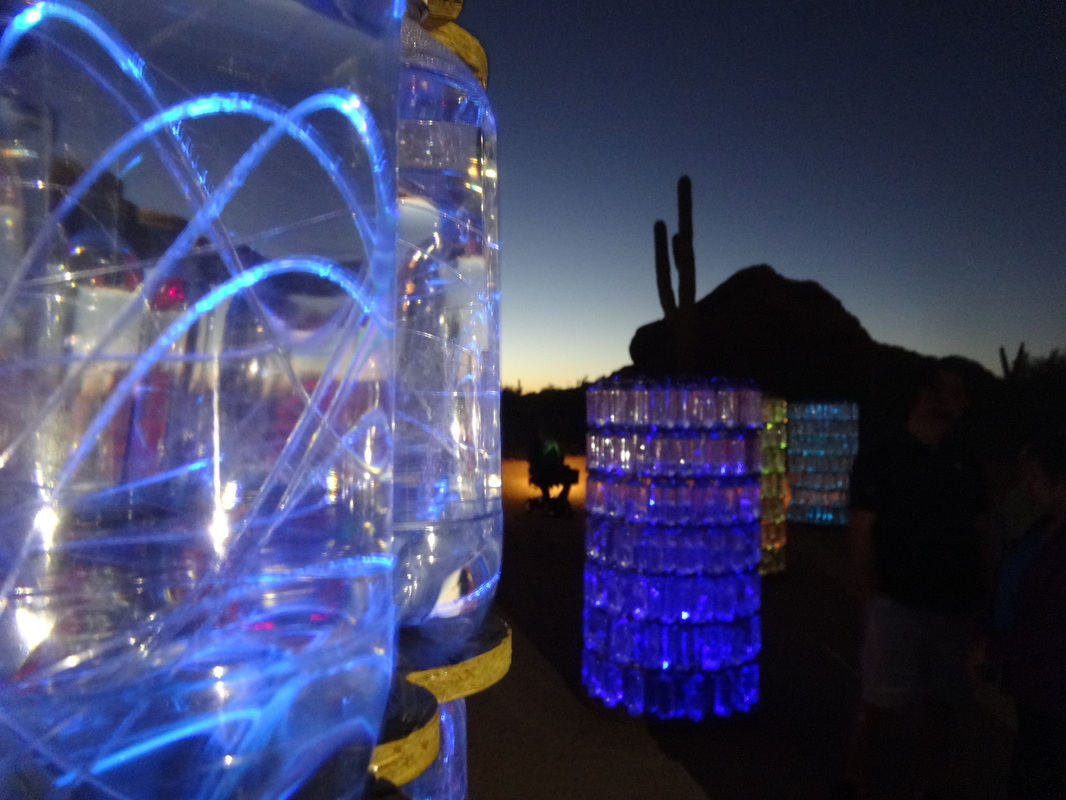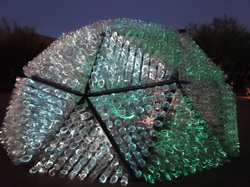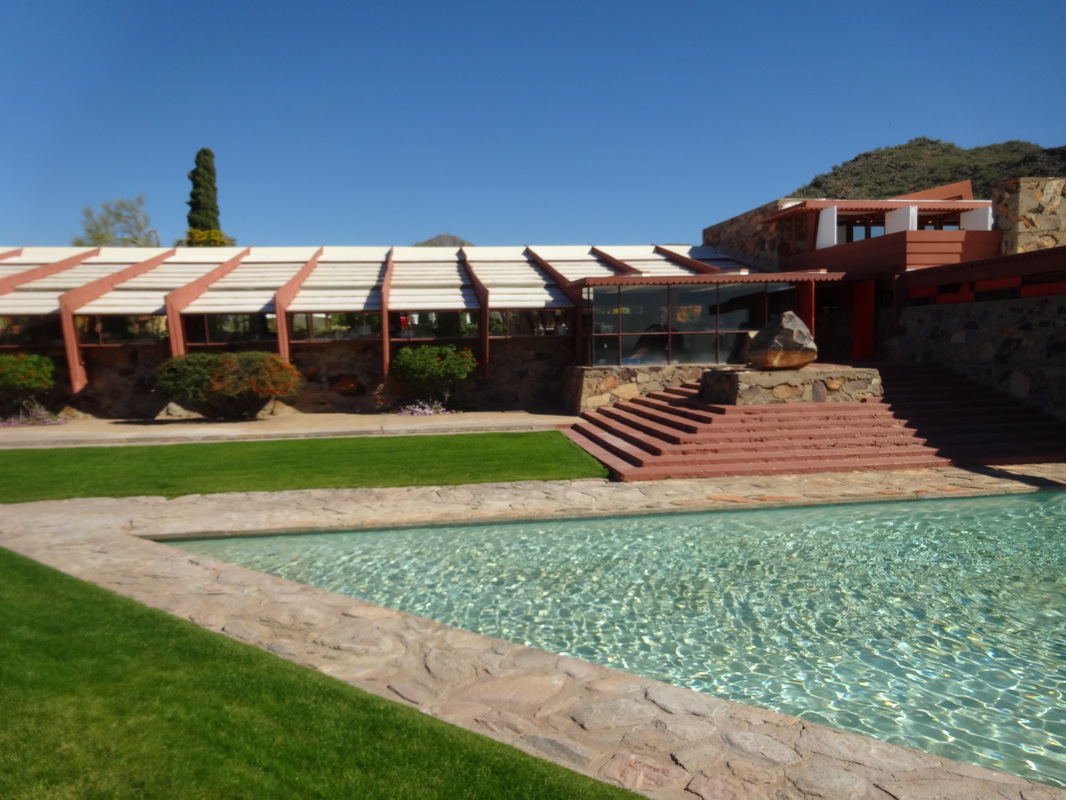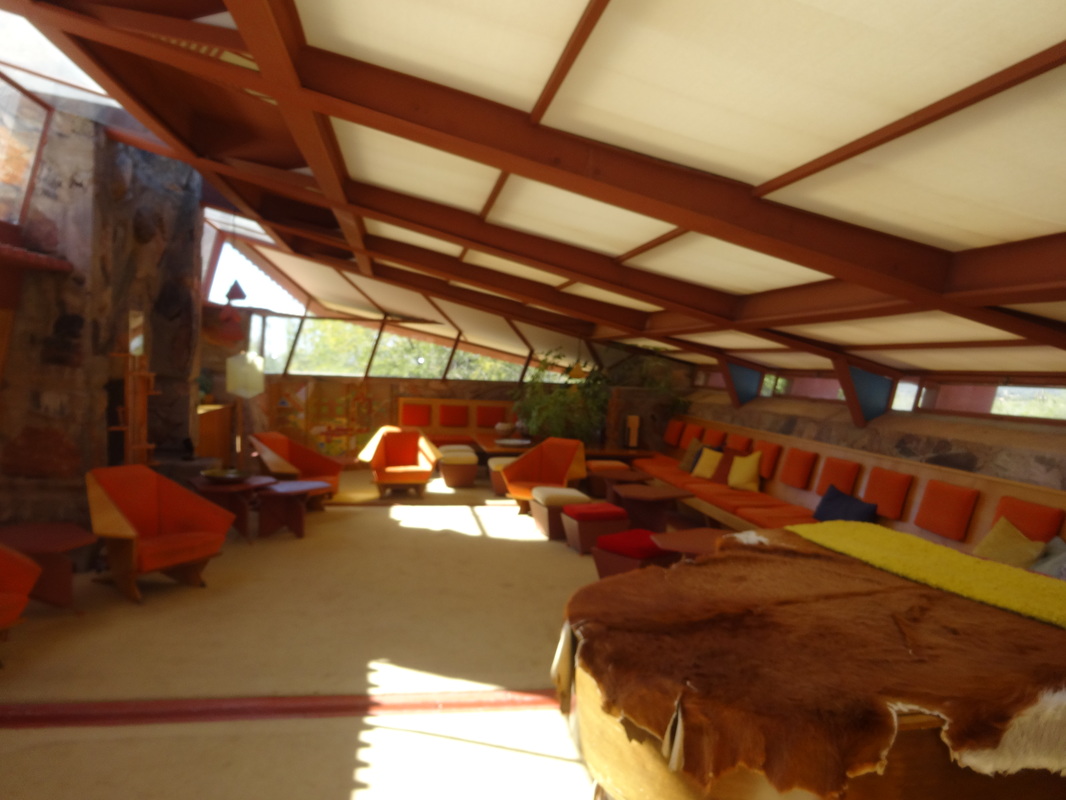Here is Willem de Kooning's 1937-1938 Oil on Masonite painting titled, "Untitled (The Cow Jumps Over The Moon). I learned that de Kooning was trained as a commercial artist and his artistic styles move back and forth between abstract and figurative methods. This painting below is one of his earlier works, which reminds me of Joan Miro's work to some degree. His later artwork, for which he is more well-known, is more gestural and epitomizes the abstract expressionism movement.
I stared at this painting below "Grazing Horses IV (The Red Horses), painted in 1911 by Franz Marc for quite a long time. Not because I love horses, but rather it struck me as fascinating. Franz Marc painted horses a lot, and was known for his preoccupation with animals. I learned that this particular painting was actually his first work of art to enter a museum's collection, the same year it was made. What struck me was his use of unnatural colors in a very natural scene. It's hard to see in the photo, but I was intrigued with the use of bright red in only one or two spots on the horses.
Below is Jasper johns' "The Dutch Wives", encaustic on canvas, created in 1975. If you haven't read my blog article on the Jasper johns retrospective exhibition at The Broad Museum in Los Angeles, you can find it HERE.
Below is a wonderful painting from a German artist that I was unfamiliar with named Corinne Wasmuht. It is titled, "50 U Heinrich-Heine-Str." oil on wood and created in 2009. The painting is a portrayal of Berlin's Heinrich Heine Street subway station and its surrounding neighborhood. It's hard to tell scale from photographs, but this is a huge painting and it's scale immerses the viewer, but the paintings various perspective points and different scales of objects also disorient the viewer. It's really a magnificent painting and I can see why it was gifted to Harvard's Busch-Reisinger Museum. Below are some fascinating samples taken from the Forbes Pigment Collection. Edward Forbes was the director of the Harvard Art Museums from 1909 to 1944. During his tenure, he traveled the world, collecting a large number of pigments for the library. Today, the Pigment Collection contains more than 2,500 samples that are beautifully displayed in cabinets on the 4th floor and are used to this day to help identify pigments used in historical artworks. I came across this wonderful, short video on the Forbes Pigment Collection that was created about 2 years ago. Check it out!
For more information about The Harvard Art Museums, please visit their website: www.harvardartmuseums.org. I definitely recommend visiting the Museum as you're in for a wonderful experience!
0 Comments
The Museum of Contemporary Art is actually comprised of three locations. The first is the MOCA Pacific Design Center in West Hollywood; the second is the MOCA on Grand Avenue; and the newest location is the Geffen Contemporary. There is actually a fourth location in Nevada. Yes! Nevada. The artist, Michael Heizer's artwork titled, "Double Negative" is a work of land art located in the Moapa Valley on Mormon Mesa near Overton, Nevada and was acquired into MOCA's permanent collection in 1985. If the artist's name rings a bell, it's because I recently wrote about his other monumental piece of artwork at the Los Angeles County Museum of Art; CLICK HERE TO READ THE BLOG ARTICLE. I should note that time didn't permit me to visit the Pacific Design Center, or the Geffen Contemporary (or visit Nevada), so this post will only include my visit to the MOCA on Grand Avenue. I also visited the Broad Museum (Read On & See Below.) The Geffen Contemporary is just a 15-20 minute walk from MOCA Grand and admission to one museum grants you admission to the other museum.
The MOCA on Grand Avenue housed an entire gallery room with Mark Rothko paintings. While I can appreciate Rothko's artwork and acknowledge its importance in art history, his paintings are not my favorite. I do love all the colors, and I also love the shapes, however, there is ambiguity, blurring of lines, that doesn't hit me the right way. Rothko wanted viewers to stand close to his paintings to see the vertically stacked bands of color seem to float upon colored grounds.
This large painting on two panels is by the artist, Njideka Akunyili Crosby. It's called "Garden, Thriving" and was completed in 2016. Her artwork was quite fascinating to see in person and I've included a detailed photograph of the two-panel painting. Originally from Nigeria, the artist layers photographic imagery within the chairs' fabric and the plant leaves. The images are pictures of Nigerian pop stars, models, military dictators, celebrities, and the artist's own personal photographs. To create this artwork, she uses acrylic paint, transfers, colored pencils, and collage on paper. There is so much to see in this painting, you could look at it for 10-20 minutes, or longer! I should also mention that the mural that is wrapped around the exterior of the museum is by this same artist!
Three other works by Jackson Pollock from MOCA’s permanent collection, were also on view. These were great examples of the diversity and range of materials Pollock used in his artwork from watercolor to collage. Walt Disney Concert Hall, Los Angeles, California This building is simply spectacular. Frank Ghery is one of my favorite architects and this is a perfect example of why that's the case. (In addition to all the awards he has won for his incredible architectural design). Frank Gehry was asked to devise a new home for the Los Angeles Philharmonic and the Walt Disney Concert Hall opened in 2003. Reflecting Gehry’s longtime passion for sailing, the structure’s exterior features are expanses of stainless steel that hover above Grand Avenue. Frank Gehry has devoted his career to disrupt the very meaning of design within architecture. From the iconic Guggenheim Museum Bilbao to the Fondation Louis Vuitton in Paris, and now the Walt Disney Concert Hall in Los Angeles, Frank Gehry has proven time and again the beautiful magic of his whimsical, cutting-edge design.
The Broad is one of the finest contemporary art museums I have ever visited. Founded by philanthropists Eli and Edythe Broad, the museum houses more than 2,000 works of art and holds one of the most prominent collections of postwar and contemporary art worldwide. The Broad's third floor galleries show a rotating selection of artwork and, best of all, it is free! The first floor galleries are for special exhibitions, like the Jasper Johns exhibit "Something Resembling Truth" that runs through May 13, 2018. So let's talk about the beautifully designed building... It's often called "The Veil and the Vault" because the building has gallery space as well as an extensive storage facility. In contrast with the neighboring Walt Disney Concert Hall, The Broad was designed to be porous and absorptive. There are wonderful olive trees that were planted in the plaza next to the museum. There were a number of artworks by Jeff Koons at The Broad. "Balloon Dog (Blue)" is perhaps one of his series of works that is most famous. The artwork is made of stainless steel and wights 2,000 pounds. It was created as part of his Celebration Series, a group of paintings and sculptures that memorialize rituals, icons, and images related to birthdays, holidays, and other celebratory parties or occasions.
Roy Lichtenstein is one of my all-time favorite pop artists. He was one of the founders of Pop Art in the 1960s and used tiny dots in his artwork, similar to the printing style of comic-books. The dots were placed in such a way to create an image, imitating the way comic-books and newspapers were printed. In addition to borrowing or seeking inspiration from newspaper ads, commercials, and comic books, Roy Lichtenstein also was inspired by some of his favorite artists like Picasso and Mondrian. See the two images below. Here is a sculpture by Roy Lichtenstein, "Goldfish Bowl" created in 1977. It is painted and patinated bronze. On the right is a detailed view, showing that the sculpture is very two-dimensional, despite it looking 3-D. I always love seeing paintings by Chuck Close. Chuck Close is known for his detailed paintings of faces, and later he was known for the deconstruction of that detailed portraiture. He explores portraiture and created this photo-realist painting called "John", painted in 1971-72. I included a detailed shot showing the incredible painting technique. John Baldessari, "Tips for Artists Who Want to Sell" 1966-68, Acrylic on Canvas. John Baldessari never touched this painting, didn't paint it, didn't write the text. Here, it's the role of the artist as the facilitator of the artwork; creating the concept. The humor is that the view is shown the paintings message, but the message is text taken from an art magazine with tips on what art should be. Another one of my all-time favorite artists is Andy Warhol. A short time after Marilyn Monroe died in 1962, Andy Warhol started to create silkscreen images of Marilyn. I learned that Warhol had recently just learned how to silkscreen, so this was a somewhat new process for him! In the painting above, titled, "Two Marilyns" created in 1962, Warhol captures the terrible fact of Marilyn's death, as if he was reporting the news. With silkscreens, the images deteriorate with each printing, which I believe is symbolic of her presence and then her fading into history with her death. It can also be interpreted as the volatility of fame and celebrity. I'm not sure how many versions of "Two Marilyns" were created, but I learned that the one pictured above from The Broad Museum was the 27th version of the silkscreen created. Ellsworth Kelly worked with shapes and solid colors. The painting below, "Green Blue Red" created in 1963, uses colors and shapes to create contrast and bring attention to edges. In the above image on the left, the green rectangle and blue oval are vibrantly displayed against the red background. His composition almost goes against the principal of design of balance. Below, Kelly's oil on canvas painting, "Green Relief with Blue" was completed in 2011. It's actually two conjoined canvases and I've posted the photo of the same painting as seen from different angles. It almost acts like a 2 dimensional painting trying to be a sculpture, with different views from different angles. Jasper Johns: "Something Resembling Truth" A Special Exhibition at The Broad (Through May 13, 2018) While The Broad Museum's main collection has free admission, this special exhibition required a special ticket with a timed entry. The exhibit was one of the best I've ever seen. The exhibit covered over 6 decades of artistic achievement from this iconic American artist. The comprehensive exhibit features more than 120 extraordinary paintings, drawings, prints, and sculptures, by Jasper Johns and draws upon works from within The Broad's permanent collection as well as from loans from over 50 international public and private sources. The imagery he used in his artwork were common items such as American flags, numbers, letters, targets, and light bulbs. Perhaps Johns’ most famous painting, "Flag (1954–55)" and is a fairly accurate representation of the American flag, in encaustic on collaged paper and fabric.
The American Flad is a geometric composition that has a strong sentimental and patriotic value in society. Jasper Johns' flags ofent trick the eye, or blur the lines between perception, reality, and illusion.
Jasper Johns began to incorporate objects and tools used in his artwork directly into the artwork's creation. Things like paintbrushes, color charts, and rulers. In the painting below, the "R" of "Red" is a neon light and wooden letters protrude outward from the canvas. I highly recommend you to experience the Jasper John Exhibit if you can! Also on the first floor was a very unique art installation by artist, Yayoi Kusama, titled "Infinity Mirrored Room--The Souls of Millions of Light Years Away." It is a mirror-lined room that includes LED lights that reflect endlessly in the mirrored space. It doesn't sound like much, but it is quite amazing to see. You need a separate timed ticket, which is free, and only one person can enter the room at a time for a duration of 45 seconds. As you can see, the Broad Museum is quite an amazing experience. I highly recommend you visit The Broad in Los Angeles and experience the art scene in Downtown LA. For more information about The Broad, please visit their website: www.thebroad.org Check out some of my other posts about Los Angeles!
Vinvent Van Gogh's "Irises" is one of The Getty's highlights. Van Gogh painted Irises in 1889 in the garden of the Saint-Remy asylum where he was being treated for his mental illness. It is oil on canvas. I learned that Van Gogh never really thought of this painting as a finished painting, but rather more of a study. It's a great example of his work that demonstrates how he painted en plein air. I'm fascinated with his brush techniques and how he layers color upon color upon color. I've included a detailed image of "Irises." I really loved the special exhibit at The Getty Center called, "Cut! Paper Play in Contemporary Photography." This exhibit that runs through May 27, 2018 features the work of contemporary photographers who use paper in unique and innovative ways. Some of the artists created paper models with images from current events with the intention of photographing them to create their final piece of artwork. While some artists make folds, cuts, or layers to arrange photographs to create something entirely new and innovative. The photo below is the artwork of artist, Soo Kim. To create her artwork, she cuts and layers imagery to create areas of negative space that gives her images a 3-D look. The shadows cast onto the wall are fascinating. I included two detailed shots showing some of the imagery seen in this cut photograph. the other detailed photo shows the beautiful shapes created by the shadows.
The grounds of The Getty are home to wonderful sculptures; there's something wonderful around every corner. Unlike most paintings, sculptures are typically created to be displayed outdoors. Outside, a three dimensional sculpture can be viewed from every angle, a variety of distances, and therefore creating an experience or a special moment for the viewer. The sculpture gardens include artwork from artists such as Joan Miro, Rene Magritte, Alexander Calder, Fernand Leger, Ellsworth Kelly, Roy Lichtenstein, and other artists. Another amazing exhibit was the "Michelangelo to Degas" exhibit that featured new aquisitions that broke records in the art world. The Getty Museum purchased 16 major drawings and one painting from a private collector that includes works by Michelangelo, Andrea del Sarto, Goya, Domenico Tiepolo, and Edgar Degas. Below are three of my favorite pieces from this small but powerful exhibit. From left to right: Edgar Degas' "After The Bath (Woman Drying Herself)" about 1886; Michelangelo's "Study of a Mourning Woman" about 1500-1505; and Edgar Degas' "Two Studies of Dancers" about 1873. I encourage you to go visit The Getty when in Los Angeles--You won't be disappointed! I encourage you to take advantage of the wonderful tours and events that the Getty Center offers such as architectural tours, garden tours, exhibition tours, etc. Also, for families with children, there are Art Detective Cards where kids can find the artworks and solve mysteries while exploring the galleries. For visitors information, please visit: www.getty.edu.
I had the pleasure to go on a Studio Tour at Warner Brothers. There are so many forms of art that go into making movies and television shows; concept art, fashion design, set design, traditional and computer generated animation, etc. It was fascinating to see so many of these art forms come to life in the exhibits on the studio tour. I'll focus this blog on the Concept Art that I saw for the Harry Potter movie franchise. Every element of the films were carefully designed and illustrated through creative and inspiring concept art. The production designer for the films and the art department created hundreds (perhaps thousands) of sketches and full-color renderings that helped to inform the look of the films as well as the fabrication of the props, sets, creatures, characters, and costumes. From the concept art, decisions were made to refine and select and approve final versions. Creating the magical creatures that filled the world of Harry Potter wasn't an easy task and involved a massive team of artists and special effects experts. From the concept art, the Creature Effects team developed 3-D creatures from small maquettes to full-sized animatronic beasts. Some of these sculptures were created so that they can be scanned into a computer and modified digitally in post-production. Warner Brothers Animation is one of the most famous animation studios. I learned that Warner Brothers has won 6 Oscars, 35 Emmys, and 20 Annie Awards (excellence in animation). I remember Warner Brothers for its cartoons featuring Bugs Bunny, Daffy Duck, Porky Pig, Elmer Fudd, Yogi Bear, and Tom & Jerry. Even more notably, Warner Brothers is the home of DC Comics Superhero franchises such as Superman, Wonder Woman, and Batman.
In addition to concept art, Storyboards transform the written words of the script into visual images depicting action in a series of illustrative panels. Storyboards help indicate camera movement, close-up shots, long shots, or other specialty shots. The storyboards help the director and crew design the finished sequence as well as plan the logistics of the shoot itself. The art department is in charge of designing everything photographed in a movie before it is shot. Other visual tools in addition to Storyboards and conept art innclude digital renderings, and models.
Here's a photo of me at the Los Angeles County Museum of Art in front of Chris Burden's sculpture, "Urban Light" installed in 2008. Burden restored over 200 cast-iron streetlamps to create this work of art. Burden was fascinated with urban life and how streetlamps are one of the fundamental building blocks of an urban metropolis. I found it interesting that the streetlamps were recently converted to LEDs, reducing the installations's annual energy consumption by 90%. The conversion to LEDs was funded by the Leonardo DiCaprio Foundation this year. Chris Burden was commissioned by Brandeis University's Rose Art Museum to create a similarly themed sculpture. You can see it by CLICKING HERE in an older blog article about the Rose Art Museum. Chis Burden's "Metropolis II" depicts an urban landscape. Burden created "Metropolis I" seven years before "Metropolis II". The earlier work featured eighty Hot Wheels cars zooming around a model city. This work is much larger and includes 1,100 custom designed cars, 18 highways, and a vast array of buildings and structures. The artwork runs on select days and times, so plan ahead! Richard Serra's "Band" is a massive sculpture that fills a huge exhibition hall from top to bottom, from front to back. The sculpture took two and a half years to develop. Made from over 200 tons of steel, it measures 12 feet high and over 70 feet in length. Below are two views of the same sculpture, titled "Phoenix" by Alexander Liberman, created in 1974-75. I love how a different view of this sculpture creates an entirely new image, a new feeling, a new perspective. "Levitated Mass" (Shown below) was conceived by artist, Michael Heizer, in 1969, but only realized in 2012. "Levitated Mass" is a 456-foot-long concrete pathway, over which sits a 340-ton granite boulder. As you walk down the pathway, it descends to fifteen feet in depth, directly underneath the massive boulder before ascending back up. Below are two views of the same Alexander Calder sculpture created in 1964 titled, "Three Quintains (Hello Girls)." It is made from sheet metal and paint with motor. To me, it appeared to be moved by the wind, but apparently it has a motor that moves the mobile sculpture.
I love this painting below by Vincent Van Gogh, not because I love the imagery, but because it really doesn't look like a typical painting by Vincent Van Gogh! This painting, "Garden of the Rectory at Nuenen" was painted in 1885 in the Netherlands. The browns and grays are vastly different from the vivid, bright colors we are used to seeing in his later paintings when he lived in the south of France. Below is one of Van Gogh's more typical painting style with all the beautiful colors and brushwork. The painting, "Hospital at Saint-Remy" is oil on canvas and was painted in 1889. It depicts the scenery at the institution in the south of France where Van Gogh was being treated for severe mental illness. The Hammer Museum also has other galleries dedicated to contemporary artists. There was a really cool exhibit by the artist, Molly Lowe and another exhibit by the artist, Lawrence Abu Hamdan. Abu Hamdan uses a series of overhead projectors that cast images that have been created with a visualization tool that architects use to map the leakages of sound throughout a structure. The visuals are accompanied by audio that helps transform the research on a Syrian torture prison. I enjoyed looking at the exhibit from a visual perspective, but after reading about the artwork's meaning, it really makes me question my thoughts on conceptual art. Below is a photo of the small room that housed the projectors. Perhaps the most bizarre (in a good way) exhibit was called "Stories of Almost Everyone" featured in the large exhibit hall . It's a group exhibition of 40 artists that is about society's willingness to believe the stories that are conveyed by works of contemporary art. It really hones in on conceptual art and how we look at material objects. Below is a photo of the exhibit hall showing some of the artworks. I'm including a YouTube video that was created by the Hammer Museum with Will Ferrell and Joel McHale, which is very funny and addresses the issues related to conceptual art head-on. Art can be confusing and the fact that the Hammer Museum pokes fun at this, I think, is really bold. "Stories of Almost Everyone" runs through May 6, 2018. For more information about The Hammer Museum, check out their website: https://hammer.ucla.edu/.
In recent years as you've read in my previous blog posts, I visited museums like the Whitney, the Guggenheim, MOMA, the Brooklyn Museum, the New Museum, the Jewish Museum, just to name a few. I encourage you to look through the Categories Listing on the right side of this page and click on what interests you, whether it be museums, cities, or famous artists. The Met has been in the news this past week because it was announced that its admission policy is changing, requiring visitors to pay for admission (the Museum has been pay-as-you-wish for over 50 years). The new admission policy will go into effect on March 1, 2018. Residents of New York State, and students from New York, New Jersey, and Connecticut will remain pay-as-you-wish. Children under 12 will remain free. Be sure to check out their website for more information: www.metmuseum.org I'd recommend purchasing your ticket(s) online and arriving to the Museum when it first opens. You will wish you had more time for your visit if you don't! The line for admission seemed to span the entire length of the huge museum, but having purchased an advance ticket, I was able to walk in a separate door, check in, and head straight into the galleries. Admission will get you into the Met Fifth Avenue, the Met Cloisters, as well as the new Met Breuer. I didn't have the chance to visit the Met Cloisters and the Met Breuer. My visit to the Metropolitan Museum of New York on Fifth Avenue was amazing. First of all, it is massive. I forgot just how large the museum is that is located on the Upper East Side on Fifth Avenue between East 80th and East 84th Streets. This blog post covers my experience of the Metropolitan Museum of Art on Fifth Avenue, mainly what was on exhibit in their Modern & Contemporary Art galleries, 19th and Early 20th Century European Paintings and Sculpture, and some of their Asian Art collection. There were also two special exhibitions going on that I'll include: One on the hugely talented artist David Hockney. And the other on an artist that you may have heard of before, Michelangelo! At the end of this blog, I'll include a few other artistic surprises outside of the Met I encountered on my trip to NYC.
In Marc Chagall's painting shown below, "Le Pont de Passy et la Tour Eiffel," painted in 1911, we experience a fascinating view of Paris and the Eiffel Tower. The important thing about this painting is its composition. Chagall uses several converging diagonal lines: the bright red road, the orange cement wall, and the lines denoting the blue sky. If you think about the time period of the painting, it's interesting to note how it depicts some of the modern changes to the city of Paris, including the Eiffel Tower, the construction of the Pont de Passy Bridge and technologically modern train, electrical power-lines, and how it is juxtaposed alongside the element of the horses and wagon alluding to and earlier time in history.
With the onset of the Industrial Revolution, painters like Fernand Leger incorporated streamlined forms and contours of assembly-line production into their artwork. In the painting shown here, "Three Women by a Garden" painted by Fernand Leger in 1922, three generations of women are depicted. "Woman with a Cat" was painted in 1921.
Piet Mondrian is one of my favorite artists. Here is one of his iconic paintings called, "Composition" completed in 1921. It's an early example of the geometric style of painting that Mondrian called Neo-Plasticism, that emphasized planar relationships in painting, architecture, and design. Many people who look at my own personal artwork sometimes comment that they see hints of a Mondrian influence in my artwork. Here is Mondrian's painting at the Met, next to one of my paintings! Mondrian used black lines to divide the canvas into rectangles that are sometimes painted in shades of blue and red, creating lighter hues by mixing primary colors with white. Later on in his artistic process, Mondrian stopped creating these hues and used pure, primary colors. In comparing his painting with mine, we each use an entirely different process to create our black lines and blocks of color. If you notice, the black line at the bottom right of his painting doesn't quite reach the bottom. To me, it detracts from the overall design. Here are two other artists, whose works are hung alongside Mondrian's at the Metropolitan Museum of Art. I love Jackson Pollock's artwork! The painting below is called "Number 28" and was painted in 1950. His drip and pour paintings are widely recognized as his greatest achievement in art. He used simple sticks or paint stirrers and enamel house paint, sometimes poured right from the can, spilling lines directly onto raw canvas spread on the floor. What I love about his paintings are that the paint on the canvas we see is a record of the artist's creative process and his movement as he walked around all the sides of the canvas. One of the Special Exhibitions on display during my visit was "Michelangelo: Divine Draftsman and Designer." Michelangelo Buonarroti lived from 1475 to 1564 and is celebrated for his excellence of the power of drawing and invention that provided the foundation for all the arts. His drawing skills, design, sculpture, painting, and architecture all combined to give him the reputation of "The Divine One" by his contemporaries. The exhibition showed a range of over 200 works by the artist that was pulled together from 50 public and private collections across the United States and Europe. The exhibit opened in November and is on view through February 12, 2018. Below are just two of his incredible artworks I saw at the Met. #MetMichelangelo During my visit there was a magnificent exhibit of the British artist David Hockney that showcases 60 years of his art career. I highly recommend visiting this exhibit that is at the Met Fifth Avenue through February 25, 2018. David Hockney's painting address translating movement, space, and time into a two dimensional painting. Hockney is probably best known for depicting California swimming pools and backyards in the mid-1960s. Many of his paintings are quite large, perhaps over 6 or 7 feet square. I love how he uses Acrylic paint on canvas.
Alexander Calder created a series of moving sculptures called mobiles that he created in a diverse range of abstract configurations. Shown here, is a free-moving wind mobile that is carefully balanced on a movable pivot point. I learned that he was inspired by the work of Joan Miro, and the similar shapes and forms can be observed in Calder's mobiles. In the video below, you can see the kinetic nature of his mobile, "Mobile" created in 1941 from painted aluminum, steel, steel rod, and wire. Here are some of Claude Monet's masterpieces...
And lastly, I came across these wonderful sculptures created by artist, Jaume Plensa, that are permanently installed at the Grand Hyatt Hotel near Grand Central Terminal. I learned that these two huge sculptures are reminiscent of the Moai sculptures on Easter Island. Overall, my visit to the Metropolitan Museum of Art was simply amazing. I could have spent the entire day looking at all the art and taking photos of every piece of artwork, but I could only include these 6 dozen or so photos! I wish I had the time to visit Met Cloisters and Met Breuer as well. Well, reason for another visit! I hope you enjoyed this blog and I welcome your comments! Have a friend who would enjoy reading this blog? Then please share it with them via email or social media! You can click on the Facebook and Twitter buttons below! PS: If you liked this article, you might like these other articles on my artistic travels:
Kennebunkport, Maine Los Angeles, California New York City Street Art Napa Valley, California Park City, Utah Barcelona, Spain Caribbean Art Last month I visited Napa Valley and had the pleasure of visiting Yountville, St. Helena, and Napa. The region of Napa Valley is known for incredible wine, so it was no surprise that it had incredible art as well. During my visit, I visited a few wineries and did a few wine-tastings all in two days. I learned that many of the vineyards in the area have art galleries associated with them. I'll write about the artistic things that I came across, however, my blog is by no means a comprehensive listing of all the artistic offerings of this incredible region in California. I had an amazing time at Kelham Vineyards, where I was lucky to have an incredibly delicious, gourmet dinner. Kelham Vineyards also sells a number of prints by the French artist Gerard Purvis. The artsist is best known for creating original sculptures & prints made from wine bottle foils. To my knowledge, Gerard Purvis' work can only be found in the United States at Kelham Vineyards. For more information, please visit: KelhamVineyards.com and kelhamvineyards.com/Puvis.html. The next day, the first stop was in St. Helena at the Alpha Omega Winery, which was one of my favorites: aowinery.com. At our next stop, I enjoyed a private luncheon in Yountville at Cliff Lede, which is where I came across some very cool art. For more information about Cliff Lede, please visit: cliffledevineyards.com. Outside of the private tasting room on a beautiful terrace were these two incredible sculptures. I only wish my photos were better to really capture these sculptures. I posted the photos here: The private tasting room, called the White Room, named after the Beatles White album, also had some very cool art in it. The lunch for our private party was served directly in the Tank Room where we saw the innovative technology used in producing their delicious wine. Looking up toward the White Room, were some beautiful paintings, which I posted here below. That evening, I dined in Napa and had the pleasure of strolling around the town and exploring a number of public art sculptures in town. Many of the sculptures were part of the Napa Art Walk. The Napa Art Walk is a bi-annual, rotating exhibition of juried sculpture created by artists from the Western United States. For more information, please visit: www.napaartwalk.org. Based in Napa is the Art Association of Napa Valley, which is a private, nonprofit arts organization that enhances life for the Napa Valley by supporting arts and culture in the area. Their website includes an artist listing, newsletters and class and event listings. Located in Downtown Napa at 1307 First Street is an art gallery that features the work of members of the Art Association Napa Valley. For more information, please visit www.artnv.org. The Yountville Art Walk was one of the highlights of my trip to Napa Valley. Known for the finest food and wine in the country, Yountville is also known for art. The Napa Valley Museum is located in Yountville. For more information, visit www.napavalleymuseum.org. Beautiful sculptures lined the streets of Yountville. I learned that in 2010, Gordon Huether partnered with Yountville Arts to establish the Yountville Art Walk. More information about Gordon Huether can be found on his website, www.gordonhuether.com. The sculptures are for sale, with a percentage of the proceeds going to Yountville Arts Fund to support their arts-related activities, programs, and events. Based on my observation, the sculptures ranged in price from $6,000 to $60,000! Yountville was a terrific place to explore and experience some great public art. Below are some photos of just a few of the sculptures I had the pleasure of seeing during my time in Yountville. For more information about Yountville Arts, please visit www.yountvillearts.com. See this beautiful, bright yellow painted piano reminded me of the piano I painted as part of the Celebrity Series of Boston's Play Me I'm Yours StreetPianos Boston 2016 Public Art Installation. To learn more about the piano I painted, please click the link to visit: StreetPianos Boston City Hall Plaza 2016.
There is so much to see and do in the Napa Valley Region. I barely scratched the surface of the art offerings the region has to experience, but I hope that this blog article inspires you to visit the area and explore on your own! I know that I'm already excited about the possibility of returning to the Napa Valley and exploring more the art world has to offer! PS: If you liked this article, you might like these other articles on my artistic travels:
Kennebunkport, Maine Los Angeles, California New York City New York City Street Art Park City, Utah Barcelona, Spain Caribbean Art
The Main Street area is pretty cool and full of history. If you look closely, you'll see that some of the older buildings have plaques on them that describe the history of the area as well as interesting facts about the architecture. For example, The Frankel Building was constructed in the mid-1800s and burned down in the Great Fire of 1898. It wasn't until 1966, that the building was renovated to establish the Silver Palace Saloon and later housed a variety of other shops. The Frankel Building is a typical example of mining town vernacular architecture and features large display windows and a recessed entryway. The brick walls demonstrate the preoccupation with using more fire resistant materials. (Sorry, no photo of the building, so you'll just have to visit yourself!)
Main Street Art Galleries: All along Main Street are some fabulous art galleries. There is a Park City Gallery Association which hosts a Last Friday Gallery Stroll. On the last Friday of each month, from 6-9 pm, the Park City Gallery Association features artists, special exhibits, and art events. The Stroll is a free community event that gives local residents and Park City visitors the opportunity to explore Park City's art scene. The remaining dates for 2017 are August 25th, September 29th, October 27th, November 24th, and December 29th. Check out their website: www.parkcitygalleryassociation.com for more information.
For more than 40 years, the Kimball Art Center has inspired and connected the Park City community through art. The Kimball Art Center is a world-class community art center and Park city's cultural hub. The nonprofit center provides art education, free exhibitions, quarterly Art Talks, gallery tours, and a variety of events to the public, including the annual Park city Kimball Arts Festival that attracts more than 50,000 people to Par City's historic Main Street. They provide over 300 visual arts classes for all ages and free educational programs for K-12 schools in Utah. The Kimball Art Center is located at 1401 Kearns Boulevard. More information can be found on their website: www.kimballartcenter.org Sundance: A short ride from Park City took me to the Sundance Mountain Resort in Sundance, Utah. The resort is owned by Robert Redford; Redford hosted the first Sundance Film Festival in 1985 to promote independent films. Perhaps the two films I'm producing, "Dan and Carla" and "Avery's Sin" will end up at Sundance in the near future!!! While at Sundance Resort, I took a scenic chairlift up Sundance Mountain to Ray's Summit at 7,150 ft. and hiked down to Stewart Falls, returning back to the main area. The hike was pretty intense (at least for me), but I was rewarded at the end with a cold drink and a view of a really cool sculpture set on a beautiful pond. Close to the main area, I came across this wonderful sculpture: Allan Houser's bronze sculpture, "Prayer Song" located in front of the Rehearsal Hall and pond at Sundance. The Sundance Art Gallery is located in the Art Studio and features a number of exhibiting guest artists. The Art Studio has daily workshops in jewelry making, wheel-thrown pottery, journal making, soap making, watercolor, acrylic painting, oil painting, printmaking, and drawing and are open to both resort guests and day visitors. More information about Sundance Mountain Resort can be found at: www.sundanceresort.com More information about the Sundance Art Studio can be found at: www.sundanceresort.com/art-studio I have no doubt that there is so much more to the art in Park City and the surrounding areas in Utah, beyond what I've written here, but it's my hope that you'll read my blog and perhaps explore on your own art adventures! Wishing you Creative and Happy Travels! PS: If you liked this article, you might like these other articles on my artistic travels:
Kennebunkport, Maine Los Angeles, California New York City New York City Street Art Napa Valley, California Barcelona, Spain Caribbean Art I recently had the pleasure of visiting Puerto Rico and traveling to various islands in the Caribbean on a family vacation this summer. It was a wonderful trip, filled with all the expected highlights one would expect such as sun, sand, beach, sightseeing, and adventure. But I didn't expect to see some incredible artwork during my time in Puerto Rico and on my cruise vacation. I should note that by no means is this blog article a complete and accurate picture of the art of Puerto Rico or Curaçao. The following are just a few of the things I came across that struck my eye. In Puerto Rico, I did not have the chance to visit the Puerto Rico Museum of Art http://www.mapr.org/es or the San Juan Museum http://sanjuanciudadpatria.com/en/services/arts-culture-and-innovation/san-juan-museum/sanjuanciudadpatria.com/en/services/arts-culture-and-innovation/san-juan-museum/ What I discovered weren't major art installations in world-renowned art museums, or famous public art, but rather art that really captured the flavor of the local area. After my visit to the Curaçao Museum, I took a walk near the water to get into the main shopping area. Along the water in Curaçao, is the famous floating pontoon bridge. This public artwork by Frank Van Der Loo was placed along the water near the pontoon bridge's entrance. Although the coloring of the artwork was faded (especially apparent from the real-life view across the water of the characteristically vibrantly-colored buildings), I really liked this mural. It reminded me of the mosaic shapes I use in my personal artwork. Especially the mosaic-like shapes shown in the sky and in the lower portion of the mural. In Curaçao, I came across a storefront that is operated by the Art Foundation Curaçao. They teach classes and provide art programs for at-risk youth. Art Foundation Curaçao is a non-profit organization founded based on the idea that people of Curaçao are creative and talented and that Curaçao has all the ingredients to become an art destination. On sale in the gallery were "Curaçao Cubes" created by local children in foster homes in a workshop titled "Big Power of Small Blocks." The proceeds from the sale of the approximately 4"x4" painted wood blocks go back to the foster homes for more free art classes. One of its projects is the Plein Air Curaçao. Plein Air painting is a painting created in the open air; a form of rapid painting with the start and ending of a painting usually in one session of about 2-3 hours. Natural light changes over time, so the quick nature of painting with broad strokes creates impressions of reality as seen through the eyes of the artist. Plein Air Curaçao is a bi-annual international art festival. For more information, please visit www.pleinaircuracao.com. Not far from there was the Jewish Cultural Historical Museum, adjacent to the Mikve Israel-Emanuel (the oldest Synagogue in continuous use in the Western Hemisphere, The museum housed numerous Jewish ritual objects as well as information about Dutch Jewry and the Jewish community of Curaçao. For more information, please visit: http://www.snoa.com/museum
I should mention the Cruise ship's art galleries and the on-board art auctions that are common on all the major cruise-lines. The art auctions were operated by Park West and all I care to say about this is that I found this online article that I found to be an accurate representation of my experience on the ship. Although I did not purchase any artwork from Park West on the ship, I did find it to be a fascinating experience interacting with their staff, viewing their artwork, and participating in their on-board auction champagne reception event. https://www.bloomberg.com/news/features/2016-12-14/ever-bought-artwork-on-a-cruise-prepare-to-be-seasick That said, the cruise was wonderful and all the artwork I saw on this trip was amazing. I highly recommend visiting Curaçao and I welcome your comments! PS: If you liked this article, you might like these other articles on my artistic travels:
Kennebunkport, Maine Los Angeles, California New York City New York City Street Art Napa Valley, California Park City, Utah Barcelona, Spain Part 1: Barcelona Architecture One cannot talk about Barcelona's architecture without mentioning Antoni Gaudi. Part of the Modernista movement of the late 19th Century, Antoni Gaudi is Barcelona's most famous architect. Almost anywhere you look in Barcelona, Gaudi had some part in its creation, from the houses, apartment buildings, churches, sidewalks, parks, and even the city benches lining the streets. In Modernism, nature was a huge element present in decorative motifs as well as present in the actual architectural structure of Gaudi's buildings. Below are some of Gaudi's masterpieces, but there are dozens of others throughout Barcelona to visit and experience. Casa Batllo I really enjoyed seeing Casa Batllo, which is situated on a main street in the heart of Barcelona. Mosaic is everywhere. The Chimneys of the building are works of art. The roof is representational of a dragon's back. The exterior facade demonstrates Gaudi's expert use of texture and color. Below are some photos of the exterior of the building as well as the interior. The sidewalk tiles as shown in the photos below line the streets and feature an underwater, marine-life motif. Sagrada Familia Gaudi's Sagrada Familia is innovative and highly symbolic. The architect's objective was to explain the teachings of the Church through sculpture and architecture. Following Gaudi's death, work on the Sagrada Familia continues to be carried out by collaborating architects and artists. The project is expected to be complete by 2026, coinciding with the 100th anniversary of Gaudi's death. The stained glass windows were perhaps one of the most beautiful aspects of the Sagrada Familia. The colors were so vivid and bright. Park Guell Park Guell is another one of Gaudi's masterpieces. It was build between 1900 and 1914. It was opened as a public park where Gaudi let his imagination run wild with his incredible use of mosaics throughout the park. Below are some photos of Park Guell. The mosaic work is unbelievable and reminds me very much of the mosaic illusion that I paint in many of my own paintings. La Pedrera La Pedrera is also known as Casa Mila. It was completed in 1912 as an apartment building. There are curved walls that seemingly defy the laws of gravity. The rooftop is amazing at night and includes all of Gaudi's architectural trademarks. Bricks in the attic create arched ceilings and are uniquely used using the log side of the brick, which also features the brick-maker's fingerprints. There are terrific wrought iron balconies and exquisite ceramic mosaics. I highly recommend visiting La Pedrera by booking a night tour, which includes a full tour of the building and a surreal visual light display on the rooftop under the stars, followed by a champagne toast and cookies! Although my time in Barcelona didn't permit me to visit the Palau Guell, I should mention that it is an excellent example of one of Antonio Gaudi's early architectural masterpieces. It is a UNESCO World Heritage Site, and is a magnificent example of domestic architecture in the context of Art Nouveau and one of the first important commissions Gaudi received at the start of his career. It is located just steps away from La Rambla, not far from La Boqueria. Part 2: Barcelona's Art Museums and Fine Art A Guide to Visiting Barcelona's Museums: If you plan to visit Barcelona, I highly recommend purchasing the Barcelona Museum Pass, also known as an art passport from ArtTicket BCN, which will give you access to six Barcelona museums, including the ability to skip the lines. The Passport give you access to the Picasso Museum (Museu Picasso), the Joan Miro Museum (Fundacio Joan Miro), the National Museum of Art of Catalunya (Museu Nacional d'Art de Catalunya), the Antoni Tapies Museum (Fundacio Antoni Tapies), the CCCB, and the MACBA. I purchased the passport online (for 30 Euros), and simply showed the ticket to the first museum I visited to receive the passport. The passport is stamped upon entry at each museum. To learn more about the ArtTicket BCN, check out their website: http://articketbcn.org/en/barcelona-museum-pass. I should also mention that it is very important to check the hours of each of the museums as they vary significantly. Most museums, with a few exceptions, are closed on Mondays. Also, all city museums are free at last one afternoon per month, so be sure to check the websites in advance for hours and special exhibition dates. If you're interested in contemporary art, check out this website that provides a network devoted to contemporary art in Barcelona: http://www.artbarcelona.es/circuit/en/. Picasso Museum in Barcelona The Museu Picasso of Barcelona is a wonderful center documenting Pablo Picasso's early years of apprenticeship. With over 4,000 works of art in its permanent collection, you'll see why this museum is one of the most popular tourist attractions in Barcelona. The Picasso Museum highlights the artist’s relationship with the city of Barcelona. I learned that Pablo Picasso's father was a teacher at the San Telmo Fine Art and Crafts School. and had an important influence on Picasso's future career as an artist, who demonstrated a strong interest in art from a very young age. There are some drawings and small panels in oil that give an idea of his efforts to give his own creativity free rein and explore new techniques by taking in his immediate environment. In Barcelona, Pablo Picasso continued his art education at the La Llotja Fine Art School. The photos here show his artwork featuring Barceloneta Beach and two ports. After taking these photos, I learned that photos were not allowed, so unfortunately, I do not have photos showing the rest of the museum. This Picasso museum focused on his earlier works, and very few on display were "well-known Picasso masterpieces." The museum highlighted Picasso's creative process of some of his work of his Blue Period. Some of the highlights of the museum included Las Meninas Series. This was a series of paintings based on the Velazquez painting Las Meninas. For more information, please visit www.museupicasso.bcn.cat. Fundacio Joan Miro The Joan Miro Museum (Fundacio Joan Miro) is located in the Montjuic area of Barcelona and houses the work of Joan Miro as well as temporary exhibitions of 20th and 21st Century art. The collection of paintings, sculptures, drawings displayed at the museum is one of the most comprehensive collections representing every stage of Miro's career as an artist. There are paintings related to Surrealism and works based on the Spanish Civil War. Miro's work on large canvases in the late 1970s onward demonstrate his use of large color fields and painting with free gesture. For more information, please visit www.fmirobcn.org.
Museums Further Afield from Barcelona: In the town of Girona, I visited the Museum of Jewish History. The goal of the Museum is to preserve the history of the Jewish communities of Catalunya. Art at this museum included various Jewish ritual objects. Be sure to visit if you are in Girona, which is not far from Figueres, where the Dali Museum is located.
On of my favorite pieces was this one below entitled, "Gala Contemplating the Mediterranean Sea which at a distance of 20 meters is transformed into the portrait of Abraham Lincoln (Homage to Rothko).” Gala was his wife and muse for many years. The exterior of the museum is a work of art as well. Statues with loaves of bread on their heads. Inside the museum in the open air courtyard is a spectacular and wild work of art called, "Rainy Taxi". If you put a Euro in the slot located at the base of the artwork, it will rain inside the taxi, and an umbrella will open up on top of the artwork!
The museum includes paintings by Old Masters with works from the 13th Century to the 18th Century. The largest section of the museum is devoted to works from the 19th and 20th Centuries and includes a wonderful selection of Catalan painting and sculpture of the Modern period. I was very impressed with their collection of paintings by the great masters of French and international impressionism (Degas, Sisley, Monet, Pisarro, Sargent, etc.). Picasso and Dali, avant-garde artists are also well represented! Part 3: Barcelona's Public Art The streets of Barcelona are filled with art by world renowned artists. Below are just a few of these that I came across on my artistic journey.
PS: If you liked this article, you might like these other articles on my artistic travels:
Los Angeles, California New York City New York City Street Art Napa Valley, California Park City, Utah Caribbean Art
 If your favorite color is blue, like it is mine, then you'll enjoy the exhibit at the Brooklyn Museum called, "Infinite Blue." The exhibition's title hints at the connection between the color blue and the idea of spirituality as written by Russian artist Vasily Kandinsky, "On the Spiritual in Art." Blue is often associated with the heavens and the spiritual because blue is the color of the sky. The artwork featured in "Infinite Blue" feature every variety of the color blue from ancient times to the present. The exhibit includes a wide range of artwork from the museum's permanent collection of Asian, African, Egyptian, American, Native American, and European art: paintings, sculpture, prints, drawings, etc. My understanding is that this exhibit will expand to other areas of the first floor of the museum over time. My favorite blue is Cobalt Blue. On display were a variety of blue and white ceramics from the Middle East. The use of Cobalt in the Middle East likely inspired the Chinese to use the pigment. In the artwork below and the detailed close-up, artist Arlene Schechet has created handmade papers from abaca, a plant native to the Phillippines. The Flow Blue series, from which this work derives, is named after a British transfer pottery from the early 19th century. For more more information on the exhibit, use the hashtag #infinitebluebkm. The museum also had a number of wonderful pieces from Alex Katz, Georgia O'Keeffe, Diego Rivera, Claude Monet, Henri Matisse, Edgar Degas, and Auguste Rodin. Here are a few paintings on exhibit. Having walked from Manhattan to Brooklyn over the Brookyn Bridge earlier that day, I really appreciated Georgia O'Keefe's painting of the Brooklyn Bridge. I had always thought that most of her artwork was in the same genre of the Ram's Head painting below. Georgia O'Keefe's painting of the Brooklyn Bridge emphasizes the abstract elements of the composition. This painting was one of her last works of art painted in New York before relocating to New Mexico in 1949. Luce Center for American Art: Visible Storage Study Center: One of the many wonderful surprises at the Brooklyn Museum was discovering the Visible Storage Study Center. The beautiful display gives you an inside look at how museums work and provides you with a glimpse of the breadth and scope of the Brooklyn Museum's collections. The Visible Storage Study Center contains artwork organized and identified by the accession number assigned by the museum's registrar. Visitors can learn more information about the object by entering an item's identification number on a special web site at computers located throughout the space. I had the opportunity to see the Marilyn Minter "Pretty/Dirty" exhibit that was on display at the Brooklyn Museum from November 4, 2016 to April 2, 2017. The exhibit featured many over-sized paintings showing seductive and sexual visual statements. The artwork included paintings and videos mostly sexual in nature. The photographs, paints, and videos in one gallery focus on licking, dripping, and devouring mouths. I believe it is a commentary on American culture's inexhaustible appetite for glamour and stimulation. I've included a few photos from the exhibit below. The Dinner Party by Judy Chicago is the most significant icon of 1970s American feminist art. It took Judy Chicago 5 years to complete the project from 1974 to 1979 with the help of hundreds of collaborators. The Dinner Party represents 1,038 important mythical and historical women, most of whom had been neglected by history. The Dinner Party consists of a series of Entry Banners, Heritage Panels, a Heritage Floor, and a huge ceremonial triangular banquet table measuring 48 feet on each side with a total of 39 place settings. The Dinner Party is housed a the Brooklyn Museum as the central installation of the Elizabeth A. Sackler Center for Feminist Art. The Table is in the shape of an open equilateral triangle, a symbol of equality. Each place setting represents a woman of great historical significance, either real of mythical. The Heritage Floor beneath the table is comprised of 2,300 porcelain tiles. The Brooklyn Museum was a fascinating experience. Check out the Museum in you are in the vicinity. You won't be disappointed!
Just recently, on February 14th, I came across an editorial article on Artsy.net by Isaac Kaplan entitled, "Do Francis Picabia's Anti-Semitic Remarks Tarnish his MoMA Retrospective?" After reading the article I learned about Picabia's anti-Jewish feelings (and womanizing behaviors). MoMA's exhibit apparently does address this part of Picabia's character; however, I must have missed this as I walked through the gallery. To answer Kaplan's question personally. I think it does, in fact, tarnish his reputation. I really enjoyed his artwork during my visit to the MoMA. But after learning more about the artist, I can't say that I can admire him. Famous artists are people that I want to look up to and admire. They are people that I want the next generation of artists to look up to. And so, while I can appreciate his artwork at face value and his artistic technique, learning about his anti-Semitic behavior does take him down several notches in my book. Similarly, just like we want our kids to admire our professional sports players, it's hard to have our kids look up to them if they do drugs, treat women badly, are anti-gay, or are anti-Jewish, or discriminate in any way. So, I'm kind of let down after my great experience viewing his work in the gallery. But for this blog article, I will continue to proceed sharing my thoughts on the exhibit as if I hadn't learned of his anti-Semitic feelings and behavior. Here is the link to the article for your information: https://www.artsy.net/article/artsy-editorial-francis-picabias-anti-semitic-remarks-tarnish-moma-retrospective As I walked though the gallery rooms, the one thing that struck me the most was how his artistic style changed throughout his lifetime. Picabia was an artist of many genres, and his body of work lacks consistency and categorization. He shifted styles over time. The exhibit highlights his impressionist landscapes, abstract works, paintings, photo-based nudes, etc. Here are some photos from the exhibit. These two Picabia paintings shown below reminded me of one of my own paintings that I painted earlier this past year, "Woof Woof! Gotta Get My Bone." All three works utilize black lines in a similar fashion. I should note that my painting was created without ever seeing Picabia's work; I am just noting the coincidence in how we both used these lines in the same fashion. "Revolutionary Impulse: the Rise of the Russian Avant-Garde" was another wonderful temporary exhibit at the Museum of Modern Art that runs through March 12, 2017. The fact that all the artwork on display comes directly from MOMA's permanent collection, demonstrates how wonderful MOMA is and how impressive their permanent collection is. Of all the artwork on view, there were two artists whose work caught my eye. The two photos below are from the Russian artist Alexandra Exter. The oil on canvas painting on the left, called "Theatrical Composition" was very intriguing to me. I loved the colors, shapes, and overall composition of the painting. The other smaller works, pictured to the right are six designs from various stage sets like The Merchant of Venice, Othello, and others.
To photograph all the well-know paintings from all the famous artists would be a huge undertaking. So I'm including a small selection of some of my favorite pieces along with some detailed close-up photos from the following artists: Georges Seurat, Vincent van Gogh, Pablo Picasso, Jasper Johns, Henri Matisse, Fernand Leger, Jim Dine, Andy Warhol, Edward Ruscha, Josef Albers, James Rosenquist, Robert Rauschenberg, and Sol LeWitt. I have the close-up photos to show the brushstrokes, the detailed use of color, and a glimpse into what the artist was focused on while painting their masterpiece. Pablo Picasso's Guitar Sculpture (3 views), and below, "Vase of Flowers" & "Les Demoiselles d'Avignon I highly recommend visiting the Museum of Modern Art in New York City. More information about the museum can be found on their website: www.moma.org. PS: If you liked this article, you might like these other articles on my artistic travels:
Kennebunkport, Maine Los Angeles, California New York City Street Art Napa Valley, California Park City, Utah Barcelona, Spain Caribbean Art
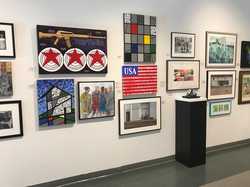 The exhibit's juror is Judith Klein of Judith Klein Art Gallery, New Bedford, MA. I highly recommend checking out this exhibit before it closes on February 2, 2017. Upcoming exhibits at the Attleboro Arts Museum look amazing as well, so if you're in the Boston Area or Providence, RI, be sure to check out the small but wonderful Attleboro Arts Museum. For more information about the exhibit: http://attleboroartsmuseum.org/members-exhibition-2016/ This past week I had the pleasure of visiting two of my favorite Art Museums in the Boston area. What I love about art museums is the special combination of new temporary exhibitions and spectacular permanent collections. The Rose Art Museum The first museum I’ll write about is the Rose Art Museum, located in Waltham, Massachusetts. On a personal note, the Rose Art Museum is special to me because it is part of Brandeis University, my alma mater. As part of my art education at Brandeis university, I had the unique opportunity to tour the Rose’s amazing permanent collection—however, not exhibited on the walls of the museum, but rather in the museum’s storage vault. In the mid-1990s, I saw incredible works from the collection from Roy Lichtenstein to Andy Warhol to Willem de Kooning to Jasper Johns. With over 8,000 works of art, mostly from American Artists from the 1960s and 1970s, the Rose Art Museum is one of the leading art museums in the world. Use the following link to see the digital collection: http://rosecollection.brandeis.edu/ This week the Rose Art Museum was exhibiting a temporary retrospective exhibit on the artist Rosalyn Drexler. The exhibit, “Rosalyn Drexler: Who does She Think She Is?” recently closed, but I believe it is traveling to other museums in the coming months.
The Museum of Fine Arts Boston The following day I had the opportunity to visit the Museum of Fine Arts Boston, which houses one of the world’s best and diverse collections of fine art including contemporary art, art of Asia, Oceana, Africa, Europe the Americas, art of the ancient world, and jewelry, musical instruments, prints, drawings, and photographs. Although I didn’t get to see everything in the museum, I was able to see some of my favorite works of art again as well as see some new things and very cool new temporary exhibits. And while I’m more of a contemporary and modern art kind of guy, I was particularly impressed with the story behind a 13-foot-tall statue of a classical sculpture of Juno. The Roman marble lady is the largest Classical sculpture in any museum in the United States. But perhaps even more fascinating was where the statue was found; It was found in the backyard of a Brookline, Massachusetts home (a suburb of Boston). The statue that is dated to about the year 1633 was purchased at the end of the 19th Century in Rome and brought to Brookline, Massachusetts to be placed as part of a formal garden.
The Danish artist, Jeppe Hein’s work entitled “PLEASE…” is a neon light installation from 2008. Hein is fascinated with the relationship between the viewer and his artwork and the art really isn’t complete without the viewer’s participation. I really can relate with Jeppe Hein and his work because some of my artwork also has a similar element to it. My paintings entitled “Close Your Eyes” and “You Have To Read This” come to mind when thinking about Hein’s work. With “Close Your Eyes” I’m trying to convey to viewers a bit of edginess or something to make you think twice about what you are seeing. I really enjoy the irony of creating art that is visual, and then the message of the painting instructs you not to look at it. “Close Your Eyes” was selected in the prestigious Connecticut Academy of Fine Arts Annual Juried Art Exhibit a few years ago. The six works of art are pictured here. http://www.jeppehein.net/ Throughout the museum (and around the Museum and even in Faneuil Hall in Boston) is the Megacities Asia exhibit, which runs until July 17, 2016. Megacities are cities with populations of more than ten million. These megacities are increasing in numbers and changes the lives of so many people. I was really impressed with the works of the artists Ai Weiwei and Choi Jeong Hwa. Choi Jeong Hwa’s “Breathing Flower” located just outside the museum was very moving. http://aiweiwei.com/ http://choijeonghwa.com/
I recently returned from a quick 2-day trip to New York City. The first day was primarily focused on a new movie I am working on (currently looking for investors for the film) called “Dan & Carla.” We had a spectacular table reading of the script with the actors along with a number of friends and interested parties of the film. After the reading, I had the pleasure of meeting and speaking with Jack Pierson, a longtime family friend of the film’s director. Jack Pierson is an incredible artist who works with a variety of different mediums, including sculpture, photography, video, and is best known for his word signage installations. His artwork is in the permanent collections of the Whitney Museum of American Art, the Metropolitan Museum of Art, the Guggenheim Museum, just to name a few. (See below for more about his two incredible pieces that were on view at the Whitney Museum.) Here’s some information about the film for those interested: It is a modern-day romantic comedy about two young NYC lovebirds who try to salvage their troubled relationship: Dan & Carla, two lovers from opposite sides of the subway tracks, are forced to confront the issues of romance, commitment, betrayal and sexual (dis)orientation.” For more information: www.Facebook.com/danandcarlathemovie http://www.imdb.com/title/tt4324704/?ref_=fn_al_tt_1 There is SO MUCH ART in New York City! There were three pieces of public art that I had the pleasure of seeing on this trip. Here is a photo of Robert Indiana’s HOPE Sculpture located on the corner of 7th Avenue and 53rd Street. A couple months ago, I wrote in my blog about Robert Indian’s LOVE Sculpture in Scottsdale, Arizona. This HOPE Sculpture is also only a few short blocks away from the LOVE Sculpture in New York City 55th and Avenue of the Americas/6th Ave. I’ve learned that each year on the artist’s birthday, September 13, Robert Indiana HOPE sculptures will be installed and displayed in locations throughout the world. The HOPE sculptures celebrate the message of hope and fulfill the artist’s vision of a more promising future for us all. Another public sculpture, located just outside of Penn Station and Madison Square Garden (7th Avenue and 33rd St.) is Roy Lichtenstein’s “Brushstroke Group.” And the last public art sculpture that I got to see was Elmgreen & Dragset’s “Van Gogh’s Ear” located in Rockefeller Center. It’s basically a huge swimming pool stood upright. I really liked how misplaced it looked, especially in such a dense area, with a huge amount of foot-traffic, in contrast to a large swimming pool, typically seen in a less congested area. This is a temporary installation, so be sure to see it before June 3rd! I started the second day of my trip at the Whitney Museum of American Art. The new Whitney’s architecture is spectacular inside and out. And the artwork within the walls of the Whitney is very special. On the Sixth and Seventh Floors of the museum, I experienced the exhibit, "Human Interest: Portraits from the Whitney's Collection." It made me rethink my own internal definition of the word "Portrait." The exhibit demonstrated the way portraiture has changed from the early 1900s to present day. When you think about it, the whole concept of portraiture has changed over time. The painting of portraits was once reserved for the elite, and those who could afford such a luxury, yet with the rise of photography, everything has changed. With the iPhone and other smartphones and with the influence of social media, the "selfie" is almost a new form of portraiture. Whatever the form, portraits get to the very essence of who we are as people and our place in the world.
Chuck Close, is very well known for his huge, floor to ceiling, portraits best viewed first from afar, and then up close (excuse the pun). This is his work titled "Lyle" and I've included a few views for you to see the genius behind his artwork. And Jack Pierson, who I had the pleasure of meeting the night before, had two of his many works that are part of the Whitney's permanent collection, on display. One a self-portrait, "Self Portrait #4", 2003, and the other called, "Jerry in the Dressing Room", 1993. I also saw some impressive works of art from some artists that I haven't been exposed to before. The painting shown here is one from the artist, Howard Kanovitz, called "New Yorkers 1". It's a very large painting and I found it to be very striking. I especially liked seeing the use of pencil within the painting as shown in this close-up photo. There is a beautiful outdoor space with stairs leading to other levels and views of the surrounding cityscape and the new, NYC treasure, the High Line. If you plan to visit the Whitney Museum, you could also walk on the High Line either before or after what is sure to be an incredible art experience at the Whitney! After the Whitney, I visited the Chelsea Market where I stumbled across a wonderful ID Pop Shop that featured apparel, accessories, Jewelry, and art. www.Idpopshop.com I then proceeded on my quest to visit some of the Chelsea galleries that feature modern and contemporary art. Some galleries were focused on established artists and artists who are well-known to the general populace and others showcased emerging artists. I walked my feet off and ended up visiting about two dozen difference art galleries in Chelsea. I'll share some of my favorites here: One of the galleries that I really enjoyed visiting in Chelsea was Jim Kempner Fine Art. http://jimkempnerfineart.com/ It was at this gallery that I was introduced to an artist named Greg Parker. His artwork features a unique process that results in an unbelievably cool work of art. He starts with a wood panel that is covered with up to 20 layers of polished gesso, thin layers of powdered pigment and graphite that is applied in progressive steps within mathematical systems. Kind of looks like metal or wood but the end result is a subdued reflective surface that is solid at nature. At the Bryce Wolkowitz gallery, http://brycewolkowitz.com located at 505 W. 24th St., I saw a truly unique exhibit of multimedia sculptures and video installations from the artist, Yorgo Alexopoulos, I have learned that he films the 4K video, makes use of a translucent LCD video screens, robots, 3-D printers, motorized dollies, and multiple cameras simultaneously shooting time lapse photography. The piece that I found most compelling was one titled "First Time On The Moon,” which is comprised of the digital animation on a high definition translucent LCD display, aluminum and patina steel, glass, and custom electronics. The subject matter is the moon with the earth hovering in the distance in space. The Berry Campbell Gallery www.berrycampbell.com presented the work of the artist Stanley Boxer, a Massachusetts born artist known for his thickly painted abstract works of art. I visited the new Lisson Gallery at 504 W. 24th St. lissongallery.com It was a brand-new exhibit that opened just this past week, featuring the artwork of Carmen Herrera. I learned that she has been painting for almost 80 years in her Manhattan studio. She's perhaps the oldest living artist I've seen on my venture; she will celebrate her 101st birthday later this month and will be honored with a survey exhibition at the Whitney Museum of American Art in September 2016. The exhibit at the Lisson Gallery represents a new body of work produced in the last two years. The paintings exhibited were primarily acrylic on large-scale canvases. They almost had an Ellsworth Kelly kind of feel to them, in terms of the colors used in a very minimalist way. At 138 10th Ave., I visited Lori Bookstein Fine Art. www.loribooksteinfineart.com There were a few artists represented in this gallery exhibit, but one stuck out to me, an artist named Diana Horowitz. The exhibition featured a series of small paintings depicting the landscape of and around Lake Como, Italy. She painted on en plain air and each of the small 5" x 7" or smaller canvases had subdued tones and colors capturing the light across the landscapes. One of the most unusual, yet fascinating exhibits that I saw was at the Lions Wier Gallery at 542 W. 24th St. www.lyonswiergallery.com The gallery featured the pop artist, Jae Yong Kim in the exhibit titled "Pop Goes The Donut". The walls of the gallery were lined with ceramic, glazed donuts, many featuring Swarovski crystals, gold, and other mixed media. At the Cheim & Read Gallery, a brand new exhibit features the work of Spanish artist, Juan Uslé. Jack Pierson has shown his work at this gallery in the past. Many of the works were in excess of 9 feet in height. I learned that the short, broad brushstrokes comprising the bands in his paintings are based on the artist's pulse, similar to a cardiogram. www.cheimread.com The Agora Gallery at 530 W. 25th St. focuses on emerging artists, and I recommend checking this gallery out for emerging talent! www.Agora-Gallery.com The Rush Arts Gallery (Rush Philanthropic Foundation www.rushphilanthropic.org) at 520 W. 26th St. featured an exhibit called “Medium: Black.” The Rush Philanthropic Foundation is a non-profit founded in 1995 by media mogul Russell Simmons and his brothers and is committed to bettering the lives of under-served city youth through exposure to the arts and to provide professional support for emerging artists and curators. The group show featured artists that all use the color black. One of the pieces of artwork that I found most fascinating in this gallery was the work of Charlotte Becket who used a motor within the artwork, giving the artwork almost an organic or living feeling to it. The Tagliatella Galleries featured some originals and prints from some of the more well-known contemporary artists like Alex Katz, Andy Warhol, Roy Lichtenstein, Mr. Brainwash, Bansky, Kaws, Damian Hirst, Keith Haring, Jeff Koons, etc. http://www.taglialatellagalleries.com/ Another well-known and established gallery, The Pace Gallery, featured David Hockney prints entitled, “The Yosemite Suite”. http://www.pacegallery.com/ The Robert Miller Gallery on 26th St featured the work of Lee Krasner. http://www.robertmillergallery.com/ And the Mitchell-Innes and Nash Gallery featured the incredible work of Tom Wesselmann. http://www.miandn.com/ Before heading back to Boston, my final stop was the Fashion Institute of Technology where I was able to see a wonderful exhibit on the history of denim. When you think about fashion, denim is one of the many materials out there that really stands out and has lasted for hundreds of years. Denim may even be the most popular fabric in the world today. The exhibit entitled: “Denim: Fashion’s Frontier” showed the evolution of denim. The exhibit takes you from the very earliest use of denim all the way to present day, highlighting the milestones denim has had impacting the fashion world. In its last days, this exhibit will be followed by an exhibit on May 20th, entitled “Uniformity,” which will explore the history behind a variety of uniforms (military, work, school, and sports), considering both their social role and their influence on high fashion. The Museum at FIT is located at 7th Avenue at 27th St. http://www.fitnyc.edu/museum/ I hope you enjoyed reading this blog and my reflections on the art I've seen. Please check out the websites of these galleries for more information and for current exhibition dates! PS: If you liked this article, you might like these other articles on my artistic travels:
Kennebunkport, Maine Los Angeles, California New York City New York City Street Art Napa Valley, California Park City, Utah Barcelona, Spain Caribbean Art I recently returned from a trip to Phoenix, Arizona. While there, I experienced some really terrific art in the Phoenix area, Scottsdale, and in Sedona. The beautiful photo above was taken on my iPhone in Sedona--Beautiful Place!!! In this blog article, I want to share some of my experiences and photos. I was very pleasantly surprised to see so many pieces of public art sculpture around Scottsdale. I'm including a number of the photos. Scottsdale Public Art has earned a glowing reputation for offering cutting-edge artworks from both local and internationally-acclaimed artists that are interactive, conceptual, and awe-inspiring. For information about Scottsdale Arizona’s public art, visit the following website: http://www.scottsdalepublicart.org/ The website has a wealth of information about Scottsdale’s permanent and temporary public art. Scottsdale also has some great chips and salsa! But that’s for another blog…
The Scottsdale fine art galleries house works spanning from classic to contemporary, geographically or philosophically aligned with the Scottsdale Arts District. I visited the arts District in Scottsdale last Thursday for the Art Walk, which is held every Thursday night from 7-9 pm. I learned that the Art Walk has been one of Scottsdale's greatest cultural traditions where the galleries stay open late every Thursday night for gallery receptions, live music, and artist demonstrations. For more information, visit www.Scottsdalegalleries.com. There were a few galleries that I found to be particularly interesting. One of my favorite exhibits during my time in Scottsdale was a show of new works from the artists Dave Newman, called “American Pop Revisited” at the Xanadu Gallery on Main St. in Old Town Scottsdale. Dave Newman’s pop art features iconic images of the US Dollar, Route 66, and the image of John F. Kennedy. I would definitely recommend visiting the Xanadu Gallery while in Scottsdale! www.xanadugallery.com http://davenewmanart.com/
Later in the week, I visited the Desert Botanical Gardens for a special evening exhibit called Bruce Munro Sonoran Light at the Desert Botanical Garden, which showcased eight large scale light-based installations. It used an inventive array of materials and hundreds of miles of glowing fiber optics. Bruce Monroe's site-specific exhibition reflected his personal interpretation of the Sonoran Desert using mixed materials and light, glass, water bottles, acrylics, and pottery. As the sun goes down, the lights come up. It was wonderful to explore eight large scale light installations that use hundreds of miles of glowing fiber optic lights. Located throughout the garden, British artist Bruce Munro’s site-specific exhibition reflects his personal interpretation of the Sonoran Desert. He even lights up the mountain behind it! If you have a chance to go, I highly recommend it. Although the Desert Botanical Garden is open year-round, the installation from Bruce Munro goes until May 8, 2016 in the evening hours. Here are some photos of the Sonoran Light exhibit. I also had the opportunity to visit Taliesin West, the famous architect Frank Lloyd Wright's winter home and studio in Arizona. Set on 600 acres in the foothills of North East Scottsdale, we had a terrific guided tour of the buildings, its terraces, walkways, and unique structures, seeing amazing cantilevered roofs, canvas ceilings, and tiny personal rooms in contrast with large sweeping communal spaces. Frank Lloyd Wright challenged his apprentices to live in desert shelters of their own creation as a lesson in sight appropriate construction. In fact, it’s still a requirement of the program! I was completely blown away by how beautiful the architecture was of Taliesin West, and how the site still operates as a school of architecture. The Frank Lloyd Wright School of Architecture is still in existence today with about 20 students living and working there in the winter. Here are some photographs of the architecture. For more information, visit: zerve.com/TaliesinWest I also visited the Musical Instrument Museum in Phoenix and saw a special exhibition that brought the violin to life as never before. The exhibit was called, “Stradivarius: Origins and Legacy of the Greatest Violin Maker”. As part of the exhibit, there was one video that highlighted the artistry in the making of a violin. It showed how the violin makers inlay the wood, create patterns, sculpted the wood, and used staining and coloring techniques to decorate the violin turning it into a unique work of art. In Sedona, Arizona, the red rocks are so incredibly amazing, one can easily understand why it has inspired so many artists to paint spectacular pieces of art of the desert, the red rocks, and the Sedona mountain range. Sedona’s natural beauty serves as a magnet for artists, art lovers, and art collectors and has grown into a world-class arts destination. I was amazed with the diversity of art in all of the galleries I visited; some with art from famous artists like Alexander Calder, Joan Miro, Warhol, etc. and some amazing local artists as well. On the first Friday of each month from 5-8 pm, Sedona’s art galleries host openings and art demonstrations. The Sedona Arts Center offers art instruction year-round as well as hosts art events such as the annual Sedona Plein Air Festival and the Sedona PhotoFest. Visit www.SedonaArtsCenter.org for more information. The Sedona Arts Festival is held every October: www.SedonaArtsFestival.org On my visit, I took an adventurous jeep ride through the mountains giving me the opportunity to take many breathtaking photos, which perhaps may inspire me as I create new paintings in the coming months. Stay tuned! I have a few ideas that I’m excited about, and will continue to update this art blog as well as my Facebook, Twitter, Pinterest, Google+, and Instagram accounts with my creative artwork. Be sure to follow me on all these social media platforms and tell your friends! Overall, my visit to Arizona was made even more spectacular by all the amazing art! I look forward to your comments on my blog and ideas for other places to visit with a vibrant art scene! PS: If you liked this article, you might like these other articles on my artistic travels:
Kennebunkport, Maine Los Angeles, California New York City New York City Street Art Napa Valley, California Park City, Utah Barcelona, Spain Caribbean Art |
The Art ConnectionWelcome to Eddie Bruckner's Art Blog! Archives
April 2022
Categories
All
|
